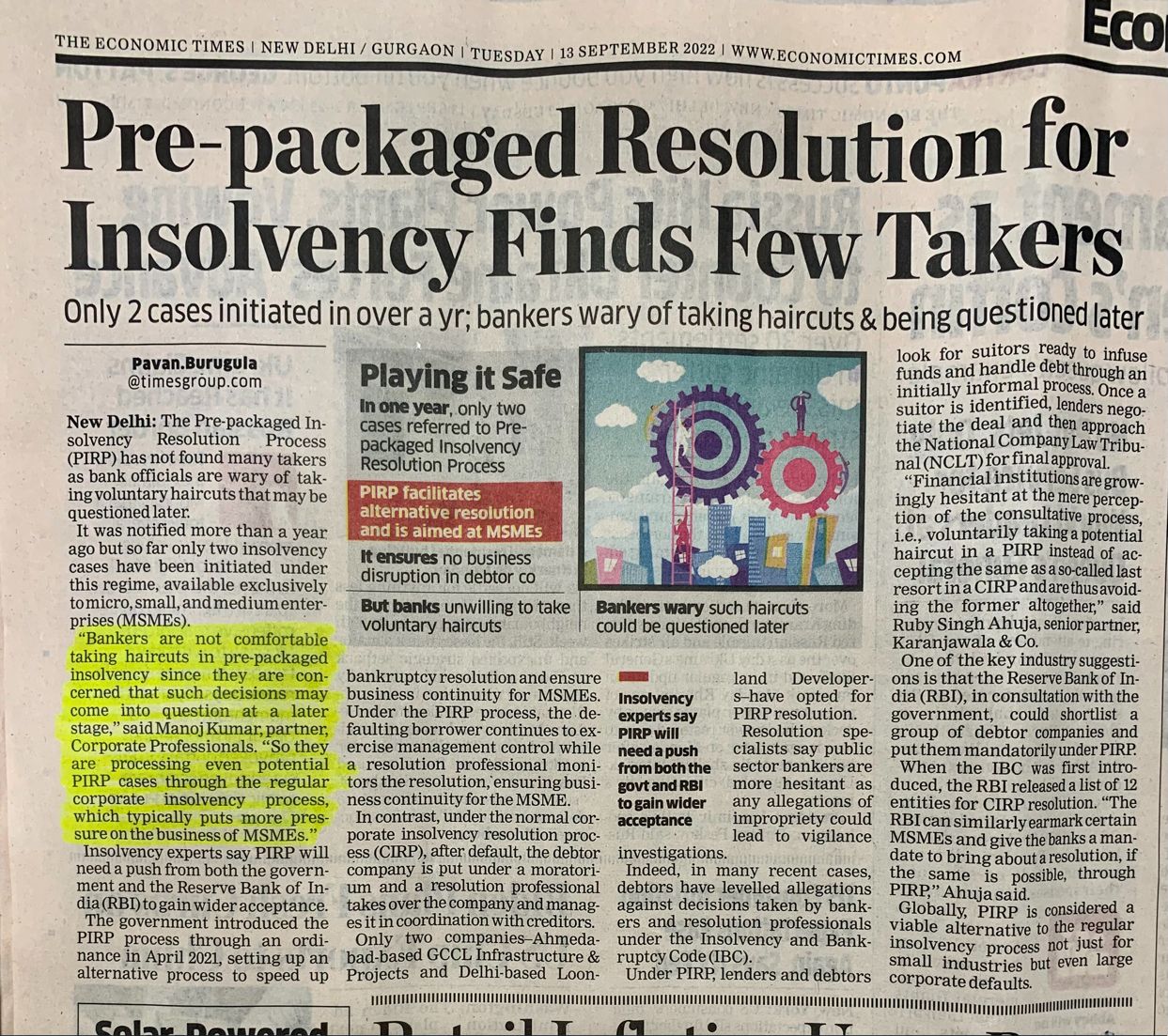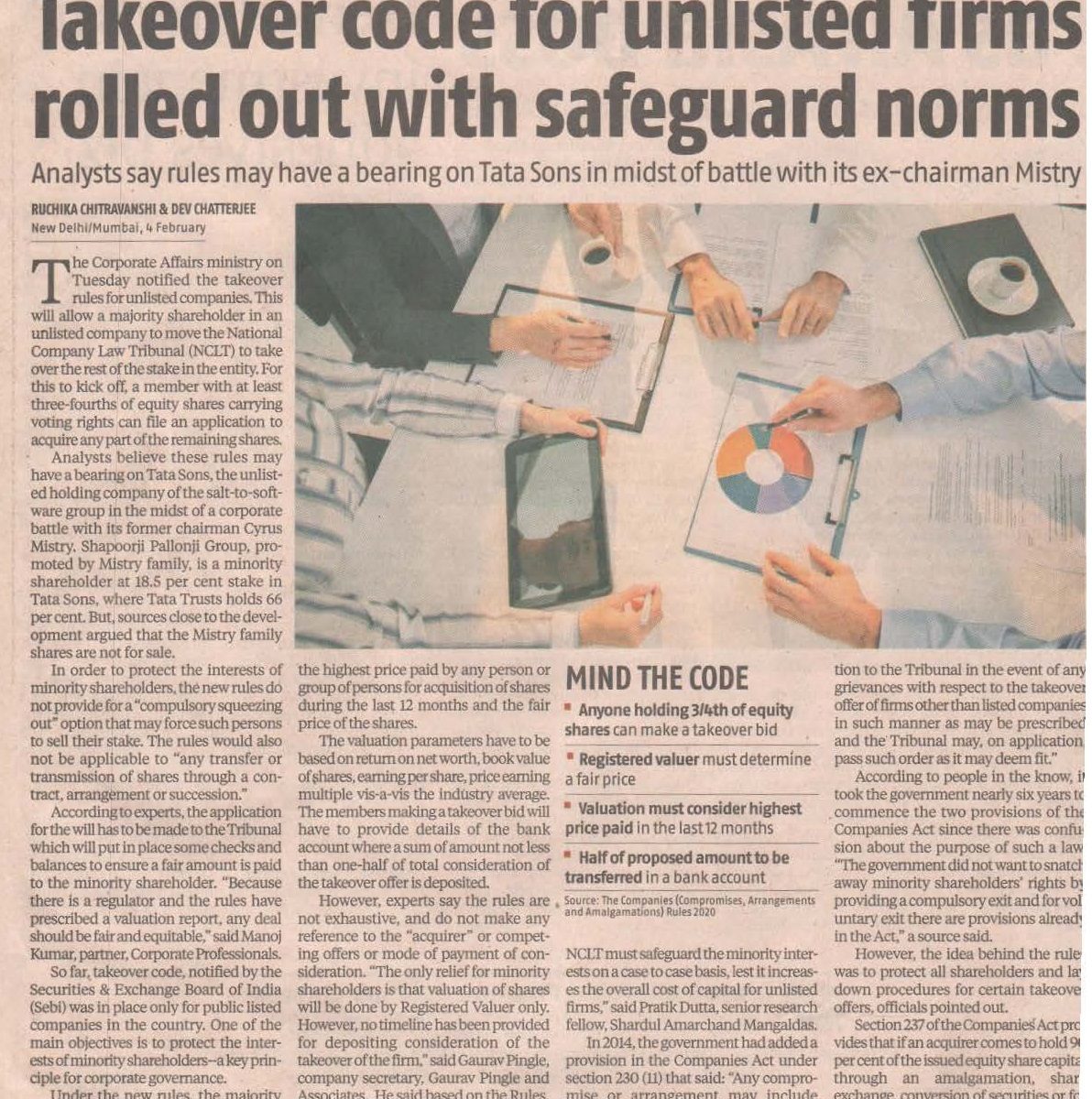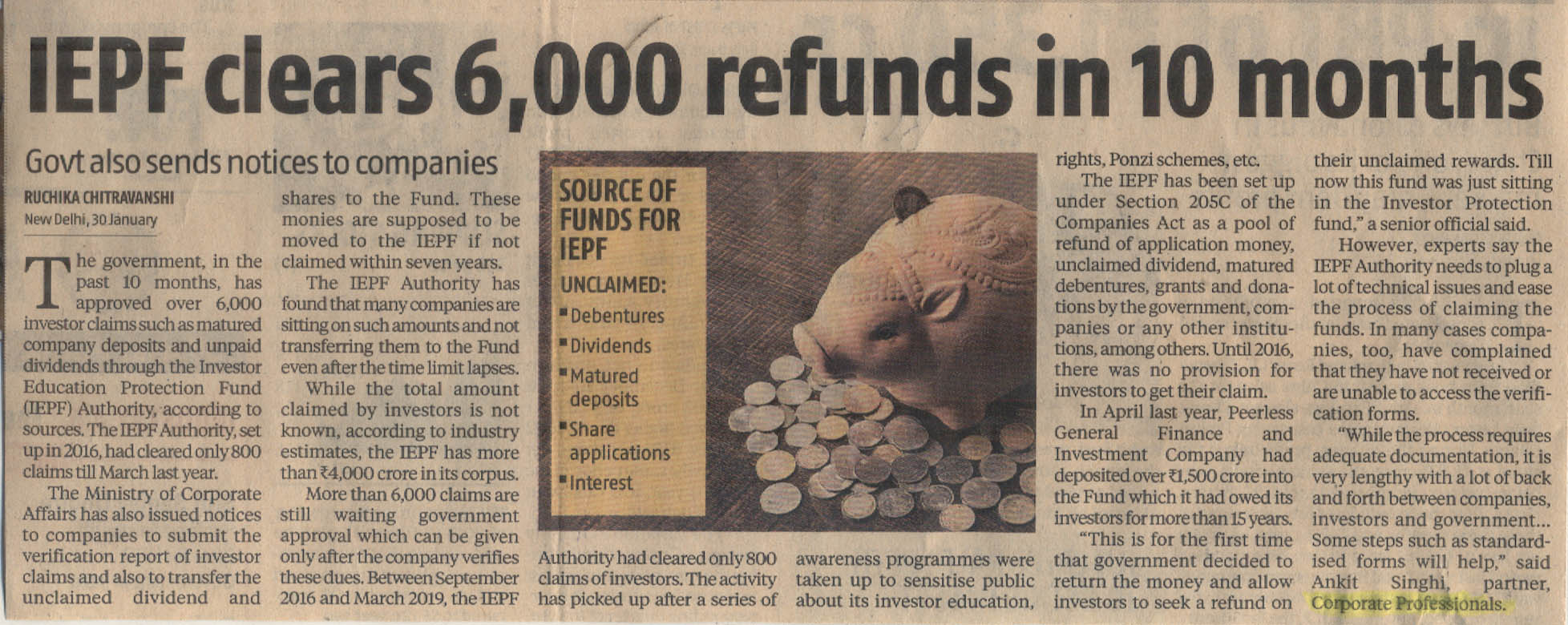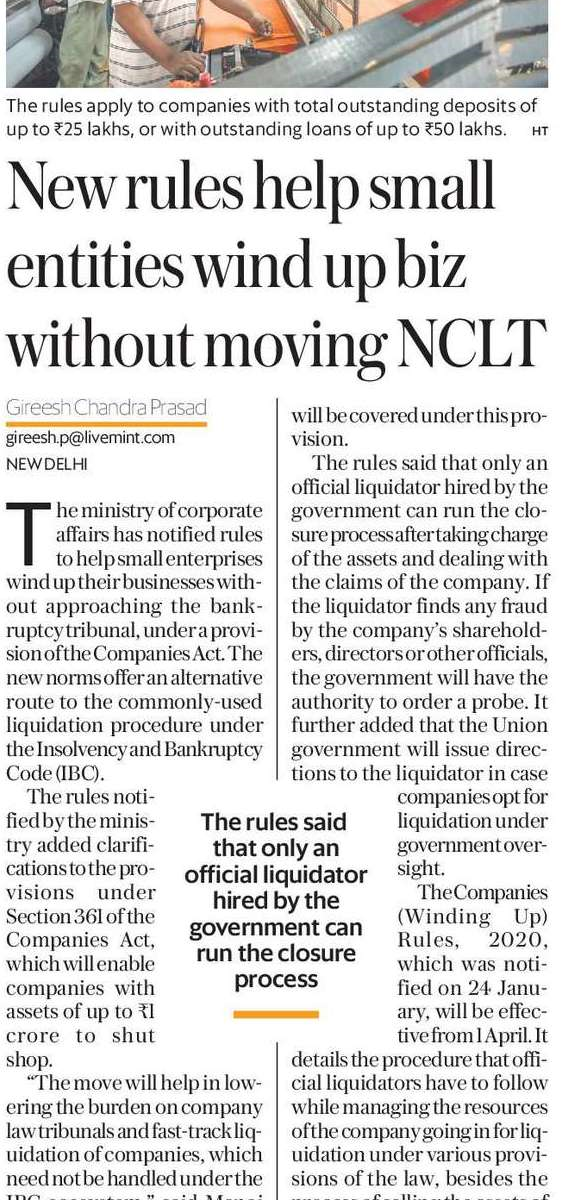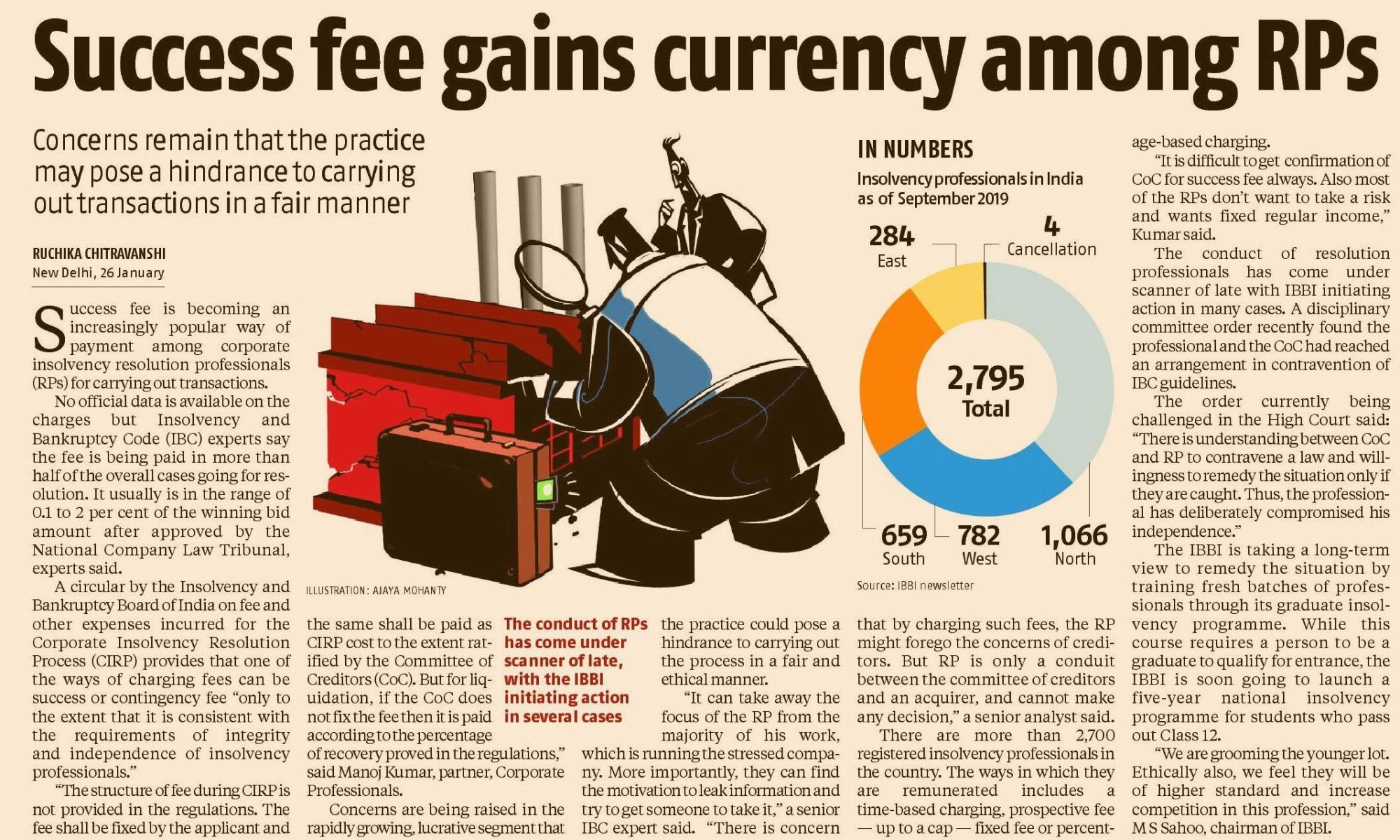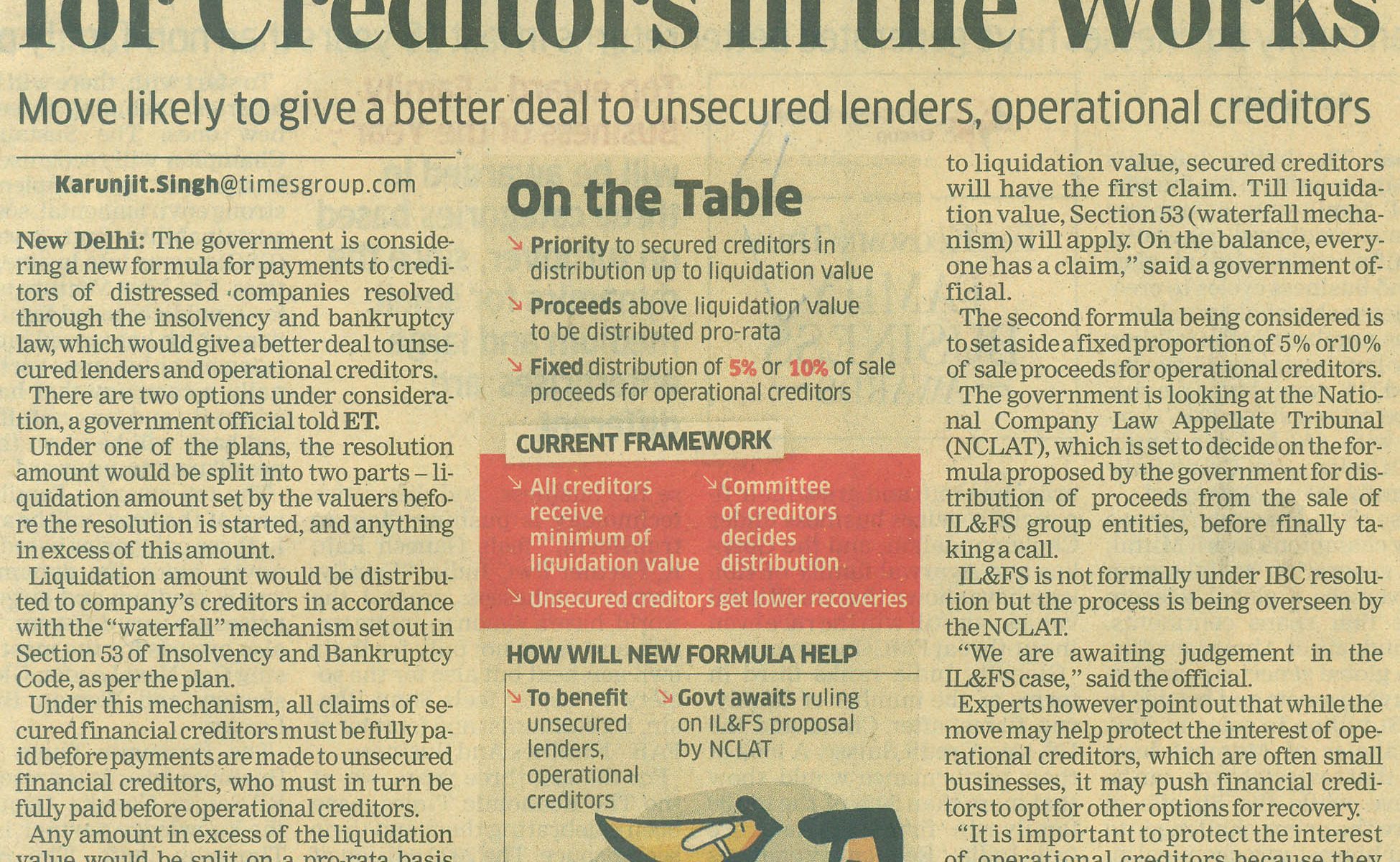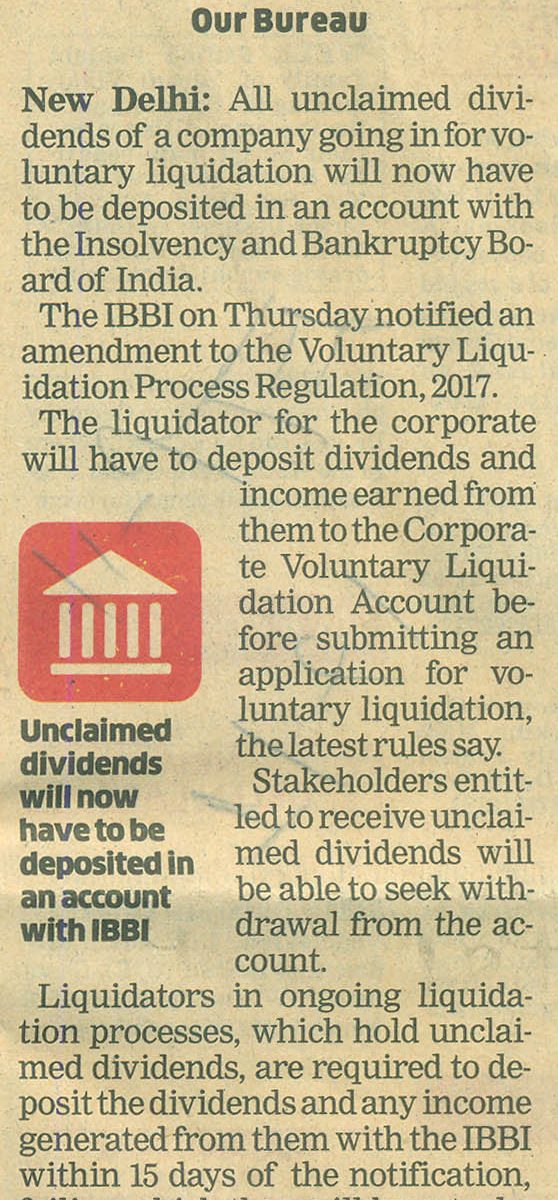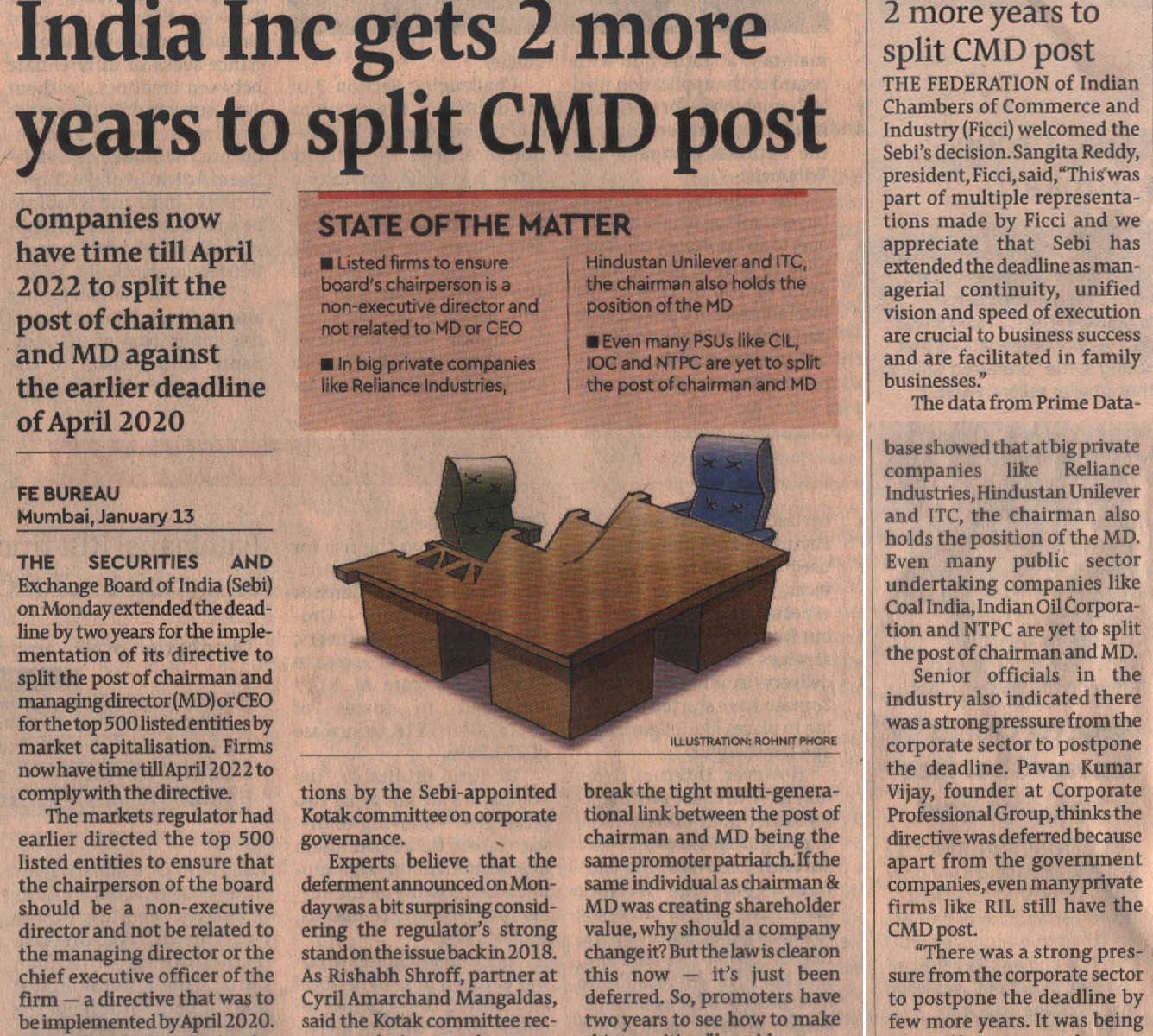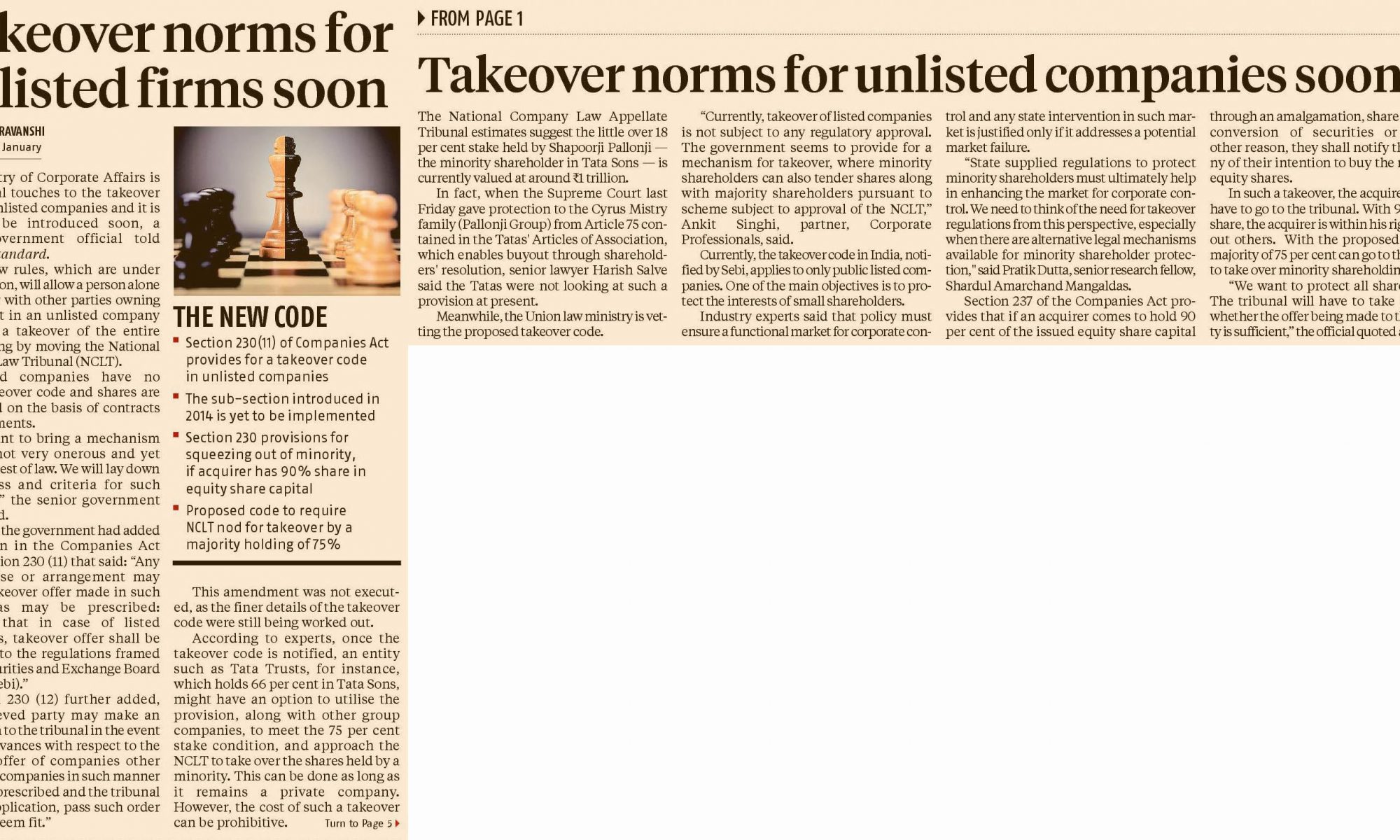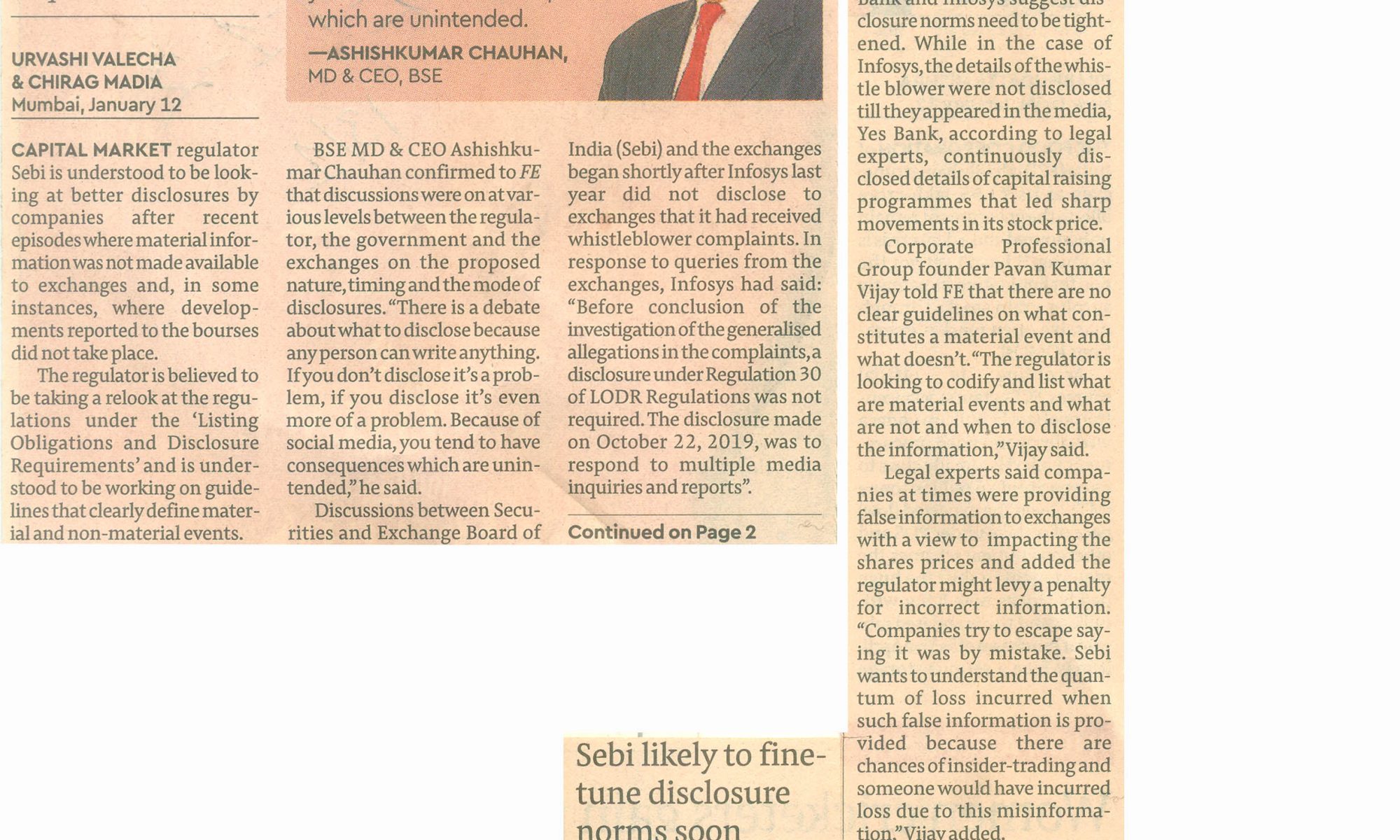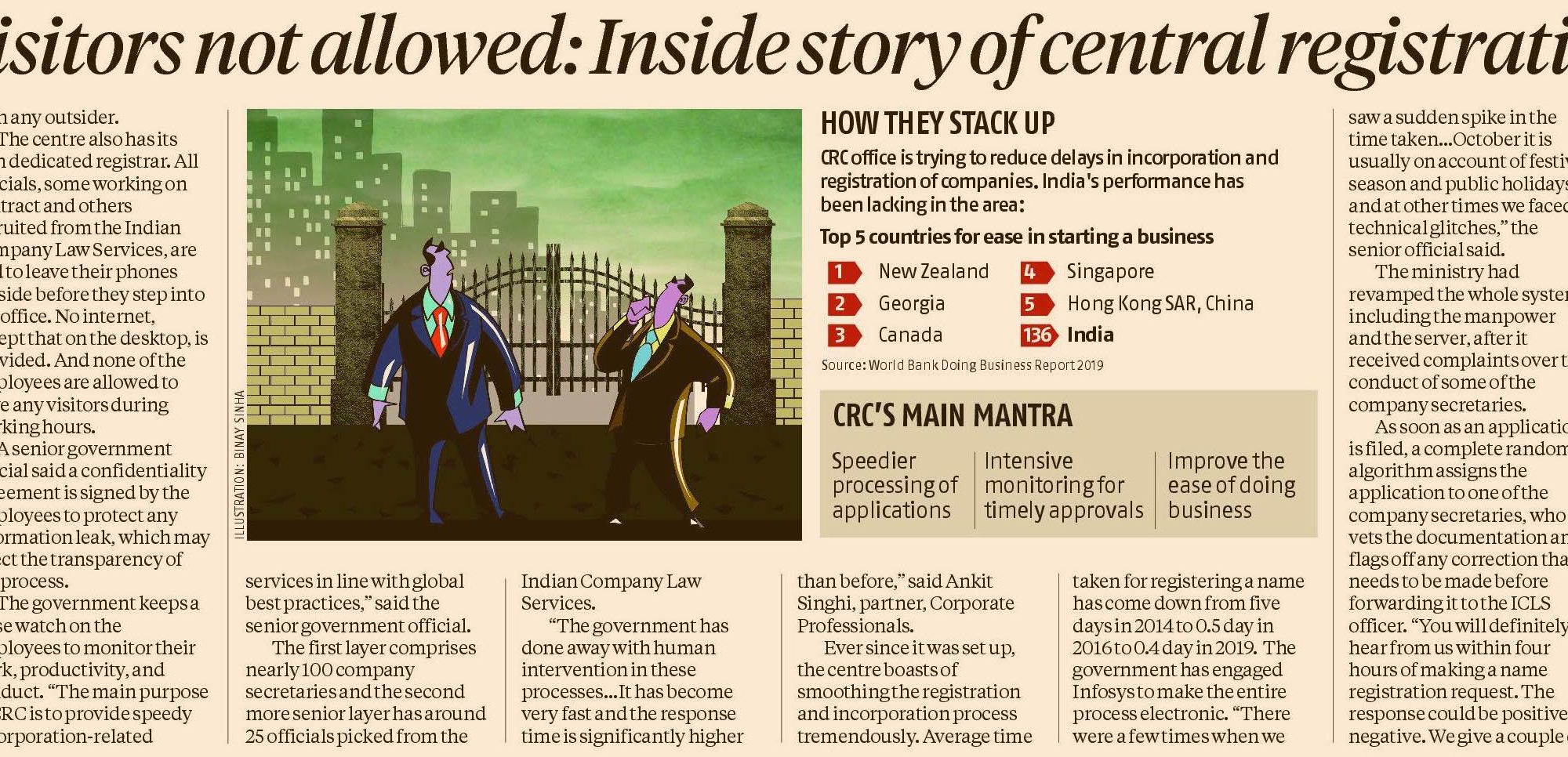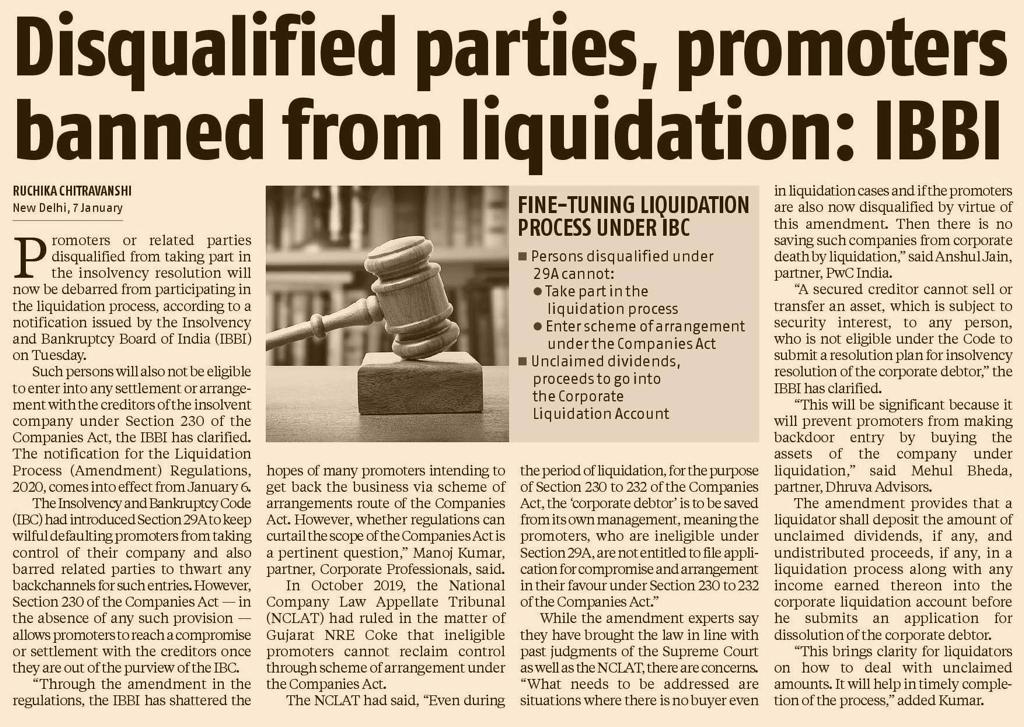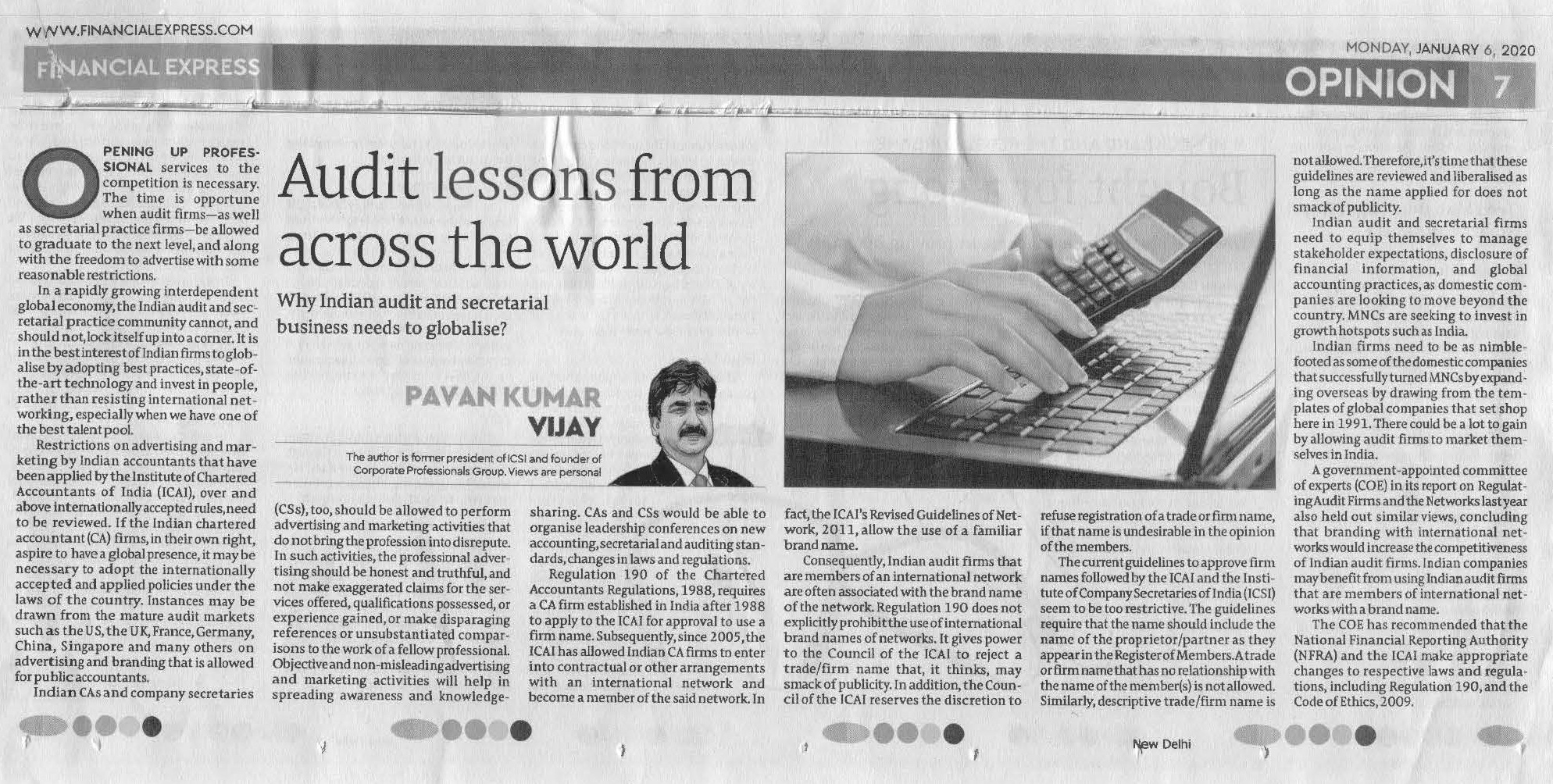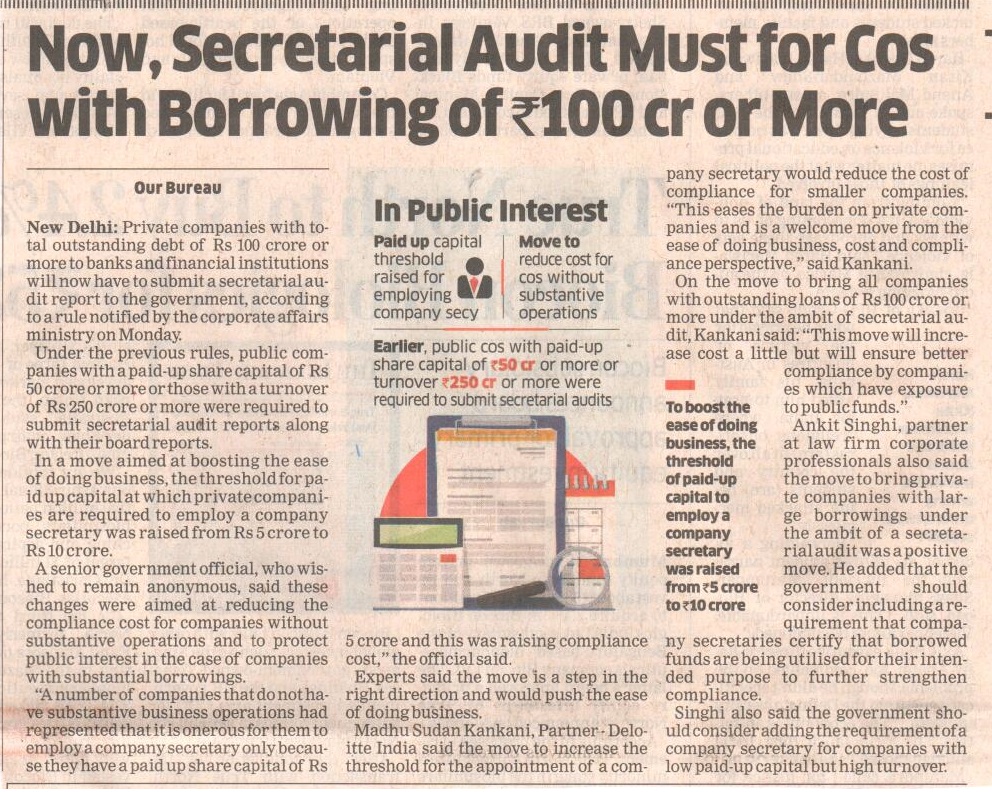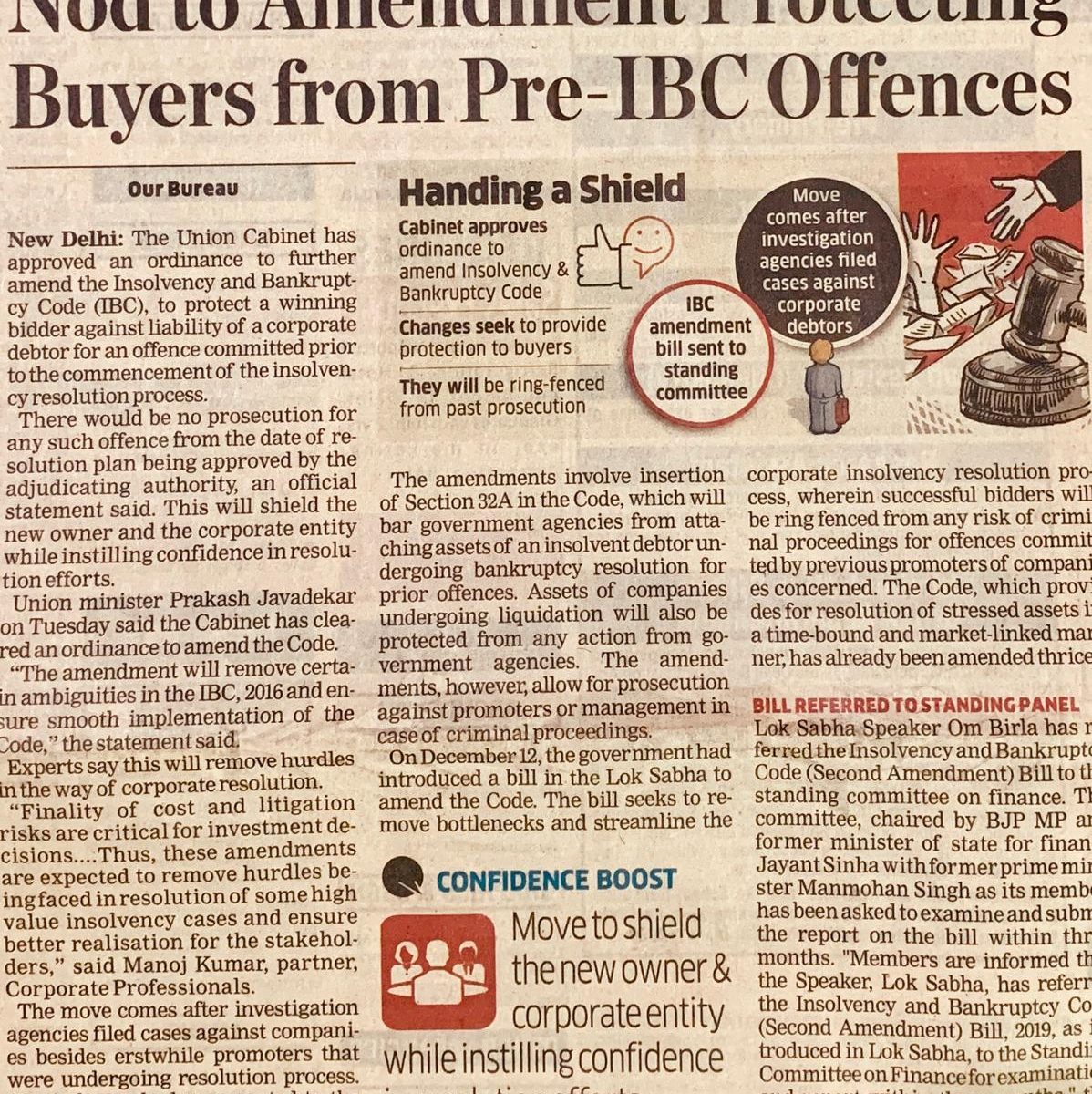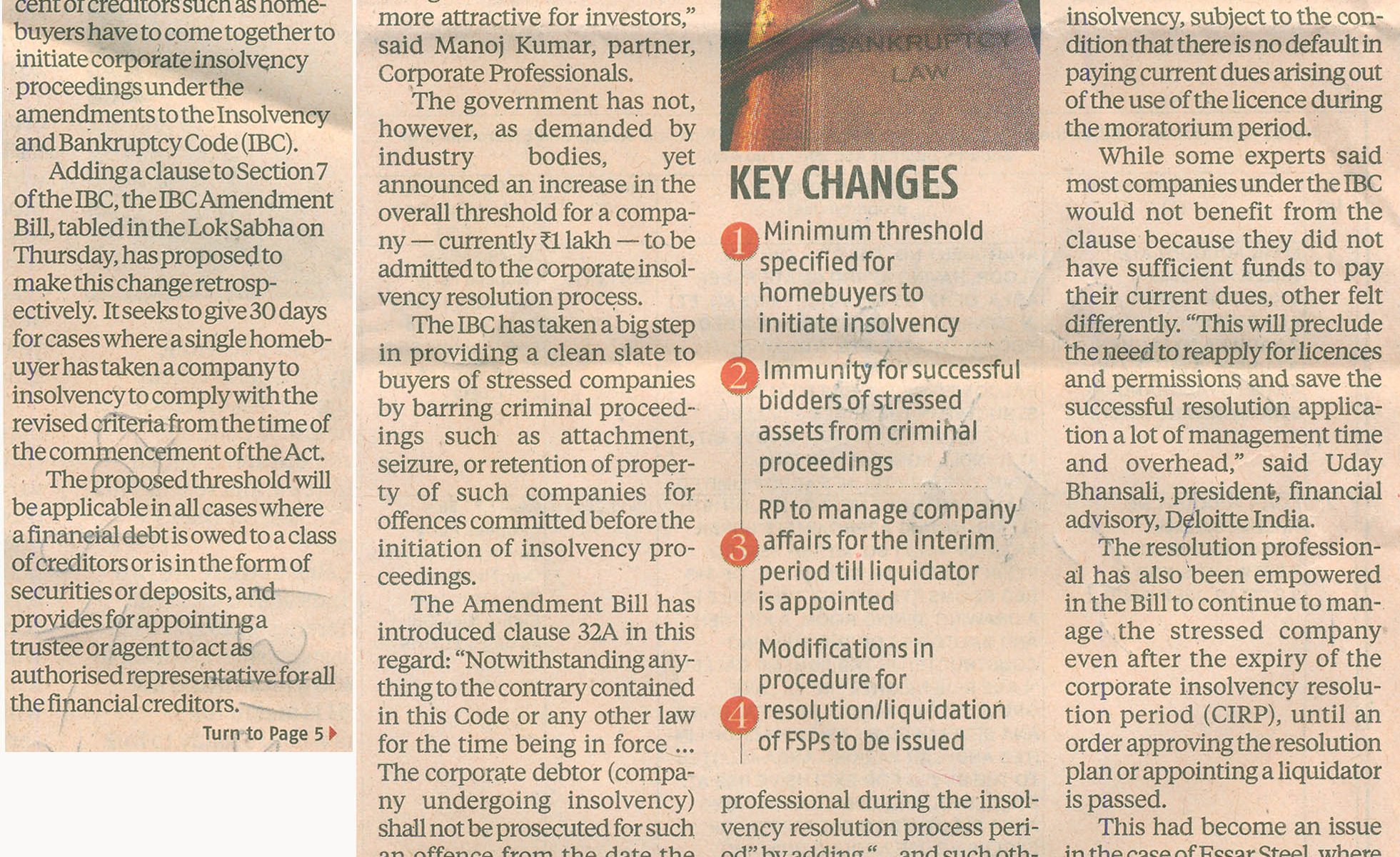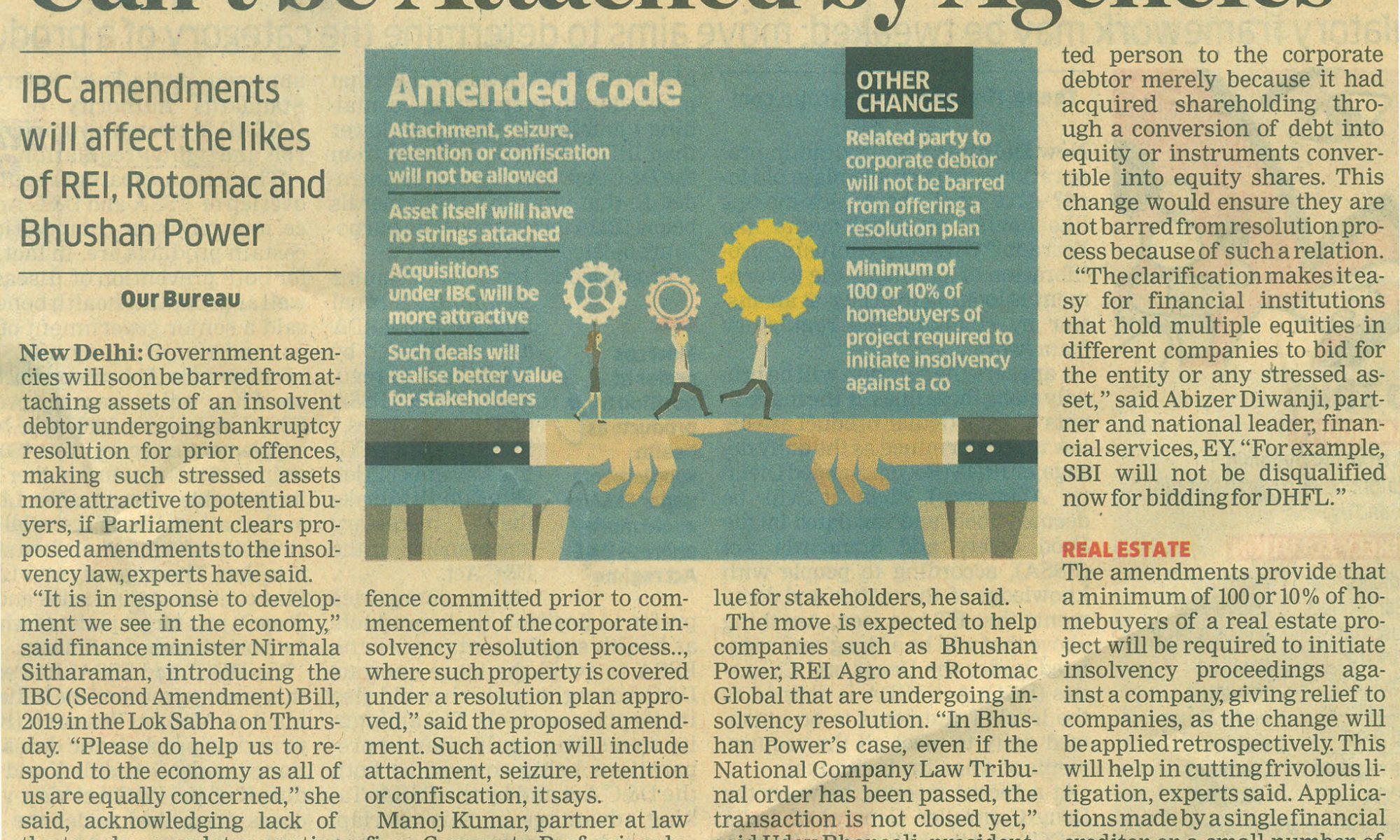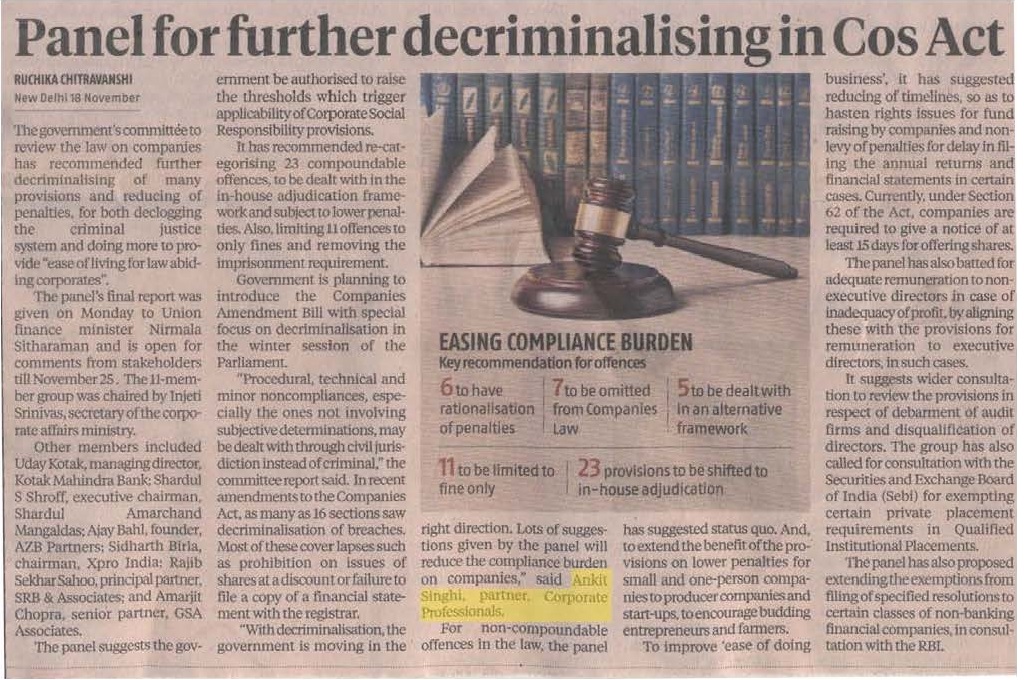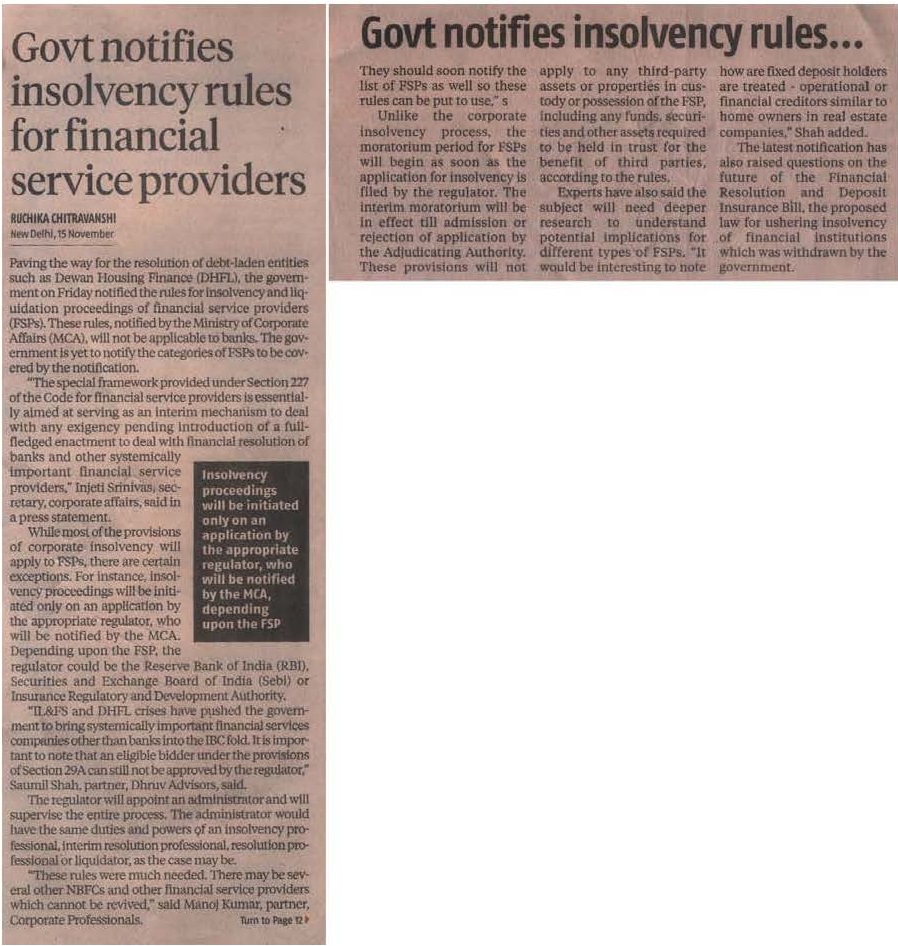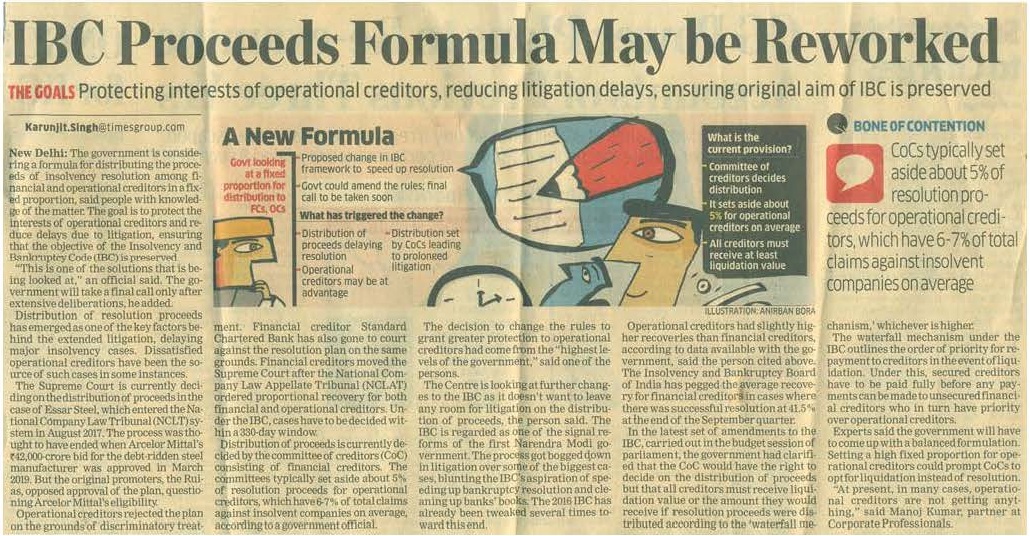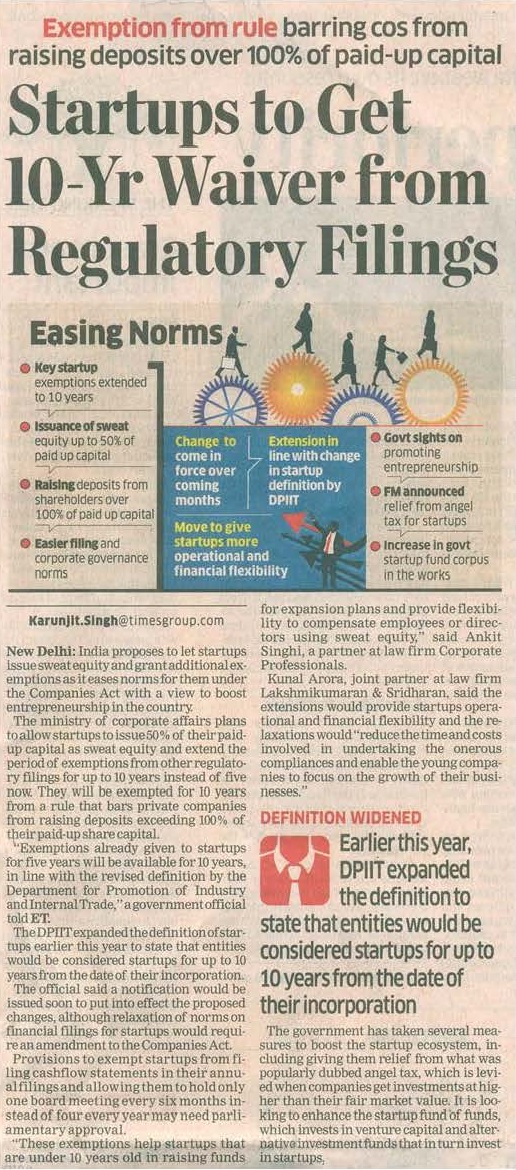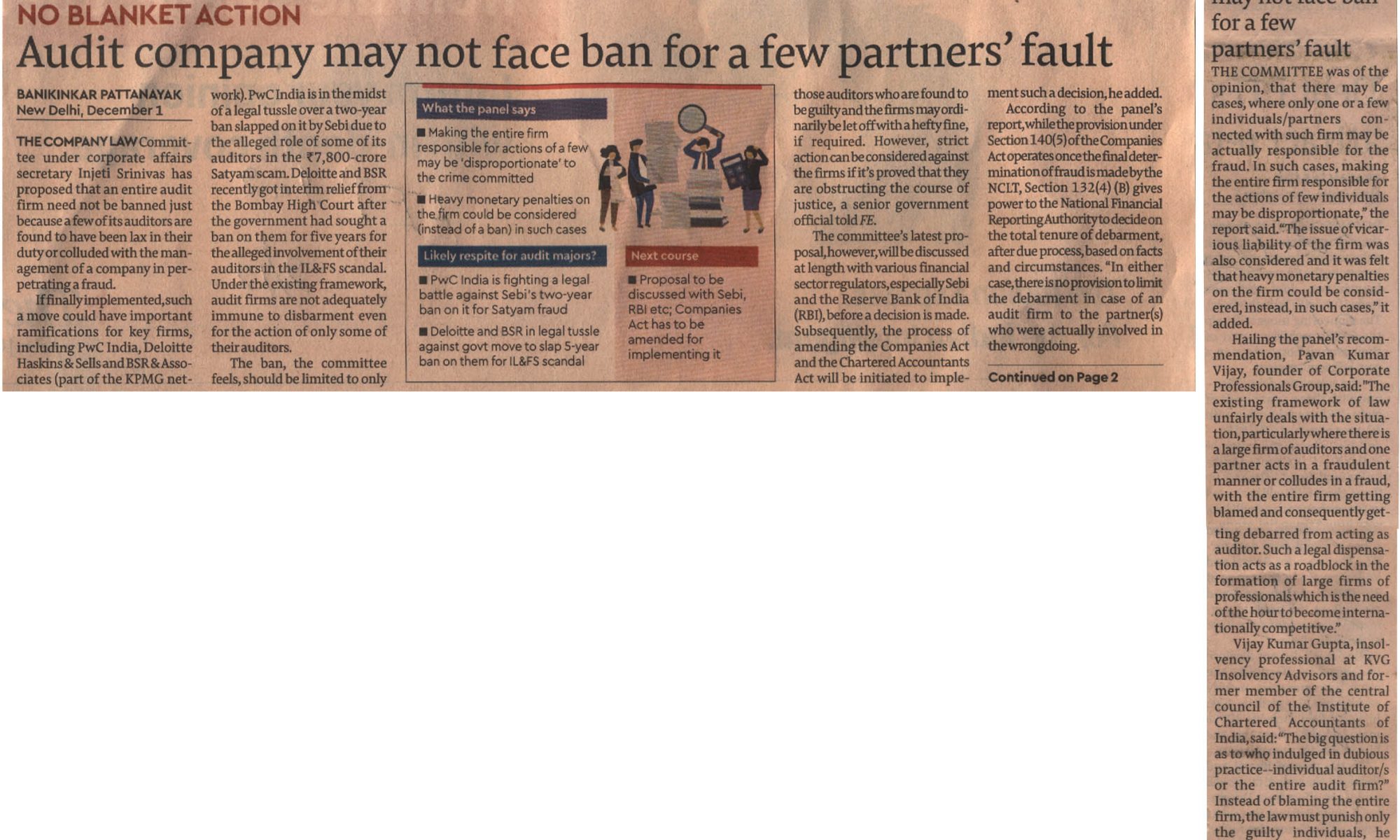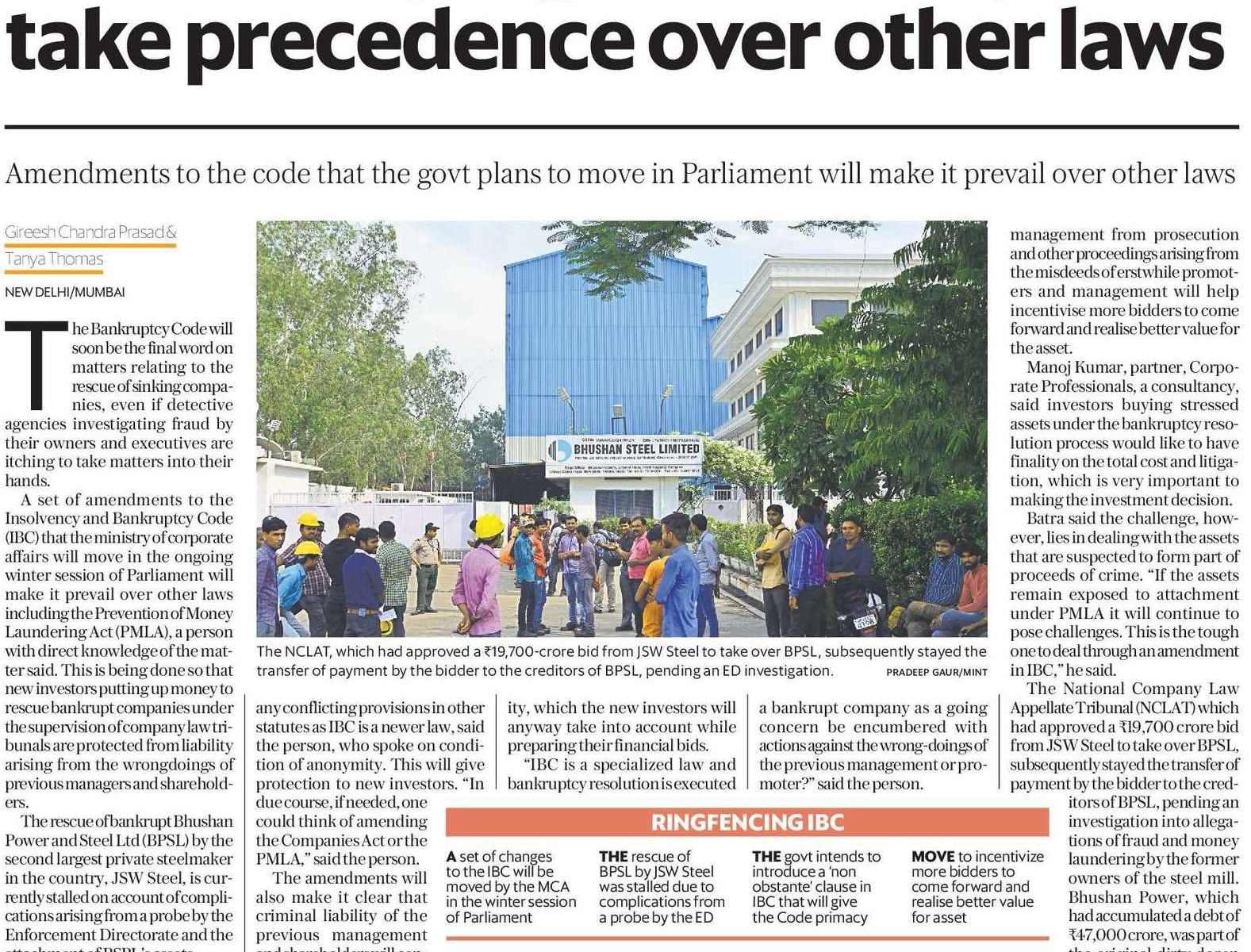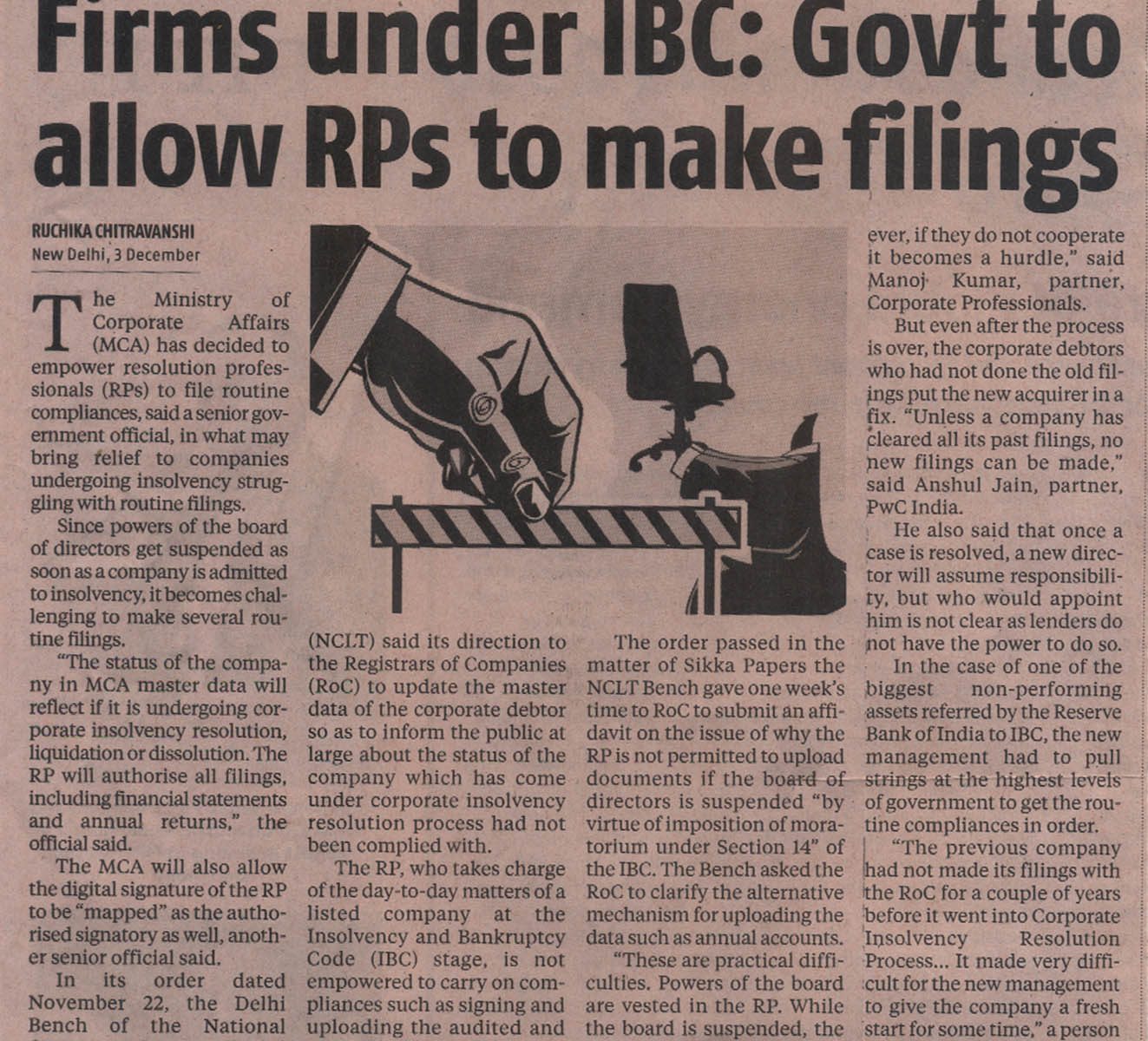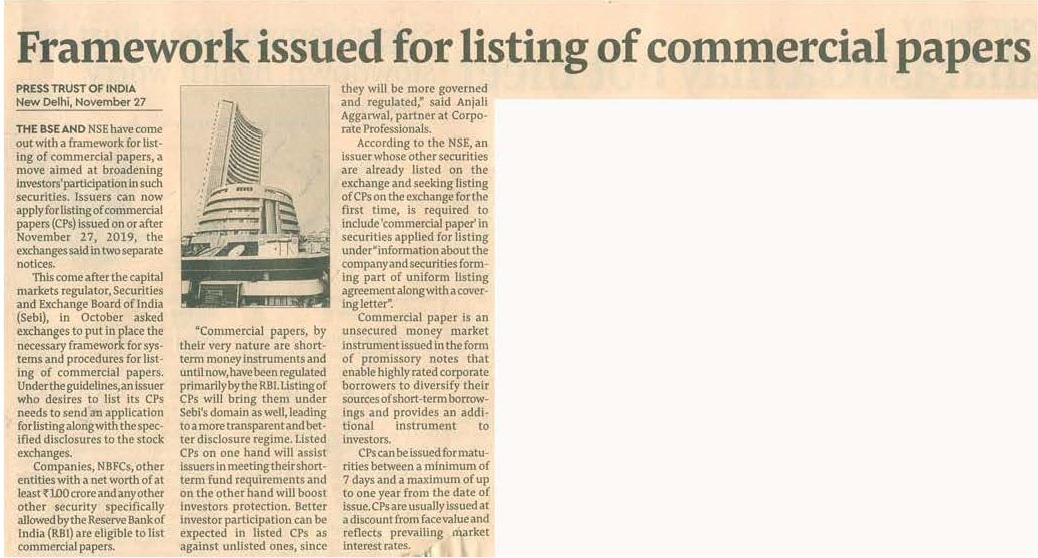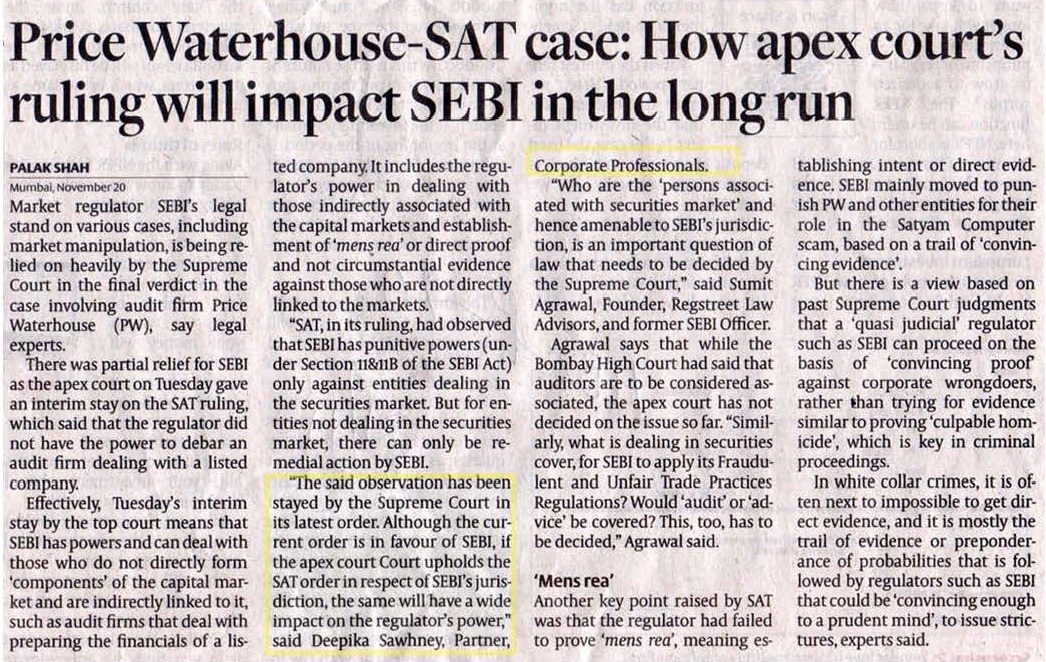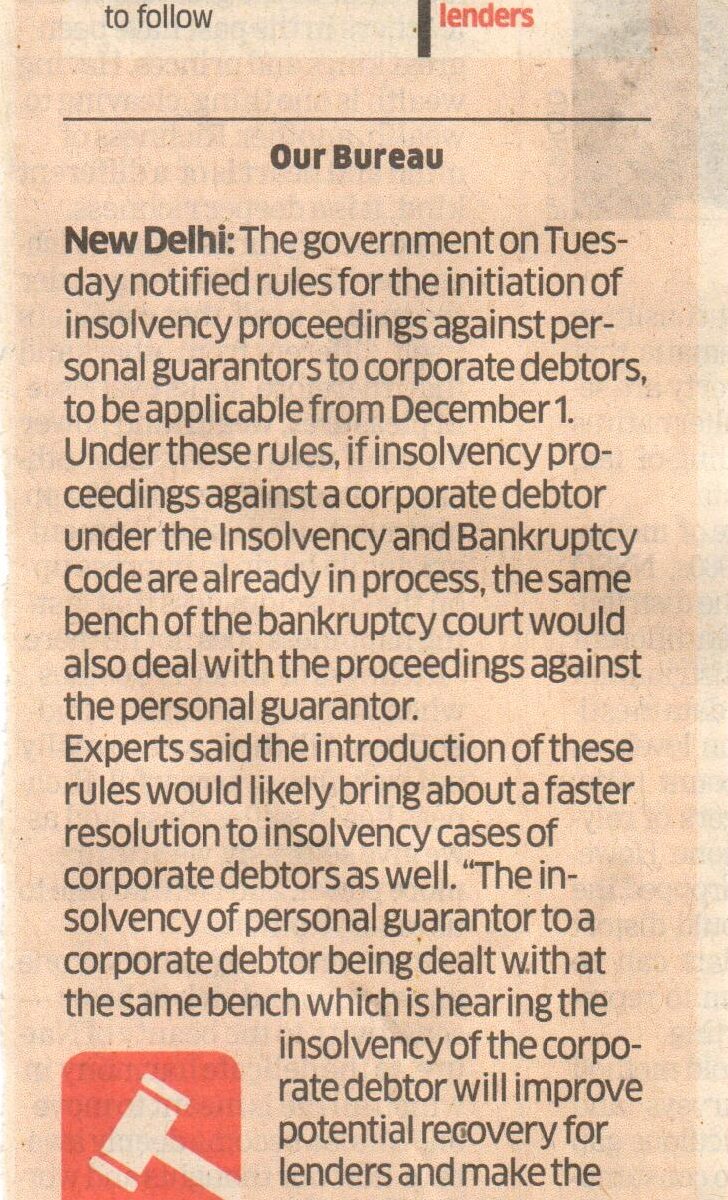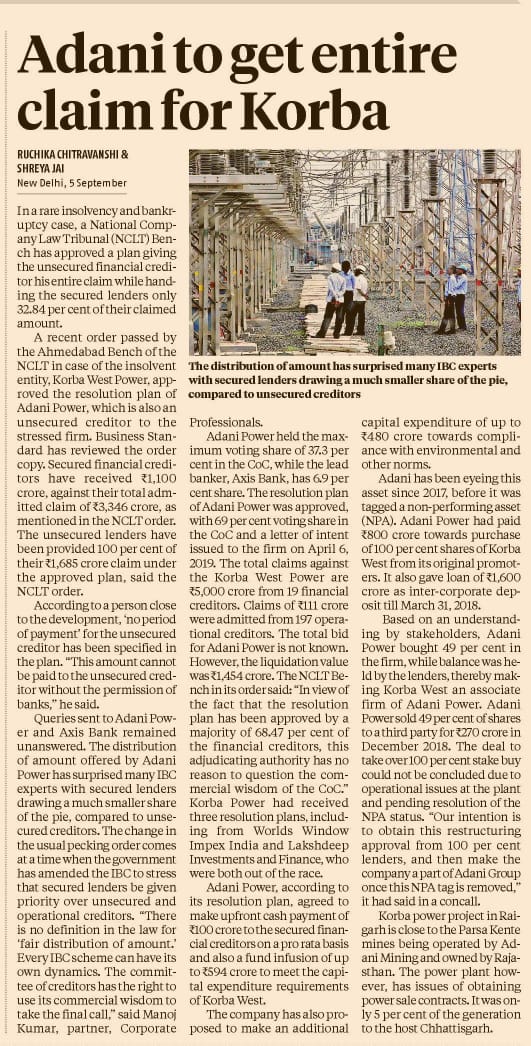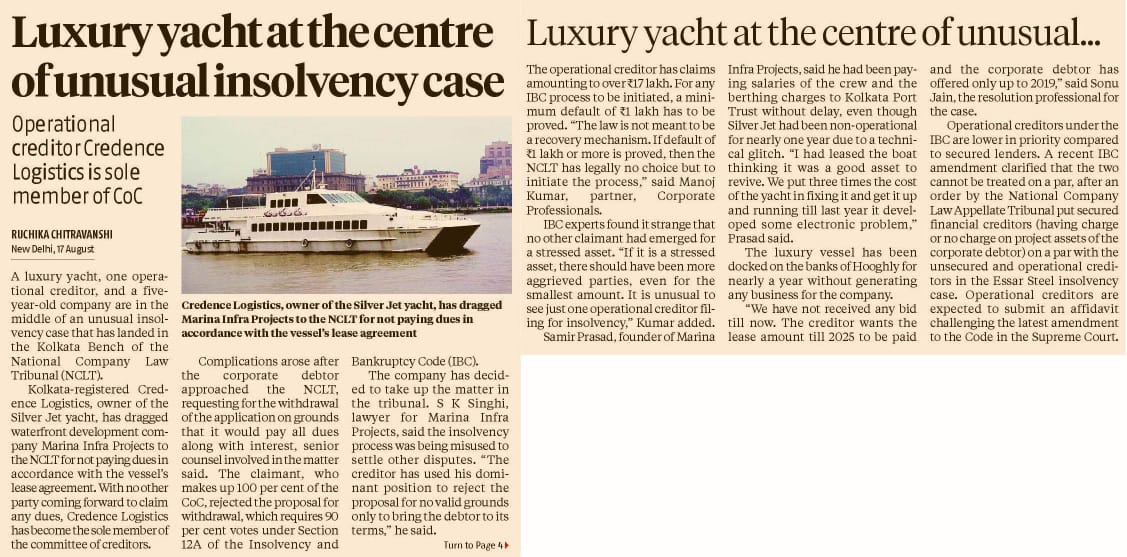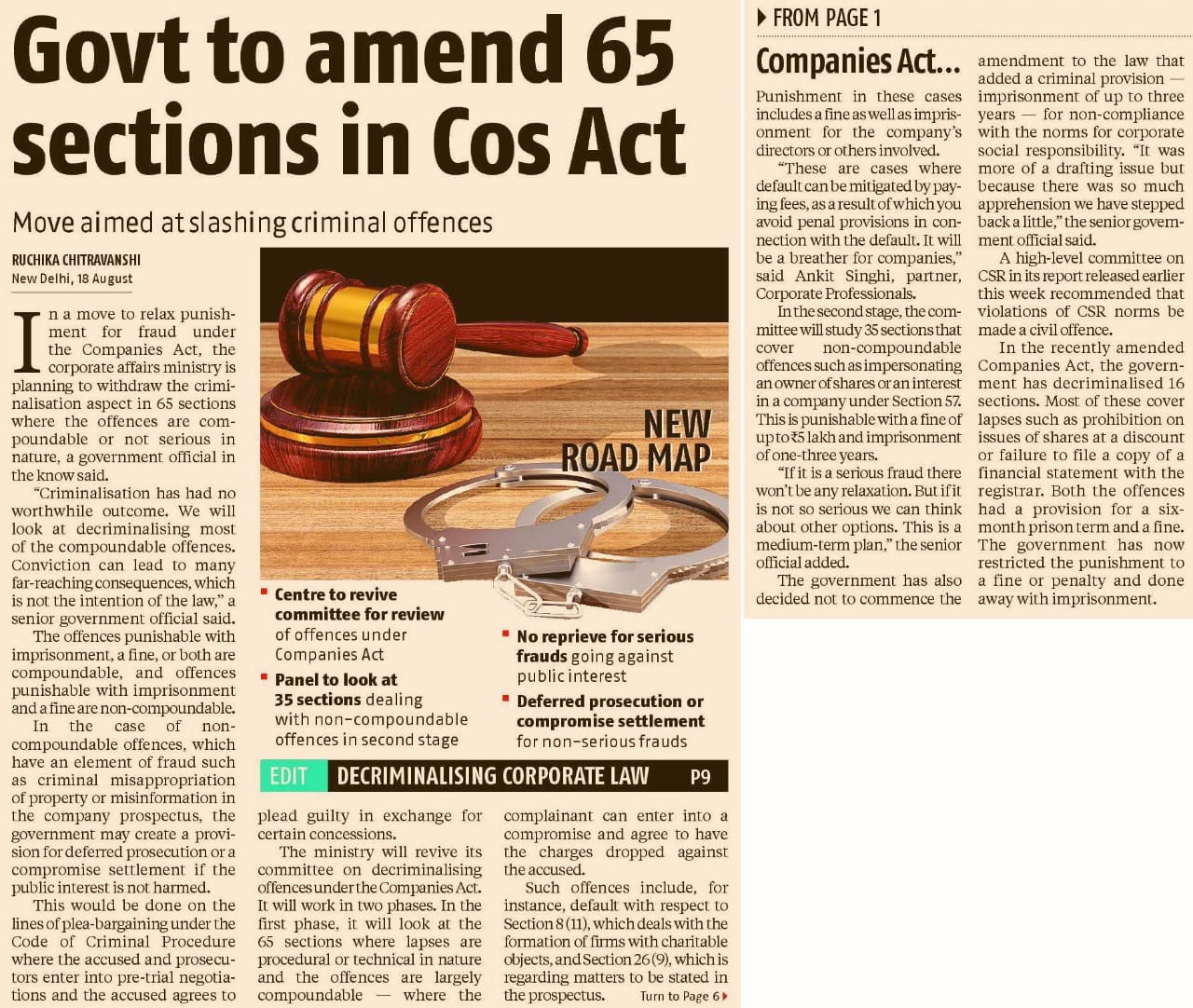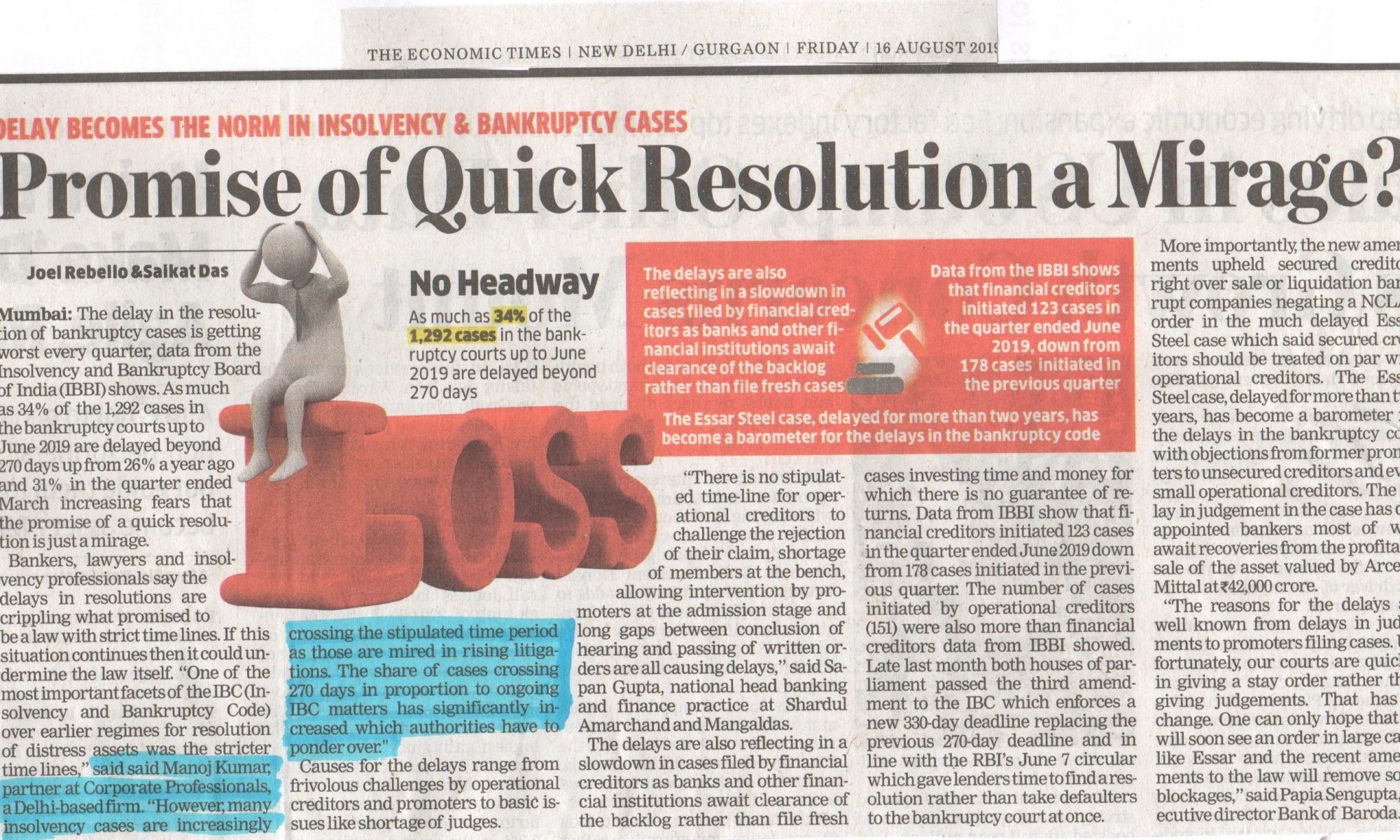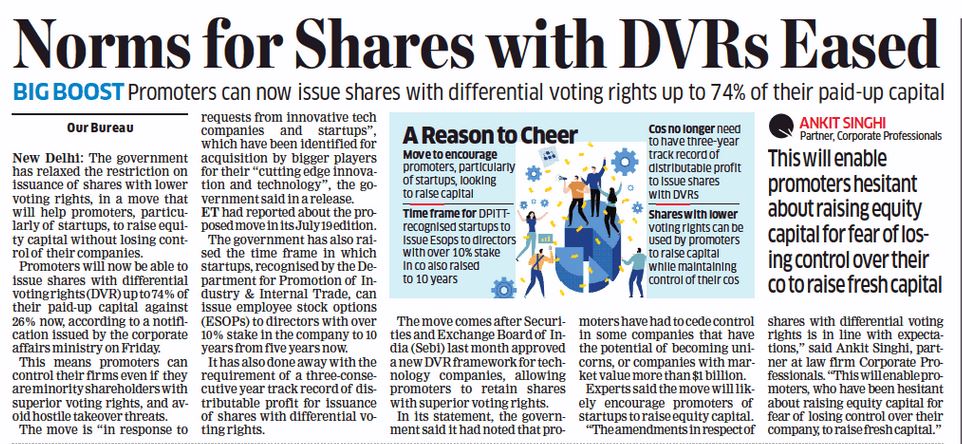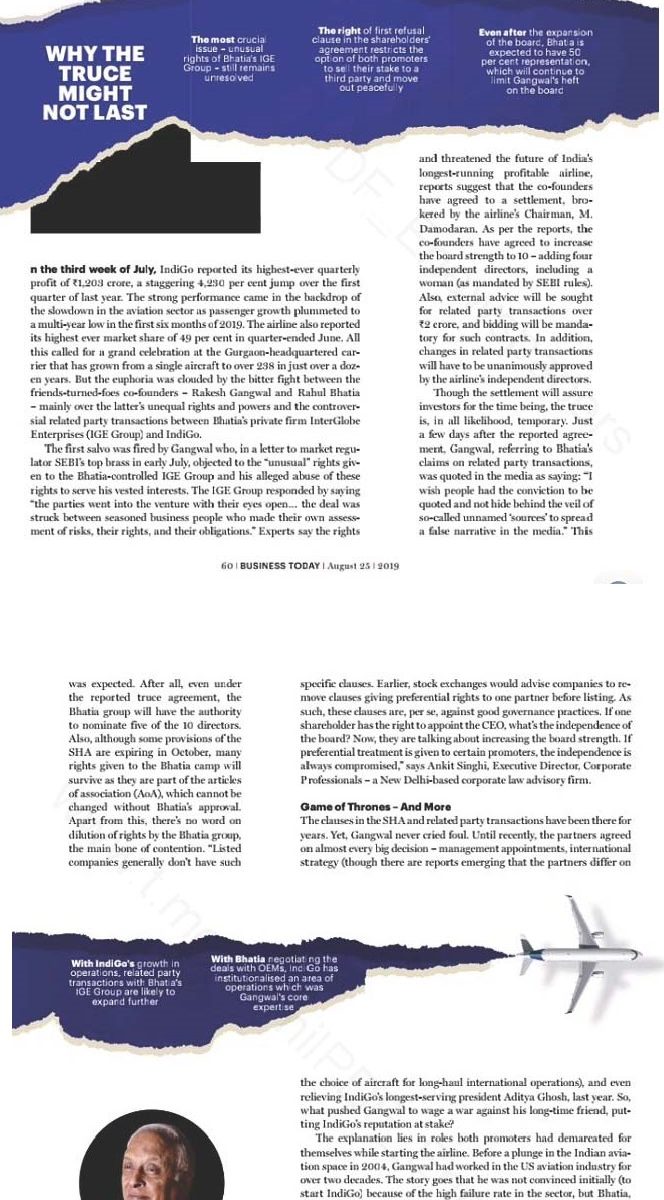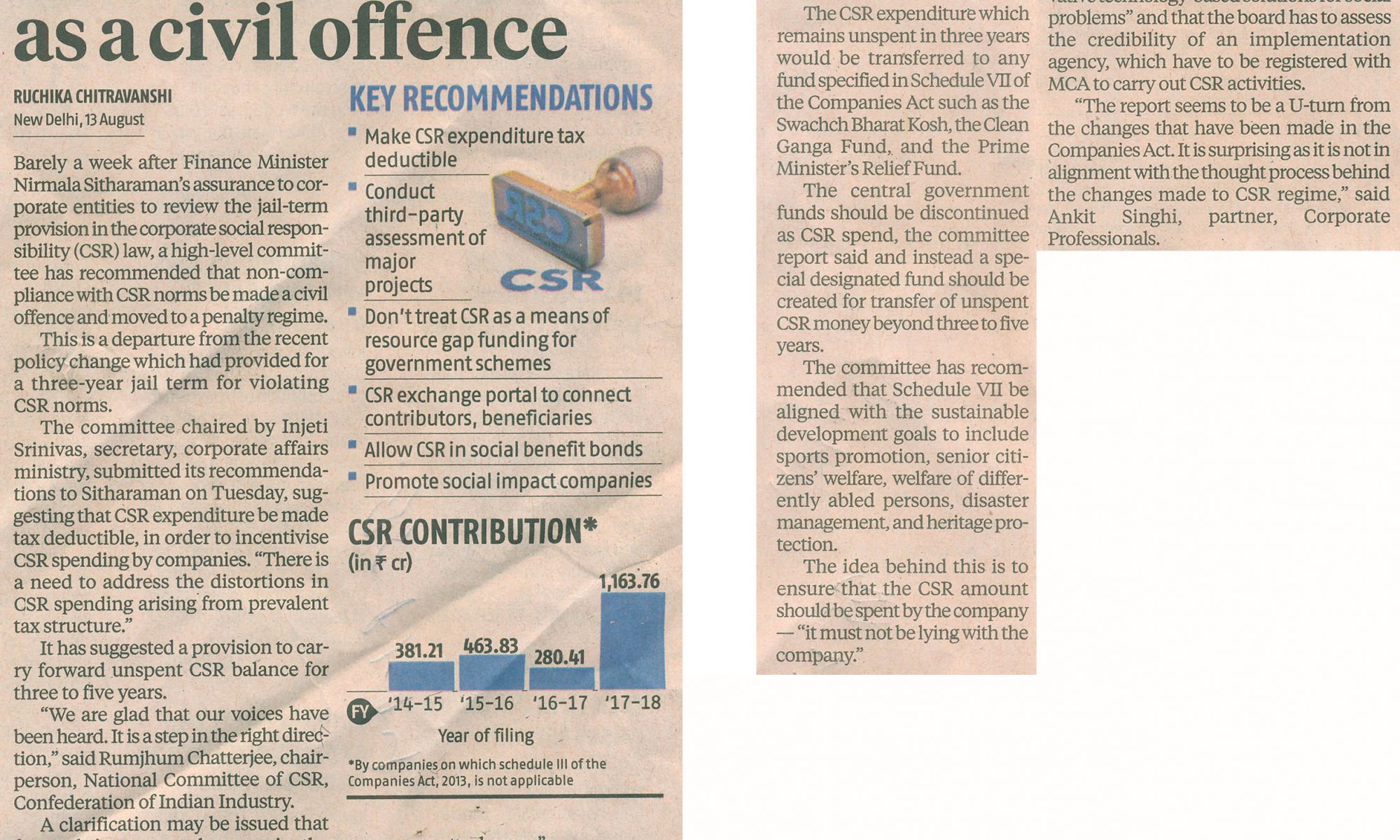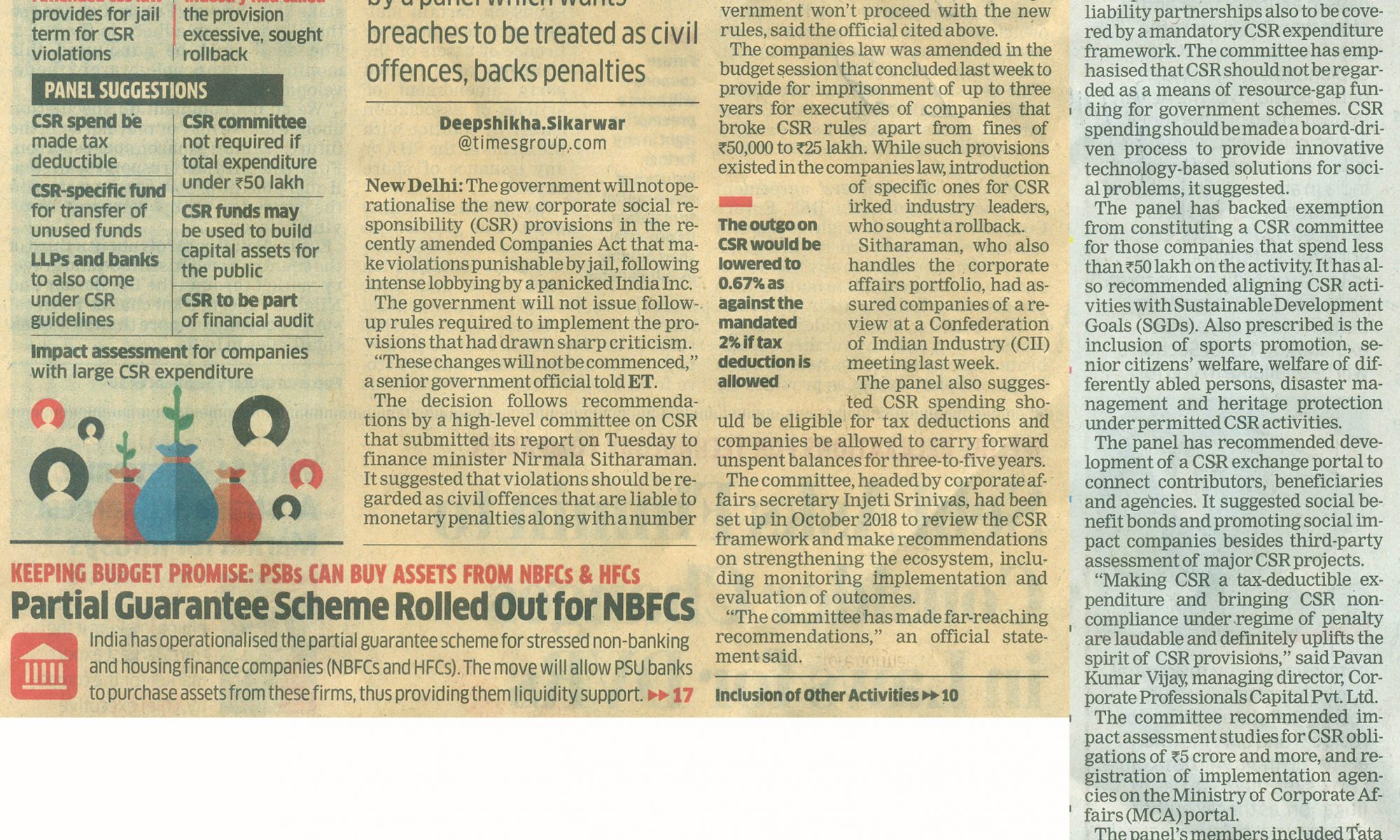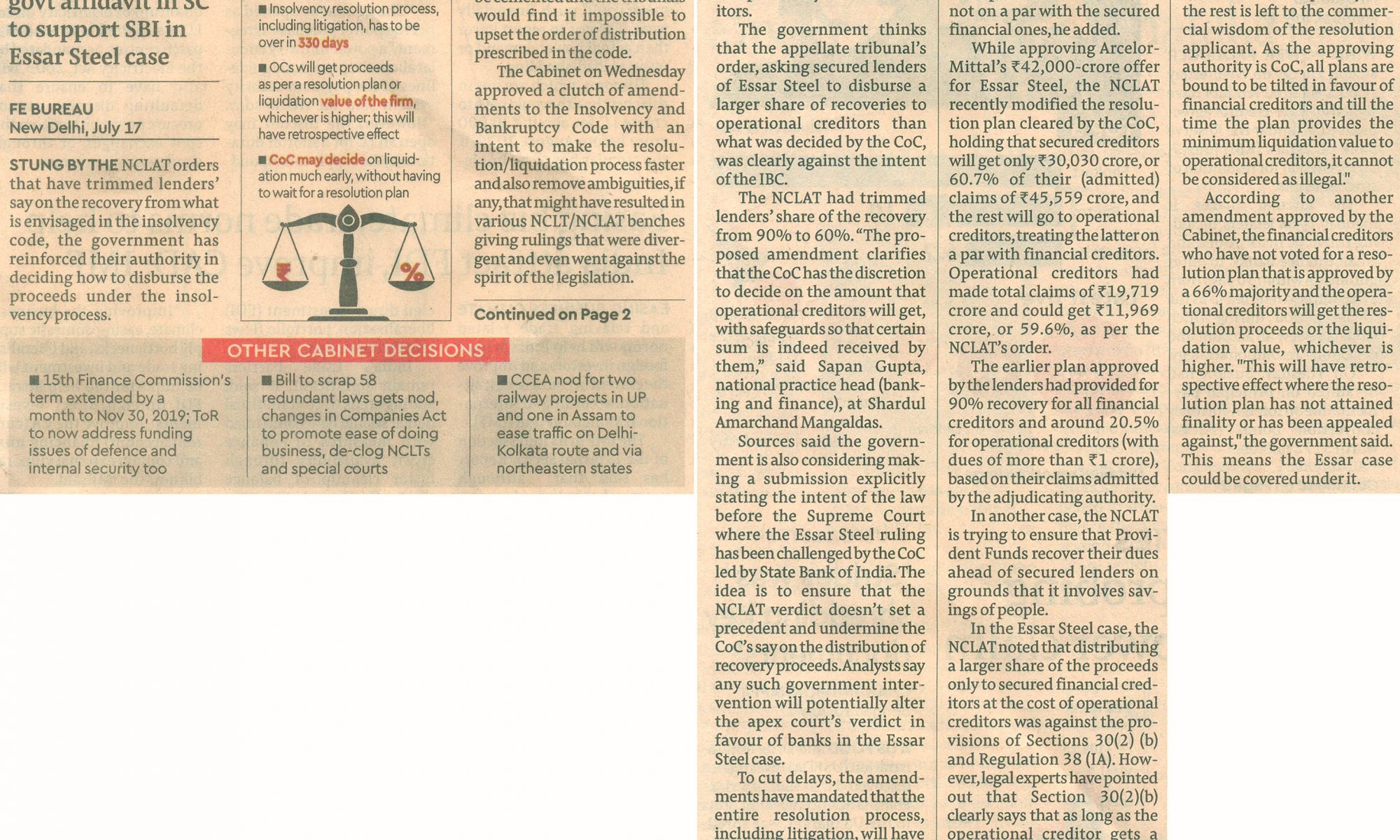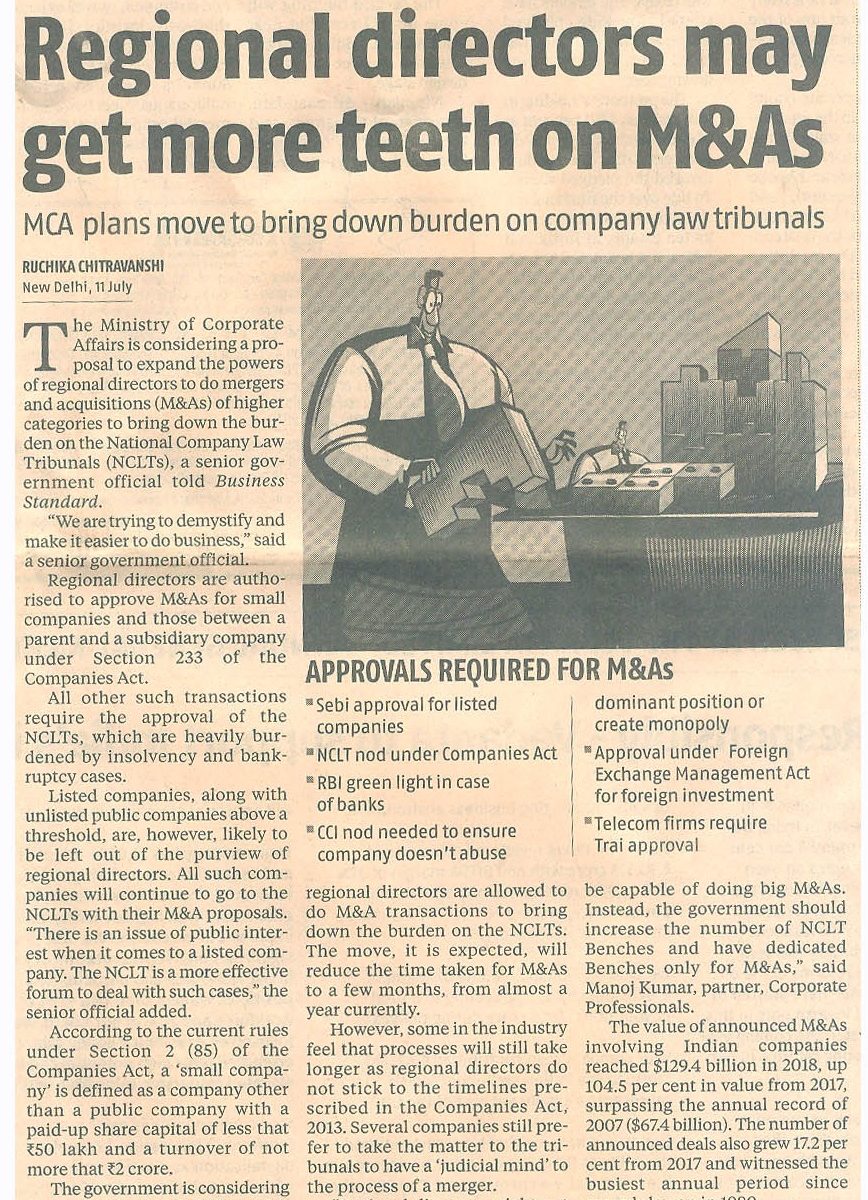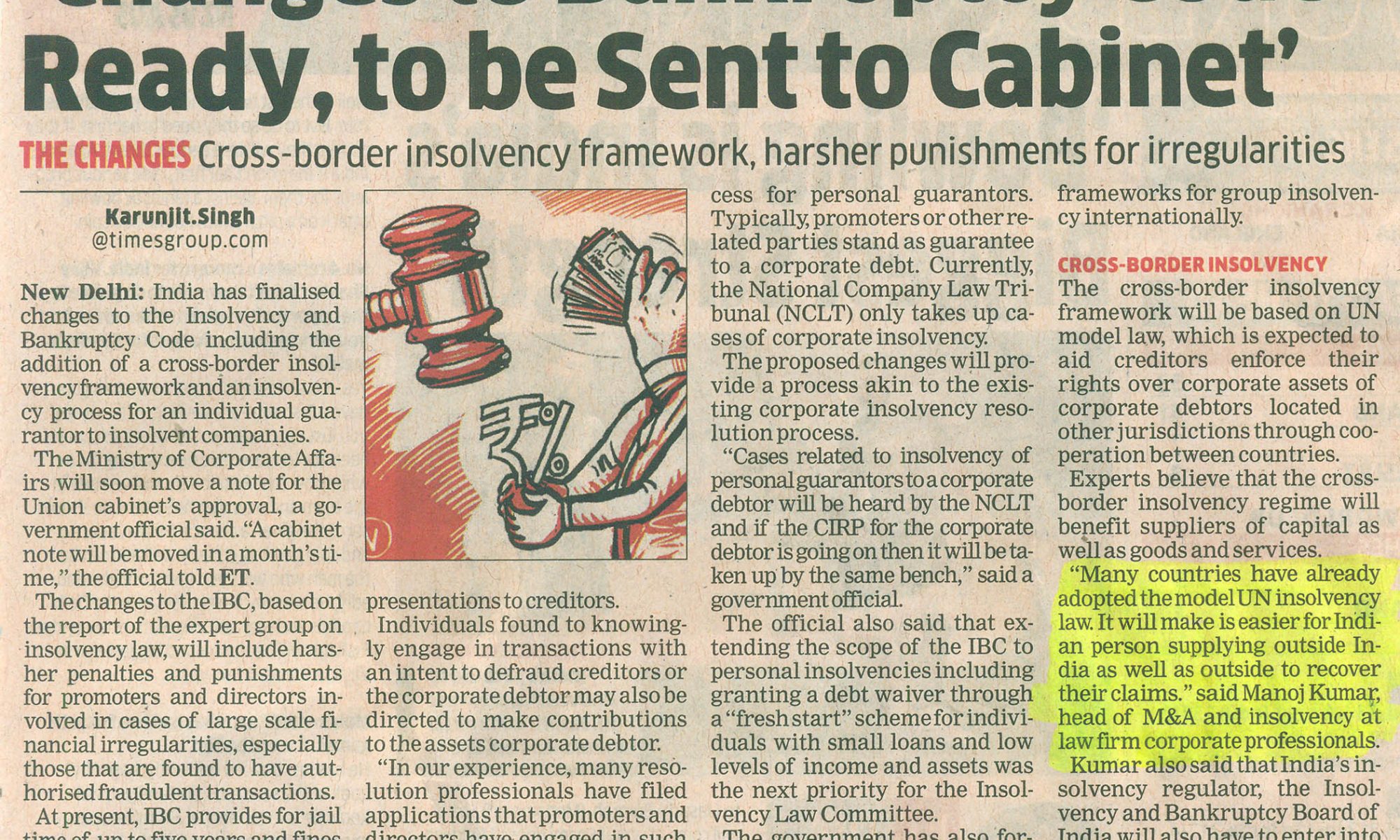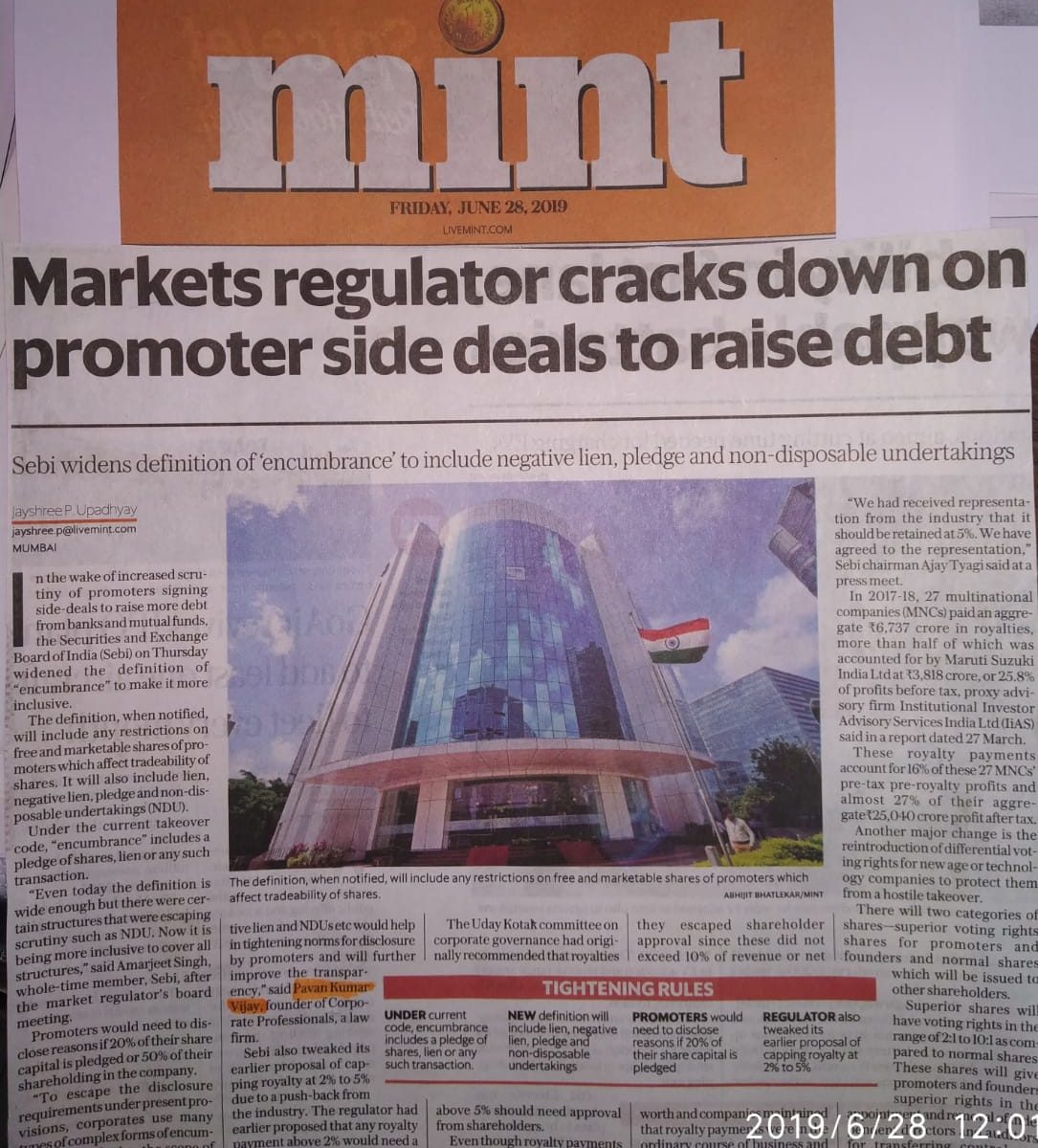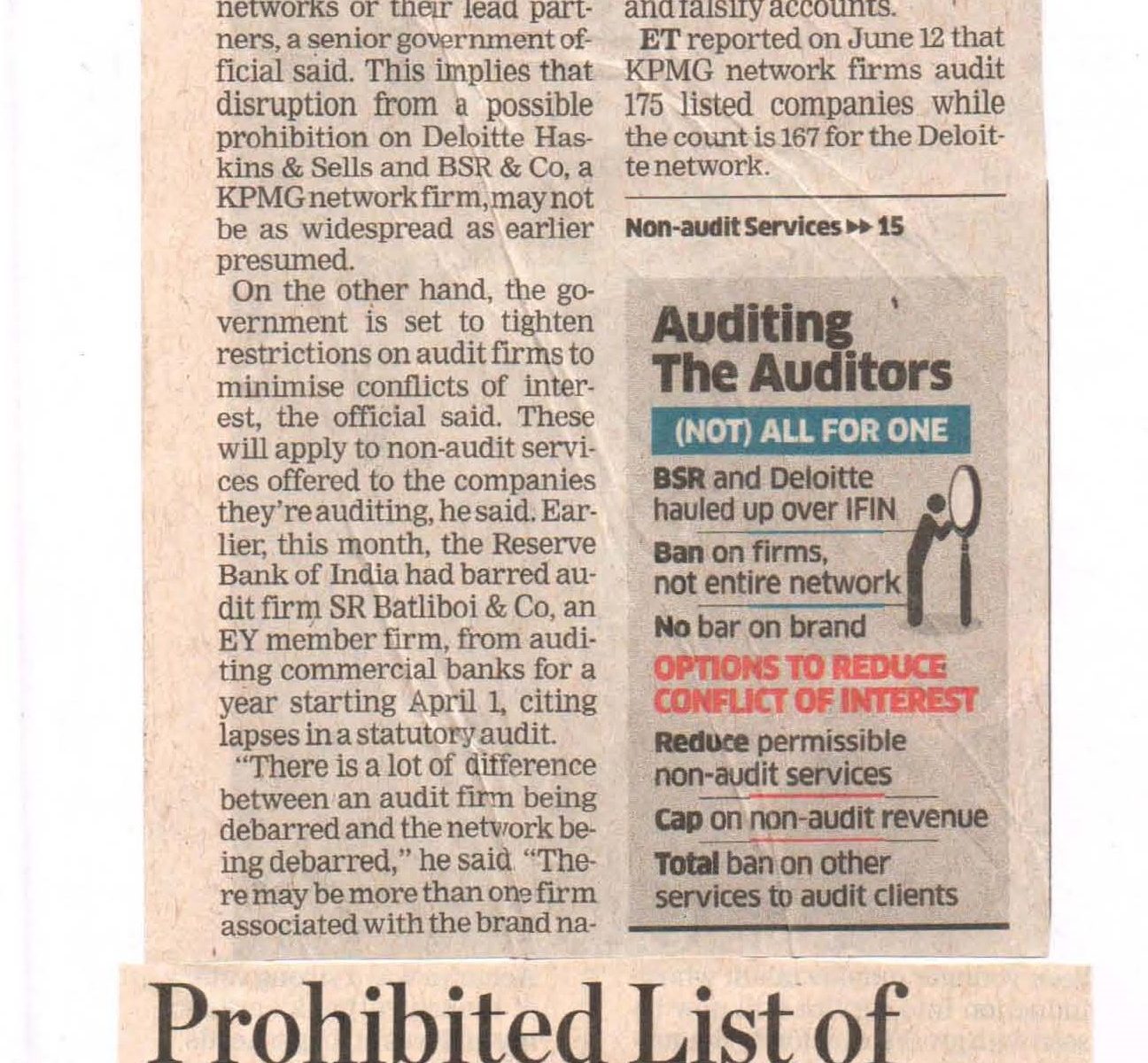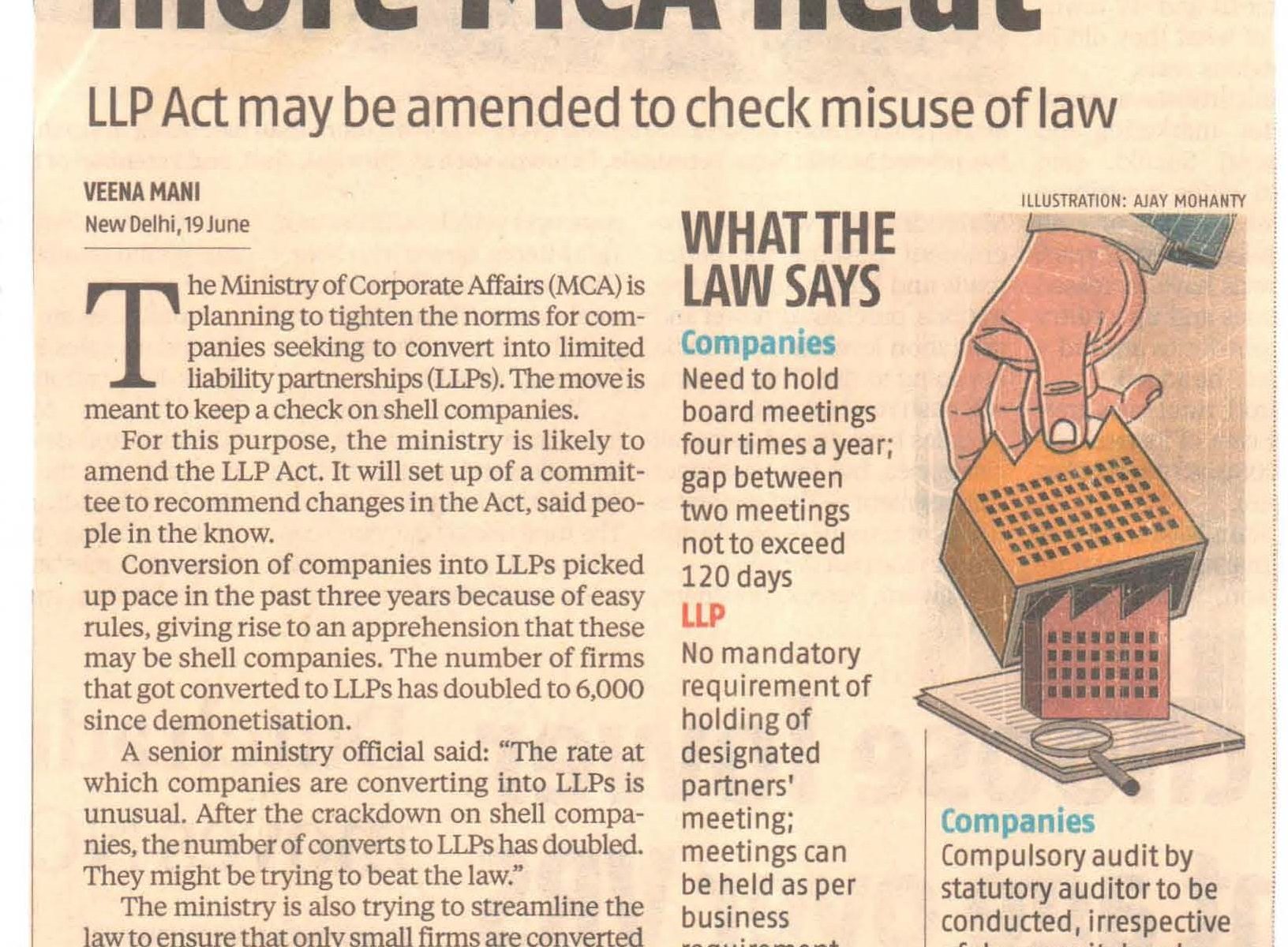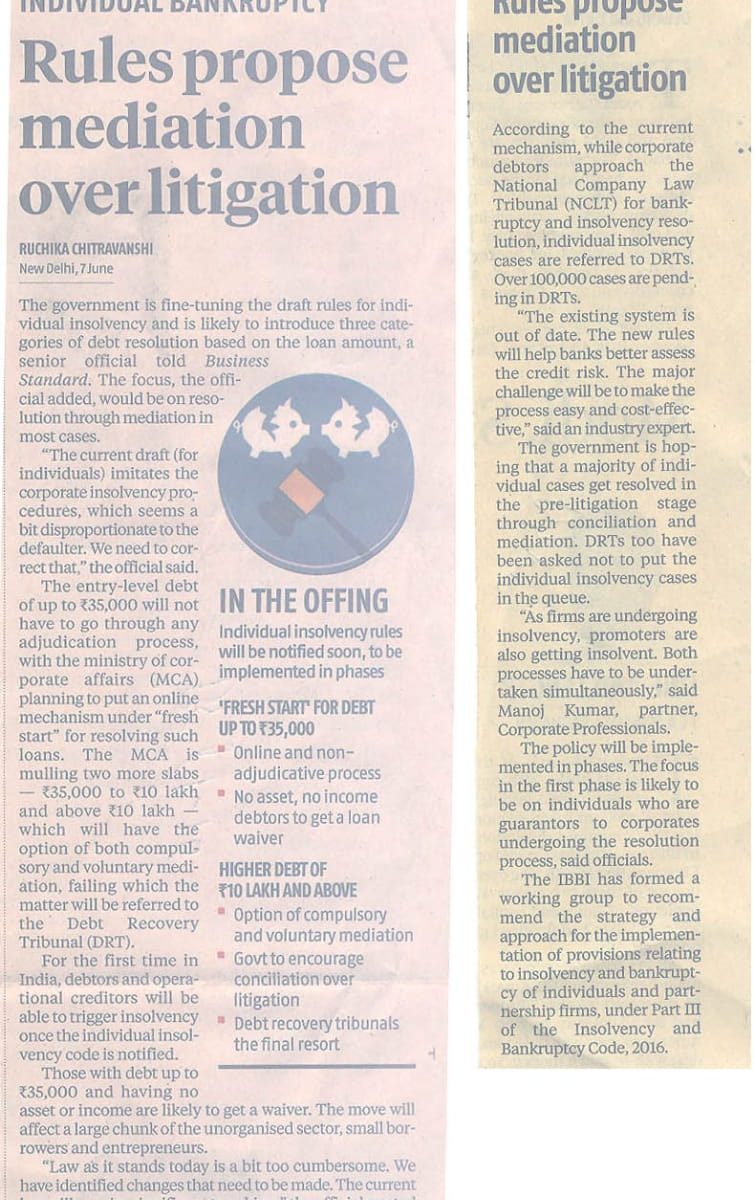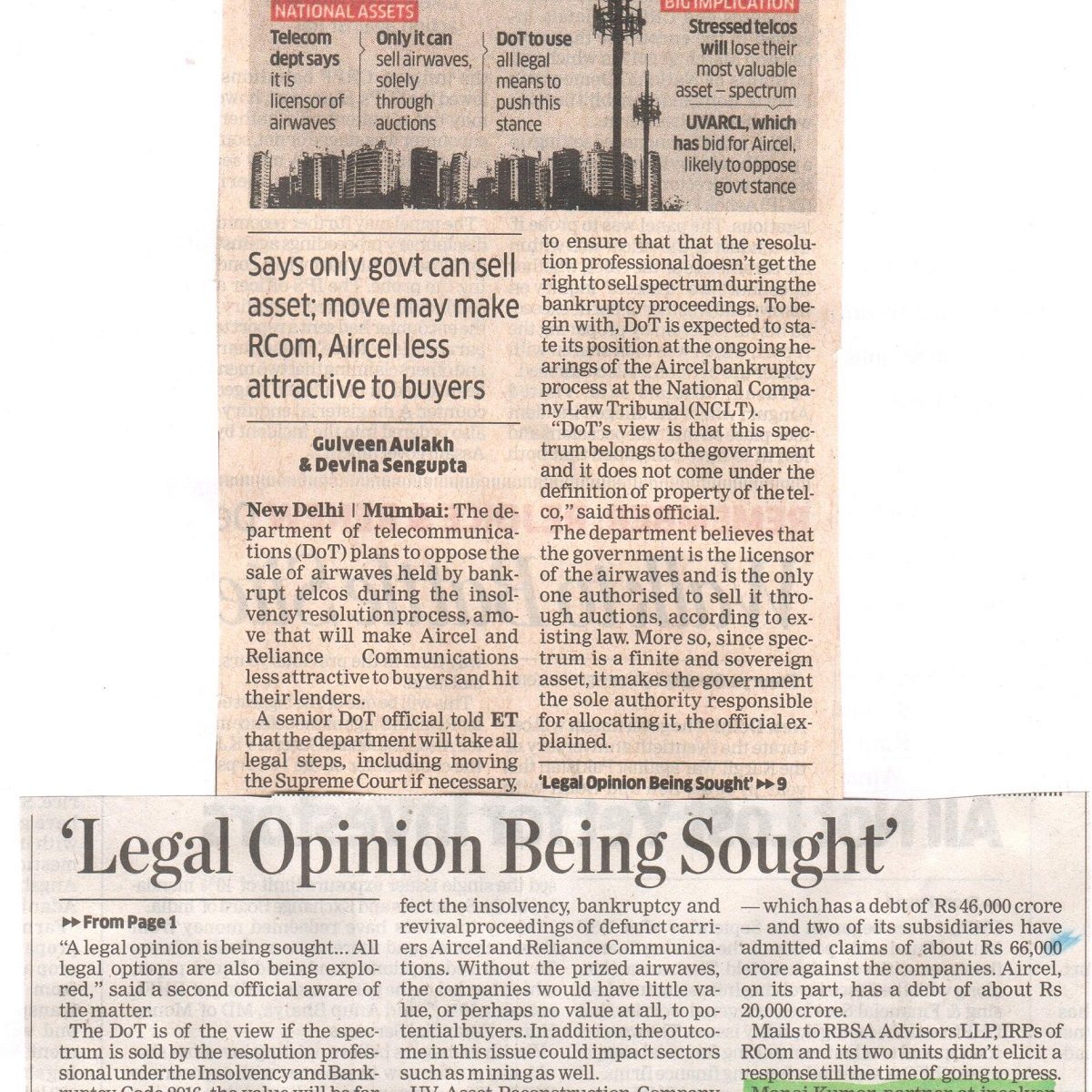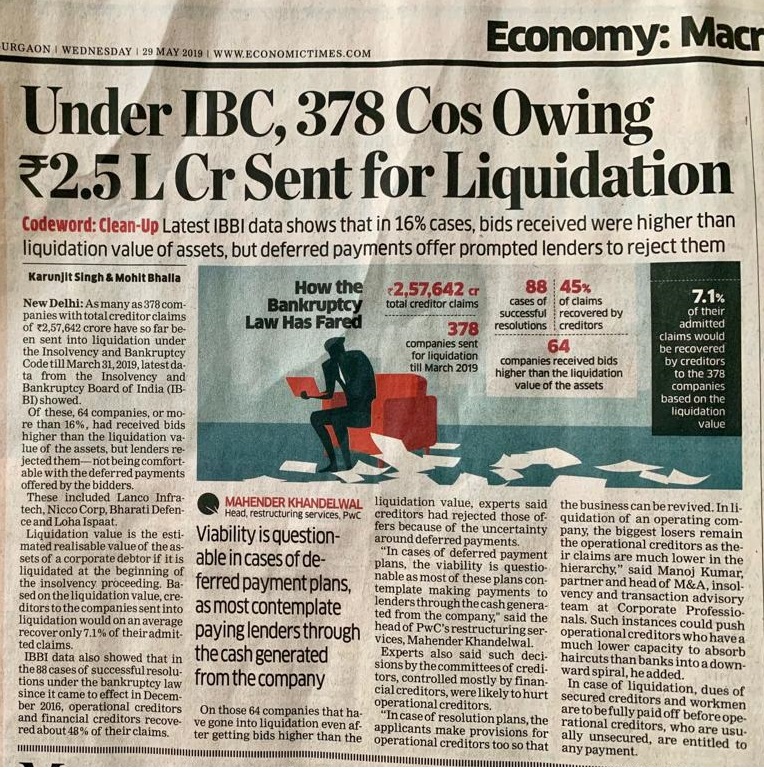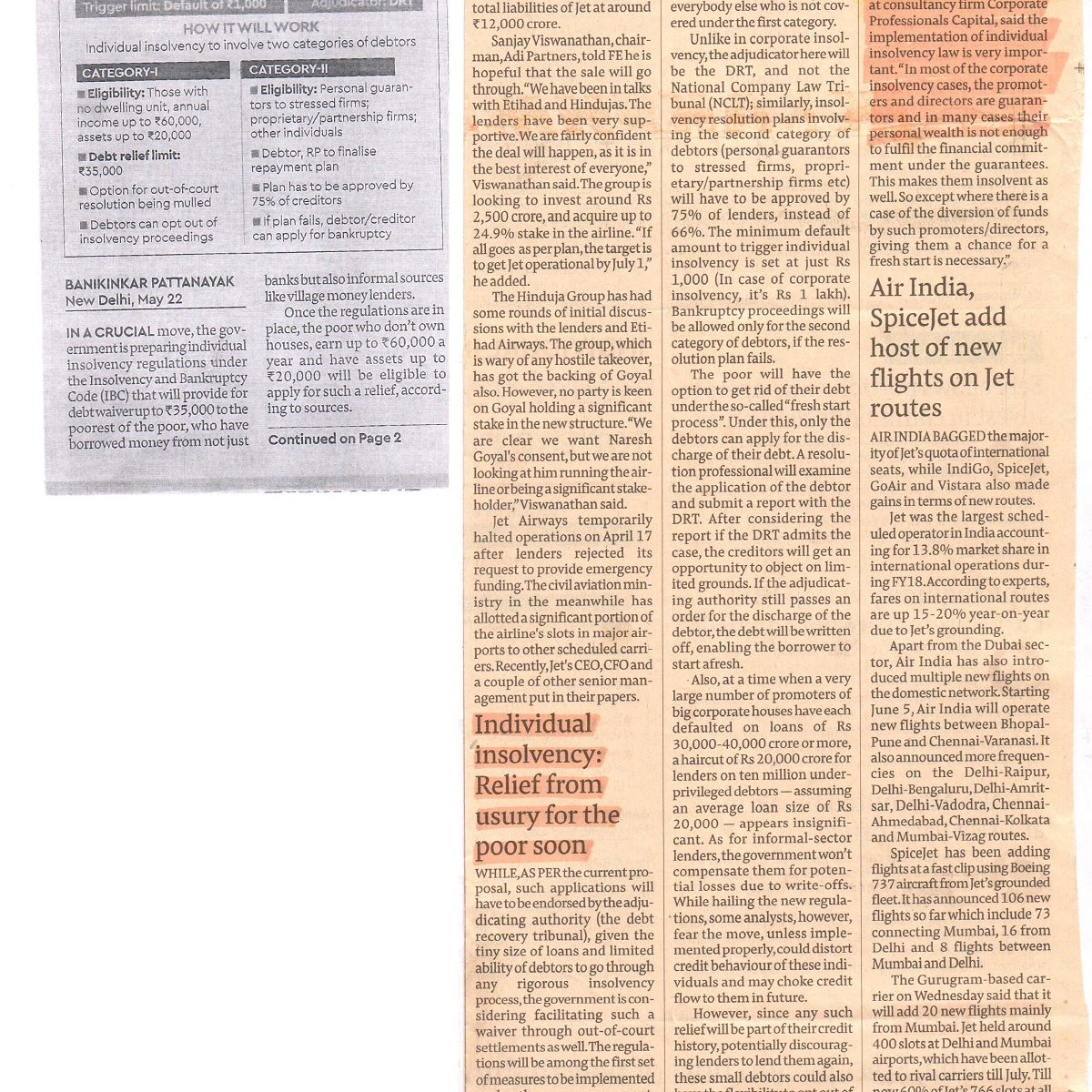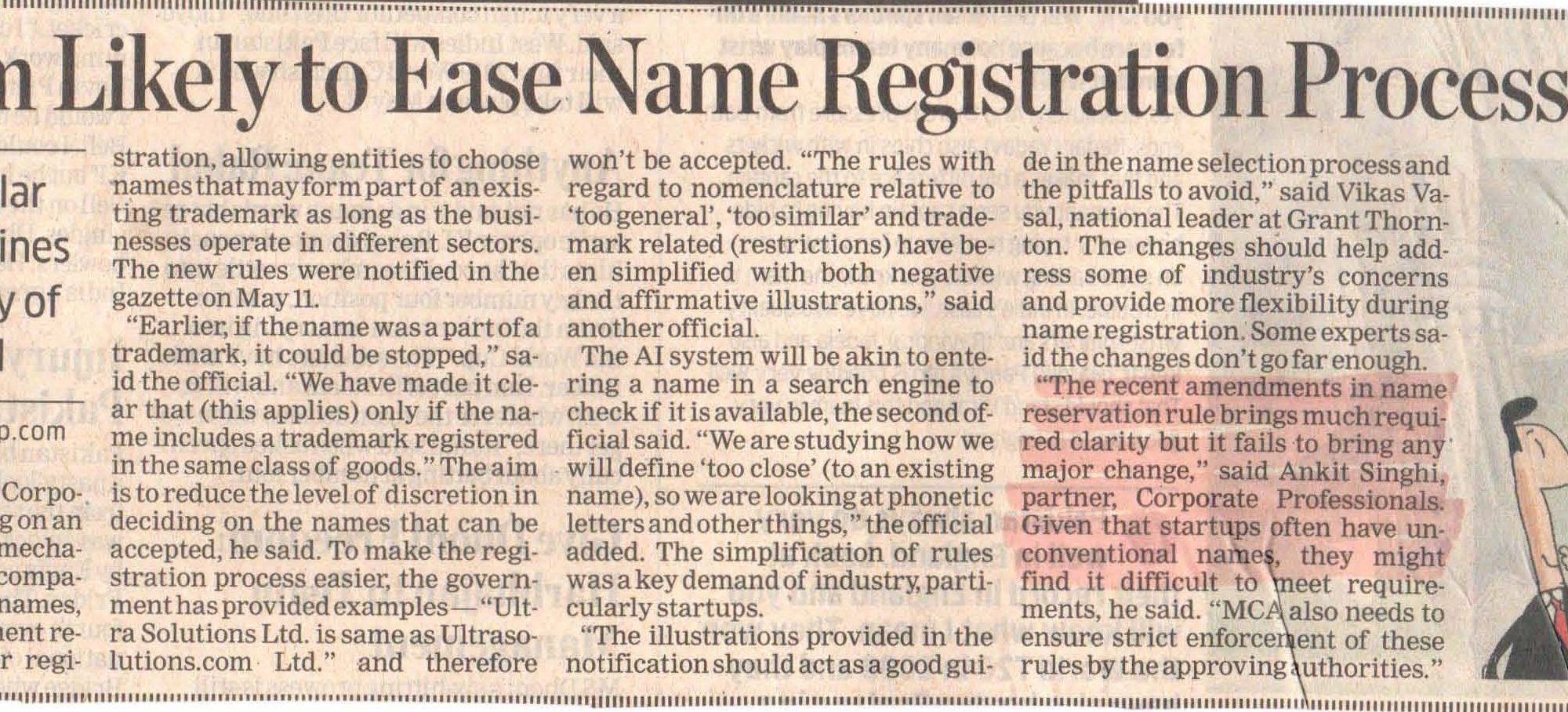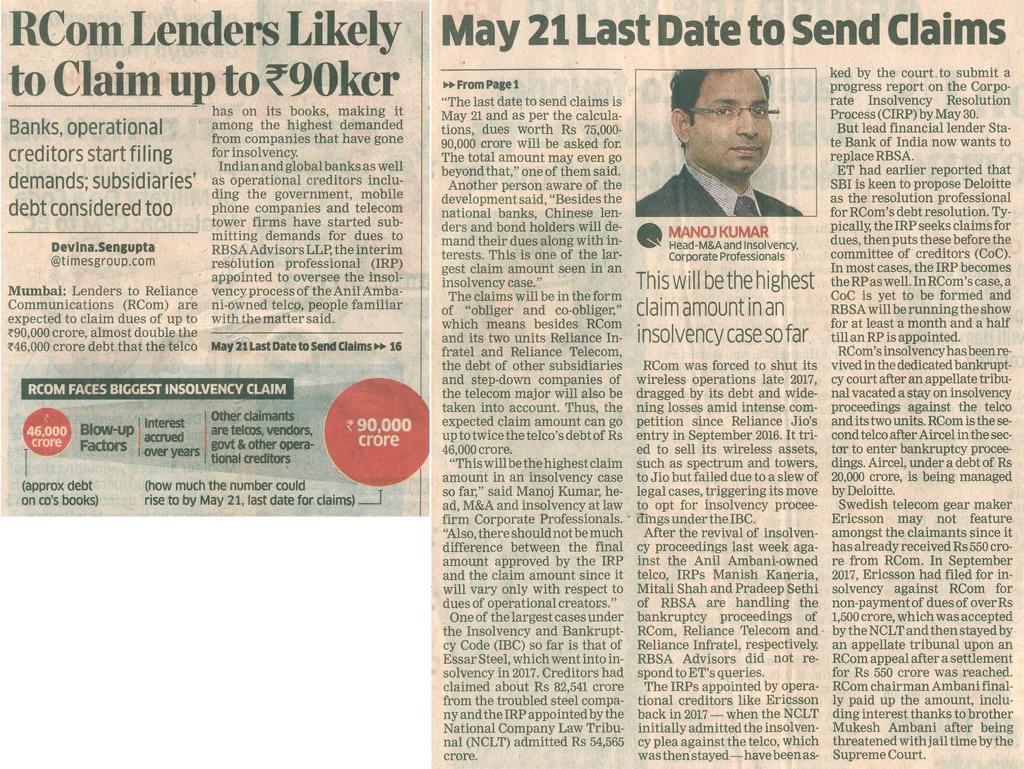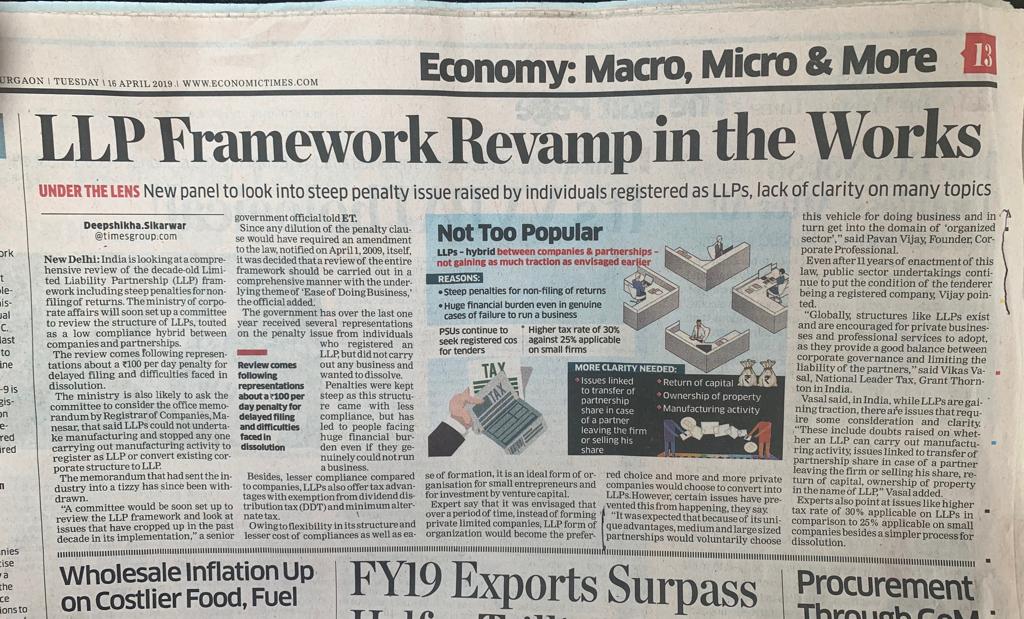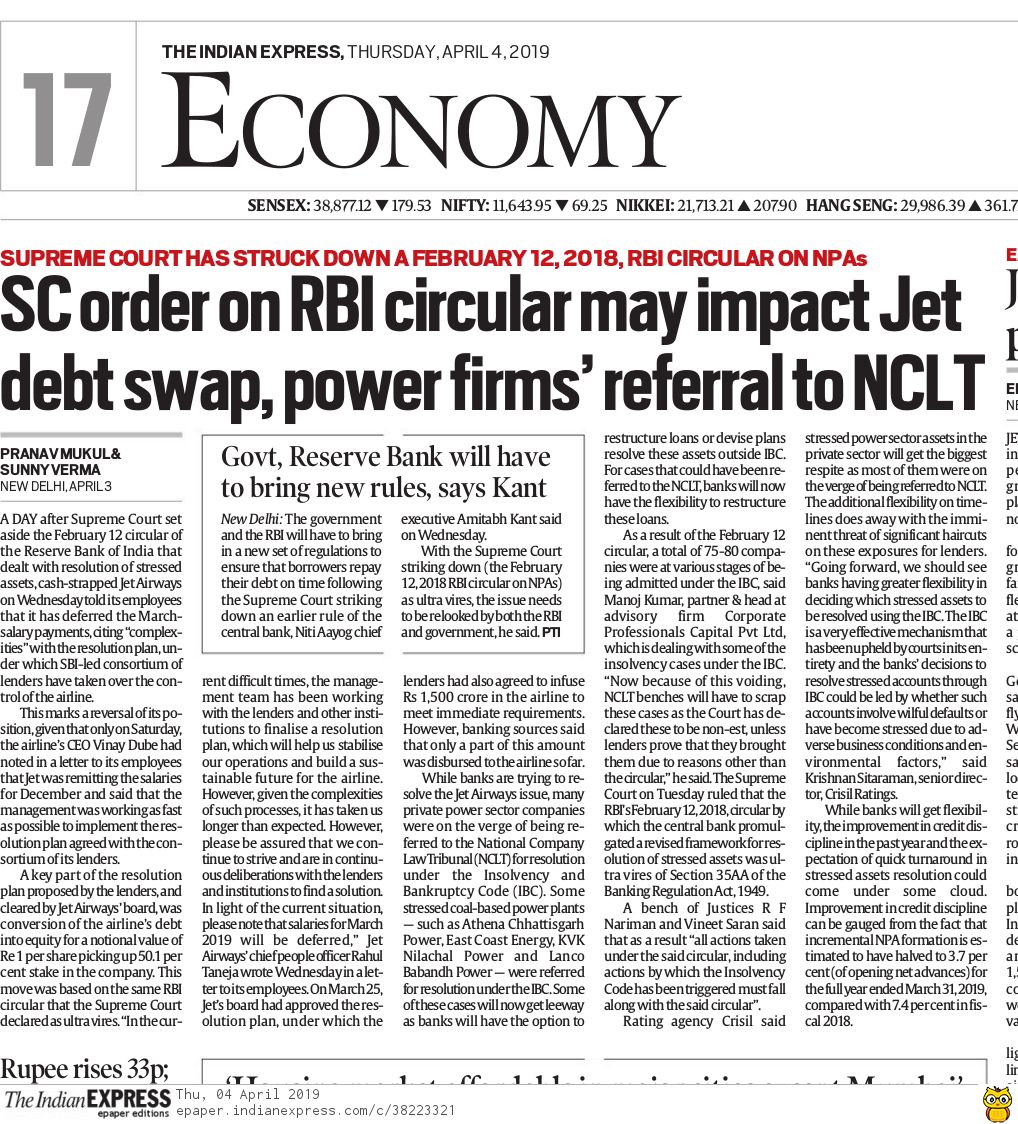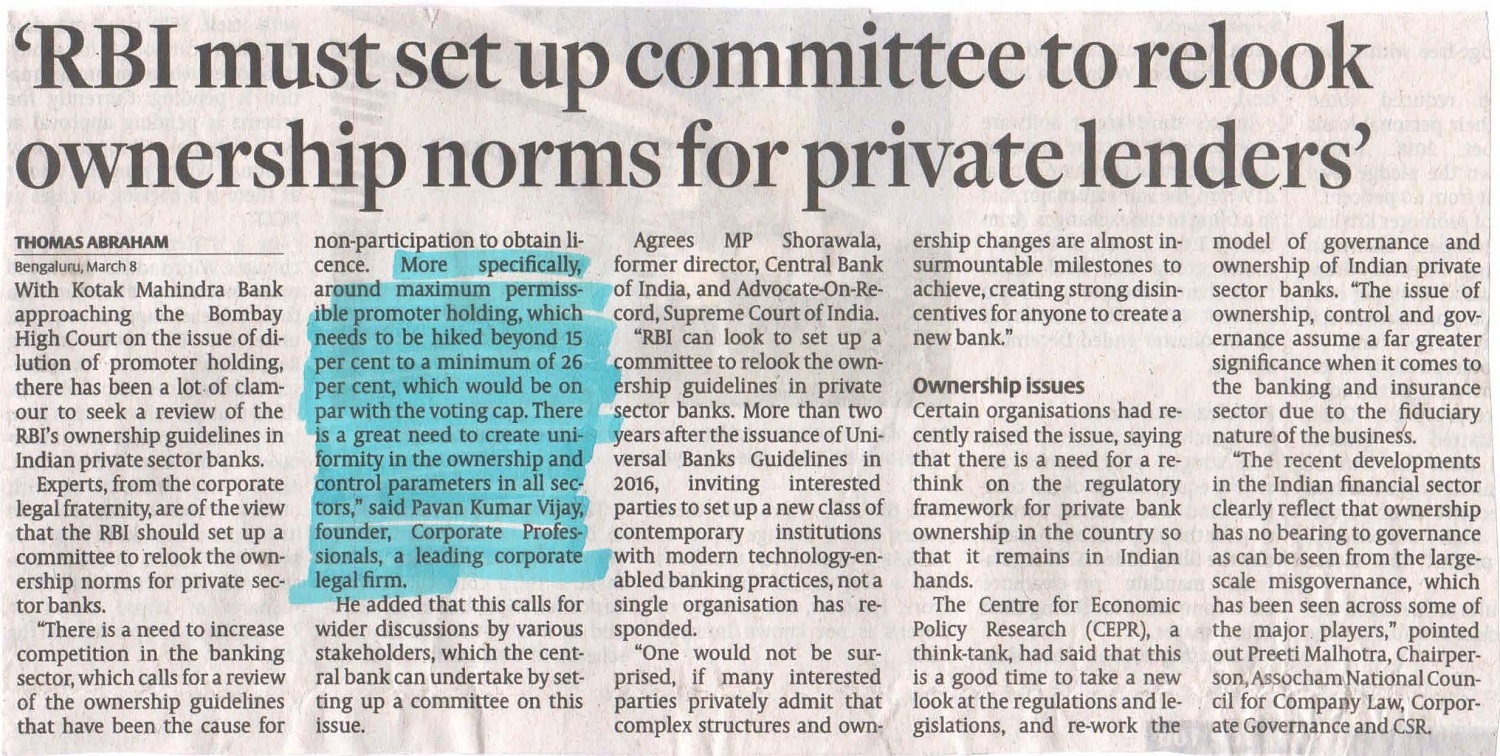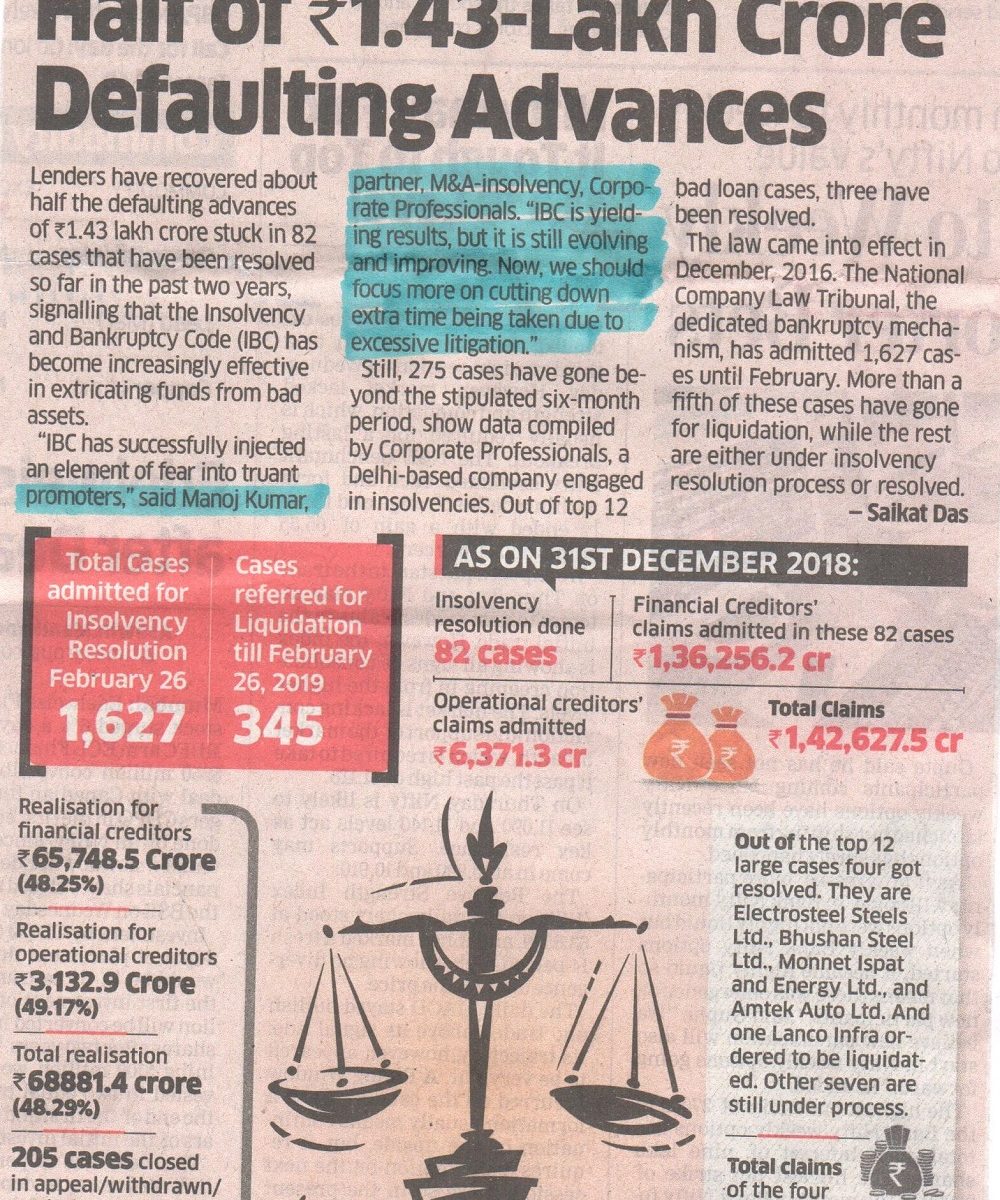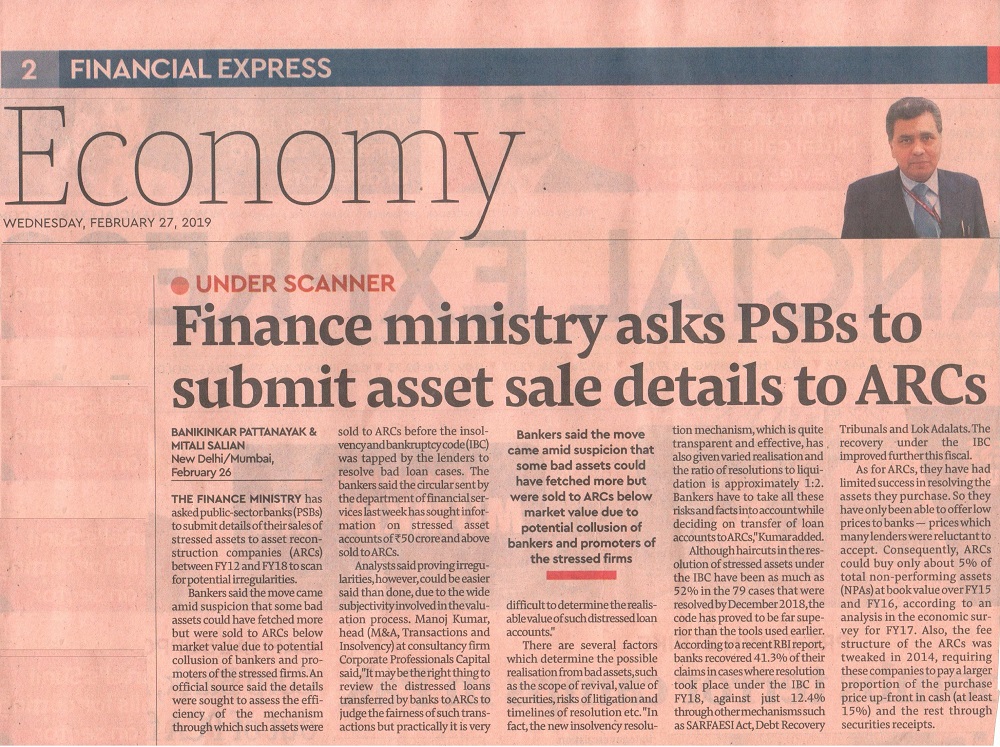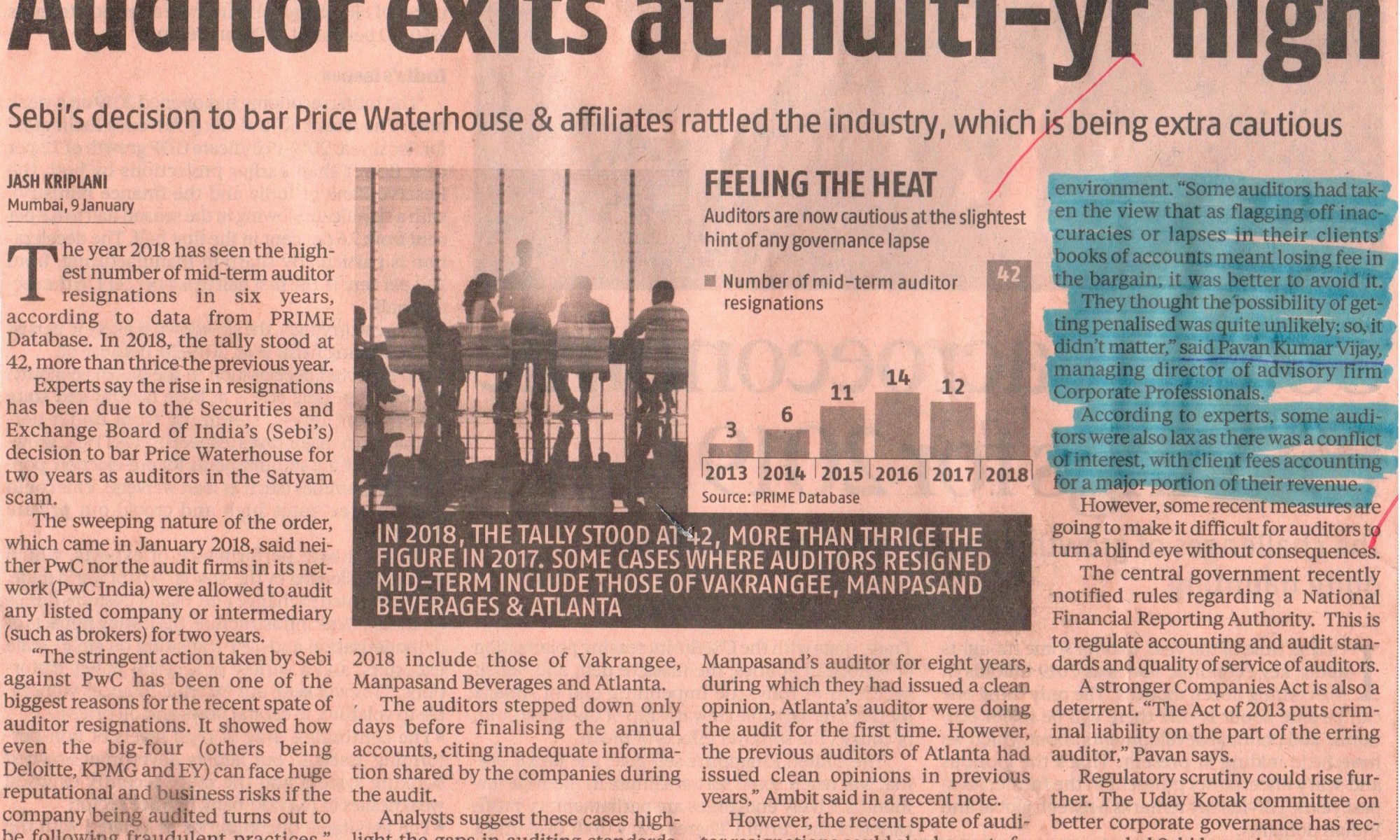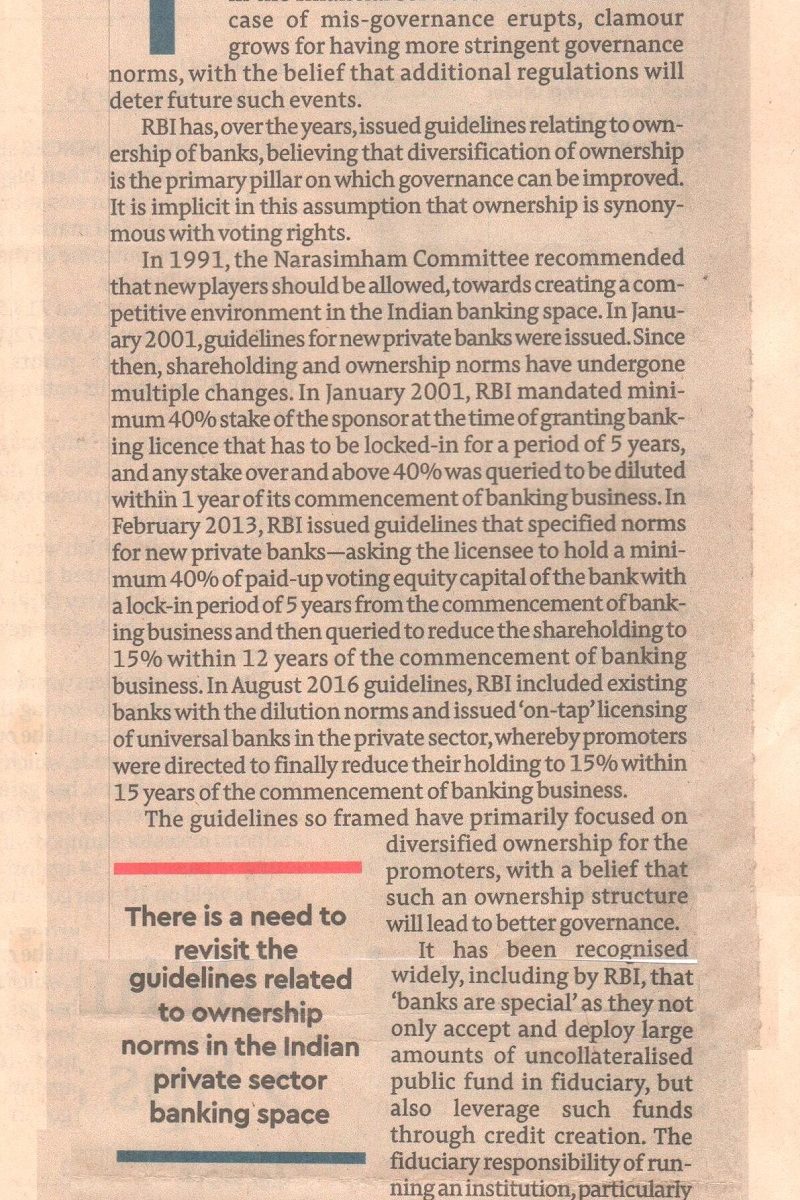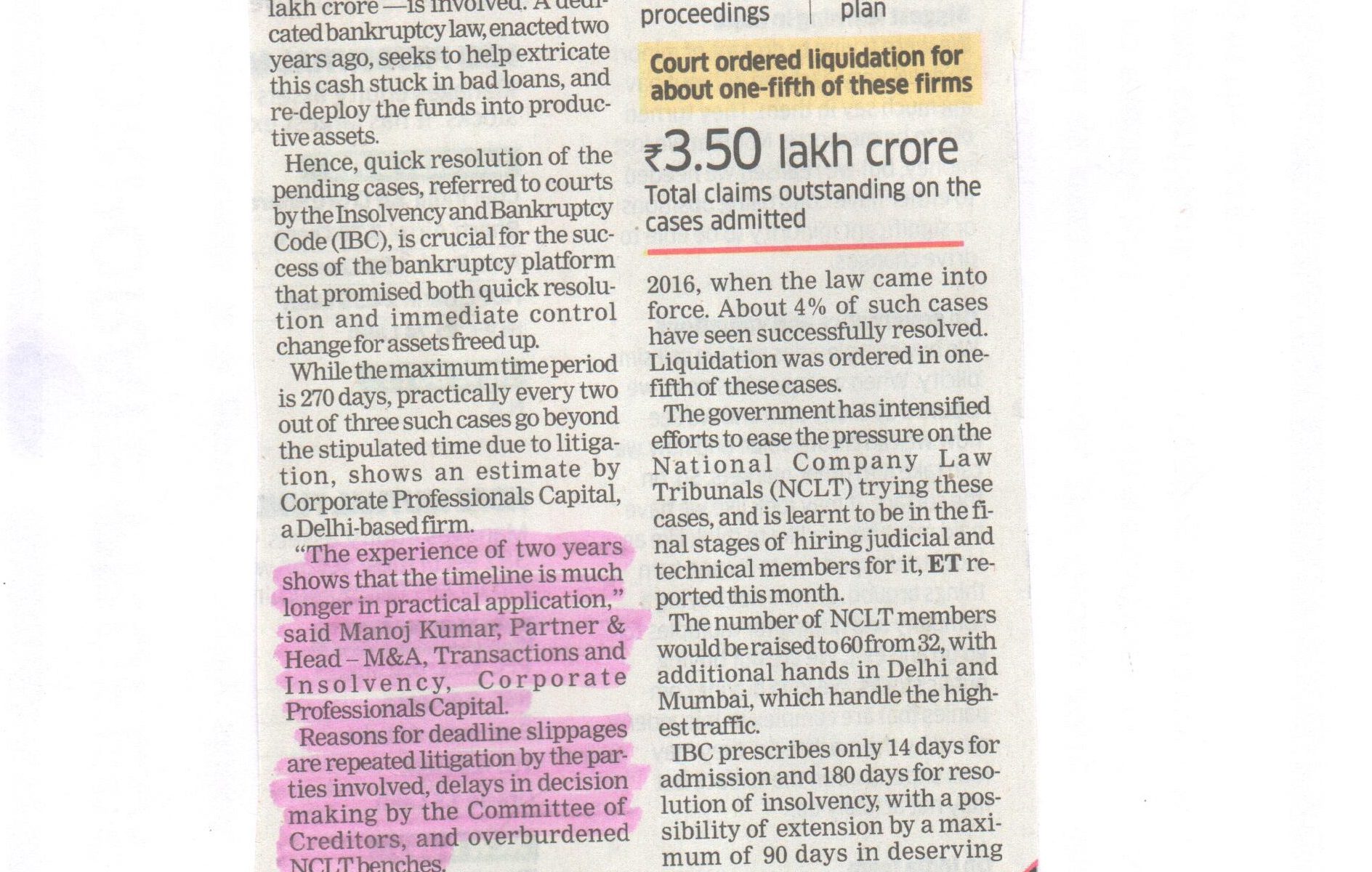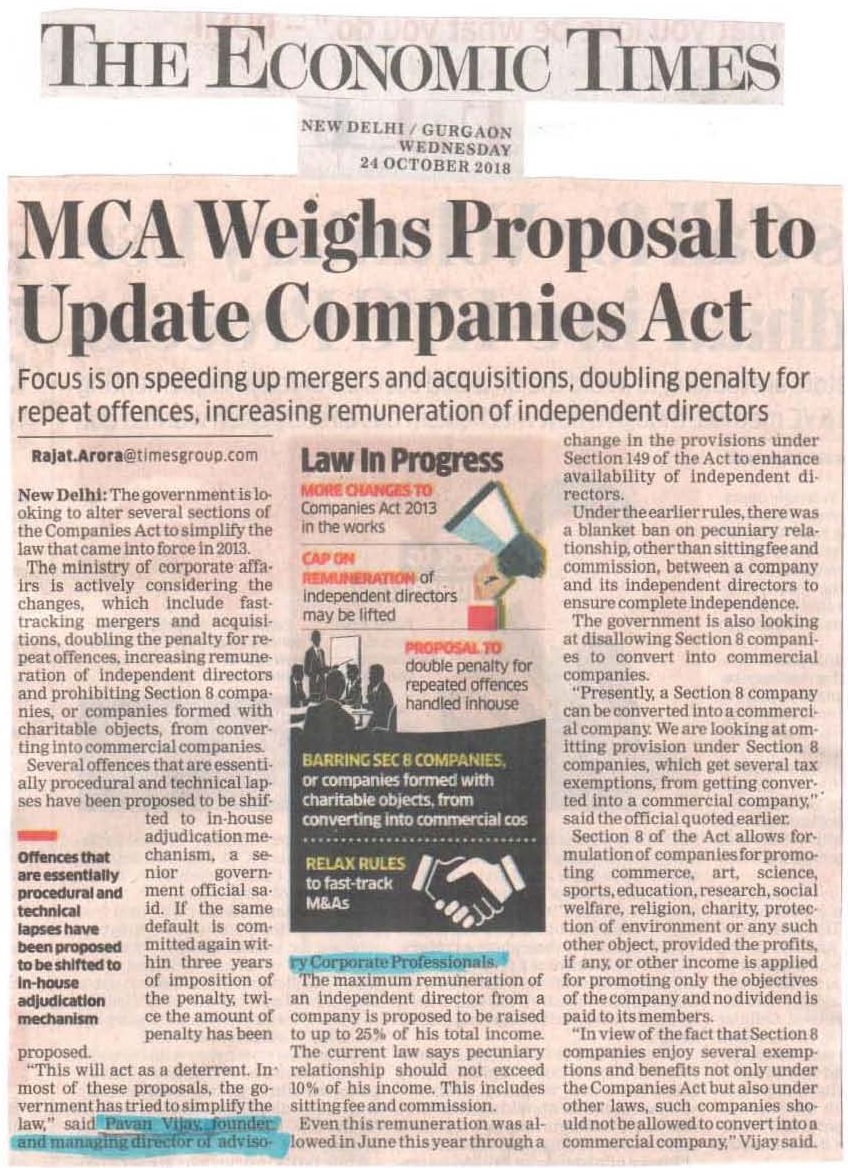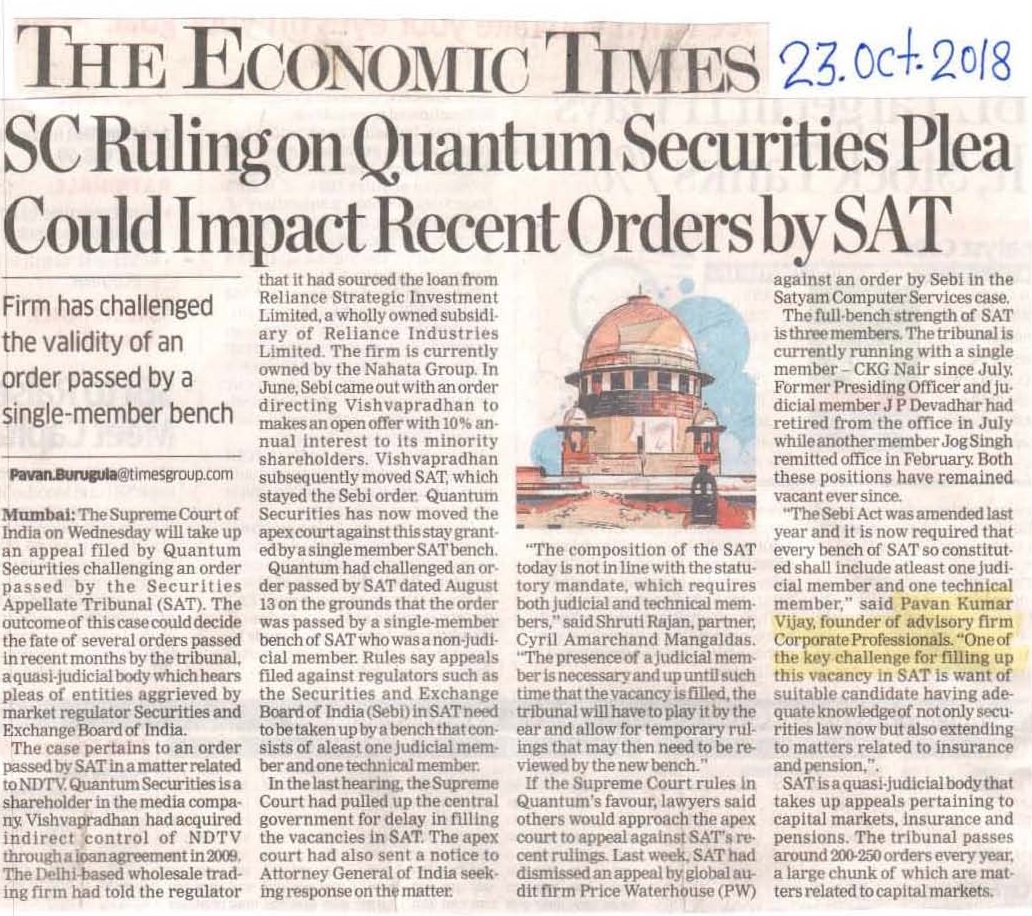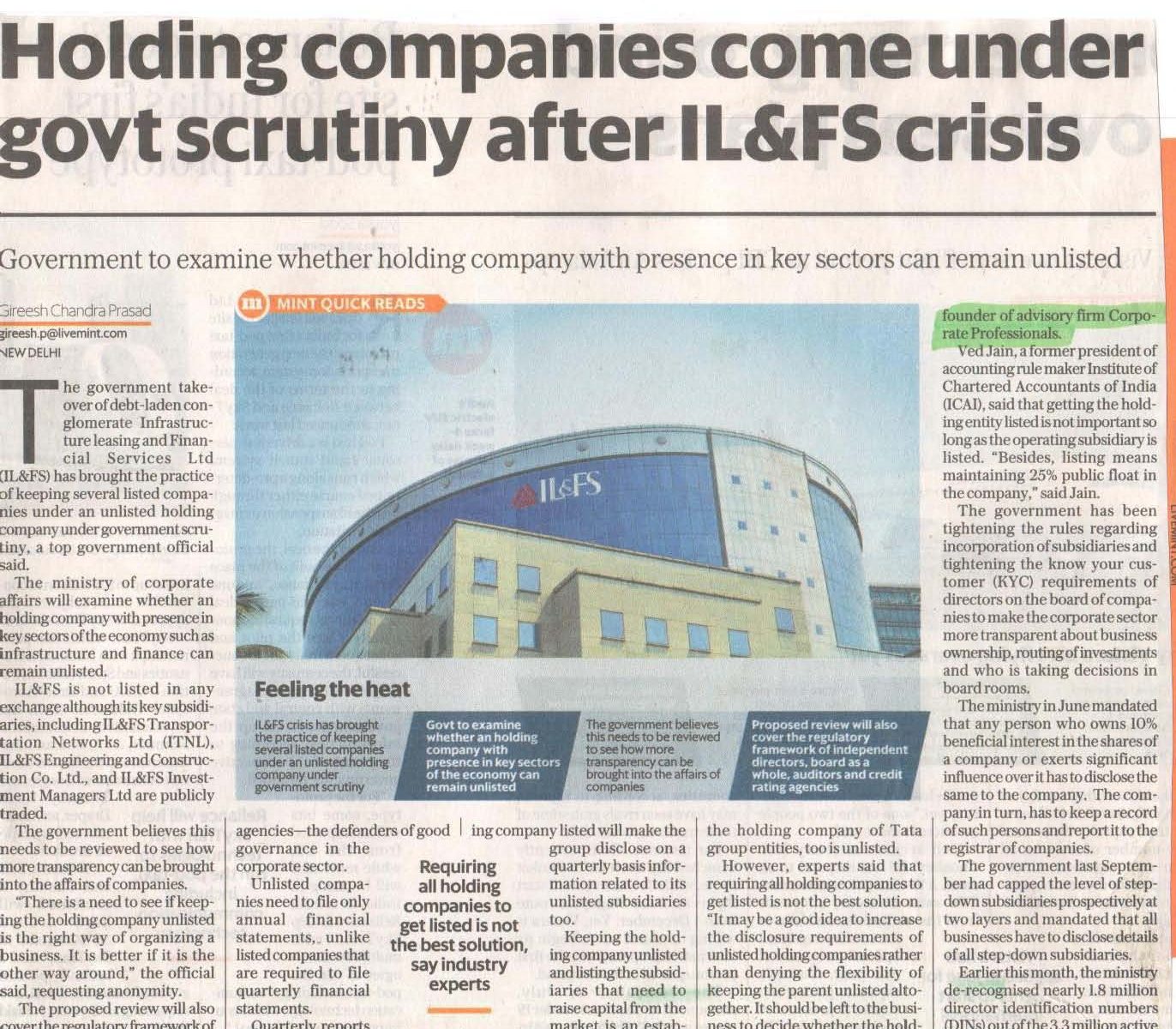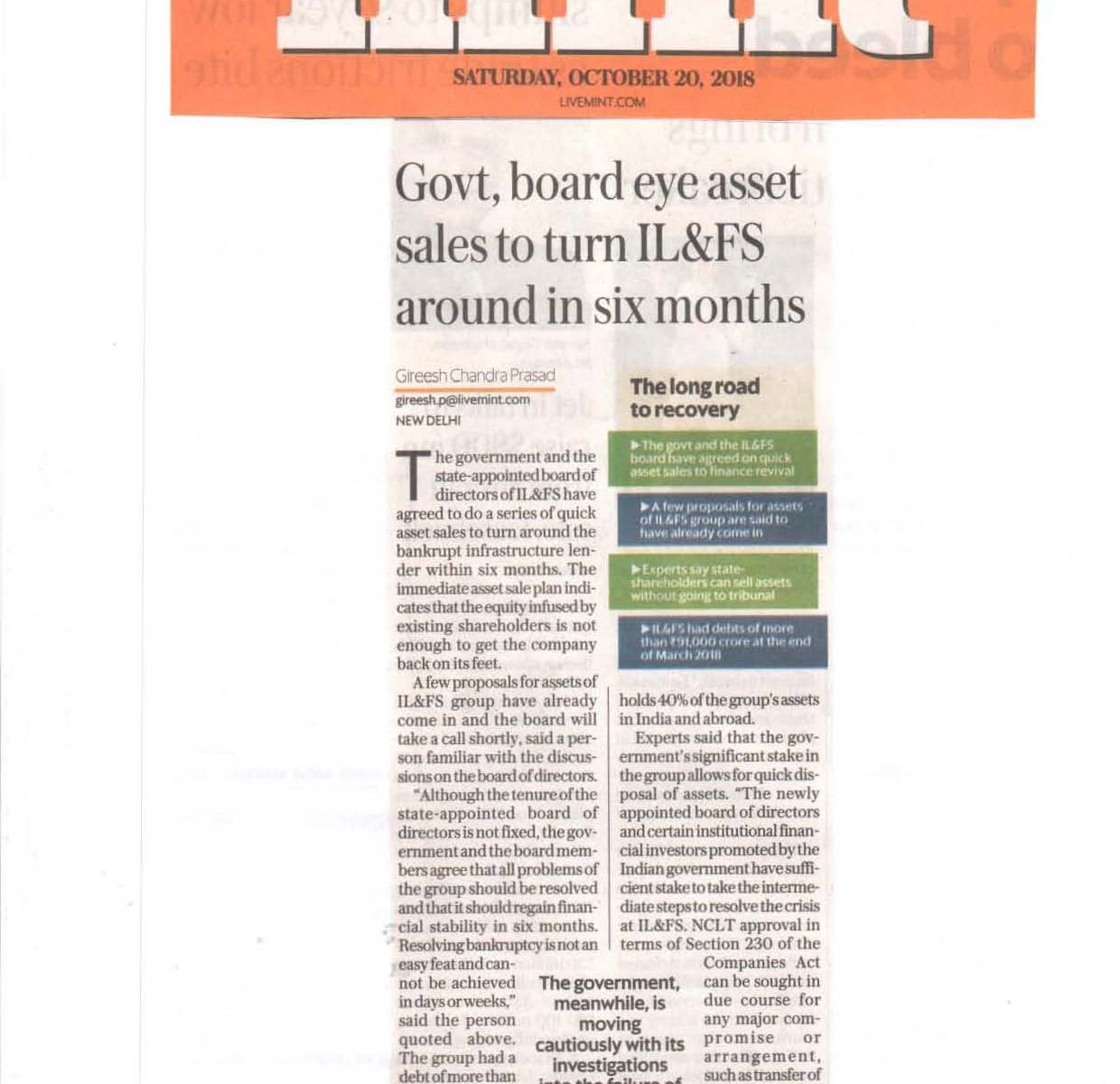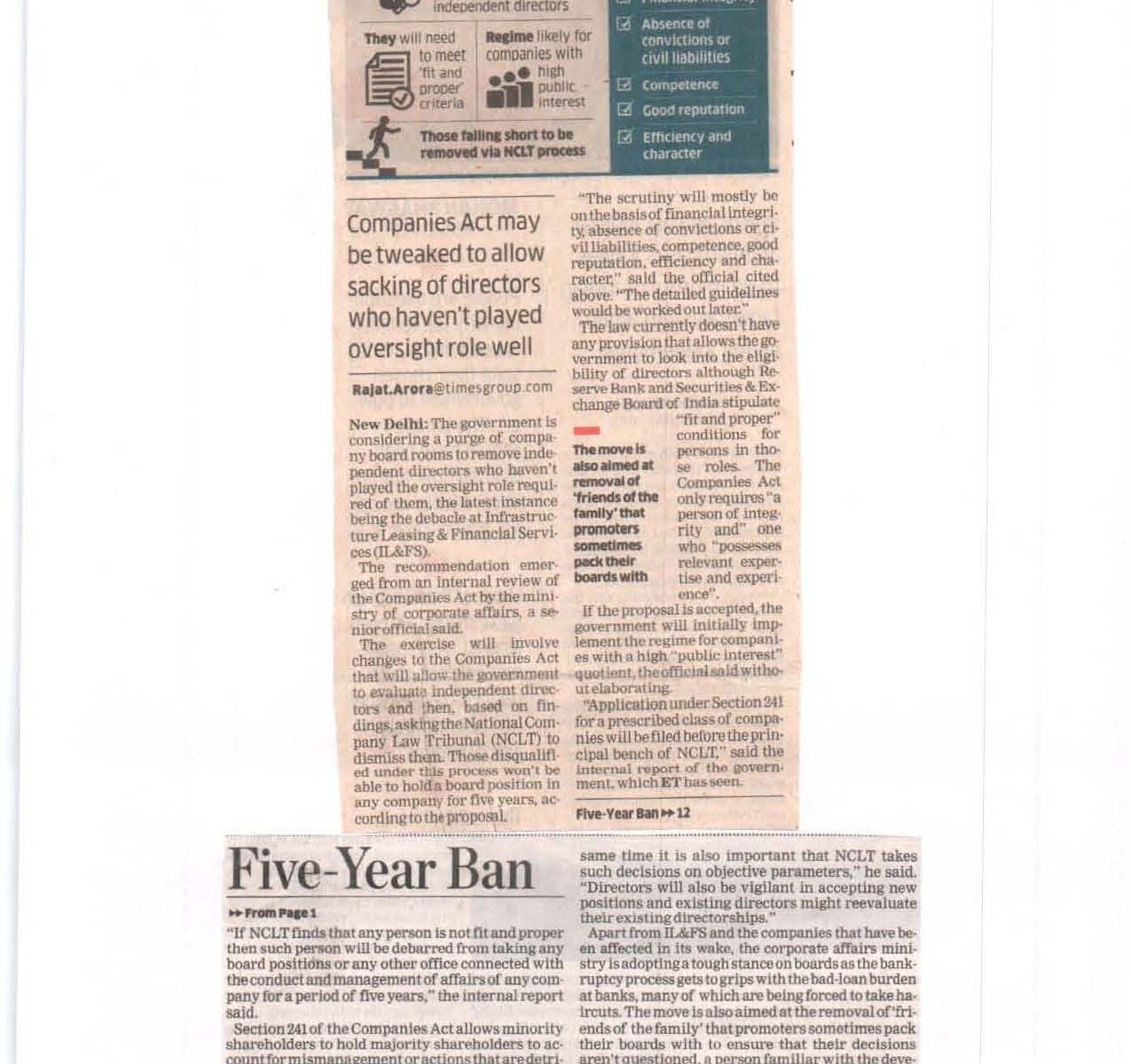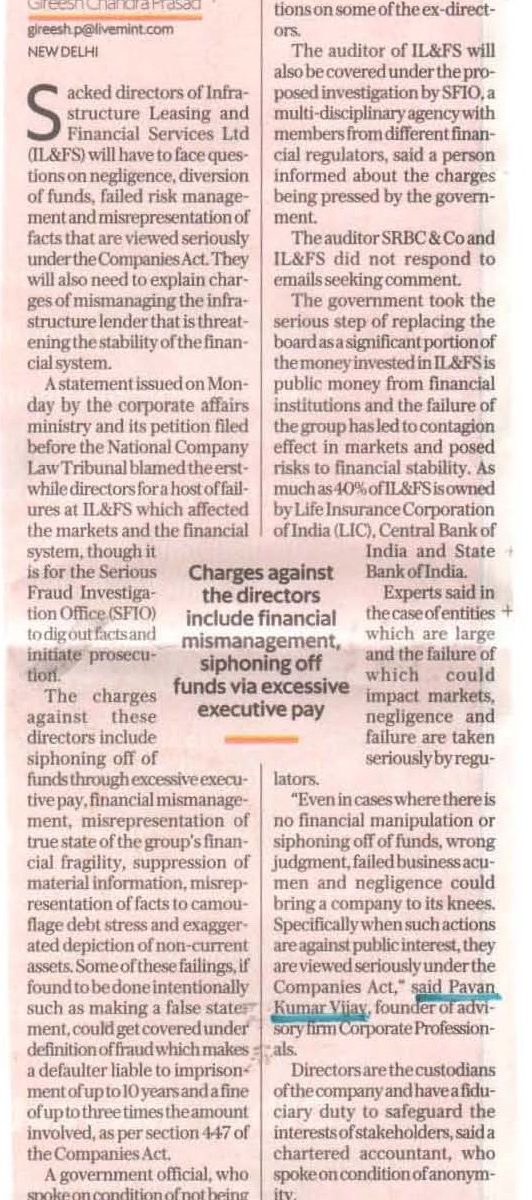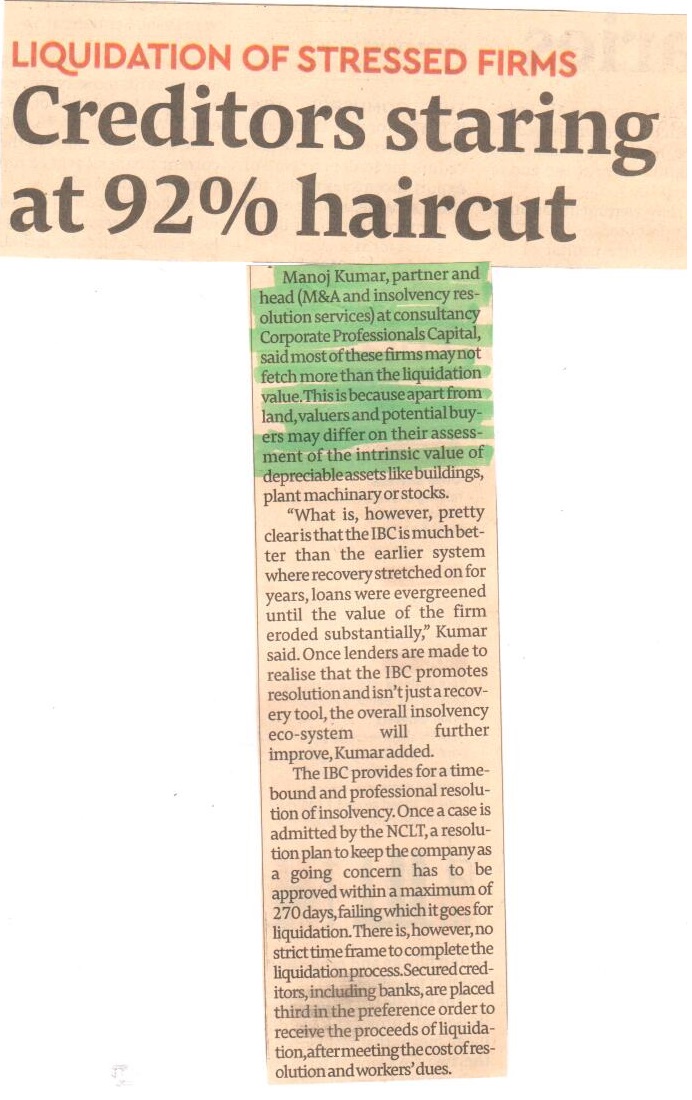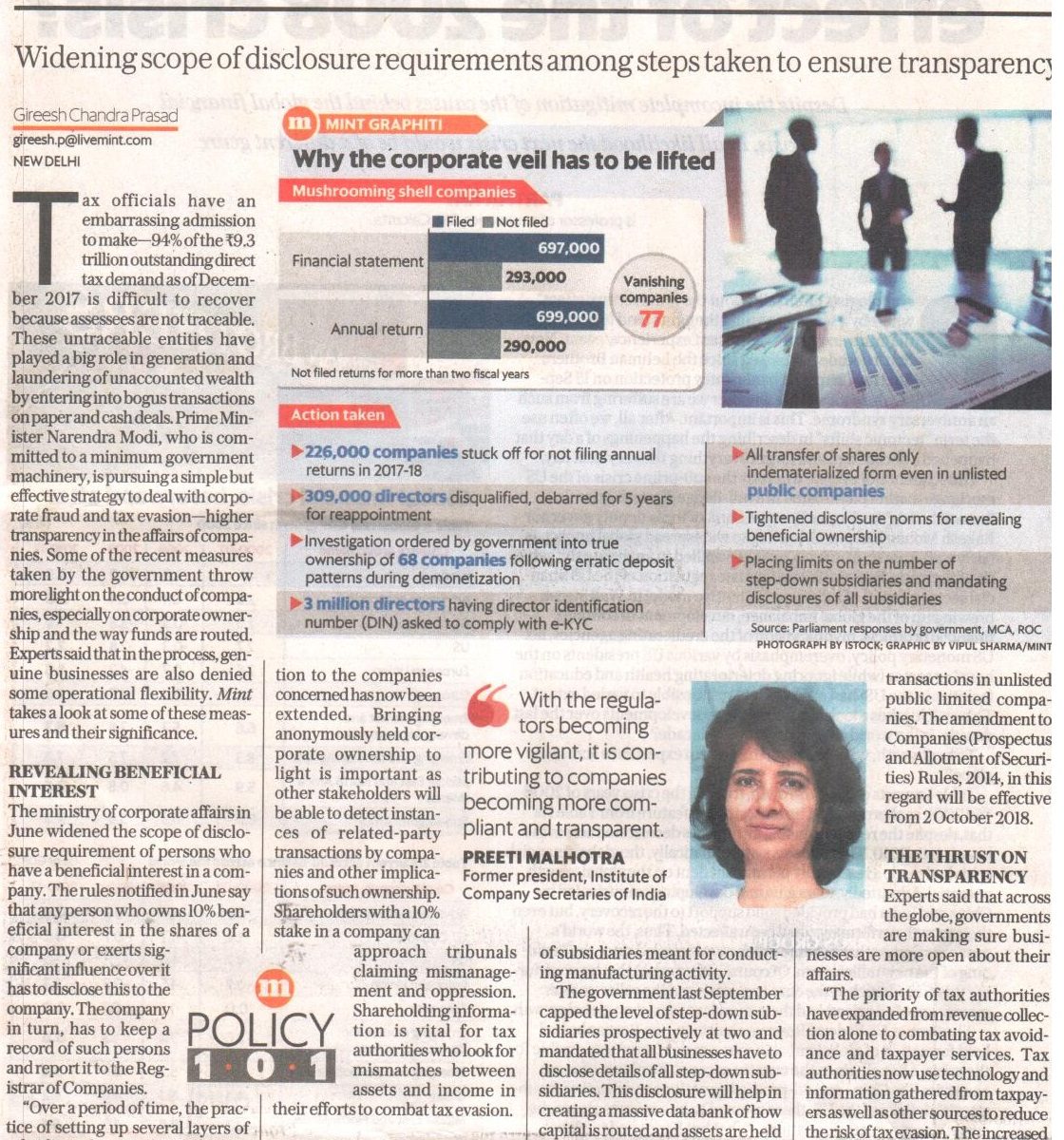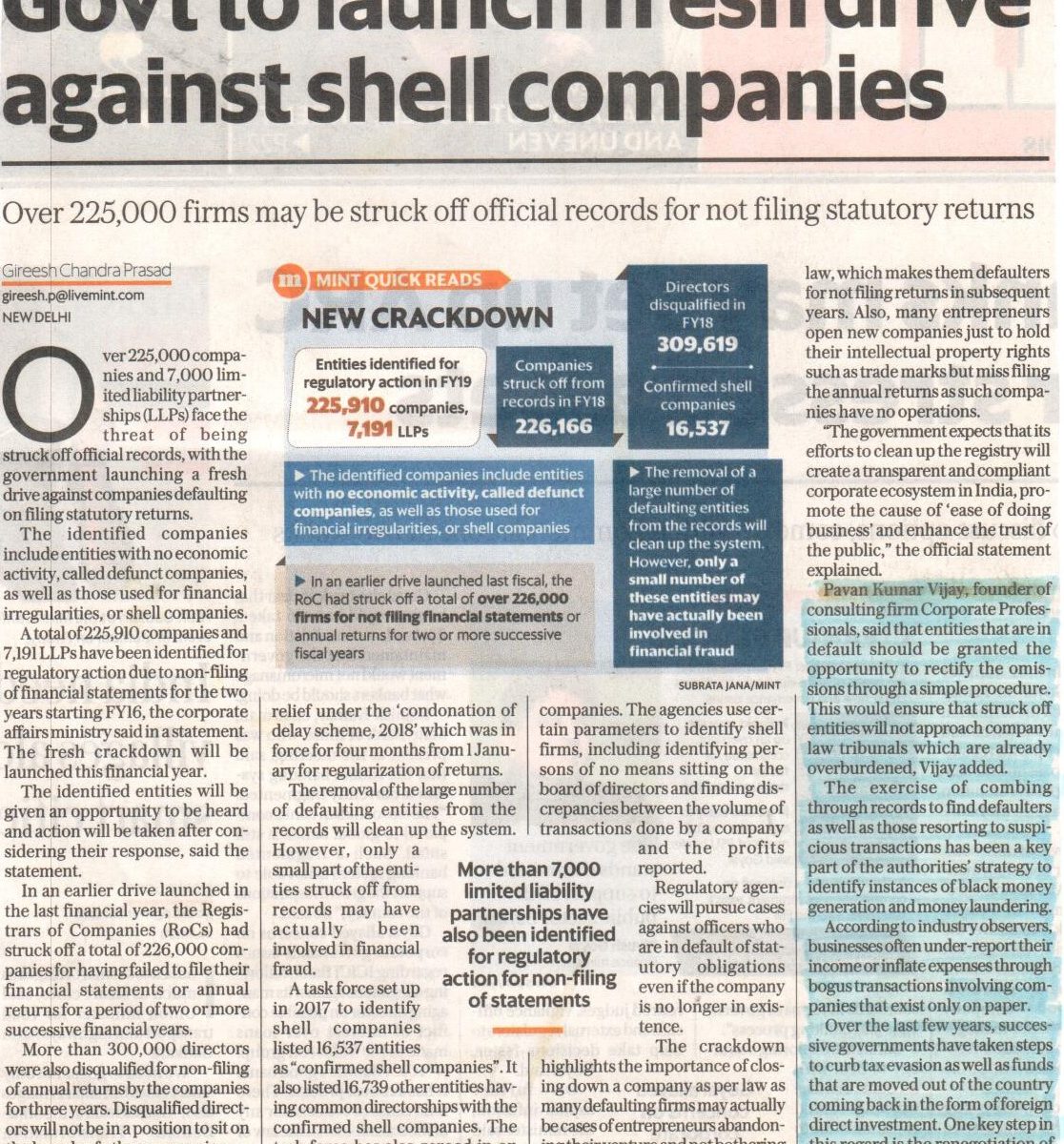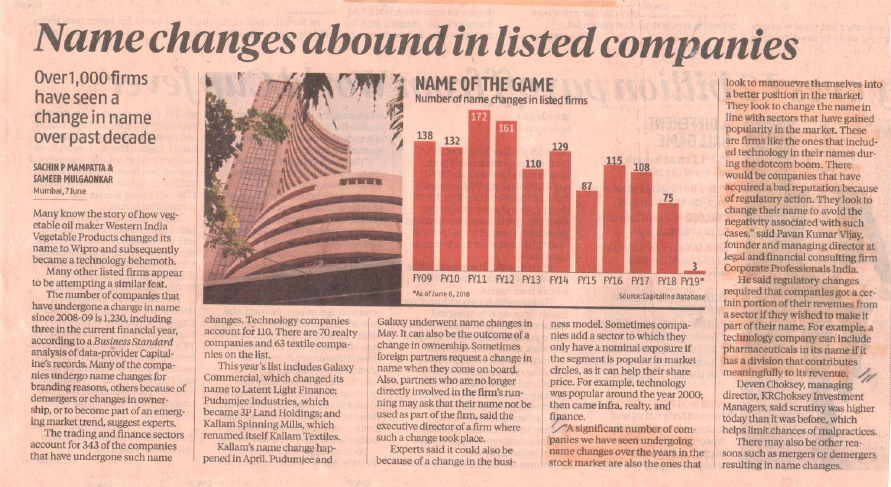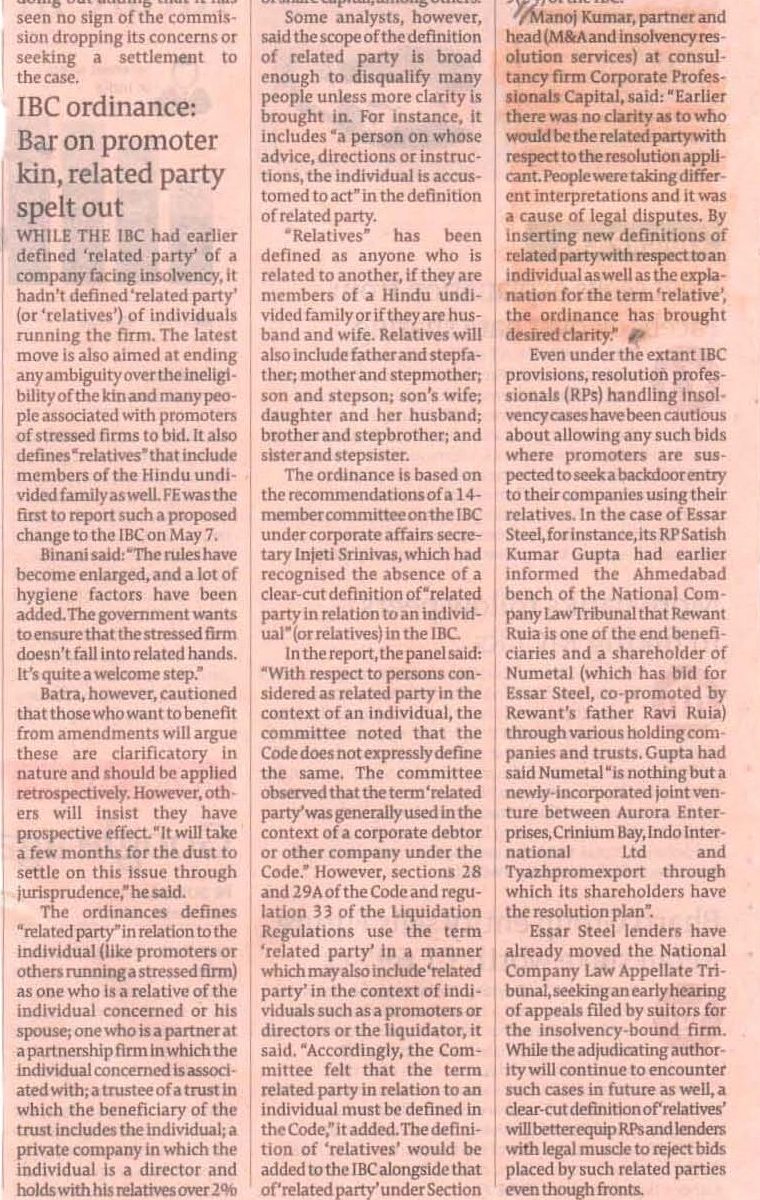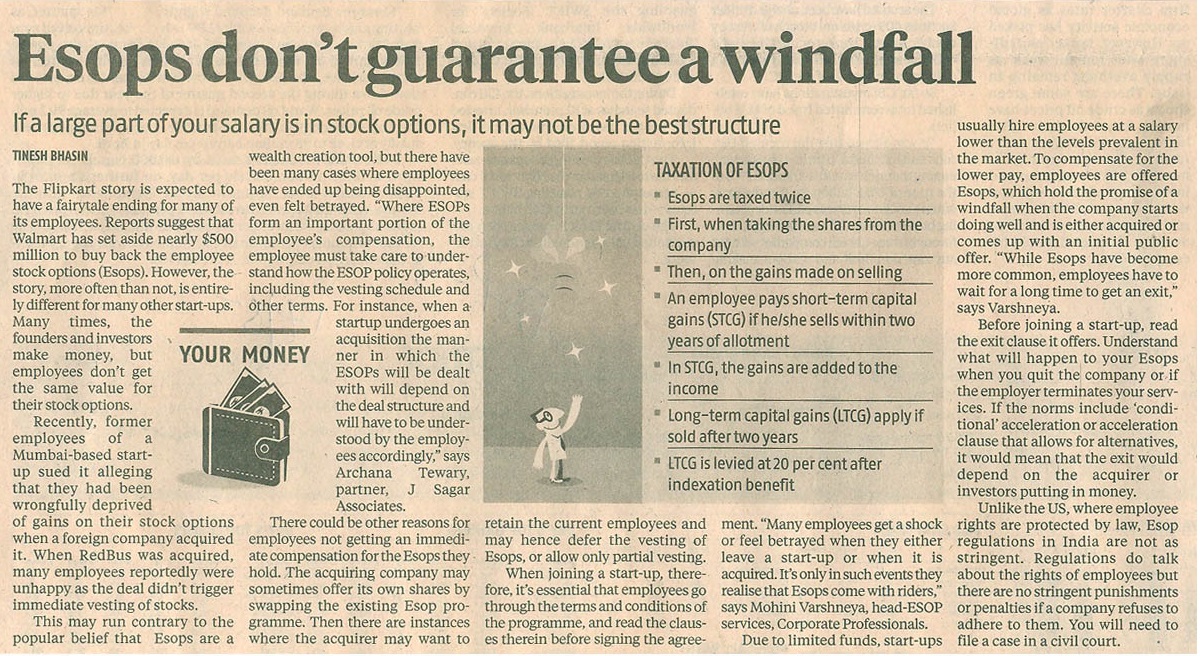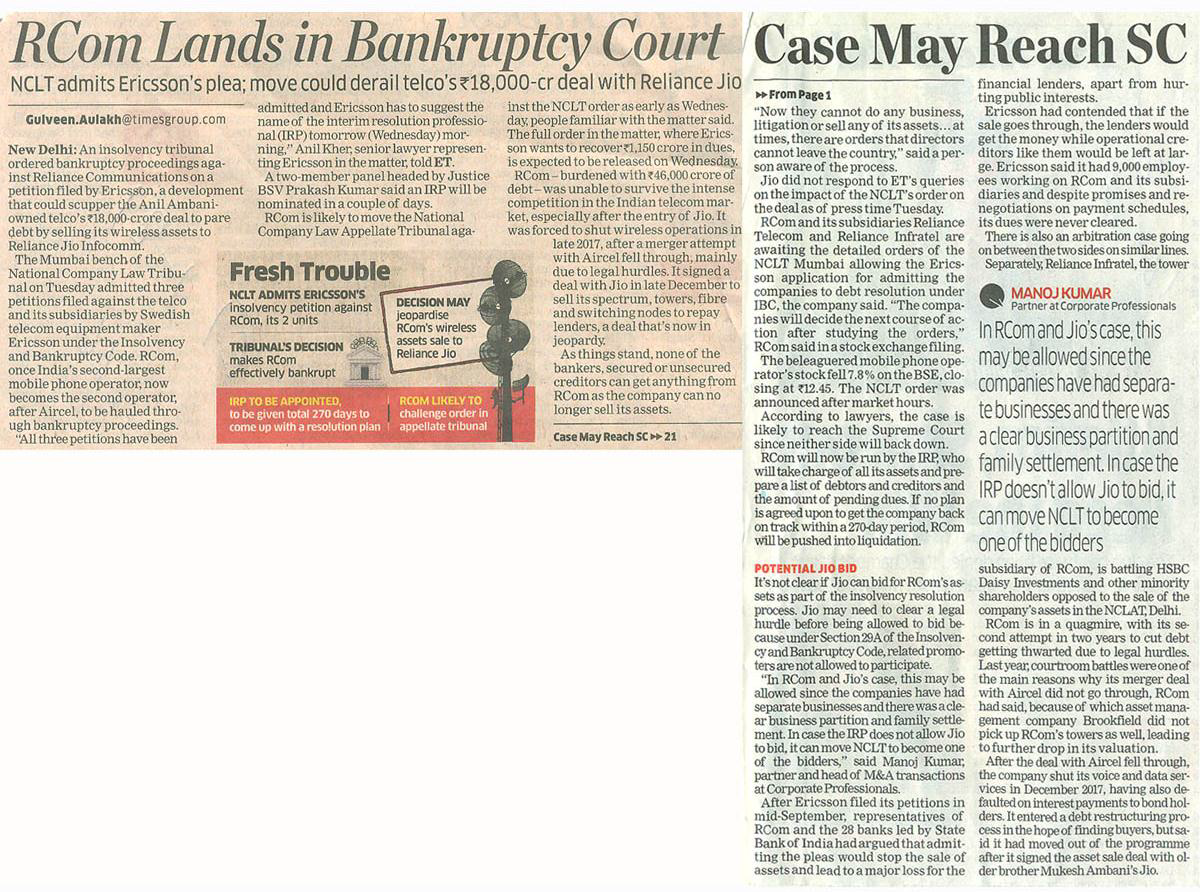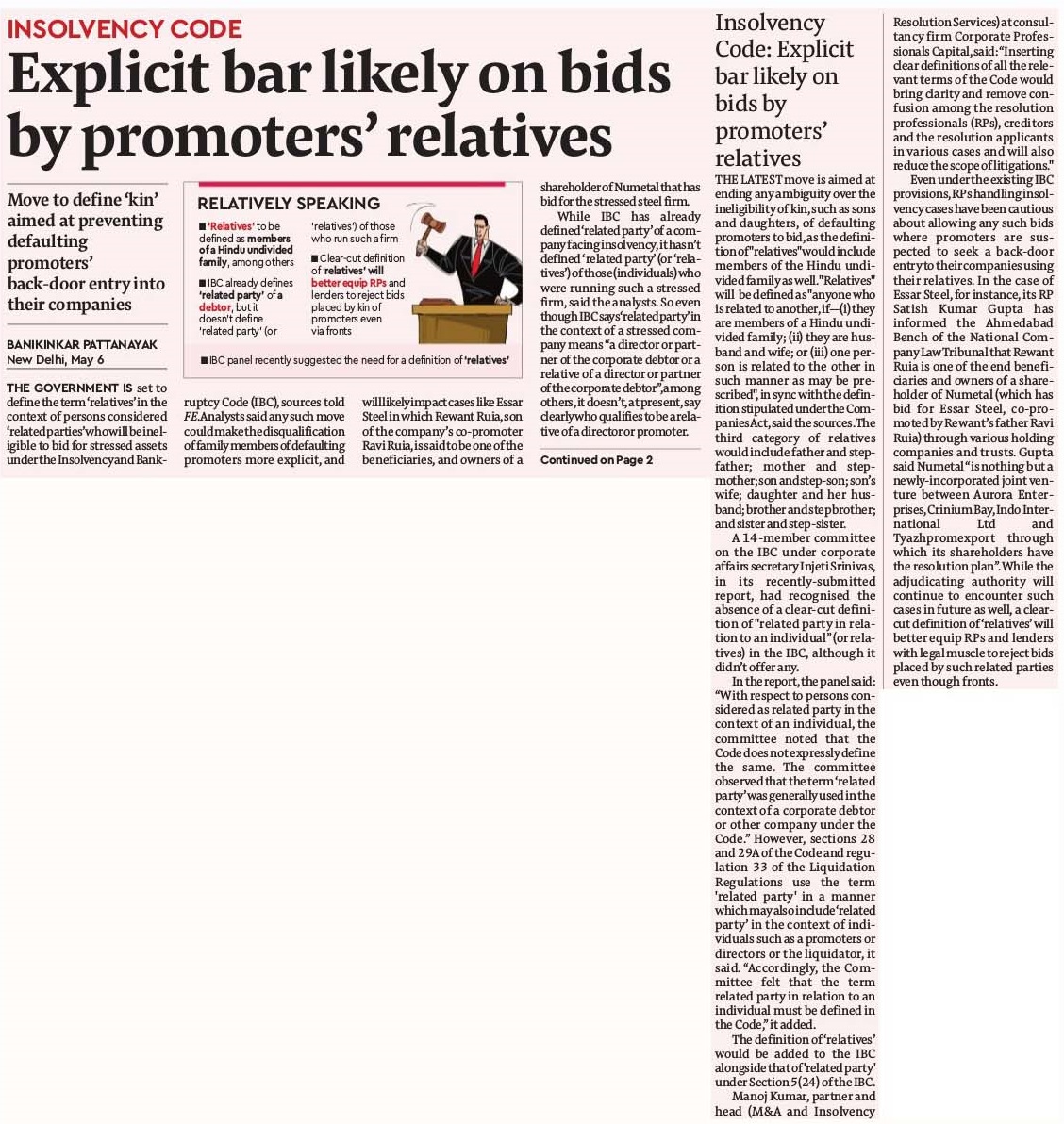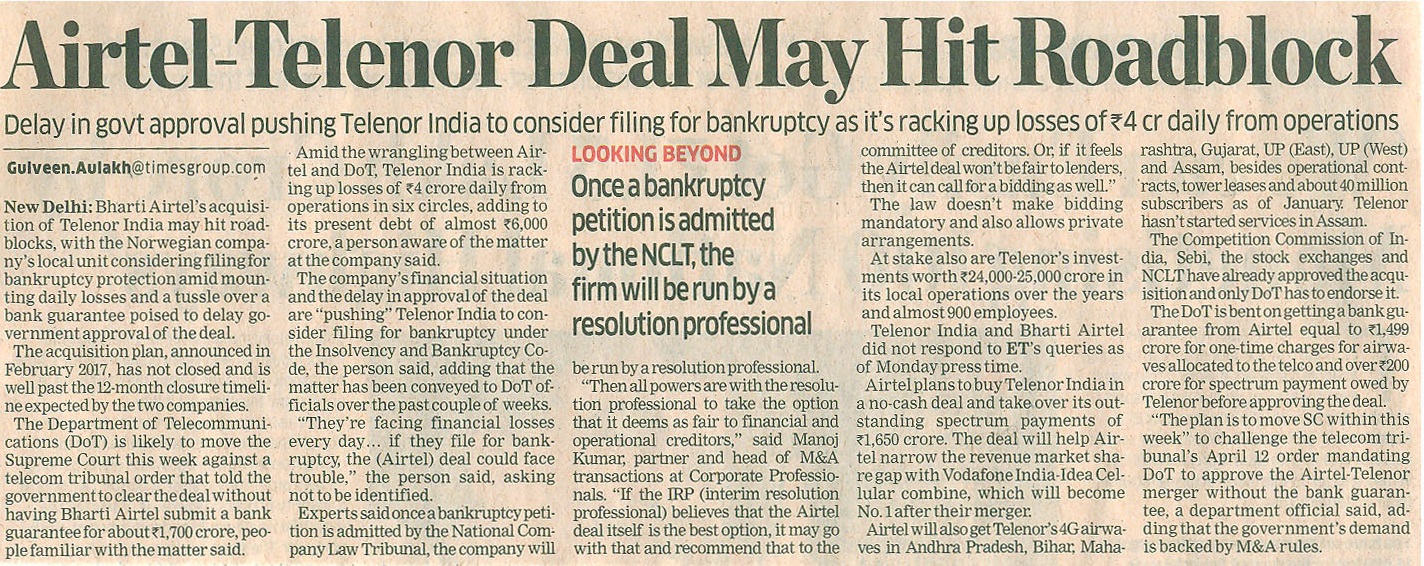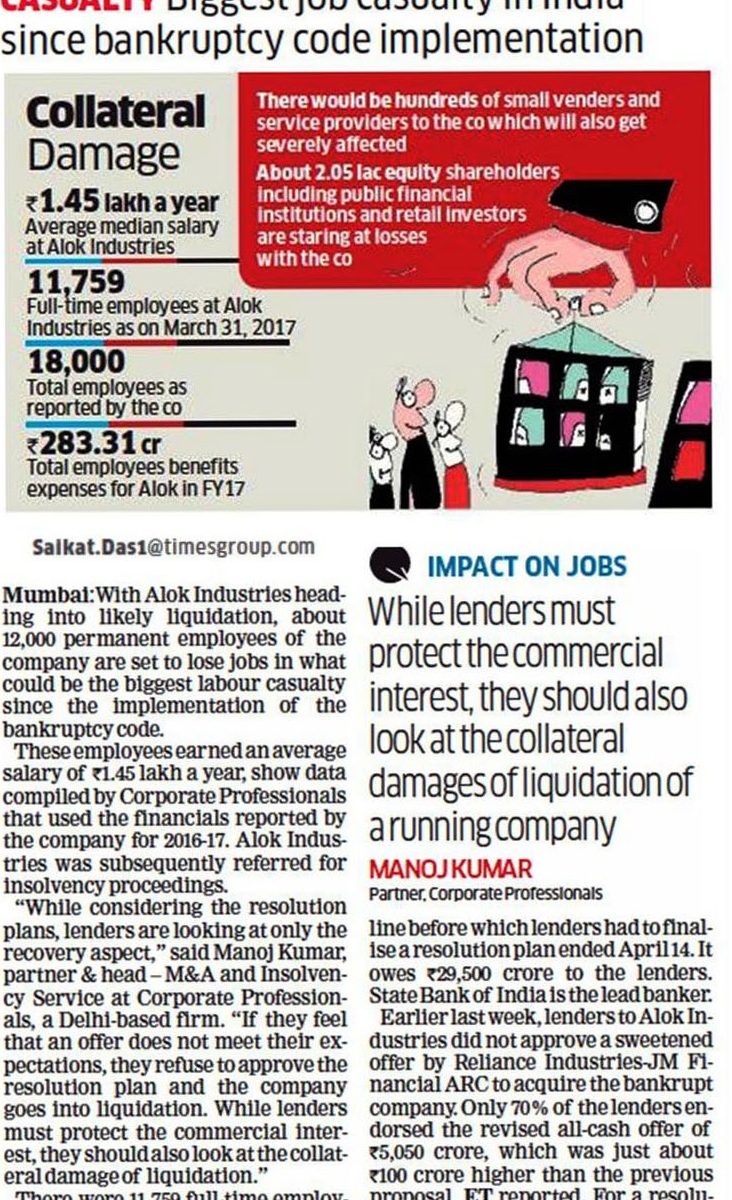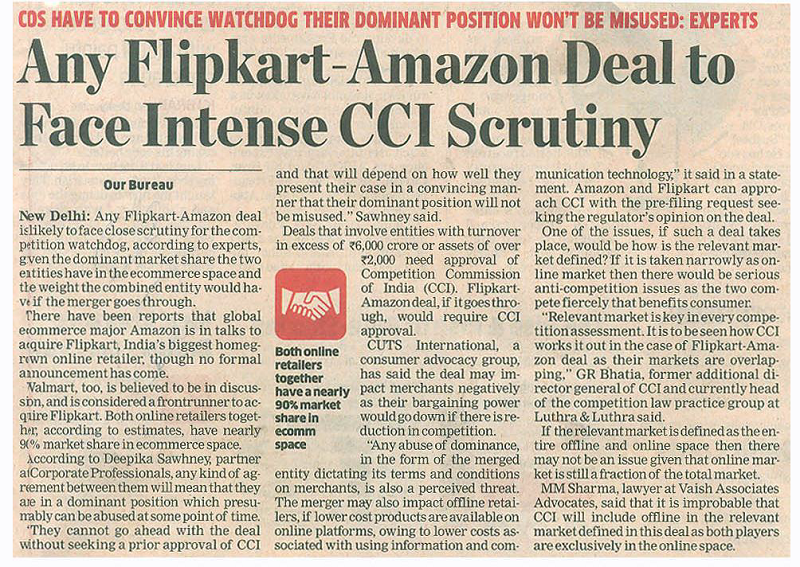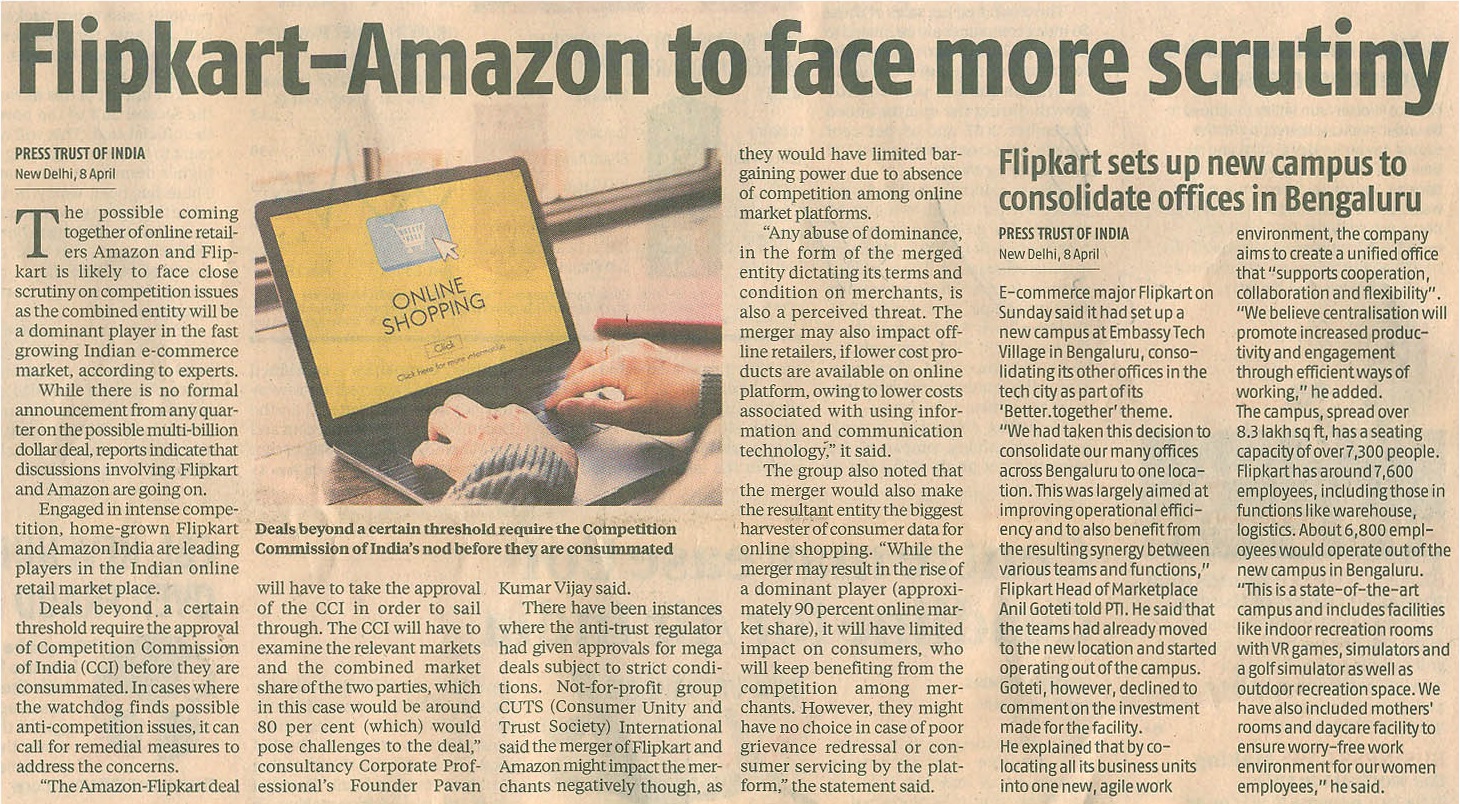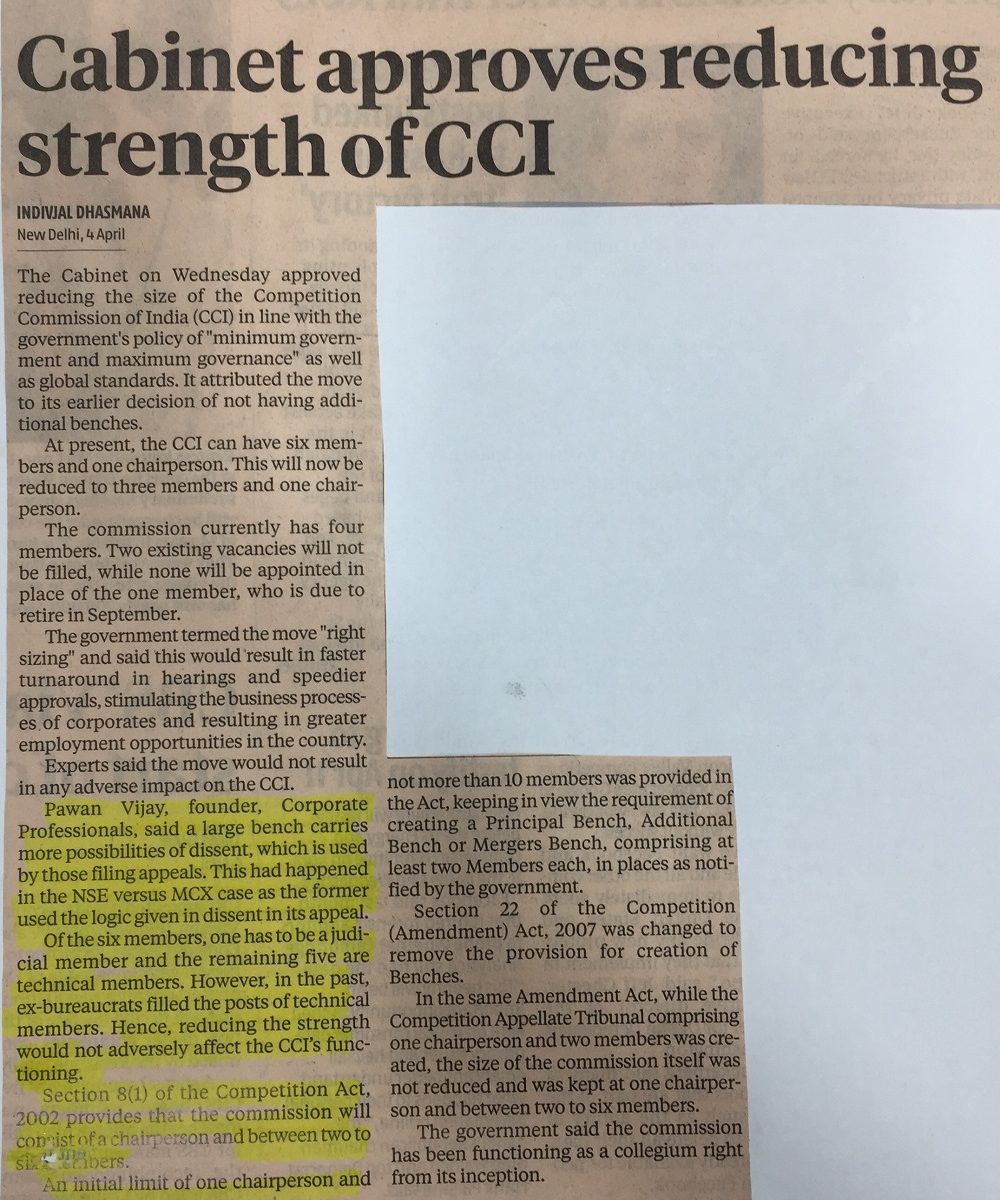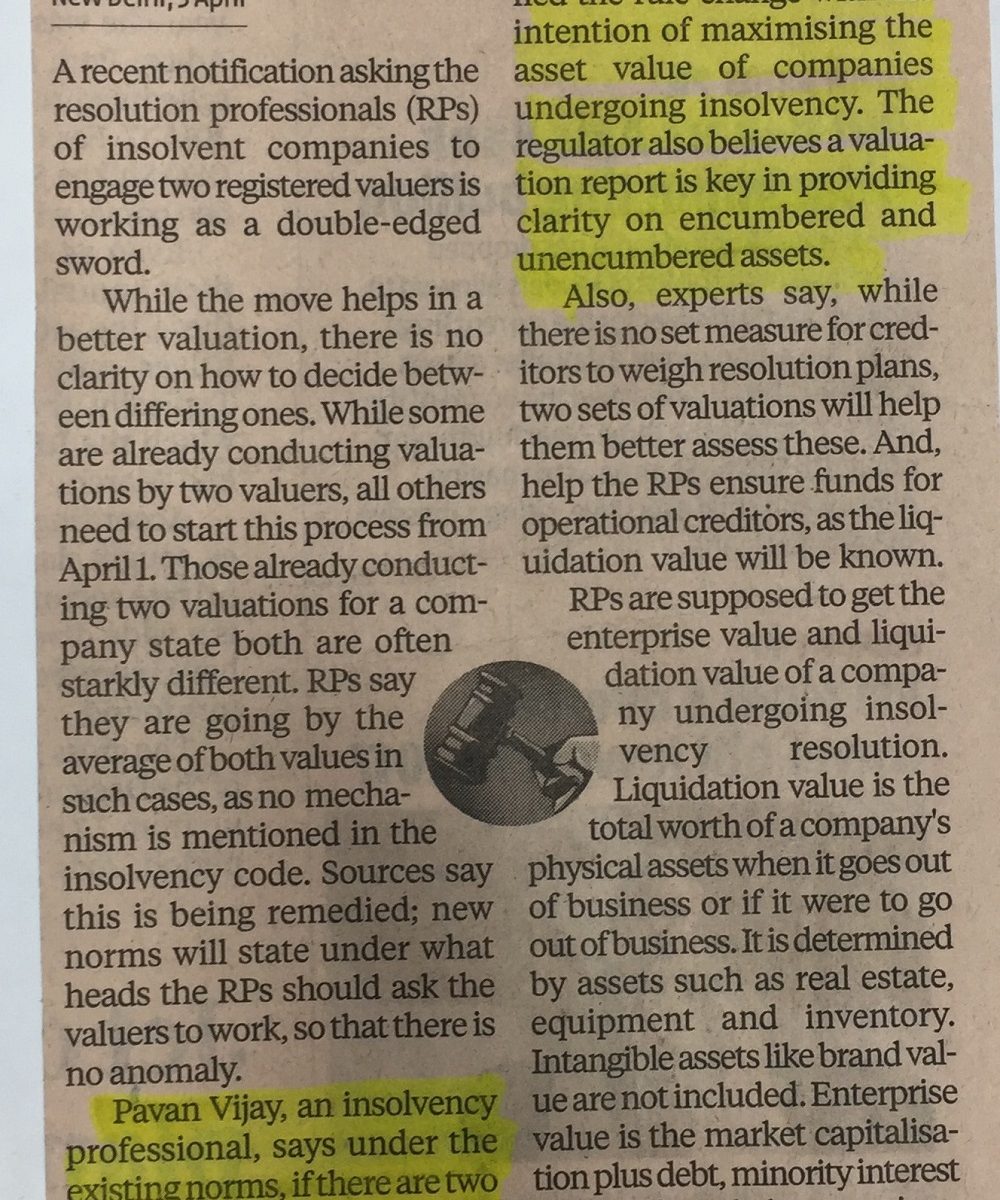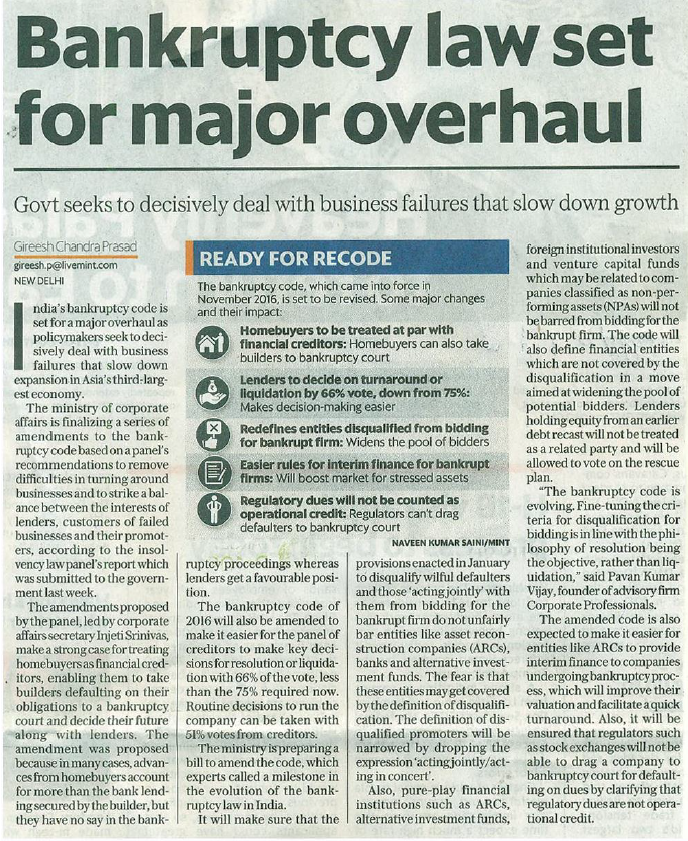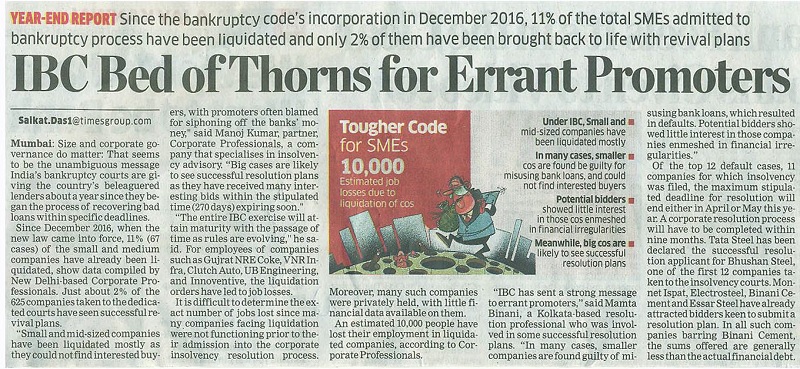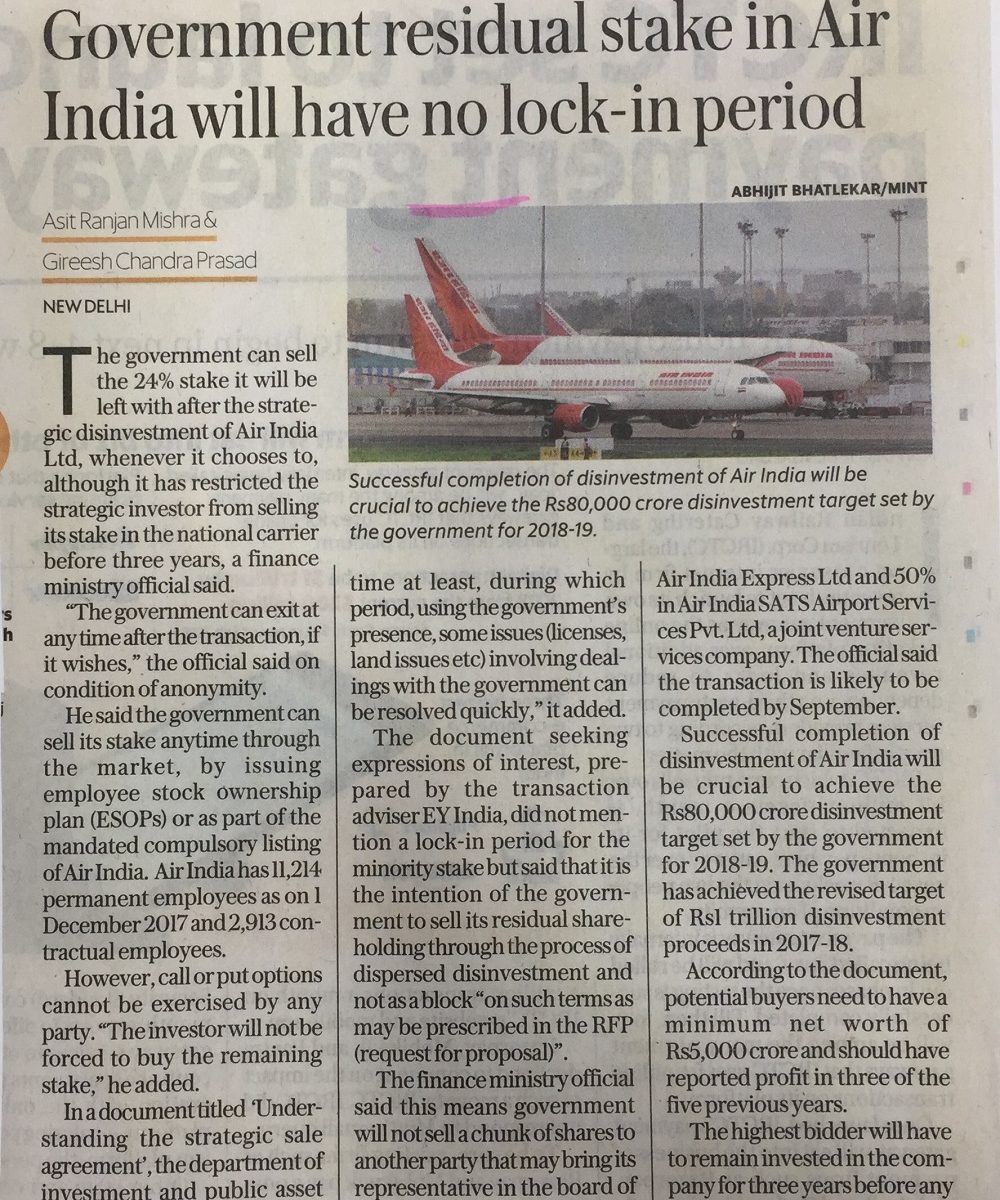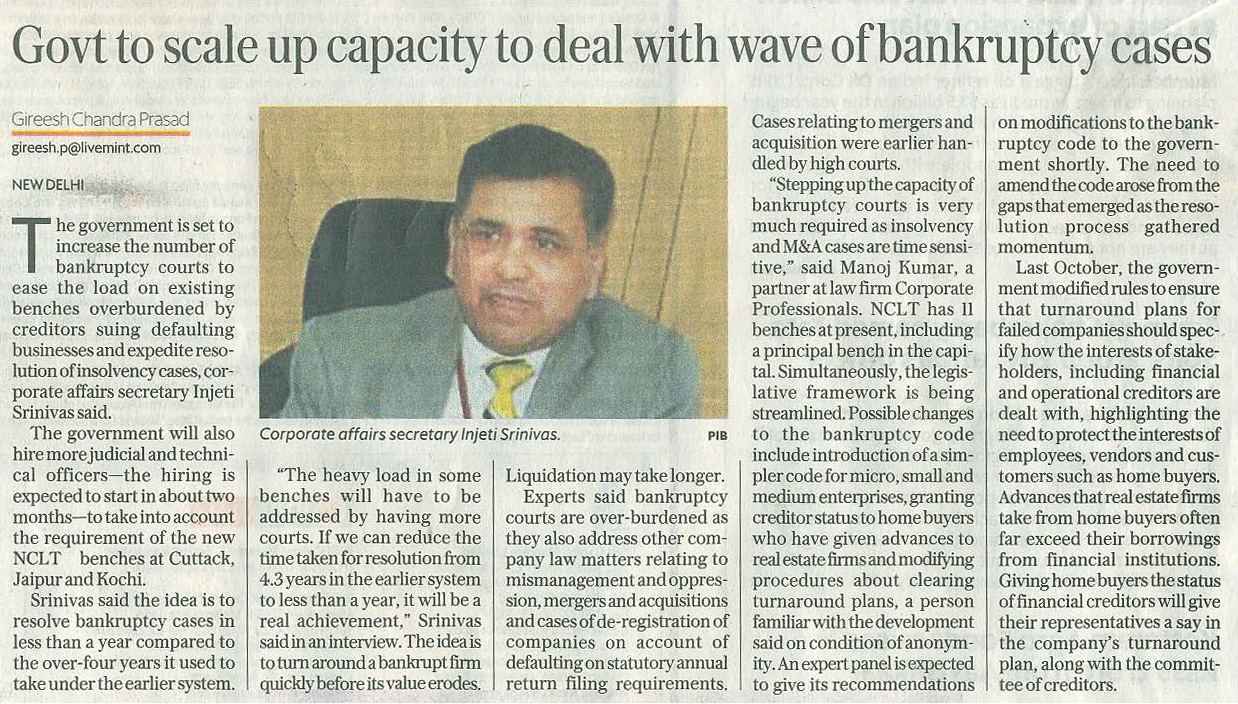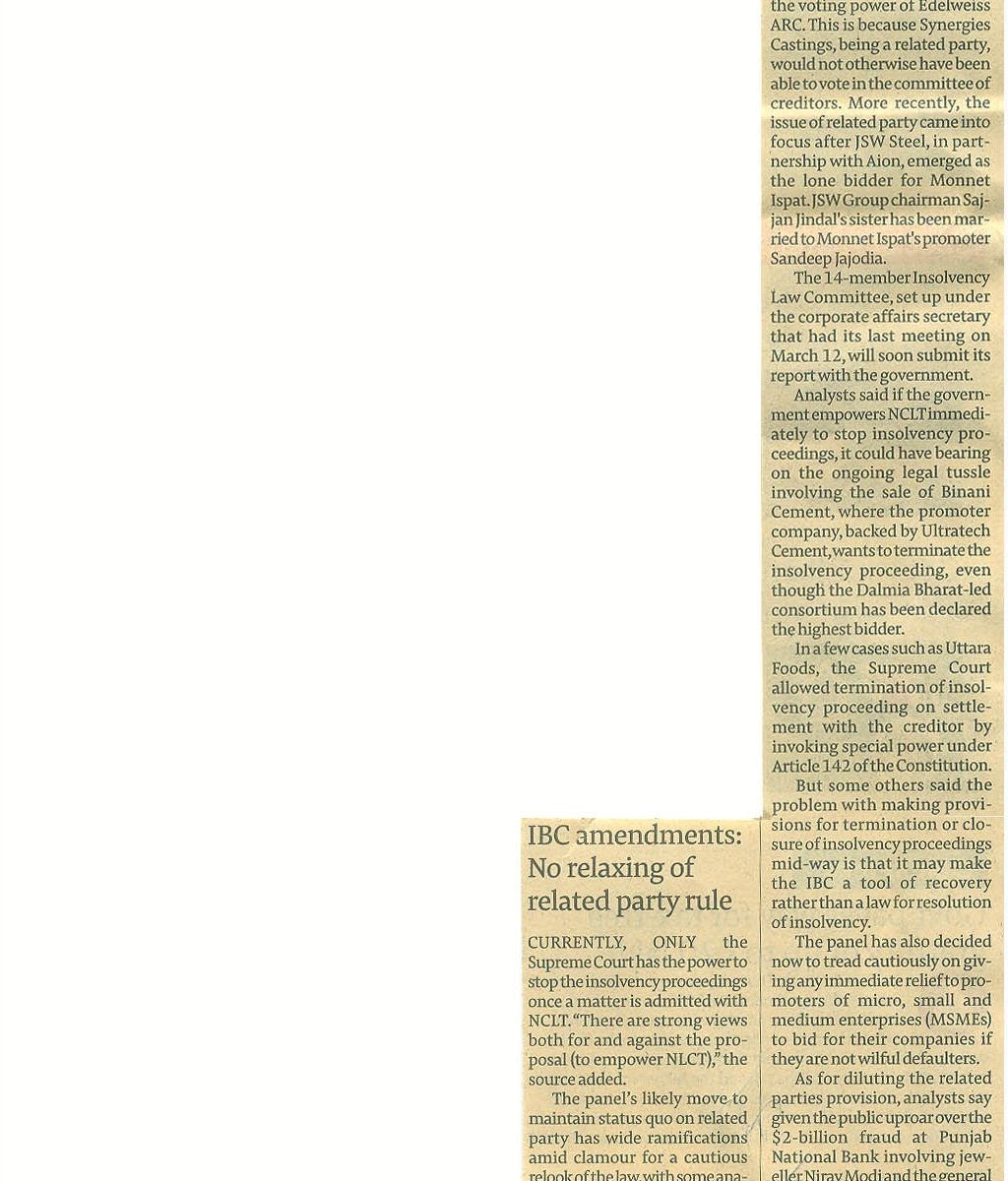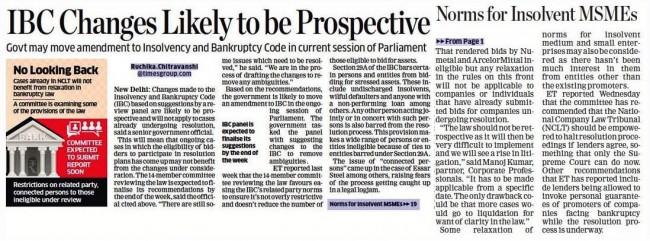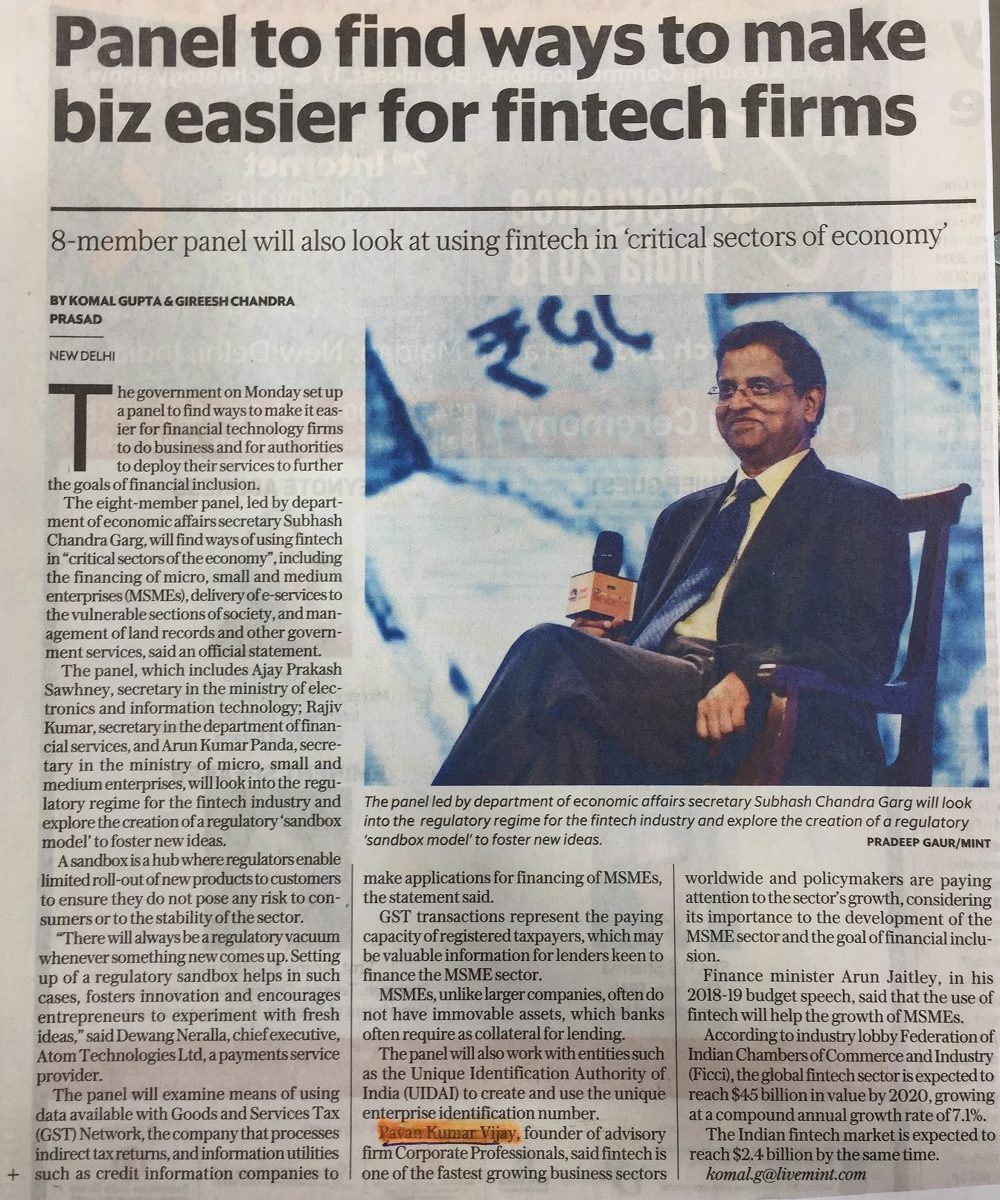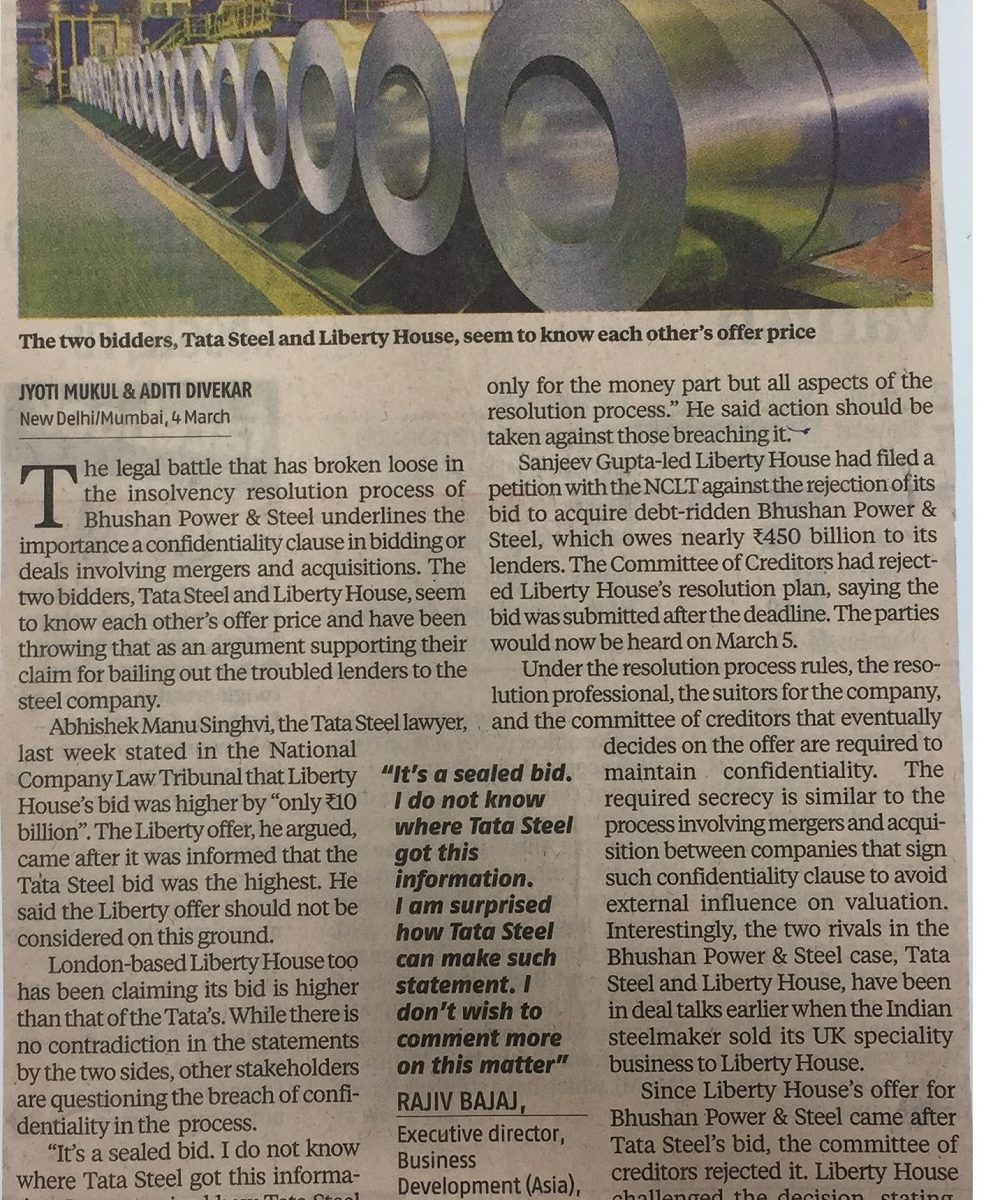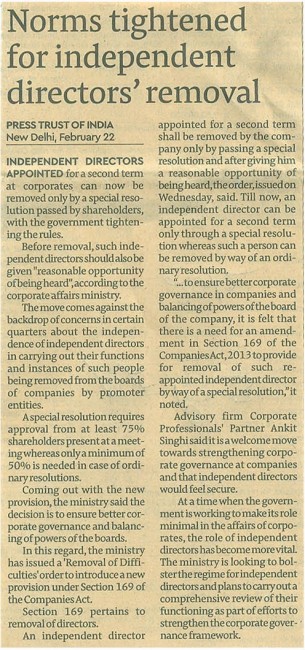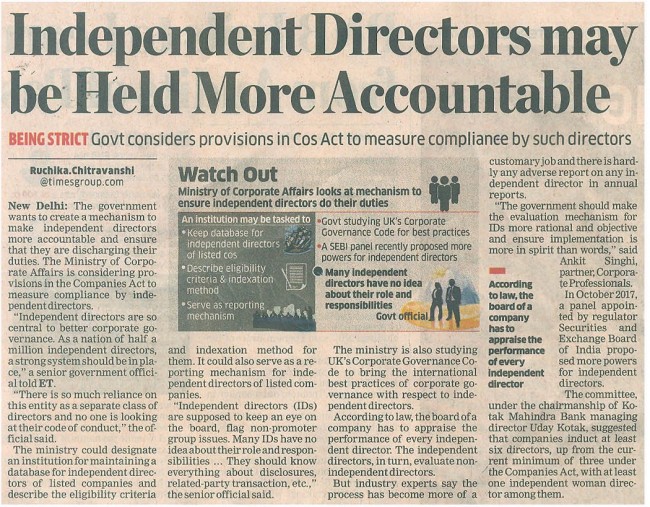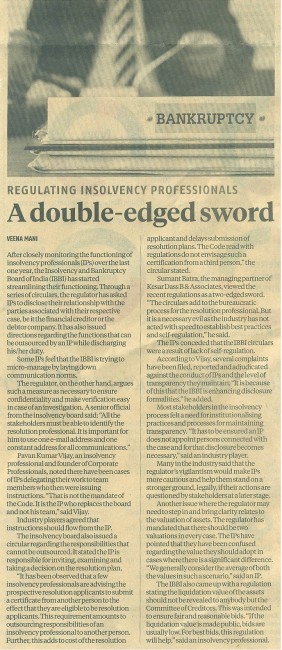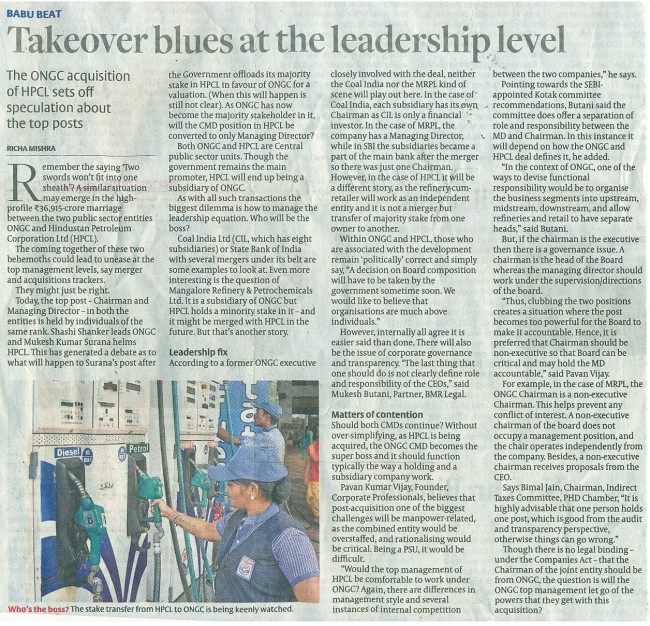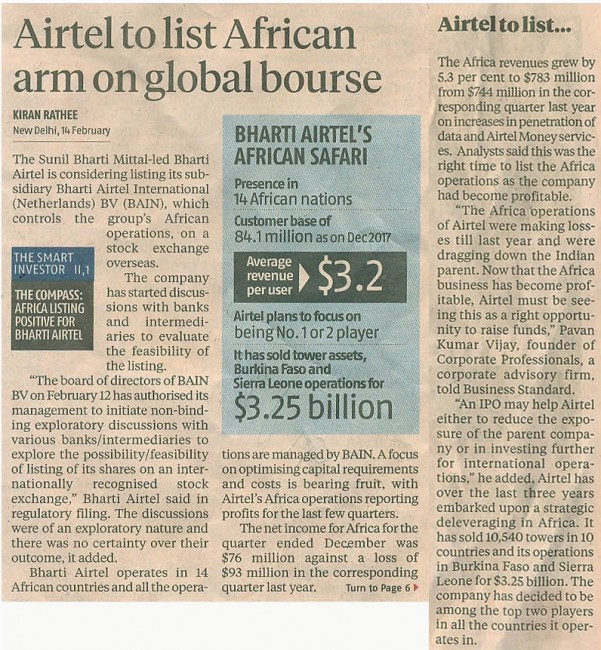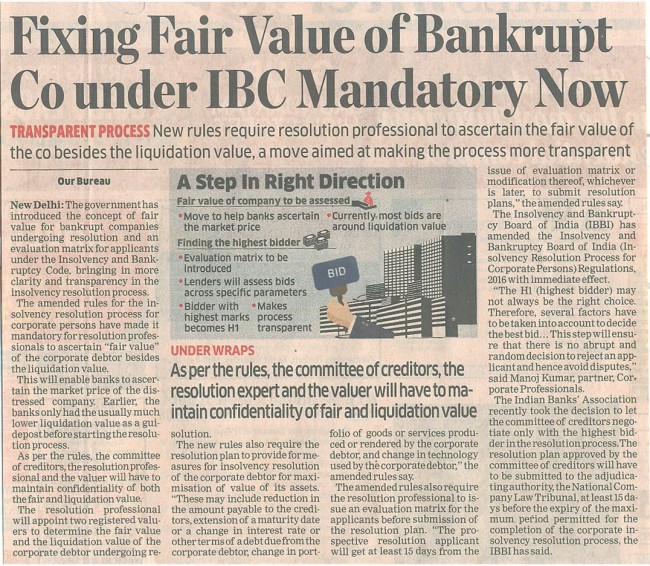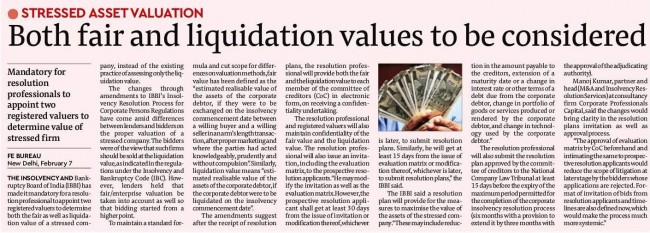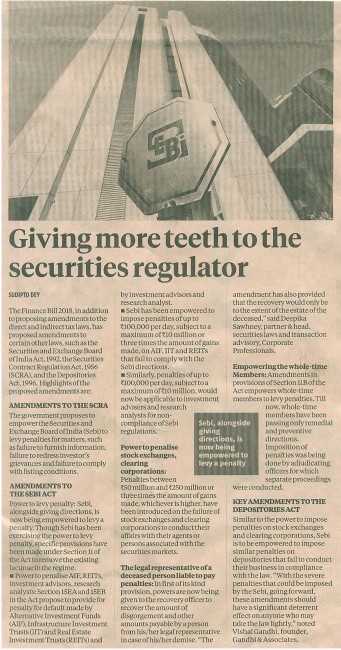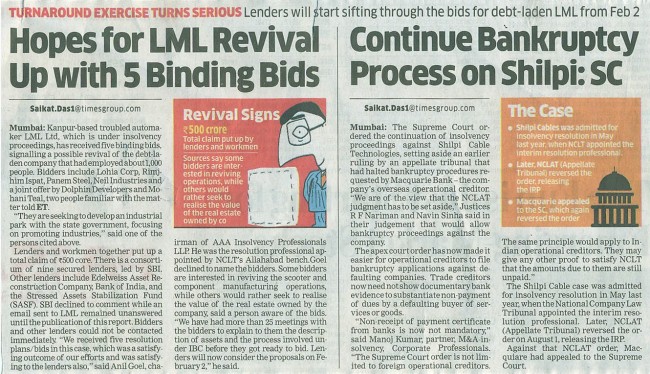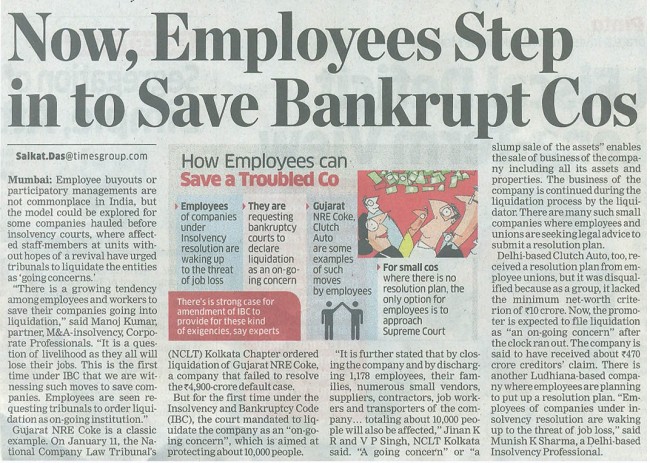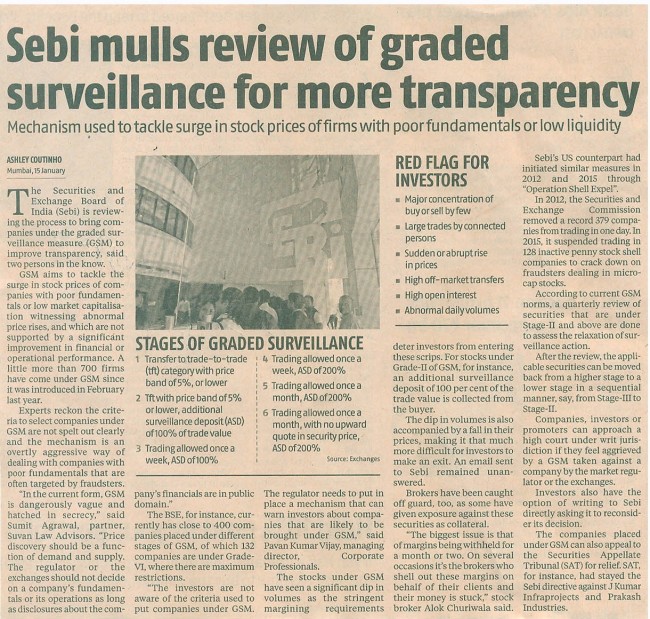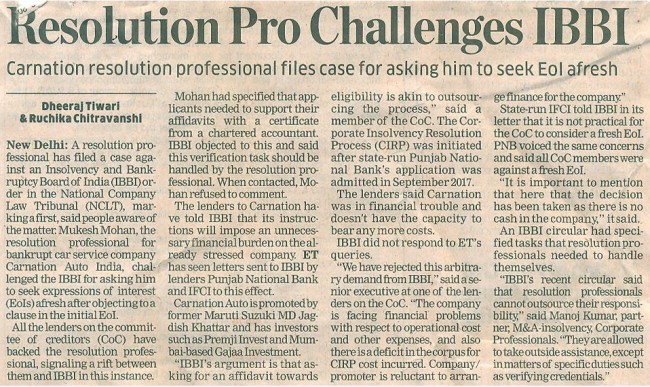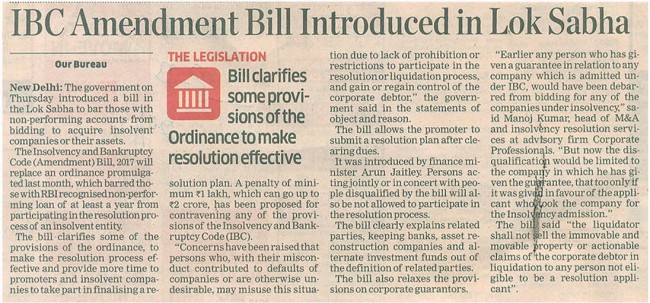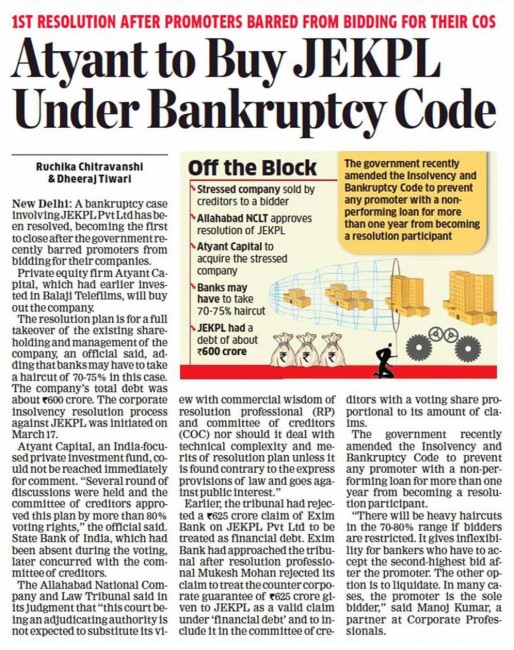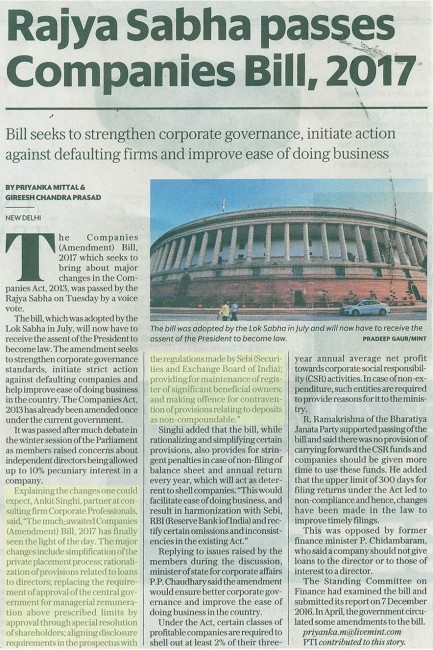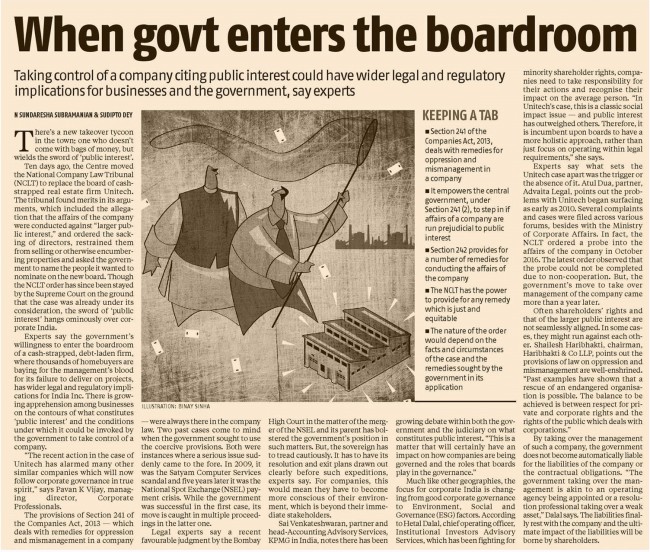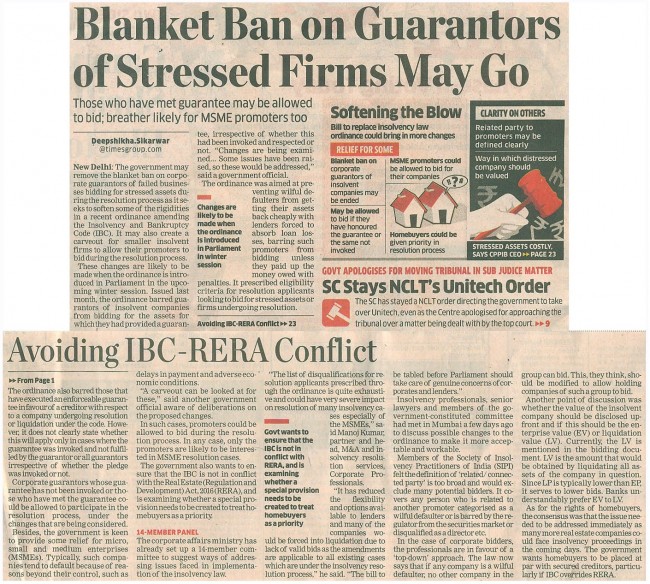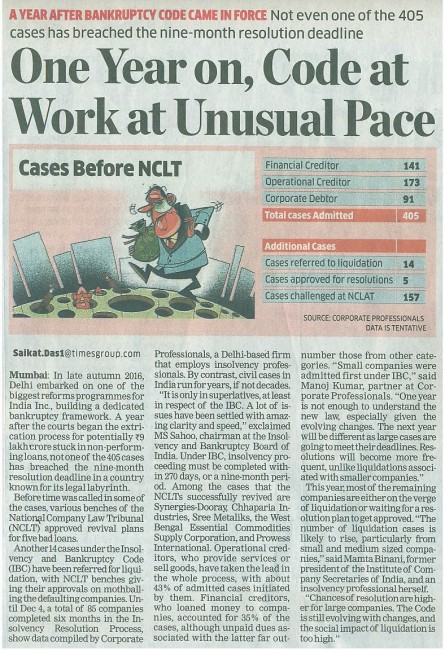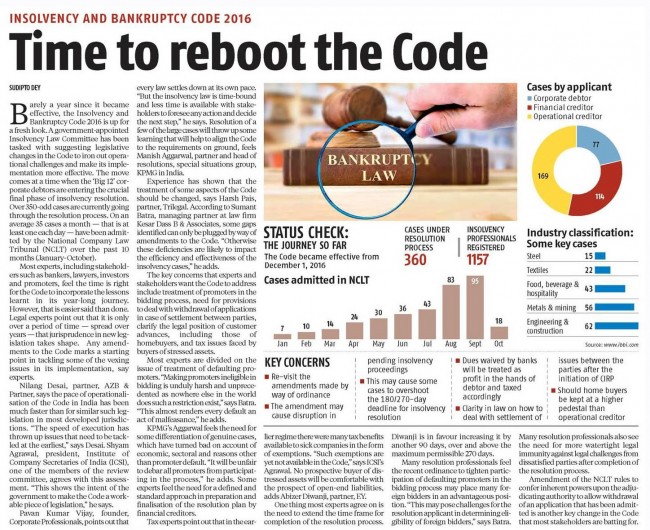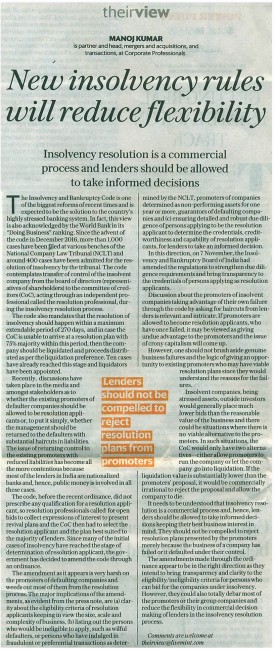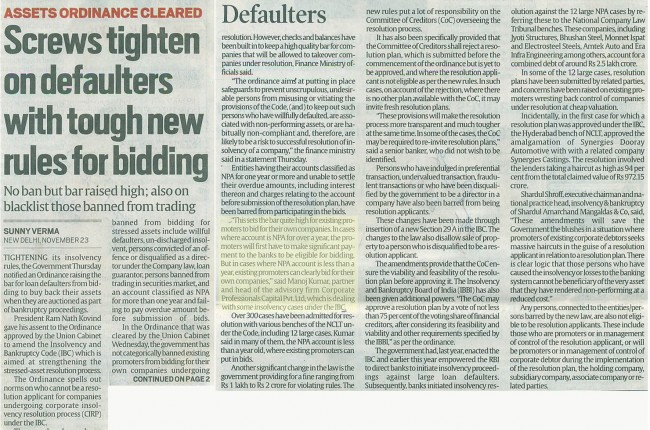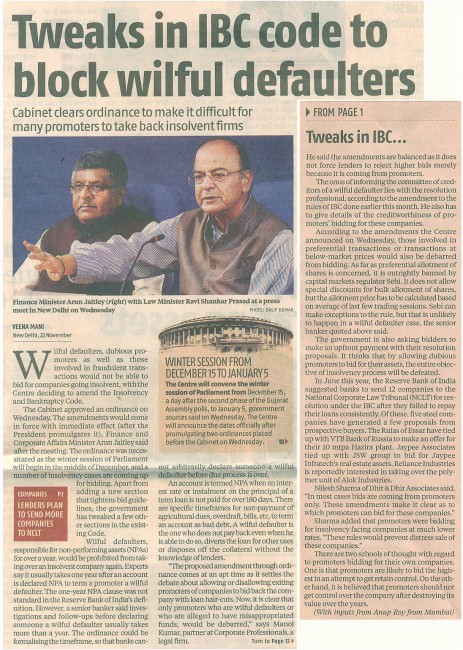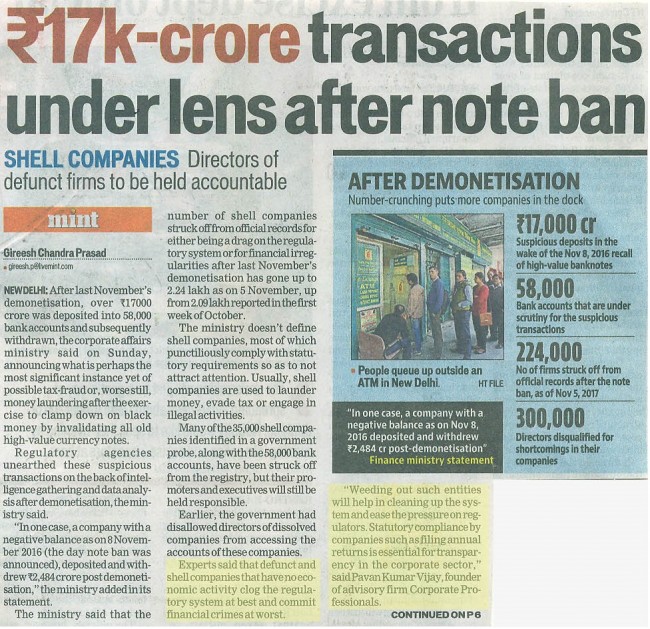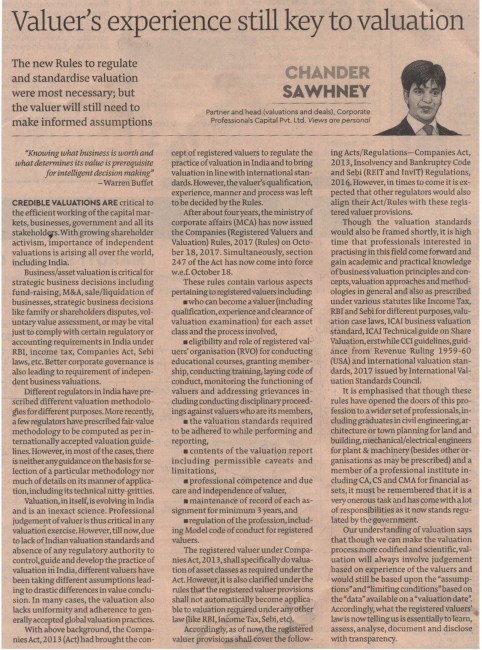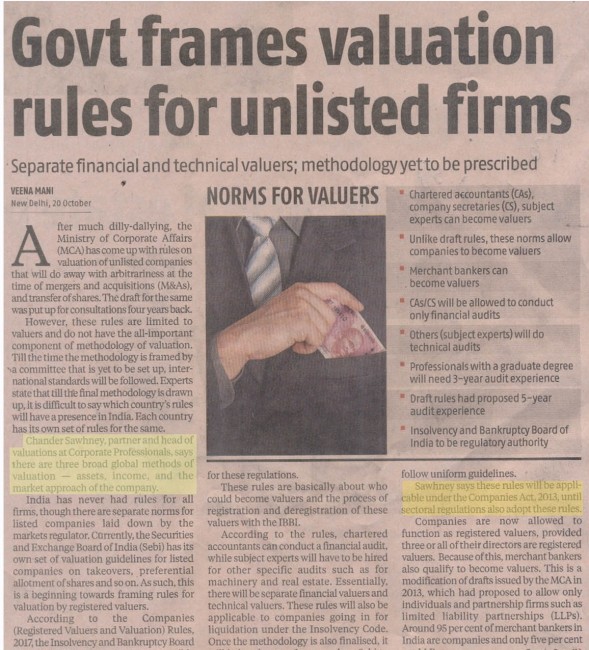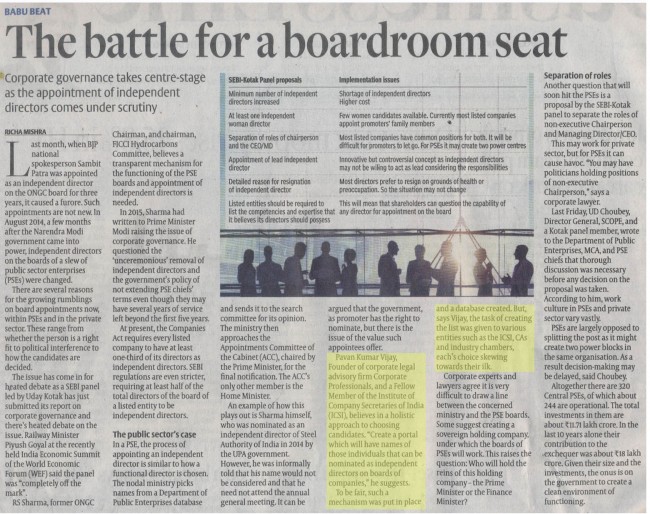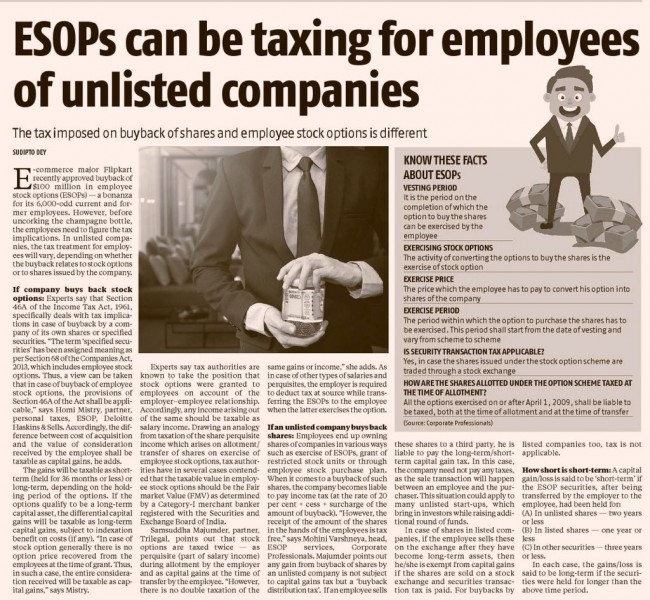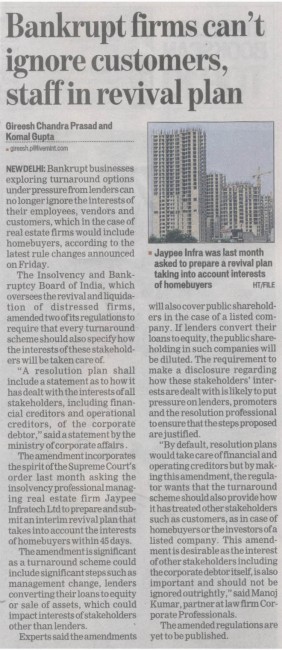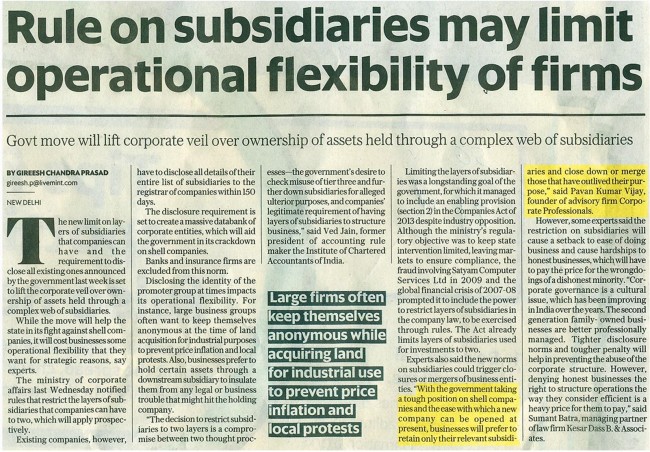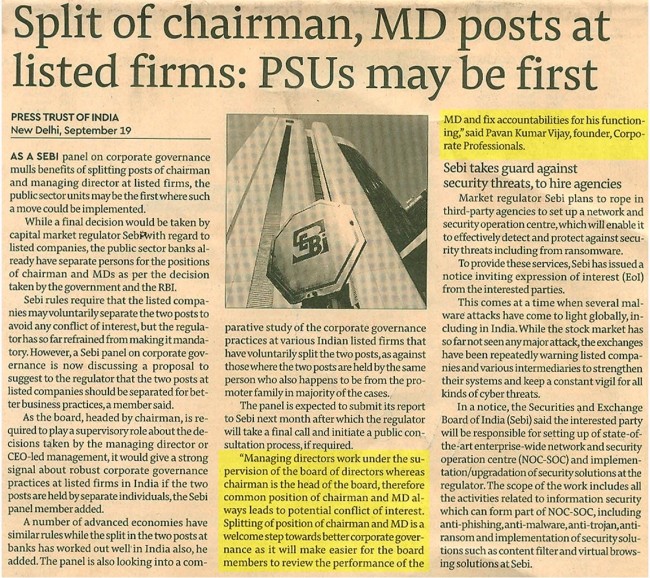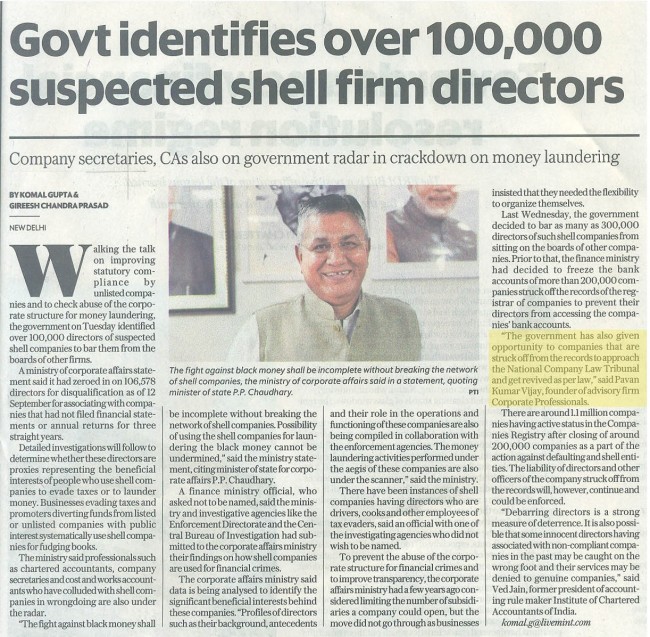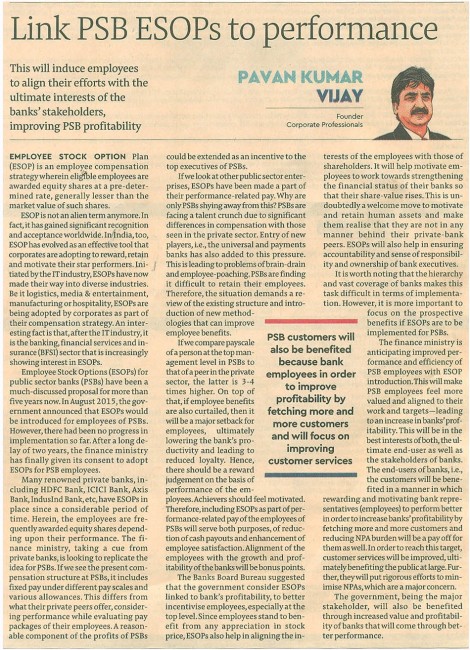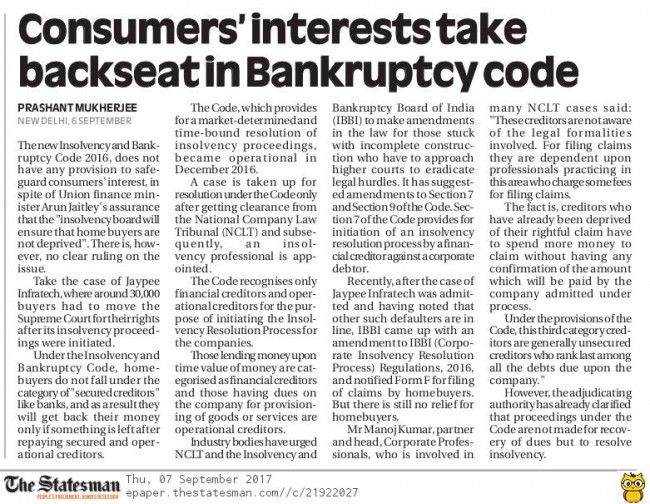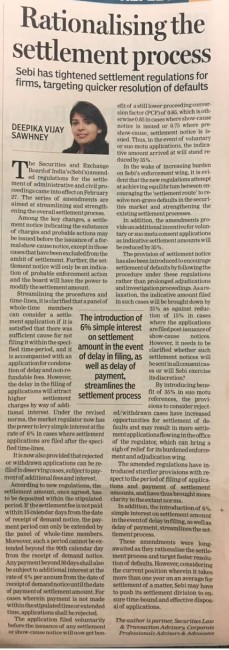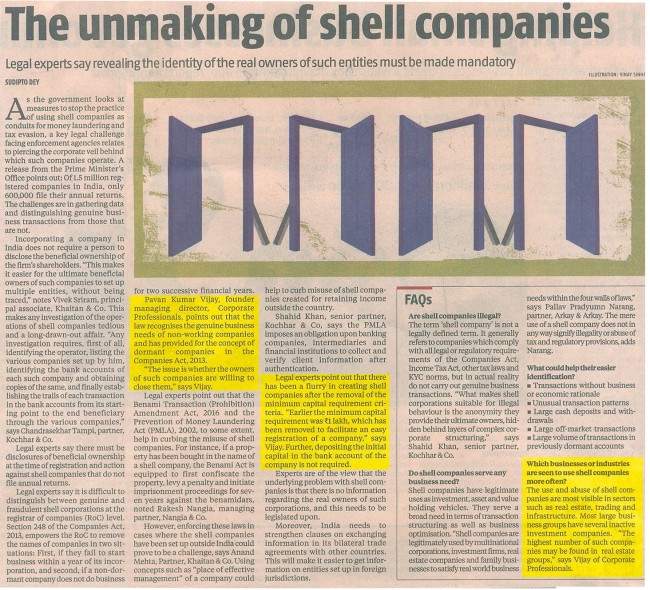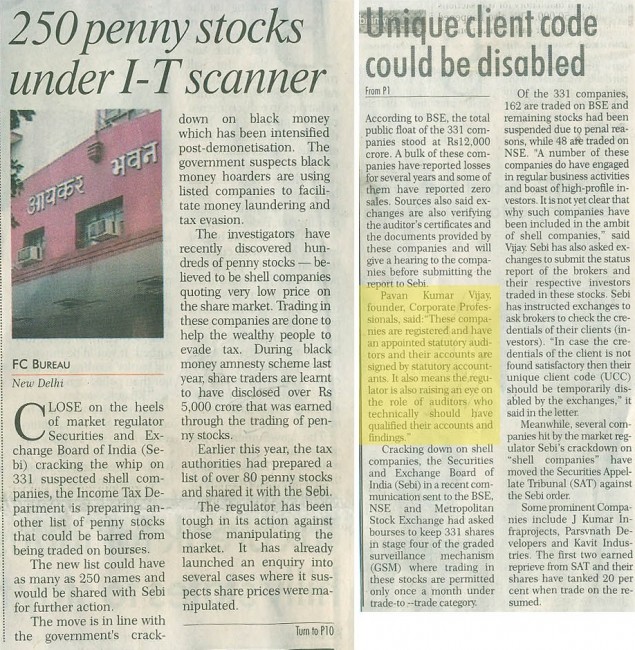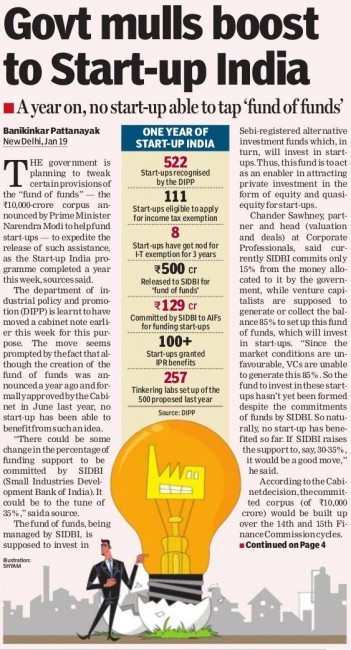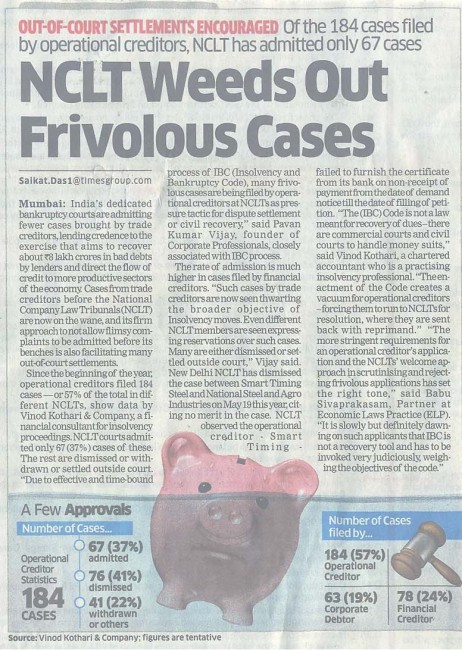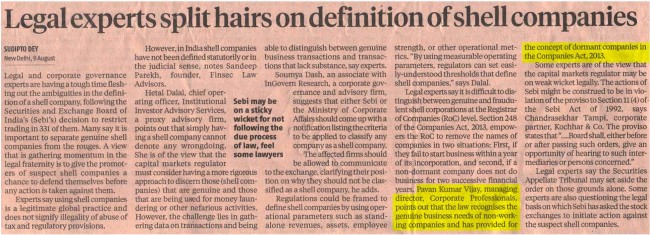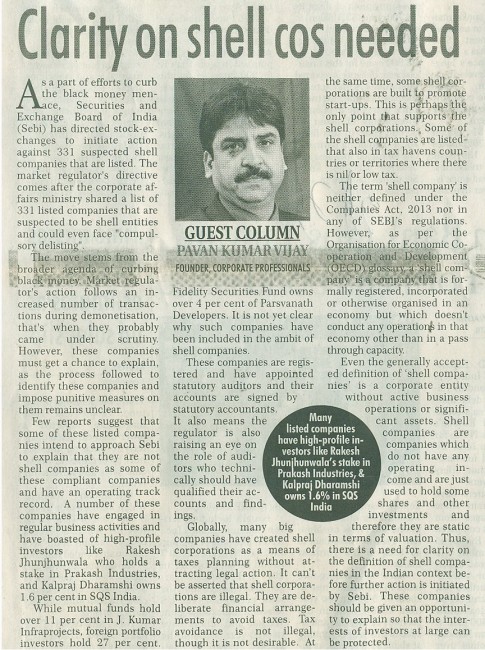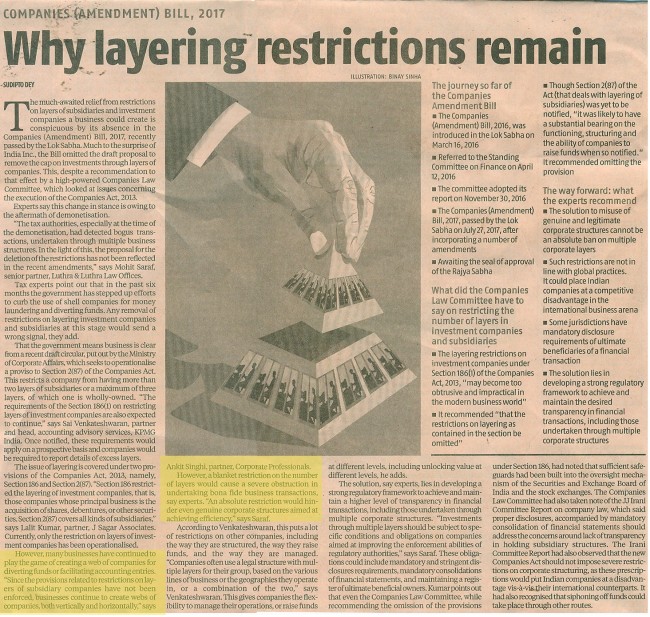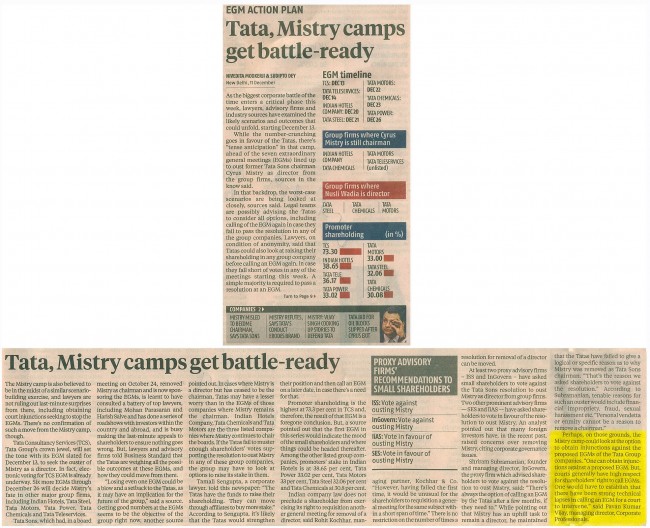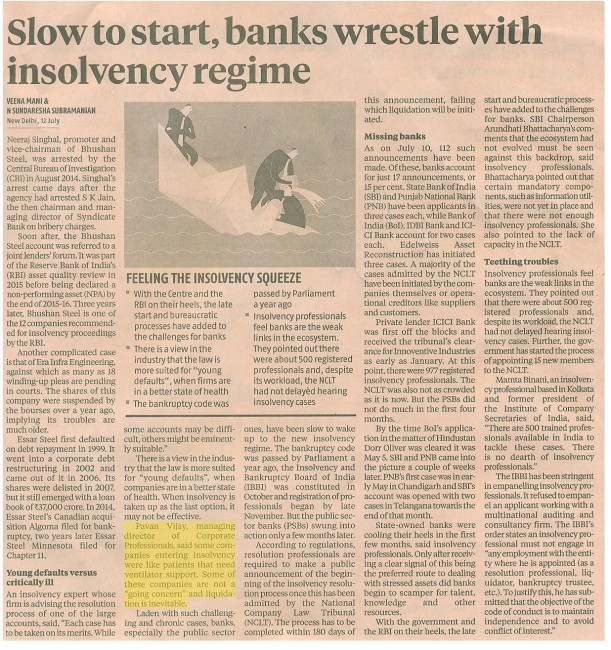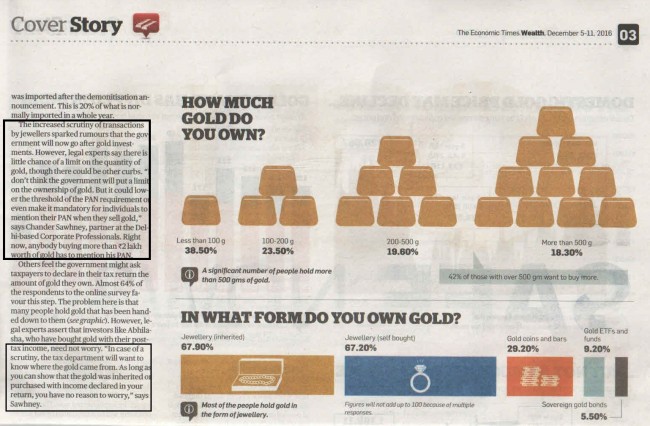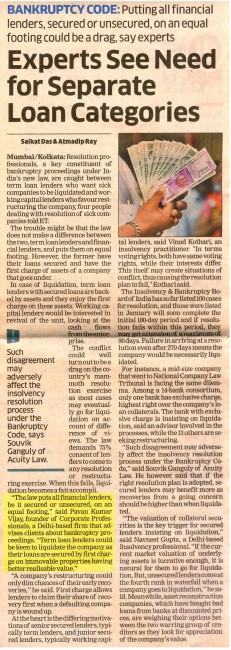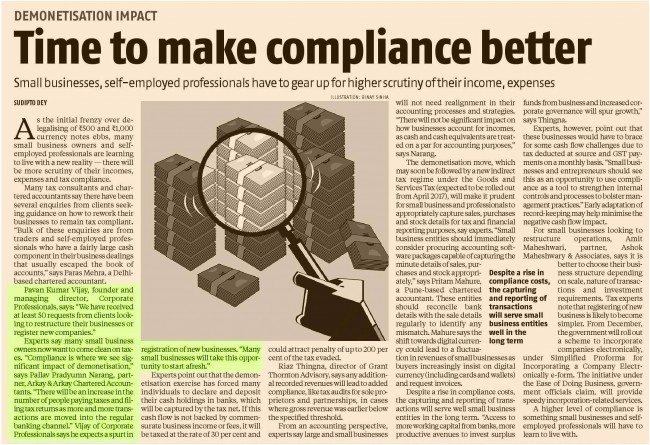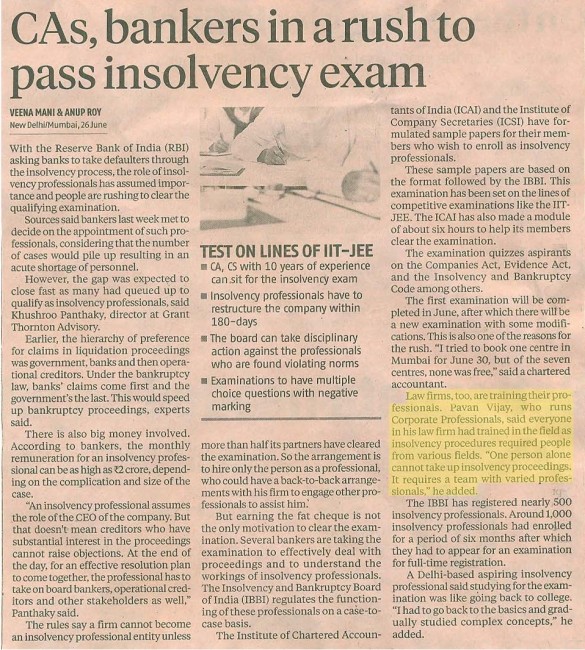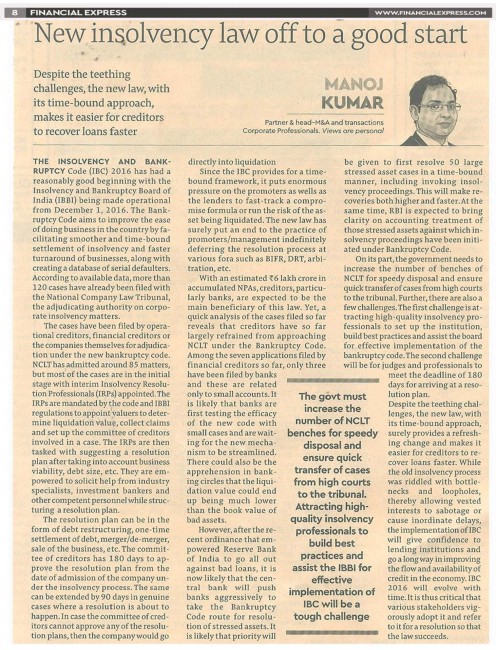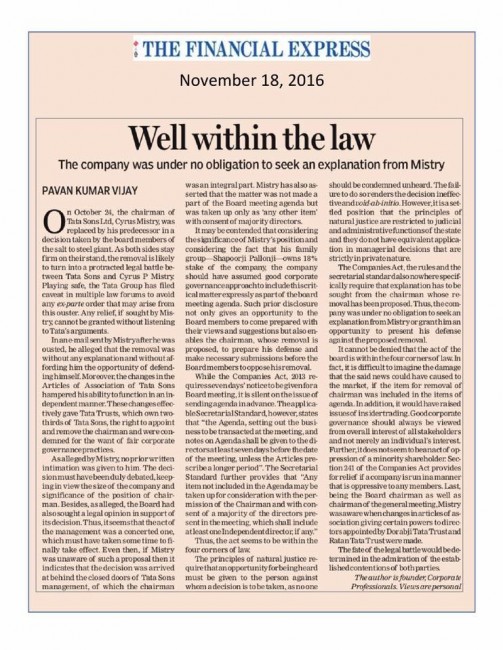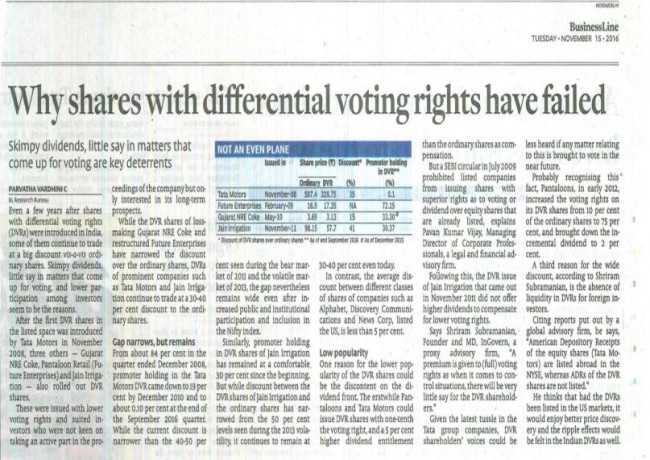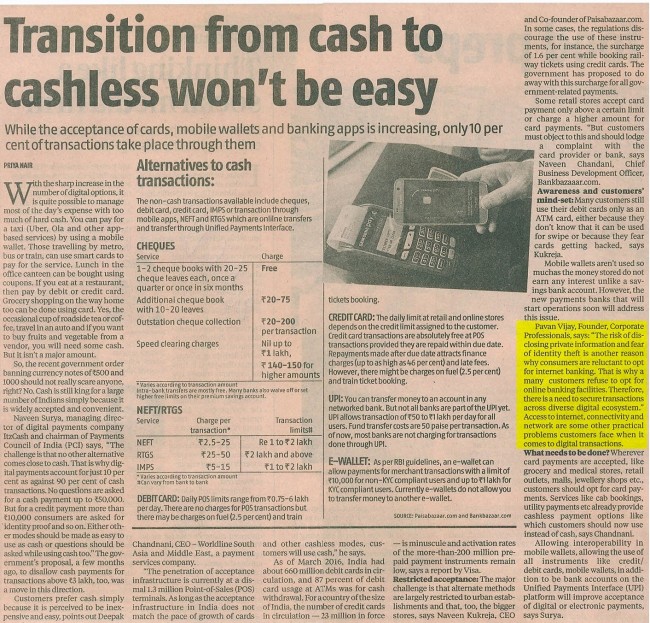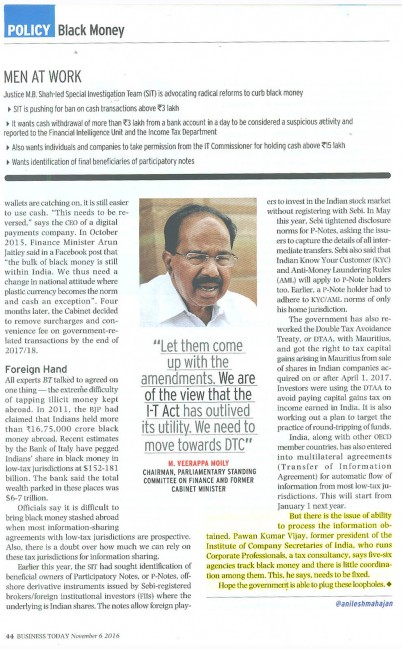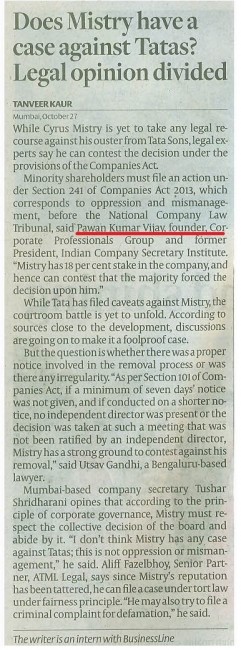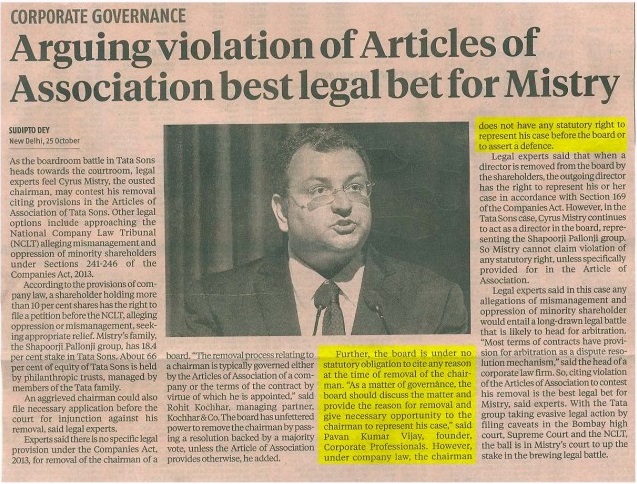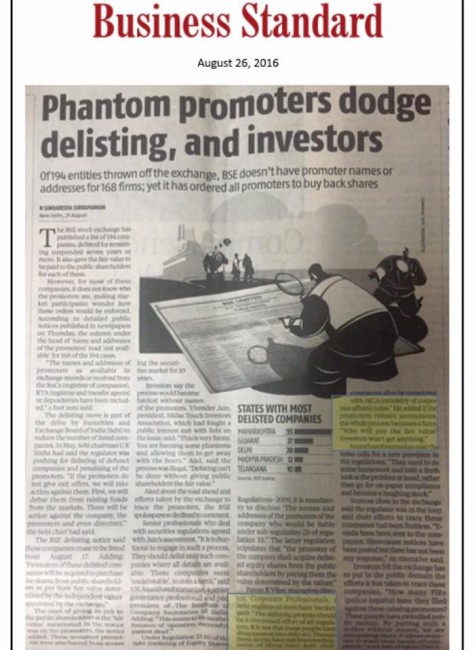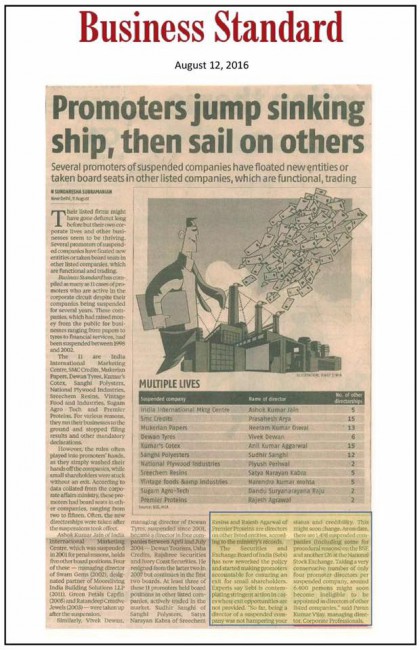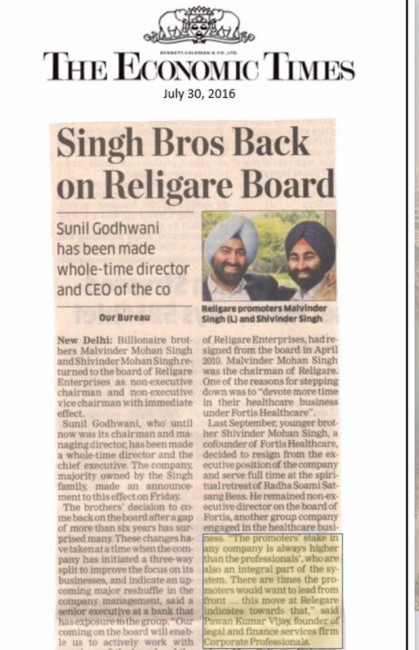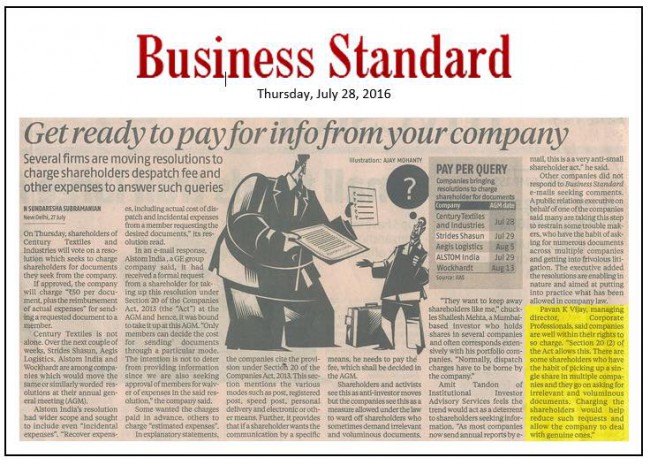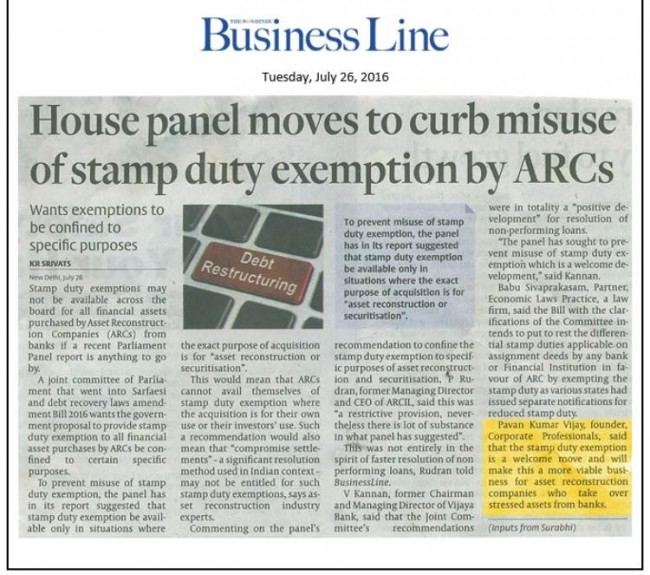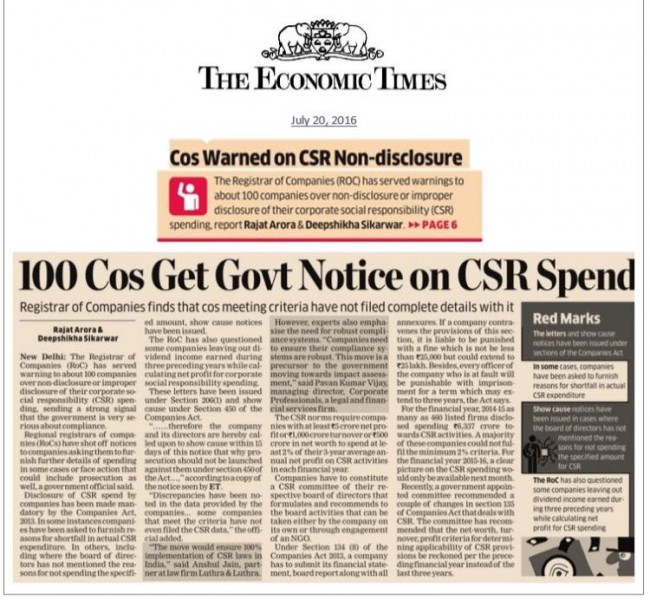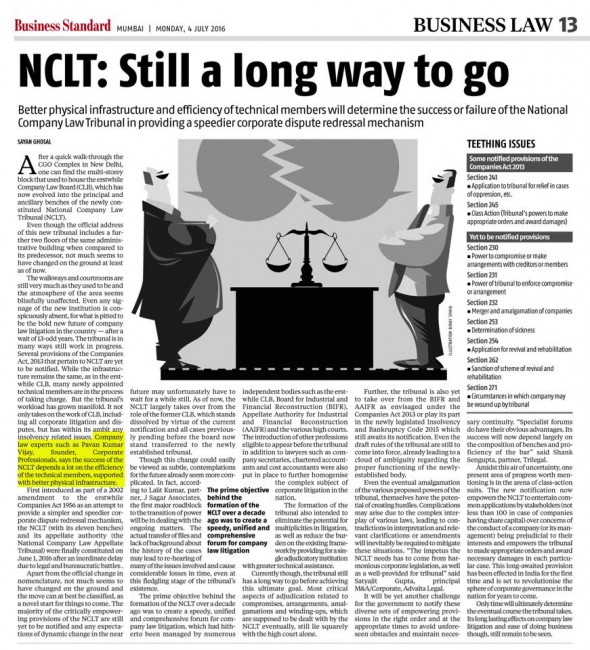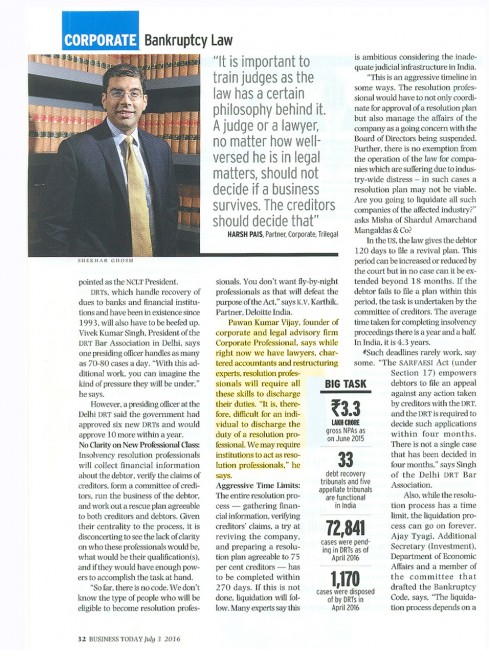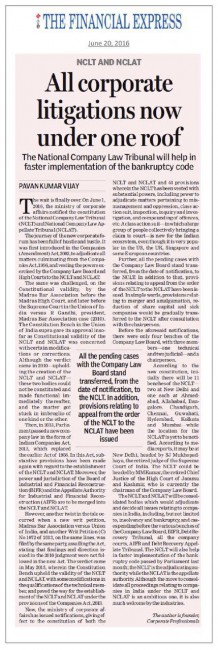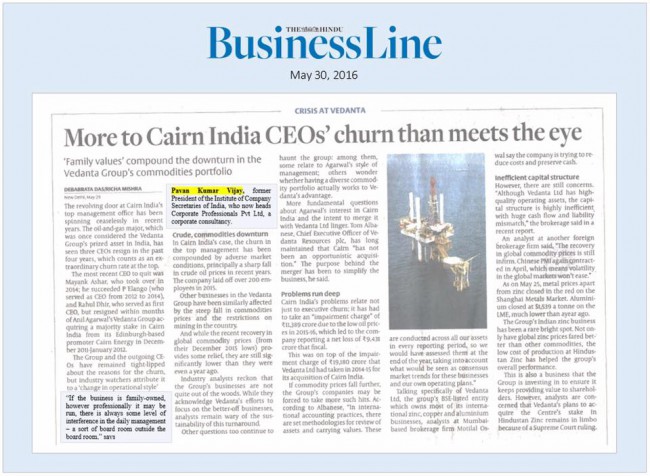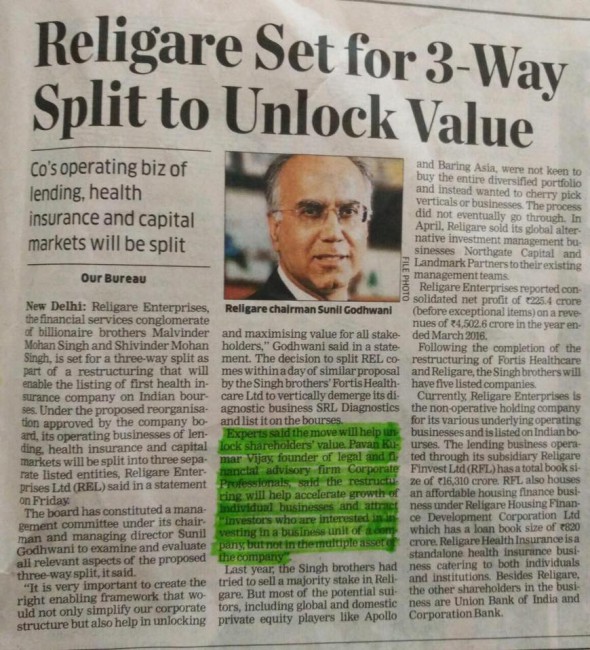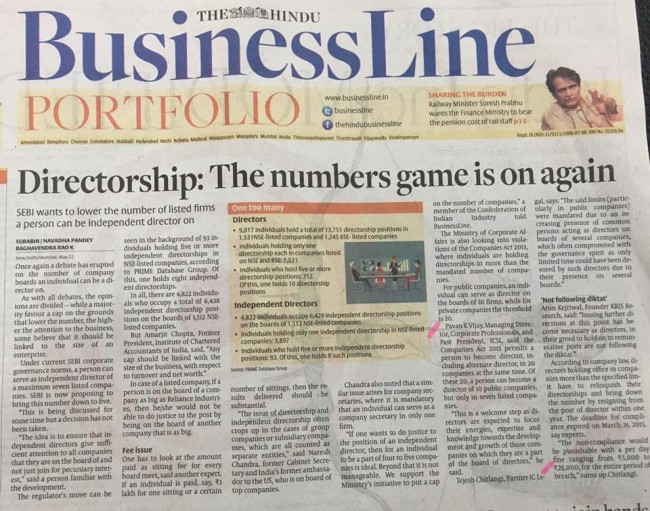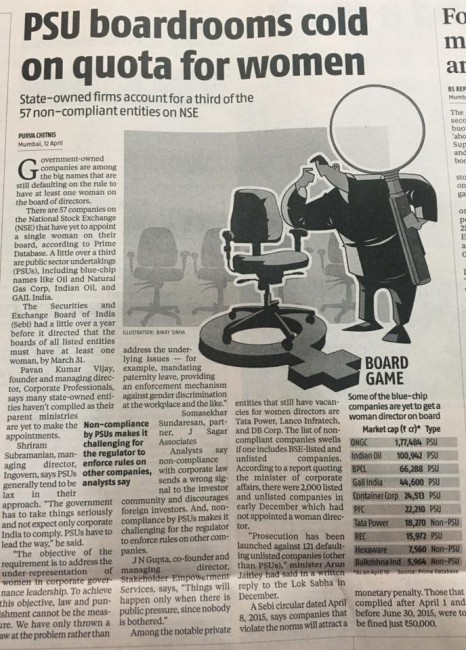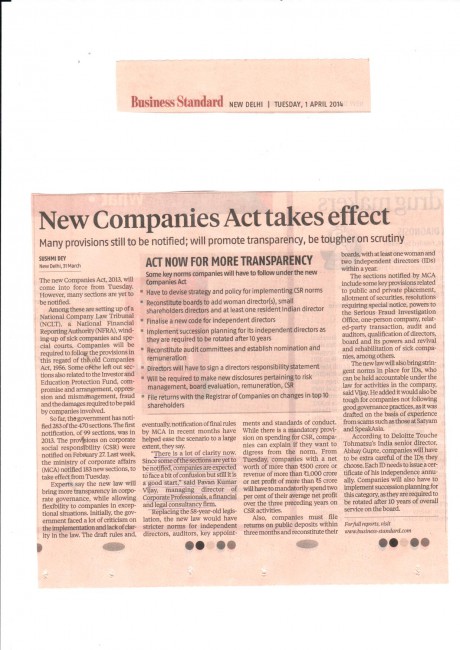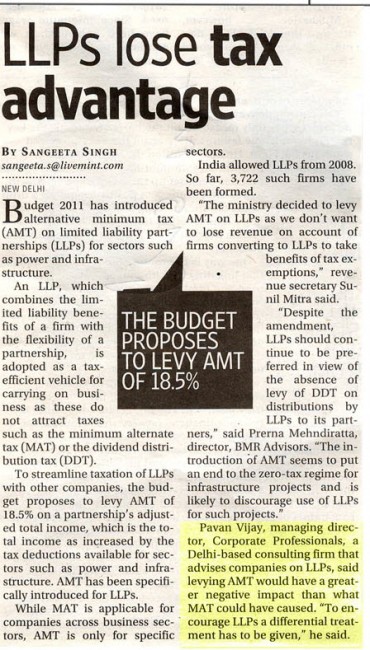Surge in personal guarantor cases under IBC in FY23
Takeover code for unlisted companies rolled out with safeguard norms
The Corporate Affairs ministry on Tuesday notified the takeover rules for unlisted companies. This will allow a majority shareholder in an unlisted company to move the National Company Law Tribunal (NCLT) to take over the rest of the stake in the entity.
For this to kick off, a member with at least three-fourths of equity shares carrying voting rights can file an application to acquire any part of the remaining shares. Analysts believe these rules may have a bearing on Tata Sons, the unlisted holding company of the salt-to-software group in the midst of a corporate battle with its …
Govt approves 6,000 investor claims through IEPF in a span of 10 months
The government in the past 10 months has approved over 6,000 investor claims such as matured company deposits and unpaid dividends through the Investor Education Protection Fund (IEPF) Authority, according to sources. The IEPF Authority, set up in 2016, had cleared only 800 claims till March last year.
The Ministry of Corporate Affairs has also issued notices to companies to submit the verification report of investor claims and also to transfer the unclaimed dividend and shares to the Fund. These monies are supposed to be moved to the IEPF if not claimed within seven …
New rules help small entities wind up biz without moving NCLT
The Ministry of Corporate Affairs has notified rules for winding up small businesses without having to go to a tribunal, under a provision in the Companies Act that offers an alternative to the commonly used liquidation procedure under India’s bankruptcy code.
The rules notified by the ministry further define provisions of section 361 of the Companies Act which allowed such an option for liquidating small firms with assets up to ₹1 crore.
As per the rules, those companies which have total outstanding deposit of up to ₹25 lakh, or those with outstanding loan including secured loan up to ₹50 lakh, or entities with up to Rs50 crore sales or those with paid up capital up to Rs1 crore are covered under this provision.
The rules mandate that the closure of the company will be carried out by the official liquidator hired by the government, who will take charge of the assets and deal with the claims of the company. If the liquidator finds any fraud having been committed by shareholders, directors or other officials of the company, the government may order a probe. The rules say that the central government will issue directions to the liquidator in case of companies going for summary liquidation similar to what bankruptcy tribunals do in other cases.
The Companies (Winding Up) Rules, 2020, signed off on 24 January and effective 1 April, prescribe how official liquidators have to go about in managing the resources of the company that goes into liquidation under various provisions of the law and the manner of selling assets under the guidance of bankruptcy tribunal.
Success fee gains currency among RPs
New payments formula for creditors in the works
The government is considering a new formula for payments to creditors of distressed companies resolved through the insolvency and bankruptcy law, which would give a better deal to unsecured lenders and operational creditors.
There are two options under consideration, a government official told ET.
Under one of the plans, the resolution amount would be split into two parts – liquidation amount set by the valuers before the resolution is started, and anything in excess of this amount.
Liquidation amount would be distributed to company’s creditors in accordance with the “waterfall” mechanism set out in Section 53 of Insolvency and Bankruptcy Code, as per the plan.
Under this mechanism, all claims of secured financial creditors must be fully paid before payments are made to unsecured financial creditors, who must in turn be fully paid before operational creditors.
Any amount in excess of the liquidation value would be split on a pro-rata basis among all creditors – secured, unsecured and operational.
The government has also proposed this formula for distribution of proceeds from the resolution of debt-ridden Infrastructure Leasing and Financial Services Group (IL&FS).
“One formula is that everyone has contributed to enterprise value, so up to liquidation value, secured creditors will have the first claim. Till liquidation value, Section 53 (waterfall mechanism) will apply. On the balance, everyone has a claim,” said a government official.
The second formula being considered is to set aside a fixed proportion of 5% or 10% of sale proceeds for operational creditors.
The government is looking at the National Company Law Appellate Tribunal (NCLAT), which is set to decide on the formula proposed by the government for distribution of proceeds from the sale of IL&FS group entities, before finally taking a call.
IL&FS is not formally under IBC resolution but the process is being overseen by the NCLAT.
“We are awaiting judgement in the IL&FS case,” said the official.
Experts however point out that while the move may help protect the interest of operational creditors, which are often small businesses, it may push financial creditors to opt for other options for recovery.
“It is important to protect the interest of operational creditors because they are very vulnerable, smaller in size and not as capable of protecting their interests but the hurdle is that because the decision making remains with secured lenders, they may try to explore other options for resolution or push the company towards liquidation,” said Major Kumar, partner at law firm Corporate Professionals.
Unclaimed Dividends to go to IBBI
Sebi gives India Inc. breather! Companies get two more years to split CMD post
The Securities and Exchange Board of India (Sebi) on Monday extended the deadline by two years for the implementation of its directive to split the post of chairman and managing director (MD) or CEO for the top 500 listed entities by market capitalisation. Firms now have time till April 2022 to comply with the directive.
The markets regulator had earlier directed the top 500 listed entities to ensure that the chairperson of the board should be a non-executive director and not be related to the managing director or the chief executive officer of the firm — a directive that was to be implemented by April 2020. The earlier directive to implement the split in the roles was done following recommendations by the Sebi-appointed Kotak committee on corporate governance.
Experts believe that the deferment announced on Monday was a bit surprising considering the regulator’s strong stand on the issue back in 2018. As Rishabh Shroff, partner at Cyril Amarchand Mangaldas, said the Kotak committee recommendations made a compelling case for the move. “Companies are still struggling to break the tight multi-generational link between the post of chairman and MD being the same promoter patriarch. If the same individual as chairman & MD was creating shareholder value, why should a company change it? But the law is clear on this now — it’s just been deferred. So, promoters have two years to see how to make this transition,” he said.
The Federation of Indian Chambers of Commerce and Industry (Ficci) welcomed the Sebi’s decision. Sangita Reddy, president, Ficci, said, “This was part of multiple representations made by Ficci and we appreciate that Sebi has extended the deadline as managerial continuity, unified vision and speed of execution are crucial to business success and are facilitated in family businesses.”
The data from Prime Database showed that at big private companies like Reliance Industries, Hindustan Unilever and ITC, the chairman also holds the position of the MD. Even many public sector undertaking companies like Coal India, Indian Oil Corporation and NTPC are yet to split the post of chairman and MD.
Senior officials in the industry also indicated there was a strong pressure from the corporate sector to postpone the deadline. Pavan Kumar Vijay, founder at Corporate Professional Group, thinks the directive was deferred because apart from the government companies, even many private firms like RIL still have the CMD post. “There was a strong pressure from the corporate sector to postpone the deadline by few more years. It was being resisted by corporates because this move would create two power centres within the company,” he said.
Takeover norms for unlisted firms getting finalised, to be unveiled soon
The Ministry of Corporate Affairs is giving final touches to the takeover code for unlisted companies and it is likely to be introduced soon, a senior government official told Business Standard.
The new rules, which are under consideration, will allow a person alone or together with other parties owning 75 per cent in an unlisted company to trigger a takeover of the entire shareholding by moving the National Company Law Tribunal (NCLT). Unlisted companies have no formal takeover code and shares are transferred on the basis of contracts and agreements. “We want to bring a …
Transparency matters! Sebi likely to fine-tune disclosure norms soon
The regulator is believed to be taking a relook at the regulations under the ‘Listing Obligations and Disclosure Requirements’ and is understood to be working on guidelines that clearly define material and non-material events.
BSE MD & CEO Ashishkumar Chauhan confirmed to FE that discussions were on at various levels between the regulator, the government and the exchanges on the proposed nature, timing and the mode of disclosures. “There is a debate about what to disclose because any person can write anything. If you don’t disclose it’s a problem, if you disclose it’s even more of a problem. Because of social media, you tend to have consequences which are unintended,” he said.
Discussions between Securities and Exchange Board of India (Sebi) and the exchanges began shortly after Infosys last year did not disclose to exchanges that it had received whistleblower complaints. In response to queries from the exchanges, Infosys had said: “Before conclusion of the investigation of the generalised allegations in the complaints, a disclosure under Regulation 30 of LODR Regulations was not required. The disclosure made on October 22, 2019, was to respond to multiple media inquiries and reports”.
FE has learnt the proposed changes have been discussed at Sebi’s Primary Market Advisory Committee (PMAC) and Secondary Market Advisory Committee (SMAC).
The Corporate Governance Report, submitted to Sebi by Uday Kotak in October 2017, says “high-quality information represents the basic input for governance because it reduces the twin problems of reliability and asymmetric information, which refer to the fact that professional managers, board members and auditors possess significantly greater information than the average investor in these companies”. “These may get exacerbated by the possibility that good news may be revealed aggressively while bad news may be allowed to percolate slowly or remain undisclosed. Therefore, high-quality information is the primary ingredient for enabling shareholders to exercise their voting rights in general meetings of the company and express their views on such key corporate decisions.”
The specific cases of Yes Bank and Infosys suggest disclosure norms need to be tightened. While in the case of Infosys, the details of the whistle blower were not disclosed till they appeared in the media, Yes Bank, according to legal experts, continuously disclosed details of capital raising programmes that led sharp movements in its stock price.
Corporate Professional Group founder Pavan Kumar Vijay told FE that there are no clear guidelines on what constitutes a material event and what doesn’t. “The regulator is looking to codify and list what are material events and what are not and when to disclose the information,” Vijay said.
Legal experts said companies at times were providing false information to exchanges with a view to impacting the shares prices and added the regulator might levy a penalty for incorrect information. “Companies try to escape saying it was by mistake. Sebi wants to understand the quantum of loss incurred when such false information is provided because there are chances of insider-trading and someone would have incurred loss due to this misinformation,” Vijay added.
Stakeholder Empowerment Services founder JN Gupta said: “The definition cannot be cast in stone. What is material and non-material depends on case to case and cannot be strictly spelled out. Sebi has already given guidelines. Those definitions stand and are doing well. I would agree with Nilekani, all whistleblower complaints need not be disclosed, accepting and disclosing all whistleblower complaints may create a panic in the market which will lead to chaos. I would strongly oppose disclosing whistleblower complaints that are anonymous, those which have the name of the complainant should be disclosed if material.”
Phones, visitors not allowed: Inside story of central registration centre
Away from the hustle bustle of city glare, on the outskirts of Gurugram, sits the office of the Central Registration Centre (CRC) where all applications for registering a company’s name and incorporation are processed and given a final stamp of approval.
The address of the office, set up by the ministry of corporate affairs three years ago, is not exactly a secret but officials do not want to publicise any specific details of the organisation housed on the premises of the Indian Institute of Corporate Affairs, Manesar. Reason? Formed with the purpose of taking away human interface and …
Liquidation process: Secured creditor cannot sell assets to entities ineligible for insolvency plan
In a significant change in the liquidation framework, the Insolvency and Bankruptcy Board of India (IBBI) has prohibited secured creditors from selling assets of a company to any person restricted from submitting an insolvency resolution plan.
The move will close doors on promoters regaining control of their insolvent firms during liquidation proceedings. The IBBI said it has notified changes to the regulations with effect from January 6. The amendment also provides for a stakeholder to withdraw from the corporate liquidation account.
“The amendment clarifies that a person, who is not eligible under the code to submit a resolution plan for insolvency resolution of the corporate debtor, shall not be a party in any manner to a compromise or arrangement of the corporate debtor under section 230 of the Companies Act, 2013,” it said.
The IBC provides for time-bound and market-linked resolution process for stressed firms. In case the resolution process does not materialise, then the entity goes for liquidation. Section 230 allows for promoters or any class of creditors to reach an arrangement with other stakeholders to take control of the company once it is sent for liquidation.
Further, a secured creditor cannot sell or transfer an asset, which is subject to security interest, to any person who is not eligible under the code to submit a resolution plan for insolvency resolution of the corporate debtor.
Section 29A of the IBC debars individuals who have defaulted on debt obligations from bidding for stressed assets during the insolvency resolution process.
The amendment allows a secured creditor, who proceeds to realise its security interest, to contribute its share of the insolvency resolution process cost, liquidation process cost and workmen’s dues, within 90 days of the liquidation commencement date, the release said.
Also, the secured creditor has to pay excess of realised value of the asset, which is subject to security interest, over the amount of its claims admitted, within 180 days of the liquidation commencement date. When the secured creditor fails to pay the amount to the liquidator within 90 days or 180 days, as the case may be, the asset should become part of the Liquidation Estate, the release said.
Among others, the amendment provides that a liquidator should deposit the amount of unclaimed dividends and undistributed proceeds in a liquidation process along with any income earned thereon into the corporate liquidation account before an application for dissolution is submitted.
Experts point out that the move is aimed at preventing defaulting promoters from regaining control of their companies at the liquidation stage but that the move may lead to lower recoveries for creditors. “In many cases promoters have tried to get their companies back by proposing scheme of arrangements in the liquidation stage under Section 230 of the Companies Act,” said Manoj Kumar, partner at law firm Corporate Professionals.
Audit lessons from across the world
Registering a company? Starting a business gets just a little bit easier
Registering a company? Soon there will be one fewer thing to worry about, with the Ministry of Corporate Affairs (MCA) planning to give a bank account number to each company as soon as it is incorporated. The move is part of the government’s push to better India’s ranking on the World Bank’s ease of doing business index, especially on the criterion of starting a business, a senior government official told Business Standard.
In giving ranking on ease of doing business, the World Bank has 10 parameters, of which starting a business is one. While India’s …
Private companies with large borrowings to undergo secretarial audit
Private companies with total outstanding debt of Rs 100 crore or more to banks and financial institutions will now have to submit a secretarial audit report to the government, according to a rule notified by the corporate affairs ministry on Monday.
Under the previous rules, public companies with a paid-up share capital of Rs 50 crore or more or those with a turnover of Rs 250 crore or more were required to submit secretarial audit reports along with their board reports. In a move aimed at boosting the ease of doing business, the threshold for paid up capital at which private companies are required to employ a company secretary was raised from Rs 5 crore to Rs 10 crore.
A senior government official, who wished to remain anonymous, said these changes were aimed at reducing the compliance cost for companies without substantive operations and to protect public interest in the case of companies with substantial borrowings.
“A number of companies that do not have substantive business operations had represented that it is onerous for them to employ a company secretary only because they have a paid up share capital of Rs 5 crore and this was raising compliance cost,” the official said. Experts said the move is a step in the right direction and would push the ease of doing business.
Madhu Sudan Kankani, Partner – Deloitte India said the move to increase the threshold for the appointment of a company secretary would reduce the cost of compliance for smaller companies. “This eases the burden on private companies and is a welcome move from the ease of doing business, cost and compliance perspective,” said Kankani.
On the move to bring all companies with outstanding loans of Rs 100 crore or more under the ambit of secretarial audit, Kankani said: “This move will increase cost a little but will ensure better compliance by companies which have exposure to public funds.”
Ankit Singhi, partner at law firm corporate professionals also said the move to bring private companies with large borrowings under the ambit of a secretarial audit was a positive move. He added that the government should consider including a requirement that company secretaries certify that borrowed funds are being utilised for their intended purpose to further strengthen compliance.
Cabinet clears ordinance to further amend insolvency law
The Union Cabinet has approved an ordinance to further amend the Insolvency and Bankruptcy Code (IBC), to protect a winning bidder against liability of a corporate debtor for an offence committed prior to the commencement of the insolvency resolution process.
There would be no prosecution for any such offence from the date of resolution plan being approved by the adjudicating authority, an official statement said. This will shield the new owner and the corporate entity while instilling confidence in resolution efforts.
Union minister Prakash Javadekar on Tuesday said the Cabinet has cleared an ordinance to amend the Code.
“The amendment will remove certain ambiguities in the IBC, 2016 and ensure smooth implementation of the Code,” the statement said.
Experts say this will remove hurdles in the way of corporate resolution.
“Finality of cost and litigation risks are critical for investment decisions….Thus, these amendments are expected to remove hurdles being faced in resolution of some high value insolvency cases and ensure better realisation for the stakeholders,” said Manoj Kumar, partner, Corporate Professionals.
The move comes after investigation agencies filed cases against companies besides erstwhile promoters that were undergoing resolution process. The industry had represented to the government on the issue.
The amendments involve insertion of Section 32A in the Code, which will bar government agencies from attaching assets of an insolvent debtor undergoing bankruptcy resolution for prior offences. Assets of companies undergoing liquidation will also be protected from any action from government agencies. The amendments, however, allow for prosecution against promoters or management in case of criminal proceedings.
On December 12, the government had introduced a bill in the Lok Sabha to amend the Code. The bill seeks to remove bottlenecks and streamline the corporate insolvency resolution process, wherein successful bidders will be ring fenced from any risk of criminal proceedings for offences committed by previous promoters of companies concerned. The Code, which provides for resolution of stressed assets in a time-bound and market-linked manner, has already been amended thrice.
Amended IBC sets threshold for initiating corporate insolvency cases
The government has proposed at least 100 individuals or 10 per cent of creditors such as homebuyers have to come together to initiate corporate insolvency proceedings under the amendments to the Insolvency and Bankruptcy Code (IBC).
Adding a clause to Section 7 of the IBC, the IBC Amendment Bill, tabled in the Lok Sabha on Thursday, has proposed to make this change retrospectively. It seeks to give 30 days for cases where a single homebuyer has taken a company to insolvency to comply with the revised criteria from the time of the commencement of the Act.
The proposed threshold will be applicable in all cases where a financial debt is owed to a class of creditors or is in the form of securities or deposits, and provides for appointing a trustee or agent to act as authorised representative for all the financial creditors.
“Overall the theme of the amendments proposed in the IBC is to remove the hurdles being faced and to make it more attractive for investors,” said Manoj Kumar, partner, Corporate Professionals.
The government has not, however, as demanded by industry bodies, yet announced an increase in the overall threshold for a company — currently Rs 1 lakh — to be admitted to the corporate insolvency resolution process.
The IBC has taken a big step in providing a clean slate to buyers of stressed companies by barring criminal proceedings such as attachment, seizure, or retention of property of such companies for offences committed before the initiation of insolvency proceedings.
The Amendment Bill has introduced clause 32A in this regard: “Notwithstanding anything to the contrary contained in this Code or any other law for the time being in force … The corporate debtor (company undergoing insolvency) shall not be prosecuted for such an offence from the date the resolution plan is approved.”
Anshul Jain, partner, PwC India, said: “While this will be a great reprieve to successful bidders, the IBC itself cannot fix this issue … Other laws have to be amended accordingly to make the intent of this amendment felt.”
Addressing the concerns of interim or rescue financiers, the Bill has also expanded their definition of “any financial debt raised by the resolution professional during the insolvency resolution process period” by adding “… and such other debt as may be notified”.
In its statement of objects and reasons, the Bill stated, “A need was felt to give highest priority in repayment to last mile funding to corporate debtors to prevent insolvency…in case the company does land in that situation — to prevent potential abuse of the Code by certain classes of financial creditors.”
The Bill, while adding an explanation in Section 14, which deals with moratorium, licences, registrations, or clearances given by the government, shall not be terminated due to insolvency, subject to the condition that there is no default in paying current dues arising out of the use of the licence during the moratorium period.
While some experts said most companies under the IBC would not benefit from the clause because they did not have sufficient funds to pay their current dues, other felt differently. “This will preclude the need to reapply for licences and permissions and save the successful resolution application a lot of management time and overhead,” said Uday Bhansali, president, financial advisory, Deloitte India.
The resolution professional has also been empowered in the Bill to continue to manage the stressed company even after the expiry of the corporate insolvency resolution period (CIRP), until an order approving the resolution plan or appointing a liquidator is passed.
This had become an issue in the case of Essar Steel, where the CIRP continued way beyond the 330-day deadline. The resolution professional will be allowed to start insolvency proceedings against another corporate debtor to recover dues.
The Bill has also clarified that the insolvency commencement date will be treated as the date of admitting the CIRP application and the resolution professional will have to be appointed by the same date.
Assets of companies under insolvency can’t be attached by agencies
Government agencies will soon be barred from attaching assets of an insolvent debtor undergoing bankruptcy resolution for prior offences, making such stressed assets more attractive to potential buyers, if Parliament clears proposed amendments to the insolvency law, experts have said.
“It is in response to development we see in the economy,” said finance minister Nirmala Sitharaman, introducing the IBC (Second Amendment) Bill, 2019 in the Lok Sabha on Thursday. “Please do help us to respond to the economy as all of us are equally concerned,” she said, acknowledging lack of the two-day mandatory notice for introducing the bill.
The Cabinet approved amendments on Wednesday. The opposition wanted the bill to be sent to a standing committee.
“No action shall be taken against the property of the corporate debtor in relation to an offence committed prior to commencement of the corporate insolvency resolution process.., where such property is covered under a resolution plan approved,” said the proposed amendment. Such action will include attachment, seizure, retention or confiscation, it says.
Manoj Kumar, partner at law firm Corporate Professionals, said, “While individual prosecution against promoters or management can continue, the asset itself will have no strings attached.” Acquisitions under the Insolvency and Bankruptcy Code (IBC) will be more attractive and realise better value for stakeholders, he said.
The move is expected to help companies such as Bhushan Power, REI Agro and Rotomac Global that are undergoing insolvency resolution. “In Bhushan Power’s case, even if the National Company Law Tribunal order has been passed, the transaction is not closed yet,” said Uday Bhansali, president, financial advisory, Deloitte.
FINANCIAL ENTITIES
The proposed amendments also provide that a financial entity regulated by a financial sector regulator will not be considered a related party or connected person to the corporate debtor merely because it had acquired shareholding through a conversion of debt into equity or instruments convertible into equity shares. This change would ensure they are not barred from resolution process because of such a relation.
“The clarification makes it easy for financial institutions that hold multiple equities in different companies to bid for the entity or any stressed asset,” said Abizer Diwanji, partner and national leader, financial services, EY. “For example, SBI will not be disqualified now for bidding for DHFL.”
REAL ESTATE
The amendments provide that a minimum of 100 or 10% of homebuyers of a real estate project will be required to initiate insolvency proceedings against a company, giving relief to companies, as the change will be applied retrospectively. This will help in cutting frivolous litigation, experts said. Applications made by a single financial creditor or a small number of homebuyers will lapse if not modified within 30 days.
The definition of interim finance, which includes financial debt raised during insolvency resolution period, was also enlarged to include any other debt that may be notified.
Govt plans additions to auditors’ rulebook; stricter norms on the cards
Auditors might soon have to provide a detailed report on usage of borrowed funds, comment on critical financial ratios, and flag any factors that affect the going concern nature of the companies under audit, as the government plans to expand the scope of audits and improve scrutiny of financials, a senior official said.
The Ministry of Corporate Affairs is planning to revise the Company Auditors Regulation Order (CARO) 2016, announcing several additions to the rulebook for auditors early next year. “The subject involves multiple jurisdictions. We should be able to introduce …
Companies Act: Panel wants further decriminalisation, easing of compliance
The government’s committee to review the law on companies has recommended further decriminalising of many provisions and reducing of penalties, for both declogging the criminal justice system and doing more to provide “ease of living for law abiding corporates”.
The panel’s final report was given on Monday to Union finance minister Nirmala Sitharaman and is open for comments from stakeholders till November 25 .The 11-member group was chaired by Injeti Srinivas, secretary of the corporate affairs ministry.
Other members included Uday Kotak, managing director, Kotak Mahindra Bank; Shardul S Shroff, executive chairman, Shardul Amarchand Mangaldas; Ajay Bahl, founder, AZB Partners; Sidharth Birla, chairman, Xpro India; Rajib Sekhar Sahoo, principal partner, SRB & Associates; and Amarjit Chopra, senior partner, GSA Associates.
The panel suggests the government be authorised to raise the thresholds which trigger applicability of Corporate Social Responsibility provisions.
It has recommended re-categorising 23 compoundable offences, to be dealt with in the in-house adjudication framework and subject to lower penalties. Also, limiting 11 offences to only fines and removing the imprisonment requirement.
Government is planning to introduce the Companies Amendment Bill with special focus on decriminalisation in the winter session of the Parliament.
“Procedural, technical and minor noncompliances, especially the ones not involving subjective determinations, may be dealt with through civil jurisdiction instead of criminal,” the committee report said. In recent amendments to the Companies Act, as many as 16 sections saw decriminalisation of breaches. Most of these cover lapses such as prohibition on issues of shares at a discount or failure to file a copy of a financial statement with the registrar.
“With decriminalisation, the government is moving in the right direction. Lots of suggestions given by the panel will reduce the compliance burden on companies,” said Ankit Singhi, partner, Corporate Professionals.
For non-compoundable offences in the law, the panel has suggested status quo. And, to extend the benefit of the provisions on lower penalties for small and one-person companies to producer companies and start-ups, to encourage budding entrepreneurs and farmers.
To improve ‘ease of doing business’, it has suggested reducing of timelines, so as to hasten rights issues for fund raising by companies and non-levy of penalties for delay in filing the annual returns and financial statements in certain cases. Currently, under Section 62 of the Act, companies are required to give a notice of at least 15 days for offering shares.
The panel has also batted for adequate remuneration to non-executive directors in case of inadequacy of profit, by aligning these with the provisions for remuneration to executive directors, in such cases.
It suggests wider consultation to review the provisions in respect of debarment of audit firms and disqualification of directors. The group has also called for consultation with the Securities and Exchange Board of India (Sebi) for exempting certain private placement requirements in Qualified Institutional Placements.
The committee has also proposed extending the exemptions from filing of specified resolutions to certain classes of non-banking financial companies, in consultation with the Reserve Bank. It has also called for the power to exclude a certain class of companies from the definition of a ‘listed company’, mainly for listing of debt securities, in consultation with Sebi.
The panel has proposed more benches of the National Company Law Appellate Tribunal. Presently, there is only one such tribunal, in Delhi.
It has also suggested that appeals be allowed against orders of the regional directors (RDs) of the National Company Law Tribunal, after due examination. “Currently, there is no redressal mechanism against any decision of an RD, except going to the high court. This will bring a lot of ease,” Singhi added.
Govt notifies insolvency rules for financial service providers’ resolution
The government on Friday notified rules under the insolvency law to deal with resolution of financial service providers, excluding banks.
The corporate affairs ministry has notified the Insolvency and Bankruptcy (Insolvency and Liquidation Proceedings of Financial Service Providers and Application to Adjudicating Authority) Rules, 2019 (Rules).
It will provide a generic framework for insolvency and liquidation proceedings of systemically important Financial Service Providers (FSPs) other than banks, an official statement said.
“The special framework provided under Section 227 of the Code for financial service providers is essentially aimed at serving as an interim mechanism to deal with any exigency pending introduction of a full-fledged enactment to deal with financial resolution of banks and other systemically important financial service providers,” it said.
The move also comes against the backdrop of instances of various FSPs facing problems.
New IBC rules to cover financial service providers
The government has put out detailed rules for the resolution of systemically important financial service providers under the bankruptcy law, opening the doors for resolution of stressed non-banking finance companies under this framework.
Financial service providers are ordinarily not covered under the Insolvency and Bankruptcy Code. Under the rules notified, the code can be invoked to find a resolution for stressed finance companies such as Dewan Housing Finance Corporation Ltd. (DHFL). These rules will not apply to banks.
Separately, the government will notify specific categories of financial service providers that do not fall under the systemically important category to be resolved as ordinarily applicable to corporate debtors.
“The government will notify specific categories of FSPs that do not fall under the systemically important category and shall be resolved under the normal provisions of the Code as ordinarily applicable to corporate debtors,” it said in a release, adding that the special framework will not apply to banks.
This will be decided in consultation with the appropriate regulators, which, in most cases, would be the Reserve Bank of India.
The rules were issued under Section 227 of the IBC, which allows the Central government to notify FSPs or categories of FSPs for the purpose of insolvency and liquidation proceedings.
Corporate affairs secretary Injeti Srinivas said the special framework is essentially aimed at serving as an interim mechanism to deal with any exigency pending the introduction of a fullfledged enactment to deal with the resolution of banks and other systematically important financial service providers.
The government will introduce the Financial Resolution and Deposit Insurance Bill in parliament in the winter session.
Under the framework, the Corporate Insolvency Resolution Process will be initiated only on the application of the appropriate regulator. The National Company Law Tribunal will appoint an administrator proposed by the regulator for financial service providers admitted into insolvency proceedings and will take on the management of the company, accept or reject claims of creditors and handle liquidation proceedings.
Under the framework, approval of any resolution plan will also require the administrator to seek ‘no objection’ from the regulator regarding the persons who will take over the management of the FSP.
The regulator shall issue ‘no objection’ on the basis of the fit and proper criteria applicable to the financial service provider.
Experts said the framework will likely bring more interest in the resolution of distressed NBFCs such as DHFL. “A housing finance company like DHFL which is stressed and not getting resolved may be admitted for insolvency resolution. This framework will allow external buyers to enter,” said Manoj Kumar, a partner at law firm Corporate Professionals, adding that the framework will provide potential players interested in acquiring DHFL assets immunity from potential liabilities arising from investigations by government agencies.
IBC proceeds formula may be reworked to avoid squabbles, legal delays
The government is considering a formula for distributing the proceeds of insolvency resolution among financial and operational creditors in a fixed proportion, said people with knowledge of the matter. The goal is to protect the interests of operational creditors and reduce delays due to litigation, ensuring that the objective of the Insolvency and Bankruptcy Code (IBC) is preserved.
“This is one of the solutions that is being looked at,” an official said. The government will take a final call only after extensive deliberations, he added.
Distribution of resolution proceeds has emerged as one of the key factors behind the extended litigation, delaying major insolvency cases. Dissatisfied operational creditors have been the source of such cases in some instances.
The Supreme Court is currently deciding on the distribution of proceeds in the case of Essar Steel, which entered the National Company Law Tribunal (NCLT) system in August 2017. The process was thought to have ended when Arcelor Mittal’s Rs 42,000-crore bid for the debt-ridden steel manufacturer was approved in March 2019. But the original promoters, the Ruias, opposed approval of the plan, questioning Arcelor Mittal’s eligibility.
Operational creditors rejected the plan on the grounds of discriminatory treatment. Financial creditor Standard Chartered Bank has also gone to court against the resolution plan on the same grounds. Financial creditors moved the Supreme Court after the National Company Law Appellate Tribunal (NCLAT) ordered proportional recovery for both financial and operational creditors. Under the IBC, cases have to be decided within a 330-day window.
Distribution of proceeds is currently decided by the committee of creditors (CoC) consisting of financial creditors. The committees typically set aside about 5% of resolution proceeds for operational creditors, which have 6-7% of total claims against insolvent companies on average, according to a government official.
The decision to change the rules to grant greater protection to operational creditors had come from the “highest levels of the government,” said one of the persons.
The Centre is looking at further changes to the IBC as it doesn’t want to leave any room for litigation on the distribution of proceeds, the person said. The IBC is regarded as one of the signal reforms of the first Narendra Modi government. The process got bogged down in litigation over some of the biggest cases, blunting the IBC’s aspiration of speeding up bankruptcy resolution and cleaning up banks’ books. The 2016 IBC has already been tweaked several times toward this end.
Operational creditors had slightly higher recoveries than financial creditors, according to data available with the government, said the person cited above. The Insolvency and Bankruptcy Board of India has pegged the average recovery for financial creditors in cases where there was successful resolution at 41.5% at the end of the September quarter.
In the latest set of amendments to the IBC, carried out in the budget session of parliament, the government had clarified that the CoC would have the right to decide on the distribution of proceeds but that all creditors must receive liquidation value or the amount they would receive if resolution proceeds were distributed according to the ‘waterfall mechanism,’ whichever is higher.
The waterfall mechanism under the IBC outlines the order of priority for repayment to creditors in the event of liquidation.
Under this, secured creditors have to be paid fully before any payments can be made to unsecured financial creditors who in turn have priority over operational creditors.
Experts said the government will have to come up with a balanced formulation. Setting a high fixed proportion for operational creditors could prompt CoCs to opt for liquidation instead of resolution. “At present, in many cases, operational creditors are not getting anything,” said Manoj Kumar, partner at Corporate Professionals.
Startups to get 10-year waiver from regulatory filings
India proposes to let startups issue sweat equity and grant additional exemptions as it eases norms for them under the Companies Act with a view to boost entrepreneurship in the country.
The ministry of corporate affairs plans to allow startups to issue 50% of their paidup capital as sweat equity and extend the period of exemptions from other regulatory filings for up to 10 years instead of five now. They will be exempted for 10 years from a rule that bars private companies from raising deposits exceeding 100% of their paid-up share capital.
“Exemptions already given to startups for five years will be available for 10 years, in line with the revised definition by the Department for Promotion of Industry and Internal Trade,” a government official told ET.
The DPIIT expanded the definition of startups earlier this year to state that entities would be considered startups for up to 10 years from the date of their incorporation.
The official said a notification would be issued soon to put into effect the proposed changes, although relaxation of norms on financial filings for startups would require an amendment to the Companies Act.
Provisions to exempt startups from filing cashflow statements in their annual filings and allowing them to hold only one board meeting every six months instead of four every year may need parliamentary approval.
“These exemptions help startups that are under 10 years old in raising funds for expansion plans and provide flexibility to compensate employees or directors using sweat equity,” said Ankit Singhi, a partner at law firm Corporate Professionals.
Kunal Arora, joint partner at law firm Lakshmikumaran & Sridharan, said the extensions would provide startups operational and financial flexibility and the relaxations would “reduce the time and costs involved in undertaking the onerous compliances and enable the young companies to focus on the growth of their businesses.”
The government has taken several measures to boost the startup ecosystem, including giving them relief from what was popularly dubbed angel tax, which is levied when companies get investments at higher than their fair market value. It is looking to enhance the startup fund of funds, which invests in venture capital and alternative investment funds that in turn invest in startups.
No blanket action: Audit company may not face ban for a few partners’ fault
The Company Law Committee under corporate affairs secretary Injeti Srinivas has proposed that an entire audit firm need not be banned just because a few of its auditors are found to have been lax in their duty or colluded with the management of a company in perpetrating a fraud.
If finally implemented, such a move could have important ramifications for key firms, including PwC India, Deloitte Haskins & Sells and BSR & Associates (part of the KPMG network). PwC India is in the midst of a legal tussle over a two-year ban slapped on it by Sebi due to the alleged role of some of its auditors in the Rs 7,800-crore Satyam scam. Deloitte and BSR recently got interim relief from the Bombay High Court after the government had sought a ban on them for five years for the alleged involvement of their auditors in the IL&FS scandal. Under the existing framework, audit firms are not adequately immune to disbarment even for the action of only some of their auditors.
The ban, the committee feels, should be limited to only those auditors who are found to be guilty and the firms may ordinarily be let off with a hefty fine, if required. However, strict action can be considered against the firms if it’s proved that they are obstructing the course of justice, a senior government official told FE.
The committee’s latest proposal, however, will be discussed at length with various financial sector regulators, especially Sebi and the Reserve Bank of India (RBI), before a decision is made. Subsequently, the process of amending the Companies Act and the Chartered Accountants Act will be initiated to implement such a decision, he added.
According to the panel’s report, while the provision under Section 140(5) of the Companies Act operates once the final determination of fraud is made by the NCLT, Section 132(4) (B) gives power to the National Financial Reporting Authority to decide on the total tenure of debarment, after due process, based on facts and circumstances. “In either case, there is no provision to limit the debarment in case of an audit firm to the partner(s)
who were actually involved in the wrong doing.
THE COMMITTEE was of the opinion, that there may be cases,where only one or a few individuals/partners connected with such firm may be actually responsible for the fraud. In such cases, making the entire firm responsible for the actions of few individuals may be disproportionate,” the report said.“The issue of vicarious liability of the firm was also considered and it was felt that heavy monetary penalties on the firm could be considered, instead, in such cases,” it added.
Hailing the panel’s recommendation, Pavan Kumar Vijay, founder of Corporate ProfessionalsGroup, said:”The existing framework of law unfairly deals with the situation, particularly where there is alarge firm of auditors and one partner acts in a fraudulent manner or colludes in a fraud, with the entire firm getting blamed and consequently getting debarred from acting as auditor.
Such a legal dispensation acts as a roadblock in the formation of large firms of professionals which is the need of the hour to become internationally competitive.” Vijay Kumar Gupta, insolvency professional at KVG Insolvency Advisors and former member of the central council of the Institute of Chartered Accountants of India, said:“Thebigquestionis as to who indulged in dubious practice–individual auditor/s or the entire audit firm?” Instead of blaming the entire firm, the law must punish only the guilty.
Bankruptcy legislation may soon take precedence over other laws
The Bankruptcy Code will soon be the final word on matters relating to the rescue of sinking companies, even if detective agencies investigating fraud by their owners and executives are itching to take matters into their hands.
A set of amendments to the Insolvency and Bankruptcy Code (IBC) that the ministry of corporate affairs will move in the ongoing winter session of Parliament will make it prevail over other laws including the Prevention of Money Laundering Act (PMLA), a person with direct knowledge of the matter said. This is being done so that new investors putting up money to rescue bankrupt companies under the supervision of company law tribunals are protected from liability arising from the wrongdoings of previous managers and shareholders.
The rescue of bankrupt Bhushan Power and Steel Ltd (BPSL) by the second largest private steelmaker in the country, JSW Steel, is currently stalled on account of complications arising from a probe by the Enforcement Directorate and the attachment of BSPL’s assets.
The government intends to introduce a ‘non obstante’ clause in IBC that will be sufficient to give the Code primacy notwithstanding any conflicting provisions in other statutes as IBC is a newer law, said the person, who spoke on condition of anonymity. This will give protection to new investors. “In due course, if needed, one could think of amending the Companies Act or the PMLA,” said the person.
The amendments will also make it clear that criminal liability of the previous management and shareholders will continue. There, however, will be no protection to the company in the hands of new investors and management for any contingent liability, which the new investors will anyway take into account while preparing their financial bids.
“IBC is a specialized law and bankruptcy resolution is executed under the supervision of company law tribunals. How can an eligible investor, who is not a related party, paying a consideration to take over a bankrupt company as a going concern be encumbered with actions against the wrong-doings of the previous management or promoter?” said the person.
According to Sumant Batra, managing partner of law firm Kesar Dass B. & Associates, the move to ring-fence new promoters and management from prosecution and other proceedings arising from the misdeeds of erstwhile promoters and management will help incentivise more bidders to come forward and realise better value for the asset.
Manoj Kumar, partner, Corporate Professionals, a consultancy, said investors buying stressed assets under the bankruptcy resolution process would like to have finality on the total cost and litigation, which is very important to making the investment decision.
Batra said the challenge, however, lies in dealing with the assets that are suspected to form part of proceeds of crime. “If the assets remain exposed to attachment under PMLA it will continue to pose challenges. This is the tough one to deal through an amendment in IBC,” he said.
The National Company Law Appellate Tribunal (NCLAT) which had approved a ₹19,700 crore bid from JSW Steel to take over BPSL, subsequently stayed the transfer of payment by the bidder to the creditors of BPSL, pending an investigation into allegations of fraud and money laundering by the former owners of the steel mill. Bhushan Power, which had accumulated a debt of ₹47,000 crore, was part of the original dirty dozen cases identified by the Reserve Bank of India to be referred to bankruptcy courts.
One standard, one regulation: Towards a professional valuation system for India
Authored By: Chander Sawhney, Registered Valuer (IBBI), and Director, Corporate Professionals Valuations
The ministry of corporate affairs has set up an expert panel to examine the need for an institutional framework for regulation and development of valuation professionals. To strengthen the practice of valuation and set a common standard for valuation professionals in the country, it has solicited public views on the issues it is deliberating. It is expected to submit its findings very soon, and based on the recommendations the regulatory architecture will be adopted.
An uptrend in deal activity and onset of corporate distress brings with it increased likelihood of fallouts and disputes. Valuation is often the first point of negotiations. Valuations are undertaken for individual assets or liabilities or a group or the entire business as per requirements and applicable regulations.
Independent valuations are also relied upon by management and investors to support decision-making.
Professional experience of a valuer plays a major role in concluding value. We have seen different regulators prescribing different valuation requirements for transactions involving purchase/sale of assets. Some regulators have prescribed some valuation methodologies, whereas others have kept it open to the judgement of valuers. Such conflicting assessment can deter investors, and hence this anomaly must be addressed for ease of doing business in India.
What India needs is an institutional framework for a single standard of valuation and regulation through which valuation professionals can estimate the value of any class of assets with transparency and accountability. India is aligned to global best practices across industries, and this makes it all the more critical that there is a comparable standard of valuation and regulation in the country. One standard, one regulation for the valuation industry will go a long way in achieving the goals that the expert committee has set.
India requires universal education, development of valuation standards, practice guidance and institutionalisation of the profession. The regulation of valuation profession would bring in serious valuation professionals with valuation standards in place. Correct principles can be applied by valuers, leading to more standardised process, the basis of conclusions, reporting formats and disclosures. However, the element of ‘valuer’s judgement’ cannot be taken out of valuation process.
Firms under IBC: Govt to allow resolution professionals to make filings
The Ministry of Corporate Affairs (MCA) has decided to empower resolution professionals (RPs) to file routine compliances, said a senior government official, in what may bring relief to companies undergoing insolvency struggling with routine filings.
Since powers of the board of directors get suspended as soon as a company is admitted to insolvency, it becomes challenging to make several routine filings. “The status of the company in MCA master data will reflect if it is undergoing corporate insolvency resolution, liquidation or dissolution. The RP will authorise all filings, …
BSE, NSE issue norms to list commercial papers, bring them under Sebi
Leading stock exchanges BSE and NSE have come out with a framework for listing of commercial papers, a move aimed at broadening investors’ participation in such securities.
Issuers can now apply for listing of commercial papers (CPs) issued on or after November 27, 2019, the exchanges said in two separate notices.
This come after the capital markets regulator Securities and Exchange Board of India (Sebi) in October asked exchanges to put in place necessary framework for systems and procedures for listing of commercial papers.
Under the guidelines, issuer who desires to list its CPs needs to send an application for listing along with the specified disclosures to stock exchanges.
Companies, NBFCs, other entities with a networth of at least Rs 100 crore and any other other security specifically allowed by Reserve Bank of India (RBI) are eligible to list commercial papers.
“Commercial Papers, by their very nature are short term money instruments and until now, have been regulated primarily by RBI. Listing of CPs will bring them under Sebi’s domain as well, leading to a more transparent and better disclosure regime.
“Listed CPs on one hand will assist the issuers in meeting their short-term fund requirements and on the other hand will boost investors protection. Better investor participation can be expected in listed CPs as against unlisted ones, since they will be more governed and regulated,” said Anjali Aggarwal Partner at Corporate Professionals.
According to NSE, issuer whose other securities are already listed on the exchange and seeking listing of CPs on the exchange for the first time, is required to include ‘commercial paper’ in securities applied for listing under “information about the company and securities forming part of uniform listing agreement along with a covering letter”.
Price Waterhouse-SAT case: How Supreme Court ruling will impact SEBI in the long run
Stock market regulator SEBI’s legal stand on various cases, including market manipulation, is now being relied upon by the Supreme Court in the final verdict in the case involving audit firm Price Waterhouse (PW) , say legal experts.
There was partial relief for SEBI as the Supreme Court on Tuesday gave an interim stay on the SAT ruling, which said that the regulator did not have the power to debar an audit firm dealing with a listed company.
BusinessLine had published a detailed report on September 27 highlighting why SEBI should challenge the SAT order in the PW matter mainly on the question of its jurisdiction on audit firms dealing with listed companies.
Effectively, Tuesday’s interim stay by the Supreme Court means that SEBI has powers and can deal with those who do not directly form ‘components’ of the capital market but are even indirectly linked to it, such as audit firms who deal with preparing the financials of a listed company.
Impact of final SC ruling on SEBI
It includes the regulator’s power in dealing with those indirectly associated with the capital markets and establishment of a ‘mens rea’ or direct proof and not circumstantial evidence against those who are not directly linked to the markets.
“SAT in its ruling had observed that SEBI has punitive powers (under Section 11&11B of the SEBI Act) only against entities dealing in the securities market. But for entities not dealing in the securities market, there can only be remedial action by SEBI. The said observation has been stated by the Supreme Court in its latest order. Although the current order is in favour of SEBI, if the Supreme Court upholds the SAT order in respect of SEBI jurisdiction, the same will have a wide impact on the regulator’s power,” said Deepika Sawhney, Partner, Corporate Professionals.
What needs to be settled now?
“Who are ‘persons associated with securities market’ and hence amenable to SEBI’s jurisdiction, is an important question of law which needs to be decided by the Supreme Court,” said Sumit Agrawal founder, Regstreet Law Advisors, and former SEBI Officer.
Agrawal says that while the Bombay High Court had said that auditors are to be considered associated, the Supreme Court has not decided on the issue so far. “Similarly, what does dealing in securities cover, for SEBI to apply its Fraudulent and Unfair Trade Practices Regulations? Would “audit” or “advice” be covered? This, too, has to be decided,” Agrawal said.
Another key point raised by SAT for rejecting SEBI’s case against PW was that the regulator had failed to prove ‘mens rea,’ meaning establishing intent or direct evidence. SEBI mainly moved to punish PW and other entities for their role in the Satyam Computer scam, based on a trail of ‘convincing evidence.’
But there is a view based on past Supreme Court judgements that a ‘quasi judicial’ regulator such as SEBI can proceed on the basis of ‘convincing proof’ against corporate wrong-doers, rather than trying for evidence similar to proving ‘culpable homicide’, which is key in criminal proceedings. In white collar crimes, it is often next to impossible to get direct evidence, and it is mostly the trail of evidence or pre-ponderance of probablities that is followed by regulators like SEBI that could be ‘convincing enough to a prudent mind,’ to issue strictures, experts said.
Observation of Chief Justice Ranjan Gogoi on ‘mens rea’ in SEBI matter
On September 20, 2017, Justice Gogoi in a judgement involving SEBI versus Kanaiyalala Baldevbhai Patel versus SEBI observed, “Mens rea is not an indispensable requirement and the correct test is one of a preponderance of probabilities. The inferential conclusion from the proved and admitted facts, so long as the same are reasonable and can be legitimately arrived at on a consideration of the totality of the materials, would be permissible and legally justified.”
In another benchmark ruling in a civil case, which was widely quoted in law journals, involving the case of a Chief Income Tax Commissioner versus one Durga Prasad More, Supreme Court judges A Grover and K Hegde with regard to the evidence said, “Science has not yet invented an instrument to test the reliability of the evidence placed before a court or tribunal. Therefore, the Courts and Tribunals have to judge the evidence before them by applying the test of human probabilities. Human minds may differ as to the reliability of a piece of evidence. But in that sphere, the decision of the final fact finding authority is made conclusive by law.”
Why was PW guilty according to SEBI
In the matter involving a network of accounting firms, including Price Waterhouse, were held held guilty by SEBI of gross negligence of duty to follow minimum standards of diligence and care expected from a statutory auditor. In fact, SEBI has gone a step further and even talked about the acquiescence and complicity of Price Waterhouse in the case and stated that several red flags, which were all too obvious for any reasonably professional auditor to miss, failed to engender the necessary professional scepticism in the Price Waterhouse team associated with the Satyam Computer audit.
Personal guarantor insolvency under IBC from December 1
The government on Tuesday notified rules for the initiation of insolvency proceedings against personal guarantors to corporate debtors, to be applicable from December 1. Under these rules, if insolvency proceedings against a corporate debtor under the Insolvency and Bankruptcy Code are already in process, the same bench of the bankruptcy court would also deal with the proceedings against the personal guarantor.
Experts said the introduction of these rules would likely bring about a faster resolution to insolvency cases of corporate debtors as well. “The insolvency of personal guarantor to a corporate debtor being dealt with at the same bench which is hearing the insolvency of the corporate debtor will improve potential recovery for lenders and make the recovery process more holistic and easier procedurally,” said Manoj Kumar, a partner at law firm Corporate Professionals.
According to the Supreme Court’s recent ruling in the Essar Steel case, overturning an order of the National Company Law Appellate Tribunal, claims against a personal guarantor would not extinguish once a resolution plan for the corporate debtor was approved.
The new framework will allow creditors to continue the recovery process with personal guarantors after the completion of the corporate insolvency resolution process. The move is the first phase of operationalising personal insolvency via IBC. In October, corporate affairs secretary Injeti Srinivas had said the government was planning to fully operationalise the personal insolvency regime under the IBC in one year.
Adani Power to get entire claim for Korba project
In a rare insolvency and bankruptcy case (IBC), a Bench of the National Company Law Tribunal (NCLT) has approved a plan giving the unsecured financial creditor his entire claim while handing the secured lenders only 32.84 per cent of their claimed amount.
A recent order passed by the Ahmedabad Bench of the NCLT in case of the insolvent entity — Korba West Power — approved the resolution plan of Adani Power, which is also an unsecured creditor to the stressed company. Business Standard has reviewed the order copy.
Secured financial creditors have received Rs 1,100 crore, against their total admitted claim of Rs 3,346 crore, as mentioned in the NCLT order. The unsecured lenders have been provided 100 per cent of their Rs 1,685 crore claim under the approved plan, said the NCLT order.
According to a person close to the development, ‘no period of payment’ for the unsecured creditor has been specified in the plan. “This amount cannot be paid to the unsecured creditor without the permission of banks,” he said.
Queries sent to Adani Power and Axis Bank remained unanswered till the time of going to press.
The distribution of amount offered by Adani Power has surprised many IBC experts with secured lenders drawing a much smaller share of the pie, compared to unsecured creditors. The change in the usual pecking order comes at a time when the government has amended the IBC to stress that secured lenders be given priority over unsecured and operational creditors.
“There is no definition in the law for ‘fair distribution of amount.’ Every IBC scheme can have its own dynamics. The committee of creditors (CoC) has the right to use its commercial wisdom to take the final call,” said Manoj Kumar, partner, Corporate Professionals.
Adani Power held the maximum voting share of 37.3 per cent in the CoC, while the lead banker — Axis Bank — has 6.9 per cent share. The resolution plan of Adani Power was approved, with 69 per cent voting share in the CoC and a letter of intent issued to the company on April 6, 2019.
The total claims against the Korba West Power are around Rs 5,000 crore from 19 financial creditors. Claims of Rs 111 crore were admitted from 197 operational creditors. The total bid amount for Adani Power is not known. However, the liquidation value was around Rs 1,454 crore. The NCLT Bench in its order said: “In view of the fact that the resolution plan has been approved by a majority of 68.47 per cent of the financial creditors, this adjudicating authority has no reason to question the commercial wisdom of the CoC.”
Korba Power had received three resolution plans, including from Worlds Window Impex India and Lakshdeep Investments and Finance, who were both out of the race.
Adani Power, according to its resolution plan, agreed to make upfront cash payment of Rs 100 crore to the secured financial creditors on a pro rata basis and also a fund infusion of up to Rs 594 crore to meet the capital expenditure requirements of Korba West. The company has also proposed to make an additional capital expenditure of up to Rs 480 crore towards compliance with environmental and other norms.
Adani has been eyeing this asset since 2017, before it was tagged a non-performing asset (NPA) by the lenders. Adani Power had paid Rs 800 crore towards purchase of 100 per cent shares of Korba West from its original promoters. It also gave loan of Rs 1,600 crore as inter-corporate deposit till March 31, 2018.
Based on an understanding by stakeholders, Adani Power acquired 49 per cent share in the company, while balance was held by the lenders, thereby making Korba West an associate company of Adani Power. Adani Power sold 49 per cent of shares to a third party for Rs 270 crore in December 2018.
The deal to take over 100 per cent stake purchase could not be concluded due to operational issues at the plant and pending resolution of the NPA status. “Our intention is to obtain this restructuring approval from 100 per cent lenders, and then make the company a part of Adani Group once this NPA tag is removed,” it had said in a concall.
Korba power project in Raigarh is close to the Parsa Kente mines being operated by Adani Mining and owned by Rajasthan. The Korba power plant however, has issues of obtaining power sale contracts. It was only 5 per cent of the generation to the host state Chhattisgarh.
A luxury yacht and 5-year-old firm in middle of an unusual insolvency case
A luxury yacht, one operational creditor, and a five-year-old company are in the middle of an unusual insolvency case that has landed in the Kolkata Bench of the National Company Law Tribunal (NCLT). Kolkata-registered Credence Logistics, owner of the Silver Jet yacht, has dragged waterfront development company Marina Infra Projects to the NCLT for not paying dues in accordance with the vessel’s lease agreement.
With no other party coming forward to claim any dues, Credence Logistics has become the sole member of the committee of creditors. Complications arose after the …
Govt to amend 65 sections in Cos Act
In a move to relax punishment for fraud under the Companies Act, the corporate affairs ministry is planning to withdraw the criminalisation aspect in 65 sections where the offences…
Delay becomes the norm in insolvency & bankruptcy cases
The delay in the resolution of bankruptcy cases is getting worst every quarter, data from the Insolvency and Bankruptcy Board of India (IBBI) shows. As much as 34% of the 1,292 cases in the bankruptcy courts up to June 2019 are delayed beyond 270 days up from 26% a year ago and 31% in the quarter ended March increasing fears that the promise of a quick resolution is just a mirage.
Bankers, lawyers and insolvency professionals say the delays in resolutions are crippling what promised to be a law with strict time lines. If this situation continues then it could undermine the law itself. “One of the most important facets of the IBC (Insolvency and Bankruptcy Code) over earlier regimes for resolution of distress assets was the stricter time lines,” said said Manoj Kumar, partner at Corporate Professionals, aDelhi-based firm. “However, many insolvency cases are increasingly crossing the stipulated time period as those are mired in rising litigations. The share of cases crossing 270 days in proportion to ongoing IBC matters has significantly increased which authorities have to ponder over.”
Causes for the delays range from frivolous challenges by operational creditors and promoters to basic issues like shortage of judges.
“There is no stipulated time-line for operational creditors to challenge the rejection of their claim, shortage of members at the bench, allowing intervention by promoters at the admission stage and long gaps between conclusion of hearing and passing of written orders are all causing delays,” said Sapan Gupta, national head banking and finance practice at Shardul Amarchand and Mangaldas.
The delays are also reflecting in a slowdown in cases filed by financial creditors as banks and other financial institutions await clearance of the backlog rather than file fresh cases investing time and money for which there is no guarantee of returns. Data from IBBI show that financial creditors initiated 123 cases in the quarter ended June 2019 down from 178 cases initiated in the previous quarter. The number of cases initiated by operational creditors (151) were also more than financial creditors data from IBBI showed. Late last month both houses of parliament passed the third amendment to the IBC which enforces a new 330-day deadline replacing the previous 270-day deadline and in line with the RBI’s June 7 circular which gave lenders time to find a resolution rather than take defaulters to the bankruptcy court at once.
More importantly, the new amendments upheld secured creditors right over sale or liquidation bankrupt companies negating a NCLAT order in the much delayed Essar Steel case which said secured creditors should be treated on par with operational creditors. The Essar Steel case, delayed for more than two years, has become a barometer for the delays in the bankruptcy code with objections from former promoters to unsecured creditors and even small operational creditors. The delay in judgement in the case has disappointed bankers most of who await recoveries from the profitable sale of the asset valued by Arcelor Mittal at Rs 42,000 crore.
“The reasons for the delays are well known from delays in judgements to promoters filing cases. Unfortunately, our courts are quicker in giving a stay order rather than giving judgements. That has to change. One can only hope that we will soon see an order in large cases like Essar and the recent amendments to the law will remove some blockages,” said Papia Sengupta, executive director Bank of Baroda.
Easier norms for issuance of DVRs, boost for startups
The government has relaxed the restriction on issuance of shares with lower voting rights, in a move that will help promoters, particularly of startups, to raise equity capital without losing control of their companies.
Promoters will now be able to issue shares with differential voting rights (DVR) up to 74% of their paid-up capital against 26% now, according to a notification issued by the corporate affairs ministry on Friday.
This means promoters can control their firms even if they are minority shareholders with superior voting rights, and avoid hostile takeover threats.
The move is “in response to requests from innovative tech companies and startups”, which have been identified for acquisition by bigger players for their “cutting edge innovation and technology”, the government said in a release. ET had reported about the proposed move in its July 19 edition.
The government has also raised the time frame in which startups, recognised by the Department for Promotion of Industry & Internal Trade, can issue employee stock options (ESOPs) to directors with over 10% stake in the company to 10 years from five years now.
It has also done away with the requirement of a three-consecutive year track record of distributable profit for issuance of shares with differential voting rights.
The move comes after Securities and Exchange Board of India (Sebi) last month approved a new DVR framework for technology companies, allowing promoters to retain shares with superior voting rights.
In its statement, the government said it had noted that promoters have had to cede control in some companies that have the potential of becoming unicorns, or companies with market value more than $1 billion.
Experts said the move will likely encourage promoters of startups to raise equity capital.
“The amendments in respect of shares with differential voting rights is in line with expectations,” said Ankit Singhi, partner at law firm Corporate Professionals. “This will enable promoters, who have been hesitant about raising equity capital for fear of losing control over their company, to raise fresh capital.”
Now, start-ups can issue shares with differential voting rights
Start-ups and technology companies will be able to issue shares with differential voting rights (DVRs) with the government amending the Companies Act provisions to help entrepreneurs retain control even as they raise equity capital from global investors.
The ministry of corporate affairs (MCA) has raised the existing cap of 26 per cent of the total post issue paid up equity share capital to 74 per cent of total voting power in respect of shares with DVRs of a company.
Such shares have rights disproportionate to their economic ownership. In June, the Securities and Exchange Board of India (Sebi) had issued a framework for filing shares with DVRs.
“Indian promoters have had to cede control of companies, which have prospects of becoming Unicorns, due to the requirements of raising capital through issue of equity to foreign investors,” an MCA statement said.
Another key change brought about is the removal of the requirement of distributable profits for three years for a company to be eligible to issue shares with DVRs. “These amendments are certainly a welcome step. This will surely help promoters, especially start- ups, in raising capital without diluting their control over the company,” said Ankit Singhi, partner, Corporate Professionals.
The MCA statement said the initiative was in response to requests from innovative tech companies and start-ups and “to strengthen the hands of Indian companies and their promoters who have lately been identified by deep pocketed investors worldwide for acquisition of controlling stake in them to gain access to the cutting edge innovation and technology development being undertaken by them.”
The government has also upped the time period within which Employee Stock Options can be issued by start-ups to promoters or directors holding over 10 per cent of equity shares, from 5 years to 10 years from the date of their incorporation.
Start-ups recognised by the department for promotion of industry and internal trade (DPIIT) will be able to avail of this provision. These steps are one of many taken by the government to woo start-ups. Recently, the income tax department has eased assessment norms for start-ups.
Why The Truce Might Not Last
No jail, CSR non-compliance should be a civil offence: Govt-appointed panel
Barely a week after Finance Minister Nirmala Sitharaman’s assurance to corporate entities to review the jail-term provision in the corporate social responsibility (CSR) law, a high-level committee has recommended that non-compliance with CSR norms be made a civil offence and moved to a penalty regime.
This is a departure from the recent policy change which had provided for a three-year jail term for violating CSR norms.
The committee chaired by Injeti Srinivas, secretary, corporate affairs ministry, submitted its recommendations to Sitharaman on Tuesday, suggesting that CSR expenditure be made tax deductible, in order to incentivise CSR spending by companies. “There is a need to address the distortions in CSR spending arising from prevalent tax structure.”
It has suggested a provision to carry forward unspent CSR balance for three to five years.
“We are glad that our voices have been heard. It is a step in the right direction,” said Rumjhum Chatterjee, chairperson, National Committee of CSR, Confederation of Indian Industry.
A clarification may be issued that for newly incorporated companies the CSR obligation under Section 135 of the Companies Act “shall lie only after they have been in existence for three years”, the committee said in its report.
The committee has also said that CSR should not be used as a “means of resource-gap funding for government schemes”.
According to the new CSR norms under Section 135 of the Companies Act a company has to earmark a part of its profit for social activities and transfer all unspent amount to an escrow account if it is an ongoing project.
This account will be opened by the company concerned in a bank and be called the unspent corporate social responsibility account.
The CSR expenditure which remains unspent in three years would be transferred to any fund specified in Schedule VII of the Companies Act such as the Swachch Bharat Kosh, the Clean Ganga Fund, and the Prime Minister’s Relief Fund.
The central government funds should be discontinued as CSR spend, the committee report said and instead a special designated fund should be created for transfer of unspent CSR money beyond three to five years.
The committee has recommended that Schedule VII be aligned with the sustainable development goals to include sports promotion, senior citizens’ welfare, welfare of differently abled persons, disaster management, and heritage protection.
The idea behind this is to ensure that the CSR amount should be spent by the company — “it must not be lying with the company.”
According to government dataof the total 21,337 companies liable for CSR 9,753 companies did not report CSR activity in 2017-18.
The panel, according to a press statement emphasised that CSR spending has to be a “board-driven process to provide innovative technology-based solutions for social problems” and that the board has to assess the credibility of an implementation agency, which have to be registered with MCA to carry out CSR activities.
“The report seems to be a U-turn from the changes that have been made in the Companies Act. It is surprising as it is not in alignment with the thought process behind the changes made to CSR regime,” said Ankit Singhi, partner, Corporate Professionals.
It has also suggested third-party assessment of major CSR projects and bringing CSR under the purview of statutory financial audit. CSR spending will have to become part of the financial statements of the company. The committee has said that companies having CSR prescribed amount below ~50 lakh may be exempted from constituting a CSR committee.
Government may identify 5 per cent of the CSR mandated companies on a random basis for third-party assessments.
The other recommendations of the committee include developing a CSR exchange portal to connect contributors, beneficiaries and agencies, allowing CSR in social benefit bonds and promoting social impact companies.
The committee constituted in October, 2018 has among its members N Chandrasekaran, chairman, Tata Sons, and Amit Chandra, managing director, Bain Capital Private Equity, among others.
Government won’t go ahead with new CSR rules
The government will not operationalise the new corporate social responsibility (CSR) provisions in the recently amended Companies Act that make violations punishable by jail, following intense lobbying by a panicked India Inc.
The government will not issue followup rules required to implement the provisions that had drawn sharp criticism.
“These changes will not be commenced,” a senior government official told ET.
The decision follows recommendations by a high-level committee on CSR that submitted its report on Tuesday to finance minister Nirmala Sitharaman. It suggested that violations should be regarded as civil offences that are liable to monetary penalties along with a number of other suggestions to make CSR provisions more effective and less burdensome for companies. In light of the recommendations by the committee, the government won’t proceed with the new rules, said the official cited above.
The companies law was amended in the budget session that concluded last week to provide for imprisonment of up to three years for executives of companies that broke CSR rules apart from fines of ?50,000 to ?25 lakh. While such provisions existed in the companies law, introduction of specific ones for CSR irked industry leaders, who sought a rollback.
Sitharaman, who also handles the corporate affairs portfolio, had assured companies of a review at a Confederation of Indian Industry (CII) meeting last week.
The panel also suggested CSR spending should be eligible for tax deductions and companies be allowed to carry forward unspent balances for three-to-five years.
The committee, headed by corporate affairs secretary Injeti Srinivas, had been set up in October 2018 to review the CSR framework and make recommendations on strengthening the ecosystem, including monitoring implementation and evaluation of outcomes.
“The committee has made far-reaching recommendations,” an official statement said.
Inclusion of Other Activities
If the report is accepted and tax deduction is allowed, it would lower the outgo on CSR to 0.67% as against the mandated 2%, experts said. All companies with a net worth of Rs 500 crore or more, turnover of ?1,000 crore or more or net profit of ?5 crore or more are required to spend 2% of their average profit of the previous three years on CSR activities every year.
The panel wants banks and limited liability partnerships also to be covered by a mandatory CSR expenditure framework. The committee has emphasised that CSR should not be regarded as a means of resource-gap funding for government schemes. CSR spending should be made a board-driven process to provide innovative technology-based solutions for social problems, it suggested.
The panel has backed exemption from constituting a CSR committee for those companies that spend less than ?50 lakh on the activity. It has also recommended aligning CSR activities with Sustainable Development Goals (SGDs). Also prescribed is the inclusion of sports promotion, senior citizens’ welfare, welfare of differently abled persons, disaster management and heritage protection under permitted CSR activities.
The panel has recommended development of a CSR exchange portal to connect contributors, beneficiaries and agencies. It suggested social benefit bonds and promoting social impact companies besides third-party assessment of major CSR projects.
“Making CSR a tax-deductible expenditure and bringing CSR noncompliance under regime of penalty are laudable and definitely uplifts the spirit of CSR provisions,” said Pavan Kumar Vijay, managing director, Corporate Professionals Capital Pvt. Ltd.
The committee recommended impact assessment studies for CSR obligations of ?5 crore and more, and registration of implementation agencies on the Ministry of Corporate Affairs (MCA) portal.
The panel’s members included Tata Sons chairman N Chandrasekaran, Bain Capital Private Equity managing director Amit Chandra, former additional solicitor general BS Narasimha, Luthra and Luthra Law Office founder Rajeev Luthra, Apollo Hospitals Enterprise Ltd executive vice chairperson Shobana Kamineni, Indian Institute of Management-Ahmedabad professor Anil Gupta, Indian Institute of Corporate Affairs director general Sameer Sharma, former NBCC chairman and managing director AK Mittal, Indian Olympic Association president Narinder Batra, chartered accountant S Santhanakrishnan and Helpage India CEO Mathew Cherian, the release said.
IBC recovery: Cabinet puts financial creditors back on top again
Sources said the government is also considering making a submission explicitly stating the intent of the law before the Supreme Court where the Essar Steel ruling has been challenged by the CoC led by State Bank of India. The idea is to ensure that the NCLAT verdict doesn’t set a precedent and undermine the CoC’s say on the distribution of recovery proceeds.
Stung by the NCLAT orders that have trimmed lenders’ say on the recovery from what is envisaged in the insolvency code, the government has reinforced their authority in deciding how to disburse the proceeds under the insolvency process. Essentially, this would mean financial creditors’ precedence over other claimants in laying hands on the recovered amounts would be cemented and the tribunals would find it impossible to upset the order of distribution prescribed in the code.
The Cabinet on Wednesday approved a clutch of amendments to the Insolvency and Bankruptcy Code with an intent to make the resolution/liquidation process faster and also remove ambiguities, if any, that might have resulted in various NCLT/NCLAT benches giving rulings that were divergent and even went against the spirit of the legislation.
“Inclusion of commercial consideration in the manner of distribution proposed in resolution plan (will be) within the powers of the committee of creditors (CoC),” a government spokesperson tweeted after the Cabinet meeting. The CoC comprises only financial creditors.
The government thinks that the appellate tribunal’s order, asking secured lenders of Essar Steel to disburse a larger share of recoveries to operational creditors than what was decided by the CoC, was clearly against the intent of the IBC.
The NCLAT had trimmed lenders’ share of the recovery from 90% to 60%. “The proposed amendment clarifies that the CoC has the discretion to decide on the amount that operational creditors will get, with safeguards so that certain sum is indeed received by them,” said Sapan Gupta, national practice head (banking and finance), at Shardul Amarchand Mangaldas.
Sources said the government is also considering making a submission explicitly stating the intent of the law before the Supreme Court where the Essar Steel ruling has been challenged by the CoC led by State Bank of India. The idea is to ensure that the NCLAT verdict doesn’t set a precedent and undermine the CoC’s say on the distribution of recovery proceeds. Analysts say any such government intervention will potentially alter the apex court’s verdict in favour of banks in the Essar Steel case.
To cut delays, the amendments have mandated that the entire resolution process, including litigation, will have to be completed in 330 days. Currently, while the IBC allows a maximum of 270 days for resolution to be over, it doesn’t set any time-frame to complete the litigation process, resulting in several high-profile cases, including Essar Steel, dragging on months together.
At the time of its constitution, the CoC will also be empowered to decide on the liquidation of a stressed company (if there is no case for a revival of it), instead of waiting for months to entertain resolution plans for it. Analyst say as per the amendments, votes of financial creditors like home buyers will be cast “in accordance with the decision approved by the highest voting share (over 50%) of such financial creditors”.
“The law (IBC) is already very, very clear. But if there is any further clarity required to make it even more explicit, the government is open to doing that as well,” an official source had told FE earlier in the day. There should be no confusion that operational creditors were not on a par with the secured financial ones, he added.
While approving ArcelorMittal’s Rs 42,000-crore offer for Essar Steel, the NCLAT recently modified the resolution plan cleared by the CoC, holding that secured creditors will get only Rs 30,030 crore, or 60.7% of their (admitted) claims of Rs 45,559 crore, and the rest will go to operational creditors, treating the latter on a par with financial creditors. Operational creditors had made total claims of Rs 19,719 crore and could get Rs 11,969 crore, or 59.6%, as per the NCLAT’s order.
The earlier plan approved by the lenders had provided for 90% recovery for all financial creditors and around 20.5% for operational creditors (with dues of more than Rs 1 crore), based on their claims admitted by the adjudicating authority.
In another case, the NCLAT is trying to ensure that Provident Funds recover their dues ahead of secured lenders on grounds that it involves savings of people.
In the Essar Steel case, the NCLAT noted that distributing a larger share of the proceeds only to secured financial creditors at the cost of operational creditors was against the provisions of Sections 30(2) (b) and Regulation 38 (IA). However, legal experts have pointed out that Section 30(2)(b) clearly says that as long as the operational creditor gets a minimum of liquidation value, the CoC can decide on the amount to be distributed. Moreover, Section 31 says that once the resolution plan is approved by the Adjudicating authority, it is binding on the corporate debtor, employees, members, creditors and so on. They also say that Regulation 38, which says the amount due to the operational creditors under a resolution plan shall be given priority in payment over financial creditors, simply means that the former should get their money back earlier.
The CoC in its appeal before the apex court last week stated that it had the power to deal with all commercial aspects of the resolution plan submitted by ArcelorMittal India. Manoj Kumar, head (M&A, transactions and insolvency) at consultancy firm Corporate Professionals Capital, said: “The concept of fairness to all stakeholders (in distribution) is already provided in the law with a minimum guarantee of liquidation value to the operational creditors on priority, and the rest is left to the commercial wisdom of the resolution applicant. As the approving authority is CoC, all plans are bound to be tilted in favour of financial creditors and till the time the plan provides the minimum liquidation value to operational creditors, it cannot be considered as illegal.”
According to another amendment approved by the Cabinet, the financial creditors who have not voted for a resolution plan that is approved by a 66% majority and the operational creditors will get the resolution proceeds or the liquidation value, whichever is higher. “This will have retrospective effect where the resolution plan has not attained finality or has been appealed against,” the government said. This means the Essar case could be covered under it.
MCA regional directors may get more teeth on M&As
The Ministry of Corporate Affairs (MCA) is considering a proposal to expand the powers of regional directors to do mergers and acquisitions (M&As) of higher categories to bring down…
Changes to bankruptcy code ready, to be sent to cabinet
India has finalised changes to the Insolvency and Bankruptcy Code including the addition of a cross-border insolvency framework and an insolvency process for an individual guarantor to insolvent companies. The Ministry of Corporate Affairs will soon move a note for the Union cabinet’s approval, a government official said. “A cabinet note will be moved in a month’s time,” the official told ET.
The changes to the IBC, based on the report of the expert group on insolvency law, will include harsher penalties and punishments for promoters and directors involved in cases of large scale financial irregularities, especially those that are found to have authorised fraudulent transactions.
At present, IBC provides for jail time of up to five years and fines up to Rs 1Crore for individuals who engage in transactions to defraud creditors, falsify accounts of the corporate debtor or make false representations to creditors Individuals found to knowingly engage in transactions with an intent to defraud creditors or the corporate debtor may also be directed to make contributions to the assets corporate debtor. “In our experience, many resolution professionals have filed applications that promoters and directors have engaged in such transactions,” said another government official.
The amendments are also likely to include a resolution process for personal guarantors. Typically, promoters or other related parties stand as guarantee to a corporate debt. Currently, the National Company Law Tribunal (NCLT) only takes up cases of corporate insolvency. The proposed changes will provide a process akin to the existing corporate insolvency resolution process.
“Cases related to insolvency of personal guarantors to a corporate debtor will be heard by the NCLT and if the CIRP for the corporate debtor is going on then it will be taken up by the same bench,” said a government official.
The official also said that extending the scope of the IBC to personal insolvencies including granting a debt waiver through a “fresh start” scheme for individuals with small loans and low levels of income and assets was the next priority for the Insolvency Law Committee.
The government has also formed a committee to look into group insolvency including that in the IBC will take more time since there is a lack of existing frameworks for group insolvency internationally.
CROSS-BORDER INSOLVENCY
The cross-border insolvency framework will be based on UN model law, which is expected to aid creditors enforce their rights over corporate assets of corporate debtors located in other jurisdictions through cooperation between countries. Experts believe that the crossborder insolvency regime will benefit suppliers of capital as well as goods and services. “Many countries have already adopted the model UN insolvency law. It will make is easier for Indian person supplying outside India as well as outside to recover their claims.” said Manoj Kumar, head of M&A and insolvency at law firm corporate professionals. Kumar also said that India’s insolvency regulator, the Insolvency and Bankruptcy Board of India will also have to enter into MoUs with regulators in other countries before creditors can benefit from the new cross-border insolvency framework.
Jet staff get on board a new partner to bid for bankrupt airline
Employees of Jet Airways (India) Ltd and London-based investor Adi Partners LLP on Friday said they will jointly bid for a 75% stake in the debt-laden airline, which is facing bankruptcy proceedings.
The platform, comprising Adi Partners and a Jet employees’ consortium, will explore taking control of the airline through the National Company Law Tribunal (NCLT) process, and then seek to revive it through better governance and operational efficiency. It will also consider reducing the airline’s fleet size from the current 110 aircraft.
Sanjay Viswanathan, a non-resident Indian investor and chairman of Adi Partners— which was set up in 2010 in London—said he hoped to make a formal bid by the end of this month.
Viswanathan said at a press conference that the partnership was expecting details of Jet Airways’ debt levels from the NCLT, before investing ₹2,500-5,000 crore as part of the airline’s turnaround efforts.
“Adi Partners will acquire 49% of Jet Airways, while the employees’ consortium will hold 26%. Details of how the employees’ consortium will mobilize the funds needed to finance the stake acquisition are being worked out,” Viswanathan said in an interview on the sidelines of the press conference.
Viswanathan said one of his priorities is to get an extension for the permit of Jet Airways’ air operator, which expires next month. “The other thing is to get the prime slots, such as Delhi-Mumbai, back,” he added.
“We are committed to co-invest with Adi Partners in our airline and also be flexible with work environment and salaries so that no stone is left unturned to turn around Jet,” Ashish Mohanty, president of Jet Aircraft Maintenance Engineers Welfare Association said in a statement.
“An employee-led turnaround attempt could be a good beginning if its top professionals are on board and are backed by an investor,” said Manoj Kumar, partner at law firm Corporate Professionals.
Markets regulator cracks down on promoter side deals to raise debt
In the wake of increased scrutiny of promoters signing side-deals to raise more debt from banks and mutual funds, the Securities and Exchange Board of India (Sebi) on Thursday widened the definition of “encumbrance” to make it more inclusive.
The definition, when notified, will include any restrictions on free and marketable shares of promoters which affect tradeability of shares. It will also include lien, negative lien, pledge and non-disposable undertakings (NDU).
Under the current takeover code, “encumbrance” includes a pledge of shares, lien or any such transaction.
“Even today the definition is wide enough but there were certain structures that were escaping scrutiny such as NDU. Now it is being more inclusive to cover all structures,” said Amarjeet Singh, whole-time member, Sebi, after the market regulator’s board meeting.
Promoters would need to disclose reasons if 20% of their share capital is pledged or 50% of their shareholding in the company.
“To escape the disclosure requirements under present provisions, corporates use many types of complex forms of encumbrances. Widening the scope of encumbrance by including negative lien and NDUs etc would help in tightening norms for disclosure by promoters and will further improve the transparency,” said Pavan Kumar Vijay, founder of Corporate Professionals, a law firm.
Sebi also tweaked its earlier proposal of capping royalty at 2% to 5% due to a push-back from the industry. The regulator had earlier proposed that any royalty payment above 2% would need a shareholder nod.
The Uday Kotak committee on corporate governance had originally recommended that royalties above 5% should need approval from shareholders.
Even though royalty payments were related-party transactions, they escaped shareholder approval since these did not exceed 10% of revenue or net worth and companies maintained that royalty payments were in the ordinary course of business and on arm’s length terms.
“We had received representation from the industry that it should be retained at 5%. We have agreed to the representation,” Sebi chairman Ajay Tyagi said at a press meet.
In 2017-18, 27 multinational companies (MNCs) paid an aggregate ₹6,737 crore in royalties, more than half of which was accounted for by Maruti Suzuki India Ltd at ₹3,818 crore, or 25.8% of profits before tax, proxy advisory firm Institutional Investor Advisory Services India Ltd (IiAS) said in a report dated 27 March.
These royalty payments account for 16% of these 27 MNCs’ pre-tax pre-royalty profits and almost 27% of their aggregate ₹25,040 crore profit after tax.
Another major change is the reintroduction of differential voting rights for new age or technology companies to protect them from a hostile takeover.
There will two categories of shares—superior voting rights shares for promoters and founders and normal shares which will be issued to other shareholders.
Superior shares will have voting rights in the range of 2:1 to 10:1 as compared to normal shares. These shares will give promoters and founders superior rights in the appointment and removal of independent directors and auditors, for transferring control and related party transactions.
Govt may tighten disclosure norms for CSR spending
India Inc may soon have to make higher disclosures on their corporate social responsibility (CSR) spending, a government official said.
A high-level panel on CSR is likely to propose increased disclosures to bring transparency in spending on these activities.
All companies with a net worth of Rs 500 crore or more, turnover of Rs 1,000 crore or more, or net profit of Rs 5 crore or more are required to spend 2% of their average profit of the previous three years on CSR activities every year.
“There is a view that disclosures need to be enhanced,” the official told ET, adding that this was needed to facilitate a “social audit”, or an examination of CSR spending.
These could include disclosures on amounts spent on foundations or trusts related to companies and spending in the local area of the company relative to that in other areas. The move comes in the backdrop of reports of companies spending CSR funds on trusts related to the group.
“The government has permitted companies to spend money in certain areas but the disclosure that is required is whether the expenditure is being done in foundations or organisations of your own company or related to your company,” said Pavan Vijay, founder of legal and corporate advisory firm Corporate Professionals.
There has been a lot of criticism about companies spending large parts of their CSR budget far from their local areas, Vijay said. Companies are required to give preference to local areas and areas around their facilities for spending amounts earmarked for CSR under the Companies Act.
At present, companies are required to disclose only their CSR policy and the composition of the CSR committee. The report will also make recommendations to deal with implementation issues related to CSR expenditure.
The committee is expected to moot creation of an online exchange portal from where companies can pick projects pitched by district-level government officers and connect with implementation agencies that have been registered with the government, another government official said. The panel is expected to submit its report next month, said the official, who is privy to the talks.
The government may also begin publishing an annual report on CSR spending by companies.
Ban on audit firms may not hit their entire network
Any ban on audit firms may not impact those entities that are part of their networks or their lead partners, a senior government official said. This implies that disruption from a possible prohibition on Deloitte Haskins & Sells and BSR & Co, a KPMG network firm, may not be as widespread as earlier presumed.
On the other hand, the government is set to tighten restrictions on audit firms to minimise conflicts of interest, the official said. These will apply to non-audit services offered to the companies they’re auditing, he said. Earlier, this month, the Reserve Bank of India had barred audit firm SR Batliboi & Co, an EY member firm, from auditing commercial banks for a year starting April 1, citing lapses in a statutory audit.
“There is a lot of difference between an audit firm being debarred and the network being debarred,” he said. “There may be more than one firm associated with the brand name. The ministry has not asked for debarring the use of the brand name.”
The Ministry of Corporate Affairs (MCA) has sought a five-year ban on Deloitte Haskins & Sells and BSR & Co following an investigation into their role as auditors of IL&FS Financial Services (IFIN). The Serious Fraud Investigation Office (SFIO), MCA’s inquiry wing, has alleged that the auditors colluded with the management to conceal information and falsify accounts.
ET reported on June 12 that KPMG network firms audit 175 listed companies while the count is 167 for the Deloitte network.
Prohibited List of Non-audit Services
These companies account for about 40% of the market capitalisation of listed companies, according to Prime Database. Deloitte has seven firms while KPMG has six in India. In India, the Big Four firms — EY, KPMG, Deloitte and PwC — operate through separate local entities to abide by Institute of Chartered Accountants of India (ICAI) rules. The official said that conflict-of-interest rules will be strengthened.
“The prohibited list (of non-audit services) may have to be extended, or there can be a cap on the revenue you generate though non-audit services as a percentage of (revenue from) audit service or you can completely ban nonaudit services to an auditee firms or its associates and subsidiaries,” he said.
The Companies Act prohibits some non-audit activities, including accounting and bookkeeping, investment advisory, investment banking and management services. The idea is that audits should not be influenced by any other consideration, said the official.
Such steps are being debated in developed economies as well, the person said. The UK government, for instance, is considering a plan to get the Big Four firms to separate their audit and consultancy businesses.
Some auditors backed the Indian proposal, saying it will eliminate the subjectivity that clouds the current list of such non-audit services.
“Restricted services are subjective in nature and therefore open to various interpretation, and in some cases, associate or network firm (of the auditor) is able to keep it out of disqualification criteria,” said Ankit Singhi, partner at Corporate Professionals. He said the government should broaden the disqualification criteria or provide a maximum cap on revenue from non-audit services instead of a complete ban on nonaudit services.
The shock default by Infrastructure Leasing & Financial Services (IL&FS) on repayments in September last year led to a liquidity crunch at nonbanking finance companies (NBFCs) that has roiled the country’s financial markets.
Corporate Affairs Min may amend LLP Act to tighten noose on shell firms
The Ministry of Corporate Affairs (MCA) is planning to tighten the norms for companies seeking to convert into limited liability partnerships (LLPs). The move is meant to keep a check on shell companies. For this purpose, the ministry is likely to amend the LLP Act.
It will set up of a committee to recommend changes in the Act, said people in the know. Conversion of companies into LLPs picked up pace in the past three years because of easy rules, giving rise to an apprehension that these may be shell companies. The number of firms that got converted to LLPs has doubled to 6,000 …
Individual bankruptcy: Draft rules propose mediation over litigation
The government is fine-tuning the draft rules for individual insolvency and is likely to introduce three categories of debt resolution based on the loan amount, a senior official told Business Standard. The focus, the official added, would be on resolution through mediation in most cases. “The current draft (for individuals) imitates the corporate insolvency procedures, which seems a bit disproportionate to the defaulter.
We need to correct that,” the official said. The entry-level debt of up to Rs 35,000 will not have to go through any adjudication process, with the …
DoT to oppose spectrum sale of bankrupt telcos
The department of telecommunications (DoT) plans to oppose the sale of airwaves held by bankrupt telcos during the insolvency resolution process, a move that will make Aircel and Reliance Communications less attractive to buyers and hit their lenders.
A senior DoT official told ET that the department will take all legal steps, including moving the Supreme Court if necessary, to ensure that that the resolution professional doesn’t get the right to sell spectrum during the bankruptcy proceedings. To begin with, DoT is expected to state its position at the ongoing hearings of the Aircel bankruptcy process at the National Company Law Tribunal (NCLT).
“DoT’s view is that this spectrum belongs to the government and it does not come under the definition of property of the telco,” said this official.
The department believes that the government is the licensor of the airwaves and is the only one authorised to sell it through auctions, according to existing law. More so, since spectrum is a finite and sovereign asset, it makes the government the sole authority responsible for allocating it, the official explained.
‘Legal Opinion Being Sought’
“A legal opinion is being sought… All legal options are also being explored,” said a second official aware of the matter.
The DoT is of the view if the spectrum is sold by the resolution professional under the Insolvency and Bankruptcy Code 2016, the value will be far less than the market price of airwaves. In addition, the sale proceeds will first accrue to banks and other financial lenders, with operational creditors like the DoT way down in the priority list, in terms of getting paid.
“We’re examining what should be the way forward…whether this category of transaction can be removed from IBC,” the second official said.
One of the officials said that if NCLT, which is the dedicated insolvency court, were to give a decision on the lines that spectrum could be sold by the RP managing the bankrupt telco, the government would be “within its rights to move the Supreme Court”.
The move assumes huge significance as the result of the decision will affect the insolvency, bankruptcy and revival proceedings of defunct carriers Aircel and Reliance Communications. Without the prized airwaves, the companies would have little value, or perhaps no value at all, to potential buyers. In addition, the outcome in this issue could impact sectors such as mining as well.
UV Asset Reconstruction Company Ltd. (UVARCL), which has put in a bid with Aircel’s RP Deloitte to take over Aircel, will argue forcefully against the DoT’s view. “The spectrum is part of the other assets that will be with the company. The DoT cannot take away the spectrum,” said a person aware of the development.
“We are bound by confidentiality obligations and are unable to comment on client-specific matters,” a Deloitte spokesperson said, while UVARCL said it “can’t comment at this stage”. The NCLT will next hear the Aircel matter on June 10.
The NCLT will next hear the Aircel matter on June 10 while the next hearing on RCom is scheduled for June 21.
The NCLT appointed interim resolution professionals (IRPs) of RCom — which has a debt of Rs 46,000 crore — and two of its subsidiaries have admitted claims of about Rs 66,000 crore against the companies. Aircel, on its part, has a debt of about Rs 20,000 crore.
Mails to RBSA Advisors LLP, IRPs of RCom and its two units didn’t elicit a response till the time of going to press.
Manoj Kumar, partner at insolvency specialist firm Corporate Partners, backed DoT’s stance.
“I believe, legally, DoT is right. The spectrum is a government property and the telecom operators are just licensees. If the licensees are not able to use it or can’t pay a fee, the spectrum licence may be revoked,” Kumar said.
Kumar said that the final decision on such an issue will have wider ramifications for sectors beyond telecom, such as mining.
“Similar situation may arise in all the cases where the key asset is government licences, like mining licence. If insolvency licences are revoked, then there would be little hope of resolution and there will be huge haircuts,” he said.
Under IBC, 378 companies owing Rs 2.5 lakh crore sent for liquidation
As many as 378 companies with total creditor claims of Rs 2,57,642 crore have so far been sent into liquidation under the Insolvency and Bankruptcy Code till March 31, 2019, latest data from the Insolvency and Bankruptcy Board of India (IBBI) showed.
Of these, 64 companies, or more than 16%, had received bids higher than the liquidation value of the assets, but lenders rejected them— not being comfortable with the deferred payments offered by the bidders.
These included Lanco Infratech, Nicco Corp, Bharati Defence and Loha Ispaat.
Liquidation value is the estimated realisable value of the assets of a corporate debtor if it is liquidated at the beginning of the insolvency proceeding. Based on the liquidation value, creditors to the companies sent into liquidation would on an average recover only 7.1% of their admitted claims.
IBBI data also showed that in the 88 cases of successful resolutions under the bankruptcy law since it came to effect in December 2016, operational creditors and financial creditors recovered about 48% of their claims.
On those 64 companies that have gone into liquidation even after getting bids higher than the liquidation value, experts said creditors had rejected those offers because of the uncertainty around deferred payments.
“In cases of deferred payment plans, the viability is questionable as most of these plans contemplate making payments to lenders through the cash generated from the company,” said the head of PwC’s restructuring services, Mahender Khandelwal.
Experts also said such decisions by the committees of creditors, controlled mostly by financial creditors, were likely to hurt operational creditors.
“In case of resolution plans, the applicants make provisions for operational creditors too so that the business can be revived. In liquidation of an operating company, the biggest losers remain the operational creditors as their claims are much lower in the hierarchy,” said Manoj Kumar, partner and head of M&A, insolvency and transaction advisory team at Corporate Professionals. Such instances could push operational creditors who have a much lower capacity to absorb haircuts than banks into a downward spiral, he added.
In case of liquidation, dues of secured creditors and workmen are to be fully paid off before operational creditors, who are usually unsecured, are entitled to any payment.
Individual insolvency: Relief from usury for the poor soon
In a crucial move, the government is preparing individual insolvency regulations under the Insolvency and Bankruptcy Code (IBC) that will provide for debt waiver up to `35,000 to the poorest of the poor, who have borrowed money from not just banks but also informal sources like village money lenders.
Once the regulations are in place, the poor who don’t own houses, earn up to `60,000 a year and have assets up to `20,000 will be eligible to apply for such a relief, according to sources.
While, as per the current proposal, such applications will have to be endorsed by the adjudicating authority (the debt recovery tribunal), given the tiny size of loans and limited ability of debtors to go through any rigorous insolvency process, the government is considering facilitating such a waiver through out-of-court settlements as well. The regulations will be among the first set of measures to be implemented under the new government, whatever its political hue.
A section of the government believes it will be more effective than populist moves like farm loan waivers that involve relief from just bank debt and is mostly exploited by rich farmers; it will also deal a deadly blow to money lenders who charge exorbitantly high interest rates (30-40% a year in many cases) from the poor by taking advantage of their vulnerability and often force them into a debt trap (many farmers have committed suicides due to this).
The sources said the individual insolvency framework recognises two broad categories of debtors — the poor (who meet the stipulated criteria of income, asset and debt size); and those who have offered personal guarantee to stressed companies, proprietary/partnership firms (not registered under the Companies Act) and everybody else who is not covered under the first category.
Unlike in corporate insolvency, the adjudicator here will be the DRT, and not the National Company Law Tribunal (NCLT); similarly, insolvency resolution plans involving the second category of debtors (personal guarantors to stressed firms, proprietary/partnership firms etc) will have to be approved by 75% of lenders, instead of 66%. The minimum default amount to trigger individual insolvency is set at just Rs 1,000 (In case of corporate insolvency, it’s Rs 1 lakh). Bankruptcy proceedings will be allowed only for the second category of debtors, if the resolution plan fails.
The poor will have the option to get rid of their debt under the so-called “fresh start process”. Under this, only the debtors can apply for the discharge of their debt. A resolution professional will examine the application of the debtor and submit a report with the DRT. After considering the report if the DRT admits the case, the creditors will get an opportunity to object on limited grounds. If the adjudicating authority still passes an order for the discharge of the debtor, the debt will be written off, enabling the borrower to start afresh.
Also, at a time when a very large number of promoters of big corporate houses have each defaulted on loans of Rs 30,000-40,000 crore or more, a haircut of Rs 20,000 crore for lenders on ten million underprivileged debtors — assuming an average loan size of Rs 20,000 — appears insignificant. As for informal-sector lenders, the government won’t compensate them for potential losses due to write-offs. While hailing the new regulations, some analysts, however, fear the move, unless implemented properly, could distort credit behaviour of these individuals and may choke credit flow to them in future.
However, since any such relief will be part of their credit history, potentially discouraging lenders to lend them again, these small debtors could also have the flexibility to opt out of the insolvency process and settle with lenders on their own.
As for the insolvency resolution process for personal guarantors to stressed companies, proprietary/partnership firms and others, once the insolvency application of either the debtor or the lender(s) is admitted by the DRT, a public notice will be issued, inviting claims from all creditors. The debtor will then have to firm up a repayment plan in consultation with the resolution professional. This plan has to be approved by creditors with a voting share of 75% before it’s submitted with the DRT for clearance. However, where the resolution process fails or the repayment plan is not implemented, the debtor or creditor will have to again apply for liquidation of the insolvent’s assets.
Manoj Kumar, head (M&A, Transactions and Insolvency) at consultancy firm Corporate Professionals Capital, said the implementation of individual insolvency law is very important. “In most of the corporate insolvency cases, the promoters and directors are guarantors and in many cases their personal wealth is not enough to fulfil the financial commitment under the guarantees. This makes them insolvent as well. So except where there is a case of the diversion of funds by such promoters/directors, giving them a chance for a fresh start is necessary.”
Lenders approve UVARCL proposal to acquire Aircel
Aircel’s lenders are said to have approved a proposal of takeover from UV Asset Reconstruction Company (UVARCL), ending a year-long debt resolution process that was the first of its kind in the telecom sector.
While the bankrupt operator may have narrowly escaped liquidation, its financial creditors may recover 15-20% of loans they extended to Aircel, among the lowest in major insolvency cases so far. “Lenders can recover 15-20% of their investments, which is a sweet deal in the given circumstances,” said a person aware of the development. “The asset reconstruction company will take the business as a going concern and run the smaller businesses like bulk SMS and enterprise. The rest of the assets will be sold and that money too will go to the lenders. The recovery will take 12-36 months.”
UVARCL has offered Rs 150 crore upfront and additional proceeds from the successful running of the bulk SMS and enterprise businesses, another person said.
Lenders may have to be satisfied with recovering Rs 2,968-Rs 3,957 crore of the money lent to the telco, a figure that Deloitte, the resolution professional, verified as Rs 19,788.77 crore.
“We have not received any communication in this regard and we have no comments to offer,” said UVARCL. However, people aware said the development has been verbally communicated. Deloitte did not respond to ET’s queries.
UVARCL was set up in 2007 and counts Central Bank of India, Bank of Maharashtra, Union Bank of India, Bank of India, United Bank of India, Allahabad Bank, United India Insurance Company and National Insurance Company as major stakeholders. It will now take over the reins from Deloitte.
The debt resolution of Aircel, majority owned by Malaysia’s Maxis Communications, was conducted by Deloitte’s Vijay Iyer for a year.
Last month, it proposed the ARC’s name to the committee of creditors, which had a month to respond. Aircel’s biggest lenders include State Bank of India, China Development Bank and Punjab National Bank.
According to claims approved, SBI should have ideally received about Rs 7,246 crore, CDB Rs 2,719 crore and PNB about Rs 2,986 crore. The three banks did not respond to ET’s queries.
“This will be one of the biggest haircuts in a big-ticket insolvency. The banks will now onwards have to increase their provisioning amount in order to take the hit of any further insolvencies,” said Manoj Kumar, head of M&A and insolvency at Corporate Professionals.
ET was the first to report that UVARCL was the name proposed to the lenders by Deloitte.
The ARC will run certain operations of Aircel and put up assets including real estate, towers and spectrum for sale. Aircel, which ran mobile services across India and was particularly strong in the south, stopped services in March 2018.
Artificial intelligence system likely to ease name registration process for companies
The Ministry of Corporate Affairs (MCA) is working on an artificial intelligence-based mechanism to ease the process for companies seeking to register their names, an official said.
The government recently liberalised norms for registration, allowing entities to choose names that may form part of an existing trademark as long as the businesses operate in different sectors. The new rules were notified in the gazette on May 11.
“Earlier, if the name was a part of a trademark, it could be stopped,” said the official. “We have made it clear that (this applies) only if the name includes a trademark registered in the same class of goods.”
The aim is to reduce the level of discretion in deciding on the names that can be accepted, he said. To make the registration process easier, the government has provided examples — “Ultra Solutions Ltd. is same as Ultrasolutions.com Ltd.” and therefore won’t be accepted. “The rules with regard to nomenclature relative to ‘too general’, ‘too similar’ and trademark related (restrictions) have been simplified with both negative and affirmative illustrations,” said another official.
The AI system will be akin to entering a name in a search engine to check if it is available, the second official said. “We are studying how we will define ‘too close’ (to an existing name), so we are looking at phonetic letters and other things,” the official added. The simplification of rules was a key demand of industry, particularly startups.
“The illustrations provided in the notification should act as a good guide in the name selection process and the pitfalls to avoid,” said Vikas Vasal, national leader at Grant Thornton. The changes should help address some of industry’s concerns and provide more flexibility during name registration. Some experts said the changes don’t go far enough.
“The recent amendments in name reservation rule brings much required clarity but it fails to bring any major change,” said Ankit Singhi, partner, Corporate Professionals. Given that startups often have unconventional names, they might find it difficult to meet requirements, he said. “MCA also needs to ensure strict enforcement of these rules by the approving authorities.”
RCom lenders likely to claim up to Rs 90,000 crore
Lenders to Reliance Communications (RCom) are expected to claim dues of up to Rs 90,000 crore, almost double the Rs 46,000 crore debt that the telco has on its books, making it among the highest demanded from companies that have gone for insolvency.
Indian and global banks as well as operational creditors including the government, mobile phone companies and telecom tower firms have started submitting demands for dues to RBSA Advisors LLP, the interim resolution professional (IRP) appointed to oversee the insolvency process of the Anil Ambani-owned telco, people familiar with the matter said.
May 21 Last Date to Send Claims
“The last date to send claims is May 21 and as per the calculations, dues worth Rs 75,000-90,000 crore will be asked for. The total amount may even go beyond that,” one of them said.
Another person aware of the development said, “Besides the national banks, Chinese lenders and bond holders will demand their dues along with interests. This is one of the largest claim amount seen in an insolvency case.”
The claims will be in the form of “obliger and co-obliger,” which means besides RCom and its two units Reliance Infratel and Reliance Telecom, the debt of other subsidiaries and step-down companies of the telecom major will also be taken into account. Thus, the expected claim amount can go up to twice the telco’s debt of Rs 46,000 crore.
“This will be the highest claim amount in an insolvency case so far,” said Manoj Kumar, head, M&A and insolvency at law firm Corporate Professionals. “Also, there should not be much difference between the final amount approved by the IRP and the claim amount since it will vary only with respect to dues of operational creators.”
One of the largest cases under the Insolvency and Bankruptcy Code (IBC) so far is that of Essar Steel, which went into insolvency in 2017. Creditors had claimed about Rs 82,541 crore from the troubled steel company and the IRP appointed by the National Company Law Tribunal (NCLT) admitted Rs 54,565 crore.
RCom was forced to shut its wireless operations late 2017, dragged by its debt and widening losses amid intense competition since Reliance Jio’s entry in September 2016. It tried to sell its wireless assets, such as spectrum and towers, to Jio but failed due to a slew of legal cases, triggering its move to opt for insolvency proceedings under the IBC.
Govt to make it easier for homebuyers to clear builders’ revival plans
The government is set to provide relief to thousands of homebuyers and bankrupt builders awaiting rescue by preparing a clarification on passing bankruptcy resolutions that are stalled because many homebuyers did not vote.
This follows a reference from the National Company Law Tribunal (NCLT) to the ministry of corporate affairs in the Jaypee Infratech Ltd case, where the panel of creditors dominated by homebuyers could not clear a rescue plan from a Suraksha Realty Ltd-led consortium as many homebuyers stayed away.
“We are exploring all options by simulating various scenarios. The decision will be communicated to NCLT,” said corporate affairs secretary Injeti Srinivas.
The government will also assess if reinterpreting voting rights needs an amendment to the Insolvency and Bankruptcy Code.
The move will stop resolution plans from being rejected because a large number of homebuyers, who could be benami holders or those unaware of the consequences of not asserting their rights, do not cast their votes.
Homebuyers have 58% voting share in the panel of creditors of Jaypee Infratech, as they were the biggest source of funds for the firm more than lenders and deposit holders.
In such a case, homebuyers not voting en masse makes it impossible for the panel of creditors to clear resolution plans, which require favourable votes from 66% of the creditors by value.
The absenteeism by homebuyers has led to nine out of 10 proposals discussed by Jaypee Infratech’s panel of creditors being rejected, according to documents available on NCLT’s website.
Jaypee Infratech informed stock exchanges on Friday that a resolution plan submitted by Suraksha Realty and Lakshdeep Investments and Finance Pvt. Ltd was also rejected as 35% of homebuyers by value of advances given to the builder abstained from voting, against 22.5% who voted in favour.
Among the homebuyers who voted, 2.1% opposed the proposal. This has also impacted the efficacy of the bankruptcy resolution process in the company.
One option before the government is to classify homebuyers as one category of creditors among financial creditors and to treat the decision of those who vote under this category as that of the whole class of homebuyers, according to Srinivas. This will prevent absenteeism among homebuyers resulting in rejection of proposals. The other option before the government is to allow passage of resolutions by a majority of those present and voting.
Taking the opinion of tens of thousands of homebuyers is difficult for the resolution professional representing them, hence the proposal to find an alternative to break the deadlock is welcome.
“The economic process should not stall on account of absentees, who neither support nor reject the proposal,” said Manoj Kumar, partner at law firm Corporate Professionals. “The mandate for clearing proposals should be obtained from the majority of people who cast their vote. Delays should be avoided as best as possible as it will lead to deterioration of asset value.”
Srinivas said the ministry was in the process of consulting the insolvency law committee attached to it that consists of Insolvency and Bankruptcy Board of India chairperson M.S. Sahoo and outside experts.
Policymakers want to make sure every effort is made to rescue bankrupt companies from slipping into liquidation.
Jet Airways’ next destination may be bankruptcy court
With operations halted, Jet Airways (India) Ltd has exposed itself to the possibility of service providers and workers dragging the beleaguered airline to bankruptcy tribunals over unpaid dues.
A revival of the carrier may also become difficult if an investor is not finalized within a week or two, according to bankruptcy experts.
Lenders led by the State Bank of India (SBI) have earlier said that they will not approach the National Company Law Tribunal (NCLT). However, operational creditors such as service providers and aircraft lessors, as well as workers, can potentially take Jet Airways to the bankruptcy tribunal.
A formal bankruptcy process will offer Jet Airways protection for some time from lenders taking over its assets for non-payment of dues but would delay resolution.
The share sale process for Jet would then have to be restarted under the supervision of the tribunal as part of a rescue plan to be designed by a resolution professional.
The experts said it could take up to three months for such a court-monitored share sale process to start after the case is admitted and claims assessed by the resolution professional. This may prove very detrimental to the airline as many employees may leave for other jobs, airport operators may re-assign slots to rival airlines, and lessors may take back the planes in favour of other airlines if the company’s operations remain suspended for more than a few weeks. Selling Jet Airways to an investor, therefore, is a more viable option.
“The process under the bankruptcy code is not a suitable proposition in such a scenario. It is ideal to finalize the investor within a week or a fortnight. It is always better to keep the company alive as a going concern than trying to recover (dues) through bankruptcy process,” said Manoj Kumar, partner at law firm Corporate Professionals.
Some experts, however, said if Jet Airways or its lenders had filed for bankruptcy earlier, it would have ensured a going concern for the insolvency professional instead of a defunct one.
“It is still not too late. Lenders should consider filing an insolvency petition immediately, which will help in salvaging any further loss of value of the company,” said Sumant Batra, managing partner of law firm Kesar Dass B. & Associates.
Etihad Airways, India’s National Investment and Infrastructure Fund, and private equity firms TPG Capital and Indigo Partners were shortlisted on Monday to place binding bids for the airline.
Jet informed the stock exchanges on Wednesday that it will await the share sale process led by State Bank of India and the consortium of lenders. Lenders are not ready to infuse more funds before an investor brings in fresh capital. A delay in reviving the company could also impair Jet’s brand value and alienate its customer base.
Limited Liability Partnership framework revamp in the works
India is looking at a comprehensive review of the decade-old Limited Liability Partnership (LLP) framework including steep penalties for nonfiling of returns. The ministry of corporate affairs will soon set up a committee to review the structure of LLPs, touted as a low compliance hybrid between companies and partnerships.
The review comes following representations about a Rs 100 per day penalty for delayed filing and difficulties faced in dissolution.
The ministry is also likely to ask the committee to consider the office memorandum by Registrar of Companies, Manesar, that said LLPs could not undertake manufacturing and stopped any one carrying out manufacturing activity to register as LLP or convert existing corporate structure to LLP.
The memorandum that had sent the industry into a tizzy has since been withdrawn.
“A committee would be soon set up to review the LLP framework and look at issues that have cropped up in the past decade in its implementation,” a senior government official told ET.
Since any dilution of the penalty clause would have required an amendment to the law, notified on April 1, 2009, itself, it was decided that a review of the entire framework should be carried out in a comprehensive manner with the underlying theme of ‘Ease of Doing Business,’ the official added.
The government has over the last one year received several representations on the penalty issue from individuals who registered an LLP, but did not carry out any business and wanted to dissolve.
Penalties were kept steep as this structure came with less compliance, but has led to people facing huge financial burden even if they genuinely could not run a business.
Besides, lesser compliance compared to companies, LLPs also offer tax advantages with exemption from dividend distribution tax (DDT) and minimum alternate tax.
Owing to flexibility in its structure and lesser cost of compliances as well as ease of formation, it is an ideal form of organisation for small entrepreneurs and for investment by venture capital.
Expert say that it was envisaged that over a period of time, instead of forming private limited companies, LLP form of organization would become the preferred choice and more and more private companies would choose to convert into LLPs.However, certain issues have prevented this from happening, they say.
“It was expected that because of its unique advantages, medium and large sized partnerships would voluntarily choose this vehicle for doing business and in turn get into the domain of ‘organized sector’,” said Pavan Vijay, Founder, Corporate Professional.
Even after 11 years of enactment of this law, public sector undertakings continue to put the condition of the tenderer being a registered company, Vijay pointed.
“Globally, structures like LLPs exist and are encouraged for private businesses and professional services to adopt, as they provide a good balance between corporate governance and limiting the liability of the partners,” said Vikas Vasal, National Leader Tax, Grant Thornton in India.
Vasal said, in India, while LLPs are gaining traction, there are issues that require some consideration and clarity. “These include doubts raised on whether an LLP can carry out manufacturing activity, issues linked to transfer of partnership share in case of a partner leaving the firm or selling his share, return of capital, ownership of property in the name of LLP,” Vasal added.
Experts also point at issues like higher tax rate of 30% applicable on LLPs in comparison to 25% applicable on small companies besides a simpler process for dissolution.
Insolvency proceedings: Defaulting promoters may get chance to come back
Defaulting promoters, who are barred from submitting resolution plans and bidding for their stressed companies under the Insolvency and Bankruptcy Code (IBC), may get a last chance to make a comeback at the liquidation stage. A discussion paper on the corporate liquidation process along with draft regulations, floated by the Insolvency and Bankruptcy Board of India (IBBI), has proposed that a credible ‘compromise or arrangement’ proposal can be made by players (including promoters) to the liquidator under the Companies Act.
This means if a stressed firm undergoing insolvency process doesn’t attract any resolution plan and is deemed for liquidation under the IBC, a last-ditch attempt can be made to save the company from liquidation through the compromise scheme by invoking section 230 of the Companies Act. Importantly, section 29A of the IBC, which makes defaulting promoters ineligible to become resolution applicants, won’t be applicable in such cases.
In fact, the National Company Law Appellate Tribunal in the case of SC Sekaran has directed the liquidator to give the scheme of compromise a chance before selling any asset. The scheme of compromise and arrangement was also tried in cases of Amar Dye Chem and Gujarat NRE Coke during liquidation. The regulator has sought comments on the draft regulations from stakeholders and public in general by May 19.
The IBBI move came at a time when almost 53% of the CIRPs (corporate insolvency resolution processes) completed by the end of March ended in liquidation and only in 13% of cases, resolutions were found for stressed firms. Of course, most of these “dead cases” were transferred from an earlier regime where resolution was not expected. However, considering that liquidation directly causes job losses, the regulator seems to have floated the latest proposal, aligning the relevant sections of the IBC with the Companies Act, to keep the company a going concern and maximising the asset value, said analysts.
The draft regulations have also proposed that a stakeholders’ consultation committee — with representation from financial and operational creditors, among others — be set up to advise the liquidator on the sale of assets and/or business. Currently, under the IBC, only financial creditors are part of the committee of creditors that make decision on resolution plans.
The draft regulations also said that liquidation should be achieved in one year and any extension of the deadline may be granted only by the NCLT. Currently, while there is a 270-day deadline for resolution, there is no such time frame for liquidation. “While compromise or arrangement under section 230 of the (Companies) Act is proposed, it must be utilised first and only on its closure/failure, liquidation under the Code (IBC) may commence,” the draft said.
However, a credible proposal for “compromise or arrangement” must be made to the liquidator within seven days of the date of order for liquidation by the National Company Law Tribunal.
Manoj Kumar, head (M&A, Transactions and Insolvency) at consultancy firm Corporate Professionals Capital, said the insolvency regulator has taken into account the fact that, since the lives and daily bread of numerous stakeholders are dependent upon the survival of a company, all attempts must be made to revive an insolvent one before it is liquidated. “This provision (compromise or arrangement) would also give last opportunity to the promoters of the company to make an attempt to revive it as the disqualification under section 29A would not apply to it,” Kumar said.
SC order on RBI circular may impact Jet Airways debt swap, power firms’ referral to NCLT
A day after Supreme Court set aside the February 12 circular of the Reserve Bank of India that dealt with resolution of stressed assets, cash-strapped Jet Airways on Wednesday told its employees that it has deferred the March-salary payments, citing “complexities” with the resolution plan, under which SBI-led consortium of lenders have taken over the control of the airline.
This marks a reversal of its position, given that only on Saturday, the airline’s CEO Vinay Dube had noted in a letter to its employees that Jet was remitting the salaries for December and said that the management was working as fast as possible to implement the resolution plan agreed with the consortium of its lenders.
A key part of the resolution plan proposed by the lenders, and cleared by Jet Airways’ board, was conversion of the airline’s debt into equity for a notional value of Re 1 per share picking up 50.1 per cent stake in the company. This move was based on the same RBI circular that the Supreme Court declared as ultra vires. “In the current difficult times, the management team has been working with the lenders and other institutions to finalise a resolution plan, which will help us stabilise our operations and build a sustainable future for the airline. However, given the complexities of such processes, it has taken us longer than expected.
However, please be assured that we continue to strive and are in continuous deliberations with the lenders and institutions to find a solution. In light of the current situation, please note that salaries for March 2019 will be deferred,” Jet Airways’ chief people officer Rahul Taneja wrote Wednesday in a letter to its employees. On March 25, Jet’s board had approved the resolution plan, under which the lenders had also agreed to infuse Rs 1,500 crore in the airline to meet immediate requirements. However, banking sources said that only a part of this amount was disbursed to the airline so far.
While banks are trying to resolve Jet Airways, many private power sector companies were on the verge of being referred to the National Company Law Tribunal (NCLT) for resolution under the Insolvency and Bankruptcy Code (IBC). Some stressed coal based-power plants — such as Athena Chhattisgarh Power, East Coast Energy, KVK Nilachal Power and Lanco Babandh Power — were referred for resolution under the IBC. Some of these cases will now get leeway as banks will have the option to restructure loans or devise plans resolve these assets outside IBC. For cases that could have been referred to the NCLT, bank will now have the flexibility to restructure these loans.
As a result of the February 12 circular, a total of 75-80 companies were at various stages of being admitted under the IBC, said Manoj Kumar, Partner & Head at advisory firm Corporate Professionals Capital Pvt. Ltd, which is dealing with some of the insolvency cases under the IBC. “Now because of this voiding, NCLT benches will have to scrap these cases as the Court has declared these to be non-est, unless lenders prove that they brought them due to reasons other than the circular,” he said. The Supreme Court Tuesday ruled that the RBI’s February 12, 2018 circular by which the central bank promulgated a revised framework for resolution of stressed assets was ultra vires of Section 35AA of the Banking Regulation Act, 1949. A bench of Justices R F Nariman and Vineet Saran said that as a result “all actions taken under the said circular, including actions by which the Insolvency Code has been triggered must fall along with the said circular”.
Rating agency CRISIL said stressed power sector assets in the private sector will get the biggest respite as most of them were on the verge of being referred to NCLT. The additional flexibility on timelines does away with the imminent threat of significant haircuts on these exposures for lenders. “Going forward, we should see banks having greater flexibility in deciding which stressed assets to be resolved using the IBC. The IBC is a very effective mechanism that has been upheld by courts in its entirety and the banks’ decisions to resolve stressed accounts through IBC could be led by whether such accounts involve wilful defaults or have become stressed due to adverse business conditions and environmental factors,” said Krishnan Sitaraman, senior director, CRISIL Ratings.
While banks will get flexibility, the improvement in credit discipline in the past year and the expectation of quick turnaround in stressed assets resolution could come under some cloud. Improvement in credit discipline can be gauged from the fact that incremental NPA formation is estimated to have halved to 3.7 per cent (of opening net advances) for the full year ended March 31, 2019, compared with 7.4 per cent in fiscal 2018
Companies may get more time to meet new disclosure rules
The deadline for new disclosure norms that require companies to upload pictures of their registered premises and at least one director may be extended, likely giving temporary relief to startups.
The last date for companies to submit INC 22 form, which ensures compliance with these norms, is April 25.
The ministry of corporate affairs has received representations from industry associations, including startups. The startup community, in particular, was riled about these norms that came soon after the resolution of the angel tax issue. A large number of startups operate out of business suites or homes of their directors. “It is being looked into….Some more time could be given for compliance,” said a government official. The new norms came into effect in February this year and are part of the government’s crackdown on shell companies.
Companies have to upload a photo of the external profile of the registered office showing the nameplate, including CIN, registered address, e-mail and phone numbers, besides photos of the internal premises of the registered office. These photos must include at least one director who would also sign the form.
“LocalCircles had received complaints from startups about the impracticality of putting the company board on buildings as many of them operate out of shared and small spaces,” said Sachin Taparia, chairman, Local-Circles. Taparia said that Local-Circles has told the MCA about these complaints. “We have been advised by MCA that they are considering the extension request,” he said, adding that Local Circles counts over 30,000 startups as members of its online community. “They will likely come up with a revised form and a revised date soon as per their inputs to us.”
The new e-form INC 22A, which is also known as e-Form ACTIVE (Active Company Tagging Identities and Verification), was notified as part of Companies (Incorporation) Amendment Rules, 2019.
There is no fee charged if the form is filled within due date, but companies will have to pay Rs 10,000 by way of penalties after the deadline of April 25. A company that does not comply would also not be able to make changes to its capital structure or go ahead with merger or amalgamation deals.
“When the government had deleted the names of a number of shell companies, there was a lot of criticism. So now they are asking people to come forward and claim existence before…,” said Pavan Vijay, founder of Corporate Professional.
How PNB fraud exposed chinks in India’s banking industry
The arrest of billionaire jeweller Nirav Modi in the $2 billion PNB fraud case represents a milestone in India’s efforts to deal with those attempting to dupe its banking system, say experts. The ₹14,000-crore fraud, which also involved some bank staff, threatened to bring India’s second largest state-run lender to its knees. Punjab National Bank (PNB) had reported a net loss of over ₹12,200 crore in FY18 after the fraud came to light in January 2018.
Having gone unnoticed for several years, the PNB fraud exposed the weak spots in India’s banking regulation and oversight.
Intense regulatory scrutiny by the government, the Reserve Bank of India (RBI) and an expert panel led by Y.H. Malegam appointed by the banking regulator brought these weaknesses to sharp focus. These include failure by state-run banks in management and monitoring of risk as well as its audits, the central bank informed a parliamentary panel led by Congress leader Veerappa Moily that tabled its report in Parliament in August 2018. The central bank also acknowledged certain gaps in its powers to regulate public sector banks.
Gatekeepers, including board members of the bank, auditors and the banking regulator, could not see the fraud happening, just as in the case of the distressed Infrastructure Leasing & Financial Services (IL&FS).
Ved Jain, former president of accounting rule maker Institute of Chartered Accountants of India (ICAI) said if a fraud of the size detected in PNB could take place, there was little assurance that another one cannot happen or has not happened in other banks.
According to RBI, none of the bank’s audit reports brought out the gaps in the processes followed at PNB’s Brady House Branch in Mumbai since 2011. Hence, directors on the board of the bank had no means to be aware of these irregularities as they banked entirely on the information provided by the management.
Nirav Modi’s lawyer Vijay Aggarwal declined to offer comments for this story.
“The board of directors of banks and their risk management committee should be held responsible for the fraud of such magnitude,” said Jain.
PNB maintains the fraud was not the result of a systemic problem. “It was one of the people’s issues and it was happening in one of the branches. The moment this surfaced, we took corrective action. We started filing with the regulatory authority and we started filing with the investigation agencies,” the bank informed parliamentarians.
The increasing number of bank frauds has led to bankers becoming very cautious in making lending decisions, said experts. According to RBI data, over 5,900 bank frauds involving over ₹32,300 crore were reported in 2017-18. Pavan Kumar Vijay, founder of advisory firm Corporate Professionals, said that lenders have become cautious after the fraud. “All banks should come together and work out a standardized process of giving loans,” Vijay said.
PNB is now getting back on its feet. It reported a net profit of ₹246.5 crore in the December quarter of FY19, recovering from three consecutive quarters of loss.
“The development is positive and we are happy about it,” a senior PNB official said after news emerged about Nirav Modi’s arrest in the UK.
The PNB fraud also brought to light serious differences between the finance ministry and RBI about the regulator’s powers. The RBI holds that not all provisions of the Banking Regulation Act, 1937, applies to state-run banks, especially those relating to hiring and firing of chairmen and managing directors of public sector banks as well as in removing other managerial persons from office. The finance ministry, however, maintains that the central bank has adequate supervisory powers, including inspection of banks’ books and examining directors and other officers under oath.
Also, withdrawal of all loan restructuring schemes and a revised framework for resolution announced by the RBI in February 2018 had increased the transparency in the banking sector. Transparent reporting of bad loans and provisioning requirements has lowered the net profits of several state-owned banks in the first half of the current fiscal. Thirteen state-run banks reported a combined net loss of over ₹21,000 crore in the first half of FY19, compared to 11 reporting a combined net loss of over ₹6,800 crore in the same period a year ago, as per official data.
RBI must set up committee to relook ownership norms for private lenders
With Kotak Mahindra Bank approaching the Bombay High Court on the issue of dilution of promoter holding, there has been a lot of clamour to seek a review of the RBI’s ownership guidelines in Indian private sector banks.
Experts, from the corporate legal fraternity, are of the view that the RBI should set up a committee to relook the ownership norms for private sector banks.
“There is a need to increase competition in the banking sector, which calls for a review of the ownership guidelines that have been the cause for non-participation to obtain licence. More specifically, around maximum permissible promoter holding, which needs to be hiked beyond 15 per cent to a minimum of 26 per cent, which would be on par with the voting cap. There is a great need to create uniformity in the ownership and control parameters in all sectors,” said Pavan Kumar Vijay, founder, Corporate Professionals, a leading corporate legal firm.
He added that this calls for wider discussions by various stakeholders, which the central bank can undertake by setting up a committee on this issue.
Agrees MP Shorawala, former director, Central Bank of India, and Advocate-On-Record, Supreme Court of India.
“RBI can look to set up a committee to relook the ownership guidelines in private sector banks. More than two years after the issuance of Universal Banks Guidelines in 2016, inviting interested parties to set up a new class of contemporary institutions with modern technology-enabled banking practices, not a single organisation has responded.
“One would not be surprised, if many interested parties privately admit that complex structures and ownership changes are almost insurmountable milestones to achieve, creating strong disincentives for anyone to create a new bank.”
Ownership issues
Certain organisations had recently raised the issue, saying that there is a need for a rethink on the regulatory framework for private bank ownership in the country so that it remains in Indian hands.
The Centre for Economic Policy Research (CEPR), a think-tank, had said that this is a good time to take a new look at the regulations and legislations, and re-work the model of governance and ownership of Indian private sector banks. “The issue of ownership, control and governance assume a far greater significance when it comes to the banking and insurance sector due to the fiduciary nature of the business.
“The recent developments in the Indian financial sector clearly reflect that ownership has no bearing to governance as can be seen from the large-scale misgovernance, which has been seen across some of the major players,” pointed out Preeti Malhotra, Chairperson, Assocham National Council for Company Law, Corporate Governance and CSR.
Bad assets and bankruptcy code: Lenders recover almost half of Rs 1.43-lakh crore defaulting advances
Lenders have recovered about half the defaulting advances of Rs 1.43 lakh crore stuck in 82 cases that have been resolved so far in the past two years, signalling that the Insolvency and Bankruptcy Code (IBC) has become increasingly effective in extricating funds from bad assets.
“IBC has successfully injected an element of fear into truant promoters,” said Manoj Kumar, partner, M&A-insolvency, Corporate Professionals. “IBC is yielding results, but it is still evolving and improving. Now, we should focus more on cutting down extra time being taken due to excessive litigation.”
Still, 275 cases have gone beyond the stipulated six-month period, show data compiled by Corporate Professionals, a Delhi-based company engaged in insolvencies. Out of top 12 bad loan cases, three have been resolved.
The law came into effect in December, 2016. The National Company Law Tribunal, the dedicated bankruptcy mechanism, has admitted 1,627 cases until February. More than a fifth of these cases have gone for liquidation, while the rest are either under insolvency resolution process or resolved.
Under scanner! Finance ministry asks PSBs to submit asset sale details to ARCs
The finance ministry has asked public-sector banks (PSBs) to submit details of their sales of stressed assets to asset reconstruction companies (ARCs) between FY12 and FY18 to scan for potential irregularities.
Bankers said the move came amid suspicion that some bad assets could have fetched more but were sold to ARCs below market value due to potential collusion of bankers and promoters of the stressed firms. An official source said the details were sought to assess the efficiency of the mechanism through which such assets were sold to ARCs before the insolvency and bankruptcy code (IBC) was tapped by the lenders to resolve bad loan cases.
The bankers said the circular sent by the department of financial services last week has sought information on stressed asset accounts of Rs 50 crore and above sold to ARCs.
Analysts said proving irregularities, however, could be easier said than done, due to the wide subjectivity involved in the valuation process. Manoj Kumar, head (M&A, Transactions and Insolvency) at consultancy firm Corporate Professionals Capital said, “It may be the right thing to review the distressed loans transferred by banks to ARCs to judge the fairness of such transactions but practically it is very difficult to determine the realisable value of such distressed loan accounts.”
There are several factors which determine the possible realisation from bad assets, such as the scope of revival, value of securities, risks of litigation and timelines of resolution etc. “In fact, the new insolvency resolution mechanism, which is quite transparent and effective, has also given varied realisation and the ratio of resolutions to liquidation is approximately 1:2. Bankers have to take all these risks and facts into account while deciding on transfer of loan accounts to ARCs,” Kumar added.
Although haircuts in the resolution of stressed assets under the IBC have been as much as 52% in the 79 cases that were resolved by December 2018, the code has proved to be far superior than the tools used earlier. According to a recent RBI report, banks recovered 41.3% of their claims in cases where resolution took place under the IBC in FY18, against just 12.4% through other mechanisms such as SARFAESI Act, Debt Recovery Tribunals and Lok Adalats. The recovery under the IBC improved further this fiscal.
Auditor exits at multi-yr high
Governance vs control in banks: Would be prudent to have minimum promotors’ ownership
The IL&FS crisis has once again put the issue of governance at the forefront of discussion in the financial services sector. Each time a case of mis-governance erupts, clamour grows for having more stringent governance norms, with the belief that additional regulations will deter future such events.
RBI has, over the years, issued guidelines relating to ownership of banks, believing that diversification of ownership is the primary pillar on which governance can be improved. It is implicit in this assumption that ownership is synonymous with voting rights.
In 1991, the Narasimham Committee recommended that new players should be allowed, towards creating a competitive environment in the Indian banking space. In January 2001, guidelines for new private banks were issued. Since then, shareholding and ownership norms have undergone multiple changes. In January 2001, RBI mandated minimum 40% stake of the sponsor at the time of granting banking licence that has to be locked-in for a period of 5 years, and any stake over and above 40% was queried to be diluted within 1 year of its commencement of banking business. In February 2013, RBI issued guidelines that specified norms for new private banks—asking the licensee to hold a minimum 40% of paid-up voting equity capital of the bank with a lock-in period of 5 years from the commencement of banking business and then queried to reduce the shareholding to 15% within 12 years of the commencement of banking business. In August 2016 guidelines, RBI included existing banks with the dilution norms and issued ‘on-tap’ licensing of universal banks in the private sector, whereby promoters were directed to finally reduce their holding to 15% within 15 years of the commencement of banking business.
The guidelines so framed have primarily focused on diversified ownership for the promoters, with a belief that such an ownership structure will lead to better governance.
It has been recognised widely, including by RBI, that ‘banks are special’ as they not only accept and deploy large amounts of uncollateralised public fund in fiduciary, but also leverage such funds through credit creation. The fiduciary responsibility of running an institution, particularly a bank, is vested primarily with the board of directors (and not shareholders), under the regulation and supervision of the banking regulator. Hence it is crucial that enough control is exercised on the constitution and functioning of the board and key management. Under the Indian corporate law, as with most other countries, it is the shareholders who vote by majority for a director to be appointed. Hence, the shareholders’ role is limited to voting. Thus, if control needs to be exercised on who gets appointed, as far as shareholders are concerned, one should ensure there is no ‘squatting’ by an owner. This is effectively achieved in two ways: one with a cap on voting rights, and two with the number of directors such owner can appoint. RBI has, for long, recognised that ‘control’ over operations of a management needs to be monitored, and hence the evolving policies and guidelines relating to management and board structures of banks.
Prohibiting the promoters not to hold more than 15% in private banks opens the doors to other scattered investors to invest. Globally, most banking jurisdictions require banks to be widely held and there are no separate limits for promoters’ shareholding. In the US, UK, Germany, Japan and China, there is no maximum cap over shareholding of promoters.
Also, due to the bevy of ownership prescriptions, at times contradictory and ambiguous, as well as different yardsticks for banks licensed under different conditions, even some of the well-run banks are faced with an insurmountable requirement: of diluting owner stakes by as much as the entire market capitalisation of these banks, which is practically impossible.
Against this backdrop, there is a need to revisit the guidelines related to ownership norms in the Indian private sector banking sector and it would be a prudent idea to have a minimum level of promoters’ ownership, which is in consonance with the voting cap of 26%, so as that promoters have a ‘skin in the game’ for greater accountability at all times.
The author is Pavan Kumar Vijay, Founder, Corporate Professionals Group
For NCLT, it is a race against time for resolution of NPAs
Justice delayed is justice denied, they say. And time value seems even bigger where big money — an estimated Rs 3.5 lakh crore —is involved. A dedicated bankruptcy law, enacted two years ago, seeks to help extricate this cash stuck in bad loans, and re-deploy the funds into productive assets.
Hence, quick resolution of the pending cases, referred to courts by the Insolvency and Bankruptcy Code (IBC), is crucial for the success of the bankruptcy platform that promised both quick resolution and immediate control change for assets freed up.
While the maximum time period is 270 days, practically every two out of three such cases go beyond the stipulated time due to litigation, shows an estimate by Corporate Professionals Capital, a Delhi-based firm.
“The experience of two years shows that the timeline is much longer in practical application,” said Manoj Kumar, Partner & Head – M&A, Transactions and Insolvency, Corporate Professionals Capital.
Reasons for deadline slippages are repeated litigation by the parties involved, delays in decision making by the Committee of Creditors, and overburdened NCLT benches.
“Lenders should be more proactive, and participants in the Committee of Creditors come with clear mandates and take decisions,” Kumar said.
For instance, the resolution of Essar Steel, one of the large cases, is going on for more than 400 days.
So far, 1,310 cases have been admitted for insolvency proceedings since December 2016, when the law came into force. About 4% of such cases have seen successfully resolved. Liquidation was ordered in one-fifth of these cases.
The government has intensified efforts to ease the pressure on the National Company Law Tribunals (NCLT) trying these cases, and is learnt to be in the final stages of hiring judicial and technical members for it, ET reported this month.
The number of NCLT members would be raised to 60 from 32, with additional hands in Delhi and Mumbai, which handle the highest traffic.
IBC prescribes only 14 days for admission and 180 days for resolution of insolvency, with a possibility of extension by a maximum of 90 days in deserving cases.
Still, interpretation of the law is also blamed for the delays beyond the stipulation. “It is due to improper application of law which was not in alignment with its intent,” said Ashutosh Agarwala, senior advisor at Duff Phelps, a global firm engaged in insolvency advisory.
Ministry of corporate affairs weighs proposal to update Companies Act
The government is looking to alter several sections of the Companies Act to simplify the law that came into force in 2013.
The ministry of corporate affairs is actively considering the changes, which include fasttracking mergers and acquisitions, doubling the penalty for repeat offences, increasing remuneration of independent directors and prohibiting Section 8 companies, or companies formed with charitable objects, from converting into commercial companies.
Several offences that are essentially procedural and technical lapses have been proposed to be shifted to in-house adjudication mechanism, a senior government official said.
If the same default is committed again within three years of imposition of the penalty, twice the amount of penalty has been proposed.
“This will act as a deterrent. In most of these proposals, the government has tried to simplify the law,” said Pavan Vijay, founder and managing director of advisory Corporate Professionals.
The maximum remuneration of an independent director from a company is proposed to be raised to up to 25% of his total income.
The current law says pecuniary relationship should not exceed 10% of his income. This includes sitting fee and commission.
Even this remuneration was allowed in June this year through a change in the provisions under Section 149 of the Act to enhance availability of independent directors.
Under the earlier rules, there was a blanket ban on pecuniary relationship, other than sitting fee and commission, between a company and its independent directors to ensure complete independence.
The government is also looking at disallowing Section 8 companies to convert into commercial companies.
“Presently, a Section 8 company can be converted into a commercial company. We are looking at omitting provision under Section 8 companies, which get several tax exemptions, from getting converted into a commercial company,” said the official quoted earlier.
Section 8 of the Act allows formulation of companies for promoting commerce, art, science, sports, education, research, social welfare, religion, charity, protection of environment or any such other object, provided the profits, if any, or other income is applied for promoting only the objectives of the company and no dividend is paid to its members.
“In view of the fact that Section 8 companies enjoy several exemptions and benefits not only under the Companies Act but also under other laws, such companies should not be allowed to convert into a commercial company,” Vijay said.
SC ruling on Quantum Securities plea could impact recent orders by SAT
The Supreme Court of India on Wednesday will take up an appeal filed by Quantum Securities challenging an order passed by the Securities Appellate Tribunal (SAT). The outcome of this case could decide the fate of several orders passed in recent months by the tribunal, a quasi-judicial body which hears pleas of entities aggrieved by market regulator Securities and Exchange Board of India.
The case pertains to an order passed by SAT in a matter related to NDTV. Quantum Securities is a shareholder in the media company. Vishvapradhan had acquired indirect control of NDTV through a loan agreement in 2009. The Delhi-based wholesale trading firm had told the regulator that it had sourced the loan from Reliance Strategic Investment Limited, a wholly owned subsidiary of Reliance Industries Limited. The firm is currently owned by the Nahata Group. In June, Sebi came out with an order directing Vishvapradhan to makes an open offer with 10 per cent annual interest to its minority shareholders. Vishvapradhan subsequently moved SAT, which stayed the Sebi order. Quantum Securities has now moved the apex court against this stay granted by a single member SAT bench.
Quantum had challenged an order passed by SAT dated August 13 on the grounds that the order was passed by a single-member bench of SAT who was a non-judicial member. Rules say appeals filed against regulators such as the Securities and Exchange Board of India (Sebi) in SAT need to be taken up by a bench that consists of aleast one judicial member and one technical member.
In the last hearing, the Supreme Court had pulled up the central government for delay in filling the vacancies in SAT. The apex court had also sent a notice to Attorney General of India seeking response on the matter.
“The composition of the SAT today is not in line with the statutory mandate, which requires both judicial and technical members,” said Shruti Rajan, partner, Cyril Amarchand Mangaldas. “The presence of a judicial member is necessary and up until such time that the vacancy is filled, the tribunal will have to play it by the ear and allow for temporary rulings that may then need to be reviewed by the new bench.”
If the Supreme Court rules in Quantum’s favour, lawyers said others would approach the apex court to appeal against SAT’s recent rulings. Last week, SAT had dismissed an appeal by global audit firm Price Waterhouse (PW) against an order by Sebi in the Satyam Computer Services case.
The full-bench strength of SAT is three members. The tribunal is currently running with a single member – CKG Nair since July. Former Presiding Officer and judicial member J P Devadhar had retired from the office in July while another member Jog Singh remitted office in February. Both these positions have remained vacant ever since.
“The Sebi Act was amended last year and it is now required that every bench of SAT so constituted shall include atleast one judicial member and one technical member,” said Pavan Kumar Vijay, founder of advisory firm Corporate Professionals. “One of the key challenge for filling up this vacancy in SAT is want of suitable candidate having adequate knowledge of not only securities law now but also extending to matters related to insurance and pension,”.
SAT is a quasi-judicial body that takes up appeals pertaining to capital markets, insurance and pensions. The tribunal passes around 200-250 orders every year, a large chunk of which are matters related to capital markets.
Holding firms come under govt scrutiny after IL&FS crisis
The government takeover of debt-laden conglomerate Infrastructure leasing and Financial Services Ltd (IL&FS) has brought the practice of keeping several listed companies under an unlisted holding company under government scrutiny, a top government official said.
The ministry of corporate affairs will examine whether an holding company with presence in key sectors of the economy such as infrastructure and finance can remain unlisted.
IL&FS is not listed in any exchange although its key subsidiaries, including IL&FS Transportation Networks Ltd (ITNL), IL&FS Engineering and Construction Co. Ltd, and IL&FS Investment Managers Ltd are publicly traded.
The government believes this needs to be reviewed to see how more transparency can be brought into the affairs of companies.
“There is a need to see if keeping the holding company unlisted is the right way of organizing a business. It is better if it is the other way around,” the official said, requesting anonymity.
The proposed review will also cover the regulatory framework of independent directors, board as a whole, auditors and credit rating agencies—the defenders of good governance in the corporate sector.
Unlisted companies need to file only annual financial statements, unlike listed companies that are required to file quarterly financial statements.
Quarterly reports are seen as more current and useful by investors. Getting the holding company listed will make the group disclose on a quarterly basis information related to its unlisted subsidiaries too.
Keeping the holding company unlisted and listing the subsidiaries that need to raise capital from the market is an established practice among business groups in the country. Tata Sons, the holding company of Tata group entities, too is unlisted.
However, experts said that requiring all holding companies to get listed is not the best solution. “It may be a good idea to increase the disclosure requirements of unlisted holding companies rather than denying the flexibility of keeping the parent unlisted altogether. It should be left to the business to decide whether the holding company should be listed or not,” said Pavan Kumar Vijay, founder of advisory firm Corporate Professionals.
Ved Jain, a former president of accounting rule maker Institute of Chartered Accountants of India (ICAI), said that getting the holding entity listed is not important so long as the operating subsidiary is listed. “Besides, listing means maintaining 25% public float in the company,” said Jain.
The government has been tightening the rules regarding incorporation of subsidiaries and tightening the know your customer (KYC) requirements of directors on the board of companies to make the corporate sector more transparent about business ownership, routing of investments and who is taking decisions in board rooms.
The ministry in June mandated that any person who owns 10% beneficial interest in the shares of a company or exerts significant influence over it has to disclose the same to the company. The company in turn, has to keep a record of such persons and report it to the registrar of companies.
The government last September had capped the level of step-down subsidiaries prospectively at two layers and mandated that all businesses have to disclose details of all step-down subsidiaries.
Earlier this month, the ministry de-recognised nearly 1.8 million director identification numbers (DINs) out of the 3.3 million active ones for failing to meet KYC obligations.
Govt, board eye asset sales to turn IL&FS around in six months
The government and the state-appointed board of directors of IL&FS have agreed to do a series of quick asset sales to turn around the bankrupt infrastructure lender within six months. The immediate asset sale plan indicates that the equity infused by existing shareholders is not enough to get the company back on its feet.
A few proposals for assets of IL&FS group have already come in and the board will take a call shortly, said a person familiar with the discussions on the board of directors.
“Although the tenure of the state-appointed board of directors is not fixed, the government and the board members agree that all problems of the group should be resolved and that it should regain financial stability in six months. Resolving bankruptcy is not an easy feat and cannot be achieved in days or weeks,” said the person quoted above. The group had a debt of more than ₹91,000 crore at the end of March 2018.
The IL&FS group has assets across highways, toll bridges, power projects and transmission networks, and holds them through various special purpose vehicles, which allows quick valuation and sale when needed. IL&FS Transportation Networks Limited (ITNL) holds 40% of the group’s assets in India and abroad.
Experts said that the government’s significant stake in the group allows for quick disposal of assets. “The newly appointed board of directors and certain institutional financial investors promoted by the Indian government have sufficient stake to take the intermediate steps to resolve the crisis at IL&FS. NCLT approval in terms of Section 230 of the Companies Act can be sought in due course for any major compromise or arrangement, such as transfer of management control,” said Manoj Kumar, partner at law firm Corporate Professionals.
The government, meanwhile, is moving cautiously with its investigations into the failure of the group, aiming to pinpoint weaknesses in the financial sector for correction rather than to carry out a witch hunt and alarm the market, something that could put investors on the backfoot and affect liquidity in the system.
Including IL&FS, the financial system is now going through a series of bankruptcy resolutions, the success of which depends on investors coming forward with viable plans and bailing out failed projects. IL&FS’s revival is court monitored, but outside the Insolvency and Bankruptcy Code.
“We cannot spread an atmosphere of distress. It (resolving IL&FS bankruptcy) is a huge task. If you make a wrong move, you are jeopardizing the outcome. There has to be a strategy,” said a government official, who asked not to be named. This does not mean that regulators will go soft in their task, the official said. “The Serious Fraud Investigation Office (SFIO) and other agencies will not be trigger happy. They will do their work professionally,” the official said.
The government earlier this month superseded the board of directors of IL&FS and said an SFIO probe was on into the management failure in the company.
“It has become more than evident that the company has been mismanaged. Now the issue is whether it has been mismanaged with a mala fide intent, knowing the outcome, or is it negligence or something else. We have to identify the nature of mismanagement, and then figure out how accountability is built into the governance structure,” said the second official quoted above.
Govt may ban unfit independent directors from holding any board position for five years
The government is considering a purge of company board rooms to remove independent directors who haven’t played the oversight role required of them, the latest instance being the debacle at Infrastructure Leasing & Financial Services (IL&FS). The recommendation emerged from an internal review of the Companies Act by the ministry of corporate affairs, a senior official said.
The exercise will involve changes to the Companies Act that will allow the government to evaluate independent directors and then, based on findings, asking the National Company Law Tribunal (NCLT) to dismiss them. Those disqualified under this process won’t be able to hold a board position in any company for five years, according to the proposal.
“The scrutiny will mostly be on the basis of financial integrity, absence of convictions or civil liabilities, competence, good reputation, efficiency and character,” said the official cited above. “The detailed guidelines would be worked out later.” The law currently doesn’t have any provision that allows the government to look into the eligibility of directors although Reserve Bank and Securities & Exchange Board of India stipulate “fit and proper” conditions for persons in those roles. The Companies Act only requires “a person of integrity and” one who “possesses relevant expertise and experience”. If the proposal is accepted, the government will initially implement the regime for companies with a high “public interest” quotient, the official said without elaborating.
“Application under Section 241 for a prescribed class of companies will be filed before the principal bench of NCLT,” said the internal report of the government, which ET has seen.
“If NCLT finds that any person is not fit and proper then such person will be debarred from taking any board positions or any other office connected with the conduct and management of affairs of any company for a period of five years,” the internal report said.
Section 241 of the Companies Act allows minority shareholders to hold majority shareholders to account for mismanagement or actions that are detrimental to public interest.
Debt defaults by IL&FS, which owes a total Rs 91,000 crore, sparked panic in the markets that engulfed other NBFCs. The government was forced to oust the board for failing to detect the brewing crisis and replaced it with its own nominees.
The move to change the Companies Act will act as a corrective, said Pavan Kumar Vijay, managing director of advisory firm Corporate Professionals.
“It will have a significant impact as it will bring more accountability in the position of directors and keep them on their toes as any adverse order will directly impact their credibility. But at the same time it is also important that NCLT takes such decisions on objective parameters,” he said. “Directors will also be vigilant in accepting new positions and existing directors might reevaluate their existing directorships.”
Apart from IL&FS and the companies that have been affected in its wake, the corporate affairs ministry is adopting a tough stance on boards as the bankruptcy process gets to grips with the bad-loan burden at banks, many of which are being forced to take haircuts.
The move is also aimed at the removal of ‘friends of the family’ that promoters sometimes pack their boards with to ensure that their decisions aren’t questioned, a person familiar with the development told ET.
The report has also proposed that assets of entities struck off by the Registrar of Companies under Section 248 should be vested with the government.
“Vesting properties will be given back to the company in case of restoration except for the properties disposed of. In that case the proceeds will be transferred back to the company,” the internal review report recommended.
There is currently no such provision, said Vijay. However, “any proposal to vest properties of the company with the central government does not seem to be appropriate”, he added.
Sacked IL&FS directors face questions on diversion of funds, negligence
Sacked directors of Infrastructure Leasing and Financial Services Ltd (IL&FS) will have to face questions on negligence, diversion of funds, failed risk management and misrepresentation of facts that are viewed seriously under the Companies Act. They will also need to explain charges of mismanaging the infrastructure lender that is threatening the stability of the financial system.
A statement issued on Monday by the corporate affairs ministry and its petition filed before the National Company Law Tribunal blamed the erstwhile directors for a host of failures at IL&FS which affected the markets and the financial system, though it is for the Serious Fraud Investigation Office (SFIO) to dig out facts and initiate prosecution.
The charges against these directors include siphoning off of funds through excessive executive pay, financial mismanagement, misrepresentation of true state of the group’s financial fragility, suppression of material information, misrepresentation of facts to camouflage debt stress and exaggerated depiction of non-current assets. Some of these failings, if found to be done intentionally such as making a false statement, could get covered under definition of fraud which makes a defaulter liable to imprisonment of up to 10 years and a fine of up to three times the amount involved, as per section 447 of the Companies Act.
A government official, who spoke on condition of not being named, said the SFIO investigation was ordered given the “enormity and depth of the violations.” “169 group companies of IL&FS are under probe. The new board of directors will review decisions of the previous management,” said the official. The government is also likely to impose travel restrictions on some of the ex-directors.
The auditor of IL&FS will also be covered under the proposed investigation by SFIO, a multi-disciplinary agency with members from different financial regulators, said a person informed about the charges being pressed by the government.
The auditor SRBC & Co and IL&FS did not respond to emails seeking comment.
The government took the serious step of replacing the board as a significant portion of the money invested in IL&FS is public money from financial institutions and the failure of the group has led to contagion effect in markets and posed risks to financial stability. As much as 40% of IL&FS is owned by Life Insurance Corporation of India (LIC), Central Bank of India and State Bank of India.
Experts said in the case of entities which are large and the failure of which could impact markets, negligence and failure are taken seriously by regulators.
“Even in cases where there is no financial manipulation or siphoning off of funds, wrong judgment, failed business acumen and negligence could bring a company to its knees. Specifically when such actions are against public interest, they are viewed seriously under the Companies Act,” said Pavan Kumar Vijay, founder of advisory firm Corporate Professionals.
Liquidation of stressed firms: Creditors staring at 92% haircut
Creditors, mainly banks, are staring at the prospect of an average haircut of 92% in 124 of the 136 stressed firms that were facing liquidation under the Insolvency and Bankruptcy Code (IBC) at the end of the June quarter due to the absence of resolution plans to turn them around, according to the data compiled by the Insolvency and Bankruptcy Board of India (IBBI).
The liquidation value of the 124 companies has been pegged at just Rs 4,817 crore, while the total admitted claims of creditors (both financial and operational) stand at Rs 57,121 crore. The liquidation values of a dozen others were yet to be determined, although the total admitted debt involving all the 136 stressed firms stood at Rs 57,378 crore, showed the IBBI data, based on inputs from resolution professionals.
By contrast, creditors recovered Rs 49,783 crore, or almost 56% of their admitted claims, from 32 stressed companies where insolvency resolution plans were approved by the National Company Law Tribunal (NCLT) by the end of June.
Commenting on liquidation, IBBI chairman MS Sahoo told FE: “The not-so-good results in the initial set of cases is no indication of the performance of the IBC. As and when fresh cases of defaults regularly come up for being admitted, the resolution performance of the IBC will look much more impressive.”
More importantly, Sahoo said, “Going forward, the best use of the IBC will be not to use it at all. The inevitable consequence of a resolution process that a promoter and the management of a corporate debtor vests in a third party, which would bring in behavioural changes, is discouraging the debtors from committing defaults.”
Analysts also termed the massive haircut in old cases unavoidable, given that most of these companies had been stressed for years before the IBC came into being in 2016. So liquidation at scrap value was the only natural outcome. The huge haircut in such cases, however, only reinforces the indispensability of the IBC, they concede. This is because the IBC promotes resolution and gives the chance to lenders to invoke insolvency at the very first default when chances of turning around the stressed firms are much higher, and recovery prospects much better.
The total admitted claims of financial creditors, such as banks, were to the tune of Rs 52,671 crore, or close to 92% of all admitted claims in all these 136 sick firms . Claims of operational creditors — including raw material suppliers — stood at Rs 4,967 crore. Some of the key stressed firms that are undergoing liquidation are REI Agro, with total admitted debt of Rs 8,626 crore, Gujarat NRE Coke (Rs 5,251 crore), Rotomac Global (Rs 3,944 crore), Roofit Industries (Rs 3,943 crore), Gupta Coal India (Rs 3,895 crore), Gupta Corporation (Rs 3,561 crore), JODPL (Rs 3,011 crore), Rotomac Exports (Rs 2,886 crore), Jenson & Nicholson India (Rs 2,899 crore) and Lohaa Ispat (Rs 2,081 crore). These debt amounts include claims of both financial and operational creditors.
Manoj Kumar, partner and head (M&A and insolvency resolution services) at consultancy Corporate Professionals Capital, said most of these firms may not fetch more than the liquidation value. This is because apart from land, valuers and potential buyers may differ on their assessment of the intrinsic value of depreciable assets like buildings, plant machinary or stocks.
“What is, however, pretty clear is that the IBC is much better than the earlier system where recovery stretched on for years, loans were evergreened until the value of the firm eroded substantially,” Kumar said. Once lenders are made to realise that the IBC promotes resolution and isn’t just a recovery tool, the overall insolvency eco-system will further improve, Kumar added.
How govt is dealing with tax evasion, corporate fraud
Tax officials have an embarrassing admission to make—94% of the ₹9.3 trillion outstanding direct tax demand as of December 2017 is difficult to recover because assessees are not traceable. These untraceable entities have played a big role in generation and laundering of unaccounted wealth by entering into bogus transactions on paper and cash deals. Prime Minister Narendra Modi, who is committed to a minimum government machinery, is pursuing a simple but effective strategy to deal with corporate fraud and tax evasion—higher transparency in the affairs of companies. Some of the recent measures taken by the government throw more light on the conduct of companies, especially on corporate ownership and the way funds are routed. Experts said that in the process, genuine businesses are also denied some operational flexibility. Mint takes a look at some of these measures and their significance.
Revealing beneficial interest
The ministry of corporate affairs in June widened the scope of disclosure requirement of persons who have a beneficial interest in a company. The rules notified in June say that any person who owns 10% beneficial interest in the shares of a company or exerts significant influence over it has to disclose this to the company. The company in turn, has to keep a record of such persons and report it to the Registrar of Companies.
“Over a period of time, the practice of setting up several layers of subsidiaries have made it difficult to know who is the ultimate owner of some companies. Disclosure of beneficial ownership will bring transparency and fairness in the affairs of companies,” said Ved Jain, former president of accounting rule maker Institute of Chartered Accountants of India (ICAI). Jain, however, said that anonymity of ownership does not per se imply intent to do wrong. Globally, many businesses do strategic operations like land acquisition through step-down subsidiaries so that the cost does not go up rendering the venture unviable.
The Companies Act mandated disclosure of beneficial ownership of 25% or what is to be specified in rules later. The ministry exercised this flexibility to narrow the threshold to 10% in the rules. The 10 September deadline for persons to file this declaration to the companies concerned has now been extended. Bringing anonymously held corporate ownership to light is important as other stakeholders will be able to detect instances of related-party transactions by companies and other implications of such ownership. Shareholders with a 10% stake in a company can approach tribunals claiming mismanagement and oppression. Shareholding information is vital for tax authorities who look for mismatches between assets and income in their efforts to combat tax evasion.
Disclosure, limits of step-down subsidiaries
After the ₹7,000 crore Satyam Computer Services Ltd scam that surfaced in January 2009, there was a demand from policy advocates to limit the number of subsidiaries a company can set up. The government eventually limited it to two layers in the case of investment companies in the Companies Act 2013. But industry observers said some entities have abused the law by routing investments through several layers of subsidiaries meant for conducting manufacturing activity.
The government last September capped the level of step-down subsidiaries prospectively at two and mandated that all businesses have to disclose details of all step-down subsidiaries. This disclosure will help in creating a massive data bank of how capital is routed and assets are held by businesses and could help regulators crack down on shell companies. Banks and insurance firms are excluded from this norm. “Limiting the layer of step-down subsidiaries will make the corporate structure clear and clean,” said Pavan Kumar Vijay, founder of advisory firm Corporate Professionals.
SEBI may allow promoters a say in delisting prices
Govt to launch fresh drive against shell companies
Over 225,000 companies and 7,000 limited liability partnerships (LLPs) face the threat of being struck off official records, with the government launching a fresh drive against companies defaulting on filing statutory returns.
The identified companies include entities with no economic activity, called defunct companies, as well as those used for financial irregularities, or shell companies.
A total of 225,910 companies and 7,191 LLPs have been identified for regulatory action due to non-filing of financial statements for the two years starting FY16, the corporate affairs ministry said in a statement. The fresh crackdown will be launched this financial year.
The identified entities will be given an opportunity to be heard and action will be taken after considering their response, said the statement.
In an earlier drive launched in the last financial year, the Registrar of Companies (RoCs) had struck off a total of 226,000 companies for having failed to file their financial statements or annual returns for a period of two or more successive financial years.
More than 300,000 directors were also disqualified for non-filing of annual returns by the companies for three years. Disqualified directors will not be in a position to sit on the boards of other companies.
About 14,000 companies got relief under the ‘condonation of delay scheme, 2018’ which was in force for four months from 1 January for regularization of returns.
The removal of the large number of defaulting entities from the records will clean up the system. However, only a small part of the entities struck off from records may have actually been involved in financial fraud.
A task force set up in 2017 to identify shell companies listed 16,537 entities as “confirmed shell companies”. It also listed 16,739 other entities having common directorships with the confirmed shell companies. The task force has also zeroed in on more than 80,000 suspected shell companies. The agencies use certain parameters to identify shell firms, including identifying persons of no means sitting on the board of directors and finding discrepancies between the volume of transactions done by a company and the profits reported.
Regulatory agencies will pursue cases against officers who are in default of statutory obligations even if the company is no longer in existence.
The crackdown highlights the importance of closing down a company as per law as many defaulting firms may actually be cases of entrepreneurs abandoning their venture and not bothering to close down the company as per law, which makes them defaulters for not filing returns in subsequent years. Also, many entrepreneurs open new companies just to hold their intellectual property rights such as trade marks but miss filing the annual returns as such companies have no operations.
“The government expects that its efforts to clean up the registry will create a transparent and compliant corporate ecosystem in India, promote the cause of ‘ease of doing business’ and enhance the trust of the public,” the official statement explained.
Pavan Kumar Vijay, founder of consulting firm Corporate Professionals, said that entities that are in default should be granted the opportunity to rectify the omissions through a simple procedure. This would ensure that struck off entities will not approach company law tribunals which are already overburdened, Vijay added.
The exercise of combing through records to find defaulters as well as those resorting to suspicious transactions has been a key part of the authorities’ strategy to identify instances of black money generation and money laundering.
According to industry observers, businesses often under-report their income or inflate expenses through bogus transactions involving companies that exist only on paper.
Over the last few years, successive governments have taken steps to curb tax evasion as well as funds that are moved out of the country coming back in the form of foreign direct investment. One key step in this regard is the renegotiation of India’s tax treaty with Mauritius.
Name changes abound in listed firms
Many know the story of how vegetable oil maker Western India Vegetable Products changed its name to Wipro and subsequently became a technology behemoth.
Many other listed firms appear to be attempting a similar feat.
The number of companies that have undergone a change in name since 2008-09 is 1,230, including three in the current financial year, according to a Business Standard analysis of data-provider Capitaline’s records. Many of the companies undergo name changes for branding reasons, others because of demergers or changes in ownership, or to become part of an emerging market trend, suggest experts.
The trading and finance sectors account for 343 of the companies that have undergone such name changes. Technology companies account for 110. There are 70 realty companies and 63 textile companies on the list.
This year’s list includes Galaxy Commercial, which changed its name to Latent Light Finance; Pudumjee Industries, which became 3P Land Holdings; and Kallam Spinning Mills, which renamed itself Kallam Textiles.
Kallam’s name change happened in April. Pudumjee and Galaxy underwent name changes in May. It can also be the outcome of a change in ownership. Sometimes foreign partners request a change in name when they come on board. Also, partners who are no longer directly involved in the firm’s running may ask that their name not be used as part of the firm, said the executive director of a firm where such a change took place.
Experts said it could also be because of a change in the business model. Sometimes companies add a sector to which they only have a nominal exposure if the segment is popular in market circles, as it can help their share price. For example, technology was popular around the year 2000; then came infra, realty, and finance.
“A significant number of companies we have seen undergoing name changes over the years in the stock market are also the ones that look to manouevre themselves into a better position in the market. They look to change the name in line with sectors that have gained popularity in the market. These are firms like the ones that included technology in their names during the dotcom boom. There would be companies that have acquired a bad reputation because of regulatory action. They look to change their name to avoid the negativity associated with such cases,” said Pavan Kumar Vijay, founder and managing director at legal and financial consulting firm Corporate Professionals India.
He said regulatory changes required that companies got a certain portion of their revenues from a sector if they wished to make it part of their name. For example, a technology company can include pharmaceuticals in its name if it has a division that contributes meaningfully to its revenue.
Deven Choksey, managing director, KRChoksey Investment Managers, said scrutiny was higher today than it was before, which helps limit chances of malpractices.
There may also be other reasons such as mergers or demergers resulting in name changes.
IBC Ordinance: Bar on promoter kin, related partly spelt out
The latest ordinance on the Insolvency and Bankruptcy Code (IBC) has defined “relatives” and “related party” in relation to individuals who have run a stressed firm and will now be barred from bidding for it. Analysts said the move will make the disqualification of family members of defaulting promoters more explicit and could impact cases like Essar Steel in which Rewant Ruia, son of the company’s co-promoter Ravi Ruia, is alleged to be one of the end beneficiaries and a shareholder of Numetal that has bid for the stressed steel firm.
Mamta Binani, former president of the Institute of Company Secretaries of India and the country’s first registered insolvency professional, told FE: “The related party rules will be implemented prospectively and applicable to cases where verdict hasn’t yet been delivered by the adjudicating authority.” The National Company Law Appellate Tribunal is yet to decide on Essar Steel case.
Noted insolvency lawyer Sumant Batra said: “Unless the legislation itself gives a retrospective effect to the amendment, it will have prospective application.” While the IBC had earlier defined ‘related party’ of a company facing insolvency, it hadn’t defined ‘related party’ (or ‘relatives’) of individuals running the firm. The latest move is also aimed at ending any ambiguity over the ineligibility of the kin and many people associated with promoters of stressed firms to bid. It also defines “relatives” that include members of the Hindu undivided family as well. FE was the first to report such a proposed change to the IBC on May 7.
Binani said: “The rules have become enlarged, and a lot of hygiene factors have been added. The government wants to ensure that the stressed firm doesn’t fall into related hands. It’s quite a welcome step.” Batra, however, cautioned that those who want to benefit from amendments will argue these are clarificatory in nature and should be applied retrospectively. However, others will insist they have prospective effect. “It will take a few months for the dust to settle on this issue through jurisprudence,” he said.
The ordinances defines “related party” in relation to the individual (like promoters or others running a stressed firm) as one who is a relative of the individual concerned or his spouse; one who is a partner at a partnership firm in which the individual concerned is associated with; a trustee of a trust in which the beneficiary of the trust includes the individual; a private company in which the individual is a director and holds with his relatives over 2% of share capital, among others.
Some analysts, however, said the scope of the definition of related party is broad enough to disqualify many people unless more clarity is brought in. For instance, it includes “a person on whose advice, directions or instructions, the individual is accustomed to act” in the definition of related party.
“Relatives” has been defined as anyone who is related to another, if they are members of a Hindu undivided family or if they are husband and wife. Relatives will also include father and stepfather; mother and stepmother; son and stepson; son’s wife; daughter and her husband; brother and stepbrother; and sister and stepsister.
The ordinance is based on the recommendations of a 14-member committee on the IBC under corporate affairs secretary Injeti Srinivas, which had recognised the absence of a clear-cut definition of “related party in relation to an individual” (or relatives) in the IBC.
In the report, the panel said: “With respect to persons considered as related party in the context of an individual, the committee noted that the Code does not expressly define the same. The committee observed that the term ‘related party’ was generally used in the context of a corporate debtor or other company under the Code.”
However, sections 28 and 29A of the Code and regulation 33 of the Liquidation Regulations use the term ‘related party’ in a manner which may also include ‘related party’ in the context of individuals such as a promoters or directors or the liquidator, it said.
“Accordingly, the Committee felt that the term related party in relation to an individual must be defined in the Code,” it added. The definition of ‘relatives’ would be added to the IBC alongside that of ‘related party’ under Section 5(24) of the IBC.
Manoj Kumar, partner and head (M&A and insolvency resolution services) at consultancy firm Corporate Professionals Capital, said: “Earlier there was no clarity as to who would be the related party with respect to the resolution applicant. People were taking different interpretations and it was a cause of legal disputes. By inserting new definitions of related party with respect to an individual as well as the explanation for the term ‘relative’, the ordinance has brought desired clarity.”
Even under the extant IBC provisions, resolution professionals (RPs) handling insolvency cases have been cautious about allowing any such bids where promoters are suspected to seek a backdoor entry to their companies using their relatives. In the case of Essar Steel, for instance, its RP Satish Kumar Gupta had earlier informed the Ahmedabad bench of the National Company Law Tribunal that Rewant Ruia is one of the end beneficiaries and a shareholder of Numetal (which has bid for Essar Steel, co-promoted by Rewant’s father Ravi Ruia) through various holding companies and trusts.
Gupta had said Numetal “is nothing but a newly-incorporated joint venture between Aurora Enterprises, Crinium Bay, Indo International Ltd and Tyazhpromexport through which its shareholders have the resolution plan”. Essar Steel lenders have already moved the National Company Law Appellate Tribunal, seeking an early hearing of appeals filed by suitors for the insolvency-bound firm.
While the adjudicating authority will continue to encounter such cases in future as well, a clear-cut definition of ‘relatives’ will better equip RPs and lenders with legal muscle to reject bids placed by such related parties even though fronts.
Esops in start-ups don’t guarantee a windfall
RCom Lands in Bankruptcy Court
An insolvency tribunal ordered bankruptcy proceedings against Reliance Communications on a petition filed by Ericsson, a development that could scupper the Anil Ambaniowned telco’s .₹ 18,000-crore deal to pare debt by selling its wireless assets to Reliance Jio Infocomm. The Mumbai bench of the National Company Law Tribunal on Tuesday admitted three petitions filed against the telco and its subsidiaries by Swedish telecom equipment maker Ericsson under the Insolvency and Bankruptcy Code. RCom, once India’s second-largest mobile phone operator, now becomes the second operator, after Aircel, to be hauled through bankruptcy proceedings.
“All three petitions have been admitted and Ericsson has to suggest the name of the interim resolution professional (IRP) tomorrow (Wednesday) morning,” Anil Kher, senior lawyer representing Ericsson in the matter, told ET. A two-member panel headed by Justice BSV Prakash Kumar said an IRP will be nominated in a couple of days.
RCom is likely to move the National Company Law Appellate Tribunal aga-
makes RCom effectively bankrupt jeopardise RCom’s wireless assets sale to Reliance Jio inst the NCLT order as early as Wednesday, people familiar with the matter said. The full order in the matter, where Ericsson wants to recover .₹ 1,150 crore in dues, is expected to be released on Wednesday.
RCom – burdened with .₹ 46,000 crore of debt – was unable to survive the intense competition in the Indian telecom market, especially after the entry of Jio. It was forced to shut wireless operations in late 2017, after a merger attempt with Aircel fell through, mainly due to legal hurdles. It signed a deal with Jio in late December to sell its spectrum, towers, fibre and switching nodes to repay lenders, a deal that’s now in jeopardy.
As things stand, none of the bankers, secured or unsecured creditors can get anything from RCom as the company can no longer sell its assets.
TRIBUNAL’S DECISION IRP TO BE APPOINTED, to be given total 270 days to come up with a resolution plan
“Now they cannot do any business, litigation or sell any of its assets… at times, there are orders that directors cannot leave the country,” said a person aware of the process.
Jio did not respond to ET’s queries on the impact of the NCLT’s order on the deal as of press time Tuesday.
RCom and its subsidiaries Reliance Telecom and Reliance Infratel are awaiting the detailed orders of the NCLT Mumbai allowing the Ericsson application for admitting the companies to debt resolution under IBC, the company said. “The companies will decide the next course of action after studying the orders,” RCom said in a stock exchange filing.
The beleaguered mobile phone operator’s stock fell 7.8% on the BSE, closing at .₹ 12.45. The NCLT order was announced after market hours.
According to lawyers, the case is likely to reach the Supreme Court since neither side will back down. RCom will now be run by the IRP, who will take charge of all its assets and prepare a list of debtors and creditors and the amount of pending dues. If no plan is agreed upon to get the company back on track within a 270-day period, RCom will be pushed into liquidation. It’s not clear if Jio can bid for RCom’s assets as part of the insolvency resolution process. Jio may need to clear a legal hurdle before being allowed to bid because under Section 29A of the Insolvency and Bankruptcy Code, related promoters are not allowed to participate.
“In RCom and Jio’s case, this may be allowed since the companies have had separate businesses and there was a clear business partition and family settlement. In case the IRP does not allow Jio to bid, it can move NCLT to become one of the bidders,” said Manoj Kumar, partner and head of M&A transactions at Corporate Professionals.
After Ericsson filed its petitions in mid-September, representatives of RCom and the 28 banks led by State Bank of India had argued that admitting the pleas would stop the sale of assets and lead to a major loss for the financial lenders, apart from hurting public interests.
Ericsson had contended that if the sale goes through, the lenders would get the money while operational creditors like them would be left at large. Ericsson said it had 9,000 employees working on RCom and its sub- sidiaries and despite promises and renegotiations on payment schedules, its dues were never cleared.
There is also an arbitration case going on between the two sides on similar lines. Separately, Reliance Infratel, the tower subsidiary of RCom, is battling HSBC Daisy Investments and other minority shareholders opposed to the sale of the company’s assets in the NCLAT, Delhi.
RCom is in a quagmire, with its second attempt in two years to cut debt getting thwarted due to legal hurdles. Last year, courtroom battles were one of the main reasons why its merger deal with Aircel did not go through, RCom had said, because of which asset management company Brookfield did not pick up RCom’s towers as well, leading to further drop in its valuation.
After the deal with Aircel fell through, RCom shut its voice and data services in December 2017, having also defaulted on interest payments to bond holders. It entered a debt restructuring process in the hope of finding buyers, but said it had moved out of the programme after it signed the asset sale deal with older brother Mukesh Ambani’s Jio.
MANOJ KUMAR Partner at Corporate Professionals In RCom and Jio’s case, this may be allowed since the companies have had separate businesses and there was a clear business partition and family settlement. In case the IRP doesn’t allow Jio to bid, it can move NCLT to become one of the bidders
Right time for staffers to sell stock options
Insolvency Code Explicit bar likely on bids by promoters’ relatives
The government is set to define the term ‘relatives’ in the context of persons considered ‘related parties’ who will be ineligible to bid for stressed assets under the Insolvency and Bankruptcy Code (IBC), sources told FE. Analysts said any such move could make the disqualification of family members of defaulting promoters more explicit, and will likely impact cases like Essar Steel in which Rewant Ruia, son of the company’s co-promoter Ravi Ruia, is said to be one of the beneficiaries, and owners of a shareholder of Numetal that has bid for the stressed steel firm.
While IBC has already defined ‘related party’ of a company facing insolvency, it hasn’t defined ‘related party’ (or ‘relatives’) of those (individuals) who were running such a stressed firm, said the analysts. So even though IBC says ‘related party’ in the context of a stressed company means “a director or partner of the corporate debtor or a relative of a director or partner of the corporate debtor”, among others, it doesn’t, at present, say clearly who qualifies to be a relative of a director or promoter.
The latest move is aimed at ending any ambiguity over the ineligibility of kin, such as sons and daughters, of defaulting promoters to bid, as the definition of “relatives” would include members of the Hindu undivided family as well. “Relatives” will be defined as “anyone who is related to another, if—(i) they are members of a Hindu undivided family; (ii) they are husband and wife; or (iii) one person is related to the other in such manner as may be prescribed”, in sync with the definition stipulated under the Companies Act, said the sources. The third category of relatives would include father and step-father; mother and step-mother; son and step-son; son’s wife; daughter and her husband; brother and step brother; and sister and step-sister.
A 14-member committee on the IBC under corporate affairs secretary Injeti Srinivas, in its recently-submitted report, had recognised the absence of a clear-cut definition of “related party in relation to an individual” (or relatives) in the IBC, although it didn’t offer any.
In the report, the panel said: “With respect to persons considered as related party in the context of an individual, the committee noted that the Code does not expressly define the same. The committee observed that the term ‘related party’ was generally used in the context of a corporate debtor or other company under the Code.” However, sections 28 and 29A of the Code and regulation 33 of the Liquidation Regulations use the term ‘related party’ in a manner which may also include ‘related party’ in the context of individuals such as a promoters or directors or the liquidator, it said. “Accordingly, the Committee felt that the term related party in relation to an individual must be defined in the Code,” it added.
The definition of ‘relatives’ would be added to the IBC alongside that of ‘related party’ under Section 5(24) of the IBC.
Manoj Kumar, partner and head (M&A and Insolvency Resolution Services) at consultancy firm Corporate Professionals Capital, said: “Inserting clear definitions of all the relevant terms of the Code would bring clarity and remove confusion among the resolution professionals (RPs), creditors and the resolution applicants in various cases and will also reduce the scope of litigations.”
Even under the existing IBC provisions, RPs handling insolvency cases have been cautious about allowing any such bids where promoters are suspected to seek a back-door entry to their companies using their relatives. In the case of Essar Steel, for instance, its RP Satish Kumar Gupta has informed the Ahmedabad Bench of the National Company Law Tribunal that Rewant Ruia is one of the end beneficiaries and owners of a shareholder of Numetal (which has bid for Essar Steel, co-promoted by Rewant’s father Ravi Ruia) through various holding companies and trusts. Gupta said Numetal “is nothing but a newly-incorporated joint venture between Aurora Enterprises, Crinium Bay, Indo International Ltd and Tyazhpromexport through which its shareholders have the resolution plan”. While the adjudicating authority will continue to encounter such cases in future as well, a clear-cut definition of ‘relatives’ will better equip RPs and lenders with legal muscle to reject bids placed by such related parties even though fronts.
Airtel-Telenor deal may hit roadblock
Bharti Airtel’s acquisition of Telenor India may hit roadblocks, with the Norwegian company’s local unit considering filing for bankruptcy protection amid mounting daily losses and a tussle over a bank guarantee poised to delay government approval of the deal. The acquisition plan, announced in February 2017, has not closed and is well past the 12-month closure timeline expected by the two companies.
The Department of Telecommunications (DoT) is likely to move the Supreme Court this week against a telecom tribunal order that told the government to clear the deal without having Bharti Airtel submit a bank guarantee for about Rs 1,700 crore, people familiar with the matter said.
Amid the wrangling between Airtel and DoT, Telenor India is racking up losses of Rs 4 crore daily from operations in six circles, adding to its present debt of almost Rs 6,000 crore, a person aware of the matter at the company said. The company’s financial situation and the delay in approval of the deal are “pushing” Telenor India to consider filing for bankruptcy under the Insolvency and Bankruptcy Code, the person said, adding that the matter has been conveyed to DoT officials over the past couple of weeks.
“They’re facing financial losses every day… if they file for bankruptcy, the (Airtel) deal could face trouble,” the person said, asking not to be identified. Experts said once a bankruptcy petition is admitted by the National Company Law Tribunal, the company will be run by a resolution professional. “Then all powers are with the resolution professional to take the option that it deems as fair to financial and operational creditors,” said Manoj Kumar, partner and head of M&A transactions at Corporate Professionals.
“If the IRP (interim resolution professional) believes that the Airtel deal itself is the best option, it may go with that and recommend that to the committee of creditors. Or, if it feels the Airtel deal won’t be fair to lenders, then it can call for a bidding as well.” The law doesn’t make bidding mandatory and also allows private arrangements. At stake also are Telenor’s investments worth Rs 24,000-25,000 crore in its local operations over the years and almost 900 employees.
Telenor India and Bharti Airtel did not respond to ET’s queries as of Monday press time. Airtel plans to buy Telenor India in a no-cash deal and take over its outstanding spectrum payments of Rs 1,650 crore. The deal will help Airtel narrow the revenue market share gap with Vodafone India-Idea Cellular combine, which will become No. 1 after their merger.
Airtel will also get Telenor’s 4G airwaves in Andhra Pradesh, Bihar, Maharashtra, Gujarat, UP (East), UP (West) and Assam, besides operational contracts, tower leases and about 40 million subscribers as of January. Telenor hasn’t started services in Assam.
The Competition Commission of India, Sebi, the stock exchanges and NCLT have already approved the acquisition and only DoT has to endorse it. The DoT is bent on getting a bank guarantee from Airtel equal to Rs 1,499 crore for one-time charges for airwaves allocated to the telco and over Rs 200 crore for spectrum payment owed by Telenor before approving the deal.
“The plan is to move SC within this week” to challenge the telecom tribunal’s April 12 order mandating DoT to approve the Airtel-Telenor merger without the bank guarantee, a department official said, adding that the government’s demand is backed by M&A rules.
12,000 employees of bankrupt Alok Industries to lose jobs
With Alok Industries heading into likely liquidation, about 12,000 permanent employees of the company are set to lose jobs in what could be the biggest labour casualty since the implementation of the bankruptcy code.
These employees earned an average salary of Rs 1.45 lakh a year, show data compiled by Corporate Professionals that used the financials reported by the company for 2016-17. Alok Industries was subsequently referred for insolvency proceedings.
“While considering the resolution plans, lenders are looking at only the recovery aspect,” said Manoj Kumar, partner & head – M&A and Insolvency Service at Corporate Professionals, a Delhi-based firm. “If they feel that an offer does not meet their expectations, they refuse to approve the resolution plan and the company goes into liquidation. While lenders must protect the commercial interest, they should also look at the collateral damage of liquidation.”
There were 11,759 full-time employees as on March 31, 2017, while total staff strength was 18,000. Staff costs amounted to Rs 283.31crore during that financial year.
Hundreds of small vendors and service providers to the company would also be affected. About 2.05 lakh equity shareholders, including public financial institutions and retail investors, are also staring at losses with the company heading into liquidation.
The resolution professional has referred Alok Industries for liquidation last Saturday. The 270-day deadline before which lenders had to finalise a resolution plan ended April 14. It owes Rs 29,500 crore to the lenders.
State Bank of India is the lead banker. Earlier last week, lenders to Alok Industries did not approve a sweetened offer by Reliance Industries-JM Financial ARC to acquire the bankrupt company. Only 70% of the lenders endorsed the revised all-cash offer of Rs 5,050 crore, which was just about Rs 100 crore higher than the previous proposal, ET reported. For a resolution plan to be accepted, at least 75% of the lenders must vote in its favour.
Alok Industries is one of the few companies where the resolution professional called for a resolution plan multiple times after the borrower was admitted for bankruptcy proceedings.
There are 81 companies that have already gone into liquidation under the Insolvency and Bankruptcy Code. More than 100 other companies facing insolvency processes are on the verge of liquidation, according to Corporate Professionals.
Any Flipkart-Amazon deal to face intense CCI scrutiny
Any Flipkart-Amazon deal is likely to face close scrutiny for the competition watchdog, according to experts, given the dominant market share the two entities have in the ecommerce space and the weight the combined entity would have if the merger goes through.
There have been reports that global ecommerce major Amazon is in talks to acquire Flipkart, India’s biggest homegrown online retailer, though no formal announcement has come.
Walmart, too, is believed to be in discussion, and is considered a frontrunner to acquire Flipkart. Both online retailers together, according to estimates, have nearly 90% market share in ecommerce space.
According to Deepika Sawhney, partner at Corporate Professionals, any kind of agreement between them will mean that they are in a dominant position which presumably can be abused at some point of time. “They cannot go ahead with the deal without seeking a prior approval of CCI and that will depend on how well they present their case in a convincing manner that their dominant position will not be misused.” Sawhney said.
Deals that involve entities with turnover in excess of `6,000 crore or assets of over `2,000 need approval of Competition Commission of India (CCI). Flipkart-Amazon deal, if it goes through, would require CCI approval.
CUTS International, a consumer advocacy group, has said the deal may impact merchants negatively as their bargaining power would go down if there is reduction in competition.
“Any abuse of dominance, in the form of the merged entity dictating its terms and conditions on merchants, is also a perceived threat. The merger may also impact offline retailers, if lower cost products are available on online platforms, owing to lower costs associated with using information and communication technology,” it said in a statement.
Amazon and Flipkart can approach CCI with the pre-filing request seeking the regulator’s opinion on the deal. One of the issues, if such a deal takes place, would be how is the relevant market defined? If it is taken narrowly as online market then there would be serious anti-competition issues as the two compete fiercely that benefits consumer.
“Relevant market is key in every competition assessment. It is to be seen how CCI works it out in the case of Flipkart-Amazon deal as their markets are overlapping,” GR Bhatia, former additional director general of CCI and currently head of the competition law practice group at Luthra & Luthra said.
If the relevant market is defined as the entire offline and online space then there may not be an issue given that online market is still a fraction of the total market. MM Sharma, lawyer at Vaish Associates Advocates, said that it is improbable that CCI will include offline in the relevant market defined in this deal as both players are exclusively in the online space.
Flipkart-Amazon to face more scrutiny
The possible coming together of online retailers Amazon and Flipkart is likely to face close scrutiny on competition issues as the combined entity will be a dominant player in the fast-growing Indian e-commerce market, according to experts.
While there is no formal announcement from any quarter on the possible multi-billion dollar deal, reports indicate that discussions involving Flipkart and Amazon are going on.
Engaged in intense competition, home-grown Flipkart and Amazon India are leading players in the Indian online retail marketplace.
Deals beyond a certain threshold require the approval of Competition Commission of India (CCI) before they are consummated. In cases where the watchdog finds possible anti-competition issues, it can call for remedial measures to address the concerns.
“The Amazon Flipkart deal will have to take the approval of CCI in order to sail through. CCI will have to examine the relevant markets and the combined market share of the two parties, which in this case would be around 80 per cent (which) would pose challenges to the deal,” consultancy Corporate Professional’s Founder Pavan Kumar Vijay said.
There have been instances where the anti-trust regulator had given approvals for mega deals subject to strict conditions.
Not-for-profit group CUTS (Consumer Unity and Trust Society) International said the merger of Flipkart and Amazon might impact the merchants negatively though, as they would have limited bargaining power due to the absence of competition among online market platforms.
“Any abuse of dominance, in the form of the merged entity dictating its terms and condition on merchants, is also a perceived threat. The merger may also impact offline retailers, if lower cost products are available on online platform, owing to lower costs associated with using information and communication technology,” it said in a statement.
The group also noted that the merger would also make the resultant entity the biggest harvester of consumer data for online shopping.
“While the merger may result in the rise of a dominant player (approximately 90 percent online market share), it will have limited impact on consumers, who will keep benefiting from the competition among merchants. However, they might have no choice in case of poor grievance redressal or consumer servicing by the platform,” the statement said.
Cabinet approves reducing strength of CCI members to 3 for speedy approvals
The Cabinet on Wednesday approved reducing the size of the Competition Commission of India (CCI) in line with the government’s policy of “minimum government and maximum governance” as well as global standards. It attributed the move to its earlier decision of not having additional benches.
At present, the CCI can have six members and one chairperson. This will now be reduced to three members and one chairperson.
The commission currently has four members. Two existing vacancies will not be filled, while none will be appointed in place of the one member, who is due to retire in September.
The government termed the move “right sizing” and said this would result in faster turnaround in hearings and speedier approvals, stimulating the business processes of corporates and resulting in greater employment opportunities in the country.
Experts said the move would not result in any adverse impact on the CCI.
Pawan Vijay, founder, Corporate Professionals, said a large bench carries more possibilities of dissent, which is used by those filing appeals. This had happened in the NSE versus MCX case as the former used the logic given in dissent in its appeal.
Of the six members, one has to be a judicial member and the remaining five are technical members. However, in the past, ex-bureaucrats filled the posts of technical members. Hence, reducing the strength would not adversely affect the CCI’s functioning.
Section 8(1) of the Competition Act, 2002 provides that the commission will consist of a chairperson and between two to six members.
An initial limit of one chairperson and not more than 10 members was provided in the Act, keeping in view the requirement of creating a Principal Bench, Additional Bench or Mergers Bench, comprising at least two Members each, in places as notified by the government.
Section 22 of the Competition (Amendment) Act, 2007 was changed to remove the provision for creation of Benches.
In the same Amendment Act, while the Competition Appellate Tribunal comprising one chairperson and two members was created, the size of the commission itself was not reduced and was kept at one chairperson and between two to six members.
The government said the commission has been functioning as a collegium right from its inception.
In major jurisdictions, including Japan, the US and the UK, competition authorities are of a similar size, it said.
IBC Review: Road cleared for UltraTech-type plans in future
A 14-member panel set up to review the Insolvency and Bankruptcy Code (IBC) has recommended some sweeping changes to the IBC, ranging from the grant of the financial creditor status to home-buyers and allowing promoters of micro, small and medium enterprises who are not wilful defaulters to bid for stressed assets to offering a conditional chance to unsuccessful players to sweeten their offers.
The panel, headed by corporate affairs secretary Injeti Srinivas, also suggested that a case admitted for resolution can be withdrawn (before the plan is approved) by the appellate body if 90% of creditors agree. Since the recommendation is unlikely to be made into law until the next session of Parliament, it may not be applicable to the current legal tussle involving the sale of Binani Cement, where the promoter company, backed by UltraTech Cement, wants to terminate the insolvency proceeding, even though the Dalmia Bharat-led consortium has been declared the highest bidder.
However, in future, unsuccessful bidders may stand a chance to bid for a stressed asset if they come up with better deal, which could ultimately lead to a lower haircut by creditors. The panel also recommended that the vote share required for approving a resolution plan by the committee of creditors be reduced to 66% from the current 75%.
A top government official told FE that the amendments to the IBC, based on the panel’s report, are unlikely to be placed before this session of Parliament that is ending on April 6. The government will first finalise the draft amendments, based on the reports, which will then be sent for vetting by the law ministry.
It will then be placed before Cabinet for approval following which parliamentary clearance will be sought. However, in case the government believes that certain recommendations are so urgent that it can’t wait until the monsoon session of Parliament, it may bring in an ordinance.
While suggesting financial creditor status to home-buyers, the panel observed that “not all forward sale or purchase are financial transactions, but if they are structured as a tool or means for raising finance, there is no doubt that the amount raised may be classified as financial debt under section 5(8)(f)”. Accordingly, home-buyers will form a part of the committee of creditors (CoC) that approves a resolution plan and their voting rights will be in step with their advances. However, the panel said certain members — Shardul Shroff, Sudarshan Sen and B Sriram — differed on this matter.
The committee also said that the power of the central government may be used for “granting relaxations to not only corporate MSMEs but MSMEs in the form of sole proprietorships, partnerships, etc covered under Part III of the Code from time to time, albeit cautiously”. However, the power should be used to make limited exemptions and modifications for MSMEs (or any other class of entities).
While the panel adopted caution in loosening the related party criteria, it said the IBC does not expressly define the persons considered as related party in the context of an individual and recommended that it must be defined in the code. But it hasn’t provided any definition yet.
The law has been made more stringent in recent months after allegations of related-party transactions in some cases reinforced fears of a back-door entry of dubious promoters. The issue of related party came into focus after JSW Steel, in partnership with Aion, emerged as the lone bidder for Monnet Ispat. JSW Group chairman Sajjan Jindal’s sister is married to Monnet Ispat promoter Sandeep Jajodia.
Manoj Kumar, partner and head (M&A and insolvency resolution services) at consultancy firm Corporate Professionals Capital, said the decision to allow MSME promoters to bid is positive. “Th collateral damage of liquidation of a company is manifold — employees and workers lose jobs, suppliers being operational creditors lose their money as well as future business.” Similarly, it has also recommended to rationalise the definition of connected persons and related party, which caused many persons to be ineligible unintentionally. “IBC is a commercial law and lenders should have multiple choices which is possible when there are many bidders and there is competition among bidders to put better value. So the list of ineligible persons should as less as possible and let the lenders take call as per their commercial interest,” Kumar said.
Insolvency rule change on valuers leads to lack of clarity on valuation gap
A recent notification asking the resolution professionals (RPs) of insolvent companies to engage two registered valuers is working as a double-edged sword.
While the move helps in a better valuation, there is no clarity on how to decide between differing ones. While some are already conducting valuations by two valuers, all others need to start this process from April 1. Those already conducting two valuations for a company state both are often starkly different. RPs say they are going by the average of both values in such cases, as no mechanism is mentioned in the insolvency code. Sources say this is being remedied; new norms will state under what heads the RPs should ask the valuers to work, so that there is no anomaly.
Pavan Vijay, an insolvency professional, says under the existing norms, if there are two values distantly placed, the RP can go for a third one to determine what should be considered for liquidation purposes. Also, the committee of creditors can be asked to consider which one of the two be taken into consideration or if an average of the two should be considered.
The Insolvency and Bankruptcy Board of India had notified the rule change with the intention of maximising the asset value of companies undergoing insolvency. The regulator also believes a valuation report is key in providing clarity on encumbered and unencumbered assets.
Also, experts say, while there is no set measure for creditors to weigh resolution plans, two sets of valuations will help them better assess these. And, help the RPs ensure funds for operational creditors, as the liquidation value will be known.
RPs are supposed to get the enterprise value and liquidation value of a company undergoing insolvency resolution. Liquidation value is the total worth of a company’s physical assets when it goes out of business or if it were to go out of business. It is determined by assets such as real estate, equipment and inventory. Intangible assets like brand value are not included. Enterprise value is the market capitalisation plus debt, minority interest and preferred shares, minus total cash and cash equivalents.
In its newsletter, the regulator says the difference between the two values would help the committee of creditors to decide in favour or against a resolution plan. Liquidation value needs to be kept confidential, declared only to the committee.
Insolvency and Bankruptcy Code set for major overhaul
India’s bankruptcy law, the Insolvency and Bankruptcy Code (IBC), is set for a major overhaul as policymakers seek to decisively deal with business failures that slow down expansion in Asia’s third-largest economy.
The ministry of corporate affairs is finalizing a series of IBC amendments based on a panel’s recommendations to remove difficulties in turning around businesses and to strike a balance between the interests of lenders, customers of failed businesses and their promoters, according to the insolvency law panel’s report which was submitted to the government last week.
The IBC amendments proposed by the panel, led by corporate affairs secretary Injeti Srinivas, make a strong case for treating homebuyers as financial creditors, enabling them to take builders defaulting on their obligations to a bankruptcy court and decide their future along with lenders. The amendment was proposed because in many cases, advances from homebuyers account for more than the bank lending secured by the builder, but homebuyers have no say in the bankruptcy proceedings whereas lenders get a favourable position.
The bankruptcy code of 2016 will also be amended to make it easier for the panel of creditors to make key decisions for resolution or liquidation with 66% of the vote, less than the 75% required now. Routine decisions to run the company can be taken with 51% votes from creditors.
The ministry is preparing a bill to amend IBC, which experts called a milestone in the evolution of the bankruptcy law in India. It will make sure that the provisions enacted in January to disqualify wilful defaulters and those ‘acting jointly’ with them from bidding for the bankrupt firm do not unfairly bar entities like asset reconstruction companies (ARCs), banks and alternative investment funds. The fear is that these entities may get covered by the definition of disqualification. The definition of disqualified promoters will be narrowed by dropping the expression “acting jointly/acting in concert”.
Also, pure-play financial institutions such as ARCs, alternative investment funds, foreign institutional investors and venture capital funds which may be related to companies classified as non-performing assets (NPAs) will not be barred from bidding for the bankrupt firm. The code will also define financial entities which are not covered by the disqualification in a move aimed at widening the pool of potential bidders. Lenders holding equity from an earlier debt recast will not be treated as a related party and will be allowed to vote on the rescue plan.
“The bankruptcy code is evolving. Fine-tuning the criteria for disqualification for bidding is in line with the philosophy of resolution being the objective, rather than liquidation,” said Pavan Kumar Vijay, founder of advisory firm Corporate Professionals.
The amended code is also expected to make it easier for entities like ARCs to provide interim finance to companies undergoing bankruptcy process, which will improve their valuation and facilitate a quick turnaround. Also, it will be ensured that regulators such as stock exchanges will not be able to drag a company to bankruptcy court for defaulting on dues by clarifying that regulatory dues are not operational credit.
The IBC amendments, which will apply prospectively once enacted, will also clarify that lenders’ action against any guarantor to a bankrupt firm do not enjoy the same protection from recovery proceedings that the insolvent company enjoys while a rescue plan is prepared.
The idea is to prevent many promoters, who personally stand as guarantors to their companies, from abusing the moratorium on recovery allowed under the law. The proposed amendments will also make sure that companies filing for bankruptcy have to notify their banks and suppliers of their decision.
IBC Bed of Thorns for Errant Promoters
Size and corporate governance do matter: That seems to be the unambiguous message India’s bankruptcy courts are giving the country’s beleaguered lenders about a year since they began the process of recovering bad loans within specific deadlines. Since December 2016, when the new law came into force, 11% (67 cases) of the small and medium companies have already been liquidated, show data compiled by New Delhi-based Corporate Professionals. Just about 2% of the 625 companies taken to the dedicated courts have seen successful revival plans. “Small and mid-sized companies have been liquidated mostly as they could not find interested buy- ers, with promoters often blamed for siphoning off the banks’ money,” said Manoj Kumar, partner, Corporate Professionals, a company that specialises in insolvency advisory. “Big cases are likely to see successful resolution plans as they have received many interesting bids within the stipulated time (270 days) expiring soon.”
“The entire IBC exercise will attain maturity with the passage of time as rules are evolving,” he said. For employees of companies such as Gujrat NRE Coke, VNR Infra, Clutch Auto, UB Engineering, and Innoventive, the liquidation orders have led to job losses.
It is difficult to determine the exact number of jobs lost since many companies facing liquidation were not functioning prior to their admission into the corporate insolvency resolution process.
Estimated job losses due to liquidation of cos Moreover, many such companies were privately held, with little financial data available on them.
An estimated 10,000 people have lost their employment in liquidated companies, according to Corporate Professionals. Under IBC, Small and mid-sized companies have been liquidated mostly In many cases, smaller cos are found be guilty for misusing bank loans, and could not find interested buyers Potential bidders showed little interest in those cos enmeshed in financial irregularities
likely to see successful resolution plans
“IBC has sent a strong message to errant promoters,” said Mamta Binani, a Kolkata-based resolution professional who was involved in some successful resolution plans. “In many cases, smaller companies are found guilty of mi- susing bank loans, which resulted in defaults. Potential bidders showed little interest in those companies enmeshed in financial irregularities.”
Of the top 12 default cases, 11 companies for which insolvency was filed, the maximum stipulated deadline for resolution will end either in April or May this year. A corporate resolution process will have to be completed within nine months. Tata Steel has been declared the successful resolution applicant for Bhushan Steel, one of the first 12 companies taken to the insolvency courts. Monnet Ispat, Electrosteel, Binani Cement and Essar Steel have already attracted bidders keen to submit a resolution plan. In all such companies barring Binani Cement, the sums offered are generally less than the actual financial debt.
Government residual stake in Air India will have no lock-in period
The government can sell the 24% stake it will be left with after the Air India sale, whenever it chooses to, although it has restricted the strategic investor from selling its stake in the national carrier before three years, a finance ministry official said.
“The government can exit at any time after the transaction, if it wishes,” the official said on condition of anonymity.
He said the government can sell its stake anytime through the market, by issuing employee stock ownership plan (ESOPs) or as part of the mandated compulsory listing of Air India. Air India has 11,214 permanent employees as on 1 December 2017 and 2,913 contractual employees.
However, call or put options cannot be exercised by any party. “The investor will not be forced to buy the remaining stake,” he added.
In a document titled ‘Understanding the strategic sale agreement’, the department of investment and public asset management (Dipam) said there could be a lock-in period after which the government can exit from the balance holding at any time.
“This may be desirable in some cases where the strategic partner may like to have government as a partner for some time at least, during which period, using the government’s presence, some issues (licenses, land issues etc) involving dealings with the government can be resolved quickly,” it added.
The document seeking expressions of interest, prepared by the transaction adviser EY India, did not mention a lock-in period for the minority stake but said that it is the intention of the government to sell its residual shareholding through the process of dispersed disinvestment and not as a block “on such terms as may be prescribed in the RFP (request for proposal)”.
The finance ministry official clarified that this means government will not sell a chunk of shares to another party that may bring its representative in the board of Air India. “We will not trouble the majority stakeholder. We will give a free hand to the majority stakeholder,” he added.
According to the plan, the government will sell 76% stake in the wholly-owned national carrier along with 100% stake in low cost international carrier Air India Express Ltd and 50% in Air India SATS Airport Services Pvt. Ltd, a joint venture services company.
The official said the transaction is likely to be completed by September this year.
Successful completion of disinvestment of Air India will be crucial to achieve the Rs80,000 crore disinvestment target set by the government for 2018-19. The government has achieved the revised target of Rs1 trillion disinvestment proceeds in 2017-18.
According to the document, potential buyers need to have a minimum net worth of Rs5,000 crore and should have reported profit in three of the five previous years.
The highest bidder will have to remain invested in the company for three years before any stake sale, except for a compulsory listing of Air India.
Pavan Kumar Vijay, founder of advisory firm Corporate Professionals, said retaining the residual stake till the time of Air India’s listing could fetch the exchequer a handsome return.
Seven firms ready to bid for Lanco Infratech
Seven companies have shown interest in acquiring Lanco Infratech, one of the first 12 stressed assets identified by the Reserve Bank for resolution under the Insolvency and Bankruptcy Code, people familiar with the development said. Lanco, holding company of several power and infrastructure projects, has debt of more than Rs 45,000 crore, taken from 29 financial creditors.
Bidders include US asset management company Ingen Capital, energy firm Penn Energy, Odisha-based mining firm Thriveni Earthmovers, DivyaSree Developers from Bengaluru, Solarland China, Cube Highways backed by ISquared and Kalyani Developers, Bengaluru, sources told ET.
The committee of creditors is expected to approve one of these bids. They had earlier invited bids for individual assets, but extended the deadline to March 2018 after tepid response. According to people in the know, most bids for Lanco Infratech are for specific assets and few offer a consolidated plan for the entire company.
In the case of Roofit Industry, another insolvency admission in June last year, the Mumbai bench of National Company Law Tribunal said bidders cannot submit resolution plans with offers for select assets and leave the rest for liquidation under Insolvency and Bankruptcy Code.
On Friday, Lanco Infratech share dropped by 4.46% to close at Rs 1.07 on the Bombay Stock Exchange.
RBI rolls out regulations for cross-border mergers
India has rolled out the long-awaited regulations to allow cross-border mergers and amalgamation that could boost foreign direct investment into the country.
The Reserve Bank of India (RBI) has framed the regulations for mergers amalgamation and arrangement between Indian and foreign companies.
The Foreign Exchange Management (Cross Border Merger) Regulations, 2018, will cover both inbound and outbound investments.
The ministry of corporate affairs had already notified Section 234 of the Companies Act, 2013, paving the way for merger and amalgamation of a foreign company with an Indian company and vice-versa.
With the RBI framing the regulations under FEMA, the regulations can now take effect.
“The notification of FEMA (Cross Border Merger) Regulations, 2018, is the last leg of legal provisions which is finally came in existence to allow both inbound and outbound mergers of companies in India,” said Manoj Kumar, partner & head – M&A and insolvency resolution services at Corporate Professionals.
“The real beneficiaries of these regulations would be MNCs which in many cases want to consolidate the business of a region and require mergers involving an Indian company with other companies in foreign jurisdictions. The clarity of law also makes corporate planning possible for all Indian business houses having overseas business,” he added.
In the case of inbound merger, the rules allow the resultant company to issue or transfer any security to a person resident outside India subject to pricing and sectoral foreign investment conditions and FEMA rules.
In a case of outbound merger, the rules allow resident Indian entities to acquire or hold securities of the resultant company in accordance with FEMA regulations.
“The valuation of the Indian company and the foreign company shall be done in accordance with Rule 25A of the Companies (Compromises, Arrangement or Amalgamation) Rules, 2016,” the regulations issued by the RBI say.
The central bank has stated that any transaction done in compliance with its regulations will be deemed to have its prior approval which will hugely impact the timeliness of cross border M&As;.
The rules will allow Indian companies to merge their foreign businesses with their domestic companies while foreign companies will no longer be required to maintain an Indian company after a merger and instead fold it up into a single entity. This is expected to encourage cross-border M&A activity.
The move is likely to have an impact on insolvency and bankruptcy proceedings as well, since it will encourage foreign bidders to consider buying Indian assets.
RBI has stated that the assets can also be held by the Indian company outside India and anything which is not permitted to be acquired or held has to be disposed off within a period of two years from National Company Law Tribunal’s sanction date.
Any borrowing of the foreign company which due to the merger becomes the borrowing of an Indian company must confirm the External Commercial Borrowing Regulations within a period of two years.
a period of two years. This is subject to condition that no remittance or repayment from India will be made within such period and the conditions with respect to end use shall not apply.
Any office in India of the foreign company shall be deemed to be a ‘branch office’ of the foreign company.
Govt to set up more NCLT benches to handle wave of bankruptcy cases
The government is set to increase the number of bankruptcy courts to ease the load on existing benches overburdened by creditors suing defaulting businesses and expedite resolution of insolvency cases, corporate affairs secretary Injeti Srinivas said.
The government will also hire more judicial and technical officers—the hiring is expected to start in about two months—to take into account the requirement of the new NCLT benches at Cuttack, Jaipur and Kochi.
Srinivas said the idea is to resolve bankruptcy cases in less than a year compared to the over-four years it used to take under the earlier system.
“The heavy load in some benches will have to be addressed by having more courts. If we can reduce the time taken for resolution from 4.3 years in the earlier system to less than a year, it will be a real achievement,” Srinivas said in an interview. The idea is to turn around a bankrupt firm quickly before its value erodes. Liquidation may take longer.
Experts said bankruptcy courts are over-burdened as they also address other company law matters relating to mismanagement and oppression, mergers and acquisitions and cases of de-registration of companies on account of defaulting on statutory annual return filing requirements. Cases relating to mergers and acquisition were earlier handled by high courts.
“Stepping up the capacity of bankruptcy courts is very much required as insolvency and M&A cases are time sensitive,” said Manoj Kumar, a partner at law firm Corporate Professionals. NCLT has 11 benches at present, including a principal bench in the capital. Simultaneously, the legislative framework is being streamlined. Possible changes to the insolvency and bankruptcy code include introduction of a simpler code for micro, small and medium enterprises, granting creditor status to home buyers who have given advances to real estate firms and modifying procedures about clearing turnaround plans, a person familiar with the development said on condition of anonymity. An expert panel is expected to give its recommendations on modifications to the bankruptcy code to the government shortly. The need to amend the code arose from the gaps that emerged as the resolution process gathered momentum.
Last October, the government modified rules to ensure that turnaround plans for failed companies should specify how the interests of stakeholders, including financial and operational creditors are dealt with, highlighting the need to protect the interests of employees, vendors and customers such as home buyers. Advances that real estate firms take from home buyers often far exceed their borrowings from financial institutions. Giving home buyers the status of financial creditors will give their representatives a say in the company’s turnaround plan, along with the committee of creditors.
Srinivas said the long-term impact of the insolvency and bankruptcy code’s functioning has been salutary. One benefit that has already accrued from the code is that banks are much more thorough in their appraisal of loan applications while businesses are cautious about unsustainable levels of debt, he said.
IBC amendments: No relaxing of related party rule
A panel reviewing the Insolvency and Bankruptcy Code (IBC) is in no rush to suggest easing the related party criteria for the bidding of stressed assets, as it decides to staunchly guard against any scope for a back-door entry to dubious promoters from any such relaxation, sources told FE. The government is also considering another proposal to empower the National Company Law Tribunal (NCLT) to stop insolvency or bankruptcy proceedings once a matter is admitted with it but has not yet reached the resolution stage, upon requests by a majority of the committee of creditors. A source, however, said the panel hasn’t taken a final call on this issue, given a view that such a proposal might give errant promoters a window to evade the resolution process.
Currently, only the Supreme Court has the power to stop the insolvency proceedings once a matter is admitted with NCLT. “There are strong views both for and against the proposal (to empower NLCT),” the source added. The panel’s likely move to maintain status quo on related party has wide ramifications amid clamour for a cautious relook of the law, with some analysts saying the definition of connected persons who are barred from bidding from stressed assets is too exhaustive. The Section 29A of the IBC explicitly disallows undischarged insolvents, wilful defaulters and anyone with a non-performing account for a year or more, among others, from bidding for stressed assets. Similarly, clause (j) of Section 29A restricts the participation of those connected to a person already disqualified under the section.
It defines “connected person” (related party) as “(i) any person who is the promoter or in the management or control of the resolution applicant; or (ii) any person who shall be the promoter or in management or control of the business of the corporate debtor during the implementation of the resolution plan; or (iii) the holding company, subsidiary company, associate company or related party of a person” who is already disqualified under the provisions of the Code. The law has been made more stringent in recent months after allegations of related party transactions in some cases reinforced fears of a back-door entry of dubious promoters.
In one case, the debtor company (Synergies Dooray Automotive) transferred its debt to its sister concern (Synergies Castings), which, in turn, transferred the debt to a third party (Millennium Finance). Edelweiss ARC, the minority financial creditor of the debtor, resisted the transfer of debt from Synergies Castings to Millennium Finance on the grounds that the sole purpose of such a transfer was to dilute the voting power of Edelweiss ARC. This is because Synergies Castings, being a related party, would not otherwise have been able to vote in the committee of creditors.
More recently, the issue of related party came into focus after JSW Steel, in partnership with Aion, emerged as the lone bidder for Monnet Ispat. JSW Group chairman Sajjan Jindal’s sister has been married to Monnet Ispat’s promoter Sandeep Jajodia. The 14-member Insolvency Law Committee, set up under the corporate affairs secretary that had its last meeting on March 12, will soon submit its report with the government.
Analysts said if the government empowers NCLT immediately to stop insolvency proceedings, it could have bearing on the ongoing legal tussle involving the sale of Binani Cement, where the promoter company, backed by Ultratech Cement, wants to terminate the insolvency proceeding, even though the Dalmia Bharat-led consortium has been declared the highest bidder. In a few cases such as Uttara Foods, the Supreme Court allowed termination of insolvency proceeding on settlement with the creditor by invoking special power under Article 142 of the Constitution. But some others said the problem with making provisions for termination or closure of insolvency proceedings mid-way is that it may make the IBC a tool of recovery rather than a law for resolution of insolvency.
The panel has also decided now to tread cautiously on giving any immediate relief to promoters of micro, small and medium enterprises (MSMEs) to bid for their companies if they are not wilful defaulters. As for diluting the related parties provision, analysts say given the public uproar over the $2-billion fraud at Punjab National Bank involving jeweller Nirav Modi and the general mood against dubious promoters, the panel may have decided against offering any window that can potentially be exploited by unscrupulous elements.
Pitching for making less stringent criteria of disqualifications for applicants in case of MSMEs, Manoj Kumar, partner and head (M&A and Insolvency Resolution Services) at consultancy firm Corporate Professionals Capital, said: “In the absence of valid bids most of such smaller companies are going towards liquidation. Apparently, around 63-64 companies went into liquidation due to non-availability of valid bids, while only 15-16 are getting resolved. The liquidation is not the objective of the IBC and each case, and each case of liquidation has a lot of collateral damages- on employees, suppliers etc”
LTCG vs ESOP: Taxing employees’ productiveness
On February 1, 2018, history was rewritten and what was scrapped in 2004-05 was brought back in a new avatar. The Union Budget 2018 assured that it will be primarily remembered for one and only thing, i.e. LTCG, or long-term capital gains tax. This year’s Union Budget has finally ushered back in the LTCG era and this change can really impact your investments in multiple ways. The rationale given for such introduction in the memorandum is that the existing tax regime is biased towards manufacturing, which has led to diversion of investments in financial assets. The introduction of capital gains tax would provide a level-playing field.
Now, it is sought to tax long-term capital gains arising on the sale of listed equity shares, units of equity-oriented fund or units of business trust at a rate of 10% (plus applicable surcharge and cess). Additionally, the said tax rate would apply to the following:
*To the listed equity shares, where both the acquisition and sale have been subjected to the Securities Transaction Tax, or STT.
* To the units of equity-oriented funds and the units of business trusts, where the transfer of such assets was subjected to STT.
Hence, with this, the employee stock option, which is given by a company to its employees as a reward for hard work and dedication, among other things, will also fall under the ambit of the new taxation norms. Suppose Mr A has 1,00,000 shares allotted pursuant to an employee stock option scheme at a cost of Rs 65 per share. Now, if Mr A sells those shares at, say, Rs 85 each after a period of two years, the taxability effect pre- and post-Budget would be poles apart.
For example, in the pre-Budget era, the total long-term capital gains would have arrived to Rs 25,00,000—Rs 85 (-) Rs 60 (x) 1,00,000—however, the tax on long-term capital gains was exempted if the STT was paid at the time of acquisition and sale of equity shares.
On the other hand, in the post-Budget era, the tax on long-term capital gains would amount to 10% of Rs 25,00,000 (-) Rs 1,00,000, i.e. Rs 24,00,000. The payable long-term capital gains tax would amount to Rs 2,40,000 as compared to nil in pre-Budget era.
Here it must be noted that in case the STT is not paid, then the long-term capital gains will be levied at the rate of 20% (with indexation) or 10% (without indexation), in both the pre- and post-Budget times.
The Union Budget 2018 has impacted only the long-term capital gains, and the short-term capital gains were left untouched. Further, the LTCG amendment has only impacted the listed entity, and the tax implications in case of unlisted entity were left untouched.
A 10% capital gains tax, while not significantly decreasing the attractiveness of investment in the financial sector, will surely affect the purpose for which employee stock options are given. The wealth creation tool will lose its effectiveness and only 90% of what was offered to an employee in return of her sweat and hard work will reach its owner.
The Rs 1 lakh exemption may not prove fruitful to the employees, as the current scenario indicates that the company is giving employee stock option benefits worth much more than what the exemption limit states. With no investment aim, an employee is still liable to pay 10% of the profits, which she has gained in return of giving her sweat and soul to the company. The shares sold pursuant to the exercise of employee stock options should have been given an exemption from tax on LTCG. As the present scenario is still shaky, time will tell what the future holds for employees.
By Ms. Mohini
AVP & Head, Esop Services, Corporate Professionals
Insolvency and Bankruptcy Code changes likely to be prospective
Changes made to the Insolvency and Bankruptcy Code (IBC) based on suggestions by a review panel are likely to be prospective and will not apply to cases already undergoing resolution, said a senior government official.
This will mean that ongoing cases in which the eligibility of bidders to participate in resolution plans has come up may not benefit from the changes under consideration.
The 14-member committee reviewing the law is expected to finalise its recommendations by the end of the week, said the official cited above. “There are still some issues which need to be resolved,” he said. “We are in the process of drafting the changes to remove any ambiguities.”
Based on the recommendations, the government is likely to move an amendment to IBC in the ongoing session of Parliament. The government tasked the panel with suggesting changes to the IBC to remove ambiguities .
ET reported last week that the 14-member committee reviewing the law favours easing the IBC’s related party norms to ensure it’s not overly restrictive and doesn’t reduce the number of those eligible to bid for assets.
Section 29A of the IBC bars certain persons and entities from bidding for stressed assets. These include undischarged insolvents, wilful defaulters and anyone with a non-performing loan among others. Any other person acting jointly or in concert with such persons is also barred from the resolution process. This provision makes a wide range of persons or entities ineligible because of ties to entities barred under Section 29A.
The issue of “connected persons” came up in the case of Essar Steel among others, raising fears of the process getting caught up in a legal logjam.
That rendered bids by Numetal and ArcelorMittal ineligible but any relaxation in the rules on this front will not be applicable to companies or individuals that have already submitted bids for companies undergoing resolution.
“The law should not be retrospective as it will then be very difficult to implement and we will see a rise in litigation,” said Manoj Kumar, partner, Corporate Professionals. “It has to be made applicable from a specific date. The only drawback could be that more cases would go to liquidation for want of clarity in the law.”
Some relaxation of norms for insolvent medium and small enterprises may also be considered as there hasn’t been much interest in them from entities other than the existing promoters.
ET reported Wednesday that the committee has recommended that the National Company Law Tribunal (NCLT) should be empowered to halt resolution proceedings if lenders agree, something that only the Supreme Court can do now. Other recommendations that ET has reported include lenders being allowed to invoke personal guarantees of promoters of companies facing bankruptcy while the resolution process is underway.
Another suggestion is that homebuyers should be treated on par with unsecured creditors and lenders should be allowed to implement a resolution plan if twothirds of them by value agree to it, versus 75% now.
Panel to find ways to make business easier for fintech firms
The government on Monday set up a panel to find ways to make it easier for financial technology firms to do business and for authorities to deploy their services to further the goals of financial inclusion.
The eight-member panel, led by department of economic affairs secretary Subhash Chandra Garg, will find ways of using fintech in “critical sectors of the economy”, including the financing of micro, small and medium enterprises (MSMEs), delivery of e-services to the vulnerable sections of society, and management of land records and other government services, said an official statement.
The panel, which includes Ajay Prakash Sawhney, secretary in the ministry of electronics and information technology; Rajiv Kumar, secretary in the department of financial services, and Arun Kumar Panda, secretary in the ministry of micro, small and medium enterprises, will look into the regulatory regime for the fintech industry and explore the creation of a regulatory ‘sandbox model’ to foster new ideas.
A sandbox is a hub where regulators enable limited roll-out of new products to customers to ensure they do not pose any risk to consumers or to the stability of the sector.
“There will always be a regulatory vacuum whenever something new comes up. Setting up of a regulatory sandbox helps in such cases, fosters innovation and encourages entrepreneurs to experiment with fresh ideas,” said Dewang Neralla, chief executive, Atom Technologies Ltd, a payments service provider.
The panel will examine means of using data available with Goods and Services Tax (GST) Network, the company that processes indirect tax returns, and information utilities such as credit information companies to make applications for financing of MSMEs, the statement said.
GST transactions represent the paying capacity of registered taxpayers, which may be valuable information for lenders keen to finance the MSME sector.
MSMEs, unlike larger companies, often do not have immovable assets, which banks often require as collateral for lending.
The panel will also work with entities such as the Unique Identification Authority of India (UIDAI) to create and use the unique enterprise identification number.
Pavan Kumar Vijay, founder of advisory firm Corporate Professionals, said fintech is one of the fastest growing business sectors worldwide and policymakers are paying attention to the sector’s growth, considering its importance to the development of the MSME sector and the goal of financial inclusion.
Bhushan Power Insolvency Case Gets Stickier as Bid Secrecy Comes Into Question
The legal battle that has broken loose in the insolvency resolution process of Bhushan Power & Steel underlines the importance a confidentiality clause in bidding or deals involving mergers and acquisitions. The two bidders, Tata Steel and Liberty House, seem to know each other’s offer price and have been throwing that as an argument supporting their claim for bailing out the troubled lenders to the steel company.
Abhishek Manu Singhvi, the Tata Steel lawyer, last week stated in the National Company Law Tribunal (NCLT) that Liberty House’s bid was higher by “only Rs 10 billion”. The Liberty offer, he argued, came after it was informed that the Tata Steel bid was the highest. He said the Liberty offer should not be considered on this ground.
London-based Liberty House, too has been claiming its bid is higher than that of the Tata’s. While there seems to be no contradiction in the statements by the two sides, other stakeholders are questioning the breach of confidentiality in the whole process.
“It’s a sealed bid. I do not know where Tata Steel got this information. I am surprised how Tata Steel can make such statement. I don’t wish to comment more on this matter,” Rajiv Bajaj, executive director, Business Development (Asia), Liberty House, told Business Standard.
Calls and text messages to Singhvi and his office did not get any response, while questions emailed to Tata Steel remained unanswered.
Pavan Kumar Vijay, founder, Corporate Professionals, and an expert in the Insolvency and Bankruptcy Code said the law provided for confidentiality but it was not being seriously implemented earlier. “All persons involved, whether resolution professional, valuer or those representing creditors, are now made to sign a confidentiality agreement. This is required not only for the money part but all aspects of the resolution process.” He said action should be taken against those breaching it.
Norms tightened for independent directors’ removal
Independent directors appointed for a second term at corporates can now be removed only by a special resolution passed by shareholders, with the government tightening the norms. Before removal, such independent directors should also be given “reasonable opportunity of being heard”, according to the corporate affairs ministry.
The move comes against the backdrop of concerns in certain quarters about the independence of independent directors in carrying out their functions and instances of such people being removed from the boards of companies by promoter entities. A special resolution requires approval from at least 75 per cent shareholders present at a meeting whereas only a minimum of 50 per cent is needed in case of ordinary resolutions.
Coming out with the new provision, the ministry said the decision is to ensure better corporate governance and balancing of powers of the boards. In this regard, the ministry has issued a ‘Removal of Difficulties’ order to introduce a new provision under Section 169 of the Companies Act which pertains to removal of directors.
An independent director appointed for a second term shall be removed by the company only by passing a special resolution and after giving him a reasonable opportunity of being heard, the order, issued on Wednesday, said. Till now, an independent director can be appointed for a second term only through a special resolution whereas such a person can be removed by way of an ordinary resolution.
“To ensure better corporate governance in companies and balancing of powers of the board of the company, it is felt that there is a need for an amendment in Section 169 of the Companies Act, 2013 to provide for removal of such re-appointed independent director by way of a special resolution,” it noted.
Advisory firm Corporate Professionals’ Partner Ankit Singhi said it is a welcome move towards strengthening corporate governance at companies and that independent directors would feel secure. At a time when the government is working to make its role minimal in the affairs of corporates, the role of independent directors has become more vital.
The ministry is looking to bolster the regime for independent directors and plans to carry out a comprehensive review of their functioning as part of efforts to strengthen the corporate governance framework. Last month, a senior official had said the ministry would be creating a database of independent directors under the Companies Act.
Independent directors may be held more accountable
The government wants to create a mechanism to make independent directors more accountable and ensure that they are discharging their duties. The Ministry of Corporate Affairs is considering provisions in the Companies Act to measure compliance by independent directors.
“Independent directors are so central to better corporate governance. As a nation of half a million independent directors, a strong system should be in place,” a senior government official told ET. “There is so much reliance on this entity as a separate class of directors and no one is looking at their code of conduct,” the official said.
The ministry could designate an institution for maintaining a database for independent directors of listed companies and describe the eligibility criteria and indexation method for them. It could also serve as a reporting mechanism for independent directors of listed companies.
“Independent directors (IDs) are supposed to keep an eye on the board, flag non-promoter group issues. Many IDs have no idea about their role and responsibilities … They should know everything about disclosures, related-party transaction, etc.,” the senior official said.
The ministry is also studying UK’s Corporate Governance Code to bring the international best practices of corporate governance with respect to independent directors. According to law, the board of a company has to appraise the performance of every independent director. The independent directors, in turn, evaluate nonindependent directors. But industry experts say the process has become more of a customary job and there is hardly any adverse report on any independent director in annual reports.
“The government should make the evaluation mechanism for IDs more rational and objective and ensure implementation is more in spirit than words,” said Ankit Singhi, partner, Corporate Professionals. In October 2017, a panel appointed by regulator Securities and Exchange Board of India proposed more powers for independent directors.
The committee, under the chairmanship of Kotak Mahindra Bank managing director Uday Kotak, suggested that companies induct at least six directors, up from the current minimum of three under the Companies Act, with at least one independent woman director among them.
A double-edged sword
.
Takeover blues at the leadership level
The ONGC acquisition of HPCL sets off speculation about the top posts
Remember the saying ‘Two swords won’t fit into one sheath’? A similar situation may emerge in the high-profile ?36,915-crore marriage between the two public sector entities ONGC and Hindustan Petroleum Corporation Ltd (HPCL).
The coming together of these two behemoths could lead to unease at the top management levels, say merger and acquisitions trackers.
They might just be right.
Today, the top post – Chairman and Managing Director – in both the entities is held by individuals of the same rank. Shashi Shanker leads ONGC and Mukesh Kumar Surana helms HPCL. This has generated a debate as to what will happen to Surana’s post after the Government offloads its majority stake in HPCL in favour of ONGC for a valuation. (When this will happen is still not clear). As ONGC has now become the majority stakeholder in it, will the CMD position in HPCL be converted to only Managing Director?
Both ONGC and HPCL are Central public sector units. Though the government remains the main promoter, HPCL will end up being a subsidiary of ONGC.
As with all such transactions the biggest dilemma is how to manage the leadership equation. Who will be the boss?
Coal India Ltd (CIL, which has eight subsidiaries) or State Bank of India with several mergers under its belt are some examples to look at. Even more interesting is the question of Mangalore Refinery & Petrochemicals Ltd. It is a subsidiary of ONGC but HPCL holds a minority stake in it – and it might be merged with HPCL in the future. But that’s another story.
Leadership fix
According to a former ONGC executive closely involved with the deal, neither the Coal India nor the MRPL kind of scene will play out here. In the case of Coal India, each subsidiary has its own Chairman as CIL is only a financial investor. In the case of MRPL, the company has a Managing Director, while in SBI the subsidiaries became a part of the main bank after the merger so there was just one Chairman. However, in the case of HPCL it will be a different story, as the refinery-cum-retailer will work as an independent entity and it is not a merger but transfer of majority stake from one owner to another.
Within ONGC and HPCL, those who are associated with the development remain ‘politically’ correct and simply say, “A decision on Board composition will have to be taken by the government sometime soon. We would like to believe that organisations are much above individuals.”
However, internally all agree it is easier said than done. There will also be the issue of corporate governance and transparency. “The last thing that one should do is not clearly define role and responsibility of the CEOs,” said Mukesh Butani, Partner, BMR Legal.
Matters of contention
Should both CMDs continue? Without over-simplifying, as HPCL is being acquired, the ONGC CMD becomes the super boss and it should function typically the way a holding and a subsidiary company work.
Pavan Kumar Vijay, Founder, Corporate Professionals, believes that post-acquisition one of the biggest challenges will be manpower-related, as the combined entity would be overstaffed, and rationalising would be critical. Being a PSU, it would be difficult.
“Would the top management of HPCL be comfortable to work under ONGC? Again, there are differences in management style and several instances of internal competition between the two companies,” he says.
Pointing towards the SEBI-appointed Kotak committee recommendations, Butani said the committee does offer a separation of role and responsibility between the MD and Chairman. In this instance it will depend on how the ONGC and HPCL deal defines it, he added.
“In the context of ONGC, one of the ways to devise functional responsibility would be to organise the business segments into upstream, midstream, downstream, and allow refineries and retail to have separate heads,” said Butani.
But, if the chairman is the executive then there is a governance issue. A chairman is the head of the Board whereas the managing director should work under the supervision/directions of the board.
“Thus, clubbing the two positions creates a situation where the post becomes too powerful for the Board to make it accountable. Hence, it is preferred that Chairman should be non-executive so that Board can be critical and may hold the MD accountable,” said Pavan Vijay.
For example, in the case of MRPL, the ONGC Chairman is a non-executive Chairman. This helps prevent any conflict of interest. A non-executive chairman of the board does not occupy a management position, and the chair operates independently from the company. Besides, a non-executive chairman receives proposals from the CEO.
Says Bimal Jain, Chairman, Indirect Taxes Committee, PHD Chamber, “It is highly advisable that one person holds one post, which is good from the audit and transparency perspective, otherwise things can go wrong.”
Though there is no legal binding – under the Companies Act – that the Chairman of the joint entity should be from ONGC, the question is will the ONGC top management let go of the powers that they get with this acquisition?
Airtel to list African arm on global bourse
The Sunil Bharti Mittal-led Bharti Airtel is considering listing its subsidiary Bharti Airtel International (Netherlands) BV (BAIN), which controls the group’s African operations, on a stock exchange overseas.
The company has started discussions with banks and intermediaries to evaluate the feasibility of the listing.
“The board of directors of BAIN BV on February 12 has authorised its management to initiate non-binding exploratory discussions with various banks/intermediaries to explore the possibility/feasibility of listing of its shares on an internationally recognised stock exchange,” Bharti Airtel said in regulatory filing. The discussions were of an exploratory nature and there was no certainty over their outcome, it added.
Bharti Airtel operates in 14 African countries and all the operations are managed by BAIN. A focus on optimising capital requirements and costs is bearing fruit, with Airtel’s Africa operations reporting profits for the last few quarters.
The net income for Africa for the quarter ended December was $76 million against a loss of $93 million in the corresponding quarter last year.
The Africa revenues grew by 5.3 per cent to $783 million from $744 million in the corresponding quarter last year on increases in penetration of data and Airtel Money services. Analysts said this was the right time to list the Africa operations as the company had become profitable.
“The Africa operations of Airtel were making losses till last year and were dragging down the Indian parent. Now that the Africa business has become profitable, Airtel must be seeing this as a right opportunity to raise funds,” Pavan Kumar Vijay, founder of Corporate Professionals, a corporate advisory firm, told Business Standard.
“An IPO may help Airtel either to reduce the exposure of the parent company or in investing further for international operations,” he added. Airtel has over the last three years embarked upon a strategic deleveraging in Africa. It has sold 10,540 towers in 10 countries and its operations in Burkina Faso and Sierra Leone for $3.25 billion. The company has decided to be among the top two players in all the countries it operates in.
Analysts said by listing, Airtel was also likely to improve the ratio of its enterprise value to its earnings before interest, taxes, depreciation and amortisation (EBITDA). Airtel’s EV/EBITDA ratio is in the range of 5 but after listing, it may climb to 7-9. The EV/EBITDA ratio is a crucial important parameter in determining the value of the company. Acquirers look at this ratio to know if a company is undervalued or overvalued.
With Africa turning profitable, Airtel is expecting a better valuation after listing.
The company offers 3G services and Airtel Money in 14 African countries and 4G services in four. As on December 31, 2017, the company reported 84.13 million customers in Africa.
Fixing fair value of bankrupt company under IBC mandatory now
The government has introduced the concept of fair value for bankrupt companies undergoing resolution and an evaluation matrix for applicants under the Insolvency and Bankruptcy Code, bringing in more clarity and transparency in the insolvency resolution process.
The amended rules for the insolvency resolution process for corporate persons have made it mandatory for resolution professionals to ascertain “fair value” of the corporate debtor besides the liquidation value.
This will enable banks to ascertain the market price of the distressed company. Earlier, the banks only had the usually much lower liquidation value as a guidepost before starting the resolution process.
As per the rules, the committee of creditors, the resolution professional and the valuer will have to maintain confidentiality of both the fair and liquidation value.
The resolution professional will appoint two registered valuers to determine the fair value and the liquidation value of the corporate debtor undergoing resolution.
The new rules also require the resolution plan to provide for measures for insolvency resolution of the corporate debtor for maximisation of value of its assets.
“These may include reduction in the amount payable to the creditors, extension of a maturity date or a change in interest rate or other terms of a debt due from the corporate debtor, change in portfolio of goods or services produced or rendered by the corporate debtor, and change in technology used by the corporate debtor,” the amended rules say.
The amended rules also require the resolution professional to issue an evaluation matrix for the applicants before submission of the resolution plan. “The prospective resolution applicant will get at least 15 days from the issue of evaluation matrix or modification thereof, whichever is later, to submit resolution plans,” the amended rules say.
The Insolvency and Bankruptcy Board of India (IBBI) has amended the Insolvency and Bankruptcy Board of India (Insolvency Resolution Process for Corporate Persons) Regulations, 2016 with immediate effect.
“The H1 (highest bidder) may not always be the right choice. Therefore, several factors have to be taken into account to decide the best bid… This step will ensure that there is no abrupt and random decision to reject an applicant and hence avoid disputes,” said Manoj Kumar, partner, Corporate Professionals.
The Indian Banks’ Association recently took the decision to let the committee of creditors negotiate only with the highest bidder in the resolution process.The resolution plan approved by the committee of creditors will have to be submitted to the adjudicating authority, the National Company Law Tribunal, at least 15 days before the expiry of the maximum period permitted for the completion of the corporate insolvency resolution process, the IBBI has said.
Stressed asset valuation: Both fair and liquidation values to be considered
The Insolvency and Bankruptcy Board of India (IBBI) has made it mandatory for a resolution professional to appoint two registered valuers to determine both the fair as well as liquidation value of a stressed company, instead of the existing practice of assessing only the liquidation value. The changes through amendments to IBBI’s Insolvency Resolution Process for Corporate Persons Regulations have come amid differences between lenders and bidders on the proper valuation of a stressed company. The bidders were of the view that such firms should be sold at the liquidation value, as indicated in the regulations under the Insolvency and Bankruptcy Code (IBC). However, lenders held that fair/enterprise valuation be taken into account as well so that bidding started from a higher point.
To maintain a standard formula and cut scope for differences on valuation methods, fair value has been defined as the “estimated realisable value of the assets of the corporate debtor, if they were to be exchanged on the insolvency commencement date between a willing buyer and a willing seller in an arm’s length transaction, after proper marketing and where the parties had acted knowledgeably, prudently and without compulsion”. Similarly, liquidation value means “estimated realisable value of the assets of the corporate debtor, if the corporate debtor were to be liquidated on the insolvency commencement date”.
The amendments suggest after the receipt of resolution plans, the resolution professional will provide both the fair and the liquidation value to each member of the committee of creditors (CoC) in electronic form, on receiving a confidentiality undertaking. The resolution professional and registered valuers will also maintain confidentiality of the fair value and the liquidation value. The resolution professional will also issue an invitation, including the evaluation matrix, to the prospective resolution applicants. “He may modify the invitation as well as the evaluation matrix. However, the prospective resolution applicant shall get at least 30 days from the issue of invitation or modification thereof, whichever is later, to submit resolution plans. Similarly, he will get at least 15 days from the issue of evaluation matrix or modification thereof, whichever is later, to submit resolution plans,” the IBBI said. The IBBI said a resolution plan will provide for the measures to maximise the value of the assets of the stressed company. “These may include reduction in the amount payable to the creditors, extension of a maturity date or a change in interest rate or other terms of a debt due from the corporate debtor, change in portfolio of goods or services produced or rendered by the corporate debtor, and change in technology used by the corporate debtor.”
The resolution professional will also submit the resolution plan approved by the committee of creditors to the National Company Law Tribunal at least 15 days before the expiry of the maximum period permitted for the completion of the corporate insolvency resolution process (six months with a provision to extend it by three months with the approval of the adjudicating authority). Manoj Kumar, partner and head (M&A and Insolvency Resolution Services) at consultancy firm Corporate Professionals Capital, said the changes would bring clarity in the resolution plans invitation as well as approval process. “The approval of evaluation matrix by CoC beforehand and intimating the same to prospective resolution applicants would reduce the scope of litigation at later stage by the bidders whose applications are rejected. Format of invitation of bids from resolution applicants and timelines are also defined now, which would make the process much more systemic.”
“The amendments have addressed many unaddressed issues, including timelines with respect to submission of resolution plan, mode and manner of inviting resolution plans, confidentially to be maintained,” said Manoj K Singh, founding partner at Singh & Associates. Also, the CoC will now have to specify the amount they will be paying out towards insolvency cost, operational creditors and dissenting financial creditors at the time of approving a resolution plan, he added.
Cabinet okays Insolvency and Bankruptcy Code Bill
The Cabinet has given ex-post facto approval to modifications carried out in the Bill that replaced the Insolvency and Bankruptcy Code (Amendment) Bill 2017.
An official statement said, “The amendment will bring clarity and ensure that the prohibition of certain persons in the resolution process of an insolvent corporate person does not include unintended persons and the opportunity given to a person whose account is classified as non-performing asset is more equitable.”
This Bill was passed by Parliament as the Insolvency and Bankruptcy Code (Amendment) Act, 2018.
According to Chander Sawhney, Partner – Valuations at Corporate Professionals, these modifications to the Bill allow for a better valuation of the assets.
He said, “Till now, only liquidation value was required to be computed by the Registered Valuers under the code. As liquidation value resulted in the estimated realisable value based on the piecemeal sale of assets, it often resulted in a base value of the assets of the corporate debtor.”
This was in the case of the corporate debtor being liquidated on the insolvency commencement date.
Giving more teeth to the securities regulator
.
How Supreme Court order spells good news for operational creditors
The Supreme Court ordered the continuation of insolvency proceedings against Shilpi Cable Technologies, setting aside an earlier ruling by an appellate tribunal that had halted bankruptcy procedures requested by Macquarie Bank – the company’s overseas operational creditor.
“We are of the view that the NCLAT judgment has to be set aside,” Justices R F Nariman and Navin Sinha said in their judgement that would allow bankruptcy proceedings against the company.
The apex court order has now made it easier for operational creditors to file bankruptcy applications against defaulting companies. Trade creditors now need not show documentary bank evidence to substantiate non-payment of dues by a defaulting buyer of services or goods.
“Non-receipt of payment certificate from banks is now not mandatory,” said Manoj Kumar, partner, M&A-insolvency, Corporate Professionals. “The Supreme Court order is not limited to foreign operational creditors. The same principle would apply to Indian operational creditors. They may give any other proof to satisfy NCLT that the amounts due to them are still unpaid.”
The Shilpi Cables case was admitted for insolvency resolution in May last year, when the National Company Law Tribunal appointed the interim resolution professional. Later, NCLAT (Appellate Tribunal) reversed the order on August 1, releasing the IRP.
Against that NCLAT order, Macquiare had appealed to the Supreme Court.
Now, employees step in to save bankrupt companies
Employee buyouts or participatory managements are not commonplace in India, but the model could be explored for some companies hauled before insolvency courts, where affected staff-members at units without hopes of a revival have urged tribunals to liquidate the entities as ‘going concerns.’
“There is a growing tendency among employees and workers to save their companies going into liquidation,” said Manoj Kumar, partner, M&A-insolvency, Corporate Professionals. “It is a question of livelihood as they all will lose their jobs. This is the first time under IBC that we are witnessing such moves to save companies. Employees are seen requesting tribunals to order liquidation as on-going institution.”
Gujarat NRE Coke is a classic example. On January 11, the National Company Law Tribunal’s (NCLT) Kolkata Chapter ordered liquidation of Gujarat NRE Coke, a company that failed to resolve the Rs 4,900-crore default case. But for the first time under the Insolvency and Bankruptcy Code (IBC), the court mandated to liquidate the company as an “on-going concern”, which is aimed at protecting about 10,000 people.
“It is further stated that by closing the company and by discharging 1,178 employees, their families, numerous small vendors, suppliers, contractors, job workers and transporters of the company… totaling about 10,000 people will also be affected,” Jinan K R and V P Singh, NCLT Kolkata said. “A going concern” or “a slump sale of the assets” enables the sale of business of the company including all its assets and properties. The business of the company is continued during the liquidation process by the liquidator. There are many such small companies where employees and unions are seeking legal advice to submit a resolution plan.
Delhi-based Clutch Auto, too, received a resolution plan from employee unions, but it was disqualified because as a group, it lacked the minimum net-worth criterion of Rs 10 crore. Now, the promoter is expected to file liquidation as “an on-going concern” after the clock ran out. The company is said to have received about Rs 470 crore creditors’ claim. There is another Ludhiana-based company where employees are planning to put up a resolution plan. “Employees of companies under insolvency resolution are waking up to the threat of job loss,” said Munish K Sharma, a Delhi-based Insolvency Professional.
Sebi mulls review of graded surveillance measures to improve transparency
The Securities and Exchange Board of India (Sebi) is reviewing the process to bring companies under the graded surveillance measure (GSM) with a view to improve transparency, said two people in the know. GSM aims to tackle the surge in stock prices of companies with poor fundamentals or low market capitalisation witnessing abnormal price rises, and which are not supported by a significant improvement in financial or operational performance.
A little more than 700 firms have come under GSM since it was introduced in February last year. Experts reckon the criteria to select …
Resolution pro challenges Insolvency and Bankruptcy Board of India
A resolution professional has filed a case against an Insolvency and Bankruptcy Board of India (IBBI) order in the National Company Law Tribunal (NCLT), marking a first, said people aware of the matter. Mukesh Mohan, the resolution professional for bankrupt car service company Carnation Auto India, challenged the IBBI for asking him to seek expressions of interest (EoIs) afresh after objecting to a clause in the initial EoI.
All the lenders on the committee of creditors (CoC) have backed the resolution professional, signaling a rift between them and IBBI in this instance.
Mohan had specified that applicants needed to support their affidavits with a certificate from a chartered accountant. IBBI objected to this and said this verification task should be handled by the resolution professional. When contacted, Mohan refused to comment.
The lenders to Carnation have told IBBI that its instructions will impose an unnecessary financial burden on the already stressed company. ET has seen letters sent to IBBI by lenders Punjab National Bank and IFCI to this effect.
Carnation Auto is promoted by former Maruti Suzuki MD Jagdish Khattar and has investors such as Premji Invest and Mumbai-based Gajaa Investment.
“IBBI’s argument is that asking for an affidavit towards eligibility is akin to outsourcing the process,” said a member of the CoC. The Corporate Insolvency Resolution Process (CIRP) was initiated after state-run Punjab National Bank’s application was admitted in September 2017.
The lenders said Carnation was in financial trouble and doesn’t have the capacity to bear any more costs.
IBBI did not respond to ET’s queries.
“We have rejected this arbitrary demand from IBBI,” said a senior executive at one of the lenders on the CoC. “The company is facing financial problems with respect to operational cost and other expenses, and also there is a deficit in the corpus for CIRP cost incurred. Company/ promoter is reluctant to arrange finance for the company.”
State-run IFCI told IBBI in its letter that it is not practical for the CoC to consider a fresh EoI. PNB voiced the same concerns and said all CoC members were against a fresh EoI.
“It is important to mention that here that the decision has been taken as there is no cash in the company,” it said.
An IBBI circular had specified tasks that resolution professionals needed to handle themselves.
“IBBI’s recent circular said that resolution professionals cannot outsource their responsibility,” said Manoj Kumar, partner, M&A-insolvency, Corporate Professionals. “They are allowed to take outside assistance, except in matters of specific duties such as verifying credentials.”
IBC Amendment Bill Introduced in Lok Sabha
The government on Thursday introduced a bill in the Lok Sabha to bar those with non-performing accounts from bidding to acquire insolvent companies or their assets.
The Insolvency and Bankruptcy Code (Amendment) Bill, 2017 will replace an ordinance promulgated last month, which barred those with RBI recognised non-performing loan of at least a year from participating in the resolution process of an insolvent entity.
The bill clarifies some of the provisions of the ordinance, to make the resolution process effective and provide more time to promoters and insolvent companies to take part in finalising a resolution plan. A penalty of minimum `1 lakh, which can go up to `2 crore, has been proposed for contravening any of the provisions of the Insolvency and Bankruptcy Code (IBC).
“Concerns have been raised that persons who, with their misconduct contributed to defaults of companies or are otherwise undesirable, may misuse this situation due to lack of prohibition or restrictions to participate in the resolution or liquidation process, and gain or regain control of the corporate debtor,” the government said in the statements of object and reason.
The bill allows the promoter to submit a resolution plan after clearing dues.
It was introduced by finance minister Arun Jaitley. Persons acting jointly or in concert with people disqualified by the bill will also be not allowed to participate in the resolution process.
The bill clearly explains related parties, keeping banks, asset reconstruction companies and alternate investment funds out of the definition of related parties.
The bill also relaxes the provisions on corporate guarantors.
“Earlier any person who has given a guarantee in relation to any company which is admitted under IBC, would have been debarred from bidding for any of the companies under insolvency,” said Manoj Kumar, head of M&A and insolvency resolution services at advisory firm Corporate Professionals. “But now the disqualification would be limited to the company in which he has given the guarantee, that too only if it was given in favour of the applicant who took the company for the Insolvency admission.”
The bill said “the liquidator shall not sell the immovable and movable property or actionable claims of the corporate debtor in liquidation to any person not eligible to be a resolution applicant”.
SEBI to ease compliance for insolvent companies
The Securities and Exchange Board of India (Sebi) will consider a raft of proposals to ease various compliance procedures for listed insolvent companies—especially with regard to trading, listing and de-listing norms, and declaration of financial results—at its board meeting on Thursday, official sources told FE. The proposals include relaxing the requirement of a minimum 25% public shareholding and the stringent procedures to de-list a stressed company, if that is part of the resolution plan. The need for mandatory disclosures of “all material events which might have bearing on the market prices” to stock exchanges and the announcement of financial results in the absence of a board of directors could also be reviewed to provide relief, said the sources. Currently, a company, stressed or not, can be de-listed only after getting approval from the board of directors and then by shareholders through a special resolution by 75% or more votes. There are also other procedures to be followed. In case of a stressed company, once the resolution process commences under the Insolvency and Bankruptcy Code, 2016 , the board of directors’ control ceases to exist.
Since it is difficult for the acquirer of a stressed company to ensure the minimum public holding within one year, as mandated by extant rules, Sebi could grant a larger time-frame. “The idea is to help the insolvency professional and the lenders focus better on firming up a resolution plan to turn around the company in a time-bound manner, without having to worry too much about every compliance procedure,” said one of the sources. The proposals are based on the deliberations Sebi officials have had with officials at the Insolvency and Bankruptcy Board of India (IBBI). Separately, the IBBI is holding discussions with the ministry of corporate affairs to facilitate easier compliance regime for unlisted insolvent firms, said the sources. For instance, the mandatory practice of submitting annual results of unlisted firms with the MCA could be relaxed in case of a company under insolvency resolution, they added.
“The requirement of completing resolution process in just six months (which can be extended by three months) is quite an onerous task. As such, the IBC imposes several responsibilities on an insolvency resolution professional, including managing the affairs of a company as a going concern, apart from drawing up the resolution plan along with the committee of creditors,” said Manoj Kumar, partner and head (M&A and Insolvency Resolution Services) at consultancy firm Corporate Professionals Capital. “So, it’s justified that the professional be freed from responsibilities of ensuring compliance of several corporate laws to focus more on the insolvency resolution.”
Atyant to buy JEKPL under bankruptcy code
A bankruptcy case involving JEKPL Pvt Ltd has been resolved, becoming the first to close after the government recently barred promoters from bidding for their companies. Private equity firm Atyant Capital, which had earlier invested in Balaji Telefilms, will buy out the company.
The resolution plan is for a full takeover of the existing shareholding and management of the company, an official said, adding that banks may have to take a haircut of 70-75% in this case. The company’s total debt was about Rs 600 crore. The corporate insolvency resolution process against JEKPL was initiated on March 17.
Atyant Capital, an India-focused private investment fund, could not be reached immediately for comment. “Several round of discussions were held and the committee of creditors approved this plan by more than 80% voting rights,” the official said. State Bank of India, which had been absent during the voting, later concurred with the committee of creditors.
The Allahabad National Company and Law Tribunal said in its judgment that “this court being an adjudicating authority is not expected to substitute its view with commercial wisdom of resolution professional (RP) and committee of creditors (COC) nor should it deal with technical complexity and merits of resolution plan unless it is found contrary to the express provisions of law and goes against public interest.”
Earlier, the tribunal had rejected a Rs 625 crore claim of Exim Bank on JEKPL Pvt Ltd to be treated as financial debt. Exim Bank had approached the tribunal after resolution professional Mukesh Mohan rejected its claim to treat the counter corporate guarantee of Rs 625 crore given to JEKPL as a valid claim under ‘financial debt’ and to include it in the committee of creditors with a voting share proportional to its amount of claims.
The government recently amended the Insolvency and Bankruptcy Code to prevent any promoter with a non-performing loan for more than one year from becoming a resolution participant.
“There will be heavy haircuts in the 70-80% range if bidders are restricted. It gives inflexibility for bankers who have to accept the second-highest bid after the promoter. The other option is to liquidate. In many cases, the promoter is the sole bidder,” said Manoj Kumar, a partner at Corporate Professionals.
Rajya Sabha Passes Companies Bill, 2017
The Companies (Amendment) Bill, 2017 which seeks to bring about major changes in the Companies Act, 2013, was passed by the Rajya Sabha on Tuesday by a voice vote.
The bill, which was adopted by the Lok Sabha in July, will now have to receive the assent of the President to become law. The amendment seeks to strengthen corporate governance standards, initiate strict action against defaulting companies and help improve ease of doing business in the country. The Companies Act, 2013 has already been amended once under the current government.
It was passed after much debate in the winter session of the Parliament as members raised concerns about independent directors being allowed up to 10% pecuniary interest in a company.
Explaining the changes one could expect, Ankit Singhi, partner at consulting firm Corporate Professionals, said, “The much-awaited Companies (Amendment) Bill, 2017 has finally seen the light of the day. The major changes include simplification of the private placement process; rationalization of provisions related to loans to directors; replacing the requirement of approval of the central government for managerial remuneration above prescribed limits by approval through special resolution of shareholders; aligning disclosure requirements in the prospectus with the regulations made by Sebi (Securities and Exchange Board of India); providing for maintenance of register of significant beneficial owners; and making offence for contravention of provisions relating to deposits as non-compoundable.”
Singhi added that the bill, while rationalizing and simplifying certain provisions, also provides for stringent penalties in case of non-filing of balance sheet and annual return every year, which will act as deterrent to shell companies. “This would facilitate ease of doing business, and result in harmonization with Sebi, RBI (Reserve Bank iof India) and rectify certain omissions and inconsistencies in the existing Act.”
Replying to issues raised by the members during the discussion, minister of state for corporate affairs P.P. Chaudhary said the amendment would ensure better corporate governance and improve the ease of doing business in the country.
Under the Act, certain classes of profitable companies are required to shell out at least 2% of their three-year annual average net profit towards corporate social responsibility (CSR) activities. In case of non-expenditure, such entities are required to provide reasons for it to the ministry.
R. Ramakrishna of the Bharatiya Janata Party supported passing of the bill and said there was no provision of carrying forward the CSR funds and companies should be given more time to use these funds. He added that the upper limit of 300 days for filing returns under the Act led to non-compliance and hence, changes have been made in the law to improve timely filings.
This was opposed by former finance minister P. Chidambaram, who said a company should not give loans to the director or to those of interest to a director.
The Standing Committee on Finance had examined the bill and submitted its report on 7 December 2016. In April, the government circulated some amendments to the bil
When Govt Enters The Boardroom
There’s a new takeover tycoon in the town; one who doesn’t come with bags of money, but wields the sword of ‘public interest’.
Ten days ago, the Centre moved the National Company Law Tribunal (NCLT) to replace the board of cashstrapped real estate firm Unitech. The tribunal found merits in its arguments, which included the allegation that the affairs of the company were conducted against “larger public interest,” and ordered the sacking of directors, restrained them from selling or otherwise encumbering properties and asked the government to name the people it wanted to nominate on the new board. Though the NCLT order has since been stayed by the Supreme Court on the ground that the case was already under its consideration, the sword of ‘public interest’ hangs ominously over corporate India.
Experts say the government’s willingness to enter the boardroom of a cash-strapped, debt-laden firm, where thousands of homebuyers are baying for the management’s blood for its failure to deliver on projects, has wider legal and regulatory implications for India Inc. There is growing apprehension among businesses on the contours of what constitutes ‘public interest’ and the conditions under which it could be invoked by the government to take control of a company.
“The recent action in the case of Unitech has alarmed many other similar companies which will now follow corporate governance in true spirit,” says Pavan K Vijay, managing director, Corporate Professionals.
The provisions of Section 241 of the Companies Act, 2013 — which deals with remedies for oppression and mismanagement in a company — were always there in the company law. Two past cases come to mind when the government sought to use the coercive provisions. Both were instances where a serious issue suddenly came to the fore. In 2009, it was the Satyam Computer Services scandal and five years later it was the National Spot Exchange (NSEL) payment crisis. While the government was successful in the first case, its move is caught in multiple proceedings in the latter one.
Legal experts say a recent favourable judgment by the Bombay High Court in the matter of the merger of the NSEL and its parent has bolstered the government’s position in such matters. But, the sovereign has to tread cautiously. It has to have its resolution and exit plans drawn out clearly before such expeditions, experts say. For companies, this would mean they have to become more conscious of their environment, which is beyond their immediate stakeholders.
Sai Venkateshwaran, partner and head-Accounting Advisory Services, KPMG in India, notes there has been growing debate within both the government and the judiciary on what constitutes public interest. “This is a matter that will certainly have an impact on how companies are being governed and the roles that boards play in the governance.”
Much like other geographies, the focus for corporate India is changing from good corporate governance to Environment, Social and Governance (ESG) factors. According to Hetal Dalal, chief operating officer, Institutional Investors Advisory Services, which has been fighting for minority shareholder rights, companies need to take responsibility for their actions and recognise their impact on the average person. “In Unitech’s case, this is a classic social impact issue — and public interest has outweighed others. Therefore, it is incumbent upon boards to have a more holistic approach, rather than just focus on operating within legal requirements,” she says.
Experts say what sets the Unitech case apart was the trigger or the absence of it. Atul Dua, partner, Advaita Legal, points out the problems with Unitech began surfacing as early as 2010. Several complaints and cases were filed across various forums, besides with the Ministry of Corporate Affairs. In fact, the NCLT ordered a probe into the affairs of the company in October 2016. The latest order observed that the probe could not be completed due to non- cooperation. But, the government’s move to take over management of the company came more than a year later.
Often shareholders’ rights and that of the larger public interest are not seamlessly aligned. In some cases, they might run against each other. Shailesh Haribhakti, chairman, Haribhakti & Co LLP, points out the provisions of law on oppression and mismanagement are well-enshrined. “Past examples have shown that a rescue of an endangered organisation is possible. The balance to be achieved is between respect for private and corporate rights and the rights of the public which deals with corporations.”
By taking over the management of such a company, the government does not become automatically liable for the liabilities of the company or the contractual obligations. “The government taking over the management is akin to an operating agency being appointed or a resolution professional taking over a weak asset,” Dalal says. The liabilities finally rest with the company and the ultimate impact of the liabilities will be borne by shareholders.
Blanket ban on guarantors of stressed firms may go
The government may remove the blanket ban on corporate guarantors of failed businesses bidding for stressed assets during the resolution process as it seeks to soften some of the rigidities in a recent ordinance amending the Insolvency and Bankruptcy Code (IBC). It may also create a carveout for smaller insolvent firms to allow their promoters to bid during the resolution process.
These changes are likely to be made when the ordinance is introduced in Parliament in the upcoming winter session. Issued last month, the ordinance barred guarantors of insolvent companies from bidding for the assets for which they had provided a guarantee, irrespective of whether this had been invoked and respected or not. “Changes are being examined… Some issues have been raised, so these would be addressed,” said a government official.
The ordinance was aimed at preventing wilful defaulters from getting their assets back cheaply with lenders forced to absorb loan losses, barring such promoters from bidding unless they paid up the money owed with penalties. It prescribed eligibility criteria for resolution applicants looking to bid for stressed assets or firms undergoing resolution.
The ordinance also barred those that have executed an enforceable guarantee in favour of a creditor with respect to a company undergoing resolution or liquidation under the code. However, it does not clearly state whether this will apply only in cases where the guarantee was invoked and not fulfilled by the guarantor or all guarantors irrespective of whether the pledge was invoked or not.
Corporate guarantors whose guarantee has not been invoked or those who have met the guarantee could be allowed to participate in the resolution process, under the changes that are being considered. Besides, the government is keen to provide some relief for micro, small and medium enterprises (MSMEs). Typically, such companies tend to default because of reasons beyond their control, such as delays in payment and adverse economic conditions.
“A carveout can be looked at for these,” said another government official aware of deliberations on the proposed changes.
In such cases, promoters could be allowed to bid during the resolution process. In any case, only the promoters are likely to be interested in MSME resolution cases.
The government also wants to ensure that the IBC is not in conflict with the Real Estate (Regulation and Development) Act, 2016 (RERA), and is examining whether a special provision needs to be created to treat homebuyers as a priority.
The corporate affairs ministry has already set up a 14-member committee to suggest ways of addressing issues faced in implementation of the insolvency law.
“The list of disqualifications for resolution applicants prescribed through the ordinance is quite exhaustive and could have very severe impact on resolution of many insolvency cases especially of the MSMEs,” said Manoj Kumar, partner and head, M&A and insolvency resolution services, Corporate Professionals.
“It has reduced the flexibility and options available to lenders and many of the companies would be forced into liquidation due to lack of valid bids as the amendments are applicable to all existing cases which are under the insolvency resolution process,” he said. “The bill to be tabled before Parliament should take care of genuine concerns of corporates and lenders.”
Insolvency professionals, senior lawyers and members of the government-constituted committee had met in Mumbai a few days ago to discuss possible changes to the ordinance to make it more acceptable and workable.
Members of the Society of Insolvency Practitioners of India (SIPI) felt the definition of ‘related/ connected party’ is too broad and would exclude many potential bidders. It covers any person who is related to another promoter categorised as a wilful defaulter or is barred by the regulator from the securities market or disqualified as a director etc.
In the case of corporate bidders, the professionals are in favour of a ‘top-down’ approach. The law now says that if any company is a wilful defaulter, no other company in the group can bid. This, they think, should be modified to allow holding companies of such a group to bid.
Another point of discussion was whether the value of the insolvent company should be disclosed upfront and if this should be the enterprise value (EV) or liquidation value (LV). Currently, the LV is mentioned in the bidding document.
LV is the amount that would be obtained by liquidating all assets of the company in question. Since LP is typically lower than EP, it serves to lower bids. Banks understandably prefer EV to LV.
As for the rights of homebuyers, the consensus was that the issue needed to be addressed immediately as many more real estate companies could face insolvency proceedings in the coming days. The government wants homebuyers to be placed at par with secured creditors, particularly if IBC overrides RERA.
One year on, code at work at unusual pace
In late autumn 2016, Delhi embarked on one of the biggest reforms programmes for India Inc., building a dedicated bankruptcy framework. A year after the courts began the extrication process for potentially ?9 lakh crore stuck in non-performing loans, not one of the 405 cases has breached the nine-month resolution deadline in a country known for its legal labyrinth.
Before time was called in some of the cases, various benches of the National Company Law Tribunal (NCLT) approved revival plans for five bad loans.
Another 14 cases under the Insolvency and Bankruptcy Code (IBC) have been referred for liquidation, with NCLT benches giving their approvals on mothballing the defaulting companies. Until Dec 4, a total of 85 companies completed six months in the Insolvency Resolution Process, show data compiled by Corporate Professionals, a Delhi-based firm that employs insolvency professionals. By contrast, civil cases in India run for years, if not decades.
“It is only in superlatives, at least in respect of the IBC. A lot of issues have been settled with amazing clarity and speed,” exclaimed MS Sahoo, chairman at the Insolvency and Bankruptcy Board of India. Under IBC, insolvency proceeding must be completed within 270 days, or a nine-month period. Among the cases that the NCLTs successfully revived are Synergies-Dooray, Chhaparia Industries, Sree Metaliks, the West Bengal Essential Commodities Supply Corporation, and Prowess International. Operational creditors, who provide services or sell goods, have taken the lead in the whole process, with about 43 per cent of admitted cases initiated by them. Financial creditors, who loaned money to companies, accounted for 35 per cent of the cases, although unpaid dues associated with the latter far outnumber those from other categories. “Small companies were admitted first under IBC,” said Manoj Kumar, partner at Corporate Professionals. “One year is not enough to understand the new law, especially given the evolving changes. The next year will be different as large cases are going to meet their deadlines. Resolutions will become more frequent, unlike liquidations associated with smaller companies.”
This year, most of the remaining companies are either on the verge of liquidation or waiting for a resolution plan to get approved. “The number of liquidation cases is likely to rise, particularly from small and medium sized companies,” said Mamta Binani, former president of the Institute of Company Secretaries of India, and an insolvency professional herself.
“Chances of resolution are higher for large companies. The Code is still evolving with changes, and the social impact of liquidation is too high.”
IBC, 2016 Time to reboot the Code
Barely a year since it became effective, the Insolvency and Bankruptcy Code 2016 is up for a fresh look. A government-appointed Insolvency Law Committee has been tasked with suggesting legislative changes in the Code to iron out operational challenges and make its implementation more effective.
The move comes at a time when the ‘Big 12’ corporate debtors are entering the crucial final phase of insolvency resolution. Over 350-odd cases are currently going through the resolution process. On an average 35 cases a month — that is at least one each day — have been …
New insolvency rules will reduce flexibility
Manoj Kumar is partner and head, mergers and acquisitions, and transactions, at Corporate Professionals.
The Insolvency and Bankruptcy Code is one of the biggest reforms of recent times and is expected to be the solution to the country’s highly stressed banking system. In fact, this view is also acknowledged by the World Bank in its “Doing Business” ranking. Since the advent of the code in December 2016, more than 1,000 cases have been filed at various benches of the National Company Law Tribunal (NCLT) and around 400 cases have been admitted for the resolution of insolvency by the tribunal. The code contemplates transfer of control of the insolvent company from the board of directors (representatives of shareholders) to the committee of creditors (CoC), acting through an independent professional called the resolution professional, during the insolvency resolution process.
The code also mandates that the resolution of insolvency should happen within a maximum extendable period of 270 days, and in case the CoC is unable to arrive at a resolution plan with 75% majority within this period, then the company should be liquidated and proceeds distributed as per the liquidation preference. Ten cases have already reached this stage and liquidators have been appointed.
Recently, discussions have taken place in the media and amongst stakeholders as to whether the existing promoters of defaulter companies should be allowed to be resolution applicants or, to put it simply, whether the management should be returned to the defaulters with substantial haircuts in liabilities. The issue of returning control to the existing promoters with reduced liabilities has become all the more contentious because most of the lenders in India are nationalized banks and, hence, public money is involved in all these cases.
The code, before the recent ordinance, did not prescribe any qualification for a resolution applicant, so resolution professionals called for open bids to collect expressions of interest to present revival plans and the CoC then had to select the resolution applicant and the plan best suited to the majority of lenders. Since many of the initial cases of insolvency have reached the stage of determination of resolution applicant, the government has decided to amend the code through an ordinance.
The amendment as it appears is very harsh on the promoters of defaulting companies and weeds out most of them from the resolution process. The major implications of the amendments, as evident from the press note, are (a) clarity about the eligibility criteria of resolution applicants keeping in view the size, scale and complexity of business, (b) listing out the persons who would be ineligible to apply, such as wilful defaulters, or persons who have indulged in fraudulent or preferential transactions as determined by the NCLT, promoters of companies determined as non-performing assets for one year or more, guarantors of defaulting companies and (c) ensuring detailed and robust due diligence of persons applying to be the resolution applicant to determine the credentials, creditworthiness and capability of resolution applicants, for lenders to take an informed decision.
In this direction, on 7 November, the Insolvency and Bankruptcy Board of India had amended the regulations to strengthen due diligence requirements and bring transparency to the credentials of persons applying as resolution applicants.
Discussion about the promoters of insolvent companies taking advantage of their own failure through the code by asking for haircuts from lenders is relevant and intricate. If promoters are allowed to become resolution applicants, who have once failed, it may be viewed as giving undue advantage to the promoters and the issue of crony capitalism will come up.
However, one should not brush aside genuine business failures and the logic of giving an opportunity to existing promoters who may have viable resolution plans since they would understand the reasons for the failures.
Insolvent companies, being stressed assets, outside investors would generally place much lower bids than the reasonable value of the business and there could be situations where there is no viable alternative to the promoters. In such situations, the CoC would only have two alternatives—either allow promoters to run the company or let the company go into liquidation. If the liquidation value is substantially lower than the promoters’ proposal, it would be commercially irrational to reject the proposal and allow the company to die.
It needs to be understood that insolvency resolution is a commercial process and, hence, lenders should be allowed to take informed decisions keeping their best business interest in mind. They should not be compelled to reject resolution plans presented by the promoters merely because the business of a company has failed or it defaulted under their control.
The amendments made through the ordinance appear to be in the right direction as they intend to bring transparency and clarity to the eligibility/ineligibility criteria for persons who can bid for the companies under insolvency. However, they could also totally debar most of the promoters or their group companies and reduce the flexibility in commercial decision making of lenders in the insolvency resolution process.
Assets Ordinance cleared: Govt tightens screws on defaulters with tough new rules for bidding
Tightening its insolvency rules, the Government Thursday notified an Ordinance raising the bar for loan defaulters from bidding to buy back their assets when they are auctioned as part of bankruptcy proceedings. President Ram Nath Kovind gave his assent to the Ordinance approved by the Union Cabinet to amend the Insolvency and Bankruptcy Code (IBC) which is aimed at strengthening the stressed-asset resolution process.
The Ordinance spells out norms on who cannot be a resolution applicant for companies undergoing corporate insolvency resolution process (CIRP) under the IBC.
Those who have been banned from bidding for stressed assets include willful defaulters, un-discharged insolvent, persons convicted of an offence or disqualified as a director under the Company law, loan guarantor, persons banned from trading in securities market, and an account classified as NPA for more than one year and failing to pay overdue amount before submission of bids.
In the Ordinance that was cleared by the Union Cabinet Wednesday, the government has not categorically banned existing promoters from bidding for their own companies undergoing resolution. However, checks and balances have been built in to keep a high quality bar for companies that will be allowed to takeover companies under resolution, Finance Ministry officials said.
“The ordinance aims at putting in place safeguards to prevent unscrupulous, undesirable persons from misusing or vitiating the provisions of the Code, (and) to keep out such persons who have willfully defaulted, are associated with non-performing assets, or are habitually non-compliant and, therefore, are likely to be a risk to successful resolution of insolvency of a company,” the finance ministry said in a statement Thursday.
Entities having their accounts classified as NPA for one year or more and unable to settle their overdue amounts, including interest thereon and charges relating to the account before submission of the resolution plan, have been barred from participating in the bids.
“This sets the bar quite high for existing promoters to bid for their own companies. In cases where account is NPA for over a year, the promoters will first have to make significant payment to the banks to be eligible for bidding. But in cases where NPA account is less than a year, existing promoters can clearly bid for their own companies,” said Manoj Kumar, partner and head of the advisory firm Corporate Professionals Capital Pvt. Ltd, which is dealing with some insolvency cases under the IBC.
Over 300 cases have been admitted for resolution with various benches of the NCLT under the Code, including 12 large cases. Kumar said in many of them, the NPA account is less than a year old, where existing promoters can put in bids.
Another significant change in the law is the government providing for a fine ranging from Rs 1 lakh to Rs 2 crore for violating rules. The new rules put a lot of responsibility on the Committee of Creditors (CoC) overseeing the resolution process.
It has also been specifically provided that the Committee of Creditors shall reject a resolution plan, which is submitted before the commencement of the ordinance but is yet to be approved, and where the resolution applicant is not eligible as per the new rules. In such cases, on account of the rejection, where there is no other plan available with the CoC, it may invite fresh resolution plans.
“These provisions will make the resolution process more transparent and much tougher at the same time. In some of the cases, the CoC may be required to re-invite resolution plans,” said a senior banker, who did not wish to be identified.
Persons who have indulged in preferential transaction, undervalued transaction, fraudulent transactions or who have been disqualified by the government to be a director in a company have also been barred from being resolution applicants.
These changes have been made through insertion of a new Section 29 A in the IBC. The changes to the law also disallow sale of property to a person who is disqualified to be a resolution applicant.
The amendments provide that the CoC ensure the viability and feasibility of the resolution plan before approving it. The Insolvency and Bankruptcy Board of India (IBBI) has also been given additional powers. “The CoC may approve a resolution plan by a vote of not less than 75 per cent of the voting share of financial creditors, after considering its feasibility and viability and other requirements specified by the IBBI,” as per the ordinance.
The government had, last year, enacted the IBC and earlier this year empowered the RBI to direct banks to initiate insolvency proceedings against large loan defaulters. Subsequently, banks initiated insolvency resolution against the 12 large NPA cases by referring these to the National Company Law Tribunal benches. These companies, including Jyoti Structures, Bhushan Steel, Monnet Ispat and Electrosteel Steels, Amtek Auto and Era Infra Engineering among others, account for a combined debt of around Rs 2.5 lakh crore.
In some of the 12 large cases, resolution plans have been submitted by related parties, and concerns have been raised on existing promoters wresting back control of companies under resolution at cheap valuation.
Incidentally, in the first case for which a resolution plan was approved under the IBC, the Hyderabad bench of NCLT, approved the amalgamation of Synergies Dooray Automotive with with a related company Synergies Castings. The resolution involved the lenders taking a haircut as high as 94 per cent from the total claimed value of Rs 972.15 crore.
Shardul Shroff, executive chairman and national practice head, insolvency & bankruptcy of Shardul Amarchand Mangaldas & Co, said, “These amendments will save the Government the blushes in a situation where promoters of existing corporate debtors seeks massive haircuts in the guise of a resolution applicant in relation to a resolution plan. There is clear logic that those persons who have caused the insolvency or losses to the banking system cannot be beneficiary of the very asset that they have rendered non-performing at a reduced cost.”
Any persons, connected to the entities/persons barred by the new law, are also not eligible to be resolution applicants. These include those who are promoters or in management of control of the resolution applicant, or will be promoters or in management of control of corporate debtor during the implementation of the resolution plan, the holding company, subsidiary company, associate company or related parties.
Tweaks in Insolvency and Bankruptcy Code to block wilful defaulters
Wilful defaulters, dubious promoters as well as those involved in fraudulent transactions would not be able to bid for companies going insolvent, with the Centre deciding to amend the Insolvency and Bankruptcy Code.
The Cabinet approved an ordinance on Wednesday. The amendments would come in force with immediate effect (after the President promulgates it), Finance and Corporate Affairs Minister Arun Jaitley said after the meeting. The ordinance was necessitated as the winter session of Parliament will begin in the middle of December, and a number of insolvency cases are coming up for bidding. Apart from adding a new section that tightens bid guidelines, the government has tweaked a few other sections in the existing Code.
Wilful defaulters, responsible for non-performing assets (NPAs) for over a year, would be prohibited from taking over an insolvent company again. Experts say it usually takes one year after an account is declared NPA to term a promoter a wilful defaulter. The one-year NPA clause was not standard in the Reserve Bank of India’s definition. However, a senior banker said investigations and follow-ups before declaring someone a wilful defaulter usually takes more than a year. The ordinance could be formalising the timeframe, so that banks cannot arbitrarily declare someone a wilful defaulter before due process is over.
An account is termed NPA when an interest rate or instalment on the principal of a term loan is not paid for over 180 days. There are specific timeframes for non-payment of agricultural dues, overdraft, bills, etc, to term an account as bad debt. A wilful defaulter is the one who does not pay back even when he is able to do so, diverts the loan for other uses or disposes off the collateral without the knowledge of lenders.
“The proposed amendment through ordinance comes at an apt time as it settles the debate about allowing or disallowing exiting promoters of companies to bid back the company with loan hair-cuts. Now, it is clear that only promoters who are wilful defaulters or who are alleged to have misappropriated funds, would be debarred,” says Manoj Kumar, partner at Corporate Professionals, a legal firm.
He said the amendments are balanced as it does not force lenders to reject higher bids merely because it is coming from promoters.
The onus of informing the committee of creditors of a wilful defaulter lies with the resolution professional, according to the amendment to the rules of IBC done earlier this month. He also has to give details of the creditworthiness of promoters’ bidding for these companies.
According to the amendments the Centre announced on Wednesday, those involved in preferential transactions or transactions at below-market prices would also be debarred from bidding. As far as preferential allotment of shares is concerned, it is outrightly banned by capital markets regulator Sebi. It does not allow special discounts for bulk allotment of shares, but the allotment price has to be calculated based on average of last few trading sessions. Sebi can make exceptions to the rule, but that is unlikely to happen in a wilful defaulter case, the senior banker quoted above said.
The government is also asking bidders to make an upfront payment with their resolution proposals. It thinks that by allowing dubious promoters to bid for their assets, the entire objective of insolvency process will be defeated.
In June this year, the Reserve Bank of India suggested banks to send 12 companies to the National Corporate Law Tribunal (NCLT) for resolution under the IBC after they failed to repay their loans consistently. Of these, five steel companies have generated a few proposals from prospective buyers. The Ruias of Essar have tied up with VTB Bank of Russia to make an offer for their 10 mtpa Hazira plant. Jaypee Associates tied up with JSW group to bid for Jaypee Infratech’s real estate assets. Reliance Industries is reportedly interested in taking over the polymer unit of Alok Industries.
Nilesh Sharma of Dhir & Dhir Associates said, “In most cases bids are coming from promoters only. These amendments make it clear as to which promoters can bid for these companies.”
Sharma added that promoters were bidding for insolvency facing companies at much lower rates. “These rules would prevent distress sale of these companies.”
There are two schools of thought with regard to promoters bidding for their own companies. One is that promoters are likely to bid the highest in an attempt to get retain control. On the other hand, it is believed that promoters should not get control over the company after destroying its value over the years.
IBC Tweak may Bar defaulters from Bidding
The government is considering amending its insolvency law to prevent existing promoters of bankrupt companies from reacquiring them during the resolution process at a steep discount.
The current Insolvency and Bankruptcy Code, passed last year, does not prevent promoters from bidding for these stressed assets during the resolution process. Some owners are reported to be getting ready to stake a claim for these assets when they are put up for sale by the creditors.
But promoters wresting back control of entities after banks take a big haircut would be politically very controversial and an influential section in the government is keen to prevent this from happening.
“There is some discomfort with it (the possibility of promoters buying back assets at a discount). It is being looked at,” a top government official told ET.
The changes may be introduced as early as the next session of Parliament. “We are examining it. An amendment to the law could be introduced in the next session of Parliament,” another top government official said.
The ministry of corporate affairs is closely looking at the pros and cons of the issue as a number of cases have been taken up for resolution.
“All options are being looked at,” said a MCA official adding that there are differing views. The government is keeping a close watch on the progress in cases that are up for resolution as the IBC is a nascent law.
State Bank of India chief Rajnish Kumar had last week said that legally the existing promoters are “within their rights to participate” in the resolution process.
The Insolvency and Bankruptcy Board of India (IBBI) has recently amended regulations governing corporate insolvency resolution process to ensure that as part of due diligence prior to approval of a resolution, the antecedents, credit worthiness and credibility of a resolution applicant, including promoters, are taken into account by the Committee of Creditors.
Banks are looking at ways to at least stop wilful defaulters and those who have been involved in wrongdoing. To participate in the resolution process, bidders should not be wilful defaulters and they should be cleared in a forensic audit that should declare that they have not diverted funds from the company.
But some government officials feel that without legislative backing, banning promoters on the basis of these regulations may not be enough. A government official told ET that there are countries that bar incumbent promoters from participating in the resolution process once they declare bankruptcy, so such a legislative restriction would not be without precedent.
Once the government reaches a final decision on the matter, an amendment could be introduced soon.
The current law allows independent resolution professionals (IRPs) to invite prospective lenders, investors and other interested parties to present resolution proposals, which means that even the corporate debtor undergoing bankruptcy can put forward a plan.
Some IRPs are not in favour of a legislative ban that would impose a blanket ban on promoters.
“Insolvency resolution is a commercial process and hence banks and financial institutions should be allowed to take informed decision taking their best business interest in mind. They should not be compelled to reject the offer of existing promoters merely because under their control the company had defaulted, except where there is an allegation of wilful default or misappropriation of funds,” said Pawan Vijay, founder of Corporate Professionals, an advisory firm that employs insolvency professionals.
Suspicious transactions involvingrs-17k-crore-transactions-under-lens-after-note-ban Rs 17K cr detected after demonetisation
Indian regulatory agencies have tracked down about Rs17,000 crore of suspicious transactions, indicating possible tax fraud, by shell companies after analysing data thrown up following last November’s demonetisation exercise, said the Union corporate affairs ministry.
The sum, equivalent to the money set aside in the Union budget for imparting skills, generating employment and providing livelihood, has been identified following a preliminary probe into 35,000 companies and 58,000 bank accounts, the ministry said in a statement on Sunday.
The investigation revealed that Rs17,000 crore was deposited into these bank accounts and withdrawn after demonetisation was announced on 8 November.
“In one case, a company with a negative balance as on 8 November 2016 (the day demonetisation was announced), deposited and withdrew Rs2,484 crore, post-demonetisation,” said the statement.
The government is trying to identify instances of money laundering by shell companies and is seeking help from state authorities to prevent transfer of properties belonging to these companies, some of which have been deregistered for failing to comply with regulatory requirements.
Experts say that shell companies that have no economic activity clog the regulatory system and that misusing them for financial crimes aggravates the threat that they pose to the system.
“Weeding out such entities will help in cleaning up the system and ease the pressure on regulators,” said Pavan Kumar Vijay, founder of advisory firm Corporate Professionals. “Statutory compliance by companies such as filing annual returns is essential for transparency in the corporate sector.”
The corporate affairs ministry said that the number of shell companies struck off from official records for either being a drag on the regulatory system or for financial irregularities after demonetisation has risen to 224,000 as on 5 November from 209,000 reported in the first week of October.
Although the shell companies are struck off from the registry, liability for any offence committed will still rest with the officers responsible for statutory compliance and with promoters.
Earlier, the government had blocked directors of dissolved companies from accessing the bank accounts of these companies. More than 300,000 directors have been disqualified because the companies they were part of did not comply with the statutory requirement of filing annual returns.
The abuse of corporate structure has been identified by various panels that have looked into the menace of unaccounted wealth in the economy as a “standard operating procedure” by tax evaders.
Shell companies are also used for fictitious transactions aimed at inflating expenses by larger companies as well as by promoters of companies with large public interest to divert funds to privately held entities.
In the third week of September, the ministry curtailed the flexibility available to businesses to form an unlimited number of operating subsidiaries, which had opened up the possibility of concealing beneficial ownership in firms. The restriction on the layers of subsidiaries that companies can have to two applies prospectively, while existing companies have to disclose details of their entire list of subsidiaries to the Registrar of Companies within 150 days.
To make the regulatory oversight over businesses more stringent, senior officials of the Serious Fraud Investigation Office, a multi-disciplinary body attached to the corporate affairs ministry, have been authorized to make arrests for certain company law violations. The corporate affairs ministry has also asked the finance ministry to categorize these as offences under the Prevention of Money Laundering Act.
Valuer’s experience still key to valuation
“Knowing what business is worth and what determines its value is prerequisite for intelligent decision making”
– Warren Buffet
Credible valuations are critical to the efficient working of the capital markets, businesses, government and all its stakeholders. With growing shareholder activism, importance of independent valuations is arising all over the world, including India. Business/asset valuation is critical for strategic business decisions including fund-raising, M&A, sale/liquidation of businesses, strategic business decisions like family or shareholders disputes, voluntary value assessment, or may be vital just to comply with certain regulatory or accounting requirements in India under RBI, income tax, Companies Act, Sebi laws, etc. Better corporate governance is also leading to requirement of independent business valuations. Different regulators in India have prescribed different valuation methodologies for different purposes. More recently, a few regulators have prescribed fair-value methodology to be computed as per internationally accepted valuation guidelines. However, in most of the cases, there is neither any guidance on the basis for selection of a particular methodology nor much of details on its manner of application, including its technical nitty-gritties.
Valuation, in itself, is evolving in India and is an inexact science. Professional judgement of valuer is thus critical in any valuation exercise. However, till now, due to lack of Indian valuation standards and absence of any regulatory authority to control, guide and develop the practice of valuation in India, different valuers have been taking different assumptions leading to drastic differences in value conclusion. In many cases, the valuation also lacks uniformity and adherence to generally accepted global valuation practices. With above background, the Companies Act, 2013 (Act) had brought the concept of registered valuers to regulate the practice of valuation in India and to bring valuation in line with international standards. However, the valuer’s qualification, experience, manner and process was left to be decided by the Rules.
After about four years, the ministry of corporate affairs (MCA) has now issued the Companies (Registered Valuers and Valuation) Rules, 2017 (Rules) on October 18, 2017. Simultaneously, section 247 of the Act has now come into force w.e.f. October 18. These rules contain various aspects pertaining to registered valuers including:
- who can become a valuer (including qualification, experience and clearance of valuation examination) for each asset class and the process involved,
- eligibility and role of registered valuers’ organisation (RVO) for conducting educational courses, granting membership, conducting training, laying code of conduct, monitoring the functioning of valuers and addressing grievances including conducting disciplinary proceedings against valuers who are its members,
- the valuation standards required to be adhered to while performing and reporting,
- contents of the valuation report including permissible caveats and limitations,
- professional competence and due care and independence of valuer,
- maintenance of record of each assignment for minimum 3 years, and
- regulation of the profession, including Model code of conduct for registered valuers.
The registered valuer under Companies Act, 2013, shall specifically do valuation of asset classes as required under the Act. However, it is also clarified under the rules that the registered valuer provisions shall not automatically become applicable to valuation required under any other law (like RBI, Income Tax, Sebi, etc). Accordingly, as of now, the registered valuer provisions shall cover the following Acts/Regulations—Companies Act, 2013, Insolvency and Bankruptcy Code and Sebi (REIT and InvIT) Regulations, 2016. However, in times to come it is expected that other regulators would also align their Act/Rules with these registered valuer provisions. Though the valuation standards would also be framed shortly, it is high time that professionals interested in practising in this field come forward and gain academic and practical knowledge of business valuation principles and concepts, valuation approaches and methodologies in general and also as prescribed under various statutes like Income Tax, RBI and Sebi for different purposes, valuation case laws, ICAI business valuation standard, ICAI Technical guide on Share Valuation, erstwhile CCI guidelines, guidance from Revenue Ruling 1959-60 (USA) and international valuation standards, 2017 issued by International Valuation Standards Council.
It is emphasised that though these rules have opened the doors of this profession to a wider set of professionals, including graduates in civil engineering, architecture or town planning for land and building, mechanical/electrical engineers for plant & machinery (besides other organisations as may be prescribed) and a member of a professional institute including CA, CS and CMA for financial assets, it must be remembered that it is a very onerous task and has come with a lot of responsibilities as it now stands regulated by the government. Our understanding of valuation says that though we can make the valuation process more codified and scientific, valuation will always involve judgement based on experience of the valuers and would still be based upon the “assumptions” and “limiting conditions” based on the “data” available on a “valuation date”. Accordingly, what the registered valuers’ law is now telling us is essentially to learn, assess, analyse, document and disclose with transparency.
Govt frames rules for valuation of unlisted firms, method yet to be decided
After much dilly-dallying, the Ministry of Corporate Affairs (MCA) has come up with rules on valuation of unlisted companies that will do away with arbitrariness at the time of mergers and acquisitions (M&As;), and transfer of shares. The draft for the same was put up for consultations four years back.
However, these rules are limited to valuers and do not have the all-important component of methodology of valuation. Till the time the methodology is framed by a committee that is yet to be set up, international standards will be followed. Experts state that till the final methodology is drawn up, it is difficult to say which country’s rules will have a presence in India. Each country has its own set of rules for the same.
Chander Sawhney, partner and head of valuations at Corporate Professionals, says there are three broad global methods of valuation — assets, income, and the market approach of the company.
India has never had rules for all firms, though there are separate norms for listed companies laid down by the markets regulator. Currently, the Securities and Exchange Board of India (Sebi) has its own set of valuation guidelines for listed companies on takeovers, preferential allotment of shares and so on. As such, this is a beginning towards framing rules for valuation by registered valuers.
According to the Companies (Registered Valuers and Valuation) Rules, 2017, the Insolvency and Bankruptcy Board of India (IBBI) is the authority responsible for these regulations.
These rules are basically about who could become valuers and the process of registration and deregistration of these valuers with the IBBI.
According to the rules, chartered accountants can conduct a financial audit, while subject experts will have to be hired for other specific audits such as for machinery and real estate. Essentially, there will be separate financial valuers and technical valuers. These rules will also be applicable to companies going in for liquidation under the Insolvency Code. Once the methodology is also finalised, it will help other regulators such as Sebi to follow uniform guidelines.
Sawhney says these rules will be applicable under the Companies Act, 2013, until sectoral regulations also adopt these rules.
Companies are now allowed to function as registered valuers, provided three or all of their directors are registered valuers. Because of this, merchant bankers also qualify to become valuers. This is a modification of drafts issued by the MCA in 2013, which had proposed to allow only individuals and partnership firms such as limited liability partnerships (LLPs). Around 95 per cent of merchant bankers in India are companies and only five per cent are LLPs.
Unregistered valuers can continue to work till March 31, 2018.
Experts say these rules will bring in professional discipline among valuers in India and will lead to standardisation in this field.
This move will also make M&As; easier, as valuation will be done on the basis of certain guidelines. Before these rules, there was a great deal of subjectivity that was usually challenged, experts had opined. They had also opined that litigation on account of valuation will reduce with the regulations. The rules state that all transactions with third parties undertaken during the period the valuer has been appointed has to be reported to the IBBI.
A disciplinary committee will be constituted which will hear complaints against the valuer. An appellate panel will also be set up which will look into appeals against the disciplinary committee’s order. An appeal can be filed within 30 days of the initial order. An individual who has been declared bankrupt cannot enrol as a valuer.
NORMS FOR VALUERS
- Chartered accountants (CAs), company secretaries (CS), subject experts can become valuers
- Unlike draft rules, these norms allow companies to become valuers
- Merchant bankers can become valuers
- CAs/CS will be allowed to conduct only financial audits
- Others (subject experts) will do technical audits
- Professionals with a graduate degree will need 3-year audit experience
- Draft rules had proposed 5-year audit experience
- Insolvency and Bankruptcy Board of India to be regulatory authority
The battle for a boardroom seat
Last month, when BJP national spokesperson Sambit Patra was appointed as an independent director on the ONGC board for three years, it caused a furore. Such appointments are not new. In August 2014, a few months after the Narendra Modi government came into power, independent directors on the boards of a slew of public sector enterprises (PSEs) were changed.
There are several reasons for the growing rumblings on board appointments now, within PSEs and in the private sector. These range from whether the person is a right fit to political interference to how the candidates are decided.
The issue has come in for heated debate as a SEBI panel led by Uday Kotak has just submitted its report on corporate governance and there’s heated debate on the issue. Railway Minister Piyush Goyal at the recently held India Economic Summit of the World Economic Forum (WEF) said the panel was “completely off the mark”.
Rs. Sharma, former ONGC Chairman, and chairman, FICCI Hydrocarbons Committee, believes a transparent mechanism for the functioning of the PSE boards and appointment of independent directors is needed.
In 2015, Sharma had written to Prime Minister Modi raising the issue of corporate governance. He questioned the ‘unceremonious’ removal of independent directors and the government’s policy of not extending PSE chiefs’ terms even though they may have several years of service left beyond the first five years.
At present, the Companies Act requires every listed company to have at least one-third of its directors as independent directors. SEBI regulations are even stricter, requiring at least half of the total directors of the board of a listed entity to be independent directors.
The public sector’s case
In a PSE, the process of appointing an independent director is similar to how a functional director is chosen. The nodal ministry picks names from a Department of Public Enterprises database and sends it to the search committee for its opinion. The ministry then approaches the Appointments Committee of the Cabinet (ACC), chaired by the Prime Minister, for the final notification. The ACC’s only other member is the Home Minister.
An example of how this plays out is Sharma himself, who was nominated as an independent director of Steel Authority of India in 2014 by the UPA government. However, he was informally told that his name would not be considered and that he need not attend the annual general meeting. It can be argued that the government, as promoter has the right to nominate, but there is the issue of the value such appointees offer.
Pavan Kumar Vijay, Founder of corporate legal advisory firm Corporate Professionals, and a Fellow Member of the Institute of Company Secretaries of India (ICSI), believes in a holistic approach to choosing candidates. “Create a portal which will have names of those individuals that can be nominated as independent directors on boards of companies,” he suggests.
To be fair, such a mechanism was put in place and a database created. But, says Vijay, the task of creating the list was given to various entities such as the ICSI, CAs and industry chambers, each’s choice skewing towards their ilk.
Corporate experts and lawyers agree it is very difficult to draw a line between the concerned ministry and the PSE boards. Some suggest creating a sovereign holding company, under which the boards of PSEs will work. This raises the question: Who will hold the reins of this holding company – the Prime Minister or the Finance Minister?
Separation of roles
Another question that will soon hit the PSEs is a proposal by the SEBI-Kotak panel to separate the roles of non-executive Chairperson and Managing Director/CEO.
This may work for private sector, but for PSEs it can cause havoc. “You may have politicians holding positions of non-executive Chairperson,” says a corporate lawyer.
Last Friday, UD Choubey, Director General, SCOPE, and a Kotak panel member, wrote to the Department of Public Enterprises, MCA, and PSE chiefs that thorough discussion was necessary before any decision on the proposal was taken. According to him, work culture in PSEs and private sector vary vastly.
PSEs are largely opposed to splitting the post as it might create two power blocks in the same organisation. As a result decision-making may be delayed, said Choubey.
Altogether there are 320 Central PSEs, of which about 244 are operational. The total investments in them are about ?11.71 lakh crore. In the last 10 years alone their contribution to the exchequer was about ?18 lakh crore. Given their size and the investments, the onus is on the government to create a clean environment of functioning.
Sebi to freeze promoter holdings if a firm violates minimum shareholding norms
The markets regulator will impose fines and freeze (restrict promoters’ rights in decision making of the company) promoter shareholding if a company violates the minimum public shareholding (MPS) norms.
MPS requires a listed company to have at least 25% public shareholding.
In a circular issued on Tuesday, the markets regulator said that share depositories will freeze the entire shareholding of the promoters if a company is found to have failed to comply with the MPS norms for 15 days. The directors of the company will also be barred from holding such positions in other companies till the non-compliant company achieves 25% public shareholding.
In addition, non-compliance with the norms will attract a monetary penalty of Rs5,000 per day.
If the non-compliance continues for more than a year then the per-day penalty will rise to Rs10,000. In addition, all the securities held by the promoter would be frozen.
“The recognized stock exchange shall intimate the depositories to freeze all the securities held in the demat account of the promoter and promoter group till the date of compliance by such entity,” Sebi said in the circular.
The stock exchanges will also need to publish the names of the non-compliant companies, the amount of fine imposed, the days of non-compliance and the action taken against the promoters.
According to data compiled by Capitaline, 1,886 companies are not compliant with MPS norms. Out of the 1,886 firms, 1,795 firms are private sector listed companies. Considering that the Sebi circular is effective immediately all these firms (private) will face penalty and strictures in the next 15 days. These strictures would apply only to listed companies outside state control as state-run companies need to meet the MPS norms by March. Sebi on 4 June 2013 had passed an order directing non-state listed companies to comply with the 25% public shareholding requirement. However, state-controlled companies were given a deadline of August 2017 to adhere to the MPS requirement.
The deadline for state-run companies has been extended to March.
“Issuance of strictures and mandating penalties for non compliance of MPS norms will surely act as a deterrent for the violators,” said Anjali Aggarwal, partner and head-capital market and stock exchanges services, Corporate Professionals, a law firm
“But for any listed company, there may be certain corporate actions like forfeiture of partly paid shares, buybacks, takeover offers etc, wherein promoters holding crossing the threshold of 75% is beyond that company’s control. In my view, for imposition of any penalties/restrictions, a distinction may be carved for routine defaulters and for lapses that may happen because of any such corporate actions,” Aggarwal said.
ESOPs not much of celebration for employees of unlisted companies; here’s why
E-commerce major Flipkart recently approved buyback of $100 million in employee stock options (ESOPs) — a bonanza for its 6,000-odd current and former employees. However, before uncorking the champagne bottle, the employees need to figure the tax implications. In unlisted companies, the tax treatment for employees will vary, depending on whether the buyback relates to stock options or to shares issued by the company.
If company buys back stock options: Experts say that Section 46A of the Income Tax Act, 1961, specifically deals with tax implications in case of buyback by a company of its own shares or specified securities. “The term ‘specified securities’ has been assigned meaning as per Section 68 of the Companies Act, 2013, which includes employee stock options. Thus, a view can be taken that in case of buyback of employee stock options, the provisions of Section 46A of the Act shall be applicable,” says Homi Mistry, partner, personal taxes, ESOP, Deloitte Haskins & Sells. Accordingly, the difference between cost of acquisition and the value of consideration received by the employee shall be taxable as capital gains, he adds.
The gains will be taxable as short-term (held for 36 months or less) or long-term, depending on the holding period of the options. If the options qualify to be a long-term capital asset, the differential capital gains will be taxable as long-term capital gains, subject to indexation benefit on costs (if any). “In case of stock option generally there is no option price recovered from the employees at the time of grant. Thus, in such a case, the entire consideration received will be taxable as capital gains,” says Mistry.
Experts say tax authorities are known to take the position that stock options were granted to employees on account of the employer–employee relationship. Accordingly, any income arising out of the same should be taxable as salary income. Drawing an analogy from taxation of the share perquisite income which arises on allotment/ transfer of shares on exercise of employee stock options, tax authorities have in several cases contended that the taxable value in employee stock options should be the Fair market Value (FMV) as determined by a Category-I merchant banker registered with the Securities and Exchange Board of India.
Samsuddha Majumder, partner, Trilegal, points out that stock options are taxed twice — as perquisite (part of salary income) during allotment by the employer and as capital gains at the time of transfer by the employee. “However, there is no double taxation of the same gains or income,” he adds. As in case of other types of salaries and perquisites, the employer is required to deduct tax at source while transferring the ESOPs to the employee when the latter exercises the option.
If an unlisted company buys back shares: Employees end up owning shares of companies in various ways such as exercise of ESOPs, grant of restricted stock units or through employee stock purchase plan. When it comes to a buyback of such shares, the company becomes liable to pay income tax (at the rate of 20 per cent + cess + surcharge of the amount of buyback). “However, the receipt of the amount of the shares in the hands of the employees is tax free,” says Mohini Varshneya, head, ESOP services, Corporate Professionals. Majumder points out any gain from buyback of shares by an unlisted company is not subject to capital gains tax but a ‘buyback distribution tax’. If an employee sells these shares to a third party, he is liable to pay the long-term/short-term capital gain tax. In this case, the company need not pay any taxes, as the sale transaction will happen between an employee and the purchaser. This situation could apply to many unlisted start-ups, which bring in investors while raising additional round of funds.
In case of shares in listed companies, if the employee sells these on the exchange after they have become long-term assets, then he/she is exempt from capital gains if the shares are sold on a stock exchange and securities transaction tax is paid. For buybacks by listed companies too, tax is not applicable.
How short is short-term: A capital gain/loss is said to be ‘short-term’ if the ESOP securities, after being transferred by the employer to the employee, had been held for:
(A) In unlisted shares — two years or less
(B) In listed shares — one year or less
(C) In other securities — three years or less.
In each case, the gains/loss is said to be long-term if the securities were held for longer than the above time period.
Demerger Season: Stock Markets Are Seeing Many New Listings
Indian conglomerates have been known to keep their multiple businesses under one roof. But the market dynamics have taken a turn now with a host of corporates choosing to split their businesses and re-list them on the exchanges.
Last year, several companies hived off operations, including Reliance Capital, Grasim, Tube Investments, CESC, Prakash Industries, Crompton Greaves and Sintex Industries among others. Recently, CESC, the flagship company of the Sanjiv Goenka group, announced that, to unlock value, it would split its businesses into four units, i.e., power generation, power distribution, retailing and business process outsourcing, with effect from 1 October, and that the shares of the hived-off entities will be listed in due course.
A few months ago, the Aditya Birla group announced a three-part split, consolidating its financial services businesses under one roof and culminating in the recent listing of the Aditya Birla Capital stock on the bourses. The company has a market share worth Rs 40,419 crore. Reliance Capital hived off its home-finance arm and gave shareholders one share for every share held in the Reliance Home Finance arm. It is worth Rs 4,845 crore on the exchanges.
In the past few years, several companies have seen structural changes in their businesses including conglomerates such as the Zee Group and the Adani Group, while several smaller companies have split their businesses intending to list the hived-off entities on the stock exchanges.
There are many reasons for the corporates to split their businesses into different entities and list them on the bourses. For starters, the stock market is booming, and shareholders want to cash in on the opportunity to unlock shareholder value. Second, hiving off gives managements the opportunity to focus better on the new business. Third, it changes the capital structure of the company, giving each new entity the opportunity to utilise capital appropriately.
For instance, Crompton Greaves was quoting at Rs 75-80 before demerger. Now CG Power’s stock is trading at Rs 80, and Crompton Consumer’s at Rs 214. The value unlocking process has led to the current combined price of Rs 294.
Ditto for Sintex. Before the demerger, Sintex Industries was quoting at Rs 80. Now post the split, after, the entities are quoting at a combined value of Rs 120, with Sintex Plastics at Rs 93, and Sintex Industries at Rs 27.
Says Manoj Kumar, partner and head of M&A and Transactions at legal and corporate advisory firm Corporate Professionals Capital: “As consolidation of businesses, vertical or horizontal, creates economies of scale and increase competitiveness, hiving off unrelated businesses helps to unlock value in the businesses. ”
In a booming stock market, it may be part opportunistic and part strategic to list the spin-offs as separate ventures. For investors looking to invest in specific industries, multi-disciplinary companies are not the preferred chioce. Many a times, large diversified conglomerates do not get the market value they deserve as some division or the other drags down valuations.
For investors, it is also difficult to judge actual performance of each business because results and figures are consolidated. Says Kumar: “When different businesses of a company grow to a reasonable scale, the management gets the urge to separate them to ensure a focused approach and to unlock the real value of each business.”
For conglomerates too, often business dynamics change due to a split. For instance, a company with heavy debt on its books could find its financial position weaker as a whole. But, if split, the division with lower debt and a better profit structure can raise resources at lower costs.
The Securities and Exchange Board of India allows listing of companies without subjecting the IPO to certain conditions if an existing listed company is split into two or more entities. Shareholders of the existing listed company get shares as per the scheme of “demerger” in the new listed company. This route of listing does not seek to raise funds, or sell part holdings, but just to unlock value in all the businesses.
Usually, such splits are positive for investors. Stockmarkets usually don’t tend to regard companies with multiple businesses so well; but when they are split, the separate businesses secure high valuations. In some cases, it is simply easier for investors to understand such businesses.
For example, in the case of CESC, which is splitting into four companies, the hiving off does not lift earnings significantly, but it definitely makes the holding structure much easier to understand. Previously, analysts found it difficult to bifurcate the earnings of all its divisions.
Sometimes such spin-offs are driven by sound business opportunities. And at other times, by the need to cash in on the opportunities in the sectors that are doing well. For example, if a conglomerate has a business that enjoys high valuation multiples, managements are increasingly prone to hive it off and list such a venture to quickly enhance value.
Of course, if you are looking to make money in the stock market on the basis of “demerger” news, remember that it is important to get in the game earlier than the rest of the market. You have to be a long-time shareholder in the company. If you are a late entrant, the “demerger” may not be as fruitful as you would like.
The ‘De-Merger’ Play
Unlock value. For conglomerates or companies with multiple businesses, the logic is that the sum-of- parts valuation is greater than the whole. Promoters and managements seek to unlock value from their divisions by hiving off and re-listing them as separate entities.
Sharper focus on individual businesses. Different segments have different risk profiles and business dynamics. As separate entities, managements can give the deserved attention to the various businesses. And investors and financial intermediaries are able to understand the standalone businesses better.
Gets quickly priced. Demergers may not be a good investment strategy as the price of the underlying share gets quickly re-priced with the news of demerger. Unless you are an early investor in such stocks, the prices may be quite volatile.
Bankrupt firms can’t ignore employees, customers in revival plans
Bankrupt businesses exploring turnaround options under pressure from lenders can no longer ignore the interests of their employees, vendors and customers, which in the case of real estate firms would include homebuyers, according to the latest rule changes announced on Friday.
The Insolvency and Bankruptcy Board of India, which oversees the revival and liquidation of distressed firms, amended two of its regulations to require that every turnaround scheme should also specify how the interests of these stakeholders will be taken care of.
“A resolution plan shall include a statement as to how it has dealt with the interests of all stakeholders, including financial creditors and operational creditors, of the corporate debtor,” said a statement by the ministry of corporate affairs .
The amendment incorporates the spirit of the Supreme Court’s order last month asking the insolvency professional managing real estate firm Jaypee Infratech Ltd to prepare and submit an interim revival plan that takes into account the interests of homebuyers within 45 days.
The amendment is significant as a turnaround scheme could include significant steps such as management change, lenders converting their loans to equity or sale of assets, which could impact interests of stakeholders other than lenders.
“It is an excellent move and plugs a gaping hole in the corporate insolvency resolution process,” said Sumant Batra, managing partner of law firm Kesar Dass B. & Associates.
Experts said the amendments will also cover public shareholders in the case of a listed company. If lenders convert their loans to equity, the public shareholding in such companies will be diluted.
The requirement to make a disclosure regarding how these stakeholders’ interests are dealt with is likely to put pressure on lenders, promoters and the resolution professional to ensure that the steps proposed are justified.
“By default, resolution plans would take care of financial and operating creditors but by making this amendment, the regulator wants that the turnaround scheme should also provide how it has treated other stakeholders such as customers, as in case of homebuyers or the investors of a listed company. This amendment is desirable as the interest of other stakeholders including the corporate debtor itself, is also important and should not be ignored outrightly,” said Manoj Kumar, partner at law firm Corporate Professionals.
The amended rules are Insolvency Resolution Process for Corporate Persons Regulations, 2016, and Fast Track Insolvency Resolution Process for Corporate Persons Regulations, 2017, said the statement. The amended regulations are yet to be published.
Rule on subsidiaries may limit operational flexibility of firms
The new limit on layers of subsidiaries that companies can have and the requirement to disclose all existing ones announced by the government last week is set to lift the corporate veil over ownership of assets held through a complex web of subsidiaries.
While the move will help the state in its fight against shell companies, it will cost businesses some operational flexibility that they want for strategic reasons, say experts.
The ministry of corporate affairs last Wednesday notified rules that restrict the layers of subsidiaries that companies can have to two, which will apply prospectively.
Existing companies, however, have to disclose all details of their entire list of subsidiaries to the registrar of companies within 150 days.
The disclosure requirement is set to create a massive databank of corporate entities, which will aid the government in its crackdown on shell companies.
Banks and insurance firms are excluded from this norm.
Disclosing the identity of the promoter group at times impacts its operational flexibility. For instance, large business groups often want to keep themselves anonymous at the time of land acquisition for industrial purposes to prevent price inflation and local protests. Also, businesses prefer to hold certain assets through a downstream subsidiary to insulate them from any legal or business trouble that might hit the holding company.
“The decision to restrict subsidiaries to two layers is a compromise between two thought processes—the government’s desire to check misuse of tier three and further down subsidiaries for alleged ulterior purposes, and companies’ legitimate requirement of having layers of subsidiaries to structure business,” said Ved Jain, former president of accounting rule maker the Institute of Chartered Accountants of India.
Limiting the layers of subsidiaries was a longstanding goal of the government, for which it managed to include an enabling provision (section 2) in the Companies Act of 2013 despite industry opposition. Although the ministry’s regulatory objective was to keep state intervention limited, leaving markets to ensure compliance, the fraud involving Satyam Computer Services Ltd in 2009 and the global financial crisis of 2007-08 prompted it to include the power to restrict layers of subsidiaries in the company law, to be exercised through rules. The Act already limits layers of subsidiaries used for investments to two.
Experts also said the new norms on subsidiaries could trigger closures or mergers of business entities. “With the government taking a tough position on shell companies and the ease with which a new company can be opened at present, businesses will prefer to retain only their relevant subsidiaries and close down or merge those that have outlived their purpose,” said Pavan Kumar Vijay, founder of advisory firm Corporate Professionals.
However, some experts said the restriction on subsidiaries will cause a setback to ease of doing business and cause hardships to honest businesses, which will have to pay the price for the wrongdoings of a dishonest minority. “Corporate governance is a cultural issue, which has been improving in India over the years. The second generation family- owned businesses are better professionally managed. Tighter disclosure norms and tougher penalty will help in preventing the abuse of the corporate structure. However, denying honest businesses the right to structure operations the way they consider efficient is a heavy price for them to pay,” said Sumant Batra, managing partner of law firm Kesar Dass B. & Associates.
Split of Chairman, MD posts at listed firms: PSUs may be first
As a Sebi panel on corporate governance mulls benefits of splitting posts of chairman and managing director at listed firms, the public sector units may be the first where such a move could be implemented.
While a final decision would be taken by capital market regulator Sebi with regard to listed companies, the public sector banks already have separate persons for the positions of chairman and MDs as per the decision taken by the government and the RBI.
Sebi rules require that the listed companies may voluntarily separate the two posts to avoid any conflict of interest, but the regulator has so far refrained from making it mandatory.
However, a Sebi panel on corporate governance is now discussing a proposal to suggest to the regulator that the two posts at listed companies should be separated for better business practices, a member said.
As the board, headed by chairman, is required to play a supervisory role about the decisions taken by the managing director or CEO-led management, it would give a strong signal about robust corporate governance practices at listed firms in India if the two posts are held by separate individuals, the Sebi panel member added.
A number of advanced economies have similar rules while the split in the two posts at banks has worked out well in India also, he added.
The panel is also looking into a comparative study of the corporate governance practices at various Indian listed firms that have voluntarily split the two posts, as against those where the two posts are held by the same person who also happens to be from the promoter family in majority of the cases.
The panel is expected to submit its report to Sebi next month after which the regulator will take a final call and initiate a public consultation process, if required.
“Managing directors work under the supervision of the board of directors whereas chairman is the head of the board, therefore common position of chairman and MD always leads to potential conflict of interest. Splitting of the position of chairman and MD is a welcome step towards better corporate governance as it will make easier for the board members to review the performance of the MD and fix accountabilities for his functioning,” said Pavan Kumar Vijay, founder, Corporate Professionals.
“Non-executive chairman will have lesser conflict and unbiased approach towards the functioning of the executives, including the managing director,” he added.
“This step is forward-looking and already PSU banks have implemented it. This will enable better governance and will augment independence,” said S Ravi, chartered accountant, who has been on several PSU boards.
Sebi had set up the 21-member panel in June this year to advise it on issues relating to corporate governance.
It includes representatives from companies, stock exchanges, professional bodies, investor groups, law firms, academicians, research professionals and Sebi officials.
Shell companies: Govt identifies over 1 lakh directors for blacklist
Walking the talk on improving statutory compliance by unlisted companies and to check abuse of the corporate structure for money laundering, the government on Tuesday identified over 100,000 directors of suspected shell companies to bar them from the boards of other firms.
A ministry of corporate affairs statement said it had zeroed in on 106,578 directors for disqualification as of 12 September for associating with companies that had not filed financial statements or annual returns for three straight years.
Detailed investigations will follow to determine whether these directors are proxies representing the beneficial interests of people who use shell companies to evade taxes or to launder money. Businesses evading taxes and promoters diverting funds from listed or unlisted companies with public interest systematically use shell companies for fudging books.
The ministry said professionals such as chartered accountants, company secretaries and cost and works accountants who have colluded with shell companies in wrongdoing are also under the radar.
“The fight against black money shall be incomplete without breaking the network of shell companies. Possibility of using the shell companies for laundering the black money cannot be undermined,” said the ministry statement, citing minister of state for corporate affairs PP Chaudhary.
A finance ministry official, who asked not to be named, said the ministry and investigative agencies like the Enforcement Directorate and the Central Bureau of Investigation had submitted to the corporate affairs ministry their findings on how shell companies are used for financial crimes.
The corporate affairs ministry said data is being analysed to identify the significant beneficial interests behind these companies. “Profiles of directors such as their background, antecedents and their role in the operations and functioning of these companies are also being compiled in collaboration with the enforcement agencies. The money laundering activities performed under the aegis of these companies are also under the scanner,” said the ministry.
There have been instances of shell companies having directors who are drivers, cooks and other employees of tax evaders, said an official with one of the investigating agencies who did not wish to be named.
To prevent the abuse of the corporate structure for financial crimes and to improve transparency, the corporate affairs ministry had a few years ago considered limiting the number of subsidiaries a company could open, but the move did not go through as businesses insisted that they needed the flexibility to organise themselves.
Last Wednesday, the government decided to bar as many as 300,000 directors of such shell companies from sitting on the boards of other companies. Prior to that, the finance ministry had decided to freeze the bank accounts of more than 200,000 companies struck off the records of the registrar of companies to prevent their directors from accessing the companies’ bank accounts.
“The government has also given opportunity to companies that are struck off from the records to approach the National Company Law Tribunal and get revived as per law,” said Pavan Kumar Vijay, founder of advisory firm Corporate Professionals.
There are around 1.1 million companies having active status in the Companies Registry after closing of around 200,000 companies as a part of the action against defaulting and shell entities. The liability of directors and other officers of the company struck off from the records will, however, continue and could be enforced.
“Debarring directors is a strong measure of deterrence. It is also possible that some innocent directors having associated with non-compliant companies in the past may be caught on the wrong foot and their services may be denied to genuine companies,” said Ved Jain, former president of accounting rule maker Institute of Chartered Accountants of India.
Link PSB ESOPs to performance
By: Pavan Kumar Vijay Founder & Managing Director, Corporate Professionals Group
Employee Stock Option Plan (ESOP) is an employee compensation strategy wherein eligible employees are awarded equity shares at a pre-determined rate, generally lesser than the market value of such shares. ESOP is not an alien term anymore. In fact, it has gained significant recognition and acceptance worldwide. In India, too, ESOP has evolved as an effective tool that corporates are adopting to reward, retain and motivate their star performers. Initiated by the IT industry, ESOPs have now made their way into diverse industries. Be it logistics, media & entertainment, manufacturing or hospitality, ESOPs are being adopted by corporates as part of their compensation strategy. An interesting fact is that, after the IT industry, it is the banking, financial services and insurance (BFSI) sector that is increasingly showing interest in ESOPs.
Employee Stock Options (ESOPs) for public sector banks (PSBs) have been a much-discussed proposal for more than five years now. In August 2015, the government announced that ESOPs would be introduced for employees of PSBs. However, there had been no progress in implementation so far. After a long delay of two years, the finance ministry has finally given its consent to adopt ESOPs for PSB employees.
Many renowned private banks, including HDFC Bank, ICICI Bank, Axis Bank, IndusInd Bank, etc, have ESOPs in place since a considerable period of time. Herein, the employees are frequently awarded equity shares depending upon their performance. The finance ministry, taking a cue from private banks, is looking to replicate the idea for PSBs. If we see the present compensation structure at PSBs, it includes fixed pay under different pay scales and various allowances. This differs from what their private peers offer, considering performance while evaluating pay packages of their employees. A reasonable component of the profits of PSBs could be extended as an incentive to the top executives of PSBs.
If we look at other public sector enterprises, ESOPs have been made a part of their performance-related pay. Why are only PSBs shying away from this? PSBs are facing a talent crunch due to significant differences in compensation with those seen in the private sector. Entry of new players, i.e., the universal and payments banks has also added to this pressure. This is leading to problems of brain-drain and employee-poaching. PSBs are finding it difficult to retain their employees. Therefore, the situation demands a review of the existing structure and introduction of new methodologies that can improve employee benefits.
If we compare payscale of a person at the top management level in PSBs to that of a peer in the private sector, the latter is 3-4 times higher. On top of that, if employee benefits are also curtailed, then it will be a major setback for employees, ultimately lowering the bank’s productivity and leading to reduced loyalty. Hence, there should be a reward judgement on the basis of performance of the employees. Achievers should feel motivated. Therefore, including ESOPs as part of performance-related pay of the employees of PSBs will serve both purposes, of reduction of cash payouts and enhancement of employee satisfaction. Alignment of the employees with the growth and profitability of the banks will be bonus points.
The Banks Board Bureau suggested that the government consider ESOPs linked to bank’s profitability, to better incentivise employees, especially at the top level. Since employees stand to benefit from any appreciation in stock price, ESOPs also help in aligning the interests of the employees with those of shareholders. It will help motivate employees to work towards strengthening the financial status of their banks so that their share-value rises. This is undoubtedly a welcome move to motivate and retain human assets and make them realise that they are not in any manner behind their private-bank peers. ESOPs will also help in ensuring accountability and sense of responsibility and ownership of bank executives.
It is worth noting that the hierarchy and vast coverage of banks makes this task difficult in terms of implementation. However, it is more important to focus on the prospective benefits if ESOPs are to be implemented for PSBs.
The finance ministry is anticipating improved performance and efficiency of PSB employees with ESOP introduction. This will make PSB employees feel more valued and aligned to their work and targets—leading to an increase in banks’ profitability. This will be in the best interests of both, the ultimate end-user as well as the stakeholders of banks. The end-users of banks, i.e., the customers will be benefited in a manner in which rewarding and motivating bank representatives (employees) to perform better in order to increase banks’ profitability by fetching more and more customers and reducing NPA burden will be a pay off for them as well. In order to reach this target, customer services will be improved, ultimately benefiting the public at large. Further, they will put rigorous efforts to minimise NPAs, which are a major concern.
The government, being the major stakeholder, will also be benefited through increased value and profitability of banks that will come through better performance.
Consumers Interests take backseat in Bankruptcy Code
.
Settlement process: Sebi has tightened regulations to ensure quicker default resolutions
Deepika Vijay Sawhney
The author is partner, Securities Law & Transaction Advisory, Corporate Professionals Advisors & Advocates
The Securities and Exchange Board of India’s (Sebi’s) amended regulations for the settlement of administrative and civil proceedings came into effect on February 27. The series of amendments are aimed at streamlining and strengthening the overall settlement process.
Among the key changes, a settlement notice indicating the substance of charges and probable actions may be issued before the issuance of a formal show-cause notice, except in those cases that have been excluded from the ambit of settlement. Further, the settlement notice will only be an indication of probable enforcement action and the board will have the power to modify the settlement amount.
Streamlining the procedures and time-lines, it is clarified that a panel of whole-time members can consider a settlement application if it is satisfied that there was sufficient cause for not filing it within the specified time-period, and it is accompanied with an application for condonation of delay and non-refundable fees. However, the delay in the filing of applications will attract higher settlement charges by way of additional interest. Under the revised norms, the market regulator now has the power to levy simple interest at the rate of 6% in cases where settlement applications are filed after the specified time-lines.It is now also provided that rejected or withdrawn applications can be refiled in deserving cases, subject to payment of additional fees and interest.
According to new regulations, the settlement amount, once agreed, has to be deposited within the stipulated period. If the settlement fee is not paid within 15 calendar days from the date of receipt of demand notice, the payment period can only be extended by the panel of whole-time members. Moreover, such a period cannot be extended beyond the 90th calendar day from the receipt of demand notice. Any payment beyond 30 days shall also be subject to additional interest at the rate of 6% per annum from the date of receipt of demand notice until the date of payment of settlement amount. For cases wherein payment is not made within the stipulated time or extended time, applications shall be rejected.
The application filed voluntarily before the issuance of any settlement or show-cause notice will now get benefit of a still lower proceeding conversion factor (PCF) of 0.65, which is otherwise 0.85 in cases where show-cause notice is issued or 0.75 where pre-show-cause, settlement notice is issued. Thus, in the event of voluntary or suo motu applications, the indicative amount arrived at will stand reduced by 35%.
In the wake of increasing burden on Sebi’s enforcement wing, it is evident that the new regulations attempt at achieving equilibrium between encouraging the ‘settlement route’ to resolve non-grave defaults in the securities market and strengthening the existing settlement processes.
In addition, the amendments provide an additional incentive for voluntary or suo motu consent applications as indicative settlement amounts will be reduced by 35%.
The provision of settlement notice has also been introduced to encourage settlement of defaults by following the procedure under these regulations rather than prolonged adjudications and investigation proceedings. As a relaxation, the indicative amount filed in such cases will be brought down by 25% as against reduction of 15% in cases where the applications are filed post-issuance of show-cause notices. However, it needs to be clarified whether such settlement notices will be sent in all consent cases or will Sebi exercise its discretion?
By introducing benefit of 35% in suo motu references, the provisions to consider rejected/withdrawn cases have increased opportunities for settlement of defaults and may result in more settlement applications flowing in the office of the regulator, which can bring a sigh of relief for its burdened enforcement and adjudication wing.
The amended regulations have introduced sturdier provisions with respect to the period of filing of applications and payment of settlement amounts, and have thus brought more clarity in the extant norms.
In addition, the introduction of 6% simple interest on settlement amount in the event of delay in filing, as well as delay of payment, streamlines the settlement process.
These amendments were long-awaited as they rationalise the settlement process and target faster resolution of defaults. However, considering the current position wherein it takes more than one year on an average for settlement of a matter, Sebi may have to push its settlement division to ensure time-bound and effective disposal of applications.
Choice between good management and spirit of governance
By Mr. Pavan Kumar Vijay, founder, Corporate Professionals)
India’s top professionally-run corporates have hit the headlines in recent months for all the wrong reasons on the issue of corporate governance. In February 2017, Infosys founder N. R. Narayana Murthy expressed his concerns over transparency and corporate governance at the country’s second largest software services provider. Murthy, along with other co-founders, were unhappy with the compensation package of CEO Vishal Sikka and the severance package given to certain employees on their way out. Last year, the Tata-Mistry battle had been a no-holds-barred one. Cyrus Mistry, the erstwhile chairman of Tata Sons, accused the company’s board of poor governance in myriad ways, including the manner in which he was ousted from his post.
The happenings at Infosys and Tata are not only a matter of concern from the point of view of their future prospects, but more so from the angle of corporate governance and accountability. The case would be very similar to other professionally-run large companies in India including ITC, Larsen & Toubro, HDFC, HDFC Bank, Axis Bank, ICICI Bank, IDFC and other institutions. For the record, these are among the best-managed companies in the country and have adopted the best governance practices. What may be missing at times is the spirit of governance. Superior corporate governance standards help investors separate the wheat from the chaff, limiting mispricing in the stock, if any.
Much as rules and regulations are concerns, India in recent years has adopted the best governance practices in the world. Although, the Companies Act 2013 specifies the minimum requirements of governance applicable to all companies, the capital market regulator, Securities and Exchange Board of India (SEBI) has moved towards aligning the requirement for listed companies with that of the Companies Act and simultaneously raised the bar on governance standards for listed companies.
The regulator has clearly indicated a move towards increased transparency on conducting board matters and articulated several changes in the roles and responsibilities of the board, board committees and independent directors. This move also indicates the intent of the regulator to align with the global standards on corporate governance adopted in mature economies – the UK Companies Act, US MBCA, US-DGCL, UK FRC Code, Stewardship Code and the Sarbanes-Oxley Act.
The board of directors is a vital link between shareholders and management, and hence has a very critical role and responsibility in the overall governance framework. Also, SEBI confirms this aspect, wherein the responsibilities of the board, its committees and independent directors have been the primary focus.
There’s a new class of shareholder activists beyond regulators who are forcing company boards to adopt better governance practices and transparency. A small but growing class of activist shareholders has emerged in India too, which will add heft to the fight for greater corporate transparency in the coming years. As more institutional investors control Indian companies, the role of these shareholder activists will create serious pressure because they are committing their own money. For instance, in the US, a shareholder activist group has told Apple Inc.: “You’ve got to pay dividends back to us because we own $3 billion of Apple stock. You give it to us; otherwise we will move a resolution to make you change your board.” But in India, we don’t have any of that. We have LIC (Life Insurance Corporation of India) and the mutual funds. However, people should realise is that if the investor does not like what he sees, he can sell the company’s stock and exert pressure on the board, if required
The unmaking of shell companies
As the government looks at measures to stop the practice of using shell companies as conduits for money laundering and tax evasion, a key legal challenge facing enforcement agencies relates to piercing the corporate veil behind which such companies operate. A release from the Prime Minister’s Office points out: Of 1.5 million registered companies in India, only 600,000 file their annual returns. The challenges are in gathering data and distinguishing genuine business transactions from those that are not.
Incorporating a company in India does not require a person to disclose the beneficial ownership of the firm’s shareholders. “This makes it easier for the ultimate beneficial owners of such companies to set up multiple entities, without being traced,” notes Vivek Sriram, principal associate, Khaitan & Co. This makes any investigation of the operations of shell companies tedious and a long-drawn-out affair. “Any investigation requires, first of all, identifying the operator, listing the various companies set up by him, identifying the bank accounts of each such company and obtaining copies of the same, and finally establishing the trails of each transaction in the bank accounts from its starting point to the end beneficiary through the various companies,” says Chandrasekhar Tampi, partner, Kochhar & Co.
Legal experts say there must be disclosures of beneficial ownership at the time of registration and action against shell companies that do not file annual returns.
Legal experts say it is difficult to distinguish between genuine and fraudulent shell corporations at the registrar of companies (RoC) level. Section 248 of the Companies Act, 2013, empowers the RoC to remove the names of companies in two situations: First, if they fail to start business within a year of its incorporation, and second, if a non-dormant company does not do business for two successive financial years.
Pavan Kumar Vijay, founder managing director, Corporate Professionals, points out that the law recognises the genuine business needs of non-working companies and has provided for the concept of dormant companies in the Companies Act, 2013.
“The issue is whether the owners of such companies are willing to close them,” says Vijay.
Legal experts point out that the Benami Transaction (Prohibition) Amendment Act, 2016 and the Prevention of Money Laundering Act (PMLA), 2002, to some extent, help in curbing the misuse of shell companies. For instance, if a property has been bought in the name of a shell company, the Benami Act is equipped to first confiscate the property, levy a penalty and initiate imprisonment proceedings for seven years against the benamidars, noted Rakesh Nangia, managing partner, Nangia & Co.
However, enforcing these laws in cases where the shell companies have been set up outside India could prove to be a challenge, says Anand Mehta, Partner, Khaitan & Co. Using concepts such as “place of effective management” of a company could help to curb misuse of shell companies created for retaining income outside the country.
Shahid Khan, senior partner, Kochhar & Co, says the PMLA imposes an obligation upon banking companies, intermediaries and financial institutions to collect and verify client information after authentication.
Legal experts point out that there has been a flurry in creating shell companies after the removal of the minimum capital requirement criteria. “Earlier the minimum capital requirement was ~1 lakh, which has been removed to facilitate an easy registration of a company,” says Vijay. Further, depositing the initial capital in the bank account of the company is not required.
Experts are of the view that the underlying problem with shell companies is that there is no information regarding the real owners of such corporations, and this needs to be legislated upon.
Moreover, India needs to strengthen clauses on exchanging information in its bilateral trade agreements with other countries. This will make it easier to get information on entities set up in foreign jurisdictions.
No sight of rules on business valuation, even after three-year wait
It has been more than three years since the ministry of corporate affairs (MCA) had issued the draft rules on valuation of businesses, under the Companies Act, 2013. These are yet to be finalised.
However, MCA has clarified that Securities and Exchange Board of India (SEBI)-registered merchant bankers and chartered accountants with 10 years of experience will do valuation of shares and debentures until the final rules come in.
The draft rules had been issued in September 2013.
The rules defined who could be a registered valuer, a process of registration and deregistration, and methods of valuation.
An email query to ministry officials on when these rules would be finalised elicited no response.
Chander Sawhney, partner and head, valuations and deals at Corporate Professionals Capital, said there were no standards for valuation of businesses, specifically for unlisted and private companies in India. He said in many cases, valuation process lacks uniformity and generally accepted global valuation practices.
He said there were organisations which regulate the valuation process globally, such as the Valuation Standards of American Institute of CPAs , American Society of Appraisers , Institute of Business Appraisers , National Association of Certified Valuation Analysts and The Canadian Institute of Chartered Business Valuers.
A substantial part of the litigation in mergers & acquisitions (M&A) takes place on the issue, as it involves an element of subjectivity that often gets challenged, Sawhney said.
He said India had limited judicial guidance available on the subject.
Saket Shukla, partner at Phoenix Legal, said while the intention of the rules is to ensure fair valuation to protect the interest of the non-promoters, these seem to micro-regulate the process, avoidable, especially when India continues to rank 130th on the ease of doing business rankings of the World Bank.
He said the ministry should perhaps take a leaf out of the Reserve Bank’s books, which no longer prescribe the methodology to determine the value of shares in a deal between residents and non-residents.
He also said the provision setting out the requirement for valuers to register needs reconsideration, as the valuers proposed to be covered are already subject to supervision by professional bodies such as the Institute of Chartered Account of India (ICAI).
Parliament’s standing committee on finance in its report on the Companies Bill, 2011, had suggested only those valuers already subject to rules on professional conduct required to be registered.
Sebi has its own valuation guidelines for listed companies on takeovers, preferential allotment of shares and so on.
Sawhney, however, said absence of any stringent course of action and non-regulation under any statute is also leading to loose ends.
Though a consensus is building among professional valuers on generally accepted approaches, methods, and procedures, numerous conceptual controversies remain even among the most prominent practitioners, he added.
He said the concept of registered valuers was likely to have huge impact on professionals, shareholders and government. Depending upon who would be eligible to register, with the increase in the number of valuation requirements, professional opportunities shall emerge.
Also, a proposed provision of personal liability on misleading or incorrect information would lead to a true, fair and complete view, he added.
Stakeholder confidence would largely get boosted with the transparency and fairness the system of valuation indicates, Sawhney added.
Valuation Under Ind AS
By: Chander Sawhney is Partner – Valuation & Deals, Corporate Professionals, Corporate Professionals Group
Ind AS will be applicable to subsidiaries, joint ventures (JVs), associates as well as holding companies of the entities covered in the roadmap. Here is how companies will need to work it out…
Indian corporates are in the process of changeover to a new set of accounting standards called the Indian Accounting Standards (Ind AS). The roadmap regarding application of Ind AS is based on the listing status and net worth of a company. It is important to note that Ind AS will also apply to subsidiaries, joint ventures (JVs), associates as well as holding companies of the entities covered in the roadmap. Ind AS apply to both consolidated and stand-alone financial statements. Adoption of Ind AS will be challenging but at the same time will be rewarding as well, since it is likely to result in improved comparability, transparency and quality of financial statements. One fundamental change in Ind AS is the significant increase in focus on Fair Value accounting.
The Ind AS are applicable from 1.4.2016 to companies (listed and unlisted) whose Networth is equal to or exceed INR 500 crores. From 1.4.2017, it is expected to expand to all Listed Companies and those unlisted companies whose Networth is equal to or exceed INR 250 crores. w.e.f. 1.4.2018, it is expected to be applied to all companies with Networth over INR 250 crores.
As Ind AS focus more on substance rather than legal form, therefore it is expected that more entities will be consolidated under Ind AS, as a parent would consolidate based on control over the investee having exposure or rights to variable returns from its involvement which is not in Indian GAAP. Further a push towards the increased use of fair value-driven accounting under Ind AS, could have a fundamental impact on financial statements as a whole.
Under Indian GAAP, no emphasis was given to Purchase Price Allocation, as net assets were generally recorded based on the carrying value in the acquiree’s balance sheet. Ind AS 103 places significant importance on the Purchase Price Allocation process. All identifiable assets of the acquired business must be recorded at their fair values. Many intangible assets that would previously have been included within goodwill must be separately identified and valued. Therefore, it is also expected that under Ind AS, goodwill could generally be lower compared to Indian GAAP mainly due to the recognition of intangibles.
| FINANCIAL ASSETS | FINANCIAL LIABILITY | COMPOUND INSTRUMENT |
| Investments in Equity Instrument of another entity | Mandatory Redemption of Preference Shares | Optionally Convertible Bonds / Debentures |
| Investment in Debt Instrument of another entity | Mandatory Interest Payments | Fully Convertible Bonds / Debentures |
| Trade Receivables | Contingent Settlement Provision, which may rise at the occurrence of any event | |
| Derivate Financial Assets (Options & Futures) | ||
| Non-redeemable Preference Shares |
Other areas of financial valuation under Ind AS include Investment in Securities, Derivative Financial Instruments, Borrowings, Preference Shares/Debentures, ESOPs, Non-Controlling Interest, Contingent Claim considerations (Earn Outs), Corporate Guarantee etc.
Ind AS 113 is a dedicated Standard on Fair Value Measurement
Fair value is defined as the price that would be received to sell an asset or paid to transfer a liability in an orderly transaction between market participants at the measurement date.
- Fair Value is a market-based measurement, NOT an entity-specific measurement
- It is measured using the assumptions that market participants would use when pricing the asset or liability, including assumptions about risk. As a result, an entity’s intention to hold an asset or to settle or otherwise fulfill a liability is NOT relevant when measuring fair value
Ind AS 109 deals with Fair Value of Financial Instruments
Some of the challenges we face in valuing complex/hybrid financial instruments are as under-
- Separating the Liability and Equity Component
The distinction between equity and liability component of any financial instrument is of careful consideration before making out which valuation methodology we need to apply. A preference share, for example, may display either equity or liability characteristics depending on the substance of the rights attaching to it.
Non-Redeemable Preference Shares: Fair Value Hierarchy:
- Level 1: It includes financial instruments measured using quoted prices. The Fair value of all equity instruments which are traded in the stock exchanges is valued using the closing price as at the reporting period. The mutual funds are valued using the closing NAV – market based methodology.
- Level 2: The fair value of financial instruments that are not traded in an active market is determined using valuation techniques which maximize the use of observable market data and rely little as possible on entity specific estimates – comparable companies multiples methodology.
Fair valuation of whole instrument by applying the Comparable Companies Multiples Methodology i.e. valuation Comparable Instrument (with similar terms and credit status) is getting in the market.
Fair valuation of liability component (if any) i.e. fair valuation of interest component that Company is bond to pay to the holder which will be calculated by discounting the interest payments to present value.
Finally the fair value of the liability component is deducted from the fair value of the instrument as a whole, with the resulting residual amount being recognized as the equity component.
However, this level can only be applied when similar and comparable instrument (with similar terms and credit status) is available in the market.
- Level 3: This level is for unlisted equity securities, contingent consideration and indemnification assets which can be valued by using discounted cash flow methodology and complex option pricing methods including black scholes methodology, binomial methodology, etc.
Fair valuation of liability component (if any) i.e. fair valuation of interest component that Company is bond to pay to the holder of instrument which will be calculated by discounting the interest payments to present value.
Fair valuation of Equity component i.e. Fair Valuation of the Company by applying DCF methodology. Classification of embedded derivative component is necessary which depended upon the terms of financial instrument issued because it has huge impact on the fair value of derivative component.
Accordingly proper evaluation of terms of agreement is of utmost important. However there are various other factors in compound financial instrument valuation which makes it more challenging like:
- Volatility: historical or implied
- Default risk or credit risk adjustment
- Listed comparable compound instrument with similar terms
- Probability for magnitude of up and down moves in value of underlying asset while building binomial tree
- Calculation of value of the embedded derivative feature i.e. premium value that holder of the instrument has paid by applying Black Scholes or Binomial Methodology.
- Summation of premium value calculated through black scholes or binomial methodology and face value of instrument is fair valuation of whole instrument.
- Allocation of fair value between equity, liability and derivative component for accounting purpose.
Concluding thoughts
Ind AS requires application of fair value principles, which would result in significant differences from financial information being presented currently. With increased scrutiny from regulators and investors, management and auditors will have to ensure that fair valuation of assets and liabilities is not only technically correct and supportable but also complies with principles of Ind AS.
250 penny stocks under I-T scanner
Close on the heels of market regulator Securities and Exchange Board of India (Sebi) cracking the whip on 331 suspected shell companies, the Income Tax Department is preparing another list of penny stocks that could be barred from being traded on bourses.
The new list could have as many as 250 names and would be shared with Sebi for further action.
The move is in line with the government’s crackdown on black money which has been intensified post-demonetisation. The government suspects black money hoarders are using listed companies to facilitate money laundering and tax evasion.
The investigators have recently discovered hundreds of penny stocks — believed to be shell companies quoting very low price on the share market. Trading in these companies are done to help the wealthy people to evade tax. During black money amnesty scheme last year, share traders are learnt to have disclosed over Rs 5,000 crore that was earned through the trading of penny stocks.
Earlier this year, the tax authorities had prepared a list of over 80 penny stocks and shared it with the Sebi.
The regulator has been tough in its action against those manipulating the market. It has already launched an enquiry into several cases where it suspects share prices were manipulated.
According to BSE. the total public float of the 331 companies stood at Rs 12,000 crore. A bulk of these com¬panies have reported losses for several years and some of them have reported zero sales. Sources also said exchanges arc also verifying the auditor’s certificates and the documents provided by these companies and will give a hearing to the companies before submitting the report to Sebi.
Pavan Kumar Vijay; founder, Corporate Professionals, said: “These compa¬nies are registered and have an ap|K)intcd statutory auditors and their accounts are signed by statutory account¬ants. It also means the regulator is also raising an eye on the role of auditors who technically should have qualified their accounts and findings.”
Cracking down on shell companies, the Securities and Exchange Board of India (Sebi) in a recent com¬munication sent to the BSE, NSE and Metropolitan Stock Exchange had asked bourses to keep 331 shares in stage four of the graded surveillance mechanism (GSM) where trading in these siocks are permitted only once a month under trade-to -trade category. Of the 331 companies, 162 are traded on BSE and remaining stocks had been suspended due to penal reasons, while 48 arc traded on NSE. “A number of these companies do have engaged in regular business activities and boast of high-profile investors. It is not yet clear that why such companies have been included in the ambit of shell companies,” said Vijay. Sebi has also asked exchanges to submit the status report of the brokers and their respective investors traded in these stocks. Sebi has instructed exchanges to ask brokers to check the credentials of their clients (investors). “In case the credentials of the client is not found satisfactory then their unique client code (UCC) should be temporarily disabled by the exchanges,” it said in the letter.
Meanwhile, several companies hit by the market regulator Sebi’s crackdown on “shell companies” have moved the Securities Apellate Tribunal (SAT) against the Sebi order.
Some prominent Companies include J Kumar Infraprojects, Parsvnath Developers and Kavit Industries. The first two earned reprieve from SAT and their shares have tanked 20 per cent when trade on the resumed.
Employee stock options take your pick
By
Mohini Varshney, AVP and Head ESOP Services, Corporate Professionals
ESOPs could become a reality in the public banking space sooner than the later, following the in-principal nod to the idea by the finance ministry.
Govt mulls boost to Start-up India
The government isplanning to tweak
certain provisions of
the “fund of funds” — the
Rs. 10,000-crore corpus announced by Prime Minister
Narendra Modi to help fund
start-ups — to expedite the
release of such assistance,
as the Start-up India programme completed a year
this week, sources said.
The department of industrial policy and promotion (DIPP) is learnt to have
moved a cabinet note earlier this week for this purpose. The move seems
prompted by the fact that al-
though the creation of the
fund of funds was announced a year ago and formally approved by the Cabinet in June last year, no
start-up has been able to
benefit from such an idea.
“There could be some
change in the percentage of
funding support to be
committed by SIDBI
(Small Industries Development Bank of India). It
could be to the tune of
35 %, ”said a source.
The fund of funds, being managed by SIDBI, is supposed to invest in Sebi-registered alternative investment funds which, in turn, will invest in start-ups. Thus, this fund is to act as an enabler in attracting private investment in the form of equity and quasi- equity for start-ups.
Chander Sawhney partner and head (valuation and deals) at Corporate Professionals, said currency SIDBI commits only 15% from the money allocated to it by the government, while venture capitalists are supposed to generate or collect the balance 85 % to set up this fund of funds, which will invest in start-ups. “Since the market conditions are unfavourable, VCs are unable to generate this 85%. So the fund to invest in these start-ups hasn’t yet been formed despite the commitments of funds by SIDBI. So naturally, no start-up has benefited so far. If SIDBI raises the support to, say 30-35%, it would be a good move,” he said.
According to the Cabinet decision, the committed corpus (of Rs. 10,000 crore) would be built up over the 14th and 15th Finance Commission cycles.
But this is subject to the progress of the scheme and the availability of funds. The government has already released Rs 500 crore to SIDBI for 2015-16 and Rs 600 crore was earmarked for 2016-17. The fund is expected to generate
1.8 million jobs. Not many start-ups have also benefited from the government’s decision to allow income tax exemption for three years to eligible start-ups. According to the latest data, only eight out of 111 start-ups that could be considered for tax exemption have got such relief. However, this has more to do with the lack of adequate innovative nature of start-ups or worthwhile contribution to society at large than lack of the DIPP initiative.
For its part, DIPP has recommended a seven-year tax holiday on profits made by the start-ups.
According to the Finance Act, 2016, start-ups are eligible to get income tax exemption for three years in a block of five years if they are incorporated between April 1,2016, and March 31,2019. To get these benefits, a start-up needs to obtain a certificate of eligibility from the inter-ministerial board of the DIPP.
Given the fact that start-ups hardly make any profits in initial years and most of them even fail, commerce and industry minister Nirmala Sitharaman has been pitching for greater tax support to start-ups. In their meetings with Sitharaman earlier this year, various start-ups had urged her to persuade the finance ministry to raise the period of the tax holiday.
NCLT weeds out frivolous cases
India’s dedicated bankruptcy courts are admitting fewer cases brought by trade creditors, lending credence to the exercise that aims to recover about Rs 8 lakh crores in bad debts by lenders and direct the flow of credit to more productive sectors of the economy.
Cases from trade creditors before the National Company Law Tribunals (NCLT) are now on the wane, and its firm approach to not allow flimsy complaints to be admitted before its benches, is also facilitating many out-of-court settlements.
Since the beginning of the year, operational creditors filed 184 cases — or 57 per cent of the total in different NCLTs, show data by Vinod Kothari & Company, a financial consultant for insolvency proceedings. NCLT courts admitted only 67 (37 per cent) cases of these. The rest are dismissed or withdrawn or settled outside court.
“Due to effective and time-bound process of IBC (Insolvency and Bankruptcy Code), many frivolous cases are being filed by operational creditors at NCLTs as pressure tactic for dispute settlement or civil recovery,” said Pavan Kumar Vijay, founder of Corporate Professionals, closely associated with IBC process.
The rate of admission is much higher in cases filed by financial creditors. “Such cases by trade creditors are now seen thwarting the broader objective of Insolvency moves. Even different NCLT members are seen expressing reservations over such cases. Many are either dismissed or settled outside court,” Vijay said.
New Delhi NCLT has dismissed the case between Smart Timing Steel and National Steel and Agro Industries on May 19 this year, citing no merit in the case. NCLT observed the operational creditor Smart Timing failed to furnish the certificate from its bank on non-receipt of payment from the date of demand notice till the date of filling of petition.
“The (IBC) Code is not a law meant for recovery of dues – there are commercial courts and civil courts to handle money suits,” said Vinod Kothari, a chartered accountant who is a practising insolvency professional. “The enactment of the Code creates a vacuum for operational creditors – forcing them to run to NCLTs for resolution, where they are sent back with reprimand.”
“The more stringent requirements for an operational creditor’s application and the NCLTs’ welcome approach in scrutinising and rejecting frivolous applications has set the right tone,” said Babu Sivaprakasam, Partner at Economic Laws Practice (ELP). “It is slowly but definitely dawning on such applicants that IBC is not a recovery tool and has to be invoked very judiciously, weighing the objectives of the code.”
Budget 2017: Govt plans boost for startups after a disruptive 2016
Startups are likely to get an impetus in the Union Budget 2017 to be announced on 1 February, according to media reports.
A report in The Economic Times said the government has drawn up a list of tax concessions on employee stock options, unlisted securities and convertible instruments, in a move give a fillip to the sagging fortunes of the Indian startup ecosystem.
The year 2016 saw 212 startups shutting down, 50 percent higher than the figure in 2016, a Times of India report recently said citing data analytics company Tracxn.
Though experts point out that this is normal, for an ecosystem that was buzzing with activity and flush with funds until 2015, the sudden change is shocking.
Private equity investments into India fell to $16 billion in 2016 amid slump in valuations, especially in once-venerated ecommerce sector, a PTI report said recently.
Though the private equity space was abuzz with deal activities throughout the year, both in terms of exits and investments, but the kitty was smaller in comparison to 2015. In fact, most of the IPOs in 2016 were offer for sale by PE owners, which were well received among investors.
According to PwC, overall PE Investments amounted to $16.3 billion across 652 deals, registering year-over-year 18 percent decline in terms of value and 23 percent in terms of volume, respectively.
The country’s startup ecosystem has witnessed many a valuation markdowns. Global investment bank Morgan Stanley marked down Flipkart valuation for the third time to $5.6 billion in the September quarter.
The retail giant was valued at around $15 billion in June 2015 when it last raised funds. In a major transaction, Jabong was sold to Flipkart for just USD 70 million in July 2016. Jabong got valued at around 0.5 times of its reported 2015 topline.
During the year hyperlocal delivery startup PepperTap reportedly shut operations in six large cities, while Grofers decided to close operations in nine cities.
“Many e-tailers reported significant decline in number of orders as they cut discounts leading to drop in their GMV raising eyebrows on their fresh funding rounds and valuations,” Corporate Professionals Founder Pavan Kumar Vijay was quoted as saying in a PTI report.
It is ironical that the negative news flow on startups comes in a year when the prime minister Narendra Modi launched his Startup India, Standup India initiative with much fanfare, aimed at boosting the ecosystem.
The narrowing of drying up of fund flow into the system was, according to Vijay, because investors started focusing on past performance, scalability and entry barriers and also unit economics.
Legal experts split hairs on definition of shell companies
Legal and corporate governance experts are having a tough time fleshing out the ambiguities in the definition of a shell company, following the Securities and Exchange Board of India’s (Sebi’s) decision to restrict trading in 331 of them. Many say it is important to separate genuine shell companies from the rouges. A view that is gathering momentum in the legal fraternity is to give the promoters of suspect shell companies a chance to defend themselves before any action is taken against them.
Experts say using shell companies is a legitimate global practice and does not signify illegality of abuse of tax and regulatory provisions.
However, in India shell companies have not been defined statutorily or in the judicial sense, notes Sandeep Parekh, founder, Finsec Law Advisors.
Hetal Dalal, chief operating officer, Institutional Investor Advisory Services, a proxy advisory firm, points out that simply having a shell company cannot denote any wrongdoing. She is of the view that the capital markets regulator must consider having a more rigorous approach to discern those (shell companies) that are genuine and those that are being used for money laundering or other nefarious activities. However, the challenge lies in gathering data on transactions and being able to distinguish between genuine business transactions and transactions that lack substance, say experts.
Soumya Dash, an associate with InGovern Research, a corporate governance and advisory firm, suggests that either Sebi or the Ministry of Corporate Affairs should come up with a notification listing the criteria to be applied to classify any company as a shell company.
The affected firms should be allowed to communicate to the exchange, clarifying their position on why they should not be classified as a shell company, he adds.
Regulations could be framed to define shell companies by using operational parameters such as standalone revenues, assets, employee strength, or other operational metrics. “By using measurable operating parameters, regulators can set easily-understood thresholds that define shell companies,” says Dalal.
Legal experts say it is difficult to distinguish between genuine and fraudulent shell corporations at the Registrar of Companies (RoC) level. Section 248 of the Companies Act, 2013, empowers the RoC to remove the names of companies in two situations: First, if they fail to start business within a year of its incorporation, and second, if a non-dormant company does not do business for two successive financial years. Pavan Kumar Vijay, managing director, Corporate Professionals, points out that the law recognises the genuine business needs of non-working companies and has provided for the concept of dormant companies in the Companies Act, 2013.
Some experts are of the view that the capital markets regulator may be on weak wicket legally. The actions of Sebi might be construed to be in violation of the proviso to Section 11 (4) of the Sebi Act of 1992, says Chandrasekhar Tampi, corporate partner, Kochhar & Co. The proviso states that “….Board shall, either before or after passing such orders, give an opportunity of hearing to such intermediaries or persons concerned.”
Legal experts say the Securities Appellate Tribunal may set aside the order on those grounds alone. Some experts are also questioning the legal basis on which Sebi has asked the stock exchanges to initiate action against the suspect shell companies.
Clarity on shell cos needed
By
Pavan Kumar Vijay Founder, Corporate Professionals
As a part of efforts to curb the black money menace, Securities and Exchange Board of India (Sebi) has directed stock-exchanges to initiate action against 331 suspected shell companies that are listed. The market regulator’s directive comes after the corporate affairs ministry shared a list of 331 listed companies that are suspected to be shell entities and could even face “compulsory delisting”.
The move stems from the broader agenda of curbing black money. Market regulator’s action follows an increased number of transactions during demonetisation, that’s when they probably came under scrutiny. However, these companies must get a chance to explain, as the process followed to identify these companies and impose punitive measures on them remains unclear.
Few reports suggest that some of these listed companies intend to approach Sebi to explain that they are not shell companies as some of these compliant companies and have an operating track record. A number of these companies have engaged in regular business activities and have boasted of high-profile investors like Rakesh Jhunjhunwala who holds a stake in Prakash Industries, and Kalpraj Dharamshi owns 1.6 per cent in SQS India.
While mutual funds hold over 11 per cent in J. Kumar Infraprojects, foreign portfolio investors hold 27 per cent. Fidelity Securities Fund owns over 4 per cent of Parsvanath Developers. It is not yet clear why such companies have been included in the ambit of shell companies.
These companies are registered and have appointed statutory auditors and their accounts are signed by statutory accountants. It also means the regulator is also raising an eye on the role of auditors who technically should have qualified their accounts and findings.
Globally, many big companies have created shell corporations as a means of taxes planning without attracting legal action. It can’t be asserted that shell corporations are illegal. They are deliberate financial arrangements to avoid taxes. Tax avoidance is not illegal, though it is not desirable. At the same time, some shell corporations are built to promote start-ups. This is perhaps the only point that supports the shell corporations. Some of the shell companies are listed-that also in tax havens countries or territories where there is nil or low tax.
The term ‘shell company’ is neither defined under the Companies Act, 2013 nor in any of SEBI’s regulations. However, as per the Organisation for Economic Co-operation and Development (OECD) glossary, a ‘shell company’ is a company that is formally registered, incorporated or otherwise organised in an economy but which doesn’t conduct any operations in that economy other than in a pass through capacity.
Even the generally accepted definition of ‘shell companies’ is a corporate entity without active business operations or significant assets. Shell companies are companies which do not have any operating income and are just used to hold some shares and other investments and therefore they are static in terms of valuation. Thus, there is a need for clarity on the definition of shell companies in the Indian context before further action is initiated by Sebi. These companies should be given an opportunity to explain so that the interests of investors at large can be protected
Companies Amendment Bill 2017 – Why layering restrictions remain
The much-awaited relief from restrictions on layers of subsidiaries and investment companies a business could create is conspicuous by its absence in the Companies (Amendment) Bill, 2017, recently passed by the Lok Sabha. Much to the surprise of India Inc., the Bill omitted the draft proposal to remove the cap on investments through layers of companies. This, despite a recommendation to that effect by a high-powered Companies Law Committee, which looked at issues concerning the execution of the Companies Act, 2013.
Experts say this change in stance is owing to the aftermath of demonetisation.
“The tax authorities, especially at the time of the demonetisation, had detected bogus transactions, undertaken through multiple business structures. In the light of this, the proposal for the deletion of the restrictions has not been reflected in the recent amendments,” says Mohit Saraf, senior partner, Luthra & Luthra Law Offices.
Tax experts point out that in the past six months the government has stepped up efforts to curb the use of shell companies for money laundering and diverting funds. Any removal of restrictions on layering investment companies and subsidiaries at this stage would send a wrong signal, they add.
That the government means business is clear from a recent draft circular, put out by the Ministry of Corporate Affairs, which seeks to operationalise a proviso to Section 2(87) of the Companies Act. This restricts a company from having more than two layers of subsidiaries or a maximum of three layers, of which one is wholly-owned. “The requirements of the Section 186(1) on restricting layers of investment companies are also expected to continue,” says Sai Venkateshwaran, partner and head, accounting advisory services, KPMG India. Once notified, these requirements would apply on a prospective basis and companies would be required to report details of excess layers.
The issue of layering is covered under two provisions of the Companies Act, 2013, namely, Section 186 and Section 2(87). “Section 186 restricted the layering of investment companies, that is, those companies whose principal business is the acquisition of shares, debentures, or other securities. Section 2(87) covers all kinds of subsidiaries,” says Lalit Kumar, partner, J Sagar Associates. Currently, only the restriction on layers of investment companies has been operationalised.
However, many businesses have continued to play the game of creating a web of companies for diverting funds or facilitating accounting entries. “Since the provisions related to restrictions on layers of subsidiary companies have not been enforced, businesses continue to create webs of companies, both vertically and horizontally,” says Ankit Singhi, partner, Corporate Professionals.
However, a blanket restriction on the number of layers would cause a severe obstruction in undertaking bona fide business transactions, say experts. “An absolute restriction would hinder even genuine corporate structures aimed at achieving efficiency,” says Saraf.
According to Venkateshwaran, this puts a lot of restrictions on other companies, including the way they are structured, the way they raise funds, and the way they are managed. “Companies often use a legal structure with multiple layers for their group, based on the various lines of business or the geographies they operate in, or a combination of the two,” says Venkateshwaran. This gives companies the flexibility to manage their operations, or raise funds at different levels, including unlocking value at different levels, he adds.
The solution, say experts, lies in developing a strong regulatory framework to achieve and maintain a higher level of transparency in financial transactions, including those undertaken through multiple corporate structures. “Investments through multiple layers should be subject to specific conditions and obligations on companies aimed at improving the enforcement abilities of regulatory authorities,” says Saraf. These obligations could include mandatory and stringent disclosures requirements, mandatory consolidations of financial statements, and maintaining a register of ultimate beneficial owners. Kumar points out that even the Companies Law Committee, while recommending the omission of the provisions under Section 186, had noted that sufficient safeguards had been built into the oversight mechanism of the Securities and Exchange Board of India and the stock exchanges. The Companies Law Committee had also taken note of the JJ Irani Committee Report on company law, which said proper disclosures, accompanied by mandatory consolidation of financial statements should address the concerns around lack of transparency in holding subsidiary structures. The Irani Committee Report had also observed that the new Companies Act should not impose severe restrictions on corporate structuring, as these prescriptions would put Indian companies at a disadvantage vis-à-vis their international counterparts. It had also recognised that siphoning off funds could take place through other routes.
The journey so far of the Companies Amendment Bill
- The Companies (Amendment) Bill, 2016, was introduced in the Lok Sabha on March 16, 2016
- Referred to the Standing Committee on Finance on April 12, 2016
- The committee adopted its report on November 30, 2016
- The Companies (Amendment) Bill, 2017, passed by the Lok Sabha on July 27, 2017, after incorporating a number of amendments
- Awaiting the seal of approval of the Rajya Sabha
What did the Companies Law Committee have to say on restricting the number of layers in investment companies and subsidiaries
- The layering restrictions on investment companies under Section 186(1) of the Companies Act, 2013, “may become too obtrusive and impractical in the modern business world”
- It recommended “that the restrictions on layering as contained in the section be omitted”
- Though Section 2(87) of the Act (that deals with layering of subsidiaries) was yet to be notified, “it was likely to have a substantial bearing on the functioning, structuring and the ability of companies to raise funds when so notified.” It recommended omitting the provision
The way forward: what the experts recommend
- The solution to misuse of genuine and legitimate corporate structures cannot be an absolute ban on multiple corporate layers
- Such restrictions are not in line with global practices. It could place Indian companies at a competitive disadvantage in the international business arena
- Some jurisdictions have mandatory disclosure requirements of ultimate beneficiaries of a financial transaction
- The solution lies in developing a strong regulatory framework to achieve and maintain the desired transparency in financial transactions, including those undertaken through multiple corporate structures
Tata, Mistry camps get battle-ready for EGMs
As the biggest corporate battle of the time enters a critical phase this week, lawyers, advisory firms and industry sources have examined the likely scenarios and outcomes that could unfold, starting December 13.
While the number-crunching goes in favour of the Tatas, there’s “tense anticipation” in that camp, ahead of the seven extraordinary general meetings (EGMs) lined up to oust former Tata Sons chairman Cyrus Mistry as director from the group firms, sources in the know said.
In that backdrop, the worst-case scenarios are being looked at closely, sources said. Legal teams are possibly advising the Tatas to consider all options, including calling of the EGM again in case they fail to pass the resolution in any of the group companies. Lawyers, on condition of anonymity, said that Tatas could also look at raising their shareholding in any group company before calling an EGM again, in case they fall short of votes in any of the meetings starting this week. A simple majority is required to pass a resolution at an EGM.
The Mistry camp is also believed to be in the midst of a similar scenario building exercise, and lawyers are not ruling out last-minute surprises from there, including obtaining court injunctions seeking to stop the EGMs. There’s no confirmation of such a move from the Mistry camp, though.
Tata Consultancy Services (TCS), Tata Group’s crown jewel, will set the tone with its EGM slated for December 13, to seek the ouster of Mistry as a director. In fact, electronic voting for TCS EGM is already underway. Six more EGMs through December 26 will decide Mistry’s fate in other major group firms, including Indian Hotels, Tata Steel, Tata Motors, Tata Power, Tata Chemicals and Tata Teleservices.
Tata Sons, which had, in a board meeting on October 24, removed Mistry as chairman and is now sponsoring the EGMs, is learnt to have consulted a battery of top lawyers, including Mohan Parasaran and Harish Salve and has done a series of roadshows with investors within the country and abroad, and is busy making the last-minute appeals to shareholders to ensure nothing goes wrong. But, lawyers and advisory firms told Business Standard that the Tatas are weighing all the possible outcomes at these EGMs, and how they could move from there.
“Losing even one EGM could be a blow and a setback to the Tatas, as it may have an implication for the future of the group,” said a source. Getting good numbers at the EGMs seems to be the objective of the group right now, another source pointed out. In cases where Mistry is a director but has ceased to be the chairman, Tatas may have a lesser worry than in the EGMs of those companies where Mistry remains the chairman. Indian Hotels Company, Tata Chemicals and Tata Motors are the three listed companies where Mistry continues to chair the boards. If the Tatas fail to muster enough shareholders’ votes supporting the resolution to oust Mistry in any of these group companies, the group may have to look at options to raise its stake in them.
Tamali Sengupta, a corporate lawyer, told this newspaper: “The Tatas have the funds to raise their shareholding. They can move through affiliates to buy more stake.” According to Sengupta, it’s likely that the Tatas would strengthen their position and then call an EGM on a later date, in case there’s a need for that.
Promoter shareholding is the highest at 73.3 per cent in TCS and, therefore, the result of that EGM is a foregone conclusion. But, a source pointed out that the first EGM in this series would indicate the mood of the small shareholders and where things could be headed thereafter. Among the other listed group companies, promoters’ stake in Indian Hotels is at 38.65 per cent, Tata Power 33.02 per cent, Tata Motors 33 per cent, Tata Steel 32.06 per cent and Tata Chemicals at 30.8 per cent.
PROXY ADVISORY FIRMS’ RECOMMENDATIONS TO SMALL SHAREHOLDERS ISS:
ISS: Vote against ousting Mistry
In Govern: Vote against ousting
Mistry IIAS: Vote in favour of ousting Mistry
SES: Vote in favour of ousting Mistry
Indian company law does not preclude a shareholder from exercising its right to requisition another general meeting for removal of a director, said Rohit Kochhar, managing partner, Kochhar & Co. “However, having failed the first time, it would be unusual for the shareholders to requisition a general meeting for the same subject within a short span of time.” There is no restriction on the number of times a resolution for removal of a director can be moved.
At least two proxy advisory firms – ISS and In Govern – have asked small shareholders to vote against the Tata Sons resolution to oust Mistry as director from group firms. Two other prominent advisory firms — SES and IIAS — have asked shareholders to vote in favour of the resolution to oust Mistry. An analyst pointed out that many foreign investors have, in the recent past, raised concerns over removing Mistry, citing corporate governance issues.
Shriram Subramanian, founder and managing director, In Govern, the proxy firm which advised shareholders to vote against the resolution to oust Mistry, said: “There’s always the option of calling an EGM by the Tatas after a few months, if they need to.” While pointing out that Mistry has an uphill task to remain a director, he maintained that the Tatas have failed to give a logical or specific reason as to why Mistry was removed as Tata Sons chairman. “That’s the reason we asked shareholders to vote against the resolution.” According to Subramanian, tenable reasons for such an ouster would include financial impropriety, fraud, sexual harassment etc. “Personal vendetta or enmity cannot be a reason to remove a chairman.”
Perhaps, on those grounds, the Mistry camp could look at the option to obtain injunctions against the proposed EGMs of the Tata Group companies. “One can obtain injunctions against a proposed EGM. But, courts generally have high respect for shareholders’ right to call EGMs. One would have to establish that there have been strong technical lapses in calling an EGM for a court to intervene,” said Pavan Kumar Vijay, managing director, Corporate Professionals.
The big squeeze on cash-rich companies
By Pavan Kumar Vijay
It is not just a higher annual dividend that the government is seeking, it wants to dig into the enterprises’ accumulated profits. So, those with free reserves have to pay a special dividend
The number of state-owned companies announcing bonus shares has touched the highest level this calendar year. According to data available, nine state-run companies have rewarded their shareholders with bonus shares in 2016. Bonus issue, also known as a scrip issue or a capitalisation issue, is an offer of free additional shares to existing shareholders.
Companies that are low on cash may issue bonus shares instead of cash dividends as a means of providing income to shareholders. Bonus shares increases the issued share capital of the company, giving a perception of it being bigger than it really is, thus, making it more attractive to investors. Also, increasing the number of shares decreases the stock price, making the stock more affordable to retail investors.
In January this year, the finance ministry asked central public sector enterprises (CPSEs) to give 30 per cent dividend to the government. Those with large cash reserves and sustainable profit were asked to issue bonus shares. This fiat was issued in the backdrop of the government looking to adhere to the fiscal deficit target amidst a massive shortfall in the targeted disinvestment receipts.
According to the new policy, a CPSE will pay a special dividend to the government as a return for its equity investments and CPSEs with large cash reserves may issue bonus shares. The rules have also prescribed issue of bonus shares if reserves are five times or more than the paid-up equity share capital. If reserves and surplus cross 10 times the equity capital, the PSU has no option but to issue bonus shares to shareholders. These sound good hypothetically, for it means wider dispersal of shareholding and cash at one level. However, the most top profitable ones have very closed shareholding, with government being the dominant shareholder.
Until now, only central public enterprises in sectors such as petroleum & gas, chemicals and other infrastructure sectors were required to pay a dividend at the rate of 30 per cent of profit after tax or 30 per cent of government equity. The threshold for all other central public sector enterprises was 20 per cent of profit after tax or 20 per cent of government equity.
It is not just a higher rate annual dividend that the government is seeking, it wants to dig into these enterprises’ accumulated profits. So, enterprises that have free reserves and cash are also required to pay special dividend, which they have been told should be considered as return for government’s equity investment. Additionally, the government wants profit-making enterprises to capitalise some of their accumulated profits, that is, it wants the companies to issue bonus shares to the existing shareholders.
In 2012, the UPA government had urged the public enterprises to use their large investible surplus of over Rs 2.5 lakh crore to be returned to shareholders as special dividend, if they did not plan to invest it for their growth and development in a time-bound manner. So what should the public sector enterprises do if they need funds for expansion or to set up new facilities? The finance ministry has now said that as recommended by the Fourteenth Finance Commission last year, public sector enterprises should consider market borrowings to partly or fully finance some of their expansion plans instead of relying entirely on their investible surpluses.
The capital investment requirements of CPSEs may be kept in view but it needs to be specifically assessed whether those investment requirements can be fully or partly met out of market borrowing, to leverage the favourable debt-equity ratios in the state-owned firms, said a statement by economic affairs department, further stating that the reliance on market borrowing would enforce more professionalism in the CPSEs.
The government needs to show more alacrity on strategic sales instead of putting the big squeeze on the cash-rich state-run companies. It is creditable that the government seems to have bitten the bullet on IDBI Bank privatisation, but the same intensity needs to be shown across the CPSE spectrum. We keep hearing of the government plans. The government should now look into individual cases along with their respective administrative ministries.
The enterprises that will have reasonable valuations should be put on the block first. The government has budgeted a very aggressive Rs 56,500 crore revenue from disinvestments in this fiscal, of which Rs 36,000 crore is to come from minority stake sale in PSUs while Rs 20,500 crore is targeted from strategic sales.
Slow to start, banks wrestle with insolvency regime
Neeraj Singhal, promoter and vice-chairman of Bhushan Steel, was arrested by the Central Bureau of Investigation (CBI) in August 2014. Singhal’s arrest came days after the agency had arrested S K Jain, the then chairman and managing director of Syndicate Bank on bribery charges.
Soon after, the Bhushan Steel account was referred to a joint lenders’ forum. It was part of the Reserve Bank of India’s (RBI) asset quality review in 2015 before being declared a non-performing asset (NPA) by the end of 2015-16. Three years later, Bhushan Steel is one of the 12 companies recommended for insolvency proceedings by the RBI.
Another complicated case is that of Era Infra Engineering, against which as many as 18 winding-up pleas are pending in courts. The shares of this company were suspended by the bourses over a year ago, implying its troubles are much older.
Essar Steel first defaulted on debt repayment in 1999. It went into a corporate debt restructuring in 2002 and came out of it in 2006. Its shares were delisted in 2007, but it still emerged with a loan book of Rs 37,000 crore. In 2014, Essar Steel’s Canadian acquisition Algoma filed for bankruptcy, two years later Essar Steel Minnesota filed for Chapter 11.
Young defaults versus critically ill
An insolvency expert whose firm is advising the resolution process of one of the large accounts, said, “Each case has to be taken on its merits. While some accounts may be difficult, others might be eminently suitable.”
There is a view in the industry that the law is more suited for “young defaults”, when companies are in a better state of health. When insolvency is taken up as the last option, it may not be effective.
Pavan Vijay, managing director of Corporate Professionals, said some companies entering insolvency were like patients that need ventilator support. Some of these companies are not a “going concern” and liquidation is inevitable.
Laden with such challenging and chronic cases, banks, especially the public sector ones, have been slow to wake up to the new insolvency regime. The bankruptcy code was passed by Parliament a year ago, the Insolvency and Bankruptcy Board of India (IBBI) was constituted in October and registration of professionals began by late November. But the public sector banks (PSBs) swung into action only a few months later.
According to regulations, resolution professionals are required to make a public announcement in the beginning of the insolvency resolution process once this has been admitted by the National Company Law Tribunal (NCLT). The process has to be completed within 180 days of this announcement, failing which liquidation will be initiated.
Missing banks
As on July 10, 112 such announcements have been made. Of these, banks account for just 17 announcements, or 15 per cent. State Bank of India (SBI) and Punjab National Bank (PNB) have been applicants in three cases each, while Bank of India (BoI), IDBI Bank and ICICI Bank account for two cases each. Edelweiss Asset Reconstruction has initiated three cases. A majority of the cases admitted by the NCLT have been initiated by the companies themselves or operational creditors like suppliers and customers.
Private lender ICICI Bank was first off the blocks and received the tribunal’s clearance for Innoventive Industries as early as January. At this point, there were 977 registered insolvency professionals. The NCLT was also not as crowded as it is now. But the PSBs did not do much in the first four months.
By the time BoI’s application in the matter of Hindustan Dorr Oliver was cleared it was May 5. SBI and PNB came into the picture a couple of weeks later. PNB’s first case was in early May in Chandigarh and SBI’s account was opened with two cases in Telangana towards the end of that month.
State-owned banks were cooling their heels in the first few months, said insolvency professionals. Only after receiving a clear signal of this being the preferred route to dealing with stressed assets did banks begin to scamper for talent, knowledge and other resources.
With the government and the RBI on their heels, the late start and bureaucratic processes have added to the challenges for banks. SBI Chairperson Arundhati Bhattacharya’s comments that the ecosystem had not evolved must be seen against this backdrop, said insolvency professionals. Bhattacharya pointed out that certain mandatory components, such as information utilities, were not yet in place and that there were not enough insolvency professionals. She also pointed to the lack of capacity in the NCLT.
Teething troubles
Insolvency professionals feel banks are the weak links in the ecosystem. They pointed out that there were about 500 registered professionals and, despite its workload, the NCLT had not delayed hearing insolvency cases. Further, the government has started the process of appointing 15 new members to the NCLT.
Mamta Binani, an insolvency professional based in Kolkata and former president of the Institute of Company Secretaries of India, said, “There are 500 trained professionals available in India to tackle these cases. There is no dearth of insolvency professionals.”
The IBBI has been stringent in empanelling insolvency professionals. It refused to empanel an applicant working with a multinational auditing and consultancy firm. The IBBI’s order states an insolvency professional must not engage in “any employment with the entity where he is appointed (as a resolution professional, liquidator, bankruptcy trustee, etc.). To justify this, he has submitted that the objective of the code of conduct is to maintain independence and to avoid conflict of interest.”
One insolvency professional recalled a meeting of the committee of creditors where the bankers discussed only the debt and not its restructuring. Another professional said bankers were poorly informed about cases and most of them lacked powers to make decisions.
Binani said bankers were not yet ready to accept the code. “In the case of Palogix Infrastructure, which filed for insolvency, two banks have not filed claims,” she added.
Insolvency professionals feel the code will deter defaulters, but NPAs will not cease unless banks are sensitised on credit appraisal and experts are hired by banks to inspect what is happening with their loans.
“Both sides of the arguments are true. While certain parts of the framework, such as the information utilities, are not yet in place, the basic structure is ready,” said an expert.
On July 16, the deadline for Innoventive Industries, the first case initiated, ends. But the case is in courts on technicalities. There are reports about difficulties in getting multiple lenders to agree on terms.
Though there have been challenges in courts, these are part of evolution of any law, say regulators. In a recent interview, M S Sahoo, chairman of the IBBI, said, “Nothing develops in a vacuum. Only when something is available will there be a market for it.”
Feeling the insolvency squeeze
Gold buyers jittery post currency ban
The finance ministry has clarified that no limits have been placed on gold ownership, yet a lot of people expect a crackdown on unaccounted wealth stored in the form of gold.
Almost 63 per cent of the respondents to an online survey expect limits on how much gold an individual can own.
“This is the next logical step in the war against unaccounted wealth,” says a Delhi-based chartered accountant. Indeed, the yellow metal is a convenient way to store black money because it is easier to hide and more liquid than real estate.
Immediately after the demonetisation was announced on November 8, there was a mad rush to buy jewellery with Rs 500 and Rs 1,000 notes. Even weeks after the ban, private deals were being struck to convert the banned notes into gold and silver.
Media reports say there was a sudden surge in gold imports in November. Almost 100 tons of gold was imported after the demonetisation announcement.
This is 20 per cent of what is normally imported in a whole year. However, legal experts say there is little chance of a limit on the quantity of gold, though there could be other curbs.
“I don’t think the government will put a limit on the ownership of gold. But it could lower the threshold of the PAN requirement or even make it mandatory for individuals to mention their PAN when they sell gold,” says Chander Sawhney, partner at the Delhi-based Corporate Professionals.
Right now, anybody buying more than Rs 2 lakh worth of gold has to mention his PAN. Others feel the government might ask taxpayers to declare in their tax return the amount of gold they own.
Almost 64 per cent of the respondents to the online survey favour this step. Legal experts assert that investors who bought gold with their post-tax income need not worry.
“In case of a scrutiny, the tax department will want to know where the gold came from. As long as you can show that the gold was inherited or purchased with income declared in your return, you have no reason to worry,” says Sawhney.
The rumours about limits on ownership and scrutiny by tax authorities come at a time when gold is already buffeted by macro-economic headwinds and global developments.
Donald Trump’s surprise win in the US elections caused global gold prices to surge but after Trump’s sober speeches the metal crashed and is now trading almost 10 per cent below the pre-election level.
The same story played out in India. Gold demand surged after demonetisation, but has now slumped. Jewellery shops are almost deserted even though this is the start of the busy wedding season.
The possibility of a rate hike by the US Fed has also dampened global gold prices. The Fed is scheduled to meet on December 13-14 and most expect a 25 bps hike in December.
ONGC-HPCL deal: Govt to opt for holding company concept
The government is likely to adopt the holding company mechanism as it moves ahead with its proposal to dilute its 51.11 per cent stake in Hindustan Petroleum Corporation Ltd (HPCL) in favour of ONGC. The holding company mechanism would mean HPCL will become a subsidiary of ONGC while retaining its identity. So, how is this different from disinvestment?
The Centre does not want this to be seen as a revenue-raising exercise. In this case, the government, the majority stakeholder in HPCL, will sell its shares to ONGC, another public sector entity. The stake will not be diluted in the market.
Besides, if the government opted for the disinvestment route, there are chances of it losing management control, a source said, adding that “it may not want to do this in such a strategic sector.”
The holding company approach was first proposed in 2005 by a committee headed by V Krishnamurthy. The committee, while concluding that the merger of oil PSUs may not be an advisable option, had suggested two alternatives, namely, creation of a holding company or a coordination body.
‘Not disinvestment’
“Technically, the ONGC-HPCL proposal is not a disinvestment. This is a consolidation effort in the petroleum sector. It is an attempt to create an integrated energy major, where the resources and strengths of ONGC’s exploration and production capabilities and HPCL’s refining and retailing capabilities will come under one umbrella,” a senior official in the know said, adding that “this was common in the private sector.”
Minister of State (Independent Charge) for Petroleum and Natural Gas Dharmendra Pradhan has been maintaining that HPCL will not lose its identity. This would also not raise human resource issues.
Asked if this would attract Takeover Code norms and whether ONGC would have to give a control premium (pay for buying the shares), experts said that if the government wants it can seek exemption from capital market regulator SEBI. Today, the consideration for a buyout is based on the one-year, 60-day, or 26-week stock prices.
The nodal ministry and the Finance Ministry’s Department of Investment and Public Asset Management are working on the Cabinet note, which is in the final stages. “The Cabinet’s nod is being sought for a broad structure indicating the intent of transferring shares in favour of ONGC. The commercial details will be worked on subsequently,” an official said.
ONGC has not started work on the stake buyout. DK Sarraf, CMD, told BusinessLine: “Only when the proposal comes to us will the process start. Nothing has come as yet.” The transaction will require the ONGC board’s approval.
Pavan Kumar Vijay, MD, Corporate Professionals Capital, a SEBI-registered merchant banker specialising in capital market transactions, mergers and acquisitions, said: “Going by what I read this will be a new type of consolidation, where it will be a consolidated balance sheet without the companies losing their identity.”
Is Gold Safe Now?
She diligently pays her taxes on time, has no unaccounted money and the only property she owns is a 2-BHK flat bought with a loan. Yet, Abhilasha Kumar was in knots last week following rumours that the government may place a limit on the gold held by an individual. “I have been investing in gold for years. How can they suddenly stop me from doing so?” says the Gurgaon-based consultant in a large MNC. Abhilasha is not alone. Though the Finance Ministry has clarified that no limits have been placed on gold ownership, a lot of people expect a crackdown on unaccounted wealth stored in the form of gold. Almost 63% of the respondents to an online survey expect limits on how much gold an individual can own. “This is the next logical step in the war against unaccounted wealth,” says a Delhi-based chartered accountant.
Indeed, the yellow metal is a convenient way to store black money. It is easier to hide and more liquid than real estate. Immediately after the demonitisation was announced on 8 November, there was a mad rush to buy jewellery. Gold prices surged from Rs 31,000 to Rs 50,000 per 10 gms for those buying with Rs 500 and Rs 1,000 notes. Even weeks after the ban, private deals were being struck to convert the banned notes into gold and silver. Media reports say there was a sudden surge in gold imports in November. Almost 100 tonnes of gold was imported after the demonitisation announcement. This is 20% of what is normally imported in a whole year.
MOST PEOPLE FEAR GOVERNMENT MAY PUT LIMITS ON OWNING GOLD
The online survey was conducted from 30 Nov to 1 Dec 2016. It got 556 respondents. Figures denote % of respondents.


The increased scrutiny of transactions by jewellers sparked rumours that the government will now go after gold investments. However, legal experts say there is little chance of a limit on the quantity of gold, though there could be other curbs. “I don’t think the government will put a limit on the ownership of gold. But it could lower the threshold of the PAN requirement or even make it mandatory for individuals to mention their PAN when they sell gold,” says Chander Sawhney, partner at the Delhi-based Corporate Professionals. Right now, anybody buying more than Rs 2 lakh worth of gold has to mention his PAN.
Also Read: What you can do if there is a limit on gold
Others feel the government might ask taxpayers to declare in their tax return the amount of gold they own. Almost 64% of the respondents to the online survey favour this step. The problem here is that many people hold gold that has been handed down to them (see graphic). However, legal experts assert that investors like Abhilasha, who have bought gold with their post tax income, need not worry. “In case of a scrutiny, the tax department will want to know where the gold came from. As long as you can show that the gold was inherited or purchased with income declared in your return, you have no reason to worry,” says Sawhney.
HOW MUCH GOLD DO YOU OWN?

42% of those with over 500 gm want to buy more.
A significant number of people hold more than 500 gms of gold.
IN WHAT FORM DO YOU OWN GOLD?
Jewellery (inherited) 67.90%
Jewellery (self bought) 67.20%
Gold coins and bars 29.20%
Gold ETFs and funds 9.20%
Sovereign gold bonds 5.50%
Gold price on decline
The rumours about limits on ownership and scrutiny by tax authorities come at a time when gold is already facing the headwinds of macro-economic factors and global developments. Gold lovers were dreaming of a big rally in the yellow metal after Donald Trump was elected US President. However, after an initial spurt, global gold prices crashed and are now almost 10% below the pre-election level (see graphic). The same story played out in India. Gold demand surged after demonetisation, but has now slumped. Jewellery shops are almost deserted even though this is the start of the busy wedding season. What should investors in gold do now? Will prices go down further? Gold prices are affected by several factors so let us analyse one at time.
DOMESTIC GOLD PRICE MAY DECLINE…
Demonetisation and fears of curbs have dampened gold demand and prices.

Compiled by ETIG Database
Rise in the US dollar is keeping the domestic gold price from falling too much.
…BUT NOT AS MUCH AS GLOBAL PRICE
Donald Trump’s sober speeches have turned the tide and caused gold to slide.

After hitting a high in 2011, international price of gold has been on a downtrend. They got a boost due to the uncertainty about the US presidential election (especially the fear that Trump will win). However, after he was elected, Trump turned sober in his views and gold prices resumed their downtrend. “It is not correct to assume that whatever Trump said during electioneering will be implemented now. The new president will be surrounded by not just his own advisers, but all advisers (government employees who were in the system for decades),” says Rory Tapner, Chairman, Sanctum Wealth Management.
The uncertainty has not gone away forever, though. Trump may not implement all his election promises, but he may implement some of them. Since the economic policies of the new US government are expected to be radically different, there will be some uncertainty in coming months. “Gold usually does better in uncertain times. Confusion about the possible economic policies of the new president is likely to be good for gold,” says Jodie Gunzberg, Global Head of Commodities and Real Assets, S&P Dow Jones Indices.
WILL YOU BUY GOLD IN THE COMING MONTHS?

Figures are % of respondents. In following graphics, figures will not add up to 100 because of multiple responses.
IF YES, WHY?

Personal use is still the most important reason for buying gold.
IF NO, WHY?

Most people expect better returns from other avenues.
GOLD DEMAND HAS DIPPED IN INDIA
Though consumption is up, investment demand has come down drastically.

Source: World Gold Council; 2016 value only for the first 9 months.
If conditions remain like this, gold demand for 2016 will be the lowest in the last 10 years.
Strengthening dollar
Since international gold is traded in US dollars, the greenback’s continued strengthening will have a direct impact on gold prices. The Dollar Index has already breached a 14-year high level. The Dollar Index is calculated based on its movements against a basket of currencies from the main trade partners of the US. Experts believe the Dollar Index could flare up further in the coming months. “The Dollar Index has already crossed a major resistance (double top of 100.5) and it is possible that it may move up to 106 soon and 1,012 later,” says Ravindra Rao, Head of Research, Anand Rathi Commodities.
However, experts are hopeful that this trend won’t last long. “The dollar is already at a high level and also well above its longterm average. So the chance of its falling is probably more than the chance of it rising,” says Gunzberg. “The continued strengthening of dollar will make Trump’s domestic manufacturing and export-oriented agenda more difficult to implement,” says Tapner.
US Fed actions
Historically, gold prices have remained subdued whenever the US Federal Reserve has been on a rate hike spree. Gold prices fell in 2015 because the Fed was expected to aggressively hike interest rates. However, the rate hikes have not yet happened, which led to some recovery in gold prices. The Fed is scheduled to meet on 13-14 December and most experts agree that a 25 bps hike in December is already priced in. “Gold will remain weak if US Fed increases rates. If that doesn’t happen (which is a remote possibility), gold price will rally,” says C.P. Krishnan, Whole Time Director, Geofin Comtrade.
In addition to the possible rate hike, the market is also awaiting the guidance from the Fed on future rate hikes. “Janet Yellen, chairperson of US Fed, is expected to give some hint about the number of hikes expected in 2017. Gold prices will fall if it is aggressive (more than two hikes in 2017), else it may remain subdued,” says Kishore Narne, Associate Director, Motilal Oswal Commodities Broker.
DOLLAR INDEX ROSE 25% IN TWO YEARS
But some experts say this trend won’t last long and the index will recede.

Source: Bloomberg
Dollar may continue to be stronger in coming months.
GLOBAL GOLD DEMAND IS SLOWING
Around 70 tonnes have moved out in the past 20 days.

Investment demand is moving out of gold due to dollar strengthening.
Gold demand
Gold demand has also slipped in recent years. Gold demand can be split broadly into two: investment demand and consumption demand. With the tide turning, investors have also started deserting gold now. As visible from the SPDR Gold Shares Holding Chart, around 70 tonnes have already moved out in the past 20 days. This trend may persist for coming months if the dollar strengthening continues.
More worrying factor for gold is the fall in consumption demand from key nations like India and China. “China and India are the biggest consumers. So the gold demand coming down there will affect the international gold price also,” says Krishnan. Domestic demand has fallen from a peak of 1,002 tonnes in 2010 to 858 tonnes in 2015. In the first nine months of this year ( Jan-Sep), domestic demand came down to 441 tonnes, down by 29% compared to 621 tonnes during same period of last year.
A series of measures taken by the Indian government to reduce physical gold consumption has also started yielding results. For example, the government has been able to wean away a major part of investment demand from gold bars and coins to Sovereign Gold Bond Scheme. However, the Gold Monetisation Scheme, which was aimed at bringing in the existing gold hoard to the market, has not been that popular (see box). A hike in import duty, which is now at 10%, is another attempt to reduce domestic gold demand.
Demonetisation impact
Gold demand is maximum during the fourth quarter (Oct-Dec) because of Diwali and the marriage season. Though there was some pick up in the last quarter of 2016, most of the demand vanished after demonetisation.
IMPORT DUTY HELPS GOLD
The 10% duty on imports buoys the domestic price of gold.

Compiled by ETIG Database
Since the government’s focus is to rein in gold demand, the import duty may not be cut.
“Local gold demand has come down drastically after demonetisation. People are using the available cash for other purposes,” says Krishnan. “There is almost a standstill in the market and gold sales from wholesalers to retail jewellers have come down by around 90%. The situation is expected to remain like this till 31 December,” says Hasmukh Bafna, President, Gold Chains & Jewellery Wholesalers Welfare Association.
Despite the glum tidings for the gold trade, the World Gold Council is putting up a brave face about the Indian demand in the fourth quarter. “Diwali was already over before demonetisation. Though some pockets like casual purchases (non wedding purchase) may get affected, people are still buying jewellery for marriages. Since most jewellers have long-term relationship with their customers, these transactions are happening through cheques or cards. So we are not revising the forecast for the year,” says Somasundaram P.R., Managing Director-India, World Gold Council.
Outlook for gold
What will happen if the price of gold falls in the international market? “We are generally bearish on gold for the next three months,” says Krishnan. Others agree that gold is headed for lower levels. “International gold prices may come down to around $1,100 by the first quarter of 2017,” says Rao.
But the decline in the global gold price may not be mirrored in India. “Domestic gold prices are expected to remain range bound with a weaker bias in the next quarter,” says Narne. This is because the dollar is strengthening against the Indian rupee. This depreciation in rupee will act as a cushion and prevent the domestic price of gold from falling too much. Also, the depreciation of the rupee may not be as pronounced as the decline in other currencies. “FCNR redemption is already over. Current account situation usually improve during January-March quarter also, so the rupee weakness will not be as much as the currencies from other emerging markets,” says Upasna Bhardwaj, Senior Economist, Kotak Mahindra Bank.
Rising yields are a worry
However, the sudden spurt in government bond prices (or fall in yield) due to increased liquidity from demonetisation may be a factor to watch out for. This sharp fall in the yield is happening at a time when the bond yields are going up in other markets. For example, the 10-year bond yield in the US has risen by 47 bps in the past one month, while it came down by 57 bps in India. The difference between the US and Indian yield has gone below 4%, the normal forward premium for a year (see chart). “Narrowing interest rate differential is a worry and this may cause FII outflows from debt and that could be another source for further weakness in rupee,” says Bhardwaj.
High import duty on gold, placed at 10% now, is another factor to be considered. Any reduction in the import duty can bring the domestic gold prices down by that extent. However, the government’s focus now is to bring down domestic consumption, so no one is expecting an immediate cut in the import duty. “The import duty will come down only if this high import duty results in large-scale smuggling. Since there is no proof that this is happening, the government may not cut import duty soon,” says Jayant Manglik, President, Religare Securities.
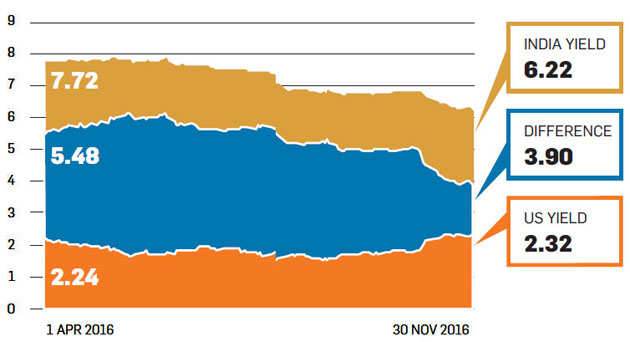
What should investors do
Though most experts are bearish in the short-term, it still makes sense to have a part of your total portfolio in gold. But financial planners say this should not be more than 5-10% of your total investment portfolio. “Gold is no more a safe haven, so limit the exposure to 5% of your portfolio,” says Gurgaon-based financial planner Taresh Bhatia. The rupee is expected to continue weakening against the dollar, which could benefit gold. “Our foreign exchange reserves are increasing along with a weakening rupee. That means the RBI and the entire economic system prefers a weak rupee. This trend is expected to continue in the coming years as well,” says Manglik. This weakening gold has protected Indian gold investors in the past also. “Historically, Indian gold investors have never lost money in any five-year holding period, mostly because of this rupee depreciation,” he points out.
Also, the uncertainty in the global economy is not yet over. Though one major event (the US election) is out of the way, several such events are expected in the coming months. “It is always better to have some small allocation (say 10-15% of the portfolio) to gold because global uncertainty will always be there. Once the Italian referendum is over, some other event will come,” says Rao.
The rising league of insolvency professionals
India’s incipient battle against bankruptcy is spawning new ideas – and career options. After India enacted tougher laws to deal with sticky loans and the central bank stepped in accelerate the pace of recoveries, finance executives have stumbled upon a career-growth opportunity based, ironically, on insolvency.
Independent insolvency professionals (IPs), are becoming critical for the success of a Rs 8-lakh crore recovery initiative. The Insolvency and Banking Board of India (IBBI), set up last autumn and tasked with providing the framework for recovery proceedings, conducts exams that allow chartered accountants, company secretaries, cost accountants, and advocates to qualify as IPs.
Nagpur-based Arnab Basu, a cost accountant, wants to take the national test so that his 10+year corporate career, facing a mid-life stagnation, gets a boost.
Kolkata-based Rajarshi Ghosh, a middle-aged accountancy professional, is also preparing for the insolvency examination. “In my city , job opportunities are limited but I need to grow in my career. Insolvency is one area to explore,” Ghosh said.
Chartered and cost accountants, company secretaries, and lawyers with a minimum of 10 years of post-qualification experience may be eligible to be appointed as IPs. The IBBI has registered 396 IPs who have cleared their qualifying exams. There are 1,000 unregistered IPs. Former compa ny CEOs, MDs, CGMs are also in the queue to qualify as IPs, which is seen as a crucial link in ensuring that competing claims from stakeholders are settled and funds made available for productive sectors of the economy.
Not the cushiest job
The role of IPs comes with its own set of challenges. “Insolvency is the most promising, but an equally challenging career,” said Vinod Kothari, an insolvency practitioner from Kolkata.
“In many cases, borrowers do not cooperate while sharing the details, and creditors insist on fast-track processing.You have to manage everything, using all resources,” Kothari said. “Your qualification matters, but your experience helps you navigate the situation.”
The primary objective of an IP is to find a resolution plan.The professionals can act in two ways: Interim Resolution Professional, who are appointed by the borrower for the first 30 days of pro ceedings at the National Company Law Board; and Resolution Professionals, who are usually appointed by the committee of creditors for the next 150-240 days of the stipulated period.
“Insolvency professionals should first have huge convincing powers to deal with creditors,” said Pavan Kumar Vijay, founder of Corporate Professionals that employs IPs. “They need to deal with warring financial creditors and tell them clearly that they are gathering to draw up a resolution plan. An IP should be a mix bag of management, financial and legal skills while she must have knowledge of business and innovative ideas.” Sanjay Grover, a CA and CS who has a 20-member team for his newly-launched Delhi firm called Ensemble Resolution Professionals, said the scope for such profes sionals would only increase as more bad loans come up for resolution.”Initially, when this law came into effect in December, we were given six months to do some work and we resolved the matter and recovered Rs 28 crore for a client,” said Grover. “Now, I too plan to give the online test and become a full-time IP because there are lots of small cases where they will require professionals under the new law.”
Complexity and cash
“The initial fee structure for individual “The initial fee structure for individual insolvency professionals like us was subdued. But it will increase once you prove your mettle,” said Navneet Gupta, an insolvency professional, who claims he was the first chartered accountant to clear the IBBI exam in the country .
IRPs and RPs (Interim Resolution Professionals and Resolution Professionals), collectively called IPs, can earn Rs 2 to Rs 15 lakh, depending on the size of business and debts of cases, professionals said. For cases between operational creditors and companies, income opportunities are in the range of Rs 50,000 to Rs 1,50,000 a month as the nature of the cases are less complex.
How resolution professionals prepare to face a new fight of creditors
Resolution professionals, a key constituent of bankruptcy proceedings under India’s new law, are caught between term loan lenders who want sick companies to be liquidated and working capital lenders who favour restructuring the company, four people dealing with resolution of sick companies told ET.
The trouble might be that the law does not make a difference between the two, term loan lenders and financial lenders, and puts them on equal footing. However, the former have their loans secured and have the first charge of assets of a company that goes under.
In case of liquidation, term loan lenders with secured loans are backed by assets and they enjoy the first charge on these assets. Working capital lenders would be interested in revival of the unit, looking at the cash flows from the enterprise.
The conflict could well turn out to be a drag on the country’s mammoth resolution exercise as most cases may eventually go for liquidation on account of difference of views. The law demands 75% consent of lenders to come to any resolution or restructuring exercise. When this fails, liquidation becomes a fait accompli.
“The law puts all financial lenders, be it secured or unsecured, on an equal footing,” said Pavan Kumar Vijay, founder of Corporate Professionals, a Delhi-based firm that advises clients about bankruptcy proceedings. “Term loan lenders could be keen to liquidate the company as their loans are secured by first charge on immovable properties having better realisable value.”
“A company’s restructuring could only dim chances of their early recoveries,” he said. First charge allows lenders to claim their share of recovery first when a defaulting company is wound up.
At the heart is the differing motivations of senior secured lenders, typically term lenders, and junior secured lenders, typically working capital lenders, said Vinod Kothari, an insolvency practitioner.
“In terms voting rights, both have same voting rights, while their interests differ. This itself may create situations of conflict, thus causing the resolution plan to fail,” Kothari said.
The Insolvency & Bankruptcy Board of India has so far listed 100 cases for resolution, and those were listed in January will soon complete the initial 180-day period and if resolution fails within this period, they may get extension of a maximum of 90 days. Failure in arriving at a resolution even after 270 days means the company would be necessarily liquidated.
For instance, a mid-size company that went to National Company Law Tribunal is facing the same dilemma. Among a 14-bank consortium, only one bank has exclusive charge, highest right over the company’s loan collaterals. The bank with exclusive charge is insisting on liquidation, said an advisor involved in the processes, while the 13 others are seeking restructuring.
“Such disagreement may adversely affect the insolvency resolution process under the Bankruptcy Code,” said Souvik Ganguly of Acuity Law. He however said that if the right resolution plan is adopted, secured lenders may benefit more as recoveries from a going concern should be higher than when liquidated.
“The valuation of collateral securities is the key trigger for secured lenders insisting on liquidation,” said Navneet Gupta, a Delhi-based insolvency professional. “If the current market valuation of underlying assets is lucrative enough, it is natural for them to go for liquidation. But, unsecured lenders come at the fourth rank in waterfall when a company goes to liquidation,” he said.
Meanwhile, asset reconstruction companies, which have bought bad loans from banks at discounted prices, are weighing their options between the two warring group of creditors as they look for appreciation of the company’s value.
Time to make compliance better
As the initial frenzy over de-legalising of Rs 500 and Rs 1,000 currency notes ebbs, many small business owners and self-employed professionals are learning to live with a new reality — there will be more scrutiny of their incomes, expenses and tax compliance.
Many tax consultants and chartered accountants say there have been several enquiries from clients seeking guidance on how to rework their businesses to remain tax compliant. “Bulk of these enquiries are from traders and self-employed professionals who have a fairly large cash component in their business dealings that usually escaped the book of accounts,” says Paras Mehra, a Delhi-based chartered accountant.
Pavan Kumar Vijay, founder and managing director, Corporate Professionals, says: “We have received at least 50 requests from clients looking to restructure their businesses or register new companies.”
Experts say many small business owners now want to come clean on taxes. “Compliance is where we see significant impact of demonetisation,” says Pallav Pradyumn Narang, partner, Arkay & Arkay Chartered Accountants. “There will be an increase in the number of people paying taxes and filing tax returns as more and more transactions are moved into the regular banking channel.” Vijay of Corporate Professionals says he expects a spurt in registration of new businesses. “Many small businesses will take this opportunity to start afresh.”
Experts point out that the demonetisation exercise has forced many individuals to declare and deposit their cash holdings in banks, which will be captured by the tax net. If this cash flow is not backed by commensurate business income or fees, it will be taxed at the rate of 30 per cent and could attract penalty of up to 200 per cent of the tax evaded.
Riaz Thingna, director of Grant Thornton Advisory, says any additional recorded revenues will lead to added compliance, like tax audits for sole proprietors and partnerships, in cases where gross revenue was earlier below the specified threshold.
From an accounting perspective, experts say large and small businesses will not need realignment in their accounting processes and strategies. “There will not be significant impact on how businesses account for incomes, as cash and cash equivalents are treated on a par for accounting purposes,” says Narang.
The demonetisation move, which may soon be followed by a new indirect tax regime under the Goods and Services Tax (expected to be rolled out from April 2017), will make it prudent for small business and professionals to appropriately capture sales, purchases and stock details for tax and financial reporting purposes, say experts. “Small business entities should immediately consider procuring accounting software packages capable of capturing the minute details of sales, purchases and stock appropriately,” says Pritam Mahure, a Pune-based chartered accountant. These entities should reconcile bank details with the sale details regularly to identify any mismatch. Mahure says the shift towards digital currency could lead to a fluctuation in revenues of small businesses as buyers increasingly insist on digital currency (including cards and wallets) and request invoices.
Despite a rise in compliance costs, the capturing and reporting of transactions will serve well small business entities in the long term. “Access to more working capital from banks, more productive avenues to invest surplus funds from business and increased corporate governance will spur growth,” says Thingna.
Experts, however, point out that these businesses would have to brace for some cash flow challenges due to tax deducted at source and GST payments on a monthly basis. “Small businesses and entrepreneurs should see this as an opportunity to use compliance as a tool to strengthen internal controls and processes to bolster management practices.” Early adaptation of record-keeping may help minimise the negative cash flow impact.
For small businesses looking to restructure operations, Amit Maheshwari, partner, Ashok Maheshwary & Associates, says it is better to choose their business structure depending on scale, nature of transactions and investment requirements. Tax experts note that registering of new business is likely to become simpler. From December, the government will roll out a scheme to incorporate companies electronically, under Simplified Proforma for Incorporating a Company Electronically e-form. The initiative under the Ease of Doing Business, government officials claim, will provide speedy incorporation-related services.
A higher level of compliance is something small businesses and self-employed professionals will have to learn to live with.
CAs, bankers in a rush to pass insolvency exam
With the Reserve Bank of India (RBI) asking banks to take defaulters through the insolvency process, the role of insolvency professionals has assumed importance and people are rushing to clear the qualifying examination.
Sources said bankers last week met to decide on the appointment such professionals, considering the number of cases that would pile up and the acute shortage of insolvency professionals in the country.
However, the gap was expected to close fast as many had queued up to qualify as insolvency professionals, said Khushroo Panthaky, director at Grant Thornton Advisory.
Earlier, the hierarchy of preference for claims in liquidation proceedings was government, banks and then operational creditors. Under the bankruptcy law, banks’ claims come first and the government’s the last. This would speed up bankruptcy proceedings, experts said.
There is also big money involved. According to bankers, the monthly remuneration for an insolvency professional can be as high as Rs 2 crore, depending on the complication and size of the case.
“An insolvency professional is really the CEO of the company. But that does not mean creditors who have substantial interest in the proceedings cannot raise objections. At the end of the day, for an effective resolution plan to come together, the professional has to take on board bankers, operational creditors and other stakeholders,” Panthaky said.
The rules say a firm cannot become an insolvency professional entity unless more than half its partners have cleared the examination. So the arrangement is to hire only the person as a professional, who could have a back-to-back arrangements with his firm to engage other professionals to assist him.
But earning the fat cheque is not the only motivation to clear the examination. Several bankers are taking the examination to effectively deal with proceedings and to understand the workings of insolvency professionals. The Insolvency and Bankruptcy Board of India (IBBI) regulates the functioning of these professionals on a case-to-case basis.
The Institute of Chartered Accountants of India (ICAI) and the Institute of Company Secretaries (ICSI) have formulated sample papers for their members who wish to enroll as insolvency professionals. These sample papers are based on the format followed by the IBBI. This examination has been set on the lines of competitive examinations like the IIT-JEE. The ICAI has also made a module of about six hours to help its members clear the examination.
The examination quizzes aspirants on the Companies Act, Evidence Act, and the Insolvency and Bankruptcy Code among others.
The first examination will be completed in June, after which there will be a new examination with some modifications. This is also one of the reasons for the rush.
“I tried to book one centre in Mumbai for June 30, but of the seven centres, none was free,” said a chartered accountant.
Law firms, too, are training their professionals. Pavan Vijay, who runs Corporate Professionals, said everyone in his law firm had trained in the field as insolvency procedures required people from various fields. “One person alone cannot take up insolvency proceedings. It requires a team with varied professionals,” he added.
The IBBI has registered nearly 500 insolvency professionals. Around 1,000 insolvency professionals had enrolled for a period of six months after which they had to appear for an examination for full-time registration.
A Delhi-based aspiring insolvency professional said studying for the examination was like going back to college. “I had to go back to the basics and gradually studied complex concepts,” he added.
Digital Tools Empowering company secretaries to survive Digi-Tsunami
Technology is the word. In the wake of India
being in the cusp of a digital revolution,
the role of the company secretaries
(CS) has gained immense criticality. It is
one profession through which one can
contribute more towards the society than
any other profession.
This upcoming dynamism in the role of
the CS was well explained in the words of
Rajesh Sharma, Government Nominee,
Council member ICSI. He said: “The CS
are the closest to the whole hierarchy of
the top management. We are the key
managerial persons amongst the board
of directors. We sense for the corporate
structure and therefore we are very important.”
Dynamics of the business are changing
very fast. It is a complete consumer driven
economy where consumer is the
king. Talking on these lines, Pramod Mulani
– Head, Product and Digital Initiative
Division, NSDCL, said: “The future pans
out to be that of fierce competition. This
will be followed by regulatory changes
and then profitability pressure will be taking
over leaving us into a complex technology
landscape where the role of CS
will come into picture.”
In this scenario, encouraging the secretaries
across the demography, Sharma
said that they were the positive professionals
as their growth means the growth
of the economy, growth of companies and
growth of the nation as a whole. “A lawyer
prospers when there is more crime and
thus cases; a doctor prospers when there
is more illness but a CS prospers when
there is growth and development. So, we
are the positive professionals,” he added.
A profession that started with just
1400, today has over 50,000 professionals
in the country and over 75,000 if we
consider across the globe and many are
in the process to become one. This is a
unique profession, said Paroon Chadha,
Co-founder & CEO of Passageways.
CS is a profession that fuels the journey
of this digital transformation. A transformation
that when converted to numbers
reflects that there will be 520 million
smart phone users by 2020 and close to
$500 billion payments will flow electronically
by 2020.
Dynamic social media changes are
changing relationships. As per the predictions,
there would be as many as 200 billion
apps by 2020.
Tracing history we find that it took 38
years for radio to percolate down social
threads and 14 years for television but if
we look at the recent past, iphones did it
in 3 years, Instagram in two years and the
game Angry bird reached millions in just
35 days. So from decades it has become
days.
To be able to keep up with this fast
paced growth, the CS also need to be updated.
Aim towards a paperless office, be
more connected through technology.
“The recent changes in digitization are
changing business and therefore, to
maintain the new development in the
technological tsunami, the ways have to
be change,” explained Pavan Kumar Vijay,
MD of Corporate Professionals Capital
Pvt Ltd.
Insolvency law off to a good start
authored by Manoj Kumar Partner & head, M&A transactions, Corporate Professionals.
THE INSOLVENCY AND BANK¬RUPTCY Code (IBC) 2016 has had a reasonably good beginning with the Insolvency and Bankruptcy Board of India (IBBI) being made operational from December 1, 2016. The Bank¬ruptcy Code aims to improve the ease of doing business in the country by fa¬cilitating smoother and time-bound settlement of insolvency and faster turnaround of businesses, along with creating a database of serial defaulters. According to available data, more than 120 cases have already been filed with the National Company Law Tribunal, the adjudicating authority on corpo¬rate insolvency matters.
The govt must increase the number of NCLT benches for speedy disposal and ensure quick transfer of cases from high courts to the tribunal. Attracting high- quality insolvency professionals to build best practices and assist the IBBI for effective implementation of IBC will be a tough challenge
The cases have been filed by opera¬tional creditors, financial creditors or the companies themselves for ad judication under the new bankruptcy code. NCLT has admitted around 85 matters, but most of the cases are in the initial stage with interim Insolvency Resolu¬tion Professionals (IRPs) appointed. The IRPs are mandated by the code and IBBI regulations to appoint valuers to deter¬mine liquidation value, collect claims and set up the committee of creditors involved in a case. The IRPs are then tasked with suggesting a resolution plan after taking into account business viability, debt size, etc. They are em¬powered to solicit help from industry specialists, investment bankers and other competent personnel while struc¬turing a resolution plan.
The resolution plan can be in the form of debt restructuring, one-time settlement of debt, merger/de-merger, sale of the business, etc. The commit¬tee of creditors has 180 days to ap¬prove the resolution plan from the date of admission of the company un¬der the insolvency process. The same can be extended by 90 days in genuine cases where a resolution is about to happen. In case the committee of cred¬itors cannot approve any of the resolu¬tion plans, then the company would go directly into liquidation
Since the IBC provides fora time- bound framework, it puts enormous pressure on the promoters as wells as the lenders to fast-track a compro¬mise formula or run the risk of the as¬set being liquidated. The new law has surely put an end to the practice of promoters/management indefinitely deferring the resolution process at various fora such as BIFR, DRT, arbi-tration, etc.
With an estimated ? 6 lakh crore in accumulated NPAs, creditors, particu¬larly banks, are expected to be the main beneficiary of this law. Yet, a quick analysis of the cases filed so far reveals that creditors have so far largely refrained from approaching NCLT under the Bankruptcy Code. Among the seven applications filed by financial creditors so far, only three have been filed by banks and these are related only to small accounts. It is likely that banks are first testing the efficacy of the new code with small cases and are wait¬ing for the new mecha¬nism to be streamlined.
There could also be the apprehension in bank¬ing circles that the liqui¬dation value could end up being much lower than the book value of bad assets.
However, after the re¬cent ordinance that em¬powered Reserve Bank of India to go all out against bad loans, it is now likely that the cen¬tral bank will push banks aggressively to take the Bankruptcy Code route for resolu¬tion of stressed assets. It is likely that priority will be given to first resolve 50 large stressed asset cases in a time-bound manner, including invoking insol¬vency proceedings. This will make re¬coveries both higher and faster. At the same time, RBI is expected to bring clarity on accounting treatment of those stressed assets against which in¬solvency proceedings have been initi¬ated under Bankruptcy Code.
On its part, the government needs to increase the number of benches of NCLT for speedy disposal and ensure quick transfer of cases from high courts to the tribunal. Further, there are also a few challenges. The first challenge is at¬tracting high-quality insolvency pro¬fessionals to set up the institution, build best practices and assist the board for effective implementation of the bankruptcy code. The second challenge will be for judges and professionals to meet the deadline of 180 days for arriving at a reso¬lution plan.
Despite the teething chal¬lenges, the new law, with its time-bound approach, surely provides a refresh¬ing change and makes it easier for creditors to re¬cover loans faster. While the old insolvency process was riddled with bottle¬necks and loopholes, thereby allowing vested interests to sabotage or cause inordinate delays, the implementation of IBC will give confidence to lending institutions and go a long way in improving the flow and availability of credit in the economy. IBC 2016 will evolve with time. It is thus critical that various stakeholders vig¬orously adopt it and refer to it for a resolution so that the law succeeds.
Well within the law
On October 24, the chairman of Tata Sons Ltd, Cyrus Mistry, was replaced by his predecessor in a decision taken by the board members of the salt to steel giant. As both sides stay firm on their stand, the removal is likely to turn into a protracted legal battle between Tata Sons and Cyrus P Mistry. Playing safe, the Tata Group has filed caveat in multiple law forums to avoid any ex-parte order that may arise from this ouster. Any relief, if sought by Mistry, cannot be granted without listening to Tata’s arguments.
In an e-mail sent by Mistry after he was ousted, he alleged that the removal was without any explanation and without affording him the opportunity of defending himself. Moreover, the changes in the Articles of Association of Tata Sons hampered his ability to function in an independent manner. These changes effectively gave Tata Trusts, which own two-thirds of Tata Sons, the right to appoint and remove the chairman and were condemned for the want of fair corporate governance practices.
As alleged by Mistry, no prior written intimation was given to him. The decision must have been duly debated, keeping in view the size of the company and significance of the position of chairman. Besides, as alleged, the Board had also sought a legal opinion in support of its decision. Thus, it seems that the act of the management was a concerted one, which must have taken some time to finally take effect. Even then, if Mistry was unaware of such a proposal then it indicates that the decision was arrived at behind the closed doors of Tata Sons management, of which the chairman was an integral part. Mistry has also asserted that the matter was not made a part of the Board meeting agenda but was taken up only as ‘any other item’ with consent of majority directors.
It may be contended that considering the significance of Mistry’s position and considering the fact that his family group—Shapoorji Pallonji—owns 18% stake of the company, the company should have assumed good corporate governance approach to include this critical matter expressly as part of the board meeting agenda. Such prior disclosure not only gives an opportunity to the Board members to come prepared with their views and suggestions but also enables the chairman, whose removal is proposed, to prepare his defense and make necessary submissions before the Board members to oppose his removal.
While the Companies Act, 2013 requires seven days’ notice to be given for a Board meeting, it is silent on the issue of sending agenda in advance. The applicable Secretarial Standard, however, states that “the Agenda, setting out the business to be transacted at the meeting, and notes on Agenda shall be given to the directors at least seven days before the date of the meeting, unless the Articles prescribe a longer period”. The Secretarial Standard further provides that “Any item not included in the Agenda may be taken up for consideration with the permission of the Chairman and with consent of a majority of the directors present in the meeting, which shall include at least one Independent director, if any.” Thus, the act seems to be within the four corners of law.
The principles of natural justice require that an opportunity for being heard must be given to the person against whom a decision is to be taken, as no one should be condemned unheard. The failure to do so renders the decision ineffective and void-ab-initio. However, it is a settled position that the principles of natural justice are restricted to judicial and administrative functions of the state and they do not have equivalent application in managerial decisions that are strictly in private nature.
The Companies Act, the rules and the secretarial standard also nowhere specifically require that explanation has to be sought from the chairman whose removal has been proposed. Thus, the company was under no obligation to seek an explanation from Mistry or grant him an opportunity to present his defense against the proposed removal.
It cannot be denied that the act of the board is within the four corners of law. In fact, it is difficult to imagine the damage that the said news could have caused to the market, if the item for removal of chairman was included in the items of agenda. In addition, it would have raised issues of insider trading. Good corporate governance should always be viewed from overall interest of all stakeholders and not merely an individual’s interest. Further, it does not seem to be an act of oppression of a minority shareholder. Section 241 of the Companies Act provides for relief if a company is run in a manner that is oppressive to any members. Last, being the Board chairman as well as chairman of the general meeting, Mistry was aware when changes in articles of association giving certain powers to directors app
ointed by Dorabji Tata Trust and Ratan Tata Trust were made.
The fate of the legal battle would be determined in the admiration of the established contentions of both parties.
Pavan Kumar Vijay
The author is founder, Corporate Professionals.
Stressed assets open floodgates for insolvency professionals
The Reserve Bank of India’s (RBI’s) move to push 12 large non-performing assets (NPAs) of the banking system into the insolvency process has created a massive business opportunity of up to ~2,500 crore for insolvency professionals.
To put the numbers in perspective, the RBI list comprises four companies with dues of over ~35,000 crore each. Even if one puts together all the few hundred cases handled by the six-month old framework, it would be a struggle to cross ~20,000 crore.
While the huge influx is likely to test the capacity of most players who are literally months old in the profession and present a steep learning curve, it will be a great stimulus for entry of stronger hands and investment in the segment.
According to the insolvency law, the entire process of corporate insolvency needs to be managed by a resolution professional appointed by a committee of creditors. The resolution professional, who will effectively become the chief executive officer of the business during the process period of 180 days, can charge a fee for his services. Besides, banks are also looking to appoint insolvency professionals to populate committees of creditors, which need to be formed for each of these companies.
With over ~2.5 lakh crore debt coming in the top 12 companies in the first list, a one per cent charge works out to ~2,500 crore. While this would be a ballpark figure, regulations do not prescribe a limit or range of fees, leaving a free hand for market forces. Globally, insolvency professionals work on various structures such as a fixed fee, timeand effort-based charges, or a percentage of realisation. In some cases, a combination of these three methods could also be used. Banks would have pricing power, but good insolvency professionals would have their levers to charge a decent number, given the complexities involved and short supply.
Pavan K Vijay, managing director of Corporate Professionals, a Delhi-based firm that is looking at this opportunity, says the move gives a big boost to the nascent profession. “Even if the one per cent number does not work out, as there are bound to be negotiations, it could be around ~1,500 crore to ~2,000 crore. It is not small.”
The State Bank of India (SBI), the country’s largest lender, which also has the lion’s share of these 12 large accounts, has begun the process of empanelling insolvency professionals by issuing advertisements recently.
“The bank (SBI) seeks to empanel IRPs (insolvency resolution professionals) as resolution professionals in applications filed before the National Company Law Tribunal for resolution and/or liquidation proceedings, including for representing the bank in the committee of creditors as per the provisions of the code/and the regulations,” said the advertisements issued early last week.
Other banks are likely to follow similar processes in selecting insolvency professionals, as the public sector is generally processdriven, regulatory officials say.
According to the Insolvency and Bankruptcy Board of India (IBBI) website, there were some 977 registered insolvency professionals in the inaugural limited period criteria and another 350 in the regular category, which requires passing the national insolvency examination. Lawyers, chartered accountants, and company secretaries form a majority. However, not all of them might be able to handle the large mandates. Given the large accounts it handles, the SBI has set stiff eligibility criteria for the applicants. It wants people with experience in debt restructuring, who are also experts in company law, etc. The application window closes early next week. Since the big accounts bring with them a lot of complexities, individual professionals might not be able to handle the entire task, Vijay said.
Several top lawyers such as Shardul Shroff and Pallavi Shroff of Shardul Amarchand Mangaldas, Alok Dhir of Dhir & Dhir, Bahram Vakil and Dushyant Dave are among the registered insolvency professionals. These would have established infrastructure and people to support their functions.
Also, the insolvency law provides for Insolvency Professional Entities (IPEs), which are corporate structures where two or more professionals can come together as partners or directors. However, there are only seven such registered IPEs as of today, according to the IBBI website. These are IRR Insolvency Professionals, a firm floated by Delhi-based lawyer Alok Dhir, AAA Insolvency Professionals, Witworth Insolvency Professionals, Gyan Shree Insolvency Professionals, A2Z Insolvency Services, Turnaround Insolvency and Nangia Insolvency Professionals.
Sandeep Gupta of Witworth, which is already handling a few mandates, feels while the opportunity is big, capacity and capabilities also need to be built up. “It is the beyond the means of an individual to handle a book size of several thousand crores. A company of such a size would have numerous non-financial creditors as well. These need to be handled in a given time frame. The resolution professional would need adequate support in terms of people and infrastructure,” he said.
For instance, Gupta said, he might hire a few freelance chief financial officers to manage one of the big accounts. Considering all this, calculating fee on a percentage basis could be misleading. It should be calculated, based on time and effort put in by the insolvency professional, he argued.
The SBI advertisement asks applicants to provide “tentative fees proposed to be charged” for various roles such as interim resolution professional, resolution professional on behalf of the committee of creditors or for being appointed as an insolvency professional to represent the bank in the committee of creditors. The bank also wanted to know whether the applicant would be “willing to abide by the fees decided by the bank.”
Why shares with differential voting rights have failed
Even a few years after shares with differential voting rights (DVRs) were introduced in India, some of them continue to trade at a big discount vis-a-vis ordinary shares. Skimpy dividends, little say in matters that come up for voting, and lower participation among investors seem to be the reasons.
After the first DVR shares in the listed space was introduced by Tata Motors in November 2008, three others — Gujarat NRE Coke, Pantaloon Retail (Future Enterprises) and Jain Irrigation — also rolled out DVR shares.
These were issued with lower voting rights and suited investors who were not keen on taking an active part in the proceedings of the company but only interested in its long-term prospects.
While the DVR shares of loss-making Gujarat NRE Coke and restructured Future Enterprises have narrowed the discount over the ordinary shares, DVRs of prominent companies such as Tata Motors and Jain Irrigation continue to trade at a 30-40 per cent discount to the ordinary shares.
Gap narrows, but remains
From about 84 per cent in the quarter ended December 2008, promoter holding in the Tata Motors DVR came down to 19 per cent by December 2010 and to about 0.10 per cent at the end of the September 2016 quarter. While the current discount is narrower than the 40-50 per cent seen during the bear market of 2011 and the volatile market of 2013, the gap nevertheless remains wide even after increased public and institutional participation and inclusion in the Nifty index.
Similarly, promoter holding in DVR shares of Jain Irrigation has remained at a comfortable 30 per cent since the beginning. But while discount between the DVR shares of Jain Irrigation and the ordinary shares has narrowed from the 50 per cent levels seen during the 2013 volatility, it continues to remain at 30-40 per cent even today.
In contrast, the average discount between different classes of shares of companies such as Alphabet, Discovery Communications and News Corp, listed the US, is less than 5 per cent.
Low popularity
One reason for the lower popularity of the DVR shares could be the discontent on the dividend front. The erstwhile Pantaloons and Tata Motors could issue DVR shares with one-tenth the voting right, and a 5 per cent higher dividend entitlement than the ordinary shares as compensation.
But a SEBI circular in July 2009 prohibited listed companies from issuing shares with superior rights as to voting or dividend over equity shares that are already listed, explains Pavan Kumar Vijay, Managing Director of Corporate Professionals, a legal and financial advisory firm.
Following this, the DVR issue of Jain Irrigation that came out in November 2011 did not offer higher dividends to compensate for lower voting rights.
Says Shriram Subramanian, Founder and MD, InGovern, a proxy advisory firm, “A premium is given to (full) voting rights as when it comes to control situations, there will be very little say for the DVR shareholders.”
Given the latest tussle in the Tata group companies, DVR shareholders’ voices could be less heard if any matter relating to this is brought to vote in the near future.
Probably recognising this fact, Pantaloons, in early 2012, increased the voting rights on its DVR shares from 10 per cent of the ordinary shares to 75 per cent, and brought down the incremental dividend to 2 per cent.
A third reason for the wide discount, according to Shriram Subramanian, is the absence of liquidity in DVRs for foreign investors.
Citing reports put out by a global advisory firm, he says, “American Depository Receipts of the equity shares (Tata Motors) are listed abroad in the NYSE, whereas ADRs of the DVR shares are not listed.”
Here’s how to boost employee performance in public sector banks
Mohini Varshneya is AVP & head, ESOP Services, Corporate Professionals, the legal and financial solutions provider.
Employee stock options plans (ESOPs) are strategy wherein eligible employees are awarded equity shares at a predetermined rate that is generally lesser than the market value of such shares. ESOPs have gained recognition globally as well as in India. Starting from the IT industry, ESOPs have made way into diverse sectors. An interesting trend is that the BFSI sector is increasingly showing interest in ESOPs.
In August 2015, the government announced ESOPs for employees of public sector banks (PSBs). But implementation took time. Now, after a delay of almost two years, the finance ministry has given its nod to implement ESOPs in PSBs.
The current compensation structure of PSBs includes a fixed pay scale and different allowances. This is contrary to their private peers who consider the performance criteria while evaluating pay packages. PSBs also face talent crunch due to the difference in compensation between public and private sectors. Now, payments banks are entering the sector. As a result, PSBs are finding it difficult to retain their employees. All of this demands a review of existing structure and introduction of new methodologies that can improve employee benefits.
What PSBs need is a reward judgement on the basis of performance of employees. Those who outstand should feel motivated. Therefore, including ESOPs as part of performance-related pay of employees will serve two purposes, i.e. reduction in cash pay-outs and enhancement of employee satisfaction.
The Banks Board Bureau has suggested the government to consider ESOPs linked to a bank’s profitability, to better incentivise employees, especially top management. Since employees stand to benefit from any appreciation in stock price, ESOPs help align the interests of employees with those of shareholders. ESOPs can motivate employees to work towards strengthening the financial status of their banks so that their share value rises. This move can retain human assets and make them realise that they are not, in any manner, behind their counterparts in private banks. ESOPs can also help ensure accountability and sense of responsibility and ownership among bank executives.
It is worth noting that the hierarchy and vast coverage of PSBs makes this task seem difficult to implement. Thus, it is important to forecast the prospective benefits of ESOPs. The step can make PSB employees feel more aligned to their work and targets, and lead to increase in bank profitability.
Transition from cash to cashless won’t be easy
With a sharp increase in the number of digital options, it is quite possible to manage most of the day’s expense with too much of hard cash. You can pay for a taxi (Uber, Ola and other app-based services) by using a mobile wallet. Those travelling by metro, bus or train, can use smart cards to pay for the service. Lunch in the office canteen can be bought using coupons. If you eat at a restaurant, pay by debit or credit card. Grocery shopping on the way home, too, can be done using card. Yes, the occasional cup of roadside tea or coffee, travel in an auto and if you want to buy fruits and vegetable from a vendor, you will need some cash. But, it isn’t a major amount.
So, the recent government order banning currency notes of Rs 500 and Rs 1,000 should not really scare anyone, right? No. Cash is still king for a large number of Indians simply because it is widely accepted and convenient.
Naveen Surya, managing director of digital payments company ItzCash and chairman of Payments Council of India (PCI) says, “The challenge is that no other alternative comes close to cash. That is why digital payments account for only 10 per cent as against 90 per cent of cash transactions. No questions are asked for a cash payment up to Rs 50,000. But, for a credit payment more than Rs 10,000 consumers are asked for identity proof and so on. Either other modes should be made as easy to use as cash or questions should be asked while using cash too.’’ The government’s proposal, a few months ago, to disallow cash payments for transactions above Rs 3 lakh, too, was a move in this direction.
Customers prefer cash simply because it is perceived to be inexpensive and easy, points out Deepak Chandnani, chief executive officer-Worldline South Asia and Middle East, a payment services company.
“The penetration of acceptance infrastructure is currently at a dismal 1.3 million Point-of-Sales (POS) terminals. As long as the acceptance infrastructure in India does not match the pace of growth of cards and other cashless modes, customers will use cash,” he says.
As of March 2016, India had about 660 million debit cards in circulation, and 87 percent of debit card usage at ATMs was for cash withdrawal. For a country of the size of India, the number of credit cards in circulation — 23 million in force — is minuscule and activation rates of the more-than-200 million prepaid payment instruments remain low, says a report by Visa.
Restricted acceptance: The major challenge is that alternate methods are largely restricted to urban establishments and that, too, the bigger stores, says Naveen Kukreja, CEO and Co-founder of Paisabazaar.com. In some cases, the regulations discourage the use of these instruments, for instance, the surcharge of 1.6 per cent while booking railway tickets using credit cards. The government has proposed to do away with this surcharge for all government-related payments. Some retail stores accept card payment only above a certain limit or charge a higher amount for card payments. “But customers must object to this and should lodge a complaint with the card provider or bank, says Naveen Chandani, Chief Business Development Officer
Awareness and customers’ mind-set: Many customers still use their debit cards only as an ATM card, either because they don’t know that it can be used for swipe or because they fear cards getting hacked, says Kukreja.
Mobile wallets aren’t used so muchas the money stored do not earn any interest unlike a savings bank account. However, the new payments banks that will start operations soon will address this issue.
Pavan Vijay, Founder, Corporate Professionals, says: “The risk of disclosing private information and fear of identity theft is another reason why consumers are reluctant to opt for internet banking. That is why a many customers refuse to opt for online banking facilities. Therefore, there is a need to secure transactions across diverse digital ecosystem.” Access to internet, connectivity and network are some other practical problems customers face when it comes to digital transactions.
What needs to be done? Wherever card payments are accepted, like grocery and medical stores, retail outlets, malls, jewellery shops etc., customers should opt for card payments. Services like cab bookings, utility payments etc already provide cashless payment options like which customers should now use instead of cash, says Chandnani.
Allowing interoperability in mobile wallets, allowing the use of all instruments like credit/debit cards, mobile wallets, in addition to be bank accounts on the Unified Payments Interface (UPI) platform will improve acceptance of digital or electronic payments, says Surya.
Hunting Black Bucks
In the 2014 elections, nobody tapped the public mood against corruption as well as Narendra Modi – one of whose promises included bringing black money stashed abroad back to the country and crediting each citizen’s bank account with Rs 15 lakh. After taking over as prime minister, he found that it was easier said than done.
First, in early 2015, Bharatiya Janata Party, or BJP, President Amit Shah said the Rs 15 lakh promise was a chunavi jumla (poll gimmick). Months later, a cornered government came out with a scheme for voluntary disclosure of foreign assets. It attracted just 638 declarations, worth Rs 3,770 crore, much less than the target, and that too mostly by those living abroad. This year, the government came out with another scheme, the Income Disclosure Scheme (IDS) – the 14th since 1951 – for tapping domestic black money. This one fared better with 64,275 declarations amounting to Rs 65,250 crore, yielding a tax revenue of Rs 29,632 crore at 45 per cent rate (30 per cent tax plus 15 per cent penalty). What worked this time were 70,000 letters questioning high-value transactions not linked to Permanent Account Number, or PAN, many involving roadside vendors such as owners of juice centres at Ghatkopar, a vada pav vendor in Thane, a dosa centre in Ghatkopar, a sandwich shop in Andheri and a famous sweet shop owner in South Mumbai. In the last two weeks of the scheme, in Mumbai alone, nearly 700 such small players were either surveyed or issued letters. This was besides lakhs of SMSes informing taxpayers about the scheme, social media campaigns, close to 5,500 awareness meetings in different cities attended by officers and political leaders, the conventional surveys and, lastly, an appeal by Modi himself in his regular radio broadcast Mann Ki Baat. To enable more declarations, the finance ministry also delayed the notification of latest changes to the Benami Transaction (Prohibition) Act that give the government power to confiscate property and impose heavy penalties. “The window allowed many people to come clean on such properties,” says an official involved in implementing the scheme. Revenue officers are already pursuing 1,466 cases involving Rs 50,000 crore indirect tax evasion and undisclosed income of Rs 21,000 crore.
Does the IDS mark a turning point in India’s war against black money, a war in which the NDA government has opened several fronts – right from mandating quoting of PAN for more transactions to tightening of benami property, PMLA and FEMA laws to encouraging use of digital money in place of cash? PMLA is Prevention of Money Laundering Act while FEMA is Foreign Exchange Management Act.
Experts say this is only a start. The government, they say, will have to do a lot more if it wants to be in a position to face voters in 2019. They say disclosure schemes such as the IDS tap a small part of the black economy and that is why the real focus has to be on putting an end to the generation of black money. And this is an area where the government is still to cover any substantial ground. They also point out ethical issues with schemes such as the IDS. “Such schemes are unfair to honest taxpayers and promote tax evasion,” says BJP leader Yashwant Sinha, who was finance minister in the previous NDA government.
The Missing Trillions
Both Sinha and M. Veerappa Moily, who was a minister in the UPA government, say the government has been able to scratch only the surface. Arun Kumar, author of The Black Economy in India and professor of economics at the Jawaharlal Nehru University, says Indians own $2 trillion (Rs 1,32,00,000 crore) black money. R. Vaidyanathan, who teaches finance at IIM-Bangalore, says black money accounts for 6-8 per cent of the country’s economy. He was part of the BJP’s task force on black money along with the present National Security Advisor Ajit Doval, S. Gurumurthy and Mahesh Jethmalani. “Apart from asking people to declare black money, reforms and new legislation should be brought in to close avenues for generation of illicit money,” says Moily.
The big question is – is the government up to the task? “The path the government has followed is correct. But we will have to wait and watch its next step. The next course of action will determine which way the fight against black money goes,” says Sinha.
The next logical step after the IDS is going after the big fish. “Generation of black money happens mostly in India. We can stop a rivulet, but not even an elephant can stop it once it becomes a big river,” says Moily, who chairs the Parliamentary Standing Committee on Finance. He says we must continue efforts to bring back the illicit money kept abroad, but the main focus should be on curbing the generation and flow of black money at home.
Towards this end, the finance ministry this year made PAN mandatory for buying property worth more than Rs 10 lakh (the earlier limit was Rs 5 lakh), any goods/services worth more than Rs 2 lakh, opening term deposits exceeding Rs 50,000 at one go or Rs 5 lakh in a year and investing more than Rs 1 lakh in shares of unlisted companies. There is also a move towards making Aadhaar a must for property transactions to discourage benami deals. Experts say these are the most commonly-used instruments for parking black money. Both FEMA and PMLA have also been amended to enable confiscation of properties in India even if the ill-gotten wealth has been stashed overseas.
But many feel that more can be done. Moily says it is time to do away with the Income Tax (I-T) Act due to scores of exemptions/complications and bring in a simpler direct taxes code or DTC. “We are of the view that the I-T Act has outlived its utility. We need to move towards DTC, with no or very few discretions and exemptions. This will close many avenues for generating black money,” says Moily.
Both Moily and Sinha agree on the need to increase the country’s tax-to-GDP ratio. The 2015/16 Economic Survey said India should move towards the 23 per cent figure; at present, it is at 16.6 per cent, much lower than even the emerging countries’ average of 21 per cent. On October 10, the Parliamentary Standing Committee on Finance started deliberations on this. The discussions centred around taxing rich farmers and professionals such as doctors and lawyers.
The Special Investigation Team, or SIT, on black money, set up under orders from the Supreme Court, has given five sets of recommendations till date. In July this year, it recommended ban on cash transactions above Rs 3 lakh and restricting cash holdings with individuals and companies at Rs 15 lakh. The government is yet to take a call on these suggestions.
One hope of the government is the Goods and Services Tax or GST. As the tax will be levied at the consumer’s end, the credit mechanism – under which one will have to show bills for availing of credit for taxes already paid – will ensure full reporting of transactions and plug indirect tax leakages. “The structure of the new tax, which will replace indirect taxes, will allow authorities to impose tax at the consumption stage. The credit system will encourage consumers to demand bills for every transaction,” says Girish Vanvari, Head of Tax, KPMG India.
Moily agrees the GST will curb black money but adds a word of caution. “It will be beneficial if the tax rates are not exorbitantly high and there is minimum arbitrage (between states),” he says.
The Digital Alternative
One big challenge governments had been facing in their fight against black money was following money trails. Here, technology has been a big help. At present, only 20 per cent of close to $2 trillion transactions a year happen via digital channels such as NEFT, debit/credit cards and digital wallets. Tracking these is easy. That is why a big part of the government’s attempts to curb circulation of black money is aimed at mass adoption of digital payment channels. For this to happen, India will require a world-class digital payments infrastructure, an area where it has made quite a few breakthroughs of late. A few months ago, the National Payments Corporation of India, or NPCIL, launched a low-cost United Payments Interface that will enable people to make everyday payments with a few taps on their smartphones. In 2014, it had announced the launch of RuPay, Indian credit/debit cards whose costs are way less than what global networks such as Visa and Mastercard charge. RuPay debit cards have seen good traction. NPCIL is planning to soon launch credit cards as well.
“Digital transactions have already touched the 50 per cent mark in other BRICS countries. We can easily reach this level provided the government does handholding and reduces or removes the surcharge on digital transactions,”says Naveen Surya, Managing Director, ItzCash, a digital payments company and Chairman of the Payment Council of India, which represents the various regulated non-banking payment industry players.
Surya’s counterparts in the industry say while digital wallets are catching on, it is still easier to use cash. “This needs to be reversed,” says the CEO of a digital payments company. In October 2015, Finance Minister Arun Jaitley said in a Facebook post that “the bulk of black money is still within India. We thus need a change in national attitude where plastic currency becomes the norm and cash an exception”. Four months later, the Cabinet decided to remove surcharges and convenience fee on government-related transactions by the end of 2017/18.
Foreign Hand
All experts BT talked to agreed on one thing – the extreme difficulty of tapping illicit money kept abroad. In 2011, the BJP had claimed that Indians held more than Rs 16,75,000 crore black money abroad. Recent estimates by the Bank of Italy have pegged Indians’ share in black money in low-tax jurisdictions at $152-181 billion. The bank said the total wealth parked in these places was $6-7 trillion.
Officials say it is difficult to bring black money stashed abroad when most information-sharing agreements with low-tax jurisdictions are prospective. Also, there is a doubt over how much we can rely on these tax jurisdictions for information sharing.
Earlier this year, the SIT had sought identification of beneficial owners of Participatory Notes, or P-Notes, offshore derivative instruments issued by Sebi-registered brokers/foreign institutional investors (FIIs) where the underlying is Indian shares. The notes allow foreign players to invest in the Indian stock market without registering with Sebi. In May this year, Sebi tightened disclosure norms for P-Notes, asking the issuers to capture the details of all intermediate transfers. Sebi also said that Indian Know Your Customer (KYC) and Anti-Money Laundering Rules (AML) will apply to P-Note holders too. Earlier, a P-Note holder had to adhere to KYC/AML norms of only his home jurisdiction.
The government has also reworked the Double Tax Avoidance Treaty, or DTAA, with Mauritius, and got the right to tax capital gains arising in Mauritius from sale of shares in Indian companies acquired on or after April 1, 2017. Investors were using the DTAA to avoid paying capital gains tax on income earned in India. It is also working out a plan to target the practice of round-tripping of funds.
India, along with other OECD member countries, has also entered into multilateral agreements (Transfer of Information Agreement) for automatic flow of information from most low-tax jurisdictions. This will start from January 1 next year.
But there is the issue of ability to process the information obtained. Pawan Kumar Vijay, former president of the Institute of Company Secretaries of India, who runs Corporate Professionals, a tax consultancy, says five-six agencies track black money and there is little coordination among them. This, he says, needs to be fixed.
Hope the government is able to plug these loopholes.
Beware of fake currency notes
The Reserve Bank of India (RBI) has warned the public to be on guard against currency notes in a recently issued circular. It is best for people to scrutinise notes carefully and not accept them if they suspect them to be counterfeit. Once you come to possess them, you stand to make a financial loss at the very least, and at worst, you could also get into legal trouble.
When banks receive counterfeit notes from the public, they inform the police, which in turn takes the help of officials at the nearest mint to certify those notes as fake. “The police does investigate such cases. But those investigations don’t achieve much because the person handing over such notes at a bank counter is usually an innocent layperson,” said a banking source on condition of anonymity.
The only positive outcome of the reporting done by the bank, he added, is that the circulation of such notes stops. Whoever handed over those notes stands to lose money.
Economists say that there is a need for the RBI to launch a massive educational campaign on how to identify counterfeit notes. “The RBI needs to also develop standard operating procedures so that when someone happens to come in possession of such notes, he can report them freely to the authorities,” said Madan Sabnavis, chief economist, CARE Ratings.
At present, the laws are inadequate in this regard. Today if you are in possession of counterfeit notes, you could be held guilty.
“The government needs to develop laws that offer protection to the person who reports such currencies,” says Pavan Vijay, founder, Corporate Professionals, an advisory firm.
Till the system develops for protecting laypersons, your best bet is not to accept such currencies. To be able to do so, you need to learn how to identify fake currencies.
Visit the RBI website: https://paisaboltahai.rbi.org.in. Here, posters of the larger denomination currency notes are given: Rs 1,000, Rs 500, Rs 100, Rs 50, Rs 20 and Rs 10. Download these posters and learn about their security features. The above graphic explains five important security features provided in the Rs 500 note.
Five ways to identify fake notes-
- Hold the note against a source of light. Floral design on the left should tell you the denomination
- When held against a light source, the watermark should show a picture of Mahatma Gandhi
- The denomination of the note written in large fonts at the centre changes colour as you view the note from different angles
- Look at empty portion to the right of Gandhiji’s portarit with a magnifying glass. It should say ‘RBI’ and ‘500’
- Hold note against light and look at it from opposite side. The vertical green line appears complete, not broken
Does Mistry have a case against Tatas? Legal opinion divided
While Cyrus Mistry is yet to take any legal recourse against his ouster from Tata Sons, legal experts say he can contest the decision under the provisions of the Companies Act.
Minority shareholders must file an action under Section 241 of Companies Act 2013, which corresponds to oppression and mismanagement, before the National Company Law Tribunal, said Pawan Kumar Vijay, founder, Corporate Professionals Group and former President, Indian Company Secretary Institute. “Mistry has 18 per cent stake in the company, and hence can contest that the majority forced the decision upon him.”
While Tata has filed caveats against Mistry, the courtroom battle is yet to unfold. According to sources close to the development, discussions are going on to make it a foolproof case.
But the question is whether there was a proper notice involved in the removal process or was there any irregularity. “As per Section 101 of Companies Act, if a minimum of seven days’ notice was not given, and if conducted on a shorter notice, no independent director was present or the decision was taken at such a meeting that was not been ratified by an independent director, Mistry has a strong ground to contest against his removal,” said Utsav Gandhi, a Bengaluru-based lawyer.
Mumbai-based company secretary Tushar Shridharani opines that according to the principle of corporate governance, Mistry must respect the collective decision of the board and abide by it. “I don’t think Mistry has any case against Tatas; this is not oppression or mismanagement,” he said. Aliff Fazelbhoy, Senior Partner, ATML Legal, says since Mistry’s reputation has been tattered, he can file a case under tort law under fairness principle. “He may also try to file a criminal complaint for defamation,” he said.
CORPORATE GOVERNANCE Arguing violation of Articles of Association best legal bet for Mistry
As the boardroom battle in Tata Sons heads towards the courtroom, legal experts feel Cyrus Mistry, the ousted chairman, may contest his removal citing provisions in the Articles of Association of Tata Sons. Other legal options include approaching the National Company Law Tribunal (NCLT) alleging mismanagement and oppression of minority shareholders under Sections 241-246 of the Companies Act, 2013.
According to the provisions of company law, a shareholder holding more than 10 per cent shares has the right to file a petition before the NCLT, alleging oppression or mismanagement, seeking appropriate relief. Mistry’s family, the Shapoorji Pallonji group, has 18.4 per cent stake in Tata Sons. About 66 per cent of equity of Tata Sons is held by philanthropic trusts, managed by members of the Tata family.
An aggrieved chairman could also file necessary application before the court for injunction against his removal, said legal experts.
Experts said there is no specific legal provision under the Companies Act, 2013, for removal of the chairman of a board. “The removal process relating to a chairman is typically governed either by the Articles of Association of a company or the terms of the contract by virtue of which he is appointed,” said Rohit Kochhar, managing partner, Kochhar & Co. The board has unfettered power to remove the chairman by passing a resolution backed by a majority vote, unless the Article of Association provides otherwise, he added.
Further, the board is under no statutory obligation to cite any reason at the time of removal of the chairman. “As a matter of governance, the board should discuss the matter and provide the reason for removal and give necessary opportunity to the chairman to represent his case,” said Pavan Kumar Vijay, founder, Corporate Professionals. However, under company law, the chairman does not have any statutory right to represent his case before the board or to assert a defence.
Legal experts said that when a director is removed from the board by the shareholders, the outgoing director has the right to represent his or her case in accordance with Section 169 of the Companies Act. However, in the Tata Sons case, Cyrus Mistry continues to act as a director in the board, representing the Shapoorji Pallonji group. So Mistry cannot claim violation of any statutory right, unless specifically provided for in the Article of Association.
Legal experts said in this case any allegations of mismanagement and oppression of minority shareholder would entail a long-drawn legal battle that is likely to head for arbitration. “Most terms of contracts have provision for arbitration as a dispute resolution mechanism,” said the head of a corporate law firm. So, citing violation of the Articles of Association to contest his removal is the best legal bet for Mistry, said experts. With the Tata group taking evasive legal action by filing caveats in the Bombay high court, Supreme Court and the NCLT, the ball is in Mistry’s court to up the stake in the brewing legal battle.
MCA makes hiring of C-suite easier for companies
Early stage companies that are yet to see significant profit and loss-making companies looking to turnaround will now have more elbow room to hire star CEOs. The Ministry of Corporate Affairs (MCA) has significantly relaxed a company law provision that capped the remuneration payable to top managers. Earlier, it had also eased the rules governing disclosure requirements under the law.
The ministry recently amended Section II of Part-II of the Schedule V of the Companies Act, 2013. The section deals with the monetary limits for remuneration that can be paid to the managerial personnel without central government approval. These limits were specific to companies that had no profit or inadequate profit.
By way of this amendment, the ministry has effectively doubled the remuneration payable without prior approval of government across different categories based on paid-up capital. In further relief to pure-play professionals who are neither related to promoters nor have any other form of ownership the government has done away with the cap altogether. Earlier, any remuneration in excess of 2.5 per cent of the current year’s profit would have required the approval of the central government.
Such a professional should not have any direct or indirect interest or be related to the directors or promoters of the company or its holding company or any of its subsidiaries at any time during the last two years before or on or after the date of appointment and possess graduate level qualification with expertise and specialised knowledge in the field in which the company operates.
An exemption has also been made for shares acquired under ESOP (employee stock option plan) up to a certain threshold. The notification said that “any employee of a company holding shares of the company not exceeding 0.5 per cent of its paid up share capital under any scheme formulated for allotment of shares to such employees including Employees Stock Option Plan or by way of qualification shall be deemed to be a person not having any interest in the capital of the company.”
“This was a long pending issue of great discomfort for the corporate sector. If you want to revive a sick company you need extraordinary talent. If you want to hire such extraordinary talent, the compensation has to be appropriate. The limits prescribed did not take into account ground realities,” said Pavan Kumar Vijay, managing director, Corporate Professionals.
Vijay said the government move would help in the revival of industrial sectors some of which are seeing cyclical downturns. He added that the move would also put an end to certain questionable practices companies had to undertake to circumvent the earlier provisions in order to retain talent.
Earlier, in July this year the MCA had amended the Rule 5 (2) of Managerial Remuneration Rules, 2014. The Board Report of such listed companies required disclosure of all employees receiving remuneration not less than ~60 lakh for a financial year and those working for part of the financial year and receiving remuneration not less than ~5 lakh per month.
The Amended Managerial Remuneration Rules, 2016 have enlarged the aforesaid monetary limit of remuneration to ~1.02 crore, while the per month limit has been enhanced to ~8.5 lakh. However, under all circumstances, the Amended Managerial Remuneration Rules, 2016 require a listed company to include the name of the top ten employees in terms of the remuneration drawn in its Board Report.
“In view of the economic growth of the country and the aforesaid enhancement of the monetary limits in terms of the remuneration drawn by the employees of a company, MCA has acknowledged increase in remuneration of employees of such companies and thereby raised the benchmark for reporting requirements in the Board Report of the concerned companies,” law firm Rajani Associates said in a note.
Queries swamp taxmen as Income Declaration Scheme deadline looms; last-minute spurt in disclosures likely
As the clock ticks down to midnight on September 30, queries about the Income Declaration Scheme (2016) are flooding in with senior income-tax officials expecting a frantic spurt in black money disclosures before time runs out.
The government expects a good response to the scheme that opened on June 1 based on declarations made so far, feedback from tax advisers and inquiries pouring in. And the kind of questions that people are asking? “I received funds through hawala, can I regularise my income now? I sold my house for part cash and part cheque, what should I do?”
Much of the surge in questions has expectedly come from business centres such as Mumbai, Pune, Surat and Ahmedabad, but also, intriguingly, parts of western Uttar Pradesh, officials said.
As with the earlier scheme for declaration of overseas assets, officials expect major declarations in the last few hours, making estimates difficult. An early internal assessment pegs tax collections at more than Rs 25,000 crore.
The income-tax department has intensified its “convert black to white” campaign in the past few weeks, calling on those with undeclared income to come clean or face the music after September 30 while simultaneously holding out the assurance that declarations will be kept secret.
“Response has picked up over the past 10 days,” an official told ET. “It was expected that the filing would be more in the last 10 days, so this is on predictable lines.”
The government had announced a scheme to unearth domestic black money in the February budget.
The four-month window — June 1 to September 30 — gives those with undisclosed income or assets achance to legitimise these by paying tax, penalty and surcharge totalling 45% of fair market value. It also offers an option for staggered payments that can be made in installments through to September 2017. Tax advisers said interest in the scheme had grown in the past 10 days.
The response would have been better if the terms had been more liberal, particularly for valuation of assets on which tax has to be paid on a notional basis, said Chander Sawhney, partner and head, valuation and deals, Corporate Professionals Capital Pvt. “But the message from the income-tax department is very clear and people do not want to take chances.” The late burst will mean collections rising significantly.
“I think the rise in the past few days is partially due to the fact that people wanted to wait till the last to declare and are increasingly realising the consequences of not declaring,” said Amit Maheshwari, partner, Ashok Maheshwary and Associates LLP. “People have also got comfort that a lot of their concerns have been addressed by the Central Board of Direct Taxes by issuing FAQs.”
Sebi tightens norms on promoter-private equity side deals
The Securities and Exchange Board of India (Sebi) on Friday tightened corporate governance norms on compensation agreements between promoters and private equity (PE) funds so that they wouldn’t cut other shareholders out of the loop and allowed foreign portfolio investors to invest directly in corporate bonds without a broker.
The markets regulator also approved raising the ceiling on shares reserved for employees in public issues to Rs 5 lakh from Rs 2 lakh.
New Listing Agreement Norm
“Instances of private equity funds entering into compensation agreements with promoter-directors and key managerial personnel of listed invested companies, based on the performance of such companies, have recently come to light,” Sebi said in a press statement. “However, when such reward agreements are executed without prior approval of shareholders, it could potentially lead to unfair practicesRs
The regulator said it will add a new provision to the listing agreement that would require disclosures and prior approval of shareholders. “If companies already have profit-sharing agreements, it would have to be informed to SEs,” said S Raman, Sebi whole-time member. “Approval would also have to be obtained from their boards and shareholdersRs
Sebi will finalise rules on this after seeking public comments.
An example of what Sebi was referring to was a PE firm agreeing with a promoter to transfer 20% of the profit earned in excess of a 30% internal rate of return on the sale of shares. “Till now, it was a market practice in the unlisted space but it seems to be growing in listed companies too. This would tackle the issue of conflict of interest,” said Sumit Agrawal, partner, Suvan Law Advisors and ex-Sebi official.
Greater transparency
Merchant bankers said the move would enhance transparency. “All such transacions should need public shareholder approval so that no undue advantage is taken at the cost of public shareholders,” said Pavan Kumar Vijay, founder of Corporate Professionals, a corporate advisory firm.
The Sebi board also allowed category I and II foreign portfolio investors (FPIs) to directly access the corporate bond market without brokers, similar to domestic institutions such as banks and insurance companies. But access to over-the-counter and electronic book provider platforms will be allowed to FPIs only for proprietary trading.
“It will help deepen the corporate bond markets by infusing more liquidity in the system and result in greater price discovery,” said Tejesh Chitlangi, partner, IC Legal. “This will also ensure a level playing field between such FPIs and Indian domestic institutionsRs
The Sebi board on Friday met at the new campus of the National Institute of Securities Markets (NISM) at Patalganga near Navi Mumbai. NISM was established by Sebi to lead educational initiatives to enhance the quality of securities market professionals in India and abroad.
Sebi Chairman UK Sinha sought to address concerns of the regulator’s staff over recent raids by the Central Bureau of Investigation. The “Sebi Act has provisions to safeguard employee interest,” he said.
The Sebi board had in 2009 proposed to the finance ministry that an amendment be made to Section 23 of the Sebi Act so that no external agency should be able to seek depositions from the regulator’s officials without the consent of the central government, in the case of the chairman and members, or the chairman, in the case of other officers.
Phantom promoters dodge delisting, and investors
The BSE stock exchange has published a list of 194 companies, delisted for remaining suspended seven years or more. It also gave the fair value to be paid to the public shareholders for each of these.
However, for most of these companies, it does not know who the promoters are, making market participants wonder how these orders would be enforced. According to detailed public notices published in newspapers on Thursday, the column under the head of 'name and addresses of the promoters' read 'not available' for 168 of the 194 cases.
“The names and addresses of promoters as available in exchange records or received from the RoCs (registrar of companies), RTA (registrar and transfer agents) or depositories have been included,” a foot note said.
The delisting move is part of the drive by Securities and Exchange Board of India (Sebi) to reduce the number of listed companies. In May, Sebi chairman U K Sinha had said the regulator was pushing for delisting of defunct companies and penalising of the promoters. “If the promoters do not give exit offers, we will take action against them. First, we will debar them from raising funds from the markets. There will be action against the company, the promoters and even directors,” the Sebi chief had said.
The BSE delisting notice said these companies cease to be listed from August 17. Adding: “Promoters of these delisted companies will be required to purchase the shares from public shareholders as per their fair value determined by the independent valuer appointed by the exchange.”
The onus of giving an exit to the public shareholders at the ‘fair value’ mentioned in the notice was on the promoters, the notice added. These unnamed promoters were also barred from accessing the securities market for 10 years.
Investors say the process would become farcical without names of the promoters. Virender Jain, president, Midas Touch Investors Association, which had fought a public interest suit with Sebi on the issue, said: “This is very funny. You are banning some phantoms and allowing them to get away with the booty.” And, said the process was illegal. “Delisting can’t be done without giving public shareholders the fair value.”
Aked about the road ahead and efforts taken by the exchange to trace the promoters, the BSE spokesperson declined to comment.
Senior professionals who deal with securities regulations agreed with Jain’s assessment. “It is infructuous to engage in such a process. They should delist only such companies where all details are available. These companies seem 'undelistable', to coin a term,” said S N Ananthasubramanian, a senior governance professional and past president of The Institute of Company Secretaries of India. Adding: “This seems to be another instance of 'operation successful; patient dead'.”
Under Regulation 22 (6) of the Sebi (Delisting of Equity Shares) Regulations–2009, it is mandatory to disclose 'The names and addresses of the promoters of the company who would be liable under sub-regulation (3) of regulation 23.” The latter regulation stipulates that “the promoter of the company shall acquire delisted equity shares from the public shareholders by paying them the value determined by the valuer.”
Pavan K Vijay, managing director, Corporate Professionals, a Sebi-registered merchant banker, said: “The delisting process should be a combined effort of all regulators. It is not that these people have disappeared into thin air. Though these stocks have not been trading, some of them have kept their companies alive by complying with MCA (ministry of corporate affairs) rules.” He added if the promoters remain anonymous, the whole process becomes a farce. “Who will pay the fair value? Investors won’t get anything.”
Ananthasubramanian said the issue calls for a new provision in the regulations. “They need to do some homework and take a fresh look at the problem at hand, rather than go for on-paper compliance and become a laughing stock.”
Sources close to the exchange said the regulator was in the loop and their efforts to trace these companies had been fruitless. “Emails have been sent to the companies. Showcause notices have been posted but there has not been any response,” an executive said.
Investors felt the exchange has to put in the public domain the efforts it has taken to trace these companies. “How many FIRs (police reports) have they filed against these missing promoters? These people have swindled public money. By putting such a notice without names, we are exonerating them. It allows everyone to wash their hands off completely,” said Jain of Midas Touch.
Promoters jump sinking ship,then sail on others
Their listed firms might have gone defunct long before but their own corporate lives and other businesses seem to be thriving. Several promoters of suspended companies have floated new entities or taken board seats in other listed companies, which are functional and trading.
Business Standard has compiled as many as 11 cases of promoters who are active in the corporate circuit despite their companies being suspended for several years. These companies, which had raised money from the public for businesses ranging from papers to tyres to financial services, had been suspended between 1998 and 2002.
The 11 are India International Marketing Centre, SMC Credits, Mukerian Papers, Dewan Tyres, Kumar’s Cotex, Sanghi Polysters, National Plywood Industries, Sreechem Resins, Vintage Food and Industries, Sugam Agro Tech and Premier Proteins. For various reasons, they ran their businesses to the ground and stopped filing results and other mandatory declarations.
However, the rules often played into promoters’ hands, as they simply washed their hands off the companies, while small shareholders were stuck without an exit. According to data collated from the corporate affairs ministry, these promoters had board seats in other companies, ranging from two to fifteen. Often, the new directorships were taken after the suspensions took effect.
Ashok Kumar Jain of India International Marketing Centre, which was suspended in 2001 for penal reasons, holds five other board positions. Four of these — managing director of Swarn Gems (2002), designated partner of Mooreliving India Building Solutions LLP (2011), Green Petals Capfin (2005) and Ratandeep Creative Jewels (2003) — were taken up after the suspension.
Similarly, Vivek Dewan, managing director of Dewan Tyres, suspended since 2001, became a director in four companies between April and July 2004 — Dewan Tourism, Usha Credits, Rajshree Securities and Ivory Coast Securities. He resigned from the latter two in 2007 but continues in the first two boards. At least three of these 11 promoters held board positions in other listed companies, actively traded in the market. Sudhir Sanghi of Sanghi Polysters, Satya Narayan Kabra of Sreechem Resins and Rajesh Agarwal of Premier Proteins are directors on other listed entities, according to the ministry's records.
The Securities and Exchange Board of India (Sebi) has now reworked the policy and started making promoters accountable for ensuring an exit for small shareholders. Experts say Sebi is contemplating stringent action in cases where exit opportunities are not provided. “So far, being a director of a suspended company was not hampering your status and credibility. This might soon change. As on date, there are 1,498 suspended companies (including some for procedural reasons) on the BSE and another 126 at the National Stock Exchange. Taking a very conservative number of only four promoter-directors per suspended company, around 6,400 persons might soon become ineligible to be appointed as directors of other listed companies,” said Pavan Kumar Vijay, managing director, Corporate Professionals.
Singh Bros back on Religare Board
Billionaire brothers Malvinder Mohan Singh and Shivinder Mohan Singh returned to the board of Religare Enterprises as non-executive chairman and non-executive vice chairman with immediate effect.
Sunil Godhwani, who until now was its chairman and managing director, has been made a whole-time director and the chief executive. The company, majority owned by the Singh family, made an announcement to this effect on Friday.
The brothers' decision to come back on the board after a gap of more than six years has surprised many. These changes have taken at a time when the company has initiated a three-way split to improve the focus on its businesses, and indicate an upcoming major reshuffle in the company management, said a senior executive at a bank that has exposure to the group.
"Our coming on the board will enable us to actively work with members of the board and the management of the company to drive the future direction and growth of Religare," Malvinder Mohan Singh told ET.
The brothers, both promoters of Religare Enterprises, had resigned from the board in April 2010. Malvinder Mohan Singh was the chairman of Religare. One of the reasons for stepping down was to "devote more time in their healthcare business under Fortis Healthcare".
Last September, younger brother Shivinder Mohan Singh, a cofounder of Fortis Healthcare, decided to resign from the executive position of the company and serve full time at the spiritual retreat of Radha Soami Satsang Beas. He remained non-executive director on the board of Fortis, another group company engaged in the healthcare business.
"The promoters' stake in any company is always higher than the professionals', who are also an integral part of the system. There are times the promoters would want to lead from front. This move at Religare indicates towards that," said Pawan Kumar Vijay, founder of legal and finance services firm Corporate Professionals.
Last May, Religare Enterprises decided to split into three independently listed entities, to separately handle lending, health insurance and capital markets operations.
Get Ready to pay for information from your company
Shareholders of Century Textiles and Industries will vote on a resolution which seeks to charge shareholders for documents they seek from the company.
If approved, the company will charge “~50 per document, plus the reimbursement of actual expenses” for sending a requested document to a member.
Century Textiles is not alone. Over the next couple of weeks, Strides Shasun, Aegis Logistics, Alstom India and Wockhardt are among companies which would move the same or similarly worded resolutions at their annual general meeting (AGM).
Alstom India’s resolution had wider scope and sought to include even “incidental expenses”. “Recover expenses, including actual cost of dispatch and incidental expenses from a member requesting the desired documents,” its resolution read.
In an e-mail response, Alstom India , a GE group company said, it had received a formal request from a shareholder for taking up this resolution under Section 20 of the Companies Act, 2013 (the “Act”) at the AGM and hence, it was bound to take it up at this AGM. “Only members can decide the cost for sending documents through a particular mode. The intention is not to deter from providing information since we are also seeking approval of members for waiver of expenses in the said resolution,” the company said.
Some wanted the charges paid in advance, others to charge “estimated expenses”.
In explanatory statements, the companies cite the provision under Section 20 of the Companies Act, 2013. This section mentions the various modes such as post, registered post, speed post, personal delivery and electronic or other means. Further, it provides that if a shareholder wants the communication by a specific means, he needs to pay the fee, which shall be decided in the AGM.
Shareholders and activists see this as anti-investor moves but the companies see this as a measure allowed under the law to ward off shareholders who sometimes demand irrelevant and voluminous documents.
“They want to keep away shareholders like me,” chuckles Shailesh Mehta, a Mumbaibased investor who holds shares in several companies and often corresponds extensively with his portfolio companies. “Normally, dispatch charges have to be borne by the company.”
Amit Tandon of Institutional Investor Advisory Services feels the trend would act as a deterrent to shareholders seeking information. “As most companies now send annual reports by email, this is a a very anti-small shareholder act,” he said.
Other companies did not respond to Business Standard e-mails seeking comments. A public relations executive on behalf of one of the companies said many are taking this step to restrain some trouble makers, who have the habit of asking for numerous documents across multiple companies and getting into frivolous litigation. The executive added the resolutions are enabling in nature and aimed at putting into practice what has been allowed in company law.
Pavan K Vijay, managing director, Corporate Professionals, said companies are well within their rights to so charge. “Section 20 (2) of the Act allows this. There are some shareholders who have the habit of picking up a single share in multiple companies and they go on asking for irrelevant and voluminous documents. Charging the shareholders would help reduce such requests and allow the company to deal with genuine ones.”
House panel moves to curb misuse of stamp duty exemption by ARCs
Stamp duty exemptions may not be available across the board for all financial assets purchased by Asset Reconstruction Companies (ARCs) from banks if a recent Parliament Panel report is anything to go by.
A joint committee of Parliament that went into Sarfaesi and debt recovery laws amendment Bill 2016 wants the government proposal to provide stamp duty exemption to all financial asset purchases by ARCs be confined to certain specific purposes.d
To prevent misuse of stamp duty exemption, the panel has in its report suggested that stamp duty exemption be available only in situations where the exact purpose of acquisition is for “asset reconstruction or securitisation”.
This would mean that ARCs cannot avail themselves of stamp duty exemption where the acquisition is for their own use or their investors’ use. Such a recommendation would also mean that “compromise settlements” – a significant resolution method used in Indian context – may not be entitled for such stamp duty exemptions, says asset reconstruction industry experts.
Commenting on the panel’s recommendation to confine the stamp duty exemption to specific purposes of asset reconstruction and securitisation, P Rudran, former Managing Director and CEO of ARCIL, said this was “a restrictive provision, nevertheless there is lot of substance in what panel has suggested”.
This was not entirely in the spirit of faster resolution of non performing loans, Rudran told BusinessLine.
V Kannan, former Chairman and Managing Director of Vijaya Bank, said that the Joint Committee’s recommendations were in totality a “positive development” for resolution of non-performing loans.
“The panel has sought to prevent misuse of stamp duty exemption which is a welcome development,” said Kannan.
Babu Sivaprakasam, Partner, Economic Laws Practice, a law firm, said the Bill with the clarifications of the Committee intends to put to rest the differential stamp duties applicable on assignment deeds by any bank or Financial Institution in favour of ARC by exempting the stamp duty as various states had issued separate notifications for reduced stamp duty.
Pavan Kumar Vijay, founder, Corporate Professionals, said that the stamp duty exemption is a welcome move and will make this a more viable business for asset reconstruction companies who take over stressed assets from banks.
100 companies get government notice on CSR spend
The Registrar of Companies (RoC) has served warning to about 100 companies over non-disclosure or improper disclosure of their corporate social responsibility (CSR) spending, sending a strong signal that the government is very serious about compliance.
Regional registrars of companies (RoCs) have shot off notices to companies asking them to furnish further details of spending in some cases or face action that could include prosecution as well, a government official said.
Disclosure of CSR spend by companies has been made mandatory by the Companies Act, 2013. In some instances companies have been asked to furnish reasons for shortfall in actual CSR expenditure. In others, including where the board of directors has not mentioned the reasons for not spending the specified amount, show cause notices have been issued.
The RoC has also questioned some companies leaving out dividend income earned during three preceding years while calculating net profit for corporate social responsibility spending. These letters have been issued under Section 206(1) and show cause under Section 450 of the Companies Act.
"…therefore the company and its directors are hereby called upon to show cause within 15 days of this notice that why prosecution should not be launched against them under section 450 of the Act…," according to a copy of the notice seen by ET.
"Discrepancies have been noted in the data provided by the companies some companies that meet the criteria have not even filed the CSR data," the official added.
"The move would ensure 100% implementation of CSR laws in India," said Anshul Jain, partner at law firm Luthra & Luthra. However, experts also emphasise the need for robust compliance systems."Companies need to ensure their compliance systems are robust. This move is a precursor to the government moving towards impact assessment," said Pavan Kumar Vijay, managing director, Corporate Professionals, a legal and financial services firm.
The CSR norms require companies with at least Rs 5 crore net profit or Rs 1,000 crore turnover or Rs 500 crore in net worth to spend at least 2 per cent of their 3-year average annual net profit on CSR activities in each financial year.
Companies have to constitute a CSR committee of their respective board of directors that formulates and recommends to the board activities that can be taken either by the company on its own or through engagement of an NGO.
Under Section 134 (8) of the Companies Act 2013, a company has to submit its financial statement, board report along with all annexures. If a company contravenes the provisions of this section, it is liable to be punished with a fine which is not be less than Rs 25,000 but could extend to Rs 25 lakh. Besides, every officer of the company who is at fault will be punishable with imprisonment for a term which may extend to three years, the Act says.
For the financial year, 2014-15 as many as 460 listed firms disclosed spending Rs 6,337 crore towards CSR activities. A majority of these companies could not fulfil the minimum 2 per cent criteria. For the financial year 2015-16, a clear picture on the CSR spending would only be available next month. Recently, a government appointed committee recommended a couple of changes in section 135 of Companies Act that deals with CSR.
The committee has recommended that the net-worth, turnover, profit criteria for determining applicability of CSR provisions be reckoned per the preceding financial year instead of the last three years.
ESOPs’ An Engagement Initiative Let Your Employees Grow With You.
Since the evolution of Corporate Sector, businesses & employees have gone hand in hand. Employees are the building blocks of any business, so they need to be the part of growth & sharing. In today’s modern business world, human capital has become one of the most important resources. The enterprises are, therefore, more than ever interested not only in retaining their employees, but also for attracting the best talent from outside. Motivation is strongly connected with the employee’s association with the company and is one of the main causes of good or bad performance and thus affects overall operations of the company.
Enterprises adopt various means & measures to resolve the concern pertaining to employee engagement ranging from monetary incentives to appraisals in kind etc. It is important for companies to look for suitable strategy which result in creating win-win situations of employees & employer as well. In such a scenario, ESOPs / Employee Stock Option Plans, as a tool to reward & retain key human talent have gained enormous acceptance and adoptions worldwide.
MEANING OF ESOP
An ESOP is a right given to an Employee to get the Shares of the Company at a pre-determined price which is generally discounted. This serves as an alternative against cash-payouts in the name of salary and rather welcomes the Employees on the ownership podium of the Company. It is a kind of deferred compensation strategy on the part of the Company the benefit of which gets transferred to the Employees over a period of time and ultimately results in wealth creation for the Employee. Enterprises are progressively adopting non-traditional methods for making payments to their Employees. Hence ESOPs have become the most popular and accepted form of Employee Compensation. ESOPs are an incredibly effective tool that can simultaneously benefit an Organization, its Shareholders and its Employees.
RESTRUCTURING MODES UNDER ESOP
Over the years, various variants of Stock option Plans have evolved, ranging from Equity Linked Incentive Plans and even Non-Equity Linked Incentive Plans.
Equity linked plans entitle Employees to the Equity Shares of the Company & it includes:
- Employee Stock Option Schemes: Employee Stock Option Schemes are the most commonly used forms of Stock Option Plans. The option granted under the plan confers a right, but not an obligation on the employee to take shares of the Company at a predetermined price over a fixed period.
- Employee Stock Purchase Plans: This is another prevalent variant of Stock Option Plans. These allow Employee to purchase Company’s shares, often at a discount from Fair Market Value. The terms of the Plan determine the tenure and price for the possession of the Company’s shares by the Employees.
- Restricted Stock Units: Under such incentive plans, the Employee is awarded with the shares subject to fulfillment of certain underlying conditions. If the said underlying conditions are not fulfilled, then the awarded shares stand withdrawn. Till about a decade back, these were offered majorly by companies overseas. But now RSUs have gained momentum in India.
Non-Equity Plans entitle Employee to get cash benefit which is linked with the value of the stock of the Company & it includes:
- Stock Appreciation Rights: SARs provide employees with cash payments equal to the appreciation of the company’s stock over a specified duration which is generally between the date of grant and final exercise of options. SARs can be settled either by allotting Equity Shares, equivalent to the amount of appreciation or by simply paying the value of appreciation in cash.
- Phantom Stocks: Phantom stock is a form of long-term deferred compensation using the Company shares as the measuring device for calculating the value of the deferred compensation. The Employee is rewarded in the form of cash corresponding to the value of the Company’s Share on the date of maturity / exercise.
WHY ESOP?
The corporate culture has changed over the years, now the management not just want to payoff the employees, they also intend to engage, motivate & retain them. This results in more loyal, hard-working workforce. Equity-based incentive plans create a sense of belongingness among Employees as they get directly linked with the growth of the Organization. It makes the Employees think and work as an intra-preneur & motivate them to work effectively and efficiently in order to enhance the profitability of the business.
BENEFITS OF ESOP
ESOPs come with multi-pronged benefits both for Companies as well as Employees:
Benefits for a Company
- Helps to attract & hire desired employees.
- Helps to address the question of Employee Engagement & reduce the attrition.
- Boosts immunity of a Business owner.
- Tax Benefits / Exemptions.
- ESOPs are a cashless compensation strategy.
- Catalyst for employee behavior.
- It’s a non-cash investment of an Employer to gain human assets.
- Create successful teams through shared goals.
- Alignment of individual & organizational objectives.
Benefits for an Employee
- Financial Rewards, linked with individual and organizational performance.
- Long term savings and wealth creation.
- Improve awareness about the corporate plans of the organisation.
- Enhances job satisfaction.
- ESOPs are often linked with employee engagement and involvement and this presents the opportunity to influence decisions about products and process.
- An increased sense of ‘ownership’ and association with the enterprise.
- Return on ESOPs can even be higher than a person’s annual salary.
APPLICABILITY OF ESOPs ON VARIOUS TYPES OF COMPANIES
ESOPs were introduced in India in the early 90s and it was firstly adopted by the IT Companies as an incentive plans for their senior management. However the concept has now successfully floated in various industries such as Banks, Pharmaceuticals, and Finance etc. Considering the increased recognition and upward trend, lawmakers also acknowledged the concept and accordingly chalked out specific governing provisions under various laws.
The regulatory framework in India, does not restrict any type of Company to roll out Equity Incentive Plans / ESOPs for the benefit of its Employees. Though the legal coverage is different for different type of Companies, however, no Company is prohibited from doing the same except Proprietorships, LLPs & Partnership firms.
For Listed entities, SEBI, the market regulator, has put in a place separate set of Regulations named as SEBI (Share Based Employee Benefit) Regulations, 2014. Any kind of Equity Incentive Plan chalked out by a Listed Entity has to be in alignment of the provisions of the said regulations. For Companies other than the Listed ones, lawmakers have chalked out governing provisions under the Companies Act, 2013 and Rules thereunder, thereby making it smooth for Corporates to think over and frame such incentive plans to reward their staff for their performance & loyalty.
Also, it’s quite interesting to see that the trend of ESOPs is constantly increasing in start-up companies. It is a strategy that young startups are adopting as they fight to attract & retain talent in a competitive market. Since a startup cannot afford an industry standard salary, the trend of offering equity stake to key people in the company is increasing.
Growth, development, and broadening horizons of business in India as well as overseas have awakened the entrepreneurs towards employee recognition and retention. The long-term growth potential of a business is directly proportional as to how well it is able to maintain a balance between satisfaction of its employees and preservation of its assets and financial resources. Companies are extensively focusing on providing various kinds of benefits to their employees over and above the fixed salary. In such a scenario, ESOPs proves to be a carrot, which can be diligently used to reward employees without cash outflow, and make them a partner in your growth.
Dealing with SEBI’s delisting order
PAVAN KUMAR VIJAY
The regulator’s action may not go down smoothly with Regional stock exchanges
Capital markets regulator SEBI has announced that it is planning to show the exit door to nearly 4,200 companies. This includes those listed on Regional Stock Exchanges (RSEs) and those suspended for over seven years at nationwide bourses.
Though this is a good move, we must address the issues and problems faced by these companies.
There are around 20 Regional Stock Exchanges that have been derecognised by SEBI. They have 5,000-6,000 companies listed on them. By virtue of de-recognition, the companies exclusively listed on these exchanges have ceased to be listed entities and shifted to BSE/NSE Dissemination Board (DB).
This treatment of being considered “unlisted”, gave many promoters and directors the leeway of preferring to move to DB and thus being declared unlisted by the regulator itself, with no obligation of following the delisting regulations or providing any exit to their public shareholders.
However, the SEBI circular dated April 17, 2015, made it categorically clear that this “unlisted” treatment does not absolve the promoters of giving an exit to their public shareholders. This circular, for the first time, talked about the scrutiny measures. It mandated that promoters and directors of such companies that fail to either get listed on other stock exchanges or to provide exit to their shareholders will undergo stricter scrutiny from SEBI. The RSE companies were given an 18-month extension to decide upon either of the options.
Companies’ confusion
But there are reasons why the companies are still not able to decide upon the liquidity option or exit option.
One, the companies could have moved to nationwide exchanges after complying with their diluted listing norms and the nationwide exchanges have to facilitate the listing of these companies on priority basis, in a time-bound manner. Accordingly, the nationwide exchanges promulgated diluted direct listing norms and over a period of time, these relaxed norms have been tightened, thus clamping down on the number of listing eligible companies.
Two, many companies that intend to go in for direct listing are not in a position to do so. In case they undertake corporate actions by way of further issues to meet the criterion, then there is a mismatch between their paid-up and the listed capital, thus making them ineligible for direct listing.
Three, another set of companies are clear that they do not intend to go in for listing; instead they are willing to provide an exit to their public shareholders. As these companies are not listed on any recognised stock exchanges, SEBI delisting regulations, per se, are not applicable. Even if one voluntarily follows the process, how will the derecognised exchange give delisting approval(s) to the company? Four, the IPO of these companies must have been in the early 1990s — over 20-25 years ago. Companies are not able to act due to the non-traceable shareholders.
There are nearly 1,200 companies that have been suspended, primarily for non-compliance with the listing agreement. Over the years, the regulators realised that suspension only hampers public interest; Promoters were least deterred and the suspended status was more benefiting and did not compel them towards compliance.
In July 2015, SEBI prohibited the suspended companies from raising funds from the public or even to transfer their shareholdings. It has now decided that such companies will de-list and pay their public shareholders the price determined by an independent valuer.
It will help if the exchanges can come out with some amnesty scheme, and charge a relaxed fee for past non-compliances and lower the reinstatement fee. Also, the delisting will not be voluntary, but would be a penal measure; it would tantamount to compulsory delisting and this has vicious effects — the company, promoters and directors cannot directly or indirectly access the capital market for 10 years. In addition, the exchange may file prosecution against them and may even file a winding up petition. Given these issues, it may be better to open the doors for listing at a nominal cost. It would even lead to better equity cult amongst the investors. On the other hand, huge fee or penalties impose a deterrent for the promoters to take a positive decision. Also, in case of an exit, it is important to pay attention to how public shareholders are being informed and ultimately being paid off. This includes keeping in mind the non-traceable and non-responding shareholders.
The writer is Founder, Corporate Professionals
NCLT: Still a long way to go
After a quick walk-through the CGO Complex in New Delhi, one can find the multi-storey block that used to house the erstwhile Company Law Board (CLB), which has now evolved into the principal and ancillary benches of the newly constituted National Company Law Tribunal (NCLT).
Even though the official address of this new tribunal includes a further two floors of the same administrative building when compared to its predecessor, not much seems to have changed on the ground at least as of now.
The walkways and courtrooms are still very much as they used to be and the atmosphere of the area seems blissfully unaffected. Even any signage of the new institution is conspicuously absent, for what is pitted to be the bold new future of company law litigation in the country – after a wait of 13-odd years. The tribunal is in many ways still work in progress. Several provisions of the Companies Act, 2013 that pertain to NCLT are yet to be notified. While the infrastructure remains the same, as in the erstwhile CLB, many newly appointed technical members are in the process of taking charge. But the tribunal's workload has grown manifold. It not only takes on the work of CLB, including all corporate litigation and disputes, but has within its ambit any insolvency related issues. Company law experts such as Pavan Kumar Vijay, founder, Corporate Professionals, says the success of the NCLT depends a lot on the efficiency of the technical members, supported with better physical infrastructure.
First introduced as part of a 2002 amendment to the erstwhile Companies Act 1956 as an attempt to provide a simpler and speedier corporate dispute redressal mechanism, the NCLT (with its eleven benches) and its appellate authority (the National Company Law Appellate Tribunal) were finally constituted on June 1, 2016 after an inordinate delay due to legal and bureaucratic battles.
Apart from the official change in nomenclature, not much seems to have changed on the ground and the move can at best be classified, as a novel start for things to come. The majority of the critically empowering provisions of the NCLT are still yet to be notified and any expectations of dynamic change in the near future may unfortunately have to wait for a while still. As of now, the NCLT largely takes over from the role of the former CLB, which stands dissolved by virtue of the current notification and all cases previously pending before the board now stand transferred to the newly established tribunal.
Though this change could easily be viewed as subtle, contemplations for the future already seem more complicated. In fact, according to Lalit Kumar, partner, J Sagar Associates, the first major roadblock to the transition of power will be in dealing with the ongoing matters. The actual transfer of files and lack of background about the history of the cases may lead to re-hearing of many of the issues involved and cause considerable losses in time, even at this fledgling stage of the tribunal's existence.
The prime objective behind the formation of the NCLT over a decade ago was to create a speedy, unified and comprehensive forum for company law litigation, which had hitherto been managed by numerous independent bodies such as the erstwhile CLB, Board for Industrial and Financial Reconstruction (BIFR), Appellate Authority for Industrial and Financial Reconstruction (AAIFR) and the various high courts. The introduction of other professions eligible to appear before the tribunal in addition to lawyers such as company secretaries, chartered accountants and cost accountants were also put in place to further homogenise the complex subject of corporate litigation in the nation.
The formation of the tribunal also intended to eliminate the potential for multiplicities in litigation, as well as reduce the burden on the existing framework by providing for a single adjudicatory institution with greater technical assistance.
Currently though, the tribunal still has a long way to go before achieving this ultimate goal. Most critical aspects of adjudication related to compromises, arrangements, amalgamations and winding-ups, which are supposed to be dealt with by the NCLT eventually, still lie squarely with the high court alone.
Further, the tribunal is also yet to take over from the BIFR and AAIFR as envisaged under the Companies Act 2013 or play its part in the newly legislated Insolvency and Bankruptcy Code 2015 which still awaits its notification. Even the draft rules of the tribunal are still to come into force, already leading to a cloud of ambiguity regarding the proper functioning of the newly- established body.
Even the eventual amalgamation of the various proposed powers of the tribunal, themselves have the potential of creating hurdles. Complications may arise due to the complex interplay of various laws, leading to contradictions in interpretation and relevant clarifications or amendments will inevitably be required to mitigate these situations. "The impetus the NCLT needs has to come from harmonious corporate legislation, as well as a well-provided for tribunal" said Satyajit Gupta, principal M&A/Corporate, Advaita Legal.
It will be yet another challenge for the government to notify these diverse sets of empowering provisions in the right order and at the appropriate times to avoid unforeseen obstacles and maintain necessary continuity. "Specialist forums do have their obvious advantages. Its success will now depend largely on the composition of benches and proficiency of the bar" said Shank Sengupta, partner, Trilegal.
Amidst this air of uncertainty, one present area of progress worth mentioning is in the arena of class-action suits. The new notification now empowers the NCLT to entertain common applications by stakeholders (not less than 100 in case of companies having share capital) over concerns of the conduct of a company (or its management) being prejudicial to their interests and empowers the tribunal to made appropriate orders and award necessary damages in each particular case. This long-awaited provision has been effected in India for the first time and is set to revolutionise the sphere of corporate governance in the nation for years to come.
Only time will ultimately determine the eventual course the tribunal takes. Its long lasting effects on company law litigation and ease of doing business though, still remain to be seen.
Going for Broke
India’s debt recovery system is in a mess. Nothing shows this better than the crammed premises of Delhi’s Debt Recovery Tribunal, or DRT, on Parliament Street. In this claustrophobic office on the fourth floor of Jeevan Tara building, both petitioners and lawyers have to jostle for space, even as shortage of presiding officers leads to high pendency levels and years of waiting for lenders struggling to recover their money. In April, for instance, the three courts here disposed of just 158 out of 6,000 pending cases. Around 72,841 cases were pending in the country’s 33 DRTs as of April 2016.
The Bankruptcy And Insolvency Act, passed in the Budget session of Parliament this year, is meant to change this by mandating a new framework for debt recovery and time-bound resolution of cases, limiting the scope for judicial review, and laying a clear roadmap for how such cases are to be handled. But the change will not be easy, for several reasons. One, the country’s judicial infrastructure is not equipped for the tight deadlines the law mandates. For example, it is banking on the same overworked DRTs – which at present handle only debt recovery cases – for insolvency proceedings against individuals and partnership firms, too. The corporate cases will be handled by the National Company Law Tribunal or NCLT. Two, there is the issue of expertise, that is, whether those who get control of the defaulter company and steer it till it turns around or goes for liquidation will have the skills to run it without help from promoters. Three, the law is too ambitious, especially with regard to strict timelines, and has several ambiguities and grey areas still waiting to be cleared.
The government will have to iron out these issues if it is to succeed in its aim of reducing the huge stress in the financial sector that has built up because of banks’ inability to recover money from loans that turn bad. At the end of June 2015, for instance, the gross non-performing assets of Indian banks were Rs 3.3 lakh crore, or 4.49 per cent of total advances. What’s worse is their alarming rise, in 2014/15 as well as 2015/16, affecting banks’ ability to lend, hitting plans of companies looking to expand and slowing the pace of economic recovery.
How It Works
The new law is fundamentally different from existing ones in that it gives more power to creditors and stipulates a time frame for completing the insolvency process and starting the liquidation process. It also reduces the scope for judicial review – no civil court can entertain any matter over which the NCLT has jurisdiction.
Any creditor, whether financial or operational (such as vendors, suppliers and employees), will be able to start the insolvency process by giving a proof of default. If the adjudicating agency, either the NCLT or the DRT, gives the go-ahead, the entity will be taken over by a committee of creditors and insolvency professionals – a new class of professionals that will work under the proposed regulator, the Bankruptcy and Insolvency Board. The applicant creditor will prepare a resolution plan and submit it to the resolution professional. The plan will then have to be approved by 75 per cent creditors (by value) in the committee (operational creditors will not be in the committee).
The process has to be completed within 180 days of the takeover by insolvency professionals, though in some cases 90 more days can be provided. If the plan provides for action to ensure “continuation of corporate debtors as a going concern” and is accepted by the adjudicating agency, the debtor will survive if it complies with its provisions. If it is rejected, the entity will go for liquidation. There is no time limit for the liquidation process.
THE CHALLENGES
Mindset Change: The big challenge, say experts, is ensuring that the system is run by judicial experts who see bankruptcy as a commercial and not a legal problem. Harsh Pais, Partner, Corporate, Trilegal, says, “It is important to train judges as the law has a certain philosophy behind it. A judge or a lawyer, no matter how well-versed he is in legal matters, should not decide if a business survives or dies. It is the creditors who should decide that.”
“The principle of natural justice may not work in cases of insolvency and liquidation of companies where the debtor will seek to delay hearings. If you look at the working of DRT presiding officers (anyone qualified to become a district judge can become a DRT presiding officer), ?they wait for all the parties to present their case, ?despite knowing that the debtor is using delaying tactics,?” says a corporate lawyer, ?on condition of anonymity.
Building The System: Putting the system in place may take at least a year given that there is nothing on the ground till date. To implement the law, a set of rules will have to be framed, which can be done only after the constitution of the Insolvency and Bankruptcy Board. “While the board may be constituted by the end of the year, the rules can be framed simultaneously,” says Mamta Binani, President, Institute of Company Secretaries of India.
Misha, Partner, Shardul Amarchand Mangaldas & Co, says while there is an enabling provision that any other financial regulator can step in for the time being and that even the Central government can discharge the function of the regulator, it would not be in the spirit of the legislation to give any other regulator this kind of responsibility. “It is a huge task which needs specialised and focused attention,” she says.
The government also has to fix the other cogs in the wheel such as deciding who all should be eligible to become insolvency professionals. It also has to set up information utilities (credit information facilities on the lines of CIBIL) and fix the infrastructure at NCLTs and DRTs to ensure their smooth functioning.
The government, though, has already notified the formation of the NCLT and the National Company Law Appellate Tribunal or NCLAT. Retired Supreme Court Justice S.J. Mukhopadhaya has joined as Chairperson of the NCLAT while Justice M.M. Kumar has been appointed as the NCLT President.
DRTs, which handle recovery of dues to banks and financial institutions and have been in existence since 1993, will also have to be beefed up. Vivek Kumar Singh, President of the DRT Bar Association in Delhi, says one presiding officer handles as many as 70-80 cases a day. “With this additional work, you can imagine the kind of pressure they will be under,” he says.
However, a presiding officer at the Delhi DRT said the government had approved six new DRTs and would approve 10 more within a year.
No Clarity on New Professional Class: Insolvency resolution professionals will collect financial information about the debtor, verify the claims of creditors, form a committee of creditors, run the business of the debtor, and work out a rescue plan agreeable to both creditors and debtors. Given their centrality to the process, it is disconcerting to see the lack of clarity on who these professionals would be, what would be their qualification(s), and if they would have enough powers to accomplish the task at hand.
“So far, there is no code. We don’t know the type of people who will be eligible to become resolution professionals. You don’t want fly-by-night professionals as that will defeat the purpose of the Act,” says K.V. Karthik, Partner, Deloitte India.
Pawan Kumar Vijay, founder of corporate and legal advisory firm Corporate Professional, says while right now we have lawyers, chartered accountants and restructuring experts, resolution professionals will require all these skills to discharge their duties. “It is, therefore, difficult for an individual to discharge the duty of a resolution professional. We may require institutions to act as resolution professionals,” he says.
Aggressive Time Limits: The entire resolution process – gathering financial information, verifying creditors’ claims, a try at reviving the company, and preparing a resolution plan agreeable to 75 per cent creditors – has to be completed within 270 days. If this is not done, liquidation will follow. Many experts say this is ambitious considering the inadequate judicial infrastructure in India.
“This is an aggressive timeline in some ways. The resolution professional would have to not only coordinate for approval of a resolution plan but also manage the affairs of the company as a going concern with the Board of Directors being suspended. Further, there is no exemption from the operation of the law for companies which are suffering due to industry-wide distress – in such cases a resolution plan may not be viable. Are you going to liquidate all such companies of the affected industry?” asks Misha of Shardul Amarchand Mangaldas & Co?
In the US, the law gives the debtor 120 days to file a revival plan. This period can be increased or reduced by the court but in no case can it be extended beyond 18 months. If the debtor fails to file a plan within this period, the task is undertaken by the committee of creditors. The average time taken for completing insolvency proceedings there is a year and a half. In India, it is 4.3 years.
Such deadlines rarely work, say some. “The SARFAESI Act (under Section 17) empowers debtors to file an appeal against any action taken by creditors with the DRT, and the DRT is required to decide such applications within four months. There is not a single case that has been decided in four months,” says Singh of the Delhi DRT Bar Association.
Third Shot
The Insolvency And Bankruptcy Act is the latest attempt by the government to make the bankruptcy and liquidation process faster and more effective.
The existing laws – SICA (Sick Industrial Companies Act) and the SARFAESI Act (Securitisation And Reconstruction of Financial Assets and Enforcement Of Security Interest Act) – are tilted in favour of debtors and have failed to increase the pace of resolution of default/insolvency cases.
The aim of SICA, enacted in 1985, was to identify industrial sickness and its reasons, expedite the revival process and close units beyond revival. The government had set up the Board for Industrial and Financial Reconstruction (BIFR) to accomplish these goals. However, debtors have been using the loopholes in the Act, particularly Section 22, which prohibits any legal action against companies referred to the BIFR, to delay recovery. Besides, under SICA, a company can approach the BIFR only on erosion of its entire net worth, after which it is usually too late to revive a company.
So, in came the Recovery of Debts Due to Banks And Financial Institutions Act (RDDBFI Act), in 1993. Under it, debt recovery tribunals, or DRTs, were set up, but the system was marred by delays and inadequate infrastructure. To plug the loopholes in SICA and RDDBFI, in 2002, the government came out with the SARFAESI Act and took corporate debt out of the ambit of the BIFR. The SARFAESI Act is for only financial institutions.
There was a need for a more comprehensive law for addressing the issues of non-financial creditors and plugging other loopholes such as procedural delays. The result is the Insolvency And Bankruptcy Law.
Also, while the resolution process has a time limit, the liquidation process can go on forever. Ajay Tyagi, Additional Secretary (Investment), Department of Economic Affairs and a member of the committee that drafted the Bankruptcy Code, says, “The liquidation process depends on a lot of things, including market conditions. If a company’s assets are not getting the right value, how can you force someone to sell them within a stipulated time?”
Low threshold: The minimum single default for starting insolvency proceedings is just Rs 1 lakh. This can be an irritant as any employee or small vendor will be able to initiate insolvency proceedings even if the default is small. Tyagi says the committee deliberately kept the threshold low to empower even employees and small vendors. In the US, three or more creditors can start insolvency proceedings against a company if the latter owes them more than $12,300 (just over Rs 8 lakh as per the current exchange rates).
Creditor democracy: While experts have welcomed the shift in the balance of power in favour of creditors, a section believes that not allowing promoters to run the company during the resolution period can be a recipe for disaster. They cite the US model, where debtors remain in control of operations till the start of the liquidation process. However, in the UK, the control of the company is passed on to insolvency practitioners.
Kumar Saurabh Singh, Partner, Khaitan & Co, says there is not enough evidence that putting the entire faith in creditors will speed up the process or improve chances of efficient restructuring. “By cutting off equity holders from decision making, you are not creating enough stake in the game for them to be supportive of a viable resolution,” he says.
There is also no certainty that 75 per cent creditors will agree to the resolution plan. In corporate debt restructuring, a group of creditors is allowed to take a decision on restructuring, but here all financial creditors will be part of the process. “You are leaving a lot of room for people to punch holes in the system,” says Singh.
But asset reconstruction companies, or ARCs, are not complaining. As aggregators of debt, they will automatically qualify as creditors. Siby Antony, Managing Director and CEO, Edelweiss ARC, says, “The law provides for takeover by the creditors’ committee and the resolution professional. We take over loans of large financial creditors. If the value of the loan (taken over by the ARC) is more than 75 per cent, the ARC will be able to run the company along with the resolution professional, which is not so under the SARFAESI Act.” Under the SARFAESI Act, ARCs can take over only assets charged to them.
Some experts say that while the law is replacing the board with a resolution professional, it is not giving the latter enough power. The professional will have to seek approval from the creditors’ committee for almost everything – raising interim finance, changing the capital structure, undertaking affiliated/related party transaction(s), disposing of shares of a big shareholder, or making any change in the management.
Tyagi of the Department of Economic Affairs justifies the decision to give control to creditors and resolution professionals. “The US is a mature market where, unlike in India, the ownership of companies is not concentrated. As corporate governance improves, the law might be changed in future.”
Antony of Edelweiss has a different take on this. “The management or promoter who puts the company in a mess has no right to run it,” he says. He cites the example of Satyam Computers, which he says was the only company revived under the Companies Law. “The board was suspended. Professionals revived it. The same thing will be done now,” he says.
It is only when the system rolls out that we will know if it has the kind of impact its admirers are expecting. As they say, the proof of the pudding is in the eating.
All Corporate litigations under one roof
By: Pavan Kumar Vijay
The wait is finally over. On June 1, 2016, the ministry of corporate affairs notified the constitution of the National Company Law Tribunal (NCLT) and National Company Law Appellate Tribunal (NCLAT).
The journey of the new corporate forum has been full of hustle and bustle. It was first introduced in the Companies (Amendment) Act, 2002, to adjudicate all matters culminating from the Companies Act, 1956, and vesting the powers exercised by the Company Law Board and High Courts to the NCLT and NCLAT.
The same was challenged, on the Constitutional validity, by the Madras Bar Association before the Madras High Court, and later before the Supreme Court in the Union of India versus R Gandhi, president, Madras Bar Association case (2010). The Constitution Bench in the Union of India supra gave its approval insofar as Constitutional validity of the NCLT and NCLAT was concerned with certain modifications or corrections. Although the verdict came in 2010—upholding the creation of the NCLT and NCLAT—these two bodies could not be constituted and made functional immediately thereafter, and the matter got stuck in imbroglio of one kind or the other.
Then, in 2013, Parliament passed a new company law in the form of Indian Companies Act, 2013, which replaced the earlier Act of 1956. In this Act, substantive provisions have been made again with regard to the establishment of the NCLT and NCLAT. Moreover, the power and jurisdiction of the Board of Industrial and Financial Reconstruction (BIFR) and the Appellate Authority for Industrial and Financial Reconstruction (AIFR) are to be merged into the NCLT and NCLAT.
However, another twist in the tale occurred when a new writ petition, Madras Bar Association versus Union of India, and another Writ Petition (C) No 1072 of 2013, on the same lines, was filed by the same party, assailing the Act, stating that findings and direction issued in the 2010 judgment were not followed in the new Act. The verdict came in May 2015, wherein the Constitution Bench upheld the validity of the NCLT and NCLAT, with some modifications in the qualifications of the technical member, and paved the way for the establishment of the NCLT and NCLAT under the provisions of the Companies Act, 2013.
Now, the ministry of corporate affairs has issued notifications, giving effect to the constitution of both the NCLT and NCLAT and 44 provisions wherein the NCLT has been vested with substantial powers, including power to adjudicate matters pertaining to mismanagement and oppression, class action suit, inspection, inquiry and investigation, and compounding of offences, etc. A class action suit—in which a large group of people collectively bringing a claim to court—is new for the Indian ecosystem, even though it is very popular in the US, the UK, Singapore and some European countries.
Further, all the pending cases with the Company Law Board stand transferred, from the date of notification, to the NCLT. In addition to that, provisions relating to appeal from the order of the NCLT to the NCLAT have been issued. In simple words, provisions relating to merger and amalgamation, reduction of share capital and sick companies would be gradually transferred to the NCLT after consultation with the chairperson.
Before the aforesaid notifications, there were only four benches of the Company Law Board, with three members—one technical and two judicial—and a chairperson.
According to the new constitution, initially there will be 11 benches of the NCLT—two at New Delhi and one each at Ahmedabad, Allahabad, Bangalore, Chandigarh, Chennai, Guwahati, Hyderabad, Kolkata and Mumbai—while the location for the NCLAT is yet to be notified. According to media reports, it may be at New Delhi, headed by SJ Mukhopadhaya, the retired judge of the Supreme Court of India. The NCLT could be headed by MM Kumar, the retired Chief Justice of the High Court of Jammu and Kashmir, who is currently the chairman of the Company Law Board.
The NCLT and NCLAT will be consolidated bodies which would adjudicate and decide all issues relating to companies in India, including, but not limited to, insolvency and bankruptcy, and cases pending before the various benches of the Company Law Board, BIFR, Debt Recovery Tribunal, all the company courts, AIFR and Debt Recovery Appellate Tribunal. The NCLT will also help in faster implementation of the bankruptcy code passed by Parliament last month; the NCLT is the adjudicating authority while the NCLAT is the appellate authority. Although the move to consolidate all proceedings relating to companies in India under the NCLT and NCLAT is an ambitious one, it is also much welcome by the industries.
The author is founder, Corporate Professionals
More to Cairn India CEOs’ churn than meets the eye
The revolving door at Cairn India’s top management office has been spinning ceaselessly in recent years. The oil-and-gas major, which was once considered the Vedanta Group’s prized asset in India, has seen three CEOs resign in the past four years, which counts as an extraordinary churn rate at the top.
The most recent CEO to quit was Mayank Ashar, who took over in 2014; he succeeded P Elango (who served as CEO from 2012 to 2014), and Rahul Dhir, who served as first CEO, but resigned within months of Anil Agarwal’s Vedanta Group acquiring a majority stake in Cairn India from its Edinburgh-based promoter Cairn Energy in December 2011-January 2012.
The Group and the outgoing CEOs have remained tight-lipped about the reasons for the churn, but industry watchers attribute it to a ‘change in operational style’
“If the business is family-owned, however professionally it may be run, there is always some level of interference in the daily management – a sort of board room outside the board room,” says Pavan Kumar Vijay, former President of the Institute of Company Secretaries of India, who now heads Corporate Professionals Pvt Ltd, a corporate consultancy.
Crude, commodities downturn
In Cairn India’s case, the churn in the top management has been compounded by adverse market conditions, principally a sharp fall in crude oil prices in recent years. The company laid off over 200 employees in 2015.
Other businesses in the Vedanta Group have been similarly affected by the steep fall in commodities prices and the restrictions on mining in the country.
And while the recent recovery in global commodity prices (from their December 2015 lows) provides some relief, they are still significantly lower than they were even a year ago.
Industry analysts reckon that the Group’s businesses are not quite out of the woods. While they acknowledge Vedanta’s efforts to focus on the better-off businesses, analysts remain wary of the sustainability of this turnaround.
Other questions too continue to haunt the group: among them, some relate to Agarwal’s style of management; others wonder whether having a diverse commodity portfolio actually works to Vedanta’s advantage.
More fundamental questions about Agarwal’s interest in Cairn India and the intent to merge it with Vedanta Ltd linger. Tom Albanese, Chief Executive Officer of Vedanta Resources plc, has long maintained that Cairn “has not been an opportunistic acquisition.” The purpose behind the merger has been to simplify the business, he said.
Problems run deep
Cairn India’s problems relate not just to executive churn; it has had to take an “impairment charge” of ?11,389 crore due to the low oil prices in 2015-16, which led to the company reporting a net loss of ?9,431 crore that fiscal.
This was on top of the impairment charge of ?19,180 crore that Vedanta Ltd had taken in 2014-15 for its acquisition of Cairn India.
If commodity prices fall further, the Group’s companies may be forced to take more such hits. According to Albanese, “In international accounting practices, there are set methodologies for review of assets and carrying values. These are conducted across all our assets in every reporting period, so we would have assessed them at the end of the year, taking into account what would be seen as consensus market trends for these businesses and our own operating plans.”
Talking specifically of Vedanta Ltd, the group’s BSE-listed entity which owns most of its international zinc, copper and aluminium businesses, analysts at Mumbai-based brokerage firm Motilal Oswal say the company is trying to reduce costs and preserve cash.
Inefficient capital structure
However, there are still concerns. “Although Vedanta Ltd has high-quality operating assets, the capital structure is highly inefficient with huge cash flow and liability mismatch,” the brokerage said in a recent report.
An analyst at another foreign brokerage firm said, “The recovery in global commodity prices is still infirm. Chinese PMI again contracted in April, which means volatility in the global markets won’t ease.”
As on May 25, metal prices apart from zinc closed in the red on the Shanghai Metals Market. Aluminium closed at $1,539 a tonne on the LME, much lower than ayear ago.
The Group’s Indian zinc business has been a rare bright spot. Not only have global zinc prices fared better than other commodities, the low cost of production at Hindustan Zinc has helped the group’s overall performance.
This is also a business that the Group is investing in to ensure it keeps providing value to shareholders. However, analysts are concerned that Vedanta’s plans to acquire the Centre’s stake in Hindustan Zinc remains in limbo because of a Supreme Court ruling.
Religare set for 3-Way split to unlock value
Religare Enterprises, the financial services conglomerate of billionaire brothers Malvinder Mohan Singh and Shivinder Mohan Singh, is set for a three-way split as part of a restructuring that will enable the listing of first health insurance company on Indian bourses.
Under the proposed reorganisation approved by the company board, its operating businesses of lending, health insurance and capital markets will be split into three separate listed entities, Religare Enterprises Ltd (REL) said in a statement on Friday.
The board has constituted a management committee under its chairman and managing director Sunil Godhwani to examine and evaluate all relevant aspects of the proposed three-way split, it said.
"It is very important to create the right enabling framework that would not only simplify our corporate structure but also help in unlocking and maximising value for all stakeholders," Godhwani said in a statement.
The decision to split REL comes within a day of similar proposal by the Singh brothers' Fortis Healthcare Ltd to vertically demerge its diagnostic business SRL Diagnostics and list it on the bourses.
Experts said the move will help unlock shareholders' value. Pavan Kumar Vijay, founder of legal and financial advisory firm Corporate Professionals, said the restructuring will help accelerate growth of individual businesses and attract "investors who are interested in investing in a business unit of a company, but not in the multiple asset of the company". Last year, the Singh brothers had tried to sell a majority stake in Religare.
But most of the potential suitors, including global and domestic private equity players like Apollo and Baring Asia, were not keen to buy the entire diversified portfolio and instead wanted to cherry pick verticals or businesses. The process did not eventually go through. In April, Religare sold its global alternative investment management businesses Northgate Capital and Landmark Partners to their existing management teams.
Religare Enterprises reported consolidated net profit of Rs 225.4 crore (before exceptional items) on a revenues of Rs 4,502.6 crore in the year ended March 2016.
Following the completion of the restructuring of Fortis Healthcare and Religare, the Singh brothers will have five listed companies. Currently, Religare Enterprises is the non-operative holding company for its various underlying operating businesses and is listed on Indian bourses.
The lending business operated through its subsidiary Religare Finvest Ltd (RFL) has a total book size of Rs 16,310 crore. RFL also houses an affordable housing finance business under Religare Housing Finance Development Corporation Ltd which has a loan book size of Rs 820 crore. Religare Health Insurance is a standalone health insurance business catering to both individuals and institutions. Besides Religare, the other shareholders in the business are Union Bank of India and Corporation Bank.
Directorship: The numbers game is on again
Once again a debate has erupted on the number of company boards an individual can be a director on.
As with all debates, the opinions are divided — while a majority favour a cap on the grounds that lower the number, the higher the attention to the business, some believe that it should be linked to the size of an enterprise.
Under current SEBI corporate governance norms, a person can serve as independent director of a maximum seven listed companies. SEBI is now proposing to bring this number down to five.
“This is being discussed for some time but a decision has not been taken.
“The idea is to ensure that independent directors give sufficient attention to all companies that they are on the board of and not just join for pecuniary interest,” said a person familiar with the development.
The regulator’s move can be seen in the background of 93 individuals holding five or more independent directorships in NSE-listed companies, according to PRIME Database Group. Of this, one holds eight independent directorships.
In all, there are 4,822 individuals who occupy a total of 6,428 independent directorship positions on the boards of 1,512 NSE-listed companies.
But Amarjit Chopra, Former President, Institute of Chartered Accountants of India, said, “Any cap should be linked with the size of the business, with respect to turnover and net worth.”
In case of a listed company, if a person is on the board of a company as big as Reliance Industries, then he/she would not be able to do justice to the post by being on the board of another company that is as big.
Fee issue
One has to look at the amount paid as sitting fee for every board meet, said another expert. If an individual is paid, say, ?1 lakh for one sitting or a certain number of sittings, then the results delivered should be substantial.
“The issue of directorship and independent directorship often crops up in the cases of group companies or subsidiary companies, which are all counted as separate entities,” said Naresh Chandra, former Cabinet Secretary and India’s former ambassador to the US, who is on board of top companies.
Chandra also noted that a similar issue arises for company secretaries, where it is mandatory that an individual can serve as a company secretary in only one firm.
“If one wants to do justice to the position of an independent director, then for an individual to be a part of four to five companies is ideal. Beyond that it is not manageable. We support the Ministry’s initiative to put a cap on the number of companies,” a member of the Confederation of Indian Industry told BusinessLine.
The Ministry of Corporate Affairs is also looking into violations of the Companies Act 2013, where individuals are holding directorships in more than the mandated number of companies.
For public companies, an individual can serve as director on the boards of 10 firms, while for private companies the threshold is 20.
Pavan K Vijay, Managing Director, Corporate Professionals, and Past President, ICSI, said the Companies Act 2013 permits a person to become director, including alternate director, in 20 companies at the same time. Of these 20, a person can become a director of 10 public companies, but only in seven listed companies.
“This is a welcome step as directors are expected to focus their energies, expertise and knowledge towards the development and growth of those companies on which they are a part of the board of directors,” he said.
Tejesh Chitlangi, Partner IC Legal, says: “The said limits (particularly in public companies) were mandated due to an increasing presence of common persons acting as directors on boards of several companies, which often compromised with the governance spirit as only limited time could have been devoted by such directors due to their presence on several boards.”
‘Not following diktat’
Arun Kejriwal, Founder KRIS Research, said: “Issuing further directions at this point has become necessary as directors, in their greed to hold on to remunerative posts are not following the diktat.”
According to company law, directors holding office in companies more than the specified limit have to relinquish their directorships and bring down the number by resigning from the post of director within one year. The deadline for compliance expired on March 31, 2015, say experts.
“The non-compliance would be punishable with a per day fine ranging from ?5,000 to ?25,000, for the entire period of breach,” sums up Chitlangi.
Early stage PE investments take a hit, outlook bullish
Early stage private equity investments saw a sharp decline in the first four months of this year, but the outlook seems bullish as the government’s initiative for startups is expected to boost investment in this space, experts say.
According to PwC, during January-April 2016, early stage PE investments saw a decline of 57 per cent in value terms and 25 per cent in volume terms.
Experts attribute the dip in startup investments to a mix of global macroeconomic factors such as a growth slowdown in China and concerns over massive losses incurred by startups.
“The slowdown is partly also attributed to companies waiting for stock market conditions to improve to secure better valuations. This year, investor caution has increased manifold, resulting in an acute slowdown in funding, fall in valuations and delayed deal closures,” Sumchit Anand Managing Director-Acquisory India Consulting said.
Going forward, experts however, have a bullish outlook on this sector as the basic fundamentals which attracted investment in the start ups like consumerism, mobile and Internet penetration etc still remain “valid and bankable”.
“We continue to be quite optimistic about the space. Clearly some new channels/platforms have been created which did not exist earlier. Having said so, further consolidation in the sector is likely,” Sanjeev Krishan, Partner & Leader – Private Equity PwC said adding “there is still appetite for the sector, and some of the Indian HNI’s have been providing seed/angel funding to start-ups.”
Acquisory India’s Anand believes “with the government initiative for startups and with the policy framework being reformed for Alternate Investment Funds (AIFs) and PE funding we expect the investment traction will remain in the long run, may go through temporary ups and downs!.”
In the last two years, significant amount of funding went into the startup sector. But most businesses however continued to burn cash (a large part of which went towards customer acquisition) and required additional funding for operations which was not forthcoming.
“The investors took a pause and encouraged consolidation amongst their investees as multiple similar formats sprung up and bled cash,” Krishan said.
According to Corporate Professionals’ Partner & Head – Valuation & Deals Chander Sawhney, “the trend of investments has remained difficult and different in 2016. Many e-tailers have reported decline in number of orders significantly as they cut discounts leading to drop in their GMV and raising eyebrows on their fresh funding rounds and valuations.”
“With three year tax benefits to new startups and exemption on capital gains benefits, many more investors are expected to join this space,” Sawhney said adding that “VC’s earn in 2 out of 10 investments and it’s a high risk, high return space so Investments would follow in good companies”
Superlative Listing day gains no longer the norm
A hundred rupees invested in a new share sale, or initial public offer (IPO), at the turn of the millennium often doubled or tripled the moment the shares were listed. That meant you could have made more money by selling shares immediately on listing than you would have by locking your capital in a fixed deposit for years.
If you blindly invested in any IPO in the last decade and half, you would have made positive returns at the opening bell in three out of four instances.
That said, such superlative opening bell gains are no longer the norm. The median return of those who sold IPO shares on opening was 79.55% in 1999. It is down to 5.62% in 2016. The returns that investors made on the opening day shows a declining trend since the start of the millennium, according to an analysis of 553 IPOs and their opening day gains since 1999, based on information from Prime Database.
To be sure, not everyone can sell the moment shares open for trading. However, even if the listing day closing price is considered, investors would have gained on two out of three occasions. Moreover, a significant proportion of new share sales—around 44.7%—showed higher prices by the end of the first trading day than they did at its beginning. This meant that many investors who held on to the end of the day made more money than those who sold at the opening bell. But as Chart 1 shows, even these end-of-day gains have been declining.
Long-term returns have been limited to begin with. As a previous Mint story pointed out, opening day returns have been better than one-year returns for two out of three companies listed in the past decade. Of course, fundamentally strong ones may have gained.
What explains the declining trend in IPO gains?
One reason could be greater scrutiny on the part of regulators. Pavan Kumar Vijay, managing director at Corporate Professionals India Pvt. Ltd, a New Delhi-based financial and legal consultancy, said that the regulator has been keeping a closer watch on volatility on day one in recent times. This meant there is less room for manipulative activities than there might have been in earlier years.
There have been rule changes as well. In 2012, capital markets regulator Securities and Exchange Board of India introduced circuit filters for the opening day. IPOs would list only after a pre-opening session. Such a session allows a price to be determined based on demand and supply that are matched before order execution. This reduces the volatility that such stocks would see otherwise. There were also circuit filters introduced which limit the movement to 5-20% of the price discovered in the pre-opening session. The filters would apply on offer price only if there is no price discovery in the pre-opening session. The regulator also said that smaller share sales (those of Rs.250 crore or less) can only see delivery-based transactions for the first 10 days.
Others say that it is also a function of how well overall markets are doing. Gains on listing are largely a function of booming markets. In the pre-crisis era, markets were in a global bull run and there was easy liquidity sloshing around. Things have been muted since then.
“Today we are in a situation where globally people are talking about a slowdown,” said Nipun Goel, president – investment banking at IIFL.
While that may be a reason, note that the decline in gains also holds true over 2004-07, when a bull market was picking up steam.
Prithvi Haldea, chairman and managing director at Prime Database, has another theory altogether—a decline in the gap between the share offer and listing date.
Consider a company which comes out with an IPO during a bull market. Longer time gaps between shares being offered to the public and their listing mean that the market would have probably moved up more in the interim. This leads to higher gains on listing as these shares have to play catch up with the rest of the market. When this time gap shrinks, it would have an impact on listing gains, said Haldea.
New tax treatment of sale of unlisted shares brings more certainty, less litigation
As per Income Tax Law, Income earned from Sale of shares could be held as either Business Income or capital gains depending upon the facts of the case which had led to a lot of litigation over the years. The disputes persisted as assesses were finding it difficult to prove the intent of acquiring these shares.
In order to avoid disputes and take a consistent view in assessments of such income, CBDT has decided that income arising from transfer of unlisted shares would be considered under the head ‘Capital Gain’. It may be noted that a similar instruction had earlier been issued by CBDT regarding tax treatment of investment in listed shares but this instruction for unlisted companies is more beneficial as the requirement of period of holding has also been dispensed with.
It is however, clarified that this would not be necessarily applied in 3 situations where:
i. The genuineness of transactions in unlisted shares itself is questionable; or
ii. The transfer of unlisted shares is related to an issue pertaining to lifting of corporate veil; or
iii. The transfer of unlisted shares is made along with the control and management of underlying business and the Assessing Officer would take appropriate view in such situations.
How would this move benefit
This is certainly a welcome move for the taxpayer as capital gains are charged at a lesser rate than business income. By taking away the discretion with Assessing Officer, all disputes would be put to rest.
By putting restrictions on bogus transactions and also where the control and management of the underlying business is also taking place, CBDT has not allowed blanket application of this instruction and Assessing Officer has the liberty to decide on these three situations based on facts of the case.
This move would also benefit Angel Funds and Private Equity Funds and other investors as they would have certainty in the quantum of tax upon exit and many of those would also get benefit from favorable treaty jurisdictions like Mauritius or Singapore.
With so much frivolous litigation in tax matters, such steps from Income Tax authorities are surely welcome.
The author, CA. Chander Sawhney is a Partner & Head – Valuations & Deals at Corporate Professionals Capital Pvt. Ltd., a SEBI Registered (Cat-I) Merchant Banker.
PSU boardrooms cold on quota for women
Government-owned companies are among the big names that are still defaulting on the rule to have at least one woman on the board of directors.
There are 57 companies on the National Stock Exchange (NSE) that have yet to appoint a single woman on their board, according to Prime Database. A little over a third are public sector undertakings (PSUs), including blue-chip names like Oil and Natural Gas Corp, Indian Oil, and GAIL India.
The Securities and Exchange Board of India (Sebi) had a little over a year before it directed that the boards of all listed entities must have at least one woman, by March 31.
Pavan Kumar Vijay, founder and managing director, Corporate Professionals, says many state-owned entities haven’t complied as their parent ministries are yet to make the appointments.
Shriram Subramanian, managing director, Ingovern, says PSUs generally tend to be lax in their approach. “The government has to take things seriously and not expect only corporate India to comply. PSUs have to lead the way,” he said.
"The objective of the requirement is to address the under-representation of women in corporate governance leadership. To achieve this objective, law and punishment cannot be the measure. We have only thrown a law at the problem rather than address the underlying issues — for example, mandating paternity leave, providing an enforcement mechanism against gender discrimination at the workplace and the like.”
Somasekhar Sundaresan, partner, J Sagar Associates
Analysts say non-compliance with corporate law sends a wrong signal to the investor community and discourages foreign investors. And, non-compliance by PSUs makes it challenging for the regulator to enforce rules on other companies.
J N Gupta, co-founder and managing director, Stakeholder Empowerment Services, says, “Things will happen only when there is public pressure, since nobody is bothered.”
Among the notable private entities that still have vacancies for women directors are Tata Power, Lanco Infratech, and DB Corp. The list of non-compliant companies swells if one includes BSE-listed and unlisted companies. According to a report quoting the minister of corporate affairs, there were 2,000 listed and unlisted companies in early December which had not appointed a woman director.
“Prosecution has been launched against 121 defaulting unlisted companies (other than PSUs)," minister Arun Jaitley had said in a written reply to the Lok Sabha in December.
A Sebi circular dated April 8, 2015, says companies that violate the norms will attract a monetary penalty. Those that complied after April 1 and before June 30, 2015, were to be fined just Rs 50,000.
Those complying between July 1 and September 30 would have to pay Rs 50,000, along with an additional Rs 1,000 per day till the date of compliance. Those doing so on or after October 1 would be slapped a fine of Rs 142,000, in addition to Rs 5,000 a day till the date of compliance.
"Unless the punishment is meted out, it will not work. The government has to follow the rules and the non-compliance should be traced to individuals, not only to the company,” said Gupta.
ASSOCHAM to give away corporate governance summit-cum-excellence awards
The Associated Chambers of Commerce and Industry of India (ASSOCHAM), which has in its fold representatives of over 400 chambers and trade associations, and serves more than 450,000 members from across India, will be giving away the ASSOCHAM Corporate Governance Summit-cum-Excellence Awards on Friday.
The event will be held from 4 p.m. at the Hotel Le-Meridien here.
Minister of State (Independent Charge) of Power, Coal, New and Renewable Energy, Piyush Goyal, will be the chief guest at the event, an ASSOCHAM release said on Thursday.
The other speakers will include Rana Kapoor, President, Sunil Kanoria, Senior Vice President ASSOCHAM, Pavan Kumar Vijay, Managing Director, Corporate Professional, Preeti Malhotra, Chairperson, National Council on Corporate Affairs and CSR and D.S. Rawat, Secretary General, ASSOCHAM.
Making sense of a million responses
A Robert Jerard Ravi, advisor (quality of services) at the Telecom Regulatory Authority of India (Trai), must be worried. When his official email id, advqos@trai.gov.in, was mentioned on the consultation paper on the regulatory framework for over-the-top services for receiving public comments, little did he anticipate the flood of mails he would get through the next month. On Thursday, savetheinternet.in, the platform collating the responses of netizens on the issue, claimed public responses on the matter had crossed the one-million mark.
Ravi isn't alone. Earlier this month, the Ministry of Corporate Affairs sought three months from the Bombay High Court to pass a final order on the merger of Financial Technologies with National Spot Exchange Ltd, as it had received about 19,000 representations from Financial Technologies shareholders.
About a year ago, the same ministry had to deal with about 60,000 responses on the new companies Act.
Other regulators such as the Securities and Exchange Board of India, the Insurance Regulatory and Development Authority of India regularly seek public views on their proposals. In several cases, it is mandated that such proposals are put before the public.
As more and more respondents take to emails and dedicated public response platforms such as savetheinternet.in and change.org, processing such a large number of responses is fast becoming a concern, especially as stakeholders insist no response can be taken lightly. To make things more difficult, Trai's consultation paper, which received a record 49,462 hits on the website, ran into 120 pages and sought public views on 20 questions.
"I'm not sure how Trai will deal with this but we hope each of the million citizens who mailed Trai is heard and his/her view is taken on board and respected," savetheinternet.in volunteer Nikhil Pahwa told Business Standard.
"We hope this sets a precedent in terms of public participation in regulatory and government consultations in India, and that future consultations are presented to the public in an accessible and bipartisan manner, with tools such as savetheinternet.in to assist in participation."
Preethi Herman, country lead and campaigns director, Change.org India, says, "Now, it is easier for citizens to make their voices heard than at any point in history. This has huge positive implications for the Indian democracy. It's time institutions took online democratic engagement more seriously. In the coming months, we will be rolling out even better tools to bridge the gap between decision makers and citizens through our site – we're seeking to be the number one platform for people to engage with the institutions that govern their lives on a huge range of issues."
Last year, the corporate affairs ministry had commissioned a platform to receive responses on the hundreds of sections and sub-sections of the Companies Act. The platform, built by Corporate Professionals, allowed section-wise responses; it classified responses under different heads such as drafting errors and conceptual issues. Further, separate log-in ids were provided for different sections of stakeholders. This organised collection of responses helped the ministry compile the data in a matter of two-three days, says Pavan Kumar Vijay, managing director, Corporate Professionals.
While establishing a dedicated platform to receive comments with stock responses can be a solution, big data experts suggest using natural language processing (NLP) tools and opinion mining techniques.
Recently, some big data experts at LIRNEasia, a Colombo-based information and communication technology think-tank, brainstormed on the issue. A paper posted by Sriganesh Lokanathan, team leader (big data research, LIRNEasia, discusses possible solutions, including NLP tools such as word clouds and semantic analysis. "Individuals or groups responding to questions might have specific interests or motives in taking part in the debate. They might use words/phrases relevant to such interests or motivations consistently across questions, though not necessarily frequently enough to be noticed in the word clouds for each question. A word cloud that visualises the aggregate of all responses to all questions for which words/phrases have been excluded might serve to highlight underlying patterns of interest of the respondents," the paper said.
Simple text matching and probability measures based on semantic similarity could be used to identify responses identical or derived from a common source, it added.
Another useful indicator could be the quality of the language used in the response. The quality of writing could be used as a filtering mechanism to identify responses that might be worth greater scrutiny for navigating a complex subject such as net neutrality.
However, Lokanathan says while these techniques could simplify the work to an extent, "human intuition and intervention are needed for effective interpretation".
New Companies Act takes effect
The new Companies Act, 2013, will come into force from Tuesday. However, many sections are yet to be notified.
Among these are setting up of a National Company Law Tribunal (NCLT), a National Financial Reporting Authority (NFRA), winding-up of sick companies and special courts. Companies will be required to follow the provisions in this regard of the old Companies Act, 1956. Some of the left out sections also related to the Investor and Education Protection Fund, compromise and arrangement, oppression and mismanagement, fraud and the damages required to be paid by companies involved.
So far, the government has notified 283 of the 470 sections. The first notification, of 99 sections, was in 2013. The provisions on corporate social responsibility (CSR) were notified on February 27. Last week, the ministry of corporate affairs (MCA) notified 183 new sections, to take effect from Tuesday.
Experts say the new law will bring more transparency in corporate governance, while allowing flexibility to companies in exceptional situations. Initially, the government faced a lot of criticism on the implementation and lack of clarity in the law. The draft rules and, eventually, notification of final rules by MCA in recent months have helped ease the scenario to a large extent, they say.
“There is a lot of clarity now. Since some of the sections are yet to be notified, companies are expected to face a bit of confusion but still it is a good start,” said Pavan Kumar Vijay, managing director of Corporate Professionals, a financial and legal consultancy firm.
Replacing the 58-year-old legislation, the new law would have stricter norms for independent directors, auditors, key appointments and standards of conduct. While there is a mandatory provision on spending for CSR, companies can explain if they want to digress from the norm. From Tuesday, companies with a net worth of more than Rs 500 crore or revenue of more than Rs 1,000 crore or net profit of more than Rs 5 crore will have to mandatorily spend two per cent of their average net profit over the three preceding years on CSR activities.
Also, companies must file returns on public deposits within three months and reconstitute their boards, with at least one woman and two independent directors (IDs) within a year.
The sections notified by MCA include some key provisions related to public and private placement, allotment of securities, resolutions requiring special notice, powers to the Serious Fraud Investigation Office, one-person company, related-party transaction, audit and auditors, qualification of directors, board and its powers and revival and rehabilitation of sick companies, among others.
The new law will also bring stringent norms in place for IDs, who can be held accountable under the law for activities in the company, said Vijay. He added it would also be tough for companies not following good governance practices, as it was drafted on the basis of experience from scams such as those at Satyam and SpeakAsia.
According to Deloitte Touche Tohmatsu’s India senior director, Abhay Gupte, companies will have to be extra careful of the IDs they choose. Each ID needs to issue a certificate of his independence annually. Companies will also have to implement succession planning for this category, as they are required to be rotated after 10 years of overall service on the board.
ACT NOW FOR MORE TRANSPARENCY
Some key norms companies will have to follow under the new Companies Act
- Have to devise strategy and policy for implementing CSR norms
- Reconstitute boards to add woman director(s), small shareholders directors and at least one resident Indian director
- Finalise a new code for independent directors
- Implement succession planning for its independent directors as they are required to be rotated after 10 years
- Reconstitute audit committees and establish nomination and remuneration
- Directors will have to sign a directors responsibility statement
- Will be required to make new disclosures pertaining to risk management, board evaluation, remuneration, CSR
- File returns with the Registrar of Companies on changes in top 10 shareholders
New companies law still lacks clarity say experts
The new companies law enacted last year comes into force from 1 April but still lacks clarity on certain aspects, especially on rules that will govern its implementation, some experts and analysts said.
The new law was passed by Parliament in August and replaces 58-year-old legislation. Last week, the corporate affairs ministry notified rules for 11 of the 24 chapters of the new law. By Monday, it is expected to notify rules for 167 of the 470 sections.
“The notified rules contain subtle changes over the draft rules, which have a significant impact in terms of applicability to class or classes of companies and role of the audit committee with regard to the vigil mechanism,” Jagdeep Singh, director, fraud services and dispute services, at consultancy EY India, said in an emailed statement.
“The audit committee or the nominated director have been given the task of overseeing the vigil mechanism rather than operating it, which makes it more practical. (But) one area which still needs clarity is exceptional situations for giving direct access to audit committee chairman or nominated director, as the same has not been defined still,” he said.
The rules notified thus far are on specifications and definitions, incorporation of companies, prospectus and allotment of securities, shares and debentures, registration of charges, management and administration, declaration and payment of dividend, accounts, appointment and qualifications of directors, board meetings and powers, and corporate social responsibility.
The new law makes it mandatory for listed companies, and unlisted ones that have either taken deposits from the public or money from financial institutions or public sector banks in excess of Rs.50 crore, to set up a vigil mechanism for reporting concerns.
There is confusion regarding provisions dealing with disqualifications for the appointment of directors, according to Pavan Kumar Vijay, managing director at New Delhi-based financial and legal consultancy Corporate Professionals India Pvt. Ltd.
Section 164 of the new law says that a person shall not be eligible to be a director on the board of a company if he has not paid any calls in respect of any shares of the company held by him, whether alone or jointly with others, and six months have elapsed from the last day fixed for the payment of the call.
“Will such a person have to vacate from (the boards of) other companies as well?” asked Vijay. “Moreover, what happens on the very first day of the law coming into force?”
The rules to be notified on Monday may limit the requirement of appointment of key management personnel (KMPs) to listed companies or those unlisted public companies having a paid-up share capital of more than Rs.10 crore, he said.
Such a provision would keep only 14,000-15,000 such companies within the purview of section 203 of the Act, which lists that managing directors, chief executive officers, whole time directors, company secretaries and chief financial officers would be KMPs. “Effectively, most of the other 14 lakh (1.4 million) or so registered companies which are either not listed or do not have paid-up capital of Rs.10 crore would not be required to have a whole-time company secretary,” Vijay said.
Another person, who was closely associated with drafting the rules and so did not want to be identified, differred with this view. “Most companies are very small and cannot afford to pay for a full-time company secretary, so this would be good for them,” he said.
Beginning April, companies may have to immediately start devising and implementing policies on corporate social responsibility and the vigil mechanism, a new code for independent directors, and identify and notify related parties.
The new companies law mandates companies with a net worth of more than Rs.500 crore or revenue of more than Rs.1,000 crore or net profit of more than Rs.5 crore to spend 2% of their average net profit over the three preceding years on corporate social responsibility activities.
Within three months of 1 April, companies will be required to file returns on public deposits and reconstitute their boards with at least one woman director and two independent directors within a year.
Last week, the corporate affairs ministry also notified 183 new sections of the new law on top of the 100 that had been notified last year. Sections related to the proposed national financial reporting authority and the national company law tribunal, investor and education protection fund, winding up, sick companies, special courts, oppression and mismanagement and compromise and arrangement are yet to be notified. Since a majority of these are being contested in courts, they are unlikely to be notified soon.
Sebis merger veto to block back-door delistings
The Securities and Exchange Board of India's (Sebi's) power to block merger transactions could act as a measure, albeit temporarily, to address a potential regulatory grey area created by the new Companies Act provision that appears to be paving the way for back-door delistings.
The Act allows an unlisted company to be merged with a listed company where the resultant entity can be an unlisted one. This essentially allows a company listed on the bourses to be delisted through such a merger, though this is not in line with Sebi's delisting regulations, according to some experts.
Section 232 of the Act allows scenarios allowing unlisted companies to merge with listed ones, with the resultant company remaining unlisted. It says: "…where the transferor company is a listed company and the transferee company is an unlisted company… the transferee company shall remain an unlisted company until it becomes a listed company."
According to Tejesh Chitlangi, partner at IC Legal, "There seems to be a conflict between the merger provisions under the new Companies Act and Sebi's delisting norms. Merger of a listed company with an unlisted company with the merged entity permitted to remain unlisted till compliance with the Sebi and exchange listing norms might lead to back-door delisting of entities."
The provision could create a bypass for the current process of delisting. "This is likely to be the case since such mergers might result, with shareholders'/creditors' super-majority approvals and with the tribunal's consent, without following Sebi's delisting norms. For instance, the promoters might not need to hold a minimum threshold shareholding in the company before going for such mergers. This, otherwise, is required in the case of delisting," adds Chitlangi.
"The Companies Act seems to allow for such delistings… there should be alignment between the two regulations," says a senior official with a domestic investment bank.
|
A Sebi circular issued in February requires all schemes of arrangement to get the regulator's approval. Otherwise, proceeding could be initiated to block such delistings for the time being. "Each merger scheme involving a listed company requires pre-clearance from Sebi and the stock exchange. So, if the scheme neither provide for listing with Sebi's approval nor provides for proper exit plan, it is not approved by Sebi," says Pavan Kumar Vijay, managing director of Corporate Professionals, a financial consultancy firm. The relevant section of the Companies Act, which has yet to be notified, also requires companies to offer exit to shareholders. This depends on a Sebi-determined pricing formula. |
|||||||||||||||||||||||||||||||||||||||||||||
"…if shareholders of the transferor company decide to opt out of the transferee company, provision shall be made for payment of the value of shares held by them and other benefits in accordance with a pre-determined price formula or after a valuation is made, and the arrangements under this provision may be made by the Tribunal," it says.
This will help protect minority shareholders on the valuation of their shares, says J N Gupta, founder & managing director of Stakeholders Empowerment Services, a corporate governance research firm. He feels Sebi regulations would not allow for such delistings, in spite of the provision.
"The proviso overrides anything under the section and makes the Sebi regulation supreme for price calculation," he says.
Interestingly, the number of delisting offers has hit a nine-year low this financial year, with only 11 offers. This is the lowest since 2003-04, when there had been three such offers.
No violation in Jet deal, Etihad tells Sebi
Abu Dhabi’s Etihad Airways has denied violating takeover rules while buying a 24 per cent stake in Naresh Goyal’s Jet Airways.
In a reply to the Securities and Exchange Board of India (Sebi), the foreign airline has said it is not liable to make an open offer for the public holding in Jet as there has been no violation of the takeover code.
Etihad’s main contention is the deal was cleared by both the securities market regulator and the Competition Commission of India before it was served a notice by Sebi in February. The airline had to reply to the notice within 21 days, failing which it could be asked to make an open offer.
| DEAL DETAILS |
2013
2014
|
The Abu Dhabi-based airline, in its reply, is believed to have said the anti-trust watchdog–which observed that Etihad would get joint control in Jet Airways — had examined the deal purely from a competition law perspective and not through the prism of the Companies Act or the Sebi’s takeover code.
Sebi and Etihad did not respond to this newspaper’s queries on the matter.
Last December, Etihad and Jet Airways had appealed to the Competition Commission to review its observation but the plea was rejected.
In a communication to the ministry of finance in September, Sebi stated the agreement between Jet Airways and Etihad did not result in change of control. However, the market regulator had put in a caveat that if any other regulator took the view that Etihad was gaining control over Jet Airways, the two airlines would be deemed to be “persons acting in concert”.
Sebi’s notice might have been influenced by the Competition Commission’s observation on the deal. According to the takeover code, an open offer can be triggered if an entity acquires “control” over a listed company.
Jay Parikh, partner in Verus, a law firm, said, “The Competition Commission’s observation on ‘control’ does act as a catalyst for Sebi to review the implications of the Jet-Etihad deal under the takeover regulations. At the heart of the debate lies the issue of what should constitute ‘control’ from the perspective of securities law.”
“Control is a subjective issue. A fresh view has come Sebi's way. The regulator will definitely act on this,” said Pavan Kumar Vijay, managing director & founder, Corporate Professionals, a consultancy firm.
Sebi allows SME listing sans IPOs
The companies would be listed on a platform which is open only to institutional investors and which would have a minimum trading lot of Rs 10 lakh, according to a regulatory notification dated October 8.
Pavan Kumar Vijay, managing director at financial consultancy firm Corporate Professionals, said the move would aid price discovery and liquidity for the shares of such companies.
| SMALL GOES BIG |
Features of the new SME platform
|
“Listing will afford companies better valuations and also help make it easier for investors to sell their stake,” he said.
Sebi has said promoters need to have at least 20 per cent stake in the company.
“Not less than 20 per cent of the post listing capital shall be held by the promoters at the time of listing of specified securities of the small and medium enterprises, which shall be locked-in for a period of three years from the date of listing,” the notification said.
Sebit has also put in place conditions to keep away wilful defaulters and those who have had a run-in with regulators, according to the notification released on Wednesday. It bars listing by companies whose name appears in the wilful defaulters list of the Reserve Bank of India. Sebi is also looking to keep out companies whose promoter, group company or directors appear in the list.
Also, there should be no winding up petition against the company or regulatory action against it for five years, said the notification.
Other criteria include not completing more than 10 years after incorporation and revenues, which have not exceeded Rs 100 crore.
The companies that list on the platform would also require to have received funding or investment from at least one from a list of eligible entities, which include angel investors, alternative investment funds, scheduled banks or specialised international multilateral agencies.
The list also extends to merchant bankers and qualified institutional investors whose stake in the company would be locked in for at least three years from the time of listing.
The exit from such an institutional trading platform will be subject to a nod from a majority of non-promoter shareholders and the stock exchange where it is listed.
The exit would also happen if the company has been listed for 10 years or fulfils criteria such as revenues of more than Rs 300 crore or market capitalisation, which is greater than Rs 500 crore.
The exchange can de-list the company if it fails to file periodic filings or comply with corporate governance norms for more than a year.
The promoters and non-independent directors of a company, which is de-listed for non-compliance, will not be allowed to list another company on the platform for five years.
Companies cannot come out with an IPO while listed on the platform but can raise capital through private placement or rights issue.
Phased rollout of new Companies Act leaves India Inc in a tizzy
While the government has notified 98 sections of the new Companies Act, 2013, where rules were not required, it has failed to notify various sub-sections linked to the 98 sections, leading to utter confusion.
The Ministry of Corporate Affairs (MCA) tried to address the issue by bringing in two separate clarifications, on September 12 and 18. It was belatedly clarified that the provisions of the old Act corresponding to the notified provisions of the new Act have “ceased to be effective” (in advance of the formal repeal of such provisions), but the problem largely pertains to the overlapping areas between the two legislations.
“This was bound to happen, as the government chose to notify those sections, which did not require any rules, thinking that these sections are on a standalone basis,” says Harinderjit Singh, partner, PricewaterhouseCoopers.
For instance, MCA has several definitions including those for associates, controls and subsidiaries. However, it has not defined joint ventures and not notified sections related to consolidating two financial statements.
Similarly, while the ministry notified Section 185 on loan to directors, a related section – Section 186 on loan to any person – has not been notified.
According to Pavan Kumar Vijay, managing director of financial consultancy firm Corporate Professionals, any law which is not fully notified is legally not implementable.
“The industry has started discussions and consultations on the matter and the ministry should now take proactive measures to address the issue,” says Vijay.
The situation of having two legislations in force on the same subject matter is certainly peculiar and creates administrative burden for corporates. For instance, a “subsidiary” is defined differently in the old Act and the new Act. As a result, one may have to refer to the definition of “subsidiary” under the new Act to apply to provisions under the old Act.
Also, while the definition of a “foreign company” has not been made effective under the new Act, the provisions applicable to foreign companies are in effect. In such a situation, it is unclear whether one would need to look at the old Act for the definition of “foreign company” and apply this to the new Act.
At the moment, corporates and their consultants have to be mindful of both legislations, as well as the draft rules published by the MCA to ensure compliance with the law.
However, this could have been avoided by notifying all the provisions of the new Act. “A delayed effective date before the provisions became effective would also have made the transition much easier,” says Rajat Sethi, partner, S&R Associates.
Mehul Modi, senior director, Deloitte Touche Tohmatsu India, points out that the 2013 Act requires the financial year (FY) to uniformly end on March 31. Under the 1956 Act, freedom was given to companies to determine the FY.
In the new Act, all the definitions are yet to get notified, so the 1956 Act needs to be followed in those cases. In any case, transition of two years is available to meet the 2013 Act provisions related to FY.
But there are people in favour of the method of rollout. “It will make it easier for companies to absorb the implications of the notified sections more thoroughly and then get ready for the next notification,” says Vijaya Sampath, senior partner, Lakshmi Kumaran & Sridharan.
When the new Companies Act was introduced in the United Kingdom, it was done in phases and it took a long time to implement the entire Act.
The new Act has introduced many new concepts and nuances, too. “This is the first time that the MCA has sought public consultation in such a web-friendly and open manner,” points out Sampath.
Timing is also an issue. If the government had waited for all the draft rules to become final and then released the Act and the rules at the same time, it might have been difficult for companies to comprehend the implications.
Phasing the Act, in that sense, is a good way to allow corporates to understand the impact of the notified sections and make necessary changes in the companies.
ICAI President Subodh Agarwal says, “Having both the Acts in place will help faster implementation of the new Act.”
MCA officials plan to notify all the rules before the year-end and the Act, in its entirety, will be in place by early next year. However, the full import of the new Act may come into effect from the next financial year (2014-15). Till then, India Inc has to live with some confusion.
MCA notifies some sections of new company law
The sections so notified will come into effect from September 12.
“These are independent sections, which do not require the publication of rules. Currently, ministry is going through the process of receiving suggestions on draft rules,” Pawan Kumar Vijay, MD of advisory firm Corporate Professionals.
The new companies Act will have 470 sections. Other sections will come into effect after the rule making process is completed.
The Companies Bill, 2013, was cleared by the Rajya Sabha during the monsoon session and has since received the Presidential nod.
This early notification is expected to include several provisions relating to several concepts which are being introduced for the first time. The sections to be notified in the first tranche will include one that deals with Private placement and public issue. The Companies Act, 1956, did not define the concept of private placement leading to a major legal battle between market regulator Securities and Exchange Board of India (SEBI) and Sahara India Parivar.
Another controversial section that will debut is the one relating to insider trading. This provision is likely to create some friction between the MCA and SEBI, which has so far been regulating insider trading in the stock market under its own regulations.
Further the notification is also likely to include provisions relating to maximum number of persons in a private limited company, which is being increased from 50 to 200 and other sections relating to penal provisions for fraud in the company.
The provisions relating to fraud found their way into the new companies law following the lacuna found while dealing with Rs 8,200 crore Satyam Computer scam in 2009. The provisions containing the definition of “associate companies” is also likely to come into effect in the first tranche. The definition of associate companies, which includes even preference shares for determining the association, is likely to have far-reaching consequences, experts said.
Companies Bill Passed : Final Parliamentary approval by Upper House brings joy to corporates
Pavan Kumar Vijay
Managing Director, Corporate Professionals
Would the provisions, as contained in the new Act, pertaining to Audit Accountability help prevention of corporate frauds like Satyam?
The new Company Law certainly seems to be a good attempt towards prevention of corporate frauds.
With the introduction of new provisions related to audit such as rotation of auditor, restriction in availing non-audit services from the auditor, strengthening of internal financial reporting system, enhanced liability and responsibility of auditor, provisions of recasting and reopening of accounts by the company, on one hand it is attempted that the working of the statutory auditor is independent, on the other hand, with enhanced accountability, responsibility and liability on the auditor they are encouraged to play the role of whistle blower in the company.
Moreover, the enhanced role of independent directors in the company along with the drive initiated towards transparency and disclosure through this law; it is likely that if not completely prevented, at least a timely judgment with respect to corporate fraud may be smelled by stakeholders, and stop loss timely activated.
Besides, have all the Issues pertaining to an up-to-date Companies Law been answered by this Bill or there still remains the issues which have not been answered or been attempted but not been answered, especially facilitating raising of capital by companies
The legislation of new company law has by and large covered up the issues pertaining to the requirement of India Inc. and also lays down several forward looking provisions.
Quite a few provisions herein are inserted which seems to be an aftermath of various Corporate Frauds which India Inc has witnessed such as enhanced role and responsibility of Independent Directors, Rotation of Independent Directors and Auditors of the company, Non Interested shareholder voting in Related party transactions, provision regarding reopening or recasting of Annual Accounts, restriction of layers of investment subsidiary, restriction in availing deposits from general public, stringent norms towards Private Placement, rights granted to minority shareholders and so on.
While most of the important issues have been effectively answered in the law, however, no legislature being targeted to the masses can be perfect as it caters to different set of people and thus always has scope of further improvising towards the stakeholders targeted by it.
Moreover, as the major portion of this law would be governed by the rules, which are yet to be made open for public comments, not much may be commented in such respect.
Companies Act draft rules put a cap on term of auditors
The new draft rules, put up on the website of the corporate affairs ministry, are spread over 16 chapters, including accounting policies, appointment of auditors and directors, the revival of companies, prevention of mismanagement, and the incorporation of companies outside India. The rules for the remaining chapters will be released after consultations with regulators such as the Securities and Exchange Board of India and the Reserve Bank of India.
The government has invited comments from various stakeholders on these rules by 8 October. The remaining chapters are likely to be made public in two instalments, on 16 and 24 September.
On 14 August, Parliament passed the new companies Bill, which overhauls the Companies Act of 1956. The new legislation is aimed at easing the process of doing business in the country and improving governance by making firms more accountable.
The Companies Act is a detailed statute which provides the skeletal framework for operations and daily functioning of a company along with the duties of those in charge of companies, particularly directors and promoters. The Act is implemented through rules.
A person on the rule-making committee said the final set of rules is likely to be officially notified in two-three months.
The new law caps the tenure of a company’s auditor to a maximum period of 10 years in case the auditor is a company and 5, if the auditor is an individual. “The rules provide many clarifications with respect to rotation of auditors. The five-year period for rotation in the case of an individual and 10-year period in the case of a firm will be calculated retrospectively and will include holding office as auditor prior to the commencement of the Act,” Dolphy D’souza, partner and national leader, IFRS (international financial reporting standards) services at EY, said in an emailed statement.
“Further, the new auditor cannot be a network firm,” he added. In India, many of the large global auditors operate through a network of several firms.
D’souza also said that the new rules had given “some breather in terms of reporting on fraud by auditors” to the government. “The reporting is required to be made within 30 days, but only with regards to material fraud. Materiality shall mean frauds that are happening frequently or frauds where the amount involved or likely to be involved is not less than 5% of net profit or 2% of turnover of the company for the preceding financial year,” he said.
The legislation was unclear on this.
The draft rules have specified at least nine broad activities on which companies can spend money in order to fulfil the new CSR obligations. These activities include eradicating extreme hunger and poverty, promotion of education, promoting gender equality and empowering women, reducing child mortality and improving maternal health, combating HIV and AIDS, ensuring environmental sustainability, employment enhancing vocational skills, social business projects, and contribution towards the Prime Minister’s relief fund.
On 21 August, Mint had reported that some of these activities could be made eligible for companies to fulfil their CSR-spending obligations.
The new companies law effectively mandates that firms with a net worth of more than Rs.500 crore or revenue of more than Rs.1,000 crore or net profit of more than Rs.5 crore spend 2% of their average net profit over the three preceding years on CSR activities.
Pavan Kumar Vijay, managing director at New Delhi-based Corporate Professionals Capital Pvt. Ltd, said the rules regarding CSR could see significant changes. “This has become a very political issue. Different industrial and political forces would like various new categories of activities included in the list,” he said.
Vijay added that rules regarding the proposed National Financial Reporting Authority could also see some changes. The new authority will monitor compliance with accounting and auditing standards. It will also have the power to investigate auditors that are registered under section 22 of the Chartered Accountants Act, 1949.
In the 21 August report, Mint had cited various analysts as saying that tax rules related to CSR remain a grey area. Vijay said that the income-tax Act is a legislation at par with the companies Act, and making any changes in income-tax rules would be the prerogative of the finance ministry.
The new rules stipulate that company boards report on steps taken for energy conservation and their impact, foreign exchange earnings and outgo, and technology absorption, including spending on research and development.
The rules require every listed company and every other company that has a paid-up share capital of Rs.100 crore or more to appoint at least one woman director on its board.
Moreover, deemed public companies having paid-up share capital of more that Rs.100 crore or aggregate outstanding loans or borrowings or debentures or deposits in excess of Rs.200 crore, are required to have at least one-third of their board made up of independent directors. Such companies, while appointing an independent director, will also have to state that in their opinion, the appointee is qualified to be an independent director.
The concept of an independent director has been formally introduced for the first time in the new Act. Every such independent director will be allowed a maximum two terms of five years each.
Any company that has a minimum paid-up share capital of Rs.5 lakh is deemed to be a public company.
The new rules define at least 15 different ways in which one person can be considered to be a “relative” of another person, crimping the ability of promoters to have their associates nominated on the boards of their companies as independent directors.
The rules have been drafted by the corporate affairs ministry in consultation with industry lobby groups, including the Confederation of Indian Industry, Federation of Indian Chambers of Commerce and Industry and the Associated Chambers of Commerce and Industry of India, the Institute of Chartered Accountants of India and investors associations.
Companies law gives independent directors greater say in governance
The Companies Bill, which is soon to become law, has overhauled the framework around independent directors – making them more accountable and responsive so as to ensure effective oversight.
Thanks to the new set of provisions, independent directors are unlikely to remain passive players or mute spectators in boardrooms.
The days of independent directors attending board meeting without even reading the agenda papers, are now numbered. Nor can such directors constantly absent themselves from meetings.
The new law will also strengthen the hands of such directors in terms of their liability, especially in peculiar situations involving corporate fraud.
The new provisions include a cap on the number of directorships a person can hold in public companies, limitation of tenure to a maximum of two consecutive terms of five years, and need to give detailed reasons to the registrar of companies on resignations.
The maximum number of public companies in which a person can be appointed as a director cannot exceed 10. This will be within the overall limit of 20 companies in which a person can be a director at the same time. There is also now a detailed definition of an independent director. “The definition of independence for independent directors is stringent,” said Richard Rekhy, Chief Executive Officer, KPMG in India.
HEALTHY REBELS
Rekhy expects the new law to improve the state of corporate governance in India. A director on being absent – with or without seeking leave of the Board – from all meetings of the Board during a period of 12 months will have to vacate his office, Rekhy pointed out.
S.N. Anantha subramanian of the Institute of Company Secretaries of India said independent directors should perform the role of “healthy rebels”. “It is not only their presence or participation, but performance that will finally count.” The new company law has limited the tenure of independent directors to maximum of two consecutive terms of five years. After a cooling period of three years, they are eligible for appointment again.
“This is a far better system than the current one. With some certainty in tenure, independent directors are likely to be more independent,” said Ashok Haldia, Director, PTC India Financial Services.
The new framework is expected to definitely usher in a new breed of good quality independent directors, according to Pawan Vijay, Managing Director, Corporate Professionals, a corporate advisory firm.
Whistle-blowers back in spotlight
Whistle-blowers are, simply put, individuals who have chosen to speak up to expose the rot in companies, government and public life. However, experts point out Thakur was lucky as he filed a case in the US. India is yet to have a robust policy and law to encourage and protect those who chose to red flag irregularities and issues related to corporate governance.
Thakur, who exposed the fraudulent practices taking place in Ranbaxy before 2005 and also filed a lawsuit in US District Court of Maryland, was rewarded with about $48.6 million from the Federal share of the settlement amount paid by Ranbaxy.
About 150 activists have been harassed for demanding answers under the Right to Information Act and around 20 have died in the last couple of years. To recall some: Shehla Mahsood, an activist was shot dead in August 2011 in Madhya Pradesh after she filed applications under RTI on illegal diamond mining. Shanmugam Manjunath was a grade A officer at Indian Oil Corp and was murdered for sealing a corrupt petrol pump in Uttar Pradesh.
Satyendranath Dubey, a Indian Institute of Technology graduate, was another such whistle-blower. Dubey, a project director with the National Highways Authority of India, who highlighted financial and contractual irregularities in construction projects, was shot dead in front of the Gaya Circuit House in November 2003. A current case the global media is worried about is of Naveen Soorinje, a TV reporter jailed in Karnataka for exposing an assault on young couples by a far-right Hindu group.
However, India still does not have a comprehensive whistle-blower law that provides protection to people who speak up against malpractices within companies or government. Some experts believe it is about doing the right thing and no law can enforce such a thing but what companies can do is to institutionalise the practice in a way that encourages people to speak up while protecting their identity.
“Whistle blowing mechanisms are most valuable when they are deeply embedded into the corporate governance apparatus of companies. For example, companies that integrate an effective whistle-blowing mechanism into the audit committee’s review and monitoring framework are in a superior position to ensure the integrity of their financial reports,” says Monish Chatrath, leader for consulting and markets at Mazars India.
“The government is working to put in place some regulations and norms to help such whistle-blowers,” says Pavan Kumar Vijay, managing director, Corporate Professionals. According to Vijay, the new Companies Bill, awaiting Rajya Sabha approval, will mandate most companies to have a whistle-blower policy.
“This would enable such people to directly have an access to the audit committee chairman, where majority is independent directors. Hence, if someone wants to highlight malpractices by a company’s managing director, he or she will be encouraged and protected by this committee,” Vijay said. The policy would also implement adequate safeguards for such people. However, Vijay feels India is still far away from rewarding whistle blowers, instead the first step has to be to give them enough protection.
Financial code provides compounding provisions
Through compounding, an accused pays charges in lieu of undergoing prosecution consequences. The process seeks to avoid lengthy legal proceedings and settle financial crime cases.
Clauses 412-414 under the draft code talk about elaborate provisions on the procedure for applying for and making a compounding order. It also says an application for such an order has to be disposed off within 90 days. The draft code submitted, alongwith a report by the Financial Sector Legislative Reforms Commission, requires the regulatory agency to provide clear guidelines on the offences that can be compounded, the amount of penalties, etc.
The financial code Bill requires the regulator to stipulate through regulations the list of violations that cannot be compounded, the list of violations that can be compounded, the method of calculating any monetary penalty that may be imposed, the considerations that the financial agency may take into account while issuing a compounding order and the process for making an application for compounding action.
The elaborate provisions of the new Bill are in contrast to single-word mentions of these concepts in the existing law. Through circulars, the Securities and Exchange Board of India (Sebi) had spawned these words into an elaborate consent order and a compounding mechanism, which settled hundreds of cases. However, this mechanism has come under legal fire, with public interest litigation challenging its validity. The new code would put the regulators on a stronger footing and give them a better framework to rely on, said legal experts.
“After the recent circular issued last year, Sebi has stopped accepting consent applications on cases relating to insider trading, takeover code violations, etc. Even in cases where it is accepting applications, it is asking applicants to include a disclaimer through which the consent settlement can be withdrawn if a high court decision goes against it,” said Pavan Kumar Vijay, managing director, Corporate Professionals, a Delhi-based advisory.
Delhi-based businessman Deepak Khosla has filed a public interest litigation in the Delhi High court, challenging the validity of the 2007 Sebi circular that operationalised the consent order mechanism. Last year, Sebi opposed this saying a new mechanism had replaced this. The hearing in this case is expected to resume later this week.
The Securities and Exchange Board of India Act, which governs the functioning of the market regulator, didn’t have any clear-cut or elaborate provision relating to compounding of offences, except Section 24 A. According to this section, “Any offence punishable under this Act, not being an offence punishable with imprisonment only, or with imprisonment and also with fine, may either before or after the institution of any proceeding, be compounded by a Securities Appellate Tribunal or a court before which such proceedings are pending.” Section 15 T of the Sebi Act says, “No appeal shall lie to the Securities Appellate Tribunal from an order made” with the “consent of the parties”. In 2007, these two sections were read together and a circular on “consent order and composition of offences” was issued by Sebi.
In one stroke, a new mechanism was created through which practically every case, including those related to insider trading, takeover code violations or other unfair practices, could be settled for a fee. Last year, Sebi revised the framework following allegations of disproportionate settlement amounts alluding to corrupt practices to keep serious violations out of the consent mechanism.
Multinational firms shun delisting weaker arms
Of the last five delisting attempts that failed, three involved loss-making companies, while four of the five successfully delisted companies were profitable, said a recent study by RippleWave Equity. While the four delisted entities had cumulative profits of Rs 810.8 crore, the three companies whose delisting attempts fell through had cumulative losses of Rs 48.4 crore.
A delisting offer falls through when there aren’t enough investors tendering shares at the price offered by the company.
High investor expectations, even in the case of companies recording losses, could have resulted in failure to delist, said Mehul Savla, director at RippleWave Equity. “Investors want higher premium for loss-making companies, which MNC promoters may not be willing to pay,” he said.
For the failed attempts, the average premium of the discovered price over the floor price was 141 per cent; for successful companies, it was 83 per cent. The failed attempts also had a much smaller deal size — the average deal value for these stood at Rs 70.1 crore. Four of the five offers had values less than Rs 60 crore. The successful ones had an average deal value of Rs 584.3 crore, the study said.
The failed delisting offers included those by Indo Tech Transformers, APW President Systems, Ricoh India and Saint Gobain Sekurit. Offers by Patni Computer Systems, Exedy India, UTV Software, Atlas Copco and Alfa Laval were successful.
In a telephonic conversation from Sweden, Thomas Thuresson, chief financial officer of Alfa Laval, told Business Standard MNCs had to deal with unrealistic valuations. “The set of rules established around two years ago provides an opportunity for minority shareholders to force the valuation upwards in a manner that is not a standard practice in stock exchanges around the world. We had to pay a multiple well beyond 30 times the earnings, which only shows the rules push the balance of power in an unacceptable fashion towards one section of the market. Still, some like us have chosen to delist. For those who didn’t, I see two main options -— they can either cease operations in India or continue through a wholly-owned subsidiary,” he said.
The other companies either declined to comment or didn’t respond to emails.
This year, investors have bet big on delisting candidates among MNCs, as companies have to meet the Securities and Exchange Board of India (Sebi) minimum public shareholding requirements. Sebi has asked all companies to cut promoter shareholding below 75 per cent by June, the rule change referred to by Thuresson.
Pavan Kumar Vijay, managing director at financial consultancy firm Corporate Professionals, said MNC parents of Indian companies with good earnings visibility were pushing for delisting. “Foreign companies make valuation decisions on the basis of cash flows. So, they are more likely to spend capital on delisting a profitable company, rather than an unprofitable one,” he said.
P Phani Sekhar, fund manager (portfolio management services) at Angel Broking, said the delisting theme might be losing sheen. “After a few trades, people got ahead of themselves…they believed all MNCs with high promoter shareholding would try and delist at any price. This has not really panned out, and many who jumped on the bandwagon have ended up with losses,” he said.
Listed companies must now seek Sebi nod for all M&A deals
In cases where company managements sought certain exemptions from Sebi, the information shared with the regulator was inadequate. “In the recent past, Sebi has received applications, seeking exemption, from certain entities containing inadequate disclosures, convoluted schemes of arrangement, exaggerated valuations, etc. Sebi is of the view that granting listing permission or exemption based on such applications may not be in the interest of minority shareholders,” Sebi said in a circular. In overhauling the merger-demerger rules, Sebi has directed listed companies to obtain shareholders’ approval through postal ballot and e-voting on a special resolution proposed to ratify the transaction. Companies will also have to ensure that they receive the approval from at least two-thirds of minority shareholders.
Sebi has also made it mandatory for companies to disclose the scheme valuation report obtained from independent chartered accountant, fairness opinion and audit committee’s observation on the scheme for public scrutiny for 21 days. “Earlier, companies were only required to get no-objection from stock exchanges but now they will have to get Sebi’s approval on the scheme and incorporate the observations before approaching the court,” said Manoj Kumar, AVP, Corporate Professionals Capital, a boutique investment banking firm. “The disclosure of valuation report and fairness opinion to public will make the merger and de-merger process transparent and seeking public shareholders approval will protect their interest,” Kumar said.
The process, however, could stretch for two months instead of one. “Listed companies shall be required to include the observation letter of the stock exchanges, in the notice sent to the shareholders seeking approval of the Scheme and bring the same to the notice of the Hon’ble High Court at the time of seeking approval of the scheme,” said the Sebi circular.
Sebi cracks down on scheming promoters
The regulator has drawn out a framework of rules and regulations to cover such transactions. Court-approved mergers and schemes of arrangements were exempt from the provisions of the takeover code. Therefore, many companies used this route to surreptitiously increase the promoters’ stakes and other such actions that affected minority investor interest.
In the recent past, governance groups have raised concerns and recommended institutional investors to vote against such proposals in court-convened shareholders’ meeting. Recently, restructuring activities by paint maker Akzo Nobel, Escorts Ltd and Elecon Engineering were under shareholder scrutiny.
Under the scheme of reconstruction or amalgamation being sanctioned by the High Court under certain sections the Companies Act, the listed companies desirous of getting their equity shares listed after merger/de-merger/amalgamation etc. were required to seek an exemption from Sebi under certain provisions of the Securities Contracts Regulation Act.
In the recent past, Sebi has received applications, seeking exemption, from certain entities containing, inter alia, (a) inadequate disclosures, (b) convoluted schemes of arrangement, (c) exaggerated valuations, etc. Sebi is of the view that granting listing permission or exemption from the requirements of Rule 19(2)(b) of SCRR, 1957 based on such applications may not be in the interest of minority shareholders. At the same time, if listing permission or such an exemption is delayed or denied, it would add to the uncertainty and would deprive shareholders of an exit opportunity. In order to avoid such situations, the existing requirements are being revised,” Sebi said in a circular.
The new rules will improve the process but may lead to delays, said experts. Manoj Kumar, Assistant vice president, Corporate Professionals said, “Sebi has drastically tightened the norms relating to approval of schemes of merger/demerger involving listed companies. Now every scheme would require clearance of SEBI besides stock exchanges. Approval of shareholders would also be through postal ballot and eVoting. Good moves towards wider participation and transparency. Only concern may be delay in approval process.”
Listed companies planning for a scheme of arrangement has to place before its Audit Committee the Valuation Report obtained from an Independent Chartered Accountant. “The Audit Committee shall furnish a report recommending the draft scheme, taking into consideration, inter alia, the aforementioned valuation report,” the circular said. After receiving the draft scheme, the concerned bourse should forward the same to Sebi within three working days.
Exchanges have to process the draft scheme — including seeking clarifications from company and/or opinion from Independent Chartered Accountant — and forward their ‘Objection/No-Objection’ letter to the market regulator.
Upon receipt of ‘Objection/No-Objection’ letter from the stock exchanges, Sebi shall provide its comments on the draft scheme to the stock exchanges. Sebi would endeavour to provide its comments on the draft scheme to the stock exchanges within 30 days, subject to certain conditions.
As per existing norms, a listed company should file any scheme/petition, proposed to be filed before any Court or Tribunal with the stock exchange for approval, at least a month before it is presented to the Court or Tribunal.
Companies are also required include the ‘Complaints Report’ in the notice sent to the shareholders while seeking approval of the scheme. The ‘Complaints Report’ should be given by the stock exchanges to Sebi before the market regulator communicates its comments on the draft scheme.
Minority strikes
Shareholders voting against management/promoter moves:
- Feb 2012, 44.9 per cent of public shareholders voted against a merger proposal by Akzo Nobel
- October 2012, 18.4 per cent of the equity shareholders by value or about a third of public shareholders in Elecon Engineering voted against a restructuring proposal
- Jan 2013, some Spicejet shareholders vote against Promoters’ plan to hike stake
One-person companies may soon become a reality
The Companies Bill 2012, when enacted into a law, would provide for floating an OPC – a concept prevalent in Europe, the US, Singapore and China.
The Companies Bill defines ‘One Person Company’ as one which is formed for any lawful purpose by only one person as member. Currently, at least two persons are required to float a private company in India.
Industry has been demanding that the Government introduce the concept of OPC, which will have a limited liability.
“It will bring in a more structured arrangement and bring in the unorganised sector of proprietorship firms in the organised version of private limited company,” said Pavan Kumar Vijay, Group Founder, Corporate Professionals.
The Companies Bill mandates that ‘One Person Company’ shall be mentioned in brackets below the name of such company, wherever its name is printed, affixed or engraved. The concept provides an opportunity to an entrepreneur to enter the corporate world without adding any of his family members for namesake.
“OPC will give greater flexibility to an individual or a professional to manage his business efficiently and at the same time enjoy the benefits of a company,” said Lalit Kumar, Partner, J. Sagar Associates, a law firm.
Company law experts see a rise in registrations of one-person companies once the Bill is enacted into law.
“Private limited companies with a minimum of two members will be reduced and there will be tremendous increase in OPCs after enactment of the Bill,” Vijay said.
The Companies Bill 2012, which seeks to replace the Companies Act, was passed by the Lok Sabha in the recently concluded Winter Session. The Rajya Sabha is expected to take up the Bill in the early part of the Budget Session of Parliament in mid-February.
The concept of OPC will also help many foreign companies, which need to appoint a minimum of two nominees now when they form a wholly-owned subsidiary. However, Vijay said the Government should restrict the concept of OPCs to smaller companies alone.
OPC will open the avenues for more favourable banking facilities, particularly loans, to such proprietors. Besides, the concept will boost flow of foreign funds in India as the requirement of nominee shareholder would be done away with.
Proposed cap on audits divides community
The Bill has been passed in the Lok Sabha and there is a hectic activity in the capital’s power corridors as lobbying picks up ahead of the tabling of the Bill in the Rajya Sabha. The Upper House is likely to take up the Bill for passage in the coming Budget session.
Statutory audit of top-listed companies is dominated by the ‘Big Four’ — KPMG, PricewaterhouseCoopers (PWC), Deloitte and Ernst and Young — and their affiliates. According to informal estimates, these firms enjoy a 55 per cent market share in the audit of listed companies’ business.
| AN ACCOUNT of ACCOUNTANTS | |
| No. of companies* | 10,66,102 |
| Active companies | 7,05,699 |
| Number of CAs required | 35,285 |
| No. of members in full-time practice | 98,863 |
| Coverage of requirement to availability | 2.80 times |
| Source: MCA, ICAI *According to MCA annual report 2011-12 |
|
One of these entities has even written to government, saying the capping clause will cause confusion as there are not enough qualified auditors to handle the volumes. “They have also been talking to members of Parliament, ministers and are expressing their concerns on this move,” said an official closely associated with the matter, requesting anonymity.
In a recent conference in Delhi on the Companies Bill, PWC partner Harinderjit Singh also expressed his reservations against the move and its potential impact on the quality of audits.
Said N Venkatram, partner at Deloitte Haskins & Sells: “It’s not a Big Four vs Little Four issue. The limited point that is being made is that private limited companies should be excluded from the calculation of 20 companies. The earlier law excluded private limited companies. If you include the private companies, then just putting an arithmetic limit won’t work. Then there should be a financial limit,”
However, auditors running smaller firms say the move will create more opportunities for chartered accountants and help them earn better fees. “Today, I pay Rs 3,000 for audit of my company. Once the supply gets restricted, price curve shifts upwards. It may become Rs 20,000,” said the managing director of a small company, who also did not want to be named.
Another issue pointed out by the Big Four is the fact that several large companies have numerous subsidiaries. For example, if the 20 company rule is applied directly, then a firm may not even be able to cover more than one large company and its subsidiaries.
“Say a company has 400 subsidiaries, why does the same audit firm have to audit all of them. Twenty different small firms can do the audit for subsidiaries and the big firm can consolidate. I don’t see any problem in this,” said the managing director of a boutique consultancy, also on condition of anonymity.
There is enough talent in India to cover the demand several times. The auditors point out the data in the ministry of corporate affairs annual report that there are about 1.06 million companies registered in India. Of these, 705,699 companies were active.
If the 20 company rule is applied, over 35,000 auditors will be required. Supporters of the Bill provisions point out that there are about 98,863 practicing chartered accountants, providing a coverage of 2.8 times to the Bill requirements.
“We are not talking about sole proprietorships. Do we have enough number of firms who can handle large audits? We may not have more than 300 such firms,” Deloitte’s Venkatram said.
Amarjit Chopra, a chartered accountant and former president of the Institute of Chartered Accountants of India, said the changes in company law were in the right direction. “Nowhere in the world there are rules which are against the local practitioners. It’s unfortunate that whenever there is a foreign collaborator, they want one of the Big Four to be the auditor. Such clauses are restrictive.”
Chopra also pointed out that even some public financial institutions had started asking for a Big Four auditor. “How will the local talent grow under such restrictive environment?” he asked.
Added Pavan Kumar Vijay, managing director of Corporate Professionals: “The new Companies Bill provisions provide a golden opportunity for Indian chartered accountants. They have to learn the art of building mega firms with specialists to provide different solutions.”
Recast corporate governance rules: Sebi
Among a slew of other proposals, the paper suggested that the appointment of independent directors should be only by minority shareholders, such directors should be formally trained to be on company boards and they should also be regularly evaluated for their performance. The regulator has proposed separating the CMD position in a company mainly to avoid concentration of power with one person. This may lead to changes in the structure of a large number of Indian companies, mainly PSU and family-owned firms, where one person holds the position of chairman-cum-managing director (CMD), market players said.
Interestingly, the regulator also suggested that all independent directors should go through a compulsory training session, followed by an exam, both under National Institute of Securities Markets (NISM), a training body under Sebi. However, it has not stipulated any exemptions even for reputed independent directors in the country, who, with years of experience and a solid track record, may not be willing to take such tests, a corporate lawyer pointed out.
Sebi is also aiming to change Clause 49 of the listing agreement between companies and stock exchanges to align it with the proposed Companies Bill. Listing agreement deals with the rules that all listed companies should adhere to remain listed on the bourses. These rules, although aimed at making the Indian market a safer place in terms of corporate governance, could lead to shortage of good independent directors since remunerations for these people may not commensurate with the duties and responsibilities, practitioners in the corporate field said.
Sebi’s paper proposed that all independent directors should be appointed by minority shareholders only and also suggested that there could be proportional or cumulative voting while electing such directors. In India, proportional voting is done while electing the President. It also proposed the position of a lead independent director in each company.
Sebi also proposed that while resigning, an independent director should disclose the reasons for his/her decision. “It has been suggested that the reason for the resignation of the independent director should be submitted to the Board of the company which in turn should circulate the same to shareholders and inform the stock exchange in this regard,” the Sebi paper said.
Although professionals from the corporate advisory field lauded Sebi’s moves to adopt global best practices, they feel some of the proposals are too stringent, and the issue about remuneration packages for the directors should also be looked into. “The rules will better the corporate governance process in the country, but they look too stringent,” said Pavan Kumar Viajy, MD, Corporate Professionals, a Delhi-based corporate legal and financial advisory firm. “Also, Sebi should be clear about the remuneration package for such directors. Otherwise these strict clauses could emerge to be a deterrent in getting good independent directors,” Vijay, who also sits on the boards of some of the companies as an independent director, said.
Sebi moots more say for minority shareholders
In a consultative paper released on Friday, the market regulator put forth suggestions that include giving more powers to independent directors, putting curbs on related-party transactions by companies and enhancing the role of institutional investors.
The proposals, if accepted, would strengthen companies’ corporate governance practices, under Clause 49 of the listing agreement and align those with the provisions in the new Companies Bill, said bankers and officials of shareholder advisory firms.
| HIGH ON GOVERNANCE |
|
|
|
|
|
|
|
“Measures announced are good for corporate governance. Sebi has tried to retain the stringent clauses between Clause 49 and the Companies Bill, while realigning the two,” said Pavan Vijay, founder of corporate services provider Corporate Professionals.
Echoing Vijay, Amit Tandon, managing director of shareholder advisory firm IIAS, said Clause 49 would have become redundant with the imminent passage of the Companies Bill, 2011.
Sebi has proposed that minority shareholders appoint at least one independent director in a company. It has also suggested that related-party transactions ( RPT) by listed companies obtain shareholders’ approval, especially in cases of divestment of shares in subsidiaries. Also proposed are immediate and continuous disclosures of material RPTs and prohibition of granting affirmative rights to private investors or financial institutions.
Many proposals pertain to improvement in the quality of independent directors, who are considered vital cog for corporate governance. Sebi has suggested certification course for independent directors, change in remuneration structure and exclusion of nominee directors as independent directors.
Sebi has also proposed to make mandatory a ‘whistleblower mechanism’ for employees to report to the management their concerns about unethical behaviour, actual or suspected fraud or violation of the company’s code of conduct or ethics policy. As prescribed in the Companies Bill, Sebi has also allowed provision for regulatory support to class-action suits and mandatory rotation of audit partners.
“Some of the proposals like class-action suits, rotation of auditors and audit partners align Clause 49 with the Companies Bill passed by the Lok Sabha,” Shriram Subramanian, founder and MD of InGovern Research Services, a corporate governance research firm, said. “Some of the proposals like succession planning, compulsory ‘whistleblower mechanism’, proposals on RPTs, etc, are truly path-breaking and the need of the hour.”
Sebi has also sought greater participation of institutional investors by asking them to have a clear policy on voting and managing conflict of interest and has called for greater monitoring of their investee companies.
Cos Can Merge With Foreign Firms via IDRs
The Companies Bill 2012, which was passed in the Lok Sabha last month, has permitted local firms to merge with foreign companies in “select jurisdictions”. The shareholders of the merging company can be paid in cash or in IDRs or partly in cash or partly in IDRs.
The Bill, which was cleared by law makers in the lower house, will now have to be cleared by the upper house. Lawyers and consultants say the move would facilitate cross border mergers, open options to restructure firms and overseas listing through reverse merger. But a final approval will depend on RBI guidelines and rules in foreign countries.
“The move would facilitate cross border listing of entities with Indian assets and exits or liquidity to shareholders and investors,” says Pankaj Jain, a lawyer with BMR Advisors, which specializes in M&A.
The older Companies Act, 1956 allowed only the merger of a foreign company into an Indian firm. In 2003, Moschip Semi Conductors arranged the merger of California-based Verasity with itself under Section 391-394 of the Companies Act in 2003 after the Andhra Pradesh high court ruled in its favour.
“The law did not permit the same freedom to Indian companies. The change, if reflected in the final version of the Bill now expected to be passed in the budget session of parliament in February, will allow Indian companies to merge with foreign firms, who will issue IDRs to shareholders of the domestic firm and which will be listed in the local market,” says Pavan Kumar Vijay, MD of Delhi-based corporate consultancy group Corporate Professionals.
But some experts say such provisions also may not be a game changer. “There may not be a large number of companies waiting for this opportunity, says Avinash Gupta, national leader at Deloitte financial service, a tax and audit firm. “It may take some time before this takes off,” he added. “Further, one needs to see how much headroom is provided by the RBI, which is worried about the flow of foreign money in the country, he added.
Tata Motors India’s largest truck maker and its British marque car maker Jaguar Land Rover and Suzlon with its German Company RE Power are some of the companies which have operations both in India and abroad.
“The capital account convertibility should not be an issue in these cases since Indian law already permits a foreign company to purchase upto the entire shareholding in an Indian company in most sectors,” says RS Loona, former SEBI executive director and now managing partner at law firm Alliance Corporate Lawyers. “It comes into play only when you make the capital freely transferable,” he added.
India Inc may have to spend Rs 10,000 cr next fiscal
Indications are that the CSR provisions in the proposed Bill will be operationalised from April 1. The Companies Bill 2012, which seeks to replace the Companies Act 1956, was passed by the Lok Sabha during the Winter Session. The Rajya Sabha is expected to take up the Bill for passage in the early part of Budget Session in February.
Companies that have a turnover of over Rs 1,000 crore or have a net worth of Rs 500 crore or that have recorded a net profit of Rs 5 crore are expected to spend 2 per cent of their average net profits in preceding three financial years towards CSR, according to the provisions in the new Bill.
An estimated 2,500 companies fall into this category, based on their filings and disclosures to the Ministry of Corporate Affairs.
Based on this data, the quantum of money that would be available for CSR activities in the first yearwould be between Rs 9,000 crore and Rs 10,000 crore, said G.P.Madaan, Founder, Corporate Knowledge Foundation, at a conference on Companies Bill 2012.
While CSR spend is not being mandated, what is compulsory is the reporting on the spending to the Corporate Affairs Ministry, said Bhaskar Chatterjee, Director-General and CEO of the Indian Institute of Corporate Affairs. Companies that are not spending on CSR should explain why they are not doing so, he added.
Companies that do not report will face a penalty ranging from Rs 50,000 to Rs 25 lakh or even imprisonment of up to three years, according to Clause 134 (O) of the proposed Bill.
Corporate law experts say the Budget may see the Finance Ministry coming up with specific provisions to allow tax deduction on the CSR spends of companies.
“We are hopeful that specific provision for tax deductibility of CSR spends will be provided in next Budget. This is more so with Government pushing companies to undertake CSR spend,” said Pavan Kumar Vijay, Past President of the Institute of Company Secretaries of India.
New Companies Bill to offer investors exit option if corporates misuse funds
The new Companies Bill 2012, passed by the Lok Sabha last week (tabled in the Rajya Sabha earlier this month), specifically provides an opportunity to the shareholders to exit from the company in case of change in its objects or in its offer document.
Apart from retail investors, the new provisions will particularly benefit large shareholders, such as domestic and FIIs, high net worth individuals and public financial institutions who invest in a company based on its objects and the concomitant growth prospects. Until now, analysts lamented, such investors have been the hardest hit by an abrupt change of a company’s objects.
According to the Bill, a company cannot vary the terms of a contract referred to in the prospectus or objects for which it was issued except by way of special resolution. It further provides that dissenting shareholders be given an exit offer by the promoters or controlling shareholders.
“The move gives more power to shareholders and enhances the sense of responsibility and diligence of companies,” said Pavan Kumar Vijay, MD, Corporate Professionals, a Delhi-based corporate consultancy group.
The Companies Act of 1956 does not expressly provide for the protection of dissenting shareholders interests when they disagree with a proposal that changes the contract terms or objects referred to in the prospectus. This is the case even when an objects clause contained in a company’s memorandum of association is altered.
“Many promoters raise funds for businesses that attract higher price-to-earning (PE) ratio only to divert them to other businesses later on. The new provisions will make it extremely difficult to do that without giving a fair deal to minority investors,” added Vijay.
According to the new Bill, if a company has raised money from public through a prospectus and still has an unutilised amount, it can’t change its objects for which it raised the money through the prospectus unless a special resolution is passed.
A company has to publish the details of the resolution in a newspaper, indicating the justification for such change. If some shareholders still continue to disagree with the company, they have to be provided with an exit opportunity by promoters and shareholders having control over the company.
It stipulates that companies having varied the terms of contract referred to in its prospectus or objects shall not use any amount raised by it for buying, trading or otherwise dealing in equity shares of any other listed company.
This, experts said, was a common industry practice. Will the exit option be on the lines of an open offer? How will valuation and price be determined? Whether any change in the objects clause is enough to trigger the exit option? Sebi will soon specify the detailed conditions by making the regulations in this behalf.
Amarendra Singh, director at proxy advisory firm Stakeholders Empowerment Services, said the buyback should be priced such that the interests of dissenting as well as the acquiescing shareholders are not impacted.
“Various alternatives could also be worked out to provide exit through other strategic investors, a concept similar to the concept of White Knights in cases of hostile takeovers,” he added.
According to investment bankers, the move may spell some trouble for companies as this could complicate any such process and increase their cost in implementation.
“The move may restrict the companies to freely divert funds into the businesses which they feel will yield more returns. Further, it may also put burden on the promoters or controlling shareholders as they would require adequate funds to purchase the shares of dissenting shareholders,” says an investment banker at a foreign bank, who does not wish to be quoted.
Rahul Bhasin, managing partner, Baring Private Equity Partners disagree that the move will help in any way. “There is no dearth of provisions to protect the minority shareholders. However, the problem is enforcement by the regulatory authorities.
Company CSR spend delinked from groups finances
If a company fails to spend the amount, it will have to explain the reason for it.
“The new law makes it compulsory for companies to spend on CSR on a standalone basis. Hence, not only they have to make this expenditure irrespective of the group’s loss or profit, but also as a percentage of their standalone average net profit,” said N Venkatram, managing partner, audit, Deloitte Haskins & Sells.
| ETHICAL CAPITALISM A company having a net worth of Rs 500 crore or more, or a turnover of Rs 1000 crore or more, or a net profit of Rs 5 crore or more, during a year, will have to constitute a CSR Committee of the Board |
|
Some say, in the absence of a penalty for defaulters, the whole exercise might turn futile. Besides, companies may use the “explain” clause to get away with the norm.
“Companies may explain their parent had booked a loss for the year, and, therefore, will not contribute towards CSR,” says Pavan Kumar Vijay, managing director, Corporate Professionals.
According to him, companies are required to think of CSR spend as a good practice and not a tax: “It is important companies inculcate CSR as a habit, so if there is a profit, there is a spend on it, too.”
There were no mandatory provisions in the old law as regards CSR. However, the new one, with various amendments to the 1956 Act, makes it mandatory for a company having a net worth of Rs 500 crore or more, or a turnover of Rs 1,000 crore or more, or a net profit of Rs 5 crore or more, during a year, to constitute a CSR committee of the board. This is required to ensure the amount attributed to CSR is utilised effectively, preferably in areas adjacent to where the company has operations.
Experts say the norms will cover a significant number of companies under their purview.
According to the newly-amended law, companies will also have to give additional information, by way of notes, to the statement of profit and loss, regarding aggregate expenditure on CSR activities.
The Bill also lists specific activities that qualify as CSR initiatives.
For instance, eradicating hunger and poverty, promotion of education and gender equality and empowering women, reducing child mortality and improving maternal health, combating human immunodeficiency virus, malaria and other diseases, ensuring environmental sustainability, imparting vocational skills and contribution to the prime minister’s national relief fund or any other fund set up by the Centre or a state for socio-economic development and relief and funds for the welfare of the schedule castes, the scheduled tribes, other backward classes, minorities and women are as CSR initiatives.
No woman director in half of Nifty firms
Once the Bill becomes law, the number of women on corporate boards is likely to increase dramatically, according to experts. Right now, the number is at five per cent. According to the Bombay Stock Exchange ( BSE), of the 16,872 directors on the board of 2,865 companies, only 928, or 5.53 per cent, are women.
Even among large companies, the number of women on board is minimal. At least 24 of the top-50 listed firms that form the Nifty index do not have a single woman director, according to an analysis of board composition by Stakeholders Empowerment Services (SES).
| GLOBAL STATUS A world over glance at the women quota on boards and in senior positions |
|
| UK | No separate quota |
| Canada | No separate quota |
| Norway | The first country to introduce gender quotas (2005) |
| USA | No separate quota |
| China | No separate quota |
| India | The new Bill prescribes mandatory quota for women on the boards of some companies |
| Germany | No separate quota |
| Netherlands | Legislative amendment made to make gender quotas for executive and supervisory board members |
| Singapore | No separate quota |
| Australia | No separate quota |
Some of the top firms without a woman in board include Reliance Industries, ITC, Reliance Infrastructure, Tata Motors, Tata Power and Larsen & Toubro. IT majors TCS and Wipro also have an all-men board. Public sector companies did better with Punjab National Bank, Bank of Baroda, BHEL, Powergrid, ONGC, GAIL and Coal India having women directors. The State Bank of India, NTPC and SAIL are the Nifty PSUs with all-men boards, according to data collated by SES.
In the current regulatory framework, there is no requirement for companies to have women directors. However, Clause 149 (1) of the new Bill proposes that at least one woman director should be on the board of companies.
The clause says: “Every company shall have a Board of Directors consisting of individuals as directors and shall have — (a) a minimum number of three directors in the case of a public company, two directors in the case of a private company, and one director in the case of a One Person Company; and (b) a maximum of 15 directors: provided that a company may appoint more than 15 directors after passing a special resolution, provided further that such class or classes of companies as may be prescribed shall have at least one woman director.”
While the exact number of women required can be calculated only when the ministry defines the “class or classes of companies”, it is expected that a majority of listed companies will be covered by this provision. The challenge then may be to identify enough women for fulfilling the mandatory criteria.
According to Primedirectors.com, which runs a database of professionals available to be appointed as directors, out of 15,378 professionals whose records it maintains, only 437 (2.84 per cent) are women.
“It might happen that many would strictly follow the words of the provision, and not its purpose or spirit. That is, companies will comply with the law and appoint a single woman director and not more than that.
Whether Indian women on the board would be able to play the role of director as intended by the law or will just be sitting at home and playing the role of director on papers remains to be seen. Another possibility might be that with the non availability of such female members, companies may fill up the position with relatives of directors and the promoters,” said a senior official from Corporate Professionals.
Auditors to face penalty if found involved in fraud
While the exact amount of the auditors’ liability will be notified as part of the rules to be notified by the ministry of corporate affairs, industry sources suggest it is expected to be hefty.
According to experts, the idea is to make auditors accountable for their job and promote good accounting practices.
“The investors often make investments based on remarks of the auditor. The auditor must, therefore, be responsible if investors lose any money because of auditor recommendations. This shall ensure the auditors be more vigilant and accountable in their conduct in performance of its duties,” said Pavan Kumar Vijay, managing director, Corporate Professionals.
The amended Bill also mandates every company to appoint an individual or a firm as an auditor at its first annual general meeting (AGM). The auditor shall hold office from the conclusion of that meeting till the conclusion of its sixth AGM and thereafter, till the conclusion of every sixth meeting. The appointment of the auditor is to be ratified at every AGM.
According to the changes, individual auditors are now required to be rotated every five years and audit firm every 10 years in listed companies and certain other classes of companies, as may be prescribed.
Earlier, there were no such clauses and in case of irregularities, only disciplinary actions were taken against auditors and the auditing firm by the Institute of Chartered Accountants of India, said Vijay.
While the moves are seen to favour investors and stakeholders, there are also concerns that the law threatens to over-regulate the auditing community and this may bring forth various challenges, such as capacity constraint and inconsistency.
“There is already adequate regulation in the law and over-regulation may destroy the industry. An auditor is into a public service and he should be able to function without fear,” says N Venkatram, managing partner (audit), Deloitte Haskins & Sells.
Although the legislation was long awaited, some experts feel the government should not have taken such reformative steps at once and should have evaluated regulations over a period of time, as there are not too many audit firms in the country. “I am glad to see the Bill go through. While provisions like those on rotation of directors and auditors are welcome, they should first be applied to a small subset of the 8,000 listed companies, and based on experience extended further,” said Vishesh C Chandiok, national managing partner, Grant Thornton India LLP.
According to Venkatram, there are only around 5,000-7,000 accounting firms in the country and rotation of firms may pose a challenge for corporates going forward.
Now, one person can start a company
“This will bring the unorganised sector of proprietorship into the organised version of a private limited company. The organised version of OPC will open the avenues for more favourable banking facilities, particularly loans to such proprietors,” says Pavan Kumar Vijay, managing director of Corporate Professionals, a corporate financial advisory firm.
“Proprietors always have unlimited liability. If such a proprietor does business through an OPC, then liability of the member is limited. This will open all options for Indian entrepreneurs, with pros and cons, and leave it in the hands of such promoters to decide the best options. It will help many foreign companies, which just need to appoint nominees for the sake of a minimum two members, when they form a wholly-owned subsidiary (in India),” Vijay adds.
Various small and medium enterprises, doing business as sole proprietors, might enter into the corporate domain. The concept would boost the flow of foreign funds into India, as the requirement for a nominee shareholder would be done away with. However, the mandatory clause that a resident indian director should be on the board could be a bottleneck, experts say.
An OPC can be formed by subscribing the name of a person to the memorandum and complying with the requirements of the Act in respect of registration. As regards the name of an OPC, the Act provides that the words “one person company” shall be mentioned in brackets below the name of such a company, wherever its name is printed, affixed or engraved.
The law comes with provisions that cover various situations arising in such a new format.
For example, any business, which is required to be transacted at an annual general meeting or any other general meeting of a company by means of an ordinary or special resolution, shall be done in the case of an OPC by passing a resolution, which shoud be communicated by the member to the company and entered in the minutes book required to be maintained under law.
It also provides that the memorandum of an OPC shall indicate the name another person as nominee, with his prior written consent in the prescribed form, who shall, in the event of the subscriber‘s death, become the member of the company, and the written consent of such person shall also be filed with the registrar at the time of incorporation along with its memorandum and articles.
In countries like the US, and many countries of Europe, Singapore, etc the entrepreneurs have options to decide the constitution of company as per their need and the option of an OPC is available to them. The concept of OPC is prevalent in many countries and notably in China.
Experts feel the key challenge for such a company will be to ensure that supporting legislations also recognise such a company as an entity and not just an extension of a sole proprietorship.
Investor protection to get a big boost
Virendra Jain, president of Midas Touch Investors’ Association, a non-profit organisation working for safeguarding investors’ interest, recalls how the association could not maintain a class action suit in the Satyam case as there was no provision under the Companies Act, 1956, for such an action.
“We had to move under the Consumer Protection Act and the case was dismissed eventually by the Supreme Court. We worked actively with the ministry to bring in the class action provisions, which will be a big boon for investors,” Jain said.
Satyam’s founder-chairman, B Ramalinga Raju, shook the Indian corporate world in January 2009 when he confessed to falsifying the software company’s accounts.
Under the new Act, a prescribed number of members and depositors can file an application against the management or the company “if its affairs are conducted pre-judicial to their interest or the interest of the company and may call for specified orders in such respect”.
An application might be filed or any other action taken under this section by any person, group of persons or any association representing the persons affected by any act or omission. Further, if the members seek any damages or compensation or demand any other suitable action from or against an audit firm, the liability shall lie on the firm and of each partner involved.
The companies Act also gives protection to whistleblowers who may bring out some wrongdoing in the company. The Act contains provisions to enable the directors and employees to report concerns. Such a vigil mechanism will place adequate safeguards against victimisation of persons .
Investors are also entitled to an exit option if a company changes its objects. “Specific provision has been formulated to provide exit opportunity by the promoters to the dissenting shareholders being those shareholders who have not agreed to the proposal to vary the terms of contracts or objects referred to in the prospectus,” Corporate Professionals, a corporate financial advisory firm, said in a note describing the provisions in the new law.
Further, the new Act puts restrictions on non-cash transactions involving directors. Companies cannot enter into any arrangement by which a director of the company or of its holding company or any person connected with him can acquire assets for the consideration other than cash from the company and vice versa without the approval of the company in a general meeting.
SFIO alone to probe economic offences
Although set up nine years ago, the Serious Fraud Investigation Office (SFIO) remains handicapped due to insufficient powers of arrest.
The proposed legislation will bar any other investigating agency of the central or state government from proceeding with any inquiry with respect to violation of the Companies Act. Further, all ongoing probes by other agencies will have to be transferred to the SFIO, which will have absolute powers over other agencies such as the police, the CBI and the enforcement directorate in this sphere.
“As was seen in the Reebok case, investigations were being held simultaneously by the SFIO, the Gurgaon police and private forensic teams. The new provision will streamline this and help fast-track probes by bringing it under one roof,” said an official of the ministry of corporate affairs, the nodal ministry under which the SFIO operates.
The proposal comes at a time when economic frauds are becoming increasingly sophisticated and difficult to detect.
Although the SFIO’s analysis of the alleged fraud at sportswear major Reebok is awaited, preliminary reports suggest that its estimate of the accounting scam is vastly different from that of the Gurgaon police, which has pegged it at 11.3 crore. In contrast, the SFIO has so far estimated it at euro 125 million, or about 850 crore.
“While penal offences will continue to be probed by the police or other concerned agencies, economic offences will no longer be sent to the economic wings of such agencies and instead be restricted to the SFIO,” the official said.
This provision is in addition to the recommendations of the Standing Committee on Finance that all charges framed by the SFIO be treated on a par with those filed by a police officer and that the agency be given statutory status and powers to arrest offenders.
The SFIO has so far dealt with 49 cases of economic fraud.
“Companies Bill, 2011 seeks to reform the institution of SFIO with the intent to strengthen the investigation mechanism by giving it a statutory status and other prescribed powers,” said Pavan Kumar Vijay, managing director of Corporate Professionals Group, a Delhi-based consultancy. “The power of arrest will not only allow them to be taken seriously but also help prevent destruction of evidences by the accused.”
The Bill also recognises fraud as a cognizable offence, making granting of bail difficult.
“There are times when we have called a person for interrogation but the person got up and left and there is very little we could have done. Hopefully, the Bill will address these issues,” a top SFIO official said.
The investigation body has also been plagued by lack of designated officers who have an understanding of audits and accounts.
“All officers come to the SFIO on deputation and have little or no domain knowledge. By the time they pick up the necessary skills, it is time to get transferred. This hampers the functioning of the agency,” the official added.
The Bill, though largely silent on deputation, mentions that directors and experts from the fields including banking, taxation, forensic audit, capital markets and law will be appointed.
“For this to be possible, the investigating officer should be the one who can understand the purpose of the inspection, whether it is mere advertence or is it done with malafide intent. Such an officer should be able to track the whole transaction and realize the real intention. This is one long-term solution to such problems,” Vijay added.
ABB promoters look for ways to sell one share
According to the latest shareholding pattern, ABB’s public shareholding is 52,977,093 shares. Out of the total outstanding shares of 211,908,375, public shareholding comes to 24.99999965%. The promoter holding of 158,931,282 shares or 75.00000035% is held by two entities ABB Asea Brown Boveri and ABB Norden Holding. Therefore, promoters have to sell one share more.
In an email response, ABB Limited in India confirmed that it is exploring ways to comply with the minimum public shareholding requirement.
Since the rules specify that the public holding has to be increased “in the manner prescribed by Securities and exchange board of India (Sebi), a simple options such as an open market sale of the share are ruled out.
Sebi has specified five methods for increasing the public shareholding so far. In addition to a follow on public offering(FPO), companies can use methods such as Offer for sale through stock exchanges (OFS) and institutional placement programme (IPP). Recently, Sebi also allowed additional methods such as rights issues and bonus issue as the regulator is keen on getting at least some 193 companies who are not in compliance to meet the deadline.
However, it seems architects of these different methods did not probably conceive a situation where somebody may have to sell a single share. For example, one of the conditions for institutional placement is that “There shall be atleast 10 allottees in every IPP issuance. No single investor shall receive allotment for more than 25% of the offer size.”
Sebi also said, “This method can be used only for the purpose of complying with minimum public shareholding requirements under SCRR, either by way of fresh issue of capital or dilution by the promoters through an offer for sale.”
Similarly under OFS, the offer shall be “for at least 1% of the paid-up capital of the company, subject to a minimum of Rs. 25 crore.”
ABB shares gained 0.7% closing at Rs 776.70 per share on BSE. Other methods such as rights issue or bonus issue are also considered time consuming in addition to the various costs.
Bankers said the company could approach Sebi considering the peculiarity. “Sebi after its last board meeting had said that they will be open for changes to the existing methods on a case by case basis. This could be one such case,” said Manoj Kumar, assistant vice president, Corporate Professionals, a Delhi based investment bank.
“Further, modifications, if any, as may be necessary, to the existing methods, will also be carried out to make them more operable,” Sebi had said in its press release after board meeting on September 16.
Securities and Exchange Board of India (Sebi) rules mandate that private sector companies are required to have a minimum public shareholding of 25%. Companies that are not in compliance have been given time till June 2012 to comply with this norm.
According to the latest shareholding pattern, ABB’s public shareholding is 52,977,093 shares. Out of the total outstanding shares of 211,908,375, public shareholding comes to 24.99999965%. The promoter holding of 158,931,282 shares or 75.00000035% is held by two entities ABB Asea Brown Boveri and ABB Norden Holding. Therefore, promoters have to sell one share more.
In an email response, ABB Limited in India confirmed that it is exploring ways to comply with the minimum public shareholding requirement.
Since the rules specify that the public holding has to be increased “in the manner prescribed by Securities and exchange board of India (Sebi), a simple options such as an open market sale of the share are ruled out.
Sebi has specified five methods for increasing the public shareholding so far. In addition to a follow on public offering(FPO), companies can use methods such as Offer for sale through stock exchanges (OFS) and institutional placement programme (IPP). Recently, Sebi also allowed additional methods such as rights issues and bonus issue as the regulator is keen on getting at least some 193 companies who are not in compliance to meet the deadline.
However, it seems architects of these different methods did not probably conceive a situation where somebody may have to sell a single share. For example, one of the conditions for institutional placement is that “There shall be atleast 10 allottees in every IPP issuance. No single investor shall receive allotment for more than 25% of the offer size.”
Sebi also said, “This method can be used only for the purpose of complying with minimum public shareholding requirements under SCRR, either by way of fresh issue of capital or dilution by the promoters through an offer for sale.”
Similarly under OFS, the offer shall be “for at least 1% of the paid-up capital of the company, subject to a minimum of Rs. 25 crore.”
ABB shares gained 0.7% closing at Rs 776.70 per share on BSE. Other methods such as rights issue or bonus issue are also considered time consuming in addition to the various costs.
Bankers said the company could approach Sebi considering the peculiarity. “Sebi after its last board meeting had said that they will be open for changes to the existing methods on a case by case basis. This could be one such case,” said Manoj Kumar, assistant vice president, Corporate Professionals, a Delhi based investment bank.
Govts IFCI move faces regulatory delay
“There are not too many precedents (of a private company going into government hands. There are only precedents of companies being nationalised through parliamentary statutes,” Atul Rai, chairman, IFCI, told Business Standard. “Since IFCI is a listed company, one would imagine that approval of Sebi (the Securities and Exchange Board of India) may be required.”
The government has decided to convert Rs 923 crore worth of optionally convertible debentures (OCDs) it holds in the company into equity shares at par. “Post exercise of conversion option of Rs 923 crore OCDs into equity at par, (our) holding will become 55.57 per cent and by including the holding of banks/financial institutions, it will be 68.31 per cent, making it a government company,” the government said last month.
Since the deal was announced on August 24, the stock has crashed 28 per cent. Today, it ended in the green, gaining 0.6 per cent to close at Rs 25.20. The company’s board of directors is scheduled to meet tomorrow on the matter.
Interestingly, the government does not hold certificates for part of its debenture holding. A person associated with IFCI said getting Sebi approval might not be easy, as the proposed move might falter at the test of the Companies Act. As a first step, the government has filed a petition to the Registrar of Companies, asking it to direct the company to issue OCD certificates. Though the government claims it holds debentures worth Rs 923 crore, it has certificates supporting only Rs 400 crore.
Further, experts said such a conversion would trigger an obligation on the government to make an open offer to minority shareholders. Under the Sebi takeover rules, any entity acquiring 25 per cent or more in a listed company is required to provide an exit to minority investors by making an open offer to acquire a further 26 per cent.
“The acquisition will trigger an open offer. But the government can apply for an exemption,” said Manoj Kumar, assistant vice president, Corporate Professionals. He said there have been instances where the government has infused a substantial amount of capital and Sebi had waived the open offer requirement. Last year, the government had subscribed to shares in several public sector banks, duly getting exemptions from the market regulator.
“Perhaps in the case of IFCI, there could be a new model of corporate governance, a new model of management or perhaps we may also have to contend with the challenges of repositioning our business,” Rai of IFCI said.
The erstwhile Industrial Finance Corporation of India (IFCI) was converted into a company incorporated under the Companies Act, 1956 in March 1993. It was then decided that the holding of government-controlled institutions in IFCI should be maintained above 51 per cent.
In 2001, the government had infused Rs 400 crore as Tier-l capital in the form of 20-year, 9.75 per cent, unsecured convertible debentures. Then, in December 2002, the government approved financial assistance of Rs 5,220 crore to IFCI, to be released between 2003-04 to 2011-12. Of the package, financial assistance of Rs 2,932 crore (Rs 523 crore as loan in the form of OCDs and Rs 2,409 crore as grants-in-aid) was released. In 2006-07 the company started making profits and it was decided to stop release of further assistance.
Finance ministry moves to RoC against IFCI
The ministry has also written to the IFCI’s board to comply with last week’s Cabinet decision and issue equity share to the government, which is now the largest shareholder in the company with 55.57 per cent stake, a senior ministry official told ET.
“IFCI’s board has defaulted by not issuing the debenture certificates. We have been asking them through our representatives on the board. After the management failed to pay heed to our suggestions, we had to take legal recourse,” said the official, who did not wish to be named. IFCI’s chairman Atul Rai remained unavailable for comment.
The government had infused Rs 923 crore in IFCI through Optionally Convertible Debentures or OCDs in two tranches worth Rs 400 crore in 2001 and Rs 523 crore the next year.
Under Section 113 of the Companies Act, the IFCI had to issue certificates within three months after the allotment of debentures or debenture stock. The company, however, issued certificates for only Rs 400 crore OCDs in 2001.
“To get the debenture certificate after allotment is the right of every debenture holder, which is granted by Companies Act 1956. Unless barred by law or any order of court etc, the company is legally bound to issue the debenture certificate,” explained Arun Gupta, partner at law firm Corporate Professionals.
Earlier this month, the IFCI had alternatively suggested that it would write off Rs 523 crore it got from the government against dues of Rs 572 crore from the state-owned sick unit Hindustan Cables, a proposal that was shot down by the government. Last week, the Cabinet approved converting debentures held by the government in the IFCI into equity at par and the government wants the process to be expedited.
The government, along with state-run banks and financial institutions, will hold 68.31 per cent stake in the IFCI, making it a state-run institution. “The government has infused around Rs 3,000 crore in the company, of which Rs 2,400 crore is as grant, on which no interest is earned. So, if the company is today profitable, it’s only because of the government’s support,” the official said, explaining the rationale behind Cabinet’s decision to allow conversion of government’s loan into equity. IFCI reported a 5.91 per cent drop in its net profit to Rs 219.25 crore in the quarter to March, compared with Rs 233.03 crore in the year-ago period.
The IFCI is among the last private institutions that have issued bonds guaranteed by the government, the official said, adding that the company has raised loans worth Rs 2,270 crore through such bonds. The finance ministry had earlier opposed the re-appointment of Atul Kumar Rai as the IFCI’s chief executive and managing director. Rai had secured a second five-year term as the head of the financial institution despite stiff opposition from the two government nominees on its board.
Established in 1948, IFCI has been plagued by allegations of financial and functional mismanagement over the past year. In 2011, a house panel had recommended a probe by the Central Bureau of Investigation into Rai’s appointment. The panel had said that Rai was guilty of suppressing facts regarding his appointment.
With more ammo likely soon SFIO fights on
High-profile probes such as those intoalleged scams at Reebok and cartelisation among major cement firms have brought
the agency back into the news.
It is almost six in the evening. At this
time, when most office employees start calling it a day, the Serious Fraud
Investigation Office (SFIO), the government’s corporate investigative wing, is
pulsating with energy. At the office, located at an isolated corner of the
second floor of Paryavaran Bhavan in New Delhi’s CGO complex, visitors are
waiting, files are being moved from one room to another and multiple meetings
are underway.
Known best for its probe into the Satyam scam in 2009-10,
SFIO is again making headlines, thanks to various high-profile cases of alleged
frauds being referred to it in the last few months. The latest include the
alleged Rs 870-crore fraud in Adidas AG’s Indian subsidiary, Reebok India. Also,
earlier in July, the Ministry of Corporate Affairs had ordered SFIO to
scrutinise nine companies of the Radia group, including Vaishnavi Corporate
Communications and Neucom Consulting , after the Registrar of Companies found
inconsistencies in their financial accounts, an SFIO official
said.
| KEY CASES HANDLED BY SFIO |
|
“It (SFIO) is a very competent agency.
In the Satyam case, it showcased one of the best probes ever conducted in the
world. We need to strengthen it and give it more powers so that it can carry out
its job even better. But that is a gradual process,” says Minister of Corporate
Affairs Veerappa Moily. His ministry, which oversees the investigative agency,
recently indicated it might refer the OnMobile case to SFIO. Various liquidating
and multi-level marketing companies such as Singapore-based SpeakAsiaOnline are
currently under SFIO’s scanner.
However, some feel the agency lacks
teeth and resources to intimidate companies. A look at how the agency functions
and what it needs to match its foreign counterparts:
Inception
SFIO,
currently a non-statutory body, was established in 2003 on the basis of
recommendations of the Naresh Chandra committee on corporate governance. This
followed various stock market scams, irregularities in non-financial banking
companies and vanishing plantation companies. The idea behind its inception was
to tackle white-collar crimes, especially those committed on a large scale or
involving great complexity.
“While corporate culture is growing in the country, it is
important to have an investigative agency that can not only keeps a check, but
also deals with complex frauds that have inter-departmental and
multi-disciplinary ramifications,” says Pavan Kumar Vijay, managing director,
Corporate Professionals, a capital markets consultancy firm. Pradeep S Mehta,
secretary-general of CUTS International, agrees. “The increasing economic
activity led to a rise in economic crimes in the country. Therefore, you require
a beefed-up, well-equipped SFIO,” he says.
However, SFIO’s role
is not limited to policing companies. Besides corporate governance and financial
frauds, SFIO also monitors the public interest in terms of monetary
misappropriation or the number of people affected. It also probes investor
frauds, disappearing companies and cartelisation by firms.
Since
inception, it has probed several complex cases, including the Ketan Parekh scam
and the Satyam financial scam. More recently, it probed cartelisation among
major cement firms, a case later referred to the Competition Commission of India
for prosecution.
Structure
A multi-disciplinary organisation, SFIO
employs about 60 people, deputed from services such as banking, taxation,
police, customs and company law. Its Director, Nilimesh Baruah, recently deputed
from the government’s taxation department, heads the team of joint directors.
These joint directors, each having a team of his/her own, separately handle
taxation, law, information technology, financial transaction, corporate law,
capital market, forensic auditing, customs and excise. SFIO’s core investigative
team comprises 40 officers.
While people with different expertise help
the agency in probing a case from all dimensions, some argue this is not enough.
The government must develop a separate cadre for SFIO, as it has for the Central
Bureau of Investigation, they say. “Until
and unless you develop a cadre, your purpose is not fully addressed. Without a
cadre, one is unable to develop a proper structure of the organisation, as there
is no ownership,” says Vijay.
To investigate the alleged Reebok
fraud, SFIO has used imaging and cloning of computer systems to gather digital
evidence. The agency is also looking at adopting recent technologies like data
mining, which would enable it to secure a pattern of data for managing risks in
corporate governance.
Need teeth
Given the purview of SFIO, some say
it is not adequately staffed and needs more power to carry out its mandate.
According to Mehta, unlike agencies in the US and Europe, SFIO lacks financial
and legal resources to investigate the number of cases. “As it exists today, it
is more of a token effort. It requires much more efficiency and powers,” he
said. In the US, agencies like the Department of Justice are much stronger, he
added.
In Britain, the Serious Fraud Office, an independent government
department, investigates and prosecutes serious or complex fraud and corruption.
The agency is part of the UK’s criminal justice system and has special
legislative powers to secure evidence needed to build successful cases and bring
criminals to justice. The European Anti-Fraud Office, popularly known as OLAF,
is another agency which keeps an eye on such frauds. OLAF is part of the
European Commission, with a special and independent status.
However, unlike its counterparts, SFIO lacks legislative
recognition. Though the Naresh Chandra Committee had recommended a separate
statute for SFIO, it continues to remain a body under the ministry of corporate
affairs. Though the concept behind the organisation is “brilliant”, it is still
a “toothless tiger”, says Vijay. “The team is competent, but it does
not have powers to search, seize and arrest. SFIO can only do a post-mortem, not
work on the surveillance process.”
Experts say during the investigation
into the Satyam scam, SFIO found it difficult to secure court approvals to
interrogate suspects or carry out searches, something seen as a handicap for
such an agency.
Empowerment
To address this, the government is
gearing up to give legislative recognition to the agency through the new
Companies Bill. “We have proposed provisions that would enable SFIO to seize
property and assets and conduct investigations independently. It would also
empower it to interrogate anyone outside the country,” Moily said. Currently,
the investigative agency takes up a case only when it is referred to it from the
administrative ministry or from the judiciary; the new law would enable it to
take up investigations on its own accord.
PSUs must declare financial impact of government directives
In a move that could vindicate UK-based hedge fund TCI’s stand on Coal India, the Standing Committee on Finance has suggested a mandatory requirement for state-owned companies to disclose the financial impact of government directives.
The move is prompted by Comptroller and Auditor General’s suggestions that some of the government directions to PSUs may have financial bearing on companies and need to be disclosed to ensure greater financial transparency.
If adopted, experts say the move will help minimise interference by injecting greater caution among government officials of parent ministries of PSUs and provide more information to investors.
Aneesh Srivastava, CIO, IDBI Federal Life Insurance, says the move will result in higher corporate governance and help investors in taking informed decisions. “All PSUs should state the financial implications of the government directives. But this may not provide an answer to all the issues affecting them.”
The Standing Committee submitted its report on the Companies Bill to the Speaker on June 26. The ministry of corporate affairs (MCA) will now draft the amended bill, which is expected to move in the monsoon session of Parliament.
Without naming CIL, the committee report states that in the light of the recent case, where a ‘similar directive given to a PSU by the government with regard to entering into FSAs with power companies, it was necessary to have a fresh look at the matter in the interest of functional autonomy and operational efficiency of PSUs.
However, the ministry of corporate affairs, or MCA, and the department of public enterprises, or DPE, do not agree with the CAG’s proposal.
MCA feels that adding further requirements for a particular class of companies in a general enactment on companies does not appear to be justified as already a large number of disclosures have been provided for inclusion in the Board’s report.
DPE says that such a computation may be difficult and it may not be desirable to have an omnibus provision on this. “These directives may or may not have financial impact and such a provision is not warranted in the Companies Bill,” it said.
Besides creating an adverse impact on government’s divestment plan, experts say that if made mandatory, the move may also have impact on the share prices on a short term. Officials of various parent ministries routinely suggest changes to management of PSUs reporting directly to them. These suggestions could be financially sensitive affecting the revenue and profitability of the companies.
TCI recently questioned the conduct of the government in relation to the sale of coal to power companies. On June 13, TCI’s partner Oscar Veldhuijzen wrote to CIL CMD Narsing Rao to price coal at market levels not later than June 30, warning that it ‘would bring claims against CIL and its directors for repeated breaches of company law, violation of their fiduciary duties and obligations to shareholders.’
Manoj Kumar, AVP, corporate professionals Capital says that while the acceptance of the standing committee suggestion would promote transparency, it is practically difficult to determine the impact of government directives to PSUs in monetary term in most cases. Also, if calculated, these amounts can be enormous and can give absurd position.”
Srivastava says the measures may have a term impact on prices as PSU shares trade at a discount factoring in possible adverse impact of government’s control on decision-making, which can tweak the policy either ways.
New definition of listed cos may take many out of Sebi ambit
At present, if any security issued by a company is traded on any recognised stock exchange, the company can be described as listed. The House panel, sources told ET, felt that a company should be categorised as a listed entity only if its equity shares or any security convertible into equity shares are listed, or the debt instruments are listed having been issued to public at large.
According to lawyers, if the suggestions are accepted, it may benefit companies such as Sahara, which raise funds through public issuance of optionally or partly convertible instruments (hybrid securities) or other quasi-debt securities.
Sahara had a run-in with the capital market regulator with the latter accusing it of inadequate disclosure in public offering of securities. PR Ramesh, senior consultant at the law firm Economic Laws Practice, says that the proposed definition misses the fully or partly convertible instruments as it speaks of securities convertible into shares without stating ‘fully or partly’, leaving scope for interpretation in cases like that of Sahara. Sahara, which raised funds through optionally fully convertible debentures ( OFCD), had said that it was not under Sebi’s jurisdiction.
The Committee, which met early in June, is finalising recommendations on these lines, said sources familiar with the matter. “If there are substantial changes, then we will send it to the Cabinet before taking it for passing in Parliament,” Corporate affairs minister M Veerapa Moily recently told PTI.
The Bill is expected to be moved in the monsoon session of Parliament. If such a proposal on listed security is accepted, then everything that is not equity or convertible into equity and not listed, will fall under the jurisdiction of Ministry of Corporate Affairs and not Sebi, said Pavan Kumar Vijay, MD, Corporate Professionals.
“Nothing is being prescribed for non- or partly-convertible preference shares even if issued to public at large,” he added. The panel has also asked for a revised definition of ‘private placement’. The current Bill defines ‘public offer’ but not ‘private placement’.
“There should be some disclosure requirements in private placement. Under existing law if you make an offer of equity shares or debentures to 50 or more people in one tranche, then you must make a public offer. Financial literacy is low in India and tighter laws are required on fund-raising from the public,” said Vijay.
According to Ramesh, there is a need to take out all provisions relating to what is public offer, issue and contents of prospectus, allotment in public issue etc, from the Companies Act and bring it into the Sebi Act. “This will specify jurisdictions under Sebi and MCA clearly and mitigate litigations,” he said.
“In US, any company having over 300 investors must disclose all information like any listed company. This is what we also require rather than what is recommended under the present Bill,” said Sandeep Parekh, founder, Finsec Law Advisors.
The Sahara Group, which claimed that the instruments it issued were private placements and not public issues, lost the case at the appellate tribunal last October. The case is pending before the Supreme Court. Since Sahara had privately placed securities with more than 50 investors, Sebi had questioned the practice
PIL seeks stay on BSEs rules for suspended companies
BSE’s move to introduce new norms for revocation of suspended companies starting next month has been challenged in the Delhi High Court. A public interest litigation (PIL) has been filed in the court seeking a stay on implementing the proposed rules has alleged that these could potentially result in losses to public shareholders of these suspended firms.
The proposed rules require the 1,400-odd suspended companies to maintain stringent new norms of minimum paid-up capital or net worth requirement and convert shares into demat form among others to revoke their suspension.
Suspended companies unable to meet the new revocation criteria may possibly face delisting once these are implemented, resulting in virtually no exit option for shareholders stuck in these companies.
“The proposed norms are against the interest of investors and rather serve the interests of promoters of these suspended companies. We have requested the court to stay the new provisions otherwise there will not be any possibility of revival of the suspended companies,” said Ajay Veer Singh, partner of New Delhi based law firm BS Jain & Co, who has filed the PIL on behalf of his client Atul Agarwal.
The Delhi High Court has given three weeks for BSE, Sebi and others to respond. The next hearing is listed for May 16, 2012. Email questionnaires sent to BSE and Sebi did not elicit any response.
Market participants said that the new norms, which are scheduled to be effective from May 15, are stringent for most of the suspended companies to comply with. For instance, the requirement to shore up the minimum capital requirement will be the tough for some companies which were listed earlier with smaller capital base.
“It is difficult for a company to raise funds to increase the capital base when it is suspended. New norms say that the entire issued capital must be listed,” said PR Ramesh, senior consultant, Economic Laws Practice.
Experts added some suspended companies may also struggle to meet the other criteria, required to revoke their suspension, such as minimum number of shareholders, profit-making requirement and compulsory dematerialization of shares.
“The new norms further stipulate a profit-making track record but there is no quantification for the same. Similarly, how can any company compel its public shareholders to demat the shares?
Many suspended companies are unable to meet the demat criterion of positive net worth of 1 crore and, hence, are rejected by the depositories for demat. In such a case, it is difficult to manage 50% public holding in the demat mode,” said Ramesh.
Last year, BSE said the new norms will be applicable from July, 2011 but they were deferred after protest from investors. The PIL is aimed at protecting the interest of over one crore public shareholders, who have almost 1.8 lakh crore stuck in these suspended companies, said Singh.
Before finalising such norms, the regulators should make all efforts to recover investments made by the shareholders by conducting thorough investigation in the affairs of the company, said Pavan Kumar Vijay, MD, Corporate Professionals. “If the company is delisted like this, retail investors will be the biggest losers. Regulators should penalize promoters and directors in case of a willful default,” he said
A large number of companies suspended for not fulfilling listing requirements are regularly filing their financial results with Registrar of Companies (RoC), said people familiar with the matter.
Sebi short-lists 19 companies in 2011 IPO fraud case
Capital market regulator Sebi has widened the scope of its investigation to probe misuse of fund orprice manipulation by some of the companies that came out with IPOs last year.
Sebi’s integrated surveillance department and investigation department have short-listed 19 companies that were listed in 2011, said a person familiar with the probe. This is in addition to seven companies and a few merchant bankers who were pulled up by the regulator in December 2011.
“In the past few weeks, exchanges have been told to share bidding details, merchant bankers have been asked to provide due diligence details and some companies have been directed to give details on the utilisation of fund proceeds,” said the person.
“Soon, banks will be told to give account statements. It will take some time to complete the investigation.” Sections of brokers and intermediaries may also come under the probe.
Within a short time, stock prices of most companies that figure in Sebi’s list have dropped significantly from prices at which the shares were issued.
Sebi has taken recent initiatives to bring down instances of manipulation in IPOs. It has formed a forensic accounting unit under its corporate finance department to step up the rigour in inspection.
It also introduced listing-day circuit filters to rein in price swings on the listing day and
mandatory reporting of merchant bankers’ track record.
In the recent cases that are being investigated, sources said the regulator has come across instances where a few thousand IPO applications came from the same set of investors in most of the small-sized IPOs. “It will be probing if there are any KYC issues,” sources added.
Most of these are dummy applications and investors who lend their names are provided an assured return by operators. Operators and brokers end up controlling thousands of applications to influence the price of new listings with low floating stock.
“While Sebi’s December order restrained companies and its promoters from accessing markets in some cases, investors’ continue to remain in losses. There should be a way to compensate investors without causing moral hazard,” said Ashok Bakliwal, president, Bombay Shareholders Association.
But market sources said that on charges like fund misuse, the ministry of corporate affairs (MCA) has to step in. “Many companies are yet to deploy the IPO proceeds as stated in the DRHP. Some of them have not even informed exchanges in a timely manner to update the status of funds raised,” said a source.
“While the statement of IPO proceeds is filed with stock exchange, it is the MCA that has the power to take action against erring companies. Filings on RoC happen with a lag of 12-18 months which make monitoring difficult. Most independent directors, who are supposed to defend shareholders’ interests, are found to be ineffective.
There should be a detailed format that provides specific details about the investments with status of the project for which funds were raised,” said Pavan Kumar Vijay, MD of Delhi-based Corporate Professionals.
MCX-SX verdict may create ripples across financial sector
The landmark judgement by the Bombay High Court, which has upheld
an innovative divestment method followed by the MCX Stock Exchange (MCX-SX) to
comply with shareholding norms, may have far-reaching impact on various
financial sector regulators and entities governed by them. The judgement, has
opened possibilities for others who are facing similar regulations across the
financial services industry, say legal experts.
Pavan K Vijay of Corporate Professionals said, “They (MCX-SX) have
shown the way. Others might also look to use similar structures to bring down
holdings for compliance. Competition is good for everyone, as long as the new
players expand the pie, rather than eat into the existing market.”
The
court set aside an order by the Securities and Exchange Board of India (Sebi),
which had rejected the divestment process followed by MCX-SX, that involved
several steps, including a capital reduction scheme, an issue of warrants and
several buyback agreements. The court held existing regulations do not limit
the modes of divesting stake. Sebi’s lawyers said they will study the order
thoroughly before deciding on an appeal.
While
the direct impact is on Sebi and other potential players interested in
launching stock exchanges, the verdict also affects other regulators like the
Reserve Bank of India (RBI), the Forward Markets Commission and the Department
of Industrial Policy and Promotion (DIPP), lawyers said, adding, these
regulators may have to amend rules to protect their rights. “There may be a
case for amendment of laws,” said Ramesh Vaidyanathan, partner, Advaya Legal.
The court seems to have followed the principle that future possibilities cannot
affect present legal status. “However, as a regulator, I have to look at both
the possibilities, present and future.”
He
cited the example of a convertible instrument, like the share warrants issued
by MCX-SX in an industry where there is a cap on FDI. “Say, a convertible
instrument is issued to a foreign investor. If the equity, on dilution at a
future date, exceeds the prescribed caps for the sector, should DIPP allow it
or not?” he questioned. Similar questions on legality of buyback arrangements
could prop up, said Kumar Desai, advocate, Bombay High Court.
The
high court held the buyback agreements entered into by MCX-SX could not be held
illegal on the grounds cited by Sebi. “A buyback confers an option on the
promisee and no contract for the purchase and sale of shares is made until the
option is exercised. The promissor cannot compel the exercise of the option and
if the promisee were not to exercise the option in future, there would be no
contract for sale and purchase of shares. Once a contract is arrived at upon
the option being exercised, the contract would be fulfilled by spot delivery
and would therefore, not be unlawful.”
Desai,
who has represented Sebi in several cases, said, “The judgement gives an aura
of legitimacy to buyback agreements. Both RBI and Sebi may not be comfortable
with this. While in this case, the agreements might have been genuine, not all
buyback agreements are.”
Some
lawyers point out that many angel investments by foreign investors are often in
the nature of loans masquerading as equities. These agreements have riders,
which assure a specific IRR and specific terms of repayment, against the very
nature of equity investments.
|
BROADBASING OWNERSHIP |
||
|
Regulator |
Entity |
Shareholding cap on individual shareholders |
|
Sebi |
Stock |
15% by banks and |
|
FMC |
Commodity |
26% by promoter, 5% |
|
RBI |
Bank |
5% by single investor; |
Like
Sebi, which has put the maximum holding by an individual entity in a stock
exchange at five per cent, the central bank and the commodities regulator have
also put caps on shareholding in their respective domains to ensure public
financial institutions, like banks, and market infrastructure institutions,
like exchanges, have broad-based ownership.
Reliance Realty taps HNIs to build an LLP fund
A hybrid of a company and partnership, the new structure will be free of dividend distribution tax and minimum alternative tax ( MAT). Market circles said the move could encourage more funds to come out with LLP structures because there is no regulatory cap on the number of partners that an LPP can have.
“LLPs, which are comparatively less regulated, offer a lot of scope for innovation. We may see new fund offerings in different LLP forms because of the benefits,” said Arun Gupta, partner, Corporate Professionals, Advocates & Solicitors. He said such structures are possible in sectors like real estate, gold and other commodities but not in securities because LLPs are barred by the central bank from carrying out investments in securities.
The internationally followed tax-efficient structure, which was introduced in 2008, is aimed at making life easier for small businesses and professional outfits like law and audit firms. But LLPs are slowly become a tax-saving instrument for the promoters.
A large number of promoters of top-listed entities have converted their holding firms into LLPs to save tax and smoothen succession planning. RIL was among the first to rejig its promoters’ shareholding by transferring 33% stake valued at around 1 lakh crore from promoter group entities to LLPs.
Over the years, government and regulators have brought several changes to make
the LLP route less attractive to business houses, possibly sensing the tax loss it could cause. For instance, in several cases companies have been told to obtain a no-objection certificate from RBI, foreign direct investment is often subject to clearance from the Foreign Investment Promotion Board and an alternate minimum tax (AMT) has been introduced.
“There is a real benefit from the clause in the LLP Act that puts no limit on the number of partners. But innovative structures could also draw the attention of regulators like RBI, the income-tax department and Sebi. They may be perceived to bypass provisions of collective investment scheme,” said Gupta.
Reliance Realty is the managing partner of Reliance Realty LLP. It will manage the activities of Reliance Realty LLP and its business on behalf of all the partners. This shall involve both a project-specific role and an administrative role, said a note circulated to prospective investors.
Reliance Capital Asset Management PMS, a subsidiary of Reliance Capital and also the investment manager to Reliance Mutual Fund, is the advisor to the realty fund. The fund was launched a few weeks ago.
“All profits and losses would be shared in a ratio as set out in the partnership agreements and all partners have similar rights. Reliance Realty LLP has an independent governance committee. The provisions pertaining to exit mechanism forms an important part of the partnership agreement. The said exit mechanism not only facilitates an exit for a partner without undue restrictions, but also ensures that the interests of other remaining partners are duly and adequately safeguarded,” said a Reliance Group spokesperson. However, the person did not disclose the amount mobilised by the fund so far.
Experts said that the fund makes interesting use of the LLP structure. “Since it is difficult to receive LLP registration with the objective of ‘investments’, the fund’s objective is investment in real estate projects. Since there is no investment in securities, there is no objection. Again, the mandatory requirement of director identification number or DIN equivalent is required only for designated partners, but the investing partners are admitted only as partners who would not need DIN. Besides, there is saving in service tax: the share in the income received by the advisor or managing partner as a partner of the LLP is not liable to service tax,” says Vinod Ambavat, partner, Jain Ambavat and Associates.
The partner who intends to exit has to find out another person to purchase the share
in the LLP as the LLP will not buyout the share of the partner. Besides, the documents do not suggest that a partner with a larger investment will have more rights than a partner who puts in less.
Are auctions best for natural resources
It cannot be denied that many controversies relating to wrongful distribution of natural resources have come to the forefront in recent times. The rights to commercially exploit scarce resources such as minerals and mines, airwaves and spectrum, major chunks of land, water supply for industrial use and forests are very important since these involve sovereignty issues and their uses have been restricted through licences and permits. These resources represent huge business opportunities so Indian business houses, multinationals and investors always remain in on the lookout for a pie of the game.
The recent verdict of the Supreme Court of India has rightly emphasised the auctioning of natural resources as an effective mechanism of clean governance. In the case relating to 2G spectrum allocation, the honourable judge said: “In our view, a duly publicised auction conducted fairly and impartially is perhaps the best method for discharging this burden and the methods like first-come-first-served when used for alienation of natural resources/ public property are likely to be misused by unscrupulous people.” As against leasing or allotment of natural resources for commercial exploitation by private parties on a first-come-first-served basis or discretionary basis or similar modes used in several instances in the past, auction is a more transparent and impartial means to determine eligible persons and fair value of these resources.
Natural resources carry a very significant economic value for a country. With their scarcity ever increasing and with a widening gap between demand and supply, allocation must be done with utmost care and prudence.
Competition in any circumstance promotes rationalism and transparency, which are of utmost importance. The auction process, where multiple parties are able to strike a claim, is more competitive and formal. As has also been pointed out by the honourable Supreme Court, the first-come-first-served policy can have dangerous implications and its success may sometimes be dependent on pure chance.
Thus, encouraging competition through a fair and open process, auction involves the communication of an offer to a majority of the public. It is a necessity that the auction be made public and this means all eligible persons can participate in the process, openly competing and fairly gaining an opportunity in the competition. Some may argue that auction of natural resources leads to cartelisation, but this can be avoided by mass participation and proper communication to the masses.
Auctioning of natural resources also generates revenue for the government, which is good for countries like India that are still in the developing phase and which ensures optimal resource utilisation for consumers and country.
Hence, there is an urgent need to ensure that those who have the power to allocate resources should be more accountable and the process should be fair, unbiased and transparent. Auction minimises the chances of corruption and provides a level-playing field for interested players and eligible parties, while also contributing to government revenues.
The author is Managing Partner, Corporate Professionals
Panel wants MCA response on Companies Bill issues
The parliamentary standing committee on finance has asked the ministry of corporate affairs (MCA) to to explain the differing views it has taken on suggestions the committee made on some key issues in the Companies Bill, 2011.
The issues include whether investment in corporate social responsibility (CSR) should be made mandatory, rotation of auditors, private placement of shares, and composition of members of the National Company Law Tribunal (NCLT), an MCA official said on condition of anonymity.
The draft legislation, which was tabled in the winter session of Parliament, was referred back to the committee after protests by the Bharatiya Janata Party (BJP). The panel, headed by former finance minister and BJP leader Yashwant Sinha, had submitted its report in August 2010.
“The committee had called some officials of MCA on 24 January to explain why some of its recommendations were not incorporated and why some provisions were included outside its recommendations,” said the ministry official.
Sinha could not be reached for comment.
The committee had reservations on the number of changes incorporated in the Bill on private placement of shares, the official said. MCA, through the draft law and a December notification, has tightened rules regarding preferential allotment of shares in unlisted companies to minimize money laundering.
Private placement of shares is made by a company to a select section of the public on a preferential basis. Under the Companies Act, 1956, an unlisted company can issue shares through private placement to only 49 people or entities.
According to Pavan Kumar Vijay, managing director of Corporate Professionals India Pvt. Ltd, which advises professionals and companies on corporate governance, since the Act does not specify as to how many times in a year can such a placement be made to 49 entities, firms were playing around with the clause.
“The Bill has put a limit on the maximum amount to be raised in a financial year through private placement, that no fresh offer be made unless allotment of the first offer is complete, that money involved in this is routed only through banking channels such as cheque or bank draft, that allotment is made within 60 days of receipt of funds, and allotment cannot be transferred in someone else’s name, and that complete disclosure of such offers are made to the registrar of companies,” he said.
This will check money laundering and transfer of shares in bogus names, he added.
The MCA official agreed. “There was an immediate need to tighten provisions relating to private placement as it was found that companies were misusing funds thus raised,” he said.
Most standing committee members wanted investments in CSR by a class of profit-making public companies to be made mandatory, the ministry official said. The Companies Bill makes this voluntary. The official added that the committee wanted that members of NCLT, a dispute resolution tribunal that will replace the Company Law Board, be of the rank of additional secretary and above. The Companies Bill has kept it one notch down, saying a joint secretary-level bureaucrat can be a member.
Auditors Refuse to Share Crucial Data,i-Bankers Complain
Investment banks carrying out prelisting due diligence in many companies have told capital market regulator SEBI that auditors of these firms are holding back key information from them.
Several auditors have refused to provide tax benefit statements, documents supporting end-use of IPO proceeds, and project-funding details on the grounds that sharing such information is beyond their scope of assignment.
Since such crucial data can significantly influence investment decisions, the matter was discussed at a recent meeting of the SEBI Committee on Disclosures and Accounting Standards, said a person familiar with the development. The 17-member committee comprising senior professionals is headed by Ishaat Hussain, finance director at Tata Sons.
According to regulations, an investment banker is responsible for the information published in an IPO offer document even though the issuer also hires the services of legal advisors and auditors.
“But a legal advisor can claim that its views are based on what the company discloses. Similarly, auditors add qualifying statements while certifying financial statements so as to limit their responsibilities. But investment bankers can neither shrug off responsibility nor escape liability,” said Pavan Kumar Vijay, managing director at Corporate Professionals Capital, an investment banker.
It was discussed at the meeting that SEBI had come across instances where auditors had modified the language of their reports in such a manner that narrowed their scope of work and responsibilities with regard to restated financial information.
The regulator may constitute a smaller group to take a closer look at the issue and come out with standard regulations that will help investors, said another person with knowledge of the discussions.
Investment bankers verify financial information with audited financial reports of companies, and in case of a restatement, banks have to ensure that the reasons are spelt out in the auditor’s report.
“But auditors do not certify on sources and deployment of funds as the same is not prescribed to be given by statutory auditors either under the Companies Act or SEBI regulations,” said Uday Patil, director (investment banking) at Keynote Corporate Services.
There may be Conflict of Interest
According to Patil, there may be conflict of interest among merchant bankers, issuer companies and statutory auditors (who are not regulated by SEBI).
He felt that a standardised set of rules would go a long way in streamlining the disclosure of financial information in offer documents. The subject assumes significance with SEBI coming down heavily on several companies, merchant bankers and brokers for diversion of funds raised through IPOs. In its recent report on the IPO scam, SEBI has pulled up merchant bankers but is silent on the possible role and involvement of other professional entities.
“It’s difficult for a merchant bank to verify information on genuineness of debtors and creditors, contingent liabilities, fair valuation of plants and immovable properties, machinery installed at various locations, installed capacity, litigations and expected liabilities,” said another banker, requesting anonymity.
Auditors like Ashish J Jain, partner at Jain Ambavat & Associate, said given the importance placed on the auditor’s report in the offer document, merchant bankers should get involved at the initial stage, along with auditors and management, to satisfy themselves.
There is a growing view that SEBI in consultation with other authorities and regulators should make all professional entities associated in fundraising accountable. Most merchant banks and auditors refrain from carrying out detailed verification of financials in order to save cost and time. In a fiercely competitive market, they undercut each other to win mandates.
“Take the case of zero fees for government mandates and also auditors charging nominal fees. They cut corners, dilute standards. The solution lies in making fees transparent and encouraging the practice where fees are charged for verifying facts rather than putting everything together,” said Vijay.
Standing committee calls MCA officials to discuss Companies Bill
The parliamentary standing committee on finance, which had given its suggestions on the Companies Bill, 2011, has called some officials from the ministry of corporate affairs (MCA) on Tuesday to discuss the draft law, said two persons familiar with the matter, who declined to be named.
The Bill, which was introduced in Parliament in the winter session, was referred back to the committee to suggest further changes after the main opposition, the Bharatiya Janata Party (BJP), opposed the draft law.
The standing committee, headed by BJP leader and former finance minister Yashwant Sinha, had given its report in August 2010.
“The committee’s main contention was that some of its recommendations were not incorporated in the final Bill that was introduced in Parliament in December,” said an MCA official. “Accordingly, we are preparing a list of recommendations made by the committee, those taken as part of the Bill fully or partially and those not taken.”
The Bill was earlier introduced in Parliament in 2009. Since Parliament was dissolved because of general elections in the same year, the Bill had lapsed.
MCA has been struggling to reintroduce the Bill since the Congress-led United Progressive Alliance came back to power in 2009. Meanwhile, MCA introduced changes in 2011, most of which were based on the recommendations of the standing committee under Sinha.
In December, the BJP, in a meeting with finance minister Pranab Mukherjee, had said that some recommendations made by the standing committee were not incorporated by the ministry.
“This is not true. Most of its recommendations were accepted and, therefore, the 2011 Bill is an update on the one introduced in 2009,” said the other MCA official.
There are no major deviations in the draft law from the recommendations made by the standing committee, according to Pavan Kumar Vijay, managing director of Corporate Professionals India Pvt. Ltd, which advises professionals and companies on corporate governance issues. “Out of the 167-odd suggestions made by the committee, more than 155 have been accepted and incorporated in the Companies Bill, 2011. And it was unfair to stall the passage of the Bill for minor issues in the last session of Parliament,” said Vijay.
Work on a new Companies Bill started in 2004 when MCA appointed J.J. Irani, a former director with Tata Steel and Tata Sons, to head the expert group to draft the new Companies Bill.
According to Vijay, some of the recommendations of the committee, which were partially accepted, included increasing minimum paid-up capital for incorporating a public company.
The committee’s recommendation that disclosure of the time of payment of the first dividend and the expected rate of dividend should be provided in the prospectus has not been accepted by the ministry.
Again, while the standing committee had suggested rotation of auditors to be provided in a particular clause, the Bill has said classes of companies, where the auditor shall retire after a fixed period, will be prescribed.
In case of directors of publicly traded companies, while the standing committee has said that a person can represent not more than five companies, MCA has not provisioned for any such limit but has said shareholders can impose such a restriction.
Corporate affairs minister Veerappa Moily is optimistic about introducing the Bill in the budget session, which according to Mukherjee will start in March.
“They (standing committee members) have told me that they will send it back in a month’s time and allow me to present it in Parliament in the budget session,” Moily said last week on the sidelines of a conference on corporate social responsibility.
Sinha could not be immediately reached for comments.
New SEBI controls on listing day fluctuations manipulations
Regulator introduces circuit filters and pre-open call auction for IPO stocks and relisted scrips on Day One.
The capital markets regulator, Securities and Exchange Board of India
(SEBI), on Friday announced several measures aimed at checking
manipulators and reducing wide fluctuations in the share prices of
companies making their stock market debut.
At present, there is no limit on share price movements on the day of
listing of shares following a public offer. This was allowed to enable
price discovery but also leads to huge fluctuations on either side. From
day two onwards, the circuit filters which cap stock movements to five
per cent, 10 per cent or 20 per cent, depending on the size, come into
play.
SEBI now plans to introduce this circuit filter on listing day
itself. The new rules, to take effect four weeks from now, will include
extending the ‘pre-market call auction’ window on listing day and
delivery-based trading for the first 10 days.
“In light of the high volatility and price movement observed on the
first day of trading, it has been decided to put in place a framework of
trade controls for Initial Public Offer (IPO) and re-listed scrips,”
said the regulator in a circular.
Further, for issues of Rs 250 crore or less, only delivery-based
trades will be allowed for the first 10 days after listing. The pre-open
call auction window, which currently is used for Nifty and Sensex
stocks, will be used for arriving at an equilibrium price on the first
day of trade of an IPO and re-listing stocks. However, unlike index
stocks, where the window is for 15 minutes, IPO stocks will have a
one-hour window between 9 and 10 am. The first 45 minutes will be for
order entry, modification and cancellation, the next 10 minutes for
order matching and trade confirmation, and the remaining five minutes
shall be the buffer period to facilitate transition from pre-open
session to the normal trading session.
In case the equilibrium price is not discovered for re-listed stocks,
all orders shall be cancelled and the scrip shall continue to trade in
the call auction mechanism until the price is determined. For IPO scrips
with issue size of less than Rs 250 crore and re-listed scrips, a 100
per cent margin shall be required for the order to be eligible in the
pre-open session.
Under normal trading, stocks with issue size of less than Rs 250
crore will trade in a price band of five per cent of the equilibrium
price. For issues greater than Rs 250 crore, the price band will be 20
per cent of the equilibrium price. In case the equilibrium price is not
discovered in the call auction, similar price bands linked to the issue
price will be applicable.
Market experts said the move would definitely help reduce volatility.
Arun Kejriwal, director at Kejriwal Research and Investment Services,
said , “These were much-need steps. Introduction of trade-to-trade on
issue size of below Rs 250 crore will help in reducing manipulation
considerably, if not totally,”
“The immediate impact will be fewer issues. All operator-driven IPOs
will be out,” said Pavan K Vijay, chairman, Corporate Professionals.
“The process of trade to trade will hurt the market. No jobber will
come. That will affect liquidity in the stock. Brokers who participate
in IPO funding will also take a hit .”
Depository participants knock SEBI door for enlarged role
Depository participants have made a representation to stock market
regulator SEBI to reconsider some of the responsibilities entrusted to
depositories and depository participants (DP), said sources.
Analysts said that the existing regulation on depositories and DPs
mandates them to deal only with securities pay-in and pay-out.
However, with the introduction of the new Qualified Foreign Investor
(QFI) guidelines, the roles and responsibilities of the depository and
DP have been extended beyond the original brief.
DPs are expected to do the know your customer (KYC) due diligence of a
QFI; receive and remit foreign exchange; place buy and sell orders of
securities on their behalf; ensure pay-in/pay-out of funds/securities on
the designated day and also address all taxation related procedures.
In addition, they are also expected to ensure that the QFI uses only one
demat account and one forex bank account; the shares held are free from
all encumbrances and that the QFI does not issue P Notes to others and
the like.
For monitoring and administering all this, DPs and depositories cannot charge anything.
Marketmen expect some amendments in regulations related to depositories and depository participants (DP) soon.
“It is a new evolution and a legal framework is required to resolve this
teething problem,” said Mr. Pavan Kumar Vijay, MD, Corporate
Professionals
In the absence of a legal framework, a DP and a depository cannot be
pulled up for not having discharged their responsibilities said experts.
“In essence, what SEBI has time and again found difficult to do with
respect to FIIs, the same is expected out of qualified depository
participants (QDP). Ideally, the new category of QDPs should have been
introduced by way of amendments to SEBI DP Regulations, which has not
been done and some of the contemplated activities may go beyond the
mandate of depository participants under DP Regulations and bye laws of
the depositories,” said Mr. Tejesh Chitlangi of Finsec Law Advisors.
According to the Financial Action Task Force (FATF), the number of
countries whose residents qualify to be a QFI is 36 (34 countries + two
regional organisations) as the countries have to be fully compliant with
the FATF standards on money laundering and terrorist financing.
In addition, only 80 countries have signed the multilateral memorandum
of understanding of the International Organisation of Securities
Commissions (IOSCO) regarding consultation, cooperation and exchange of
information among market regulators.
Only six entities, Kotak Bank, HSBC, Deutsche Bank, Citibank NA, SBI SG
Global securities services and India Infoline Limited qualify as a DP
according to a list put up by SEBI. India Infoline is the only one to
qualify as a DP in both NSDL and CDSL while the other five are qualified
DPs of NSDL.
Cos Talk Fancy,Look to Force Investors Out
At least three companies Alfa Laval, UTV Software and Carol Info Services which recently started their delisting process have used terms indicative price or attractive price in public announcements.
Lawyers and investors feel such terms,which are not specified under the Delisting Regulations,may be misleading for shareholders,especially when acquirers of shares in delisting offer are under no obligation to buy shares at the indicative price mentioned in the document.
Indicative price may influence public shareholders in capping their bid up to that level.Delisting regulations dont specify any such price indicative or otherwise where the acquirer has no obligation or intention to accept., said Pavan Kumar Vijay,MD of Delhibased corporate consultancy group Corporate Professionals.This is done to guide public shareholders to their desired motive of delisting at a price which they may be willing to pay.This may not be in accordance with the spirit of law as it is not obligatory to accept such indicated price, said Vijay.
SEBI regulations provide scope for only three kinds of price.One,the floor price,which acquirers at the minimum price are committed to accept under the reverse book-building process.The amount deposited in the escrow account is also based on this.
Discovered price the price at which the maximum number of bids are received,exit price and final price,which the acquirer is willing to pay to shareholders for delisting a company.Theres no reference to indicative price and any such price.In these three instances,the floor price has been much below the indicative price.
The floor price for Alfa Laval is at.2,045 apiece while the indicative price was recently increased to.2,850.The floor price for Carol is at.106 per share while its indicative price is.160.The floor price for UTV is at.835 apiece while the acquirer said in its public announcement,the delisting offer may be made a price up to.1,000,which is a an attractive price.
Such terms can be used to influence the decision of public shareholders.Without committing,the acquirer can retain the flexibility to delist at the higher or lower price than the indicated price in terms of accepting the final exit price, said Pankaj Jain,associate director,BMR Advisors.
A top official of a shareholder association said that such terms leave scope for manipulation.What is indicative price If this is not binding,why should it be given If the acquirer feels that this is fair value then why does he not convert the indicative price into floor price asks Ashok Bakliwal,president,Bombay Shareholders Association.The acquirer wants to have the cake and eat it too.The regulator should take immediate action as this misleads investors, Bakliwal adds.
SEBI did not respond to an ET query.Morgan Stanley,the manager to the offer for UTV,too declined comment.JM Financials executive director-investment banking,Prakash Chellam,who is handling the Alfa Laval delisting,said,One of the top queries of shareholders is at what price acquirers will buy shares.So,acquirers have given an indicative price of.2,850 per share as a price at which they are willing to accept shares.
Recently,the acquirers of Atlas Copco,which gave an indicative price of.2,250 paid.2,750 to the shareholders for delisting the company.JM Financial was the manager to the Atlas Copco delisting offer.In the case of Carol Info,another JM Financial official said,Given the time elapsed from the announcement of floor price and to appropriately reflect the market movement,the promoter has decided to offer a reasonable exit.Adequate and transparent disclosures are made in the public announcement regarding indicative offer price.This is given with a view to reward shareholders and offers a reasonable exit to shareholders.
UTV Software shares,which started the delisting offer on Monday,are trading at.1,048,above its indicative price of.1,000.Habil Khorakiwala promoted Carol Info is trading at.168 against to its indicative price of.160.Alfa Laval closed at.2,756 on the BSE.. Anil Jindal,director,Jindal Securities and the shareholder of UTV,feels the book-building mechanism is devised for price discovery.Anything which influences investor decision is against regulations.Since the market has reacted to such indicative prices,it is clear such prices are being taken seriously.In case,the delisting offer doesn’t succeed,shareholders could suffer huge losses.
FM Doubt On SEBI Rule Delays Cos Bill
Sources in the know said Mukherjee found the section lacking in clarity and wanted the ministry of corporate affairs (MCA) to once again work out the areas that would fall under SEBI. Mukherjee was also expected to meet corporate affairs minister Veerappa Moily on Tuesday evening to work out the modalities in this regard, the sources added.
“The FM wanted certain sections in the Bill to be clearer. The clause over delegation of power to SEBI is unclear,” a source who attended the Cabinet meeting told FE. Another government official privy to the Cabinet discussions said MCA would be given up to 10 days to clearly work out the section in question. He however, said that if the issue was resolved earlier the Bill could be presented in the Cabinet meeting on November 3.
Issues over the jurisdiction of SEBI and MCA have been raked up several times in the recent past. While in the extant Companies Act, SEBI is responsible for regulating those companies that use the capital markets to raise funds, MCA’s jurisdiction expands to over 8 lakh unlisted companies in the country. However, MCA is empowered to tighten extant regulations to strengthen shareholders and make certain set of disclosures mandatory for companies.
Very recently, issues of regulatory overlap between MCA and SEBI had come up when two Sahara Group companies refused to comply with the market regulator’s orders saying that since the firms concerned were unlisted they were beyond SEBI’s jurisdiction.
Corporate Professionals managing partner Pavan K Vijay, who has been consulted by MCA on several issues, said, “The Bill, to the best of my knowledge, is very clear on this aspect. All capital markets related issues fall under SEBI and it has been made very clear in the Bill. There is no ambiguity at all”.
Cabinet to take viewon cos bill soon khursid
“I think he (Corporate Affairs Minister Veerappa Moily) has sent the Cabinet note. It takes a while for the Cabinet note to go through various processes and then come to the Cabinet. I think the final shape has been given and it should come to the Cabinet soon,” Khurshid said on the sidelines of an event to mark the formation of the Corporate Knowledge Foundation here.
Khurshid, who earlier held the Corporate Affairs portfolio, also expressed hope that the Bill would be passed in the Winter Session of Parliament.
The Parliamentary Standing Committee on Finance had given its observations on the Bill in August, 2010. The new Companies Bill, which was tabled in the backdrop of the Rs 14,000 crore Satyam fraud, promises greater shareholder democracy and stricter corporate governance norms.
For the first time, the Bill has introduced ideas like mandatory CSR, class action suits and a fixed term for independent directors.
Among other things, it also proposes to tighten the laws for raising money from the public.
Cos bill to soon go before cabinet khurshid
Mr Khurshid told Business Line here. “It (Bill) has come to a final shape. It will come to Cabinet soon,” he said after the launch of ‘Corporate Knowledge Foundation’, a new body set up by professionals to be a knowledge companion for Corporate India. India has been looking to enact a new Company law for more than a decade now.
The earlier attempts, over the last decade to enact a new Company law had met with little success. The existing Companies Act was enacted in 1956
New TakeOver Code Cramps Leg Room For Promoters
According to sources, the market regulator may come up with clarifications on the point.
The Achuthan committee report and the draft takeover code had limited the open offer obligation to inter-se transfers between persons acting in concert.
But the language of the new code notified by the Securities and Exchange Board of India last week implies that even other modes of stake increases by promoters such as market purchases, creeping acquisition and preferential allotment will trigger the mandatory open offer at the individual shareholder level, if the 25 per cent limit is breached.
Kumar Desai, advocate, Bombay high court and member of the Achuthan committee, said that the provision will cover modes other than inter-se transfers. “This will cover creeping acquistions,” he said.
CLOSE TO THE TRIGGER
Some prominent companies where single promoters within a group are close to the 25 per cent trigger
Company Total
promoter
holding Individual promoter
Name Holding
Axis Bank 37.15% Unit Trust of India
– UTI – 1 SUUTI 23.60%
Unitech International 48.53% Dhruv Rajesh Desai 24.08%
Unitech 48.57% Prakausali
Investments India 21.73%
Bhushan Steel 69.15% Neeraj Singal 22.09%
Source: Companies
For example, if in a company, promoter group holding is 60 per cent, of which the main promoter holds 23 per cent, then, though the promoter group as a whole is entitled buy 5 per cent as creeping acquisition without open offer, the main promoter who holds 23 per cent cannot acquire beyond 1.99 per cent.
Regulation 3 (3) of the new law says, “Acquisition of shares by any person, such that the individual shareholding of such person acquiring shares exceeds the stipulated thresholds, shall also be attracting the obligation to make an open offer for acquiring shares of the target company irrespective of whether there is a change in the aggregate shareholding with persons acting in concert.”
Experts say the result of this new sub-regulation will be that while taking decisions of consolidation of holdings, promoters have to see both overall as well as holding of individual entities.
Indian companies have multiple entities holding the promoter group shares. For instance, The promoter group shares of Mahindra and Mahindra are held by some 53 entities including companies, trusts and individuals.
Manoj Kumar, Assistant Vice President, Corporate Professionals, a Sebi-registered Merchant banker, said “As a basic principle, in takeover laws, acquirer should always be considered with PACs with him and the prescribed thresholds should be based on collective holding of Acquirer and PAC. But this new Sub-regulation makes threshold individual as well as collective,” Kumar added.
The Achuthan committee draft had limited the obligation only to purchases of shares “by any person from other persons acting in concert.”
The Regulation 3 (3) under the draft proposed by the Achuthan committee read as follows, “Acquisition of shares by any person from other persons acting in concert with him such that the individual shareholding of the person acquiring shares exceeds the stipulated thresholds shall also be regarded as attracting the obligation to make an open offer for acquiring shares of the target company
although the aggregate shareholding along with persons acting in concert may remain
unchanged.”
This, according to lawyers, covered only inter-se transfers between co-promoters or two or more promoter group shareholders.
New Takeover Code Will Keep Raiders Away
In 2006, US outsourcing major EDS made a voluntary open offer to buy 52 per cent of Jerry-Rao promoted Mphasis. EDS completed the Rs 1,750 crore deal by buying 83 million shares, even though it did not have
any prior shareholding in Mphasis.
Such voluntary offers by outsiders will not be possible under the new Takeover Code, which takes effect next month, say M&A lawyers.
The Sebi (Substantial Acquisition of Shares and Takeover ) Regulations 2011 has made attempts by outsiders difficult and time-consuming by providing specific terms for “voluntary open offer”.
“An acquirer, who together with persons acting in concert with him, holds shares or voting rights in a target company entitling them to exercise 25 per cent or more but less than the maximum permissible non-public shareholding, shall be entitled to voluntarily make a public announcement of an open offer for acquiring shares in accordance with these regulations,” the new code says.
This provision, while arming the promoters with a provision to consolidate holdings, puts in place time and shareholding restrictions on such offers, virtually shutting the door on nasty surprises from raiders, experts say. According to the new regulations, only people already holding a minimum of 25 per cent in a target company can make voluntary offers for 10 per cent or more. Even these shareholders cannot make voluntary offers if they had purchased shares from the market in the preceding one year.
Under the 1997 regulations now in force, there is no distinct category as a voluntary open offer. Therefore, nothing prevented any non-promoter, with or without a shareholding, from making an unsolicited open offer to public shareholders. The new criteria put most large companies clear of hostile bids, experts say. Even deals like Mphasis, where promoters willingly tendered their shares, will not be possible, they add. Ruchi Hans of Corporate Professionals, a consulting-cum-merchant banking firm, says, “The prior holding criteria and the limits on market purchases will thwart hostile acquisition attempts and prevent people without substantial stakes from creating pressure on or threatening the promoters.”
“Given that the C Achuthan-led Takeover Regulations Advisory Committee did not frown upon or otherwise make recommendations against hostile acquisitions in its report, the manner in which the 2011 Takeover Regulations have been drafted seem to be inadvertent. These omissions will, however, have serious ramifications for corporate India,” Amarchand Mangaldas, a leading M&A law firm, said in a note.
HOSTILE ACQUIRERS BEWARE
VOLUNTARY OFFER RULES, 1997 NEW RULES
No separate provision/definition Distinct provisions under Chapter II
No minimum shareholding norm Acquirers should hold 25 per cent or more
Open offer size not specified Offer should be for at least 10 per cent
No cap on post-offer stake Post-offer stake cannot exceed 75 per cent
Can buy from market before offer No share purchases in previous 52 weeks
No bar on post-offer deals Six-month bar on fresh purchases post offer
At least 493 of the top 500 firms listed on the Bombay Stock Exchange would benefit from this ring-fence. According to the Business Standard Research Bureau, only seven of the top 500 listed firms had non-promoter shareholders holding of more than 25 per cent, as of June 30, 2011.
In Hindustan Zinc, the central government still holds close to 30 per cent, after a strategic sale to Sterlite group. Balmer Lawrie, ICICI Bank and ITC Ltd do not have any identifiable promoters, but have large investment firms holding over 25 per cent stake. Redington India, Himadri Chemicals and VST Industries are the other firms with substantial holding by non-promoter entities. In at least 222 of the BSE 500 firms, there are non-promoter shareholders with holdings of 7 per cent or more. In 65 companies, such investors hold at least 10 per cent.
Since the direct offer is ruled out, potential acquirers will have to buy shares through the stock exchange or negotiated deals to first cross the 25 per cent threshold. This will automatically trigger the mandatory open offer for 26 per cent, making deals more expensive, say lawyers.
For example, EIH Ltd is an interesting case, where ITC Ltd and a Reliance group company hold over 14 per cent each. If either of them want to acquire the company, they will now have to take the mandatory open offer route. ITC itself has large holdings by LIC (12.7 per cent ) and the Special undertaking of UTI (11.6 per cent). Institutions like LIC (which has significant holdings in 38 of the companies analysed) are financial investors and do not pose a big threat to promoters. However, there is a possibility of these shares being bought in bulk by a potential acquirer. Billionaire investor Rakesh Jhunjhunwalla holds between seven and 17 per cent in five of these companies.
However, according to some lawyers, a second, liberal view is possible. Akila Agrawal, partner, Amarchand Mangaldas, says, “The provisions on voluntary offers are ambiguous. Two views are possible. One view is that voluntary offers with a minimum offer size of 10 per cent can be made only by persons who already hold at least 25 per cent stake. The corollary is there is no prohibition on voluntary offers by persons holding less than 25 per cent so long as the minimum offer size is 26 per cent. The second view is that a voluntary open offer by persons who hold less than 25 per cent (and who have not made a mandatory offer in past) is not permitted at all.”
Flattering to Deceive
The guidelines stipulate: “entities in the private sector owned and controlled by residents with diversified ownership, sound credentials and integrity and having a successful track record of at least 10 years will be eligible to promote banks”. On the face of it, that clause should instantly rule out many business houses hoping to float a bank, including the Tatas, Anil Ambani’s Reliance, Religare Enterprises, Aditya Birla Group and Bajaj Financial Services. Since all of these are promoted by one promoter group, they may not meet the “diversified ownership” condition, feel industry experts.
The bigger surprise is that broking firms have been excluded from the list as well. According to the draft, “entities/groups having significant (10% or more) income or assets or both from real estate construction and /or broking activities individually or taken together in the last three years will not be eligible”. This effectively rules out groups such as Indiabulls, Edelweiss and Bajaj FinServe.
Broking firms have been excluded from the list of banking-hopefuls.
“These entities will probably have to restructure their businesses and ownership to become eligible for a licence,” says Pavan Kumar Vijay, Managing Director of Corporate Professionals, a consultancy, and past president of the Institute of Company Secretaries of India. However, Viren H Mehta, Director, Ernst & Young India, differs. “If the overall group exposure is above 10%, then a restructuring may not work,” he says.
Although the capital requirement has been pegged at Rs 500 crore, which appears conservative, the stringent norms could mean that there aren’t too many contenders with that kind of capital. In any case, there will be challenges galore for any new banks. They will have their work cut out to negate the early-mover advantage of the existing ones. Also, they will have to comply with a capital adequacy ratio (CAR) of 12% as compared to 9% for existing ones. Some of these business challenges may get accentuated by the tough licensing conditions.
As things stand, L&T Finance Holdings and Srei Infrastructure Finance are among the few private companies that seem to qualify for a licence.
But these are still draft guidelines. They are up for feedback from the public and interested entities until October 31, after which suitable amendments will be made and final guidelines issued. Some of the norms may well change when that happens.
Govt Backtracks on 24 – Hour Online Co Incorporation
Corporates rush to ensure eligibility for banking space entry
The groups interested in seeking a banking licence also include Religare, L&T, Srei Infrastructure and Shriram Capital, along with some public sector entities like PFC, REC and LIC Housing Finance.
While experts believe that clarity was required on the various proposals made by the Reserve Bank of India (RBI) in its draft guidelines, the interested parties have already started working on their readiness and adherence to the terms and conditions put forth by the central bank.
At the same time, almost all the interested parties will be writing to the RBI, suggesting changes relevant to their candidature, in response to the central bank’s invitation for public comments on the draft guidelines till next month, a senior official at one such group said.
However, the final guidelines and the eventual award of banking licences were unlikely to come up at least till next year, as certain amendments were required to be ratified in the extant banking regulations by Parliament.
Many of these groups already claim to meet the guidelines proposed by the RBI, but there are still many areas that require further clarity, an official at another such group said.
Many of the interested companies have either already set up advisory panels for their possible banking foray, some are seeking outside support from third-party consultancy and advisory firms and some others are in the process of doing so.
Experts said the draft guidelines need clarity on some clauses, like how the RBI would define diversified ownership and corporate groups and about the chances of public sector companies to bag licences.
“The draft guidelines need clarity on some points like the listing aspect and its definition of corporate groups and public sector companies,” consultancy firm Corporate Professionals’ Managing Director, Pavan Kumar Vijay, said.
At the same time, investment banking major Morgan Stanley said the RBI guidelines were positive for non-banking financial companies (NBFCs) and housing finance companies and entities like Shriram Transport, LICHF and Reliance Capital could potentially look to convert themselves into banks.
Those who have been vocal about their banking ambitions include Anil Dhirubhai Ambani Group firm Reliance Capital, Religare, Bajaj Finserv, L&T Finance, Srei Infra and M&M Financial Services, while entities like Tata Capital and the Aditya Birla Group are also said to be keen on getting a licence. Brokerage firm Unicon Wealth Management said companieslike Shriram Transport, M&M Financial, Bajaj Finserve, Magma, IFCI and L&T Finance were in a better position to capitalise on this new opportunity to expand their existing businesses.
On the other hand, Emkay Global Financial Services said the draft guidelines were positive for PFC, REC, LICHF and Srei, among others, but many of them might require corporate restructuring.
Don’t allow business houses to run banks, says CPI(M)
The CPI-M on Sunday opposed Government’s decision to allow corporates to set up banks, saying it was a “completely irrational and retrograde” move that would cause “incalculable damage” to national economy.
The move not only completely reversed Indira Gandhi’s bank nationalisation policy of 1969 but was also “fraught with serious consequences as it would push the banking sector towards a crisis and financial scams,” party General Secretary Prakash Karat said here.
Maintaining that CPI(M) strongly opposed these moves, he said it would ask all political parties, trade unions and mass organisations to oppose the Government’s decision that would cause “incalculable, harmful consequences” for the economy.
Corporates Gear Up For Banking
Corporates Gear Up For Banking
4 September 2011
Allowing industrial houses to own banks could be a potential risk to the system from a long-term perspective. Most other countries have moved away from corporate participation in banking. The RBI has mentioned that regulatory safeguards need to be put in place before the licence process will move forward. However, this still remains a potential source of risk. ~ Morgan Stanley
With the RBI proposing the entry of new players in the banking space, over a dozen entities, including those from the Tatas, Ambanis, Mahindras, Birlas and Bajaj Group, have begun firming up their candidature for the coveted few bank licences that could be on offer next year.
The groups interested in seeking a banking licence also include Religare, L&T, Srei Infrastructure and Shriram Capital, along with some public sector entities such as PFC, REC and LIC Housing Finance.
While experts believe that clarity was required on the various proposals made by the Reserve Bank of India (RBI) in its draft guidelines, the interested parties have already started working on their readiness and adherence to the terms and conditions put forth by the central bank.
Meanwhile, Morgan Stanley has said: “Allowing industrial houses to own banks could be a potential risk to the system” from a long-term perspective.
“Most other countries have moved away from corporate participation in banking. The RBI has mentioned that regulatory safeguards need to be put in place before the licence process will move forward. However, this still remains a potential source of risk,” Morgan Stanley said.
At the same time, almost all the interested parties will be writing to the RBI, suggesting changes relevant to their candidature, in response to the central bank’s invitation for public comments on the draft guidelines till next month, a senior official at one such group said.
However, the final guidelines and the eventual award of banking licences were unlikely to come up at least till next year, as certain amendments were required to be ratified in the extant banking regulations by Parliament.
Many of these groups already claim to meet the guidelines proposed by the RBI, but there are still many areas that require further clarity, an official at another such group said.
Many of the interested companies have either already set up advisory panels for their possible banking foray, some are seeking outside support from third-party consultancy and advisory firms and some others are in the process of doing so.
Experts said the draft guidelines need clarity on some clauses, such as how the RBI would define diversified ownership and corporate groups and about the chances of public sector companies to bag licences.
“The draft guidelines need clarity on some points such as the listing aspect and its definition of corporate groups and public sector companies,” consultancy firm Corporate Professionals’ managing director, Mr Pavan Kumar Vijay, said.
At the same time, investment banking major Morgan Stanley said the RBI guidelines were positive for non-banking financial companies (NBFCs) and housing finance companies and entities such as Shriram Transport, LICHF and Reliance Capital could potentially look to convert themselves
into bank.
Those who have been vocal about their banking ambitions include Anil Dhirubhai Ambani Group firm Reliance Capital, Religare, Bajaj Finserv, L&T Finance, Srei Infra and M&M Financial Services, while entities such as Tata Capital and the Aditya Birla Group are also said to be keen on getting a licence.
Wanna Hike Stake For Free?Ask Promoters
Pharma firm Alembic and Triveni Engineering are among companies awaiting regulatory approvals to conclude transactions which will eventually dilute the stake of non-promoter shareholders. Consider Alembic where promoters hold 63.48% while 36.52% equity is with the public.
For demerging its 100% subsidiary, Alembic Pharma (APL), the company announced issuance of shares to Alembic shareholders in the ratio of 1:1. Once the demerger takes place, the promoters’ direct holding in APL will be 44.96%; Alembic’s stake in APL will stand at 29.18%, and the public will hold 25.86% in APL.
Since the promoters will continue to hold a majority stake in the parent firm, they can influence key decisions relating to APL by virtue of their direct holding in APL as well through their stake in Alembic. On the other hand, non-promoter shareholders will face a decline in their combined holding in APL from 36.52% to less than 26%.
“These structures, though legal, don’t meet with the highest standards of corporate governance and are a court-blessed poison pill against hostile acquisitions,” says Sandeep Parekh, founder, FINSEC Law Advisors. According to him, so long as shareholders, including institutional shareholders, don’t oppose these changes in shareholder meetings, such restructurings are likely to continue.
Take the case of Triveni Engineering & Industries (TEIL), which announced a demerger of its whollyowned subsidiary, Triveni Turbine (TTL). Promoters hold 67.99% in TEIL while 32.01% is with the public. After the demerger, public shareholders will have around 25% control in the demerged entity (Triveni Turbine) while promoters will directly hold 53.15%. But the latter group will end up with a greater control through their holding in TEIL.
Here too, the promoters will have a predominant say in any future decisions relating to the demerged entity. TEIL has proposed another layer of transaction to overcome a regulatory hurdle. The company has converted a slice of its holding in TTL into preference shares to avoid the combined holding of TEIL and TEIL promoters in the demerged entity exceeding 75%.
Since listing requirement calls for promoters to hold less than 75%, security market experts think that the preference share transaction was aimed at averting possible complications that can arise when the demerged entity is listed. Both companies have already received court approval for the proposed demergers. The proposals have caught the attention of Bombay Shareholder’s Association, a Sebi-registered investor body.
Says Ashok Bakliwal, president of the association: “Many companies are engaged in all sorts of financial engineering, structuring and valuation of shares. Promoters are trying to raise control without resorting to expensive buyback, preferential shares and takeovers.”
When contacted, a Triveni Engineering (TIEL) official said it is awaiting Sebi nod for listing, but the regulator has not raised any query on the matter so far. A TTL spokesperson said that stock exchanges have given an in-principle approval for listing of TTL shares. Alembic did not respond to ET’s email query. An email to Sebi remained unanswered. Such demerger exercise did not go down well with some shareholders.
Aspi Bhesania, a Bajaj Auto shareholder, had earlier written to Sebi, drawing its attention to the company’s decision to demerge business in a way where the parent continues to hold shares in the demerged entity. In conventional demergers, shareholders get shares in a certain ratio in the demerged company, but the ownership pattern remains identical.
“Some demergers are dilutive in nature. A clean demerger would result in both firms having identical equity capital and shareholding pattern,” adds Mr Bakliwal. But according to Pavan Kumar Vijay, MD at consultancy firm Corporate Professionals, at the end of the day what matters is whether minority shareholders gain once the value is unlocked through listing.
“Schemes of arrangement require various regulatory approvals. If shareholders find anything wrong, they have to prove that the sole intent of the scheme is not in the interest of the minority or point out other issues such as tax avoidance etc,” he said.
According to Hinesh Doshi, VP, Investors’ Grievances Forum, promoters should not be allowed to vote a demerger proposal. Besides, a valuation report should be circulated to shareholders, he said. Some feel that the issue of shares should be done on a proportionate basis.
“While demerger is not specifically defined under the Companies Act, 1956, provisions 391-394 provide that a company may enter into a compromise, arrangement or reconstruction or amalgamation with its members or creditors. Under Income-tax Act, ‘demerger’ is defined as transfer of one or more undertaking with certain conditions to be complied for the demerger to be tax neutral. It includes that issue of shares should be done on a proportionate basis. The company issuing shares pursuant to the demerger will have to obtain the approval of SEs for listing/ trading of its shares over the exchanges,” says Rajesh Thakkar, Partner, MZS & Associates.
Control may remain a sticky issue in M&As
Sebi defines control to include right to control management/policy but the debates and court feuds prompted takeover committee to suggest that its scope be widened. “The committee suggested that the scope of term ‘control’ be widened to include not only the right to control management/policy decisions but also the ‘ability’ to control management/policy decisions,” Bahram Vakil, senior partner, AZB & Partners.
While the term control has been defined in the regulations, ‘negative control’ used by the regulator in certain cases remains undefined. It opens the door to the concept of negative control that is often exercised by veto rights, which are common in most investor agreements. “Sebi often judges these agreements to have crossed takeover thresholds, triggering an open offer. The term negative control has still not been defined, which has been variably used by the regulator,” said Pavan Kumar Vijay, MD, Corporate Professionals.
“For instance, in the matter of acquisition of shares of Daikaffil Chemicals, Sebi denied the overseas firm GE Chemical the exemption on the ground that with 25.1% in the company, it will have a negative control in the form of stopping special resolutions,” adds Vijay. Here, Sebi did not exempt the acquirer even though Sebi’s internal takeover panel gave it exemption.
It was a good opportunity for Sebi to define ‘negative control’, says Ashish Bhakta, partner at Advaya Legal. “More so, because SAT has recently held that the present definition refers to a ‘positive power’ and not a negative power.”
Sebi chairman UK Sinha earlier said that the board turned down the suggestion on definition of control to include ‘ability to control’ as it was a subjective matter and interpretations could vary.
Indeed, what constitutes effective “control” is a function of specific facts and circumstances. “Sebi possibly wishes to retain its right to monitor or question specific transactions where it believes that effective ‘control’ is being transferred,” said Amit Jain, partner, BMR Advisors.
SO ARE VETO RIGHTS EQUAL TO CONTROL?
In the case of Subhkam Ventures versus Sebi, SAT removed some of the ambiguities over the interpretation of control. It said: “Power by which an acquirer can only prevent a company from doing what the latter wants to do is by itself not control. In that event, the acquirer is only reacting rather than taking the initiative. It is a positive power and not a negative power.”
The ruling is contrary to a previous ruling by SAT. “The case of Rhodia SA versus Sebi seems to have been overuled by SAT in the Subkam Ventures based on a review of the 22 items, which in the opinion of the SAT did not allow the investor to carry out the actions on ‘its own’,” adds Bhakta.
The SAT judgment came as a respite not just for Subhkam but for all private equity players as control has remained a bone of contention in many agreements. “It reversed Sebi’s long-standing position that any rights in the hands of an acquirer will constitute control over a target company,” said Jain.
But, the matter is far from closed with Sebi having moved the Supreme Court to challenge SAT’s decision. Since the SAT judgment said that none of the clauses in the agreement between Subhkam and MSK constitute control, experts say it does not exempt all veto rights from the definition of ‘control’.
“The Supreme Court is expected to pronounce its judgment on whether ‘control’ would only mean positive and effective control over a company – as already ruled by SAT in Subhkam or whether it would also include control by virtue of acquisition of ‘negative’ control by way of rights such as affirmative vote rights,” said Vakil.
Experts perceive that since the case in pending before the court, Sebi has refrained from considering a change in the ‘control’ definition. “Unless the Court adopts a different stance, there is no specific need for amending the definition of control by clarifying what negative control is. To have more teeth in such circumstances, it could examine amending the law too,” said Jain.
WILL THE SUPREME COURT PUT THE CONTROL DEBATE TO REST?
It is hard to assume that any decision will have a last word on the issue. Considering the broad definition and interpretation of the word, keeping in mind several other factors, it is also reasonable to anticipate more such disagreements.
“Even if the definition is broad, it will clear out the grey areas,” said Bhakta. It is possible that the ruling may clarify the law and provide final certainty even with respect to the ‘control’ trigger under the new/amended code. But Jain disagrees. “It is unlikely that it would be settled based on the SAT ruling or even by a Supreme Court ruling. Of course, the principles would get reinforced, but since it would be difficult to provide for all circumstances, some case-specific situations can arise where there is a difference of view between the regulator and transacting parties.”
Promoters Want To Build 25% Firewall To Keep Raiders At Bay
|
Promoters Want To Build 25% Firewall To Keep Raiders At Bay |
|
N Sundaresha Subramanian / Mumbai August 9, 2011, 0:28 IST |
A number of promoters, who hold more than 20 per cent stake in their companies but are short of the new trigger of 25 per cent announced by the Securities and Exchange Board of India (Sebi ) last week, are looking to increase their shareholding.
Cash-rich promoters are looking to raise stakes at the prevailing cheap share prices by taking advantage of the window before the new rules get notified, say bankers advising these promoters. Getting to 25 per cent is a crucial safeguard against hostile takeovers and a key enabler for further consolidation.
According to data provided by Takeovercode.com, a website that specialises in the takeover law and its application, at least 210 companies had promoter holding above 20 per cent and below 25 per cent as of June 30.
Some of the prominent names in the category are Mahindra & Mahindra Ltd, in which more than 50 promoter group entities including trusts hold 24.86 per cent, HDFC Bank (23.28 per cent), 3i Infotech (20.33 per cent), Koutons Retail (21.74 per cent) and Edserv (23.75 per cent).
Promoters of these companies still have a window of a week to 10 days before the notification is issued, according to a takeover law expert. “The new code is expected to be notified in 8-10 days. During this period, when the old law is in force, the promoters can use the creeping acquisition provisions to raise their stakes,” he added. The Takeover Code, 1997, in force at present, allows promoters who have 15 per cent or more stake to increase their holdings by 5 per cent every financial year without making any open offer, under the creeping acquisition route.
Under the new norms, creeping acquisition will be open to promoters only if they hold 25 per cent or more, the new trigger limit. Creeping acquisition is an important weapon for promoters to consolidate holdings without the burden of open offers. The new code also provides for a voluntary open offer by promoters to consolidate their holdings. Even this offer, which can be for a minimum of 10 per cent stake, can be made by promoters only if they have a holding of at least 25 per cent.
The takeover panel had said in its recommendations the new code would have prospective effect. However, whether the effective date will be the date of notification or the date of the board meeting (July 28) is still not clear. SEBI officials declined to comment.
“I think people will do that (buy shares to reach 25 per cent), provided they have the money. The TRAC (Takeover regulations advisory committee) had recommended the regulations take effect prospectively. So, if someone is below 25 per cent on the day the new code takes effect, he will not be in a very comfortable position,” said a senior investment banker, who was part of the 12-member TRAC headed by C Achuthan.
Promoters of at least 170 companies who hold between 15 and 20 per cent will be in an uncomfortable position. Though they would hold over 15 per cent and be eligible for the creeping buy, they will not be able to cross the 25 per cent line even if they exhaust their entire 5 per cent creeping limit.
This list includes Infosys Ltd, in which founders Narayana Murthy, Nandan Nilekani, S Gopalkrishnan, K Dinesh and Shibulal hold a little over 16 per cent along with their family members. Nirlon (16.05 per cent), Moser Baer (16.3 per cent), Essar Oil (15.96 per cent) and Firstsource Solutions (19.86 per cent) are some of the other prominent names in this category.
“The Trac recommendations were out almost a year ago. These companies had sufficient time to shore up their holdings. Now, that they have not done it for any reasons, they are exposed to the new reality. If they want to raise their stake to 25 per cent, they cannot do it without making the mandatory open offer for 26 per cent to minority shareholders,” said the TRAC member quoted earlier.
Class Action Boon For Dipositors In Unlisted Firms Too
any armour of protection, according to sources from the ministry of corporate affairs.
Class action is a suit in which a group of people with the same grievance sue a defendant claiming damages. This is reckoned to be a facility especially suitable for small investors and is set to find a place in the Companies Bill which has recently been vetted by a Parliamentary committee and is expected top be tabled in the House in the winter session.
Concerned over the lack of regulatory oversight over fund raising from the public by unlisted companies through issuance of bonds and debentures, the ministry has decided to empower such investors with the tool of the class action suit. Last month, the finance ministry, too, has made a proposal to this effect, the sources said. Investors subscribe to these bonds on the promise of high returns and there are several instances of them taken for a ride by the firms concerned.
“Investors are lured by companies on the promise of higher returns. But it turns out that they have no intention of paying back. What option do investors have in such cases?” an official source wondered.
He said that the provision has been included in the Companies Bill which needs approval from the Prime Minister Office before going to Parliament in a couple of weeks. Since unlisted companies are not required to follow stringent disclosure norms, the government feels it could have a damaging impact on investors.
In an interview to FE last week, corporate affairs minister Veerappa Moily had said that the ministry of corporate affairs would be addressing the issue of small investors in unlisted companies very seriously. “We are very serious about the matter. Small holders cannot go to the court because it is not viable. However, if a group of investors or depositors as a class can go to court, it would save them of a lot of legal hassles,” he had said.
Managing director of Corporate Professionals Pavan K Vijay said that the government’s move would go a long way in empowering small investors.
He said that since it was difficult for government to oversee every activity of unlisted companies the investors should play that role. “At present public depositors in unlisted companies have little power. Once the class action suit comes into force, it should keep such erring companies on their toes,” he said.
The matter recently came to light when media reports blew the lid over various unlisted companies that were taking deposits from the public on the promise of very high returns. “We want investors to become more vigilant. Government cannot monitor every activity; hence investors need to be forthright in this matter,” a government source said.
The mechanism of class action suit was first introduced in the Companies Bill in 2009 following the Satyam carnage.
However, it was restricted only to the shareholders of the listed companies. In fact, soon after the scam broke out, two leading law firms in the US had filed class action suits against the promoters of Satyam on behalf of shareholders.
Selling A Business Must Trigger Open Offer: Ministry
Selling A Business Must Trigger Open Offer: Ministry
Also favours non-compete fees
The Ministry of Corporate Affairs is contemplating making open offer mandatory in transactions involving sale of any business. This is even as the SEBI is said to have rejected MCA’s suggestions on this while revising the Takeover Code.
The Ministry was of the view that open offer should be triggered even when a company sells its business, according to sources.
“A shareholder is investing in a textile business. If promoters sell a part of that business to a real estate developer, then a shareholder may wish to exit. When open offer can be allowed for change in control, then logically mandating it for sale of businesses is justified,” according to an industry insider.
Areas of difference
Other suggestions of the Ministry that did not find favour with SEBI reportedly include, triggering open offer for change in object clause and making an exemption on forfeiture of shares. As per SEBI, there is exemption only for buyback of shares.
The Ministry had also advocated for retaining non-compete fees. Under the new Takeover Code, SEBI has abolished non-compete fees.
“An Investor invests in a company considering its business potential and future growth. When the promoters sell out that business, there may not be a change in the balance sheet of the company as the consideration received from the sale of business is shown in cash.
“However, it causes loss to the investor who has invested money considering the profitability and business potential which would be more than the amount of interest accruing on cash portion realised on account of sale of business.
“Further, it cannot be assured as to whether the entire amount received from the sale of business is brought in the company or there may be some misappropriation of funds,” said Mr Pavan Kumar Vijay, Managing Director of a Delhi-based consultancy, Corporate Professionals.
Chance in cos bill
These were reportedly some of the suggestions sent by MCA to SEBI on the Takeover Code which have been rejected by the stock market regulator. However, there is a possibility that some of the suggestions which have been rejected could find mention in the new Companies Bill, sources indicated.
“We were asked to give suggestions as the Secretary is on the Board. They have incorporated some of our points and it is up to them to include or reject whatever suggestions they like,” an MCA official told Business Line.
The Companies (Amendment) Bill, 2011 is expected to be tabled in Parliament during the ongoing monsoon session. If the provisions find their way into the Companies Act, then SEBI will have to amend its Code to align with the mother law.
Control May Be Defined In New Companies Bill
‘Control’ May Be Defined In New Companies Bill
Move to bring it in sync with SEBI’s Takeover Code
The Ministry of Corporate Affairs (MCA) plans to come up with a definition of ‘control’ in respect of companies, that will be in alignment with what is contained in the SEBI’s Takeover Code, an MCA official told Business Line.
“We want to have a common definition that will establish a clear legal framework for what ‘control’ in a company entails,” the official added.
SEBI’s Takeover Code defines ‘control’ mainly in terms of a person or a group of persons exercising the right to appoint the majority of directors. The Companies Bill of 2009, while not defining ‘control’, referred to ‘controlling interest’. The latter, in turn, pertained to a member/group exercising the largest voting power in a general meeting of the company.
“We are planning to incorporate the definition of ‘control’ in the Companies (Amendment) Bill of 2011 and this definition will be based on what is contained in the SEBI’s Takeover Code,” the official explained.
The MCA is said to be keen to define ‘control’ with the objective of restricting indirect or proxy control. There are instances where the right to vote or appoint a director is misused. There may be a dummy director, who passes resolutions. In that case, the control is with the director or company only notionally. The real ‘control’ lies with the person or the Group exercising the right to appoint the majority of directors in a company.
To cut down legal scraps
“For the industry, SEBI’s definition is topical and contemporary. So, it makes sense for MCA to synchronise the definition of ‘control’ with it,” noted Mr Pavan Kumar Vijay, Managing Director of Corporate Professionals, a Delhi-based corporate consultancy firm.
Having an explicit definition of ‘control’ within the Companies Act is seen as a way to avoid legal tussles. This is especially so in companies where those in the helm of affairs do not have dominant ownership and are yet still able to influence director appointments and through such device influence decision-making process in that company.
In the absence of an explicit definition within the Companies Act, ‘control’ is currently being exercised through the articles or memoranda of associations of the companies concerned. “Once you have a legal framework that clearly defines control, the scope for disputes would come down,” said a corporate lawyer.
The Companies (Amendment) Bill 2011 is scheduled to be tabled in the monsoon session of Parliament.
Promoters Asked To Disclose Share Dealings
The decision would remove a major anomaly from the Sebi’s insider trading prohibition regulations, which currently requires only directors and senior officials to disclose their dealings in the company share.
The proposed step was approved by the market regulator’s board in Friday and would soon come into effect after
a notification for the amendment to existing regulations.
As per the Sebi board decision, it will be mandatory for the promoters and those part of the promoter group of a listed company to give the initial disclosures relating to their shareholding at the time of becoming promoter or part of promoter group.
Besides, they will have to make continuous disclosures whenever there is a change in their holdings exceeding Rs five lakh in value or 25,000 shares or 1 per cent of total shareholding or voting rights, whichever is lower.
Similar, disclosures are at present required to be made by the directors and officers of the company.
“
Till date Promoters of Companies were outside the purview of Disclosures under Insider Trading law unless they hold some managerial position,” Consultancy firm Corporate Professionals’ MD Pavan Kumar Vijay said.
“This was a big anomaly and inclusion of Promoters into the class of person is a welcome change,” he said, adding that it was “hard to assume that Promoters are ignorant of price sensitive Insider information.”
So far, promoters have been kept out of the regulations on the ground that they were not necessarily in the know about day-to-day business of their company, unless they held some positions with the company.
Sebi’s former Executive Director and a legal expert on financial regulations Sandeep Parekh also said that a disclosure loophole has been filled by the regulator with this decision.
“This was a disclosure loophole which has been filled,” Parekh wrote on his blog
Changes Put New Premium On Performance, Governance
|
Changes Put New Premium On Performance, Governance |
|
Vishal Chhabria / Mumbai July 30, 2011, 0:11 IST |
Promoters with less than 25 per cent stake in their companies may feel vulnerable to takeover threats with the new changes in the Takeover Code. However, experts say the threat would be limited to those who had been showing indifferent performance.
The impact of the new code should also result in gains for minority shareholders by way of better governance and performance, experts said.
The measures announced by the Securities and Exchange Board of India, including raising the open offer trigger from 15 per cent to 25 per cent and in the open offer size from 20 per cent to 26 per cent, effectively means non-promoter investors can now increase their stake in a listed company to almost 25 per cent without triggering the open offer.
|
VULNERABLE? |
|||
|
Company |
Promoter |
Share |
% change |
|
Prraneta Inds. |
4.8 |
75.7 |
0.7 |
|
Sh.Ashtavinayak |
5.3 |
4.1 |
-2.8 |
|
IVRCL |
9.5 |
62.2 |
-3.9 |
|
Subex |
11.7 |
58.3 |
-7.5 |
|
Essar Oil |
16.0 |
116.6 |
-3.2 |
|
Infosys |
16.0 |
2766.8 |
-1.0 |
|
Moser Baer |
16.3 |
36.7 |
-4.3 |
|
Karuturi Global |
18.2 |
11.7 |
0.3 |
|
NCC |
19.6 |
73.0 |
-4.4 |
|
Firstsour.Solutions |
19.9 |
17.5 |
-4.1 |
|
3i Infotech |
20.3 |
40.9 |
-3.2 |
|
ICSA (India) |
21.8 |
91.7 |
-3.0 |
|
Infotech Enterp. |
23.0 |
136.1 |
0.7 |
|
Geodesic |
23.2 |
64.7 |
-1.8 |
|
M & M |
24.9 |
718.3 |
0.2 |
|
* Share price is as on July 29 and % change is over July 27, a day prior to the takeover code announcement; Promoter’s holding, which includes stake held by group companies, is as on June 30; |
|||
The rise in these limits will increase the takeover threat for promoters with a small holding. However, says Rahul Bhasin, managing partner, Baring Private Equity Partners (India) Pvt Ltd, “I fundamentally believe that if promoters are running the company well, with good corporate governance practices, then even if they hold a small stake, they need not worry (about a takeover).” Adding: “But for companies e not being run well, you could see people coming in and looking at it seriously (as a target), which is a good thing.”
Also, traditionally, institutions which have been substantial shareholders in Indian companies have backed the existing managements.
Pavan Kumar Vijay, managing director, Corporate Professionals, says, “It will keep the promoters always alert, as due to very thin participation of public shareholders in voting, an investor with 24 per cent can cause obstacles for all major decisions.”
In the scenario, promoters of such companies have a choice. One is that they will try and increase stake in the company. Or, they will have to improve governance and, more important, performance, believes Bhasin.
On the whole, the move by Sebi has been welcomed and experts believe some of the anomalies like minority shareholders getting a lower price than promoters (who also got non-compete fees in many cases) have been done away with.
Sebi Removes Non-Compete Fees
The increase in the open offer size from 20% to 26% was mainly because of industry pressure which was against the 100% offer size recommended under the Achutan Committee set up by SEBI in 2010 to look into changes in the takeover rules, said Pavan Kumar Vijay, MD, Corporate Professionals ,a securities and corporate laws advisory firm. The move is good for domestic promoters and the industry as the cost concerns related to 100% stake buy under the earlier recommendations and funding of offers of such large sizes have been addressed to a large extent, said Vijay, a former president of ICSI.
Besides, the SEBI board, which met here on Thursday, has also done away with the controversial non-compete fees that an acquirer has to pay to the promoters of the target company. In a number of recent takeovers, the acquirer had paid about 10-20 % more to the promoters of the target company in the name of non compete fee but had denied the same to the non-promoter shareholders. The change in rules will allow every shareholder the same price per share in all the acquisitions A non compete fee also ensures that the seller does not enter the sector in which it was working.
According to Abhishek Dalmia,who made some visible hostile takeover bids in the past, the change in takeover rules would give investors flexibility and leverage to invest more in a company. Though the new rules definitely provide for more M&A activity, it may not lead to any substantial increase in hostile takeovers because institutions are not dispassionate and are almost always pro-incumbent promoter, Dalmia told TOI.
SEBI also simplified the process of opening a demat account by making the forms simpler. Sinha said that once the new form is in place ,the number of signatures one needs to put in to open a trading account will drop from more than 50 to just about one or two .The Know Your Client (KYC) requirement ,a process that allows the market regulator to keep track of every investor in the market, will also be simplified .Currently, an investor has to complete separate KYC processes for investing in mutual funds and stock market although both are regulated by SEBI.TNN
Sebi Pleases All Overhauls Key TakeOver Code Clauses
U K Sinha was in a please-all mood while announcing his first major set of decisions as the chairman of the Securities and Exchange Board of India (SEBI).
While a key change in the Takeover Code will be a major relief for companies seeking to acquire or merge, reintroduction of a small entry load in mutual funds will make distributors happy. There are some goodies for retail investors, too, as the regulator has simplified the initial public offer (IPO) application form and provided for an abridged prospectus.
HIGHLIGHTS OF SEBI BOARD MEETING
* TAKEOVER CODE
1. Open offer trigger increased from 15% to 25%
2. Open offer size increased from 20% to 26%
3. Non-compete fee scrapped
* MUTUAL FUNDS
1. Transaction charge of Rs 100 for old customers and Rs 150 for new customers for investment of over Rs 10,000
2. SEBI to allow common set of fund managers and research analysts for different pooled assets like offshore funds and pension funds
3. SEBI to regulate mutual fund distributors
* SECONDARY MARKET
1. Unified and simplified know-your-client
requirement; aadhar cards eligible for KYC
2. Single signature required to open a trading
account instead of more than 50 at present
* PRIMARY MARKET
1. IPO form to be simplified
2. Information document with the IPO form
to include track record of merchant bankers, comparison with peers
* NSDL
SEBI board to release the report of a two-member committee on IPO irregularities and DSQ Software to NSDL
A uniform KYC – Know Your Client – procedure across market intermediaries and a separate KYC Registration Authority are also on the anvil.
TAKEOVER CODE
The capital markets regulator increased the open offer size from 20 per cent to 26 per cent, much lower than the 100 per cent proposed by the Takeover Committee under the chairmanship of C Achuthan. The open offer trigger limit, however, has been increased from 15 per cent to 25 per cent – in line with the proposal of the panel.
Sinha said the rationale for increasing the open offer size was to create a level-playing field for all potential acquirers, an issue that was strongly highlighted by representatives of India Inc during meetings with regulatory officials.
“In the absence of acquisition finance in our country, it was felt that (100 per cent offer size) would give outside acquirers an advantage,” said Sinha, while addressing the media. “While it is desirable, the decision was likely to have helped only one set of entities,” he added.
Observers say it simplifies a complicated law. They said many investors, particularly private equity players, were not able to invest in listed companies in excess of 15 per cent because of the open offer requirement. Now, they can buy up to 25 per cent without having to make an open offer.
Sourav Mallik, senior executive director, M&A, Kotak Investment Banking, and a member of SEBI’s takeover panel, said raising the threshold from 15 per cent to 25 per cent would allow companies to access growth capital easily. “Though there is no direct relation between the Takeover Code and M&A deals, the regulatory changes will ensure better prospects of future M&A deals,” he added.
Pavan K Vijay, founder, Takeovercode.com, said the new code struck a balance between promoters and ac-quirers.
In another important decision, the regulator accepted the takeover panel’s recommendation on doing away with the non-compete fee. “There shall be no separate provision for a non-compete fee and all shareholders shall exit at the same price,” said SEBI.
Though many said this was a welcome move as it did away with the discrimination against minority shareholders, industry chamber Confederation of Indian Industry was not happy with this.
MF TRANSACTION CHARGE
The capital market regulator has allowed mutual fund (MF) distributors to levy a transaction charge of Rs 100 per subscription. This, however, will not be applicable if the investment is less than Rs 10,000. An additional Rs 50 can be charged from first-time MF investors. For systematic investment plans, the charge can be recovered in three or four instalments. These charges will be over and above the existing commissions. A common account statement will be sent to investors every month.
In another relaxation to fund houses, the regulator allowed a common set of fund managers and research analysts for different pooled assets like offshore funds and pension funds. At present, fund houses have to maintain separate sets of people for such assets.
SEBI will also regulate select distributors that account for a significant chunk of the total assets under management (AUM) by putting in place a due diligence process. “The regulation will cover distributors whose contribution to the industry is material…This will cover 50 per cent AUM,” said Sinha.
SIMPLIFYING LIFE FOR INVESTORS
“The process for secondary market investors has been simplified and an investor will have to sign at only one place instead of 50,” said Sinha, terming the move “revolutionary”.
The KYC norms have been made uniform across market intermediaries. A KYC Registration Agency will be set up. If more than one such agency was formed, inter-operability would be compulsory to allow data sharing, said Sinha. The size of the IPO application form had been reduced by almost one-fourth, he said. Further, there would be a single form for ASBA and non-ASBA applications. ASBA refers to Application Supported by Blocked Amount. In this, the money does not leave an applicant’s account till he has been allotted shares. A general information document will also be circulated along with the IPO form that will include information on lead managers’ track record, peer valuation and financial ratios to help investors take informed decisions.
NSDL
The SEBI board has decided to release the two-member committee report in the matter of IPO irregularities and DSQ Software to NSDL for compliance. SEBI had invited a lot of criticism for its handling of the NSDL issue. The depository was pulled up for its acts at a time when former SEBI chairman C B Bhave was at its helm.
DISCLOSURES
Listed companies have been asked to disclose the voting pattern to give investors an idea on how the various categories of shareholders vote on different resolutions. Initially, top 500 listed companies will have to make this disclosure on their websites.
Merchant bankers will now be required to maintain due diligence records for verification or scrutiny by SEBI. These records would comprise due diligence activities related to issue management, takeover, buyback and delisting. The insider trading norms have also been amended and promoters will have to disclose if the change in stake is more than Rs 5 lakh in value or 25,000 shares or 1 per cent of the total shareholding, whichever is lower.
Sebi makes it easier to take over companies
The game changer for India Inc, however, is the change in the almost 15-year-old takeover rules, which would now enable companies to buy up to 25% in another company without triggering the mandatory open offer. Currently this trigger is at 15%. The regulator also said that after the new takeover rules become effective, the acquirer will have to buy a further 26% stake in the acquiring company through an open offer, up from 20% now. In effect, under the new rules if the open offer is successful, the acquirer will get a controlling 51% stake in the target company, something which analysts say could give a boost to M&A (mergers and acquisitions) activity and ownership changes in the country.
The new rules will also allow companies which hold 14.9% in another company, which is just below the open offer trigger limit, to acquire a further 10% in that company without going for an open offer. For instance, ITC holds just below 15% in Oberoi group’s East India Hotels and Hotel Leela Ventures. The increase in the open offer trigger price from 15 to 25 % could potentially increase the demand for shares of companies where investors have already acquired 14.9 % and therefore their prices could go up, analysts suggested.
The increase in the open offer size from 20% to 26% was mainly because of industry pressure which was against the 100% offer size recommended under the Achutan Committee set up by SEBI in 2010 to look into changes in the takeover rules, said Pavan Kumar Vijay, MD, Corporate Professionals, a securities and corporate laws advisory firm.
“The move is good for domestic promoters and the industry as the cost concerns related to 100% stake buy under the earlier recommendations and funding of offers of such large sizes have been addressed to a large extent,” said Vijay, a former president of ICSI.
Besides, the SEBI board, which met here on Thursday, has also done away with the controversial non-compete fees that an acquirer has to pay to the promoters of the target company. In a number of recent takeovers, the acquirer had paid about 10-20% more to the promoters of the target company in the name of non-compete fee but had denied the same to the non-promoter shareholders. The change in rules will allow every shareholder the same price per share in all the acquisitions. A non compete fee also ensures that the seller does not enter the sector in which it was working.
According to Abhishek Dalmia, who made some visible hostile takeover bids in the past, the change in takeover rules would give investors flexibility and leverage to invest more in a company. “Though the new rules definitely provide for more M&A activity, it may not lead to any substantial increase in hostile takeovers because institutions are not dispassionate and are almost always pro-incumbent promoter,” Dalmia told TOI.
The market regulator also said that mutual fund distributors will get Rs 150 per new investor they bring into a fund, provided such investments are worth Rs 10,000 or more. Distributors will also get Rs 100 for every new subscription of Rs 10,000 or more from existing investors, the regulator said. Speaking about this move by the regulator, UK Sinha, chairman, SEBI said that the decision was taken after it was observed that after the entry load was abolished in the fund industry from August 2009, the number of fund investors has dropped as also sales of MF schemes in smaller towns have gone down. The new incentive structure “will help MFs penetrate into retail segment in smaller towns,” Sinha said.
SEBI also simplified the process of opening a demat account by making the forms simpler. Sinha said that once the new form is in place, the number of signatures one needs to put in to open a trading account will drop from more than 50 to just about one or two. The Know Your Client (KYC) requirement, a process that allows the market regulator to keep track of every investor in the market, will also be simplified. Currently, an investor has to complete separate KYC processes for investing in mutual funds and stock market although both are regulated by SEBI. Now the regulator will allow setting up KYC authorities, and once a KYC requirement is fulfilled at any one of these, the same will be valid for all market transactions.
SEBI also made the IPO process easier by reducing the size of IPO application forms much smaller and said that the information most relevant to the investors will be given in a set format. In a recent interview with TOI, Sinha had said that the information which is available in the 100-200 pages of IPO documents do not help retail investors to take an informed investment decision.
SEBI rewrites norms for takeover raises open offer trigger
The new norms mark an increase in the open offer size for public shareholders from 20 per cent currently, while the trigger for such offer has also been raised from 15 per cent in the existing regulations.
Partly accepting the recommendations of a Sebi-appointed panel on the matter, the Sebi also decided to abolish the non-compete fees that acquirers generally pay to the sellers in merger and acquisition deals.
The decisions were taken at a Sebi board meeting here today and were later announced by the Chairman, Mr U K Sinha.
The Sebi panel on new takeover regulations had recommended an open offer for buying up to 100 per cent in the target company, while suggesting an increase in the trigger limit to 25 per cent.
While the recommendation on trigger has been accepted, the same for offer size has been kept lower due to intense opposition from industry and other market participants.
At the time of recommendation of Achutan committee, it was said that all the public shareholders were required to be given an exit opportunity in case of promoters of target company selling out their stake to acquirers.
For removal of non-compete fees, which could be as high as 25 per cent of deal value, the logic was given that promoters should not get higher price than that for public shareholders.
Commenting on the Sebi decision, consultancy firm Corporate Professionals MD, Mr Pavan Kumar Vijay said: “The Sebi Board approved new Takeover Regulations. It is a good move in the direction of simplification of the complicated law“.
He said the move to raise open offer trigger point from 15 per cent to 25 per cent was a “good move for increasing fund raising options and joint ventures“.
It has been said that institutional investors were not being able to put money in listed companies in excess of 15 per cent in fear of mandatory requirement of additional 20 per cent open offer. Now, the investors can buy up to 25 per cent stake without making an open offer.
Mr Vijay said Sebi has decided to increase open offer size to only 26 per cent due to “industry pressure against the 100 per cent offer size recommendation of Achutan Committee“.
“Though logic of 26 per cent is not known, but the move is good for domestic promoters and industry as cost concerns and funding of offer is addressed to a major extent,” he added.
On non-compete fee, he said that the Sebi has accepted the Takeover Regulations Advisory Committee (TRAC) recommendation of scrapping the non-compete fee.
“Outright scrapping may not be treated as a right move as the promoters can not be treated as right in all cases. Where the promoters have real personal contribution in business, Non-compete fee is logical,” he added.
SEBI Announces New Takeover Norms; Open Offer Trigger Raised
SEBI Announces New Takeover Norms; Open Offer Trigger Raised
Heralding a new set of rules for takeover of companies, Securities and Exchange Board of India on Thursday said an entity buying 25 per cent stake in a listed firm will have to mandatorily make an offer to buy additional 26 per cent from public shareholders.
The new norms mark an increase in the open offer size for public shareholders from 20 per cent currently, while the trigger for such offer has also been raised from 15 per cent in the existing regulations.
Partly accepting the recommendations of a Sebi-appointed panel on the matter, the regulator also decided to abolish the non-compete fees that acquirers generally pay to the sellers in merger and acquisition deals.
The decisions were taken at a Sebi board meeting on Thursday and were later announced by Chairman UK Sinha.
The Sebi panel on new takeover regulations had recommended an open offer for buying up to 100 per cent in the target company, while suggesting an increase in the trigger limit to 25 per cent.
While the recommendation on trigger has been accepted, the same for offer size has been kept lower due to intense opposition from industry and other market participants.
At the time of recommendation of Achutan committee, it was said that all the public shareholders were required to be given an exit opportunity in case of promoters of target company selling out their stake to acquirers.
For removal of non-compete fees, which could be as high as 25 per cent of deal value, the logic was given that promoters should not get higher price than that for public shareholders.
Commenting on the Sebi decision, consultancy firm Corporate Professionals MD Pavan Kumar Vijay said: “The Sebi Board approved new takeover regulations. It’s a good move in the direction of simplification of the complicated law”.
He said the move to raise open offer trigger point from 15 per cent to 25 per cent was a “good move for increasing fund raising options and joint ventures “.
It has been said that institutional investors were not being able to put money in listed companies in excess of 15 per cent in fear of mandatory requirement of additional 20 per cent open offer. Now, the investors can buy up to 25 per cent stake without making an open offer.
Vijay said Sebi has decided to increase open offer size to only 26 per cent due to “industry pressure against the 100 per cent offer size recommendation of Achutan Committee”.
“Though logic of 26 per cent is not known, but the move is good for domestic promoters and industry as cost concerns and funding of offer is addressed to a major extent,” he added.
On non-compete fee, he said that Sebi has accepted the TRAC recommendation of scrapping the non-compete fee.
“Outright scrapping may not be treated as a right move as promoters can not be treated as right in all cases. Where the promoters have real personal contribution in business, non-compete fee is logical,” he added.
Come August And You Can Start A Company In 24 Hours
Come August And You Can Start A Company In 24 HoursMinistry of Corporate Affairs plans to introduce simplified process for online incorporation of companiesIt took Kishore Biyani almost three months to incorporate Pantaloon Retail; Tulsi Tanti needed a month to float Suzlon Energy; Ramesh Chauhan says it took him ages, and he had to agonise over 50-100 pages of documentation; Kiran Mazumdar Shaw recollects she did it in a “record time” of three months in 1978, an era in which six months was the norm. But come August, entrepreneurs dreaming about walking in their footsteps can float a company in exactly 24 hours, doing everything that’s needed online. At least, that’s the promise the Ministry of Corporate Affairs (MCA) is holding out to start-up aspirants across the country.
It takes an average of 29 days to start a new company in India now, according to the India edition of Doing Business 2011, a report co-produced by the World Bank and the International Finance Corporation. Often, the wait is longer. Serial entrepreneur Mukund Mohan, who floated four businesses in Silicon Valley before moving to India to start three businesses here, says the latter took him 2-3 months each. In contrast, “it took me between 5 hours to 2 days to start my businesses in the Valley,” he says. Adds Vinod Ambavat, partner, Jain Ambavat and Associates, an auditing firm: “It takes over a month to complete this process.”
But the MCA proposal, if implemented in letter and spirit, will make India among the best in the world. It now takes a day to float a company in New Zealand, two days in Australia, three in Singapore and six in the US, according to the Doing Business 2011 Report. The MCA is putting in place a system that will help companies submit all the required forms online and enable the Registrar of Companies to process the application and issue a digital certificate of incorporation within 24 hours. It has already implemented online approval of Directors’ Identification Number (DIN). A DIN is allotted to an individual, who is an existing director or intends to be appointed as a director of a company. Practitioners say that it takes around 3-5 days to issue the permanent DIN after the concerned authority verifies the requisite documents.
The MCA proposal also includes penal action against any one who files wrong information in online application for company registration.
|
SEBI Liberalises Takeover Norms
SEBI Liberalises Takeover Norms
Raises trigger point for open offer to 25%; new rules expected to revive mergers and acquisitions
The Securities & Exchange Board of India (SEBI) today said an entity buying 25 per cent stake in a listed firm will have to mandatorily make an offer to buy additional 26 per cent from public shareholders. This is seen as an attempt to lure investment after mergers and acquisitions fell 37 per cent.
The new norms mark an increase in the open offer size for public shareholders from 20 per cent currently, while the trigger for such offer has also been raised from 15 per cent in the existing regulations.
In Japan, the trigger for an open offer is 33.3 per cent, while in Hong Kong it is 30 per cent and in Singapore it is 29.99 per cent. In all three, the trigger requires an acquirer to make an offer for the entire company.
The panel, which included Tata Steel Ltd. (TATA) Chief Financial Officer Koushik Chatterjee and YM Deosthalee, CFO Larsen & Toubro Ltd. (L&T), also said that shareholders who already own more than 25 percent can make a voluntary open offer of a minimum size of 10 percent, half the earlier minimum size of 20 percent.
The decisions were taken at a SEBI board meeting and were later announced by Chairman UK Sinha.
The panel on new takeover regulations had recommended an open offer for buying up to 100 per cent in the target company, while suggesting an increase in the trigger limit to 25 per cent.
While the recommendation on trigger has been accepted, the same for the offer size has been kept lower due to intense opposition from industry and market participants.
For removal of non-compete fees, which could be as high as 25 per cent of deal value, the logic was given that promoters should not get higher price than that for public shareholders.
Commenting on the SEBI decision, consultancy firm Corporate Professionals Managing Director Pavan Kumar Vijay said: “The SEBI Board approved new Takeover Regulations. It’s a good move in the direction of simplification of the complicated law.”
He said the move to raise open offer trigger point from 15 per cent to 25 per cent was a “good move for increasing fund raising options and joint ventures”.
It has been said that institutional investors were not able to put money in listed companies in excess of 15 per cent in fear of mandatory requirement of additional 20 per cent open offer.
Now, the investors can buy up to 25 per cent stake without making an open offer.— Agencies
Rs 100 fee on Mutual Fund investments
New investors will now have to cough up an additional Rs 150 for investment of Rs 10,000 and above in mutual funds, while the charge will be Rs 100 for existing investors, SEBI has said. Investors are already paying a commission in some cases, besides up to 2.5 per cent of their investment towards expanses of fund management.
SEBI said to help mutual funds penetrate into retail segment in smaller towns, the distributor would be allowed to charge Rs 100 as transaction charge per subscription. No charge can be made for investments below Rs 10,000. An additional amount of Rs 50 can be charged to first time MF investor, it said
Now shorter and simpler IPO form
A new short and simple form for IPO investors for increasing retail participation in the stock markets will be introduced. “The whole form has been changed and this will lead to reduction in the size of the form by about one-fourth,” SEBI chairman U K Sinha said here.
To implement on report in IPO scam
In an unprecedented move of reviving charges dismissed as “null and void” in the past, SEBI today decided to implement a two-member committee’s report charging depository NSDL and others of irregularities in the IPO scam of 2003-2006. The regulator would ask NSDL to comply with the findings of the report.
Starting A Business In India To Take Less Than A Day
|
Starting A Business In India To Take Less Than A Day |
|
India will soon join an elite group of countries where starting a business will take less than a day. The Ministry of Corporate Affairs (MCA) has simplified the procedures for incorporation to enable promoters to get their companies incorporated within 24 hours. The new procedure to issue online certificate of incorporation will be implemented from August 11. Earlier, officials at the Registrar of Companies used to go through the available list of names and approve all documents manually. Incorporation took anywhere between four days to two weeks, depending upon individual issues. Under the new procedure, the promoters need to get the application and other relevant documents certified by a practising professional and the applications will be processed electronically. “In case the e-forms 1, 18, 32 and e-form for Memorandum of Association and Articles of Association have been certified by the practising professional regarding the correctness of the information and declarations given by the subscribers, the application shall be processed electronically and the digital certificate of incorporation shall be issued online immediately by the Registrar of Companies,” the ministry said in a circular dated July 23. Starting business is the first of the 10 sub-indices that form the Ease of Doing Business Index of the World Bank. India has consistently been placed at around 130 among the 183 countries ranked. According to the Doing Business 2010 report, New Zealand, Canada and Australia bagged the top three rankings on the first sub-index, ‘Starting a business’. For example, in Australia, there are two procedures required to start a business which take on average two days to complete. The official cost is 0.8 per cent of the gross national income per capita. There is no minimum capital requirement. By contrast, in Guinea-Bissau which ranked among the worst (183rd) on the same sub-index, there are 16 procedures required to start a business, taking 213 days to complete. The official cost is 323 per cent of the gross national income per capita. A minimum capital investment of 1,006.6 per cent of the gross national income per capita is required. Pawan K Vijay, CEO, Corporate Professionals Pvt Ltd, said the move would go a long way in improving India’s rankings in ease of doing business globally. “It is very positive. Earlier, it used to take 8-10 days. Getting it down to 24 hours will be a big boost.” While fewer and simpler regulations often imply higher rankings, putting adequate safeguards is also crucial, feel experts. “While the ministry officials used to intrepret rules conservatively, professionals may take risk. Therefore, it is important for the ministry to explain the guidelines more explicitly,” said Vijay. COUNTING DAYS Days taken to start a business Fastest Slowest Country No of days Country No of days New Zealand 1 Lao PDR 100 Australia 2 Brunei Darussalam 105 Georgia 3 Haiti 105 Macedonia 3 Brazil 120 Singapore 3 Venezuela 141 Belgium 4 Congo 160 Albania 5 Guinea Bissau 216 Canada 5 Suriname 694 Source: Doing Business Database The simplified procedure will enable promoters to get their companies incorporated in a day |
High Asking Rate Makes Delisting Tough For Mncs
High Asking Rate Makes Delisting Tough For Mncs
Multinational companies are increasingly finding it difficult to delist their Indian subsidiaries from bourses in the absence of positive response from minority shareholders.
The inability to pass delisting resolution with a majority support and the high-valuation expectations of investors have adversely affected the prospects of some of the MNCs that made delisting attempts in the recent past.
Kennametal India and AstraZeneca Pharma are two major examples where the delisting resolutions were not passed by shareholders.
The shareholders of two other companies, BOC and Goodyear India, did not tender the required number of shares in the respective open offers, while promoters of Bosch Chasis did not accept the price discovered through the reverse book-building system.
Delisting regulations of 2009 have made delisting more difficult as it is necessary to receive shareholders’ approval through the postal ballot method, according to Pavan Kumar Vijay, managing director of law firm Corporate Professionals. The delisting proposal is passed as special resolution. The resolution is passed only if two-thirds of the votes are cast in favour of the proposal. Only public shareholders can cast vote.
“The postal ballot method makes sure that public shareholders have a say in crucial decisions relating to delisting and they should not be left at the promoters’ whims and fancies,” said Mr Vijay.
The new delisting norms are in the interest of minority shareholders, feels RS Loona, managing partner, Alliance Corporate Lawyers and former executive director (legal), Sebi. In the past, many companies raised funds from the market which fuelled growth and helped promoters prosper, before they eventually decided to delist, said Mr Loona.
Sometimes, valuation expectations start building up even before the delisting process begins. For instance, Saint-Gobain Sekurit has received shareholders’ approval for delisting proposal with majority through postal ballot whose result was announced on July 4. However, the stock had appreciated 10% in seven days ahead of the result. At Friday’s close of . 45, the company is valued at a high price to earning (ratio of 41 times based on trailing four-quarter earnings.
A company in India can be delisted if the offer results in the promoter holding exceeding 90%, or the promoter acquiring at least 50% of the public holding, whichever is higher. The price is determined by investors in what is called reverse book-building where they indicate prices at which they are willing to sell.
Minority shareholders have been expecting high valuation also because of delisting of a few MNCs at an attractive premium in the recent past, feels Vishal Jajoo, senior research analyst at Nirmal Bang Securities.
“The confidence of minority shareholders is boosted after global companies such as Atlas Copco paid a hefty premium to buy out them,” he said. According to Anil Jindal, director of Jindal Securities, a Delhi-based investor in some MNCs, “postal ballot system has its drawback also as by the time shareholders receive the form, most of them have already sold off their holdings due to huge spurt in the price, after the delisting announcement, and are still eligible to vote. But all those who have purchased shares after the announcement are not eligible to participate in voting.”
The legal side of indian M&As
M & As are critical in corporate life and are considered as inevitable tools for inorganic growth. The main objective of a M&A is to add value to all the stakeholders, based on the assumption that it will produce higher corporate potential value than the value of the two separate entities. Trend shows that with economic prosperity, business houses tend to involve more and more in M&As to meet various corporate goals.
Dynamics of India are strong and M&As have become a strategic choice for the growth of Indian companies. Many international and Indian M&As have helped companies to scale to the next pedestal and maximize the long-term value for stakeholders. However, practical experience shows that there are an equal number of cases where the M&As have failed to achieve the desired result.
Any major M&A transaction involves three major challenges – (1) commercial understanding including valuation & consideration (2) legal compliances to implement the transaction; and (3) post transaction implementation issues to achieve the desired advantages of a M&A.
Commercial understanding
As business grows, the management feels the compulsion of inorganic growth – to go at an upper echelon, to create larger market share, to enter into new geographic horizons or a new line of business. Thus, the search for M&A target starts, which leads to deal negotiations, business due diligence, valuations and arriving at commercial understanding for M&As. With the help of experts, a structure of the transaction is created to make it optimal in terms of cost, efforts and time.
Legal compliance phase
While framing the deal structure, legal framework governing the transaction is very significant. The legal complexity of an M&A depends upon the nature of business, size of entities involved, geographical coverage of the businesses and mode of transaction finalized. The primary law governing M&As is the Indian Companies Law; however, there are several other statutes which directly or indirectly govern these transactions:
• The Tax Laws – basically Income Tax.
• Stamp duty & property tax provisions of respective states.
• Regulatory frameworks of the industry.
• Accounting norms as prescribed for M&A.
• In case of listed companies – Securities Laws especially SEBI Takeover Regulations & Listing Agreements with Stock Exchanges.
• Foreign Exchange Laws in case of cross- border M&A.
• Anti-trust laws or Competition Act if the size of businesses are significant.
The legal framework for M&A in India segregates Mergers from Acquisitions. Mergers refer to consolidation of two or more business entities in which any one or all entities lose their legal existence, whereas Acquisitions refer to the takeover of controlling stakes of one company by another
Ministry to take action against 12 listed firms for wrong filings
MCA has asked the regional directors concerned to look into the role of the respective professionals. If proved correct, such professionals could lose their practising licences.
This could just be the beginning, according to Pavan Kumar Vijay, managing director, Corporate Professionals Group, which advises professionals and companies on corporate governance issues.
“Professionals as also companies were filing returns as a ritual so far, assuming that nobody will cross-check,” Vijay said. “With MCA making professionals responsible for certifying documents through their digital signatures, they need to be very careful, as there is a thin line of divide between negligence and intentional deed.”
MCA took just one variable, the number of shareholders in each of the 12 companies, and found several lapses in oversight.
“While in six cases, companies showed just one shareholder, in some they showed as high as 1.29 crore and 29 crore,” a ministry official said on condition of anonymity. The minimum number of shareholders in a publicly listed company by law should be seven.
“We have written to MCA’s regional directors to look into the matter. Based on their reports, the matter will be referred to the respective professional institutes such as the Icai (Institute of Chartered Accountants of India) and the ICSI (Institute of Company Secretaries of India),” said another top MCA official, who also declined to be named. “These institutes can take disciplinary action against these professionals, which can be as dear as taking away their licensing practices.”
A letter sent to all regional directors, a copy of which Mint has reviewed, said: “It can be also inferred that by putting (the) figure of only one shareholder in a listed company, the practising professionals have not discharged their duties prudently and are liable for professional misconduct.”
The letter also advised the respective regional directors to conduct quick enquiry against such professionals.
Information on only three of the 12 companies were found on the Bombay Stock Exchange (BSE) and only one on the National Stock Exchange (NSE).
“We have not heard from the RDs (regional directors) or MCA so far. But in 2010, we had 6,155 shareholders and this information is there in the company’s annual report as also (on) the stock exchanges. So how can we write six shareholders, especially when a listed company has to have a minimum of seven shareholders,” said a professional at Andhra Pradesh-based Suryalakshmi Cotton Mills Ltd, who did not want to be identified.
He added the company will respond to the ministry with clarifications once it is asked for.
An official at Chennai-based Raj Television Network Ltd, who did not wish to be identified, said: “Actually the company by mistake put share capital figures in the column for number of shareholders. But we rectified that by submitting a fresh form, as corrections cannot be carried in the same form, to RoC (Registrar of Companies). The ministry probably has not taken the updated form.”
He added the company will respond once it hears from MCA.
Raj Television, which is listed on both BSE and NSE, had 17,148 shareholders as of September 2010, the period for which ministry’s report pertains.
Turbotech Engineering Ltd, a Mumbai-based company, has filed one shareholder with MCA, whereas it had 362 shareholders in September 2010, according to BSE’s data of that period.
The phone numbers of the company given on the BSE website were found to be wrong. Email sent to the company remained unanswered.
Mint’s research shows that Greenearth Resources and Projects Ltd, a Mumbai-based company registered in Kolkata, had also put share capital in the place of number of shareholders.
An official at the company confirmed that the company’s share capital is Rs. 29,0296,040, the figure shown as the number of shareholders with MCA. “The total number of shareholders with our company are 113,000,” said the official, who wanted to remain unnamed. He was neither aware that a wrong entry has been made, nor that the ministry is looking into the matter.
MCA will move on from merely counting the number of shareholders to other vital financial data and erring companies will face more action, Vijay said.
Ashok Haldia, director of PTC India Financial Services Ltd, said these aberrations can be taken into account only when the cases are referred to the respective institutes.
“The institutes will decide whether they are cases of professional negligence through their disciplinary mechanism and then take due action,” said Haldia, who is a former secretary of Icai.
Stan CID Rs Thank as Sebi Bars Conversion
The Indian Depositary Receipts (IDRs) closed at Rs 94.55 on the Bombay Stock Exchange, down 17.5% from the previous close. Intraday, it hit the 20% lower circuit, which is also a 52-week low.
The move implies that IDR holders will not benefit from arbitrage due to the price gap between the Indian exchanges, where the IDRs are listed, and the London Stock Exchange or Hong Kong Stock Exchange, where the underlying shares are listed.
“The move has reduced the attractiveness of this instrument for traders,” said Lalit Thakkar, managing director — institution, Angel Broking.
The conversion of IDRs into underlying shares will be allowed only if the annualised trading volume over the six months preceding the redemption is less than 5% of the total securities issued, SEBI said. However, the trading volume of StanChart’s IDR was higher.
StanChart had said in its offer document that the IDRs could not be converted into underlying shares before one year from the date of issue. The one-year lock-in for the IDRs was to end on June 11, making them eligible for conversion.
Experts said the capital market regulator’s recent move, along with issues such as lack of clarity on tax, voting rights, absence of arbitrage opportunity and insurance companies not being allowed to invest, could further put off foreign companies from listing in India. Since the listing of StanChart IDR in June last year, no other global company has shown interest in the instrument.
“One of the reasons for no other IDR was the lack of clarity on redemption. However, there is still lack of clarity on capital gains tax and non-participation of insurance companies. If the IDRs are to be promoted, then there is need to put them on par with shares of listed companies,” said Pavan Kumar Vijay, managing director, Corporate Professionals.
IDRs incur short-term capital gains tax of 30%, double of what is charged for shares and also have a long-term capital gains tax of 20%, which is exempt on shares. Also, SEBI has not given clarity on voting rights for IDR holders, leaving it to the discretion of the issuer.
“We are hopeful that there would be more clarity on policies around imposition of capital gains tax and permitting insurance companies to invest in IDR. These changes could boost the IDR market,” said Neeraj Swaroop, regional CEO – India and South Asia, Standard Chartered Bank.
Suhail Nathani, partner, Economic Laws Practice, said, “The issuers have several options and listing in India must compete with other jurisdictions. Regulatory authorities should address concerns and make policy to attract issuers and investors alike.”
India contributes around one-fifth of the UK banks profit and oneeighth of its revenue. The IDR has seen FII holding doubling to about 70% in March from 38% on the day of listing, while retail participation has been flat at 8%.
MCA Defines Criteria For PFLs Broadens Scope
The move is expected to benefit companies such as L&T Infrastructure Finance Co. Ltd and Srei Infrastructure Finance Ltd.
So far, only a few firms such as IFCI Ltd, Life Insurance Corporation of India, UTI Mutual Fund, Infrastructure Development Finance Co. Ltd and India Infrastructure Finance Co. Ltd have been labelled as PFIs under the Companies Act. The Act allows the government to incorporate more firms through notifications.
“The idea is to have a wider, but streamlined definition of PFIs. The criteria so far were somewhat diffused,” said an official at MCA, who did not want to be identified.
In a circular on Friday, the ministry said a company can be included as a PFI if its main business was industrial and infrastructural financing. It said the company should have existed for three years and its income from industrial or infrastructural financing should be more than half its total income.
The company’s net worth should be at least Rs.1,000 crore and it should be registered with the Reserve Bank of India or as a housing finance company with the National Housing Bank, MCA said.
Besides, the company should have been established under a special Act or the Companies Act.
PFI status opens the door to cheaper funds as it allows companies labelled as such to tap regulated funds, say, money from pension funds, said an executive director at a public sector bank, who too did not want to be identified.
Pension funds face restrictions in lending to private companies, but they have the freedom to invest in bonds floated by PFIs, he added.
MCA’s move will weed out non-serious players and discourage companies with a low capital base from applying for the status, said Arun Gupta, director, Corporate Professionals India Ltd, which advises companies on investments and re-structuring.
“If we get an opportunity to become a PFI, we will, of course, be interested,” said Sumeet Maheshwari, chief executive of L&T Infrastructure Finance.
Becoming a PFI makes fund-raising easier, he said.
“A PFI also gets the benefit of SARFAESI (Securitization and Reconstruction of Financial Assets and Enforcement of
Security Interest) Act and debt tribunal benefits. Presently, the benefits are available to only banks and PFIs,” Maheshwari said, adding he is yet to examine MCA’s circular.
The SARFAESI Act and access to debt tribunals help in securing assets pledged faster and easier when a loan turns bad.
In the infrastructure space, a project becoming unviable suddenly is a possibility that worries lenders.
Going by the criteria laid down in the circular, analysts say Srei Infrastructure Finance qualifies to be a PFI.
Sunil Kanoria, vice-chairman of Srei Infrastructure Finance, said he did not want to comment on the circular before studying it in detail.
Moves Afoot To Remove Veil Over Corporate Structuring
ministry of corporate affairs (MCA) has come up with a unique solution
to the vexed issue. It is considering directing companies to clearly
chart out their various subsidiaries and layered subsidiaries in a
‘family tree’ format in their annual reports.
Also, companies would be required to spell out the movement of funds, if
any, from one subsidiary to the other. This would give investors and
government agencies a clear picture of the overall financial health of
such group firms.
Layered subsidiaries refer to subsidiaries of subsidiaries, which makes
it practically impossible for the government and its inspection agencies
to detect the source of funds. As per the extant Companies Act there is
no restriction on the number of such layered subsidiaries making it
easier for companies to route funds from tax havens such as Mauritius
and Cayman Islands. “Often investors are not in the loop as to how many
layered subsidiaries companies have. As per current practice, companies
often list out their various subsidiaries, but investors would not know
how many of those are layered subsidiaries,” a government source said.
Legal experts and industry captains welcomed the government’s move.
President of CII B Muthuraman told FE that the ministry’s step would
create transparency in the operations of companies and benefit all
stakeholders.
Expressing a similar view, company law expert Pavan K
Vijay who is also managing director of Corporate Professionals, said
that the move would be the surest way to ensure transparency in
operations from the promoter firm down to its remotest subsidiary. “It
is a very smart move. Companies can’t argue with this since all that the
government is asking for is transparency. It would restrict rampant
intra-group activities,” he said.
The MCA is also hoping that once the eXtensible Business Reporting
Language (XBRL) comes into effect keeping a tab on such layered
subsidiaries would also become easier. XBRL is a company software
language that reads and analyses company data in a systematic way.
Earlier this month , the MCA issued a circular mandating companies to
start reporting their balance sheets and profit and loss account in this
format by September 30 this year. “Once companies start reporting in
XBRL format it would easily analayse the number of layered subsidiaries.
It would be a good step,” the government source said.
The issue of layered subsidiaries first came to light when the Rs
8,000-crore Satyam scam erupted in January 2009. Its tainted chairman B
Ramalinga Raju set up a multitude of layered subsidiaries to route funds
from overseas destinations. The Enforcement Directorate (ED) and the
Serious Fraud Investigations Office (SFIO) are still trying to locate
the source of funds. Apart from that investigative agencies are
currently investigating how some telecom firms had raised funds through
their chain of subsidiaries overseas and routed them back to the country
to buy spectrum. “The issue of a multiple chain of subsidiaries is very
worrying. A system is required where investors would know exactly the
number of such layered subsidiaries,” the government source added.
The parliamentary standing committee on finance headed by Yashwat Sinha
had earlier proposed that the number of such layered subsidiaries should
be capped. However, the MCA did not accept the recommendation fearing
that it could impinge upon companies’ freedom to structure their
operations for financial purposes. The ministry is trying to find a
common ground between the PSC’s proposal and industry’s concerns.
MCA’s solution of a ‘family tree’ format for listing out layered
subsidiaries comes at the backdrop of the North Block working on set of
measures to curb the menace of black money. Last week the government set
up a panel headed by chairman of Central Board of Direct Taxes Sudhir
Chandra to examine ways to tighten regulations surrounding black money.
The panel would submit its recommendations within six months. “Issues of
black money laundering, beneficial ownership and money laundering are
all inter-connected,” the source said.
Start Saving Early
What are your top financial goals?
One, after I retire I should be able to earn sufficient income on my savings. Two, I should also have sufficient funds for my children’s education. I should also have ample amount of money for taking care of medical expenses and treatment, if any. And last, but not the least, is to plan my retirement depending on whatever liabilities I currently have or will have in future.
How has your idea about money changed with time?
Well, I am from a middle class family and used to live in a small town of Kasganj. Initially, I struggled a lot for my studies as well. I have thus realised the value of money very well. So, while initially money meant a means to fulfil basic needs of life, it later turned to luxurious needs. But the focus now is on saving money for building a better future.
Tell us about your most successful investment, one which made the most money for you?
My most valuable investment is in real estate. Whenever and wherever I have invested in real estate, it has given me a good return as compared to equity investments.
One mistake in investing or saving that you regret?
Most of us invest in equities and mutual funds but we always do one mistake – we marry our stocks when the market is going up. This is at a variance to the basic concept of equity, which requires us to sell them when the market is going up and buy when the market is going down. My biggest investment mistake was that I didn’t encash my equity investments when the market was at its peak.
How do you plan your investments – do you seek professional advice or do your own research?
I always plan my investments after doing proper research work and reading the market thoroughly.
I also listen to others but invest only after testing all the perimeters.
What has been your most important learning experience so far?
My most important learning is that one should start saving as early as possible. We shouldn’t worry about how much we can save, but should try to create the habit. Savings by way of investing in SIPs is good. Also, everyone should start investing in medical and other insurance policies when they are young. Doing this at a young age makes these instruments cost effective and helps in increasing your savings as well.
Tell us about books or investment guru that inspired you to think out of the box?
Warren Buffet has always inspired me, as he’s always had a different approach to investments.
What’s the amount of wealth you hope to retire with? How are you creating this corpus?
Honestly, there is no limit to one’s greed for money. But one should hope to create a corpus such that they aren’t dependent on anyone. As such there is no fixed amount of wealth that I am expecting at the time of my retirement. But I am investing in real estate, and equities, such that their value grows with the time.
How do you plan your investments to beat inflation?
Well, my investments are basically into the real estate, equities and fixed income, such that a combination of their returns will help me in beating the inflation.
What’s your message on savings and investing to young people just starting out on their career?
Create a habit for saving. Start with medical insurance at a young age itself. Also start SIPs early on, as it will always help you in beating inflation.
SEBI Pleases All, Overhauls Key Takeover Code Clauses
|
SEBI Pleases All, Overhauls Key Takeover Code Clauses |
|
UK Sinha was in a please-all mood while announcing his first major set of decisions as the chairman of the Securities and Exchange Board of India (Sebi). While a key change in the Takeover Code will be a major relief for companies seeking to acquire or merge, reintroduction of a small entry load in mutual funds will make distributors happy. There are some goodies for retail investors, too, as the regulator has simplified the initial public offer (IPO) application form and provided for an abridged prospectus. A uniform KYC – Know Your Client – procedure across market intermediaries and a separate KYC Registration Authority are also on the anvil. TAKEOVER CODE The capital markets regulator increased the open offer size from 20 per cent to 26 per cent, much lower than the 100 per cent proposed by the Takeover Committee under the chairmanship of C Achuthan. The open offer trigger limit, however, has been increased from 15 per cent to 25 per cent – in line with the proposal of the panel. Sinha said the rationale for increasing the open offer size was to create a level-playing field for all potential acquirers, an issue that was strongly highlighted by representatives of India Inc during meetings with regulatory officials. “In the absence of acquisition finance in our country, it was felt that (100 per cent offer size) would give outside acquirers an advantage,” said Sinha, while addressing the media. “While it is desirable, the decision was likely to have helped only one set of entities,” he added.Observers say it simplifies acomplicated law. They said many investors, particularly private equity players, were not able to invest in listed companies in excess of 15 per cent because of the open offer requirement. Now, they can buy up to 25 per cent without having to make an open offer. Sourav Mallik, senior executive director, M&A, Kotak Investment Banking, and a member of Sebis takeover panel, said raising the threshold from 15 per cent to 25 per cent would allow companies to access growth capital easily. “Though there is no direct relation between the Takeover Code and M&A deals, the regulatory changes will ensure better prospects of future M&A deals,” he added. Pavan K Vijay, founder, Takeovercode.com, said the new code struck a balance between promoters and acquirers. In another important decision, the regulator accepted the takeover panel’s recommendation on doing away with the non-compete fee. “There shall be no separate provision for a non-compete fee and all shareholders shall exit at the same price,” said Sebi. Though many said this was awelcome move as it did away with the discrimination against minority shareholders, industry chamber Confederation of Indian Industry was not happy with this. MF TRANSACTION CHARGE The capital market regulator has allowed mutual fund (MF) distributors to levy a transaction charge of `100 per subscription. This, however, will not be applicable if the investment is less than `10,000. An additional `50 can be charged from first-time MF investors. For systematic investment plans, the charge can be recovered in three or four instalments. These charges will be over and above the existing commissions. A common account statement will be sent to investors every month. In another relaxation to fund houses, the regulator allowed a common set of fund managers and research analysts for different pooled assets like offshore funds and pension funds. At present, fund houses have to maintain separate sets of people for such assets. |
Curbs No Bar, Limited Liability Partnerships A Big Hit With Cos
Curbs No Bar, Limited Liability Partnerships A Big Hit With Cos
Promoters take the LLP route to earn more dividends and lower succession planning costs
Around 4,800 holding firms of Indian corporates across industries have been converted into limited liability partnerships (LLPs) – tax-efficient hybrids of a company and partnership. Promoters of more than three dozen listed companies, including firms like Reliance Industries, Reliance Communication, Zee Entertainment, Gitanjali Gems, Hexaware Technologies, Siyaram Silk and Edelweiss Capital have converted their ownership into LLPs to save tax and smoothen succession planning.
Since the law allowing LLPs was passed two years ago, the government and regulators, possibly sensing the tax loss it could cause, have brought in changes to make LLPs comparatively less attractive to business houses. For instance, in several cases companies have been told to obtain a no objection certificate (NoC) from RBI, automatic foreign direct investment has been barred and an alternate minimum tax (AMT) has been introduced. But, unruffled by these hurdles, business houses continue to transform their investment firms, which hold shares in key group companies, into LLPs.
“The introduction of AMT did not have a significant impact because LLPs with their inherent flexible structure for repaying investment benefits coupled with exemption from dividend distribution tax, still remain viable. With FDI for LLPs, its usage as a structure/vehicle will grow,” said Zulfiqar Shivji, partner at MZS & Associates, a chartered accountancy firm.
LLP is an internationally followed tax-efficient structure that is spared of dividend distribution tax and minimum alternative tax (MAT) on gains from sale of shares.
Though the new law was aimed to help small businesses and outfits like law and audit firms, large firms were quick to sense the opportunity. Promoters who are partners in LLPs end up collecting more dividend in the absence of DDT. The AMT, introduced subsequently, has not robbed the LLP of its charm. “Despite the levy of AMT, LLP is gaining popularity among the promoters due to its flexible structure. LLP structure allows non-applicability of deemed dividend provisions, deductibility of interest on capital, cash method of accounting and no compulsory audit. There is a difference between MAT and AMT. The starting point for MAT is to book profit, which includes all kinds of income, while for AMT is taxable income and is adjusted for income-related deductions. The long-term capital gains (LTCG) are thus not liable to AMT for LLPs. AMT is very liberal as compared to MAT on companies,” says Vinod Ambavat, partner, Jain Ambavat and Associates.
Besides the exemption on DDT, it could make succession planning easier as handing over reins of LLPs to the next generation would be inexpensive. Since any transfer of shares during a succession would be seen as a transfer between partners of the firm, it would not be taxed. Most Indian promoters hold stakes in their companies through a clutch of private limited firms that are liable to pay DDT and MAT.
“Many promoters are approaching us for this. The attractiveness of LLP still remains as there is no DDT, and AMT levied in this budget does not cover income, which are exempt from tax,” said Pavan Kumar Vijay, MD of Corporate Professionals Group, which helps professionals and companies to form LLPs. “Companies are liable to MAT at 18.5% (effective rate: 20.01%) on long-term capital gains (LTCG) on sale of equity shares, which is otherwise tax-exempt if sold on a recognised stock exchange. Holding companies are also liable to pay DDT as and when they declare dividend at 15% (effective rate: 16.22%). This is very harsh for holding companies as shareholders effectively get 68.83% of the income in their hand after paying MAT and DDT, which is otherwise tax-exempt for LLP and its partners. A holding firm with potential earning of . 1,000 crore by way of LTCG will end up paying . 312 crore as MAT and DDT,” said Ambavat. A year ago RIL rejigged its promoters’ shareholding by transferring substantial stake from promoter group entities to LLPs. As per the March shareholding pattern, around 29 LLP firms hold around 33% shares of the company, valued at around. 1 lakh crore.
Foseco Shows How Mncs Can ‘Beat’ Listing Rules
Foseco Shows How Mncs Can ‘Beat’ Listing Rules
But Cookson’s Move may still be seen as a violation and lack of compliance, say experts
Cookson Plc, the parent of metallurgical chemicals maker Foseco India, has shown a novel way to scores of global companies to escape minimum holding needs for listing on Indian stock exchanges. But that may still be interpreted as a securities law violation and insufficient compliance, say lawyers. The world’s biggest maker of ceramic linings for metal smelters has gifted a portion of its holdings in Foseco India to an undescribed ‘Karibu Holdings’, avoiding a potential offer to buy out minority holders, or selling to other investors that could have pressurised Foseco’s stock price.
The London-listed Cookson had last year transferred 11.48% of Foseco India stake to Karibu Holdings UK, bringing its stake down to 75% to comply with Indian listing norms that is enforced gradually, it said in one of its result filings. It held 86.5% before the transfer. “It (minimum public holding) was introduced so that float can be maintained and the scope for price manipulation can be minimised,’’ says Pavan Kumar Vijay, managing director, Corporate Professionals, a legal advisory firm .
“It also provides the modes for complying with the same, keeping in view the interest of minority shareholders and to ensure real public float. The transaction doesn’t adhere to the Listing Agreement, Sebi Takeover Regulations, SEBI Insider Trading Regulations and also requires to be evaluated from the tax angle.” Union finance minister Pranab Mukherjee, last year, mandated that the public holds at least 25% of any company that is listed on stock exchanges to ensure a ‘non-manipulable’ stock market. Since there was some resistance on fears it may lead to value erosion, lobbyists managed to extend the time-frame for compliance by three years. For initial public offerings too, the 25% public holding norm should be complied within three years if the market value at the time of IPO is . 4,000 crore. “The company is in compliance with the Listing Agreement and has made necessary filings,” Cookson said in a terse statement. “It does not consider it appropriate to discuss private matters.”
Clause 40A of the listing agreement between companies and the stock exchange prohibits promoters from indirectly holding stake in the company to maintain minimum public shareholding. It doesn’t recognise the sale of shares through off-market transactions for meeting holding norms since it provides scope for transferring shares to a known party, depriving the right of the public shareholders.
“The transaction requires a prior exchange approval and mere intimation to the exchange is not enough,” said Darshan Upadhyay, associate partner, Economic Laws Practice. “However, gift of shares is not prohibited by a person resident outside India (other than NRIs and OCBs) to other person resident outside India.” Under a different rule, the Foreign Exchange Management Act, the transaction may be permissible, say lawyers.
“Overseas transfer, by way of gift of shares abroad, is permitted under FEMA,” says Akil Hirani, managing partner, Majmudar & Company. “If it is done by way of gift, it doesn’t attract capital gains tax. Since there is no change in control and there is no restriction under the listing agreement, there is no problem with such atransaction.”
This can be a boon for companies such as US tyre maker Goodyear, drug maker Astra-Zeneca and gas producer BOC who in the past failed to buy out minority holders. Investors believe that these companies could take a similar route to avoid depressing prices. But investors, who have bought into these stocks expecting a huge premium, may be disappointed.
“Karibu appears to be a front for Cookson and the word transfer suggests that the transaction is off-market to avoid the details like price etc,” says Anil Jindal, director, Jindal Securities and a shareholder in Foseco.
“In case of a delisting through reverse book-building, the pricing can be manipulated as promoters continue to hold significant chunk indirectly, defeating the whole purpose of reverse book-building. This also creates unreal float in the market.”
Investors had declined to tender their shares in some of the offers of these companies. If others follow Cookson, the premium of some companies’ shares may shrink. AstraZeneca is trading at a price to earning (PE) ratio of 60 compared with Pfizer whose current PE ratio is 20. Gillette is trading at a PE ratio of 57 compared with Emami’s PE ratio of around 29. Industrial equipment maker Atlas Copco paid a hefty premium early this year to buy out minority holders, when some others failed. Goodyear offered a 33% premium in February last year that investors declined. AstraZeneca’s shares rose 20% after its board approved delisting plans. It has gone up 60% in the past one year on hopes of delisting.
As per notes to accounts for the results in July last year, it just mentioned that the promoter, Cookson Group Plc, UK, had transferred 11.48% to Karibu of the UK.
“The transaction involves a transfer of a 11.48% stake, it attracts certain disclosures in terms of transaction details to the stock exchanges,” says Rajesh Thakkar, partner, MZS & Associates. The company declined to comment on whether Karibu is an associate.
apurv .gupta@timesgroup.com
FDI In Limited Liability Partnerships Cleared
FDI In Limited Liability Partnerships Cleared
The cabinet committee on economic affairs on s Wednesday approved foreign direct investment (FDI) in limited liability partnership (LLP) firms with some riders.
LLP is a business structure that is between a partnership firm and a corporate body, combining the limited liability benefits of a company with the flexibility of a partnership.
The concept was notified by the government in 2009 through an Act of Parliament.
The Act allows both partner- ship firms and companies to convert to LLPs.
As of 2 May, 4,679 LLPs have been formed, government data show.
FDI in LLPs will be implemented in a calibrated manner, beginning with the open sectors where monitoring is not required, subject to certain conditions, according to a press statement issued by the government.
Accordingly, FDI in LLPs will apply in sectors where 100% FDI is allowed through the automatic route. LLPs with FDI will not be allowed to make any downstream investments. Besides, the statement said LLPs with FDI will not be al- lowed in agriculture, plantation, media and real estate businesses.
This announcement will facilitate LLPs to raise foreign funds, according to Pavan Ku- mar Vijay, managing director, Corporate Professionals group, which helps professionals and companies form and convert to LLPs through its Internet venture LLPonline.in.
“Besides, international LLPs wanting to do business in India through partnerships will get encouragement,“ Vijay said.
“This will allow several LLPs in the areas of manufacturing, IT, hospitality, consultancy, tourism etc to raise foreign direct investment.“ said Akash Gupt, executive director at audit firm PricewaterhouseCoopers.
He added that the cabinet announcement has provided another window. “It not only allows foreign investors to set up new LLPs, but also allows the restructuring of the exist- ing investments in joint ventures and wholly owned subsidiaries to convert to LLPs,“ Gupt said.
However, professionals such as chartered account- ants (CAs), company secretaries and lawyers will have to wait a while to reap the benefits.
For their partnership firms to become LLPs, the respective laws such as the chartered accountants Act or company secretaries Act have to be amend- ed. These are pending before Parliament for passage.
The amendments will not only allow chartered account- ants to form LLPs with any number of partners, but will also enable them to form multidisciplinary LLPs with cost and works accountants, company secretaries and law- yers as well as chartered engineers.
Harinderjit Singh, partner at Price Waterhouse, an audit firm affiliated to Pricewater- houseCoopers (PwC), said PwC’s advisory and tax services are currently conducted through a private limited company and its auditing services through partnership firms. “The two can function as one entity once the amendment to the CA Act is passed in the same manner as PwC functions in the US as an LLP,“ he said.
“The CCEA’s approval will benefit the Indian economy by attracting greater FDI, creating employment and bringing in international best practices and latest technologies in the country,“ the government said in its release.
Cos Taking LLP Route to Escape Tax Liability
Cos Taking LLP Route to Escape Tax Liability
Promoters of 30 firms have suppressed information to avoid seeking RBI nod
Corporates are masking their true identities to jump regulatory hurdles and form holding entities that help them lower their tax burden.
Promoters of at least 30 companies have formed limited liability partnerships (LLPs) by suppressing the information that the newly-floated LLPs would serve as group investment companies — a disclosure that would have called for a non-objection certificate from the Reserve Bank of India (RBI). Instead, they have tweaked the object clause to claim that the LLPs are into businesses like consultancy and broking — a simple manipulation that quickens clearance from the registrar of companies (RoC), the final authority that approves the formation of an LLP.
In 2008, Indian businessmen were allowed to form LLPs, an internationally followed tax-efficient structure that is spared of dividend distribution tax and minimum alternative tax (MAT) on gains from sale of shares. Though the new law was aimed at making life easier for smaller businesses and such ventures as law and audit firms, there was nothing to prevent business houses from converting their investment companies into LLPs.
But, when businesses houses applied for such conversion, the RoC insisted on a no-objection certificate from the central bank. Most companies hit a wall as RBI was unwilling to comply with their requests. The banking regulator is keen to monitor corporate investment firms just as it keeps an eye on non-banking finance companies. And allowing them to transform into LLPs would mean losing control over these firms.
Now, corporates have found a way out. “There are several LLPs which have devised routes to get over the RBI hurdle. These are structures well within the legal framework,” said Anup Shah, partner, Pravin P Shah & Co, a chartered accountancy firm.
An entity that claims to be carrying out consultancy is not required to approach RBI. Since its business is unrelated to activities like share investment, banking, insurance and finance, it can directly approach RoC.
According to banking circles, the central bank is possibly aware of the mechanism that companies are adopting, but it’s unclear how to stop it as LLPs are outside the jurisdiction of the banking regulator.
“The way out is forming LLPs with different business objectives, but carrying out investment activities behind it…. Such LLPs are formed with different commercial objectives and not with investment as their main business activity,” said Pravin Kumar Vijay, managing director of Corporate Professionals Group, which advises professionals and companies forming LLPs.
An entity that attains LLP status by falsely declaring consultancy as its main business activity is subsequently capitalised by the partners to buy out the shares that is held by the original group investment companies. According to Vinod Ambavat, partner of the chartered accountants firm, Jain Ambavat & Associates, “Holding companies have started floating operating-cum-investment LLPs in order to avoid refusals from RoC and RBI. It is possible to register an LLP with the objective of investment along with some operating business like broking or advisory.”
However, the possibility of RBI coming out with new rules to stop LLPs from bypassing it is not being ruled out. More so, given its intentions to monitor investment companies. A year ago, RBI announced new rules which meant that group holding companies and investment firms would have to get themselves registered with RBI, fulfil certain criteria and share information on a regular basis. Amid corporate lobbying, the rules were later diluted to an extent to exclude investment companies which do not raise funds. But finance professionals said that even the diluted rules would cover a significant number of companies.
In-Principle Nod For FDI In Limited Liability Partnerships
In-Principle Nod For FDI In Limited Liability Partnerships
As per definition, an LLP is a business set up that combines the benefits of limited liability while retaining the flexibility in operations of a partnership firm. Since the corporate affairs ministry allowed the setting up of an LLP, close to 4,000 firms have been formed.
Last year the department of industrial policy and promotion (DIPP) had circulated a note across various ministries and stakeholders including MCA and the ministry of finance to discuss the possibility of allowing FDI in LLPs. “We have to encourage financial indepence for LLP firms. Allowing FDI would help these firms grow and evolve,” a government source told FE. He said that the government had discussed the matter and the final decision would be taken by DIPP.
Managing director of Delhi-based Corporate Professionals Pavan K Vijay said, “Since the government has formed a new form of business, there is no point imposing several restrictions. It is a good move.”
In a note sent to the DIPP the Reserve Bank of India had imposed strict conditions on allowing FDI in LLPs. Some of the proposals mooted by the central bank included mandatory approval by Foreign Investment Promotion Board (FIPB), total FDI cap to be fixed at 49% and bringing in regulations on pricing. “The valuation of economic interest in an LLP in case it is transferred to non-residents in terms of the LLP Act will have to comply with the pricing guidelines,” an RBI note said, a copy of which is with FE.
In the Budget 2011-12 the government brought LLPs under the ambit of minimum alternative tax (MAT) which has posed a big threat to the business. Various experts said that one of the reasons why companies chose an LLP format over other forms of business to curtail the regulatory requirements. However the proposed move by the finance ministry could spell trouble.
MCA Set To Lift Corporate Veil On Structuring Of Companies
MCA Set To Lift Corporate Veil On Structuring Of Companies
New Delhi: The ministry of corporate affairs is working on a set of measures to lift the veil on the complex ways in which certain companies structure themselves, taking advantage of loopholes in the law, for protecting the interests of the shareholders.
Sources said that one of the first reform measure on which the MCA is working on is related to the way preference shares are used. Officials said that the ministry has woken up to the need because certain instances have come up that indicate how preferential shares could become a route for “invisible promoters” to dictate terms to the company, especially when it operates in sensitive sectors like telecom and defence.
The issue is a little complex, as was revealed with the Comptroller and Auditor General report that concluded Anil Ambani’s Reliance Telecom Ltd (RTL) had more than the permissible 10% stake in Swan Telecom when the latter applied for telecom licences in March 2007. However, RTL said that its equity was 9.9% and the balance was through preference shares, which cannot be counted as equity.
However, the CAG pointed out that preference shares were counted as equity in this case because R1,002 crore of Swan’s R1,100 crore equity had been contributed by RTL. The MCA feels that such instances could be tricky in future and, therefore, a clear policy should be put in place to bring more clarity on the ways preference shares can be used. For instance, it feels that a mechanism needs to be evolved wherein majority preferential shareholders be made directly responsible for the affairs of the company and ways devised to link preferential shareholding in such cases with equity shareholding for the purposes of calculating the equity holding. “There is little doubt that Indian companies are misusing the preferential share route. It has become a tool for invisible promoters to control a company. We could be starting work to determine how this impacts shareholder democracy,” an official said. Officials said that the ministry has for long been concerned about the myriad financial instruments usually adopted by companies. “It’s a thought that we should govern preferential shares more strictly. We could either lay down stricter regulations or create more transparency,” the source added. Experts and analysts have welcomed such a move, saying is was long overdue. Executive director and head (accounting advisory services) at KPMG Jamil Khatri said, “Given the complex nature of financial instruments, classification as equity merely based on legal form may no longer be appropriate.” He said that the government should draw up a set of strict guidelines that would clearly specify the factors that will determine whether a preference share is to be treated as equity or not. A Delhi-based corporate lawyer said that the government can also consider coming up with a fixed ratio between the preferential share allotted to a single entity and the total value of the company.
“For instance, if the total value of the company is R1,000 crore and an individual entity holds preferential shares worth, say, R800 crore, then it cannot be merely seen as an investor,” he said, requesting anonymity owing to the sensitivity of the matter. The managing director of Delhi-based Corporate Professionals Capital, Pavan K Vijay recommended a three-pronged strategy to address the issue of invisible promoters. “MCA should direct companies to clearly state that who is controlling the company – as in who is signing the cheques, making decisions – and clearly spell out the equity structure of a company. Any attempt to violate these rules should become a criminal offence,” he said. According to current rules, preferential shareholders can get voting rights under extraordinary circumstances, for instance, if a company has not paid dividend for a period of three years. “MCA should seriously consider not giving complete voting rights to preferential shareholders but give qualifying voting rights which would have riders and restrictions,” he said. Khatri said that the government should also make a distinction between the various types of preferential shares.
“To treat every preferential share as an equity is not advisable since they can vary greatly in substance,” he said, adding that if a set of preferential shares have to be mandatorily redeemed after a fixed period of time, then it has to be merely seen as debt.
If preferential shareholders can encash their stake at any given time, then it would be more in line with equity, he said. Managing partner of Kesar Dass B & Associates Sumant Batra said the industry ministry had argued how preferential shares would also need to be taken into account at the time of calculating the stake of a promoter so that it does not breach the sectoral cap. “A similar solution has to be found in the sectoral policy level. No change is required in the Companies Act,” he said.
LLPs Still Best Option For Companies
|
LLPs Still Best Option For Companies |
|
Joe C Mathew / New Delhi April 03, 2011, 0:30 IST |
Finance Minister Pranab Mukherjee’s decision to impose minimum alternate tax (MAT) on limited liability partnership (LLP) firms in the Budget may not deter corporate entities from shifting to this new legal framework.
Mukherjee’s move, seen as an attempt to stop the misuse of the LLP format to escape the tax burden by established business conglomerates, can instead reduce the attractiveness of the new format among emerging business groups, say experts. They want the government to propose two types of LLPs to distinguish between corporate LLPs and small LLPs and tax the former, while encouraging the latter through continued tax sops.
“LLPs were formulated to enable professionals to set up multi-skilled business ventures on a partnership format. However, it proved to be an attractive option for corporates to reduce their tax burden. By trying to plug this loophole, the government has reduced the attractiveness of LLPs,” a corporate consultant said.
The LLP Act, which came into effect in 2009, allows the formation of partnership firms that have features of both corporate bodies as well as traditional partnerships. The major advantage of an LLP is the limited liability of a partner which is directly proportionate to the shares he holds in the firm. The finance minister had announced 18.5 per cent MAT on LLPs from the next financial year. Corporate tax is levied at 30 per cent.
Corporate affairs ministry officials said they were aware of the possible impact of taxation on LLPs. The ministry is yet to take a firm view on the issue.
“For large conglomerates, there are several reasons for deciding the structure of their business entities. Tax advantage will not be the only reason,” said Jagannadham Thunuguntla, equity head, SMC Capitals Ltd.
According to him, exemption from payment of dividend distribution tax is still a major attraction for conglomerates to shift to the LLP format.
Pavan Kumar Vijay, former president of Institute of Companies Secretaries of India and managing director of consultancy firm Corporate Professionals, supported the need for two types of LLPs to ensure that tax advantage continues for new entrepreneurs or small players who are interested in taking the partnership route.
Subhash Lakhotia, a leading tax consultant said the LLP format still holds lot of advantages to small players. Despite the tax liability, one would see the formation of more LLPs, he said.
Till date, there are 4,168 LLPs registered in the country. Corporate ministry officials said conversions from other formats of business entities constitute a significant portion of this list.
Govt Drops Plan To Abolish Dvr Share Issues
Govt Drops Plan To Abolish Dvr Share Issues
New Delhi: The government has dropped the plan to do away with practice of differential voting rights (DVR) shares, as this facility has been found to provide corporates legroom for raising capital. The Companies Bill, to be tabled in the monsoon session of Parliament, would, however, bring in a set of additional conditions to avoid misuse of DVRs. The parliamentary standing committee on finance that vetted the Bill had proposed retention of the DVR provision. One of the criteria being considered by the ministry is is to make companies clearly state the objective for a DVR issue. The ministry could also lay down certain corporate governance norms for a company to be eligible for issuing DVRs. The independent directors would need to approve these issues, which involve curtailing the voting rights of some shareholders.
The DVR provision was set aside by the ministry in the draft Companies Bill in 2008 citing possible misuse by companies. Sources, however, said that while the modified Bill is going to allow companies to use the DVR route, it would be subject to stricter regulations.
DVRs differ from normal share issuance that entail voting rights proportionate to investment. Differential voting rights can come either way: you get rights higher than what your shareholding would entail or a fraction of that, with the reduced rights being compensated through higher dividend payout. Though yet to become a popular tool in India, companies have resorted to DVRs for delinking economic interest and voting rights since its introduction in 2001. At times, DVRs can, for example, reduce the risk of any hostile takeovers from outside.
In 2008, Tata Motors became the first Indian company to issue DVRs at the time of acquiring the iconic British carmaker Jaguar-Land Rover. The company had issued over 60 million DVR shares to raise R4,145 crore through a rights issue for repaying the loan on JLR. Pantaloons and Gujarat NRE Coke too have issued DVRs.
“Though the new companies Bill is going to retain DVRs, these would be brought under stricter supervision,” a source privy to the discussions told FE. He said after the Bill is passed by Parliament, the ministry is going to come out with a set eligibility criteria for companies which can use the DVR route.
As per Section 86 of the extant Companies Act, only those companies are allowed to raise funds through DVRs which have recorded distributable profits for three financial years preceding the year of the issuance, clean record as per which it should not have defaulted in filing returns or indicted under the Sebi Act and approved by shareholders. Apart from these the regulations also state that shares with differential voting rights should not exceed 25% of the total share capital issued.
Company law experts said while the current conditions laid down in the Act are already very strict, the government could add a few more.
Managing director of Delhi-based institute Corporate Professionals Pavan K Vijay said the government’s decision to bring back DVRs would be welcomed by the industry. “Since there is already a lack of sufficient instruments to raise funds in India, putting a complete ban on DVRs is not an option. However, there are some options that the government can adopt to ensure transparency in its operations,” he said.
In 2001, the NDA government had allowed DVRs subject to conditions. However, in 2008, the ministry removed the option from the draft Companies Bill, sparking an industry uproar. In fact, soon after taking charge as corporate affairs minister, Murli Deora had a meeting with industry representatives, where the matter was discussed.
LLPs Lose Tax Advantage
LLPs Lose Tax Advantage
New Delhi: Budget 2011 has introduced alternative minimum tax (AMT) on limited liability partnerships (LLPs) for sectors such as power and infrastructure.
An LLP, which combines the limited liability benefits of a firm with the flexibility of a partnership, is adopted as a tax-efficient vehicle for carrying on business as these do not attract taxes such as the minimum alternate tax (MAT) or the dividend distribution tax (DDT).
To streamline taxation of LLPs with other companies, the budget proposes to levy AMT of 18.5% on a partnership’s adjusted total income, which is the total income as increased by the tax deductions available for sectors such as power and infrastructure. AMT has been specifically introduced for LLPs.
While MAT is applicable for companies across business sectors, AMT is only for specific sectors.
India allowed LLPs from 2008. So far, 3,722 such firms have been formed.
“The ministry decided to levy AMT on LLPs as we don’t want to lose revenue on account of firms converting to LLPs to take benefits of tax exemptions,” revenue secretary Sunil Mitra said.
“Despite the amendment, LLPs should continue to be preferred in view of the absence of levy of DDT on distributions by LLPs to its partners,” said Prerna Mehndiratta, director, BMR Advisors?. “The introduction of AMT seems to put an end to the zero-tax regime for infrastructure projects and is likely to discourage use of LLPs for such projects.”
Pavan Vijay, managing director, Corporate Professionals, a Delhi-based consulting firm that advises companies on LLPs, said levying AMT would have a greater negative impact than what MAT could have caused. “To encourage LLPs a differential treatment has to be given,” he said.
Exit Option For Minority Investors
Exit Option For Minority Investors
New Delhi: Minority shareholders who find themselves at their wit’s end when promoters alter their plans after raising funds through an IPO would soon receive succour from the government. They would get the option to exit the company in case of such breach of trust.
The ministry of corporate affairs is learnt to have included a provision of ‘exit options’ in the Companies Bill, slated to be tabled in Parliament in the ongoing session. A Parliamentary standing committee had earlier vetted the Bill. The move would help foreign institutional investors (FIIs), insurance companies, banks and retail investors holding minority stakes in various companies cover their risks.
Under current norms, a company can change its objectives from what is stated in the Red Herring Prospectus after a shareholder resolution, which is passed by majority shareholders. This however, does not provide for any safeguards for minority shareholders. But with the new proposal, promoters would have to go in for mandatory acquisition of the stake of its minority shareholders, in case of a post-IPO change in plans which the latter might find unacceptable.
According to officials, the ministry will also set conditions for such an ‘exit option.” This could include clearly defining a minority shareholder, setting a maximum time period within which the entire exercise has to be completed and possibly set an average share price for the buyback offer.
The move is significant because the Takeover Code, which has also sought to enhance safeguards for minority shareholders, is yet to be implemented. Sources said the move is part of the government’s overall efforts to fix financial obligations on companies which change objectives without consulting their minority shareholders.
Take for instance a company which raises money through an IPO for setting up a new power plant and after the entire process is completed, decides to diversify into chemicals. Under the current law, the company merely has to get a majority shareholders’ approval for such a policy shift, leaving minority shareholders with no option, even if they are not in agreement with the new plan.
Sources said this issue would be addressed in the Companies Bill by according minority shareholders an exit option in suchcircumstances. “This is one of the biggest changes that the new Companies Bill is going to include,” a source privy to the details told FE. In fact, the ministry has been working in conjunction with market regulator Sebi to strengthen the rights of minority shareholders. Senior officers of the corporate affairs ministry and Sebi are also part of a high-level committee to track the end use of IPO money. “The Companies Bill will have a provision for exit options for minority shareholders. But as we go forward, we are going to come out with specific parameters for the same,” the source explained. Managing director of the Delhi-based institute Corporate Professionals Pavan K Vijay said the move is significant; however, the provision would not be able to cover genuine cases. “Some companies might change the objectives for the benefit of shareholders. What happens then?,” he said. The sentiments were echoed elsewhere as well. Head (research) at SMC India Jagannadham Thunuguntla said the move is very important and an excellent one. “My only concern is that the provision should have a clause for genuine cases. If that is covered, it is an excellent step with long-term implications,” he said. He added that move is going to put a moral-cum-financial obligation on companies to comply with the stated objectives in the Red Herring Prospectus.
Ministry Relaxes Disclosures For Financial Institutions
Ministry Relaxes Disclosures For Financial Institutions
Feb. 11–NEW DELHI — The ministry of corporate affairs (MCA) has in a notification limited the disclosures to be made by financial institutions about their investments in the annual profit and loss accounts.
The move comes on the heels of a similar move effected with respect to corporate disclosures, as reported in Mint on Thursday.
According to a senior official at the MCA who did not want to be identified, this will allow public financial institutions, or PFIs, a general exemption as against the current practice of obtaining one on a case-to-case basis.
“These exemptions, which are otherwise required under schedule VI of the Companies Act, were earlier granted on a case-to-case basis. Now, they have been granted provided they fulfil certain conditions,” the official said.
According to Arun Gupta, director, Corporate Professionals India Ltd, which advises companies on investments and restructuring, this will help PFIs maintain confidentiality of vital data relating to their investments. “This will also allow them filter some data which competitors cannot access but the government can as also shareholders if they want to,” Gupta said.
Gupta added while PFIs have to reveal total investment in different securities such as bonds, debentures and shares for quoted categories, they need not give names of individual companies in which they have invested.
IFCI Ltd, Life Insurance Corporation of India (LIC), Unit Trust of India (UTI), Infrastructure Development Finance Co. Ltd (IDFC) and India Infrastructure Finance Co. Ltd (IIFCL) are some PFIs. The government may incorporate more through notifications.
The official added that PFIs have several kinds of expenditure and investments, and putting them all in the balance sheet results in cluttering of data. “Seeking some kind quantitative details may not be required, and that’s why the ministry has exempted them to furnish those details subject to certain conditions,” said the official.
He said this will not cover banks.
Schedule VI of the Companies Act has a detailed format where companies as also PFIs have to furnish information on expenditure on items such as goodwill, leaseholds, railway sidings, furniture and fittings, patents, trademarks and designs, and foreign exchange outgo, besides that on government and trust securities and shares.
According to a press note issued by the ministry, all these nondisclosures are subject to two conditions.
One, PFIs have to make complete disclosures about investments in the balance sheet in respect of immovable property, capital of partnership firms, all unquoted investments, and investments in subsidiary companies.
Two, PFIs have to disclose the total value of quoted investments in government and trusts securities, shares, debentures, bonds and other securities.
A senior official at a leading PFI, not wishing to be identified, said the exemptions don’t mean much to them. “Since there is a condition specifying that full disclosure has to be made in categories where investments exceed 1 crore, or 2% of the total value, very little will remain undisclosed,” he said. “Besides, banks are not asked for these details, so why PFIs? So the ministry has not done anything big.”
The official added that in the past, PFIs have been seeking exemptions for investments made for ‘2 crore and above and the ministry has granted these on a case-to-case basis.
The MCA official said: “Well, they don’t have to come to the ministry every year seeking exemptions if they meet these conditions.”
The press note added: “The PFIs shall also give an undertaking to the effect that as and when any of the shareholders ask for specific particulars the same shall be provided.”
Along with the PFIs, the, MCA has granted exemption to six categories of companies from providing details of certain quantitative details required under schedule VI.
“This is to avoid competition (in) accessing and making use of certain vital data such as those on inventory, raw materials, brand promotion, etc.” said the same ministry official.

